“THE STAR CYCLE CO of Wolverhampton, have gone very largely into the motor cycle industry. For some time past they have been engaged in the manufacture of a specially designed, high-powered machine, but at present this machine it not ready, so, believing that there is a good demand for a smaller type of machine, they have been experimenting with a French machine known on the Continent as the Griffon. To the general reader this motor-bicycle is, perhaps, little known, but to those sportsmen who have carefully followed the history of the motor-bicycle, its name must be very familiar. We need only mention a few of the competitions it took such a successful part in, Gaillon—Chateau—Thiery and others. As will be seen by the illustration, the construction of the machine is of the accepted type, the engine being built vertically into the frame, exactly similar to more expensive machines. The engine is 2hp, and is fed by the well-known and well-tried Longuemare carburetter. The drive is by means of a twisted belt of a double ply character, being exceptionally strong but very pliable. Everything, down to the smallest detail, is of the very best.”
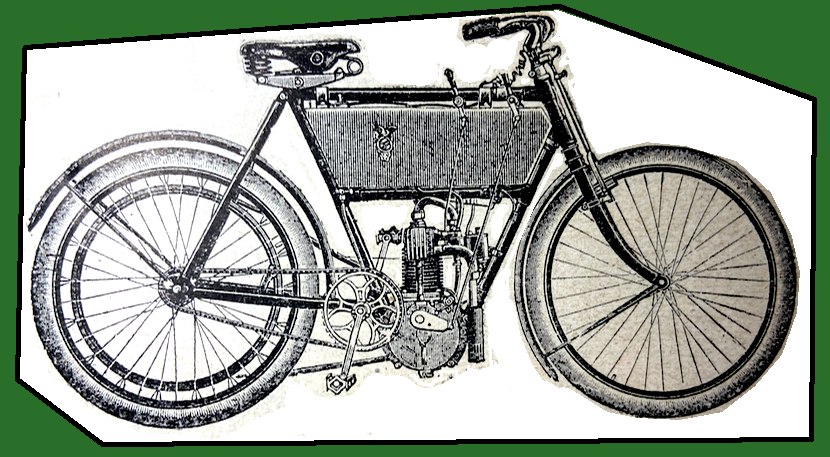
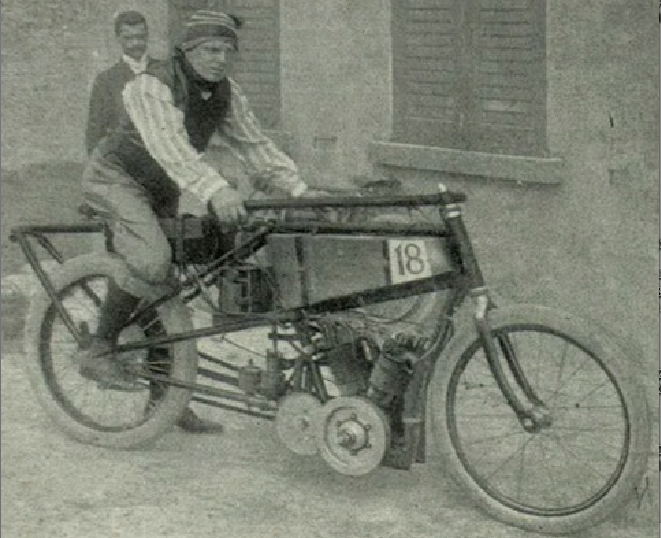

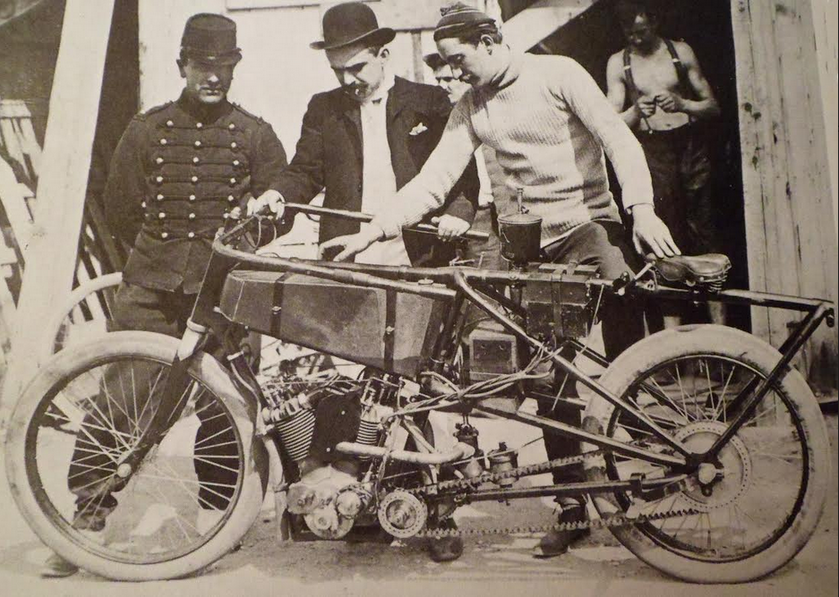

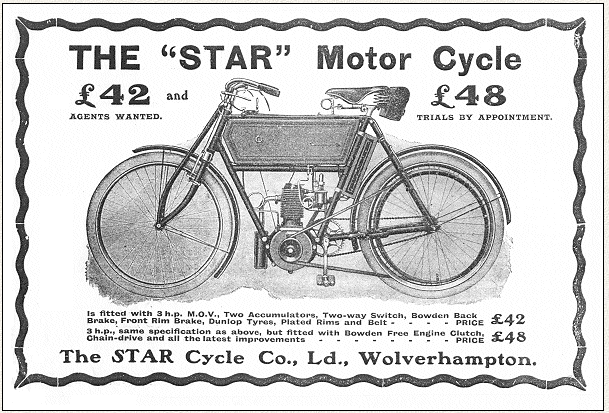
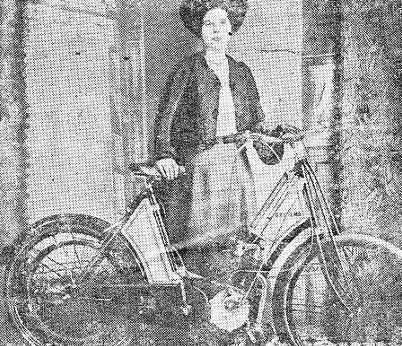
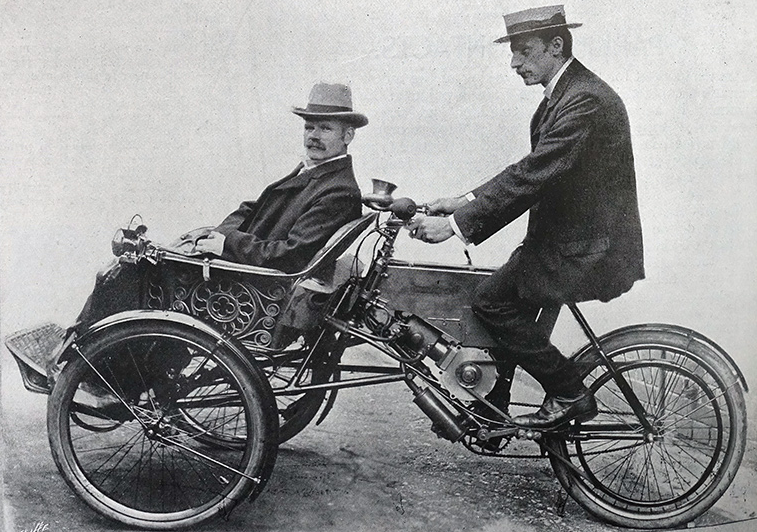
THERE WAS GREAT international interest in the Paris-Madrid race though some enthusiasts wondered if motor cycles were really up to such a severe test. A number of Brits joined the fun, though it was reported: “The formalities to be gone through by the foreign riders were ridiculous and irksome, some of them occupying most part of the day before they could be discharged. They had to submit their machines for judgement as to whether they were bicycles that could be driven safely to the Department of the Engineers of Mines and then prove they as riders were also capable of directing them.” However not all the pre-race tests were so rigrous: “We were interested, and, it must be confessed, somewhat disgusted, while watching the weighing of the motor bicycles for the Paris-Madrid race, to observe the amount of perverted ingenuity that had been employed in reducing the weight of motor bicycles of from 4 to 5hp, so that they would pass the 50kg class. Readers will say it is impossible, seeing that an ordinary 2hp commercial motor cycle
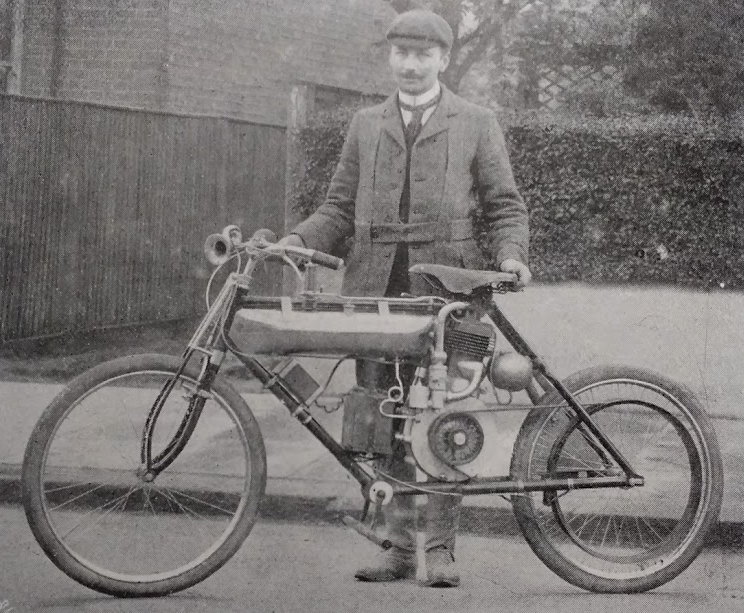
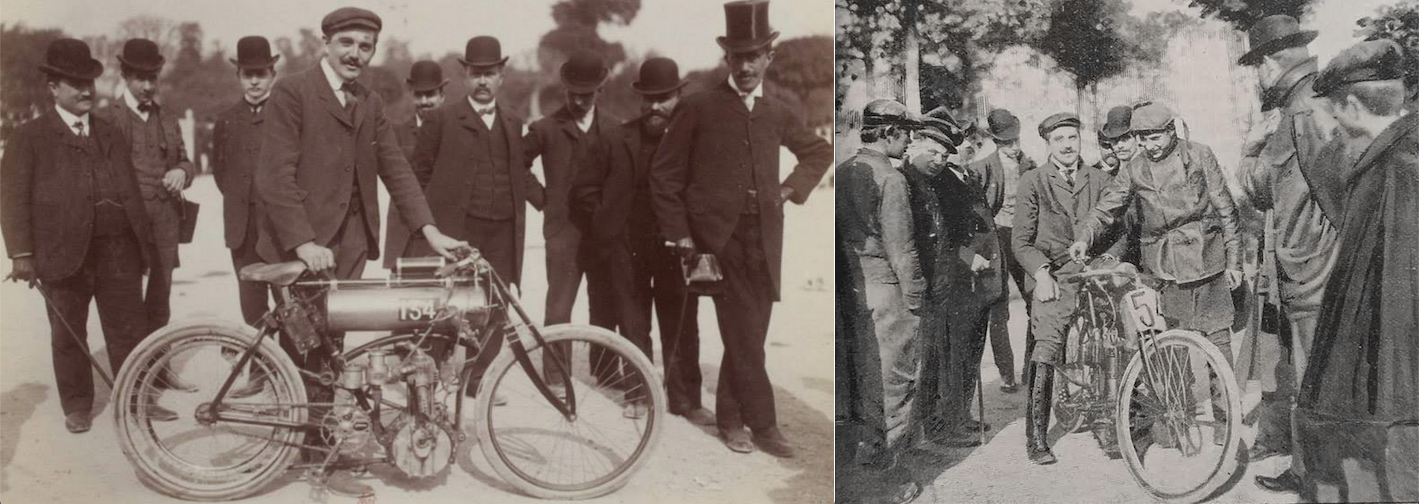
weighs 50kg and over, even without petrol, oil, or accumulators.On the other hand, this is very easy to explain, when we say that the above-mentioned motor bicycles were weighed for the Paris-Bordeaux race with ordinary track racing tyres on, half the usual bolts missing, no chain, no pedals, in many cases no cranks, sprockets, or chain wheels, and on one of the motor bicycles we even saw a seat-pillar made of wood painted with aluminium powder, tanks of only one litre capacity, handle-bars as thin as paper, and these perforated all over with holes for the purpose of lightening them. In addition, tyre lock nuts were non est, and circuit wires were made of thin electric bell wire. Many of the coils were actually only attached to the frames by pieces of leather, in some cases string even being used for this purpose. By these means the weights were brought down to 49kg 999g! But next day, when ready to start, the motor bicycles of which we are talking were totally different machines. Everything required for safety had been replaced. The general outline remained the same, and this naturally deceived the starter; but the details necessary for road racing had been replaced, which of course meant an increase in weight.” Riders started in pairs at one-minute intervals on the 345-mile run to Bordeaux. As they arrived they all complained of nails thrown onto the road which had caused numerous punctures. There were stories of cars blocking the road and competitors brought to a halt by spectators wandering in front of them. More than one Brit pulled over with fatigue and heat exhaustion, the quickest competitors took nine hours to reach Bordeaux where the race was cancelled following a number of fatalities. “The impression caused by the accidents was so great that that the Prefect of the Department sent an order to prevent the racing machines from leaving the grounds where they were exhibited on the day following the race, without a special authority, and this was only given on condition that the vehicles were hauled away to the railway stations to be put upon waggons for their destinations.”
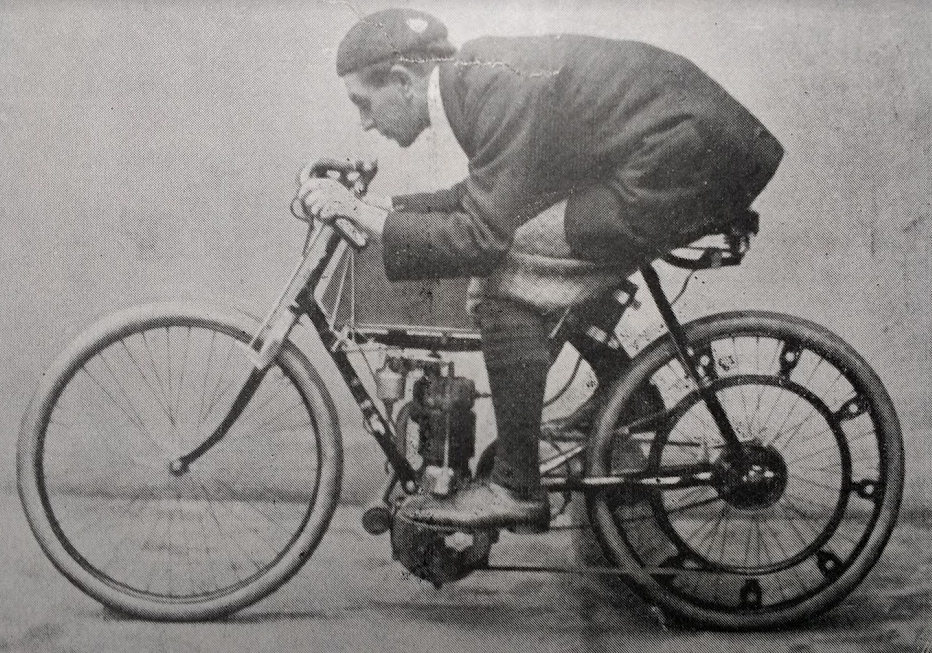
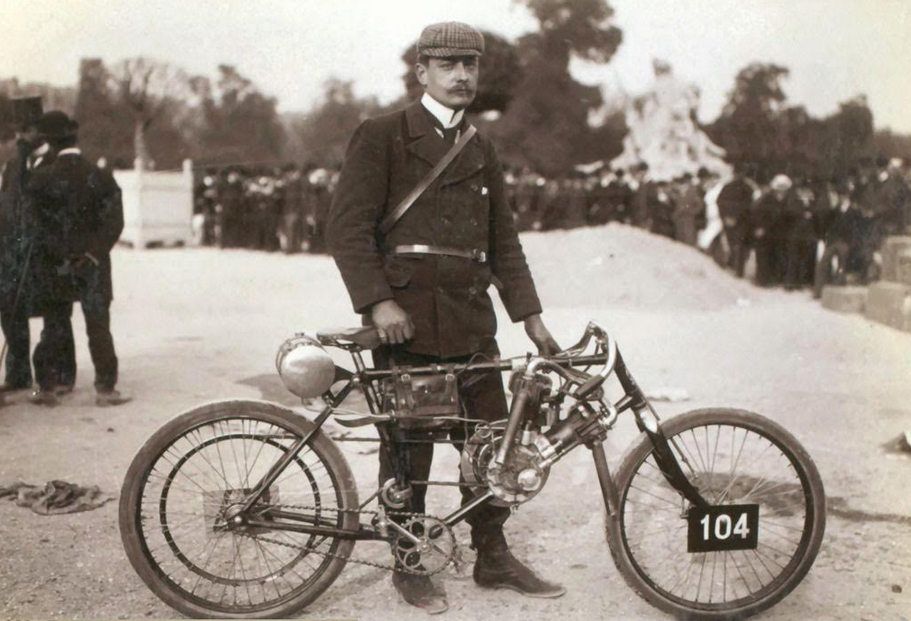
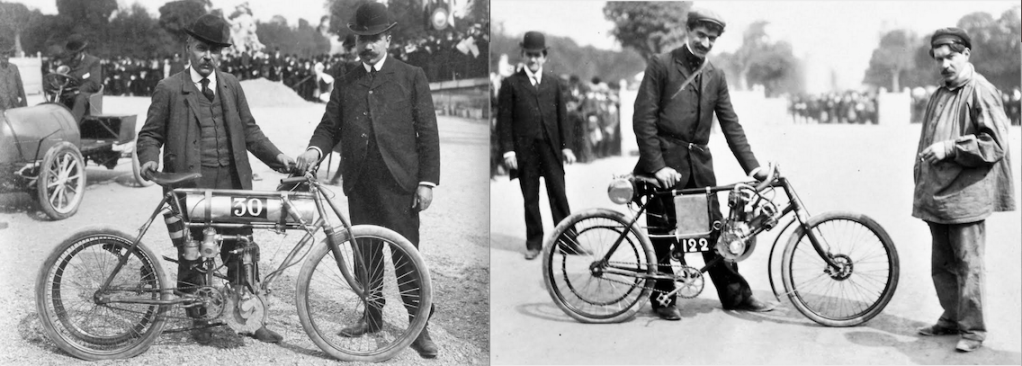
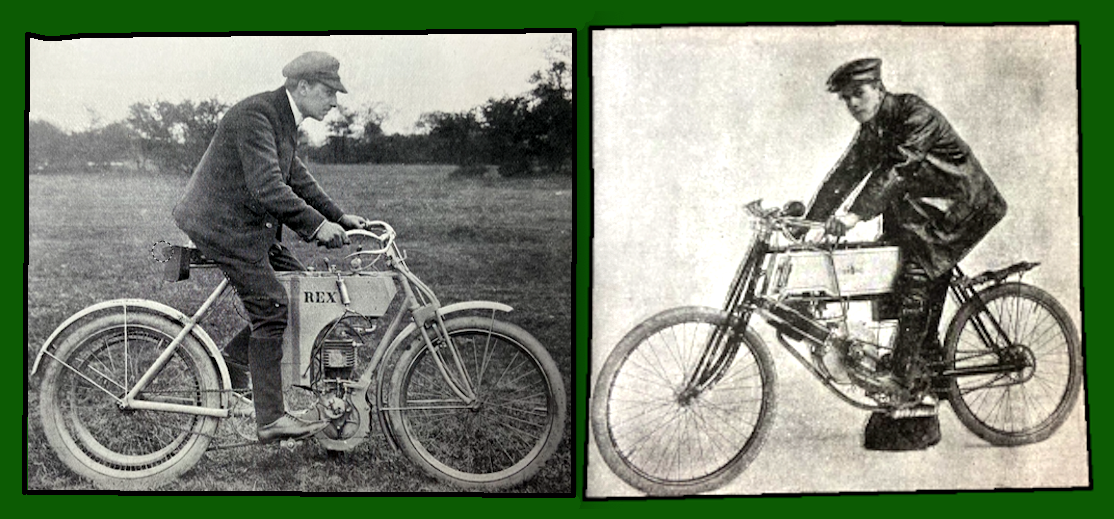
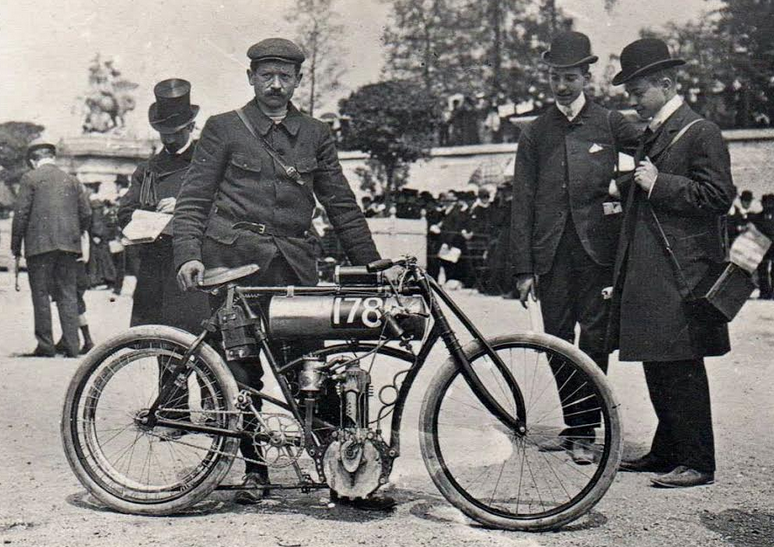

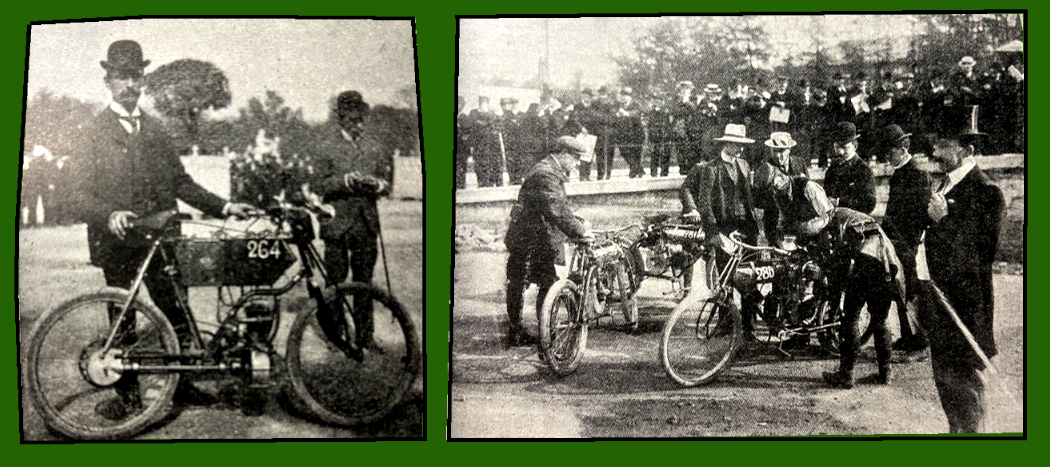
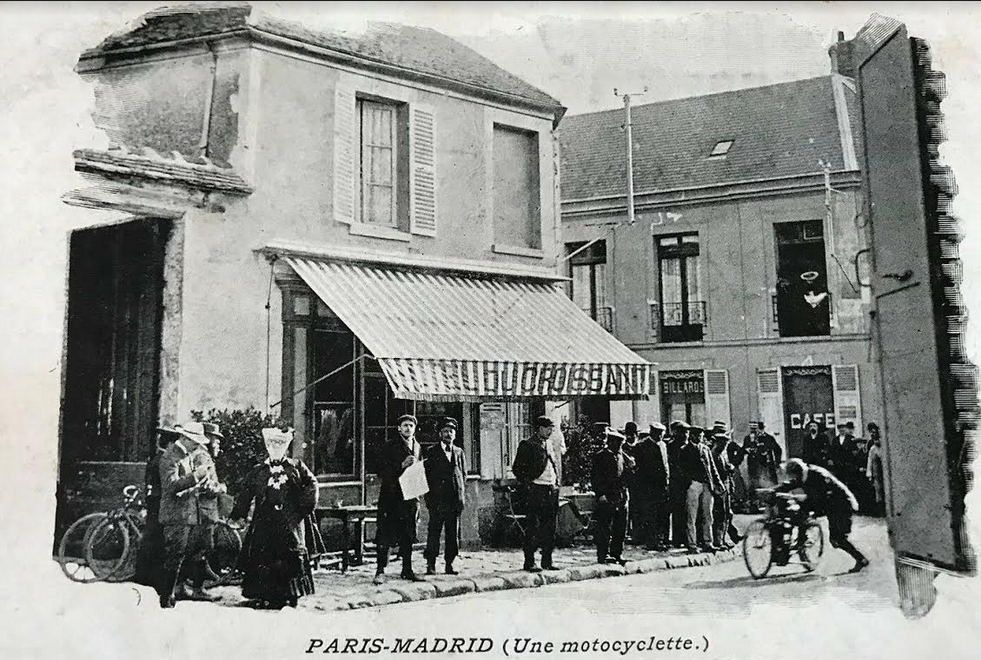
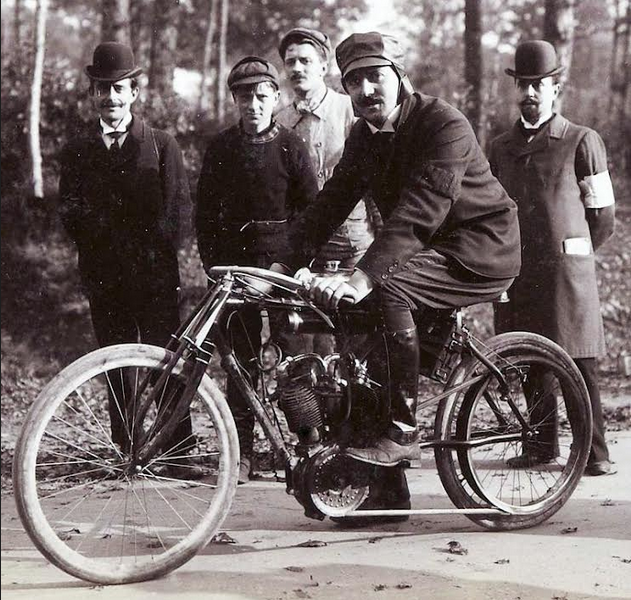
The foregoing report and pics from the Paris-Madrid was concocted from. a variety of sources. I’ve now read a full report in The Motor which indicates that the event was a shambles that cost the lives of competitors and spectators. It seems that 139 “heavy and light cars” started, as did 36 “voiturettes” and 52 motor cycles. The race was stopped at Bordeaux to avoid further fatalities and led France to follow the British lead by banning road racing. There were fears that the Gordon Bennett Race in Ireland at risk, though in the event well-heeled French drivers hired an ocean liner to take them to Ireland; for two weeks they used it as their headquarters.
ONLY 15 BIKES GOT AS FAR AS Bordeaux. Arnott was the first Brit to finish, in 10th place. The results were: Motorcycles: 1, Bucquet (3½hp Werner) 8hr 57min 1sec; 2, Demester (3½hp Griffon) 9hr 3min 44sec; 3, Jollivet, (3½hp Griffon) 9hr 25min 54⅖sec; 4, Cissac (3hp Peugeot) 9hr 39min 36⅘sec; 5, Lanfranchi, (3½hp Peugeot) 9hr 50min 40sec; 6, Derny (2 cylinder Clement) 10hr 23min 23sec; 7, Griet (3½hp Griffon) 10hr 43min 46⅕; 8, Momo (4hp Peugeot) 11hr 3min 20sec; 9, Prost (2½hp Doue) 11hr 42min 5sec; 10, Arnott (3½hp Werner) 12hr 8min 2sec; 11, Martel (3½hp Griffon) 13hr 11min 2sec; 12, Baret (3hp Bruneau) 13hr 59min 0sec; 13, Maillard (3½hp Werner) 14hr 3min 18sec; 14, Conderc (3½hp Peugeot); 15, (2½hp Vaurs). The final two arrived outside the time limit. Bikes had to meet the 50kg weight limit which was
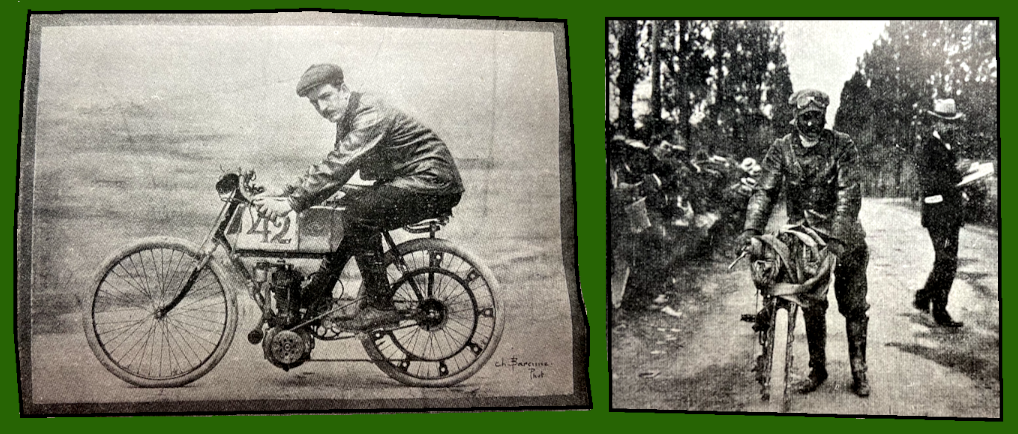
ubiquitous on the Continent. This encouraged bikes that were fast but sacrificed braking, muduguarding and rider comfort on the alter of speed. As we will see the Brits final reacted to this with a race for touring bikes (yes, of course I mean the TT). The following excerpts from The Motor give some idea of the chaos that beset what was planned to be the greatest inter-city road race to date: “We are writing this in the knowledge that the rest of the race is prohibited, a private telegram having reached the little band of English journalists and pressmen at Bordeaux early this evening, and before the news got through to the Automobile Club. There is no doubt in our minds that motor racing in France has ended—ended in black tragedy—the regrettable incidents of the ill-fated Paris-Madrid course having sounded its death knell. And it is difficult to foresee the outcome of it all, because in every country both government and people are ever prone to panic legislation, and if this, by some unfortunate chance, is not averted, the net results must be harmful, whereas, properly applied, the lessons learned from the catastrophes could be made profitable…The awful tales which reached us from competitors when they arrived were simply blood-curdling, and before the end of the day there were over a dozen competitors killed, and even more spectators. From all this mass it was difficult to pick the wheat from the chaff, and the news of the condition of the various competitors which has come in to Bordeaux from time to time since is so contradictory that one feels unable to believe anything…The protective forces performed their duties in a most
perfunctory way. The infantry were a lot of boys, who acted as if they had just been allowed out of school. To see them playing about on the roads, twisting their bayonets into all sorts of shapes, and then, instead of keeping the crowd in line, themselves wandering about the road, and seeing that their own view of the race was not spoiled, gave a Britisher, who knows how these things are managed in his own country, a profound contempt for the French soldiers. The officers could do little, and very seldom tried to do anything with the slovenly lot they had to deal with, and so we would see one of them leave his post, cross the road, and playfully drop his rifle butt on an unsuspecting comrade’s foot. Then there would be more horseplay when the latter got his revenge. Is this the way to protect the public? Is this the way to keep a clear course? Is it to be wondered at, therefore, that spectators and racers were killed and maimed, that regulations were evaded, or that the competitors were forced to snatch time in controls, when such laxity prevailed?…Matters would not have been so bad had even the incomplete arrangements and regulations been carried out. Here the lack of thoroughness and the absence of conscientiousness in the carrying out of an imposed duty, which are so characteristic of the French nation, came in. The signalling and the marking of dangerous portions of the route were carried out for a time, but then the tired feeling came over the men, and warning flags would be taken away from the course just when they were needed to avert a catastrophe. At the controls the regulations were carried out in a disgraceful manner…”
…and here’s part of the Paris-Madrid report in The Motor Cycle...
“ON OUR ARRIVAL AT BORDEAUX the wires from the different controls enabled us to piece together the story of the motor cycle race. The competitors left Versailles in pairs at minute intervals, the first two being sent off at 6hr 19min. Bucquet, on his Werner, started with Momo a minute behind the first couple, and he covered the first 26km to Rambouillet in 21min while Demester took 25min 17sec, Lanfranchi 25min 28sec, Derny 27min 29sec, and H Arnott 28min 28sec. On the way to Chartres (74km), Demester had passed Bucquet and arrived at the control nearly a minute ahead, making close on six minutes in actual time, and then came Derny, Lanfranchi and Arnott. So far scarcely any of the motor cyclists seem to have given up, though the way in which they were tailing off showed clearly enough that many of them were being delayed by punctures and other troubles. Interest was now being centred in the struggle between Bucquet and Demester, the former having now made up his loss, and was the first to reach Chateaudun (119km) with Demester, Arnott, Lanfranchi, Haustgen, Cissac and Derny all in good positions. The only English bicycles now left in the race were the Ormondes ridden by Wright and Hacking . The motor cyclists now found themselves among the cars, which occasionally gave them a good deal of trouble, though the tourist cars were the worst offenders in this respect. Wright declares that he had to pull up to avoid running into a touring vehicle which was drawn right across the road, and he and the other competitors were terribly worried by the spectators, who spread out over the course to such an extent that they were obliged repeatedly to cut out and brake for fear of accidents. At Vendôme (158km) a large number of the motor cyclists had dropped out, nearly all of them apparently due to tyre bursts and punctures. Not a single competitor seems to have escaped trouble of this kind. On the whole, it would appear as if the tyres were much too light for such a race, in which the cycles frequently travelled up to 50mph; and what with the hot weather and the wear and tear of racing at such speeds, the tyres would have to be indestructible to go through without trouble. The tyres ought to be much heavier in a race where they are put to such an exceptionally severe test. At Vendôme the positions of the leaders remained with little change, but at Tours Demester was again in front, with Bucquet, Lanfranchi and Arnott in that order. Between Tours and Châtellerault, Lesna, the old bicycle champion, who was riding a Peugeot
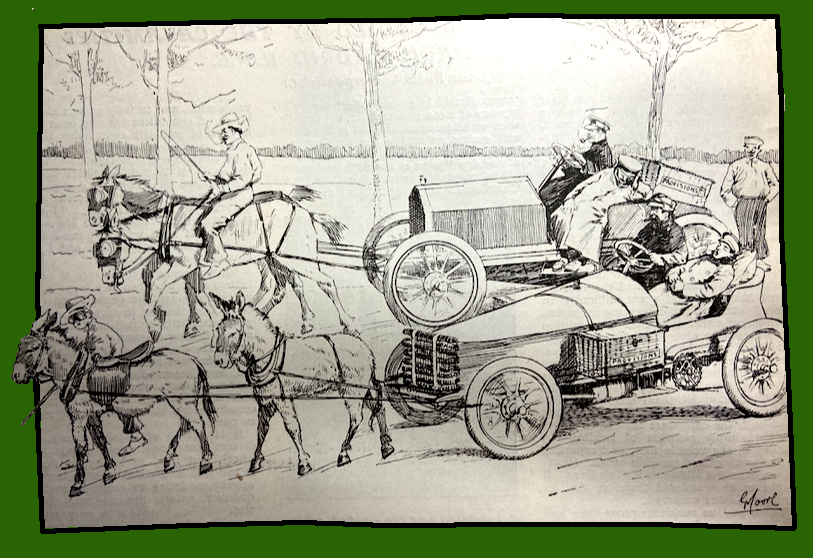
cycle, met with an accident at a level crossing. One of the Ormonde riders, Wright, was now having a lot of trouble with his tyres, which went flat every few miles, and most of his time was taken up in repairing and pumping. The heat and the climate were now telling on him, and towards evening he actually found himself dozing on his machine and waking up with a start as the bicycle swerved. When the tyre went flat for the last. time Wright saw that it was hopeless to expect to get to Bordeaux that day. Had he continued, he feared that he would have fallen off his bicycle. He therefore pushed the machine back to the control and dropped incontinently to sleep. This appears to have been the experience of a good many riders who were not accustomed to the heat of a Southern climate. Meanwhile, Demester was still leading at the controls, with Bucquet second; and Cissac had improved his position and was running with another Peugeot rider, Lanfranchi, while Arnott, Derry, Momo and Jollivet were following in that order. The race between Demester and Bucquet was now very exciting, for there was only a few minutes’ difference between them; and, taking into account the times of starting, it was really difficult to say who was actually leading. At the Bordeaux control it was not expected that the motor cyclists would arrive until very late. So few of the cars had come in that it was feared the disaster which had befallen so many of them would have overtaken the motor bicycles but fortunately these fears mere not realised, and if the proportion of machines to finish was very small, it can only be attributed to the tyres, which were put to an ordeal through which they had probably never gone before. The bicycles behaved splendidly, as will be seen from the times of the first half dozen. It was after six o’clock that the first motor cyclist was signalled, and Bucquet drew up to the control, where he got as big a reception as was given to the winner of the big car section. On account of the fatal accidents to some of the cars the French Minister of the Interior prohibited a continuation of the race to the frontier, and this interdiction was extended to Spain by the Spanish Government; so what promised to be the greatest and most interesting race yet held finished abruptly at Bordeaux. The impression caused by the accidents was so great that the Prefect of the Department sent an order to prevent the-racing machines from leaving the grounds, where they were exhibited on the day following the race, without a special authority, and this was only given on condition that the vehicles were hauled away to the railway stations to be put upon waggons for their destinations. One or two of the motor cyclists went to Spain to complete the course; but the restrictions in that country were as great as they were at Bordeaux. It is reported that as the result of the accidents in the race the French Government is revising the regulations relating to autocar and motor cycle traffic, so that the event is likely to have an unfortunate ending in more ways than one, though it is too early yet to say in what stay the existing regulations may be modified.”
“IT APPEARS THAT THE accident to Lesna, who was the only motor cyclist injured in the Paris-Madrid race, happened as follows: On approaching a level crossing over the railway at Port de Piles he came on a gipsy’s cart right in the middle of the roadway, in attempting to pass which he struck one of the iron posts supporting the barrier, was thrown forward on to the railway track, and falling with his knee on one of the rails fractured his knee cap.”
“WE HAVE RECEIVED a long letter from Messrs Werner Frères, of Paris, in which they wish us to make it clearer than we did, in our comments on the Paris-Madrid race, that the successful Werners were thoroughly equipped with everything that was necessary for the lengthy journey, and that comfortable saddles, large tyres and two brakes were fitted. We mentioned that Werners had been more successful in their pruning down, with the result that, whilst they came within the weight limit at the official weighing, they were thoroughly complete and efficient machines. They arrived at Bordeaux in good order, and seemed fit to accomplish the remainder of the trying journey with credit to themselves. This was mainly due to the fact that the first idea of using machines with large engines was abandoned, moderate sized engines being used and a little more allowed for the tyres. Messrs Werners claim that speed is of much greater importance than we are willing to concede, but they admit that it must go hand in hand with ‘reliability, regularity and precision of workmanship’. They also advance the opinion that progress is of supreme importance, even though it may claim its victims, and the ill-fated Paris-Madrid race marked the summit of immense effort on the part of the new industry, demonstrating the fact that the extreme limit of speed had been attained, whilst at the same time valuable information on the resisting power of metals has been obtained. Of all their victories, Messrs Werners are the most satisfied with the result of the first stage of the recent race.”
THE 1903 MOTOR Car Act (it came into force on 1 January 1904) required every motorised vehicle to be registered with the owner’s county council and fitted with number plates. It increased the national speed limit from 12 to 20mph with lower local limits, and driving licences were introduced. There was no driving test, just a five-bob (25p) fee with a minumim age of 17 for cars and 14 for motorcycles, which were defined as vehicles weighing up to 3cwt with up to three wheels. The offence of ‘reckless driving’ came in to control pioneer roadhogs. Horses still ruled the roost – noisy exhaust cut-outs were banned and drivers were required to “stop, and remain at a standstill, for as long as may be reasonably necessary” if a horse rider held up his hand. And riding side saddle on a motorcycle was banned.
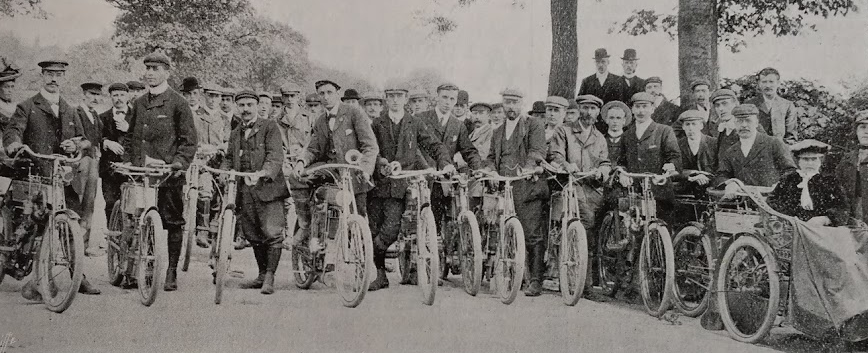
IT WAS A NOTEWORTHY year for motor cycling in the USA. William Harley and Arthur Davidson produced a 3hp motorcycle and sold it to an old schoolmate; Indian chief engineer Oscar Hedstrom set a motorcycle speed record of 56mph over a measured mile at Daytona Beach; Reading-Standard made Thor-engined Indian clones. A year after making his first motor cycle Glenn Curtiss rode a Curtiss to victory in the first American hillclimb; then, at Providence, Rhode Island, he set a flying-mile single-cylinder record at 63.8mph; this is generally accepted as the first motor cycle world speed record. And following ‘agitation’ by the New York MC and the Alpha MC, the Federation of American Motorcyclists (FAM) was established at a meeting in the Kings County Wheelmen clubhouse in Brooklyn. It recuited 70 enthusiasts as ‘charter members’, stating: “Any rider of good character is eligible for membership.” Applications could be endorsed by existing members or by “two reputable citizens of the town of his residence”…“Its objects shall be to encourage the use of motorcycles and to promote the general interests of motorcycling; to ascertain, defend and protect the rights of motorcyclists; to facilitate touring; to assist in the good roads movement; and to advise and assist in the regulation of motorcycle racing and other competition in which motorcycles engage.” Committees included Membership; Legal Action; Competition; Roads, Touring and Hotels; and Transportation and Facilities.
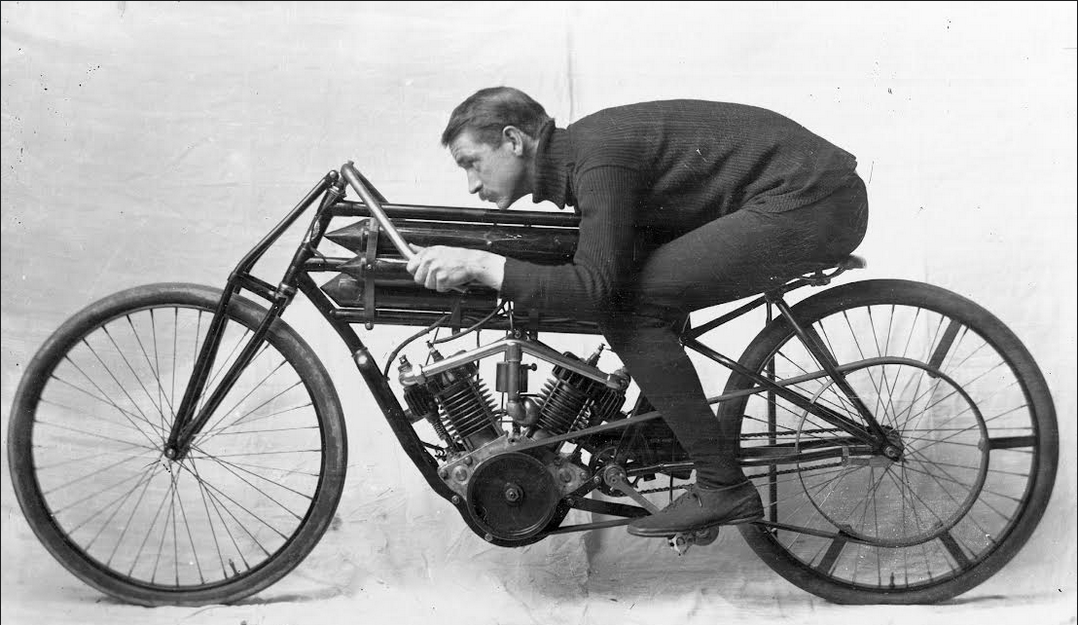
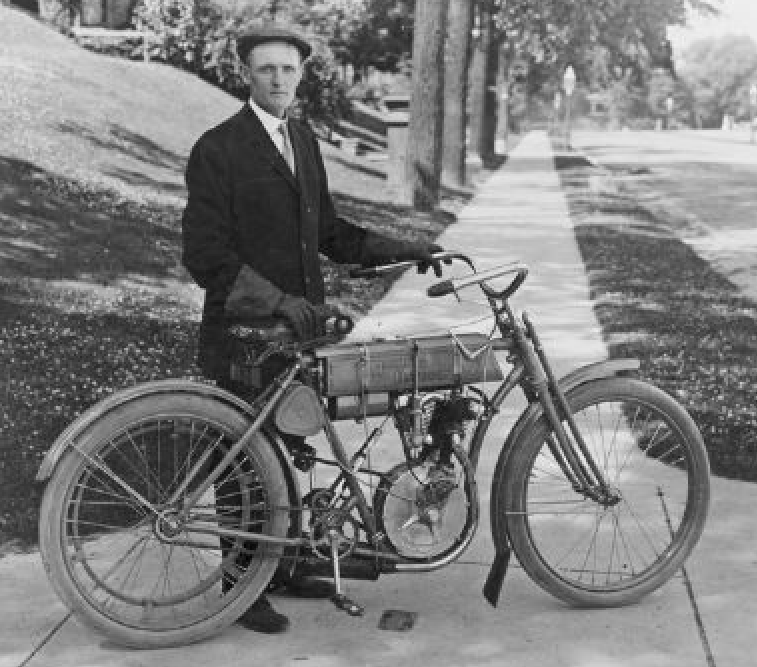
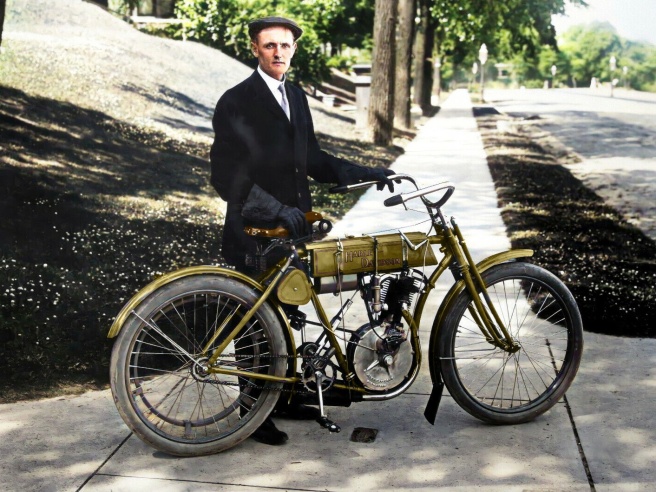
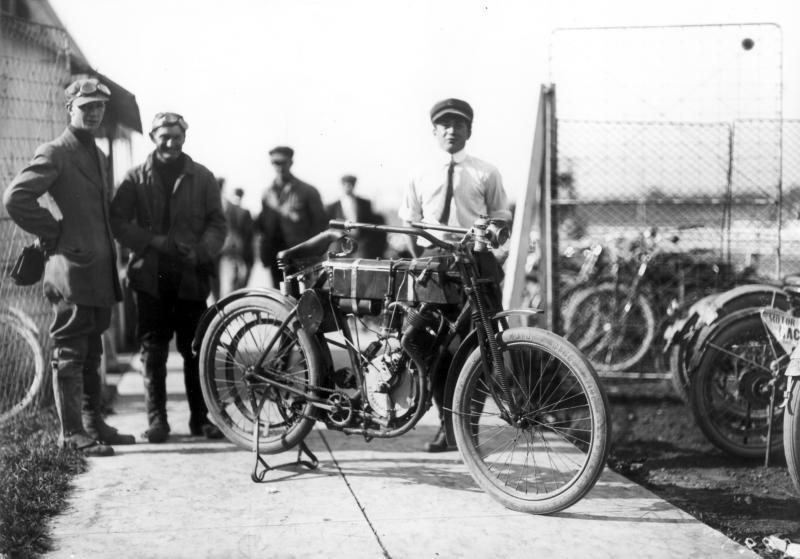
“THE POWER TO CONTROL any motive vehicle is an element which cannot be underestimated. It must be simple and positive, especially when upon a machine intended to thread its way in and about heavily travelled streets where loss of control would be fatal. To control the Indian motorcycle, but one lever is used. It is termed the speed lever. It is easily reached without removing the hand from the handlebar. To the beginner it is a marvel of simplicity because, with but one lever to think of, accidents are impossible, as one cannot become confused over several levers of which they do not know know even the functions. The speed lever starts the machine, increases the speed, and stops the machine. It also lifts the exhaust valve, so that the machine can be handled without compression in the cylinder. This enables one to start with-out compression, and without touching any relief lever or pet-cock. To start: pedal, throw speed lever over a quarter of an inch, which drops the exhaust valve, and engine starts. The further the lever is thrown over the faster the speed. The time of the spark is governed by this lever throwing the contact breaker forward. This lever will give all possible speed required for road work, and will take the machine up 10 and 12% grades. When heavier grades are met the gas lever is used. This simply gives a heavier charge to the engine, thus increasing the power. The flow of gasoline—the known quantity—is fixed and does not require regulating. The air—unknown and variable quantity—is regulated and adjusted by the air regulator. The machine can be stopped instantly also by turning the left grip to the left, which breaks the electric circuit.”
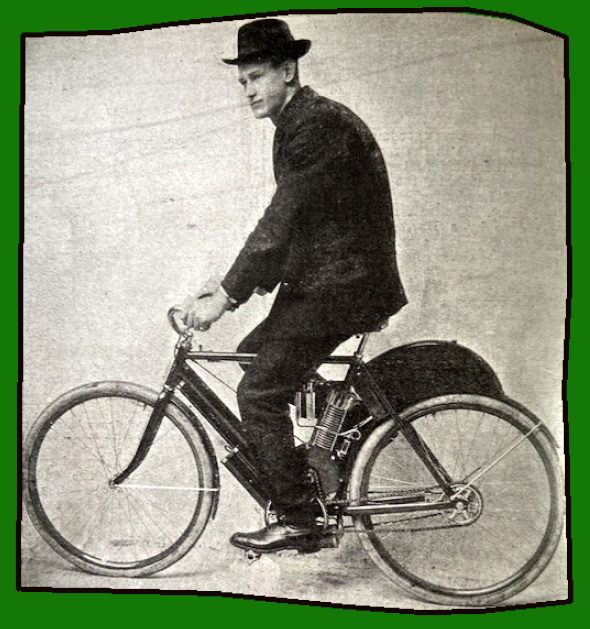
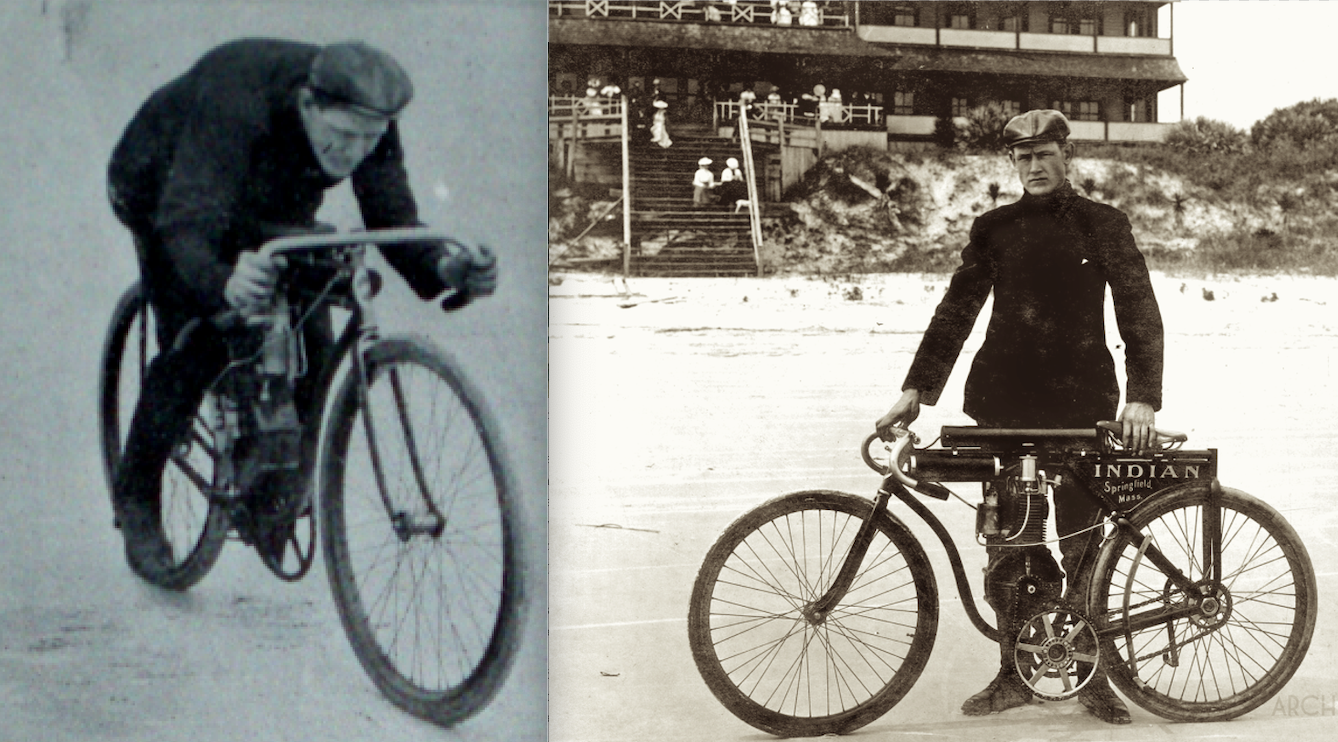
DE DION-BOUTON built a six-litre V8 car. They might have been surprised to know that a century later a V8 engine of comparable size would power a production motorcycle.
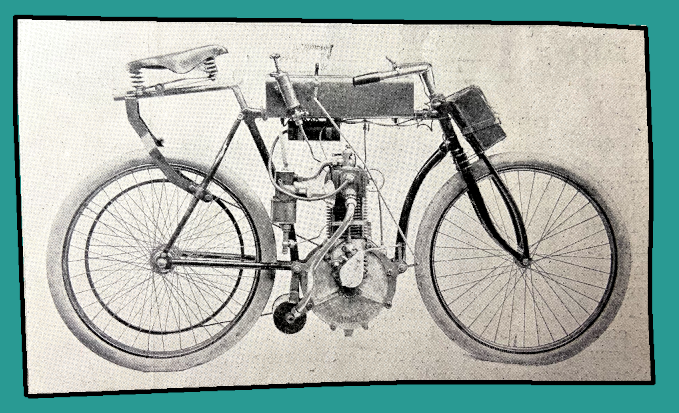
MOTOR CYCLING reported: “Some remarkable developments in the application of the turbine principle to the construction of petrol motors are expected shortly. Messrs. Birch and Co, of Salford, have designed a 3hp motor on this principle, and they claim that it runs very economically at high speed, and with a total absence of vibration. At present the motor is fitted to a bicycle, and the inventors are highly satisfied with the results obtained.”
RIGHTLY PREDICTING that the car market would far outgrow the motorcycle market, Temple Press relaunched its new motor cycling magazine as The Motor (on 28 January). This left the growing band of motorised bicycle obsessives without a magazine of their own, but not for long.
Rudge-Whitworth had a row with Werner over the Rudge-Wedge motorcycle (which you might recall from 1902). Rudge-Whitworth’s Johannesburg depot manager was approached by Werner to sell their machines in South Africa. As Rudge-Whitworth did not sell motorcycles there appeared to be no conflict of interest, so Werner signed a contract with the Coventry company to send 36 machines to South Africa, with Rudge-Whitworth acting as sole agents for Werner. However, it soon transpired that other Werner motorcycles were being sold in South Africa at a cheaper price. Rudge-Whitworth refused to pay Werner the balance due on the shipment; the dispute was settled out of court.
RIGHTLY PREDICTING that the car market would far outgrow the motorcycle market, Temple Press relaunched its new motor cycling magazine as The Motor (on 28 January). This left the growing band of motorised bicycle obsessives without a magazine of their own, but not for long. Here’s Motor Cycling’s attempt to explain the move: “Much has already been said concerning the change in the title of this journal, but, after all, little explanation is necessary when we come to take a broad view of the matter, and it is the broad view tshat makes for successful journalism nowadays. Having set ourselves earnestly to the dealing with all popular-priced light motor vehicles, the line of demarcation between the motorcycle and the light car is remote to the point of non-existence. There are already motorcycles without pedals, and the absence of pedals and cranks may result in an entire revolution in design as compared with the motor-cycle which retains pedals. After all the MOTOR is the thing; and careful peering into the future has brought along with it the resolve which we put into action this week. The motor is common to the motorcycle as it exists today: it will be common to the same vehicle as it advances through the revolutionary stages towards perfection. The motor is common to the ‘four-wheeler’, to the development of which we intend devoting our attention. It must not be thought that the motorcyclist will suffer in any way by the change of title. We shall continue to devote our attention assiduously to his interests and requirements, but there is no more justification for this journal to limit its scope to catering for those we now describe as motorcyclists than there was in the days of long ago for the repeated endeavours which were made to run weekly journals solely in the interests of tricyclists. The relationship existing between the motorcycle and the light four-wheel vehicle is as close as that of the everyday bicycle and tricycle.”
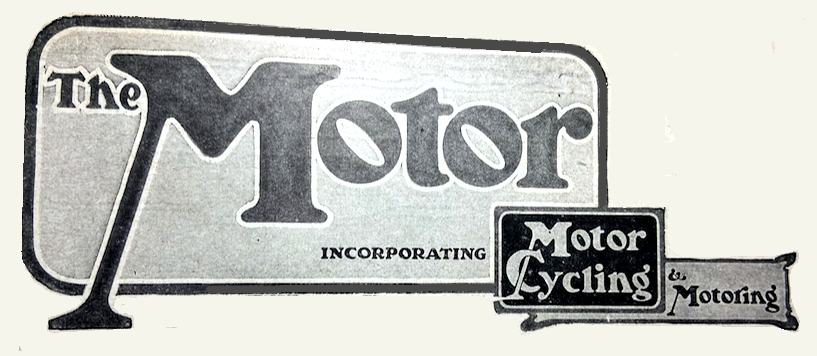
THE FIRST ISSUE of The Motor Cycle, published by Illife Press, was datelined 31 March–its actual launch date was 1 April but April Fool’s Day was held to be an inauspicious launchpad. In later years a blue masthead was adopted which earned it the nickname The Blue ’Un. The first page of the first issue carried what would now be called a mission statement: “The main points of the policy of The Motor Cycle will be: (1.) To give practical and useful information to motor cyclists. (2.) To explain the working of the motor and every part of the machine in the clearest possible manner. (3.) To describe new inventions and improvements. (4.) To reward all matters of interest in the motor cycle world. (5.) To promote the exchange of ideas and useful information between motor cyclists. (6.) To reply to queries. (7.) To help the motor cyclist to get the utmost enjoyment from the pastime, (8.) To bear in mind that many motor cyclists are not in receipt of large incomes. (9.) To foster motor cycling in every possible way.” The magazine grew with the industry; like British motorcycles, it was a world-beater. After six years Temple Press realised the error of its ways and relaunched Motor Cycling (this time with no mention of Motoring). For the best part of 60 years Motor Cycle and Motor Cycling would be friendly rivals as the Blue ‘Un and the Green ‘Un; they finally merged in 1967.

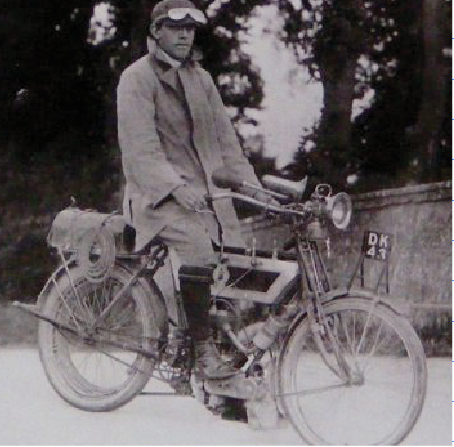

“IT AROSE IN THIS WAY: my friends who were not so speedy as I on the ordinary common or pedal bicycle obtained motors, and started off so early in the morning, went so far, and got back so late at night, I came to the conclusion that the way to see life was to have a motor bicycle. My knowledge was absolutely nil. The fittings and engine were ordered from firms with a great reputation, and I waited delivery with great anxiety. To cut a long story short (as to the building up), after waiting for bits of wire and things, the machine was completed in five weeks three days—some hours odd later than the promises made by every-body. But the disappointment of this was overcome by anticipation and excitement, when at 11pm the machine was nailed down by the steps of back wheel on two soap boxes, and an attempt made to start. After a few futile attempts it spun round at something like 1,000-1,500rpm, and satisfaction was plainly visible on the faces of the half-dozen people present. Now I commence the details of what are usually called troubles, and sincerely hope that my readers will benefit from my carelessness and forgetfulness. The engine fitted was of a well-known make, well made. Nothing happened to it. From a course of hard reading, I learned the ‘carburetter’ was the box wherein the gas was made. The ‘accumulator’, an electric battery from which I get sparks to ignite gas and cause the explosion. I have heard the boys in the street call it ‘fit, fit’. The ‘commutator’, the portion of the mechanism that causes the electricity, the gas, and the engine to work together at the proper moment. The ‘sparking plug’, the arrangement that makes the spark inside the engine to explode the gas at the correct position of the piston. The ‘switch’, by turning the handle the electric current was in force or not. When not, the engine was a dead and useless article, and a brake to the machine. An early rise at six the next morning by the proud owner of this wonderful machine found that two people could not move it. I will call all forgetfulness and carelessness ‘Morals’. We had run the engine half an hour instead of half a minute; consequently it had overheated, and the piston was galled in the cylinder. This is easily understood when one thinks that the piston stroke is, say, 1,000 to 1,500 per minute, and, being in a close room, the chance of the cooling effect when travelling was absolutely nil. The lubricating oil had become ‘set’. After some time spent in forcing the engine round it was found necessary to inject paraffin into the cylinder and valves. Moral.—Always have paraffin handy, and see that there is an inlet at the top of the cylinder in which to inject paraffin, but do not inject too much. The detriment found in the use of paraffin is that when the explosion takes place the paraffin in the combustion chamber ignites, and the smoke arising from the burnt paraffin causes the sparking plug to become sooted up. The electric current is allowed to flow through the soot; therefore no sparking takes place. Sparking takes place only when the electric current is suddenly broken. Moral.—Do not use too much paraffin, and if doubtful of the cleanliness of the sparking plug brush with a soft brush damped with petrol or clean with fine emery cloth, being careful not to cause the gap between the two platinum points to be more than 1/32in, and always carry the brush, the petrol, and the spanner to take out the plug. The machine was started—the sensation both ex-citing and exhilarating—but after getting into the country and ascending a stiff incline the engine seemed to be going tremendously fast and the bicycle much slower than on the flat. A stop was made at the bottom of a hill, and after some futile attempts to get restarted it was found that the belt was so loose that in pedalling it did not drive the engine. This will explain the reason why the engine raced away uphill and did not drive the bicycle. The home journey was satisfactorily performed after tightening the belt. Moral.—Before starting, see that the belt is sufficiently tight to drive the engine. Carry any tools required to tighten belt. Start on the level or downhill, if possible. After exhibiting the machine on the stand and running it several miles before admiring friends, the next journey was undertaken, and after a run of ten miles it appeared to be firing very intermittently. It was found the commutator was not acting as it should do, and upon examining the piece of steel which is called the ” trembler ” (inside the commutator case) it was found that the platinum points were not touching every time, owing to one point having become ‘pitted’ or burnt away. By half a turn of the platinum-pointed screw, all went merrily. At the end of 50 miles a pull-up was necessary owing to traffic at a cross road, and in mounting the rider let the machine fall, but without any bad result being apparent for the moment. After a few miles he firing was again intermittent, and progress far from satisfactory. Upon examination it was found that the pipe supplying oil to the lubricator had split (this must have been done by letting the machine fall), and the oil had found its way into the carburetter, and the difficulty in reaching home was in keeping the carburetter clean and getting rid of the lubricating oil that had got into it. This was done by cleansing with petrol. The petrol used in this operation should have carried the machine twenty miles further than the point reached; but luckily, as the last few drops were used a good Samaritan was found, and home was safely made, the distance covered being about 130 miles. By this time recharging of the battery was considered necessary, and it was put in the hands of an electrician to charge, and on the voltmeter showed a voltage of 4. The machine was thoroughly cleaned and promise kept to lend to a friend for a Saturday afternoon’s ride. On the Sunday morning the friend called round to thank the owner for the enjoyable ride he had, and desired a short spin, as the owner was not ready to start. The machine was put upon the stand, but a start found impossible. The plug had been carelessly left in the interrupter, the switch handle left on. The battery had run down in the night, the only remedy being a recharged battery. Moral.—Look at your machine after a friend has used it; see that the handle is switched off; see that the plug is out, and always have a volt-meter handy to test the accumulator, and a fully charged accumulator handy. In mounting machine, did it awkwardly, and did not start; found had kicked sparking plug and broken same. Moral.—Always carry a spare sparking plug. Ran two-and-a-half miles splendidly, but firing became intermittent, and although it was considered that there was as much as a gallon of petrol in the tank, it was found that there was none. Moral.—Always be sure that you have sufficient petrol for the journey anticipated. Next journey, before a crowd of admiring friends and the usual boys of the street, a start for the first few yards was impossible. The would-be rider had omitted to turn on the petrol. Moral.—Make it a point to turn on the petrol, seeing that your interrupter plug is in its place and that the levers are in the best position for starting that your experience has taught you. Next time out, a horseshoe nail through the tyre and inner chamber, and after searching in the tool-bag, although there was every spanner and instrument required to manipulate the motor, the tyre repair outfit had been forgotten. Moral.—Do not forget the ordinary pedal bicycle requirements. Riding the machine in traffic one day, in switching on, the rider noticed that the switch had to be firmly screwed up before it would act, and on unswitchng the connection was not broken. This was awkward, especially as the traffic was heavy, but proved no great trouble. It was found that some particles of cement had become dislodged, and got between the brass connections of the switch handle. A ride was planned with some friends on ordinary bicycles, and some miles from home there was no sparking obtainable, and on examination it was found that one of the platinum points on the sparking plug had become loose, but upon replacing the plug everything went well. Moral (again).—Do not forget to carry a spare sparking plug. The machine was running splendidly, but it was deemed necessary to give it a good cleaning, after which the firing was not as good as it should be. It was found that in the cleaning of the machine the terminal or end of the wire to the commutator had been broken, and only a few strands of wire left unbroken. Moral.—Examine your terminals and connections occasionally, seeing that all are tight and clean. After a few days’ rest the machine ran beautifully on the stand, and a start was attempted in the road, but without success. Everything appeared to be in order, and still ran splendidly on the stand, especially when going fast. The trouble was found in the trembler blade being broken, and when the cam acting upon this was moving slowly no connection was made. Moral.—Always carry a spare trembler blade. Of parts that gave no trouble or were not forgotten, I have not mentioned. The above Instances are taken from a diary when I first commenced motor cycling, and now, owing to practice and improvements in construction, I laugh at the novice in trouble, but still get into trouble myself, but only for a minute or two. The final moral is, if you take up motor cycling, be determined to master the details, and you will find it the finest means of locomotion you ever touched.”
GEORGE WYMAN MADE the first motorised crossing of the USA on a 1¼hp 200cc California. The trip from San Francisco to New York took him 50 days, including a five-day break in Chicago while he waited for a replacement crank (he later wrote of Chicago’s “insect-infested hotels, drunken citizens and shady merchants”). Inevitably Wyman had to make running repairs; as he neared the end of the trip the California began to disintegrate. He later admitted that he “felt like shooting his mount full of holes and abandoning it”. Eventually the engine was beyond repair. Fortunately Wyman was a champion bicycle racer—his exploits included cycling round the coast of Australia—so, undeterred, he pedalled the last 150 miles in time to attend the innaugural meeting of the Federation of American Motorcyclists. For the full story of his epic trek have a look in features list.
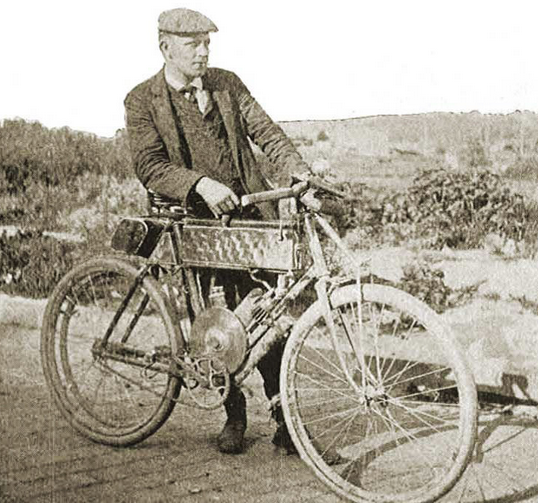
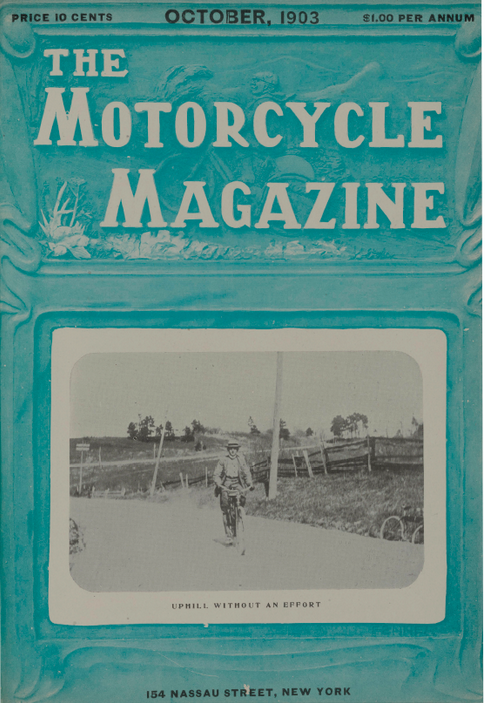
MOTOR CYCLING & MOTORING reported: “The following is an account of an interesting motor-bicycle run accomplished recently by Mr HB James, of Melbourne. The roads out in the open country are of the worst description, and the performance is highly creditable to rider and machine The route was from Melbourne to Hamilton, via Geelong, Camperdown and Caramut. The rider started from the Melbourne General Post Office at seven in the morning and reached Hamilton at 4.30 in the afternoon—a distance of 204 miles—this being better time than is accomplished by the mail train. A return was then made towards Camperdown, and at the 12th hour 243 miles had been covered. Out of this time one hour 54 minutes must be deducted for stoppages. The last stretch of 165 miles home was run during the night, and at seven next morning the rider had reached a point three miles on the Melbourne side of Lara, having covered 460½ miles. Deducting four hours 12 minutes from the 24 hours for stops, the net remaining time was 19 hour- 40 minutes, which works out at 23½ miles an hour all the way. The photo shown will give a fair idea of the machine used, and the following are some details: The motor used is a local production (excepting the De Dion aluminium fly wheel case), manufactured by E Beauchamp, of Melbourne, with a 2⁵⁄₁₆ bore by 2¾ stroke, and 24lb weight fly wheels. An atomiser somewhat after the Carlton principle provides the carburation—which is fired by an electric spark—timed by a positive make and break contact. An EIC sparking-plug was used, and gave every satisfaction, the plug not needing cleaning during the 600 miles’ ruts. A Dow coil was fitted, in conjunction with four No ‘o’ Obach dry cells, which still gave a third of an inch spark after the ride. Although the engine became very hot through continuous running during the hot portion of the day, the Vacuum Oil Co’s No 5 Mobile oil gave perfect lubrication. Transmission of power (gearing 1 in 5) was through an inch fiat belt, constructed from two strips of English leather sown together by raw hide laces. Dunlop 2 inch motor tyres were fitted to the machine, and although they had covered. some thousand odd miles previous to the ride, they required no touching nor pumping during the day’s ride, despite the. rough and stony nature of some of the roads. The quantity, of petrol used on the trip was 9½ gallons, but fully three gallons were lost on the road owing to supplementary petrol rank (which fits on back stay under saddle) leaking. The ordinary consumption of petrol by the . motor averages about 80 to 90 miles per gallon, which quantity is carried in petrol tank that fits between the top stays of the frame. The complete weight of the machine is between 150 and 1601b, when petrol, tool kit, etc, are fitted, so that it will be seen that the machine does not err on the light side; in fact, it is Mr James’s opinion that no machine under 100lb is suitable for use on their roads. The majority of the machines imported are too light he thinks.”

YOU CAN’T RUN a workshop without tea. Tea bags of a sort date back to 8th century China but just a week after the first issue of the Blue ‘Un, over the pond a patent was issued to TG Lawson and M McLaren for ” a novel tea-holding pocket constructed of open-mesh woven fabric, inexpensively made of cotton thread”. So at a stroke chaps fettling his hogbus could take a break and, as well as a lungful of old navy shag, relax with a bike magazine and a cuppa. Truly, that week was the launch of the modern age.
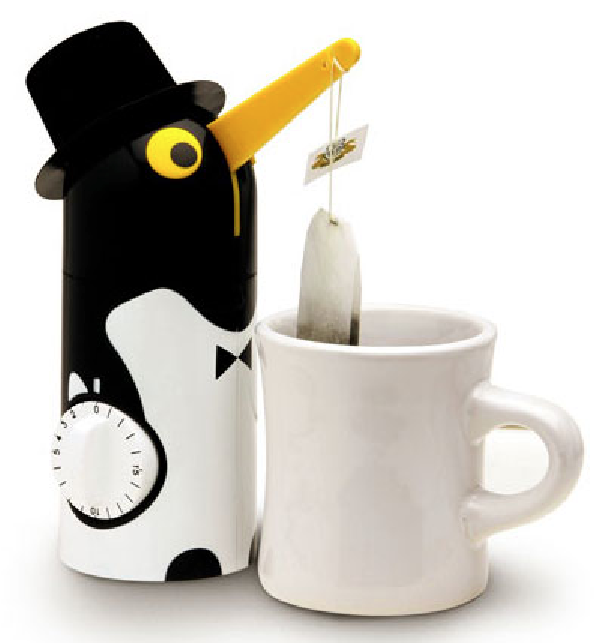
“WE GIVE A PHOTO of Arthur Herbert Price, of Willow Grove, Plaistow, and the motor-bicycle which he has made for himself,” Motor Cycling reported. “Young Price, who is the son of an engineer, is fifteen years of age and has inherited his father’s love of mechanics. He bought a set of castings and worked them up him. self. Then he bought a Minerva tank with its fittings and fitted op the whole machine. The work occupied seven months of his spare time, and with the idea of teaching him the value of independent research, his father told him to ‘find out’ whenever he asked for help or information. That he did ‘find out’ was proved when the machine was complete, for it ran well from the very start, and has given its youthful and clever owner considerable pleasure. “

“MR AW WALL, OF GUILDFORD, has made a motor bicycle from his own designs which presents some original features. It will be noticed that the machine is of great length, the frame being not only very long, but very low, this last result being partly obtained by setting the top tube almost in a line with the bottom of the head. The top of the head is stayed by a curved strut. Careful inspection of the illustration will reveal the fact that the horizontal stay member is clipped on. This is done with the object of providing a ready means for fixing the tanks, which are grooved top and bottom to receive the frame members. The tanks are put in position, with the upper grooves engaging the top tube, and then the detachable stay, which is built up of D-section tubes arranged face to face, is pushed up into the grooves on the undersides of the tanks, and is clipped on. A 2¾hp motor of a well-known pattern is employed, and no pedalling gear is fitted. The large belt pulley, however, is mounted on a very ingenious clutch. This clutch is of the double conical type, one part being on the pulley, and the other on the hub of the road wheel. A transverse key working in a cross slot in the hollow wheel axle controls the part of the clutch carrying the pulley, and this key is operated by a pin passing through the axle. At the outer end the pin is connected up to a hand lever, which will be noticed running up by the saddle stay. The end of the lever is fulcrumed just below the wheel axle, so that the rider can control the clutch to a nicety. Magneto ignition, spray carburetter, and belt drive are employed. Both the saddle and the handles are carried very far back, and we can quite believe that the machine is a flier.”
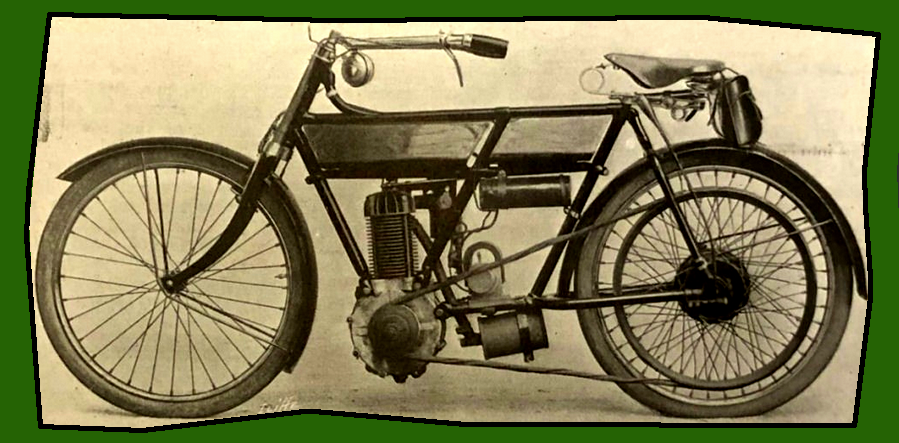
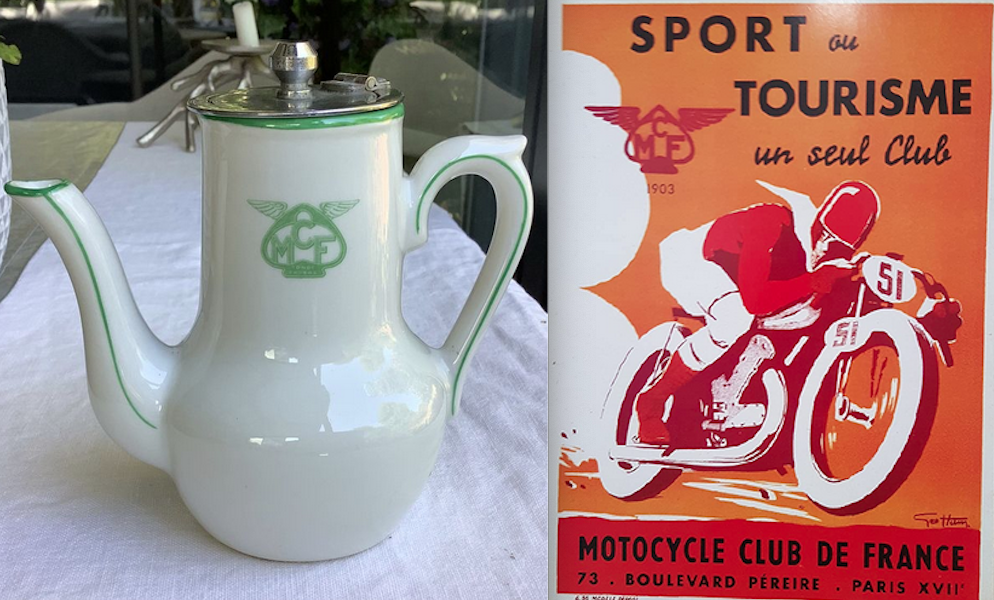
“THE MOTOR CYCLE has been developing in France almost concurrently with the automobile. By 1895 there were several on the market, the first in date being the Millet with four cylinders revolving round the rear hub. Then came the Dalifol steam bicycle, which ran with wonderful smoothness; but the system was not altogether conducive to the comfort of the rider, whose feet rested on the furnace, and the chimney, into which he occasionally dropped pieces of coke, rose conveniently above the top tube right under his nose, while he had to stop every few miles to replenish the water tank…Mr HO Duncan introduced that equally wonderful Hildebrand and Wolfmuller bicycle…but very few seemed to have the acrobatic skill necessary to mount the machine. The desire for pacemaking bicycles induced Pingault to devise his electric two-wheeled machine, but batteries of accumulators did not prove satisfactory on bicycles, and electricity has gone the way of steam. The first practical bicycle was the Werner, originally with tube ignition; but the machine was looked at askance until electric ignition was adopted, when the machine took up the position which it has occupied ever since.”
“IT IS NOW CLOSE UPON ten years ago that motor bicycles were first turned out in France—not, of course, upon a commercial scale, though this was not from any want of enterprise on the part of the inventors, who did their best to make their novel, and in some cases extraordinary, bicycles popular in this country; but, despite their short-comings, the Millet, Dalifol and other bicycles, which are nowadays merely memories of a historical past, represented in any event the beginnings of what has now become a recognised industry; but it is only within the past year that there has been any serious attempt to supply the growing demand which sprang up for motor bicycles as soon as their performances in the various automobile races showed that they were really practical machines.”
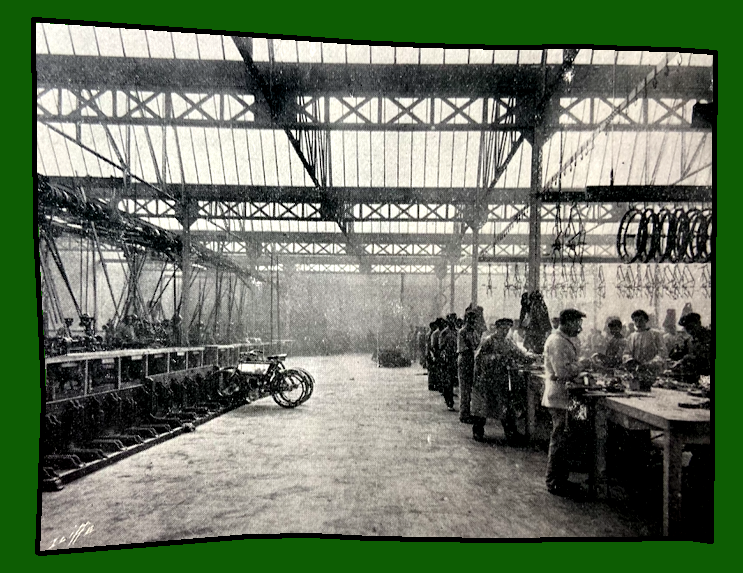
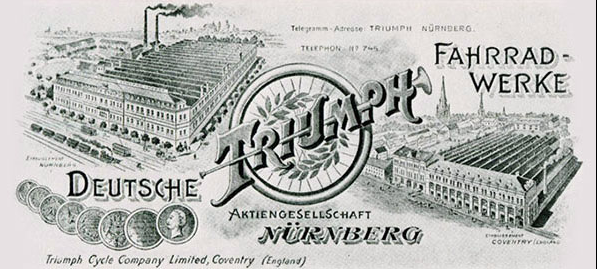
DOT WAS launched in Bradford; the initials stood for ‘Devoid Of Trouble’.
THE SUCCESS of Humber’s two previous models (in 1902) led on to the development of new machines: 1¾hp and 2¾hp solos, a 2¾hp tricar with single front-wheel, and the Olympia Tandem forecar. All has chain drive and were listed in two forms, the ‘Beeston’ or the cheaper ‘Coventry’, following Humber’s bicycle practice.
THE AUTO-CYCLE Club was established as the motorcycle committee of the Automobile Club of Great Britain and Ireland; it is still in business as the Auto-Cycle Union, governing motor cycle sport in the UK.
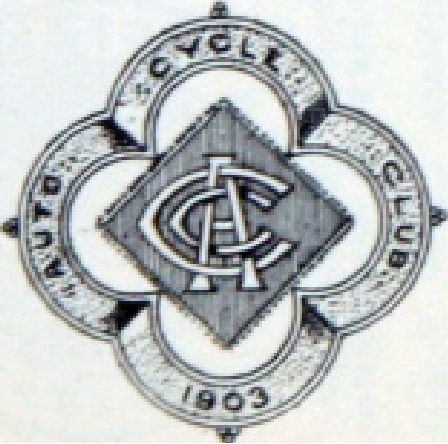
THE MCC HELD its first AGM; during the year membership rose from 20 to 109. Two competitions were held: a two-mile reliability trial, won by WJ Milligan on a Bradbury; and a passenger trial. The club also staged a run from Marble Arch to The Barn, Market Harborough, home of vice-president Edward Kennard JP, who gave them a damned fine lunch. The Motor Cycle noted: “Most of the riders were splendidly mounted on high-powered machines. Werners were much in evidence. Mr Van Hooydonk bestrode one of his now celebrated bicycles, fitted with forecarriage and a 2½hp Minerva motor. The new Clyde, 2¾hp Simms engine, made a brave show at hills, and under the skilful guidance of the vice-president well maintained its reputation for speed and power.” The Motor reported: “On Saturday, April 25th, about 15 members assembled at the Marble Arch at 2.45…The weather conditions prevailing at the start were perfect, the sun shining, and just a gentle breeze blowing…so much attraction did the machines create that the officials of the park came to the conclusion that the machines and their owners constituted ‘an unlawful assembly’, with dangerous intent, and as such requested them to move on beyond the precincts. Several other members joined the party at Barnet, and at 4 o’clock a start was, again made for Dunstable, via St, Albans. Tea was taken at The Saracen’s Head, Dunstable. Mr. Kennard said that he was delighted to entertain the club, and hoped it would be an annual visit. He regretted that, owing to the long journey hack to London, the members could only stay for a few hours. A start back was made at 3.15; but the weather conditions went from bad to worse, and beyond Dunstable towards London, the roads were rapidly becoming seas of mud; this. coupled with a pitch dark night and a blinding rain, the return home was a marked contrast to the outward journey. No mishap occurred throughout the run, rut minor incidents, such as punctures, were plentiful.”

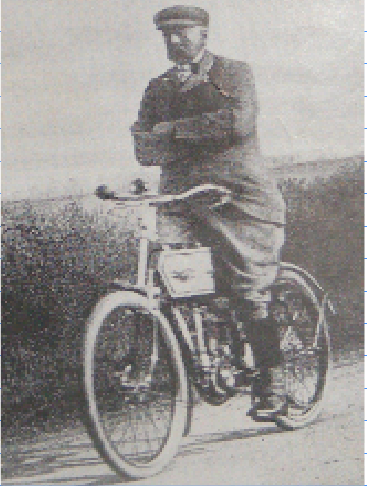
“THE SOUTHAMPTON COUNTY Motor Club had a very pleasant run on April 25th to Lymington, via Hythe and Beaulieu. Tea was taken at the Londsborough Hotel. The return home was made via Brokenhurst and Lyndhurst. The roads were found in excellent condition. The only mishap recorded occurred to the captain (Mr FP Hill). His inlet valve gave out, and, unfortunately, he had not a spare one at hand to replace it.”
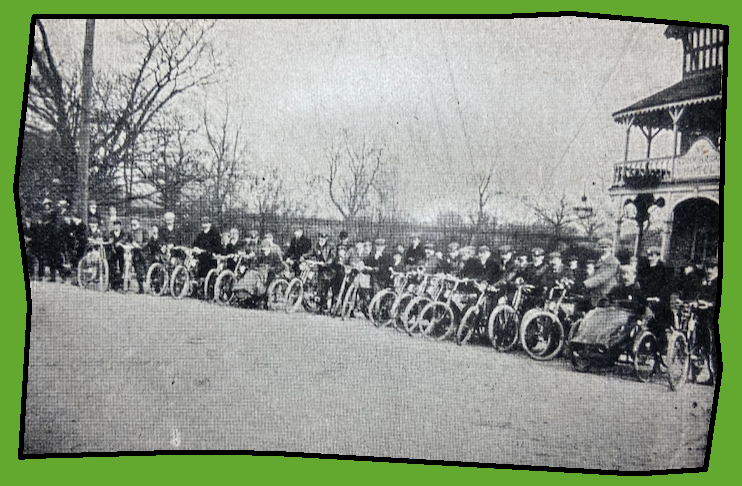
“IT IS VERY probable that the experience of the motor cycle match at the Parc des Princes has put a nail in the coffin of professional racing,” the Blue ‘Un reported. And it looked so promising. Rigal had been undefeated all season when Fournier challenged him to a mid-summer head-to-head. The race was duly arranged as the main event of a race meeting; the arena was packed and excitement was at fever pitch. “The match, however, proved to be the biggest farce that has ever been perpetrated on the public. Both men led alternately as first one then the other cut out ignition to let his rival pass; and in the final lap Rigal, it is said, stopped his engine and allowed Fournier to win by about fifty yards. For a moment it looked as if the Parc des Princes track was going to see a revival of the good old days when the enraged public were in the habbit of pulling up the railings and seats to make a bonfire; but happily they contented themselves with yelling and howling and trying to get their money back.”
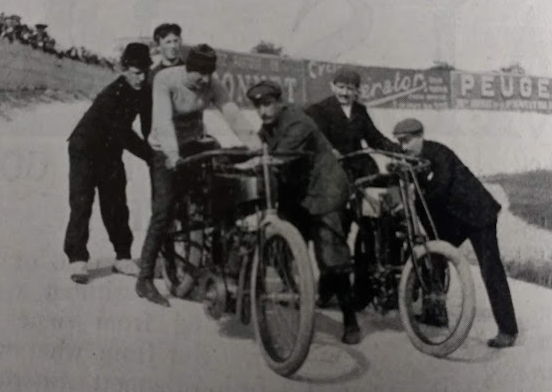
THE FRENCH WEEKLY MAGAZINE La Vie au Grand Air (Life in the Great Outdoors) reported: “Last week was taken up by an original event organised by our colleagues at L’Auto (The Car) at the velodrome of the Parc des Princes. It was the Quarter-Litre Criterium, an event reserved for motor cycles whose cylinder capacity, ie the volume of gas absorbed before the explosion, did not exceed 250cc—a quarter litre…It is known that up to now engines and vehicles have been classified according to the total weight of the machine. But the distinction of this weight, which at first seemed to be a classification of speed, soon became insufficient for this purpose. Thus we saw motor cycles of 50kg with engines capable of driving them at 100km/hr, first in Nice and then in Ostend..” Over to The Motor Cycle’s man on the spot: “Twelve started in the final, namely, two Peugeots, five Griffons, one each Antoine, Bruneau, Knap, Werner, and Lurquin-Coudert. Lanfranchi on a Peugeot easily led until put out by accidents. Result: 1, Knap, gear driven (rider, Mignard), time, 1hr 31min 11sec; 2, Star-Griffon (Champoiseau), 1hr 34min; 3, Star-Griffon (Jacquelin), 1hr 34min 34sec; 4, Star-Griffon (Louvet), 1hr 41min; 5, Star-Griffon (Demester), 1hr 54min. Mathieu on a Lurquin-Coudert, Bucquet on a Werner, and Bonnevie on a Star-Griffon also finished. The object of the French motor cycle trials was principally to ascertain the advantages of the different systems of transmissions by placing the machines on an equality as regards motive power: but not the leant surprising result of these tests was the power which makers got out of their engines with the capacity to which they were limited. Several engines were running at 2,500rpm and more; but further enquiries show that this is below the mark, as several motors ran at 3,200 and even 3,600 revolutions. There could be no doubt that during the trials the Griffons and Peugeots were running extremely fast. Lanfranchi’s engine gave an impression not of a motor pulsating, but of a turbine whirling. These fast motors were lubricated with a force pump. Whether this is absolutely necessary it is difficult to say, but it is certain that they require very careful lubrication. At one time it would have been regarded as impossible for a motor to run for an hour and a half continuously at more than 3,000rpm revolutions without decomposing the oil; but during the trials there was no trouble whatever with the motors apart from the ignition and the defective lubrication of one of the Moto-Cardan motors; and on the winning machines being inspected after the race, the pistons and rings did not show the slightest signs of wear. It is thus conclusively proved that these high-speed engines can run for a considerable time, but the trials have not shown whether the same results as regards relative power and speed can be obtained on the road. It would also be interesting to see whether these extremely high speeds are not obtained at the expense of a much higher consumption of petrol. The trial has raised a very interesting problem as to the efficiency and durability of high speed motors…Coming to the transmission systems, we find on analysing the machines that there were 56 belt-driven bicycles, 14 with chain transmissions, four Moto-Cardans (bevel drive), and three direct spur-driven Knaps. It is much to be regretted that the chain was not represented to the same extent as the belt; but on looking at the results of the trials, we can perhaps detect the reason for the partial eclipse of the chain. The first thing to be noticed is that none of the chain-driven Peugeots were able to finish their heats, while the belt-driven Peugeot of Lanfranchi beat the record for the hour. The question, therefore, may be raised whether the chain is at all suitable for very high speed engines. The bevel gear also had very bad luck. It showed up remarkably well all through the trials, and only failed through accidents. But for these it would undoubtedly have shown up in the final. The race has been a triumph for the ideas of M. Georgia Knap, who has for years made a special study of the motor bicycle, and has applied these ideas in a way to produce a bicycle of the simplest possible form. The Knap won because there was really nothing to get out of order. It did the laps. with the regularity of clockwork, and wore down machines that were perhaps faster, and finally vanquished the favourites with their high-speed engines. some of whom were going much less satisfactorily in the final than they did in the heats. In the case of Demester (Star-Griffon) at least this was because he fried to run his engine at a still higher speed than before in the hope of beating Lanfranchi’s record on the Peugeot…It cannot but be admitted that the winning in succession, and within such a short time of each other, of two such important events as the Haustgen Prize and the Criterium du Quart de Litre, is a tremendous score for the direct gear drive and, what is more, for the designer of the winning machine, Mr Georgia Knap. This will be all the more apparent when it is said that 50 of the best French makes were represented in the Criterium trial. Mr Georgia Knap is one of the most skilful French motor experts who has been working for some considerable time past at the production of a direct gear-driven motor bicycle in which he seems at length to have been completely successful. The engine in this machine is fixed to the back stay cf the bicycle frame, and geared direct on to a spur wheel on the rear driving wheel, a flexible coupling being at the same time provided between the gear and the hub by means of spiral springs placed inside the spur wheel, so that any sudden impulses of the engine are taken up by the resistance of these springs.”
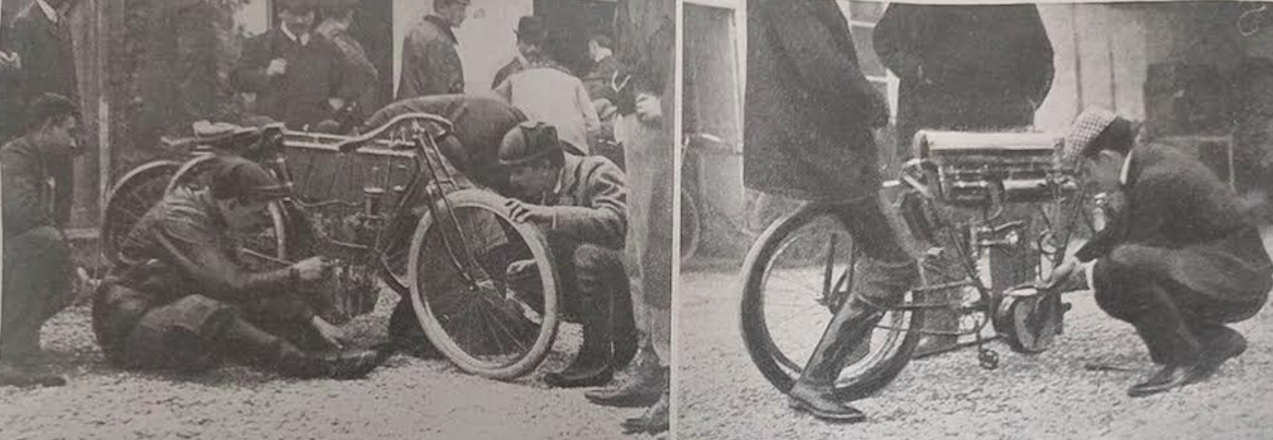
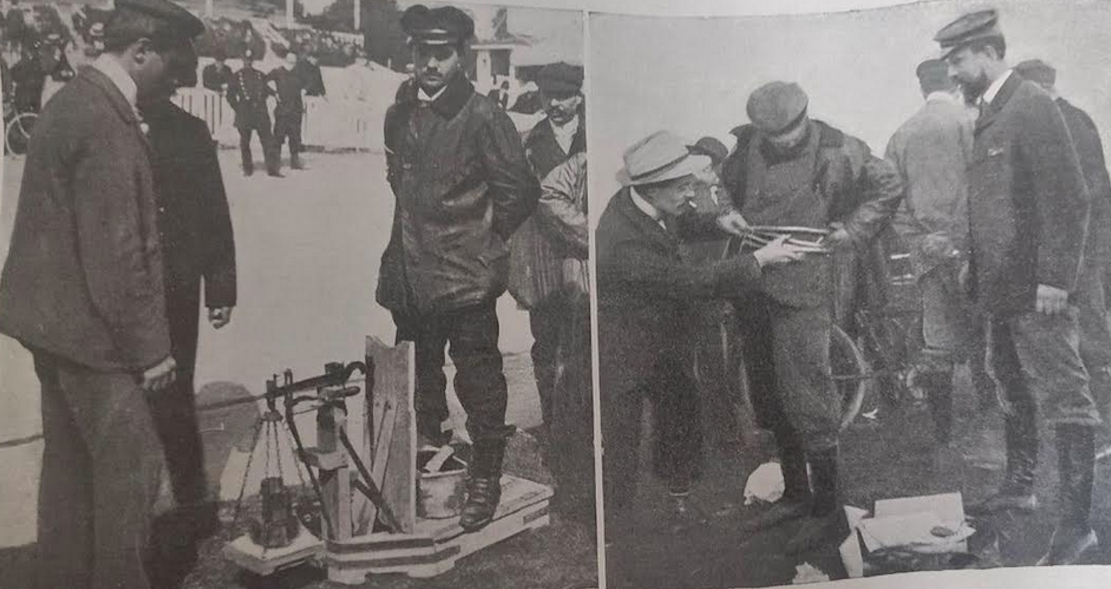

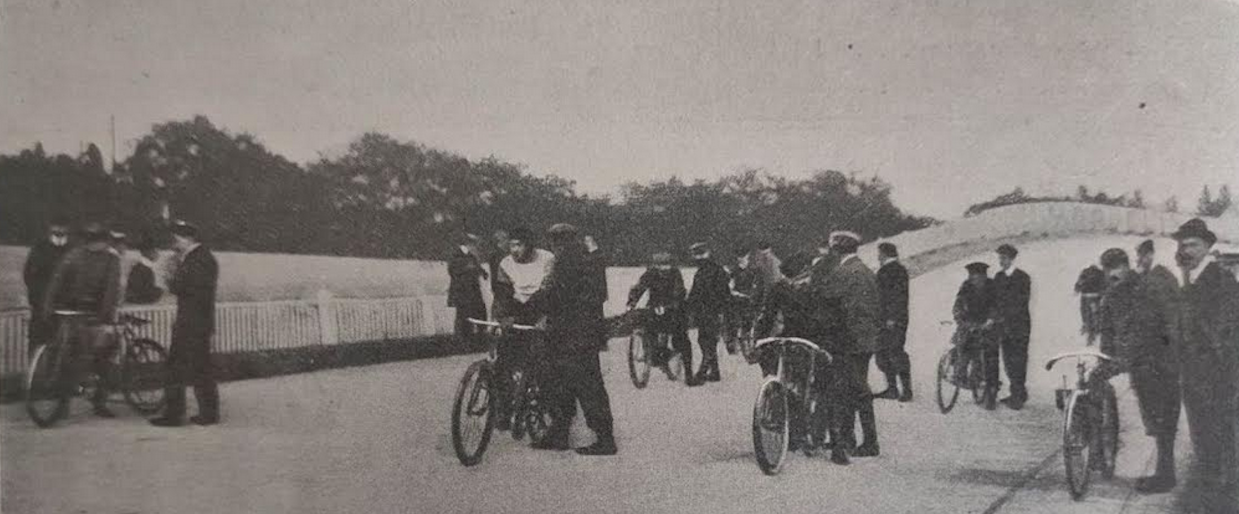
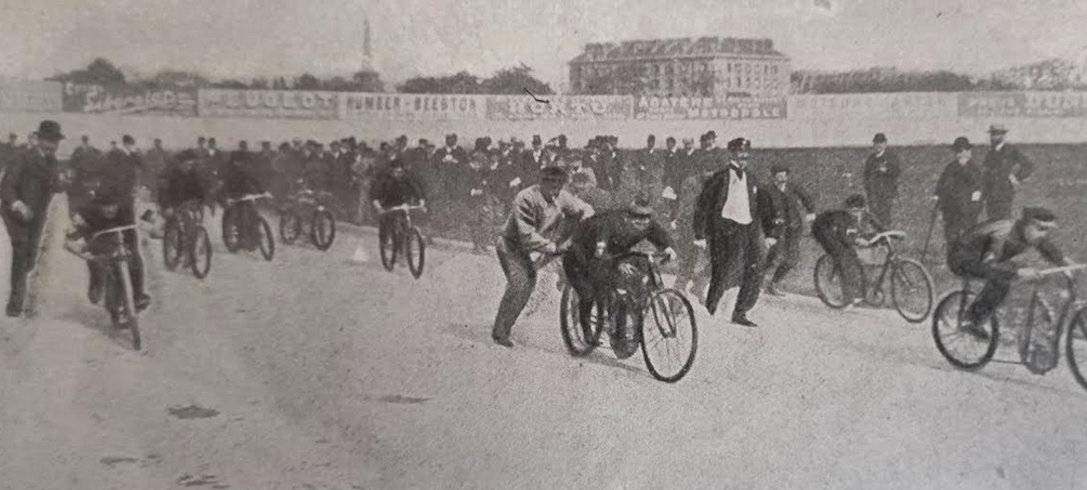
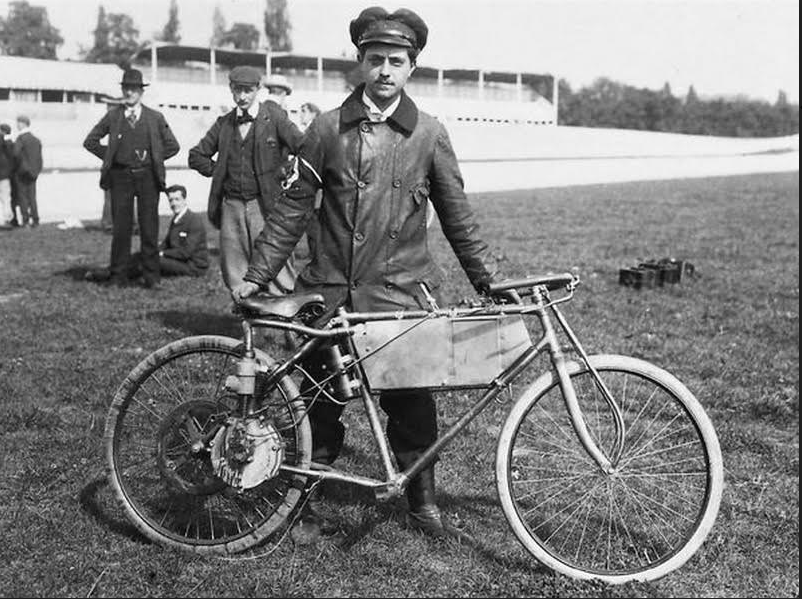
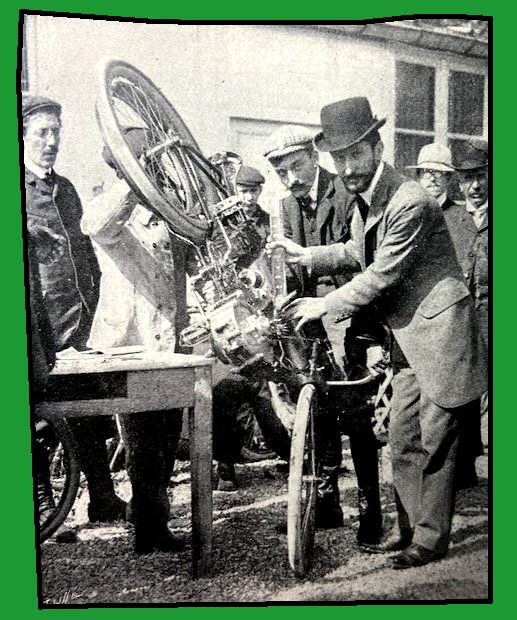
ACCORDING TO A CONTEMPORARY newspaper: “The astonishing speed of a mile a minute was attained by Cissac, the French rider, on the Buffalo track, Paris, recently, under circumstances which are somewhat amusing. Marius Thé, the wonderful successful motor cyclist, was defeated by Cissac in a race for motor bicycles, but, feeling dissatisfied, straight away issued a challenge to all and sundry. On the following day, while he was enjoying an after-dinner siesta, Cissac burst into his apartment, and, throwing 200 francs on the table, exclaimed, “I’ll take you on. Cover my money. We will run the race now, within 10 minutes.” He was not prepared just then, but Anzani, another rider, obtained permission from Thé to use his motor bicycle, covered the deposits, and the combatants forthwith adjourned to the Buffalo track, followed by an excited throng, amongst whom was Major Taylor. Sixteen horse-power motors were used. A terrific pace was set, the spectators, Major Taylor especially, becoming wildly excited. After a few laps had been run, Anzani, seeing his opportunity, shot down in front of Cissac, who in turn was obliged to go up the banking; Then he let his engine out, and covered three miles in 3min 11 sec, eventually winning the match. After claiming the 400 francs, he and his friends repaired to a cafe, where he regaled them with champagne. The leg-driven bicycle continues to get faster and faster, so much so that in the light of to-day the attainment of a mile within the minute does not seem to be without the realm of probability. As the best judges admit, it is almost entirely a matter of a good man and gilt edged pacing, and some day the right combination will be struck and the wonderful feat accomplished. It is interesting to recall that it is only a little more than 20 years since the mile was ridden in 3min, and less than 10 years since JS Johnson put the record at 2min. Only last month Walthour rode the last mile of five in lmin 12sec. The present record for the mile 1 min 16sec, held by Coete. Clearly Cissac had a need for speed!”
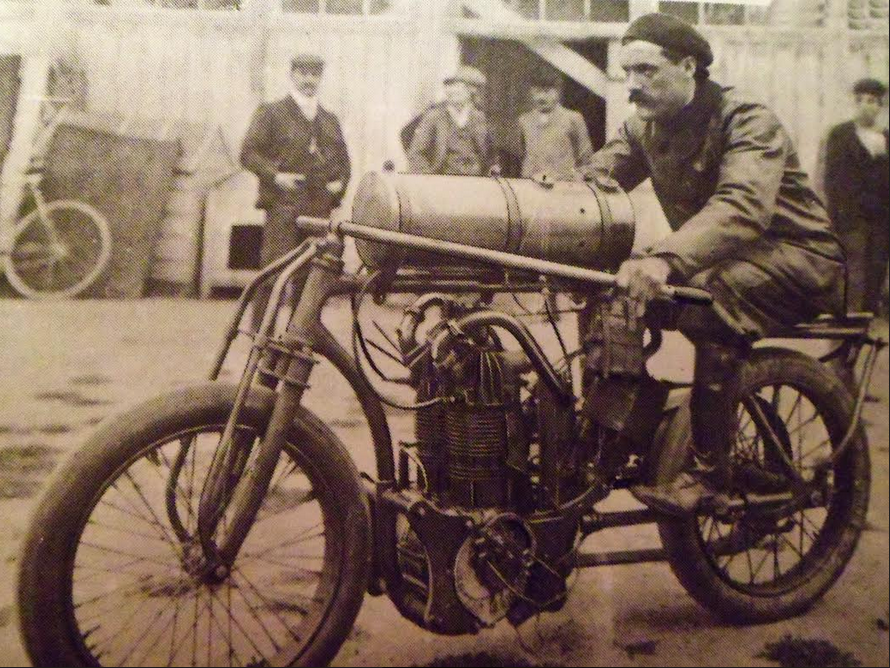
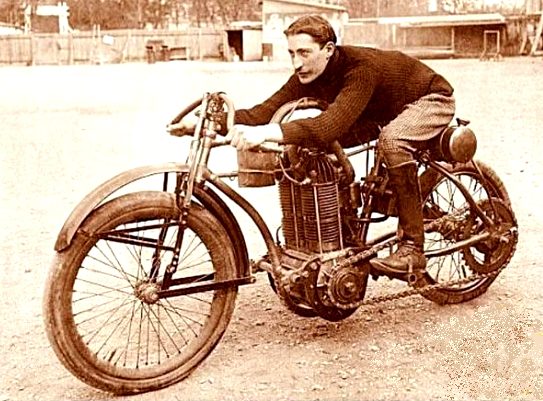
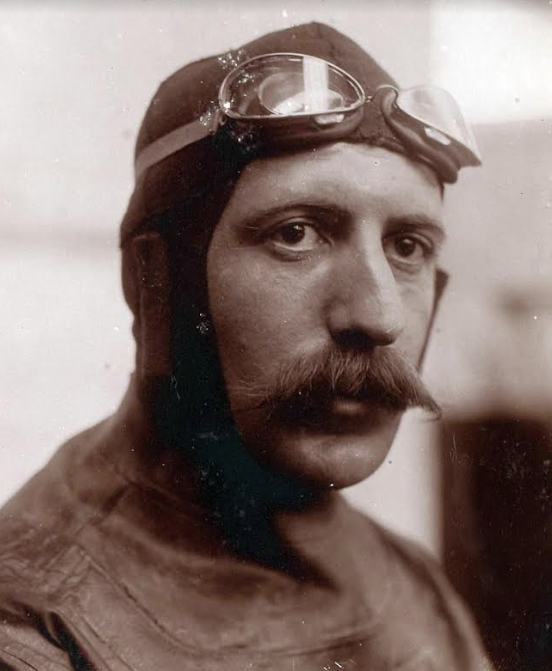
“WE THINK THAT motor cycle manufacturers should be careful into whose hands they place their racing machines, and if they allow powerful engines to be taken on the road they should see that they are fitted with silencers. While out last week end in the suburbs we met more than one maker’s amateur in full career, whose method of progression and governing or control of the machine consisted of switching on and off. Four reports similar to those produced by railway fog signals were sufficient to carry one of them through a crowd of people coming out of church, and the audible remarks passed on motor cycling were not by any means calculated to improve the welfare of the sport. If these men must take path racers on the road their employers should see that before being used for such a purpose they are fitted with silencers. There is nothing particularly heroic in scattering a congregation by means of a succession of rapid reports, and then switching off and on again.”
A HOT TOPIC for debate was the virtues of automatic vs the mechanical inlet valves pioneered by Mercedes in 1901 (an ‘automatic’ was in essence a spring-loaded flap).
French engineers Edmond Fouché and Charles Picard developed oxygen-acetylene welding.
“Now that the surrey magistrates have decreed that six miles an hour is an illegal speed for a motor cycle drawing a trailer, it is not unlikely that they will next turn their attention to the pedestrian. Cases of ‘furious walking’, perhaps, may next figure on the charge streets.

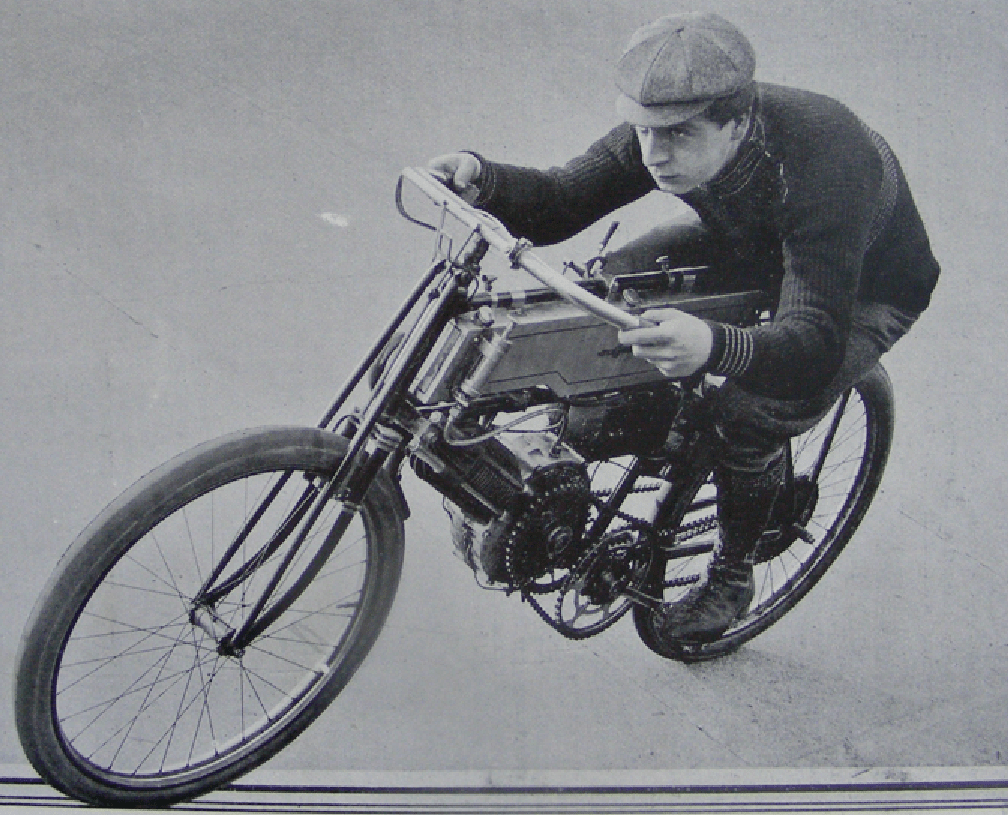
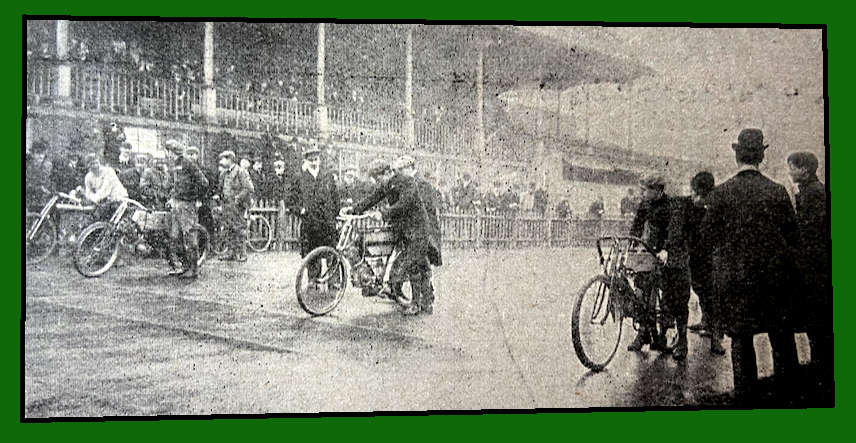
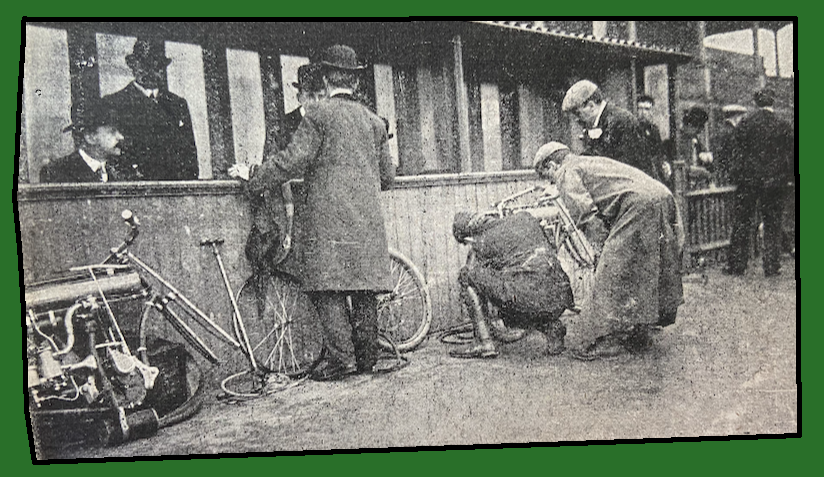
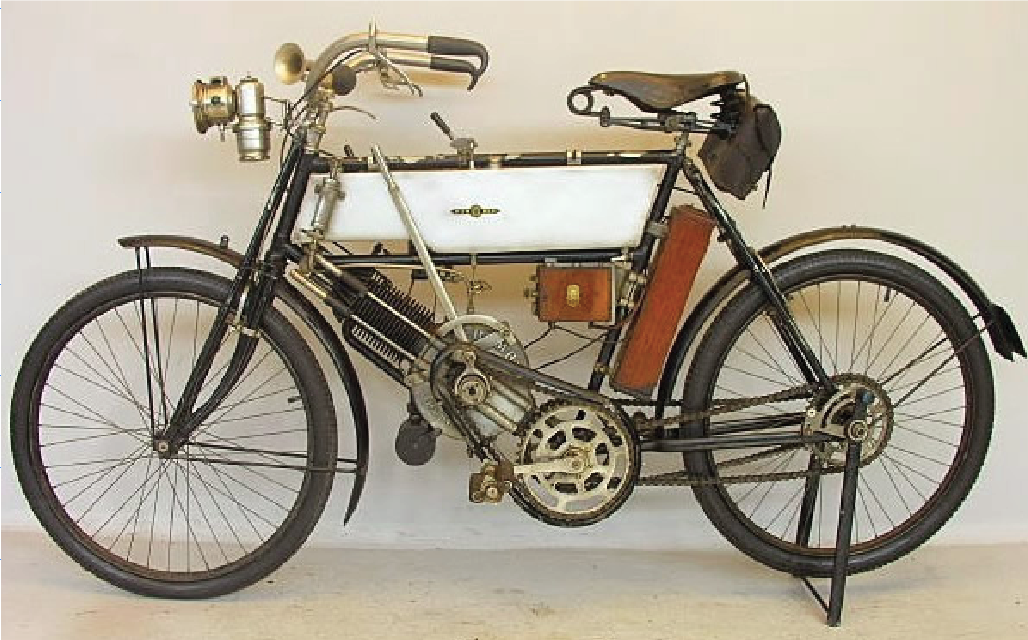
HARRY MARTIN’S SUCCESS—against French and Belgian aces as well as his fellow Brits—earned him the nickname ‘The British Bullet’. He was the first rider to exceed 60 mph on a flying kilometre (at the Phoenix Park Speed Trials in Dublin on a 2¾hp Excelsior). At the Gordon Bennett Speed Trials he became the first rider in the world to cover 60 miles in an hour.. Then he set a flying mile record of 58.5sec at Canning Town, where he also set a standing-start mile record of 1min 24.4sec. The Excelsior he rode at Canning Town featured the 8hp, 600cc MMC developed from the de Dion design.

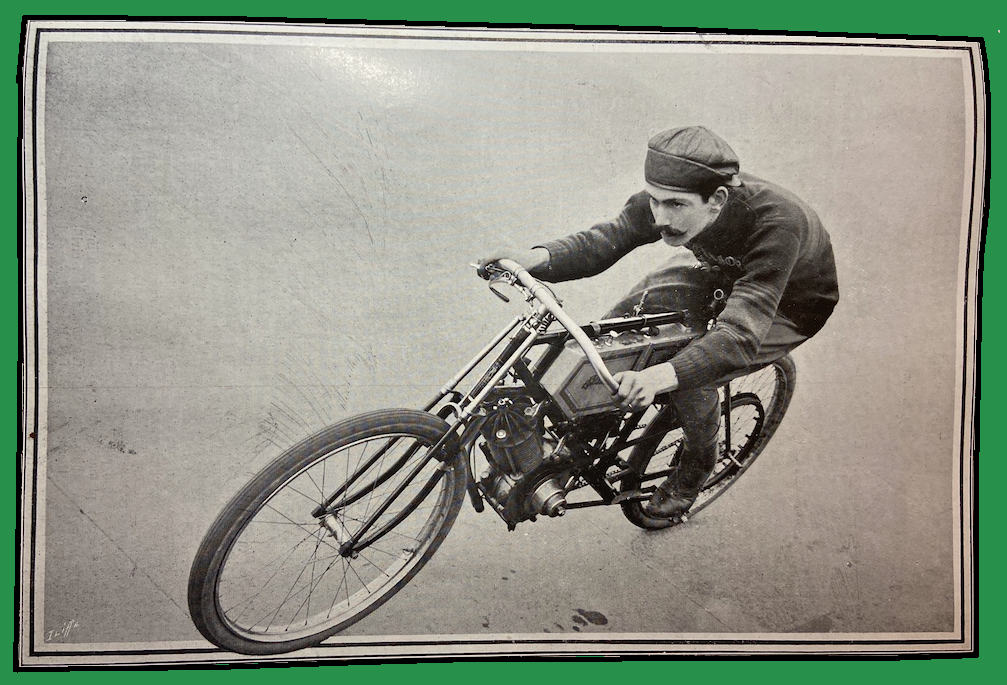
“RESULTS OF THE PHOENIX PARK Speed Trials. Motorcycles (full course, 2,853.6 yards). Competitors allowed to pedal for first 100 yards only. Class A1 (cycles up to 70lb); 1, CG Garrard (Clement Garrard) 2min 53⅗sec; 2, Bert Yates (Humber). Class A (cycles up to 114lb): 1, Andre Gommers (Gamage) 2min 6⅕sec; 2, JF Crundall (Humber); 3, TC Furlong (Werner). Class B (motorcycles up to 170lb: 1, H Martin (Excelsior) 2min 1sec; 2, S Wright (Excelsior); 3. H Prickett (Riley).
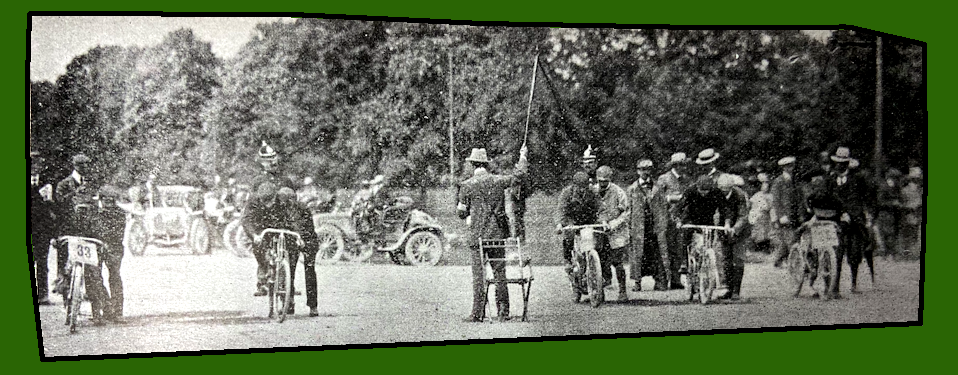
“MOTOR CYCLISTS have been considerably amused by an appeal made by a Member of Parliament in the House of Commons to the Secretary of State that he would take into consideration the desirability of establishing a force of motor cycle policemen, these men to be employed for restraining furious driving in crowded streets. It is evident that Mr Cathcart Watson, the member in question, is not a practical motor cyclist, and it would appear from the official reply that was given him that this fact was recognised, as it was simply stated that the matter would be left to the discretion of the police authorities. We would be the last to cavil at new uses for motor cycles, but we do not think any good purpose would be served by mounting police upon them in the way suggested, as it appears that the idea of Mr Watson is not so much the prevention of furious driving by horse drivers as the chasing of motor cars. In other words he would check one evil by substituting another, as it stands to reason if the alleged furious driver is to be caught the motor cycle policeman must ride at a higher speed still; and assuming the pace to be dangerous on the part of the motor cars, that of the policemen will be still more dangerous. As things are at present we do not think any good purpose would be served by the use of the motor cycle in crowded thoroughfares by policemen. On less frequented roads, of course, it has great possibilities, whether ridden by a police official or by any other person who is desirous of expeditiously getting over the ground.”

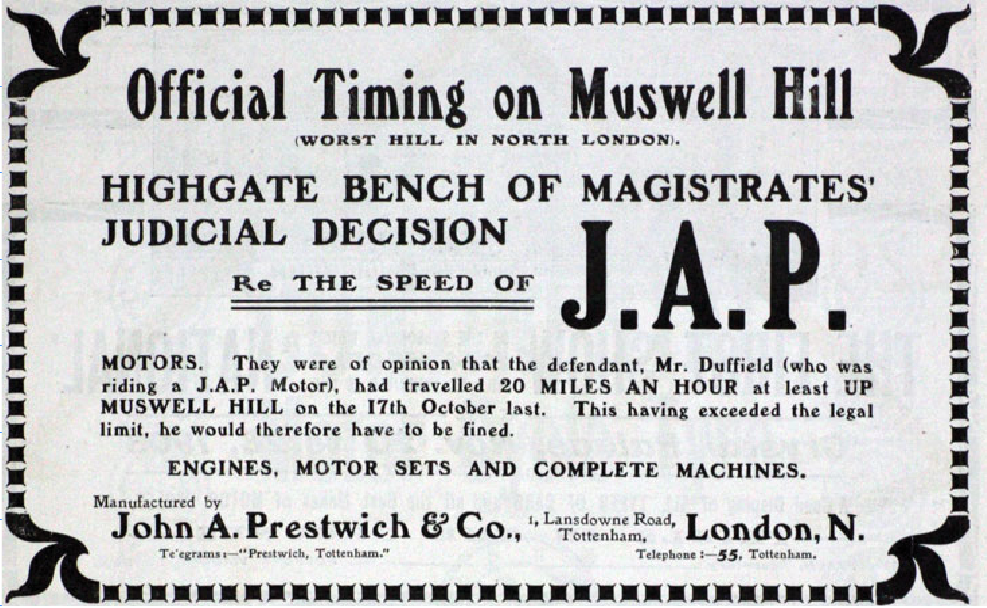
GOODYEAR PATENTED a tubeless tyre, but only for cars. A testimonial to Clincher A1 ‘self-sealing air-tubes’, claimed: “Nearly a thousand miles without a puncture!”
BAT FITTED rear springing; kits were offered to make rigid forks springy. The Sharp concern even offered air-springing for forks and frames.
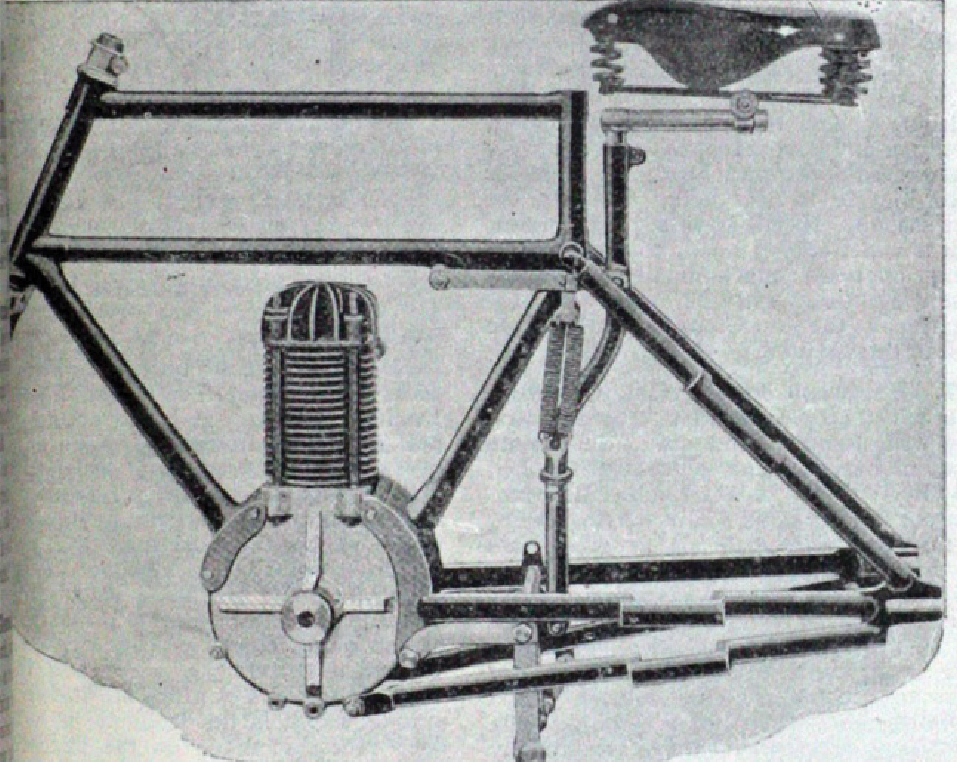
HAROLD ‘OILY’ Karslake built his dream bike, sourcing bits from chums and adverts in The Motor Cycle. A few years later he named the beast after Britain’s revolutionary battleship: Dreadnought. The frame was ex-Quadrant with a 3½hp MMC engine built to power a BAT trike. It dispensed with pedals; Oily later fitted a two-speed NSU transmission. Dreadnought had a successful career in verious competitions and was first bike away in the first London-Brighton Pioneer Run in 1930 ridden by George Brough. Oily bequeathed her to the Vintage MCC and she’s still ridden to Brighton every year by VMCC members. You can read all about her later adventures in the 1903 features section.

TOM SILVER made an end-to-end run on his 3hp Quadrant in 64hr 29min, knocking 1hr 16min of the time set by Edward Arnott the previous year. Raleigh staffer GP Mills designed and made a two-speed box and cut the record to 50hr 46min. [The full story of the End-toEnd run is covered in the 1911 features section].
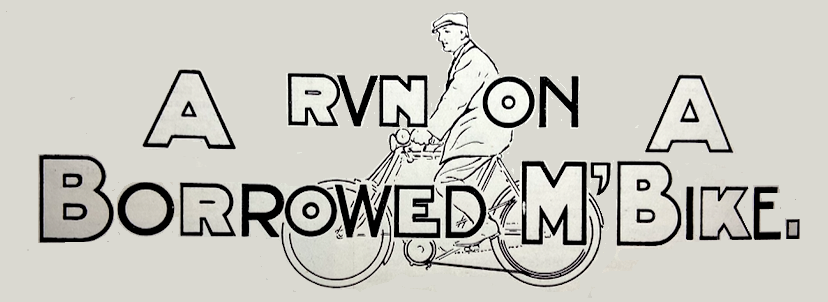
“WHIT WEEK AND NOTHING BUT a push bicycle to ride! Confound that enthusiastic novice who would insist on purchasing my motor bicycle just before the holidays. And doubly confound that kind friend who glibly promised to put a machine at my service, and as readily forgot all about it apparently. But stay! A ring at the entrance bell! The maid announces, ‘Please, sir, a dustman wants to see you in the hall!’ ‘Dustman!’ This is not the Christmas-box season—what can be his business, pray? Upon going forward—Ha! ha!! ha!!! so much for motoring togs—the alleged ‘dustman’ proves to be my worthy friend, who, as good as his word, has brought over his machine for my use for this day only, while he proposes occupying, for a change, a snug seat in the tonneau of a relative’s car. Good boy! I give him a hearty reception, a modest amount of liquid refreshment, and, after listening patiently to his numerous instructions upon this, that, and the other about this particular motor bicycle, I lend him my wife’s machine to ride back home on—for I am a reciprocal soul, mind you—and an incongruous spectacle he presents in all conscience pedalling away in his leather rig-out upon a lady’s machine. But, bless you! being a motor fiend his appearance is absolutely nothing to him—a sad state of things truly. Petrol is so demoralising. Before starting out I go over the points of the machine. which is practically new. The engine is a 2hp Minerva, with, of course, the mechanically operated inlet valve; wheels, 26in, with Clipper-Continental tyres; 24in frame; wide mudguards with forward extension piece over front wheel. duplex front forks; twisted belt; Bowden band brake on front wheel, and a back-pedalling ‘any point’ band brake on rear wheel. Now, I am particularly partial to band brakes, but not when operated by back pedalling. I think it much more comfortable and convenient to be able when riding to swing one’s feet into any position either backward or forward at will without thinking of the brake.
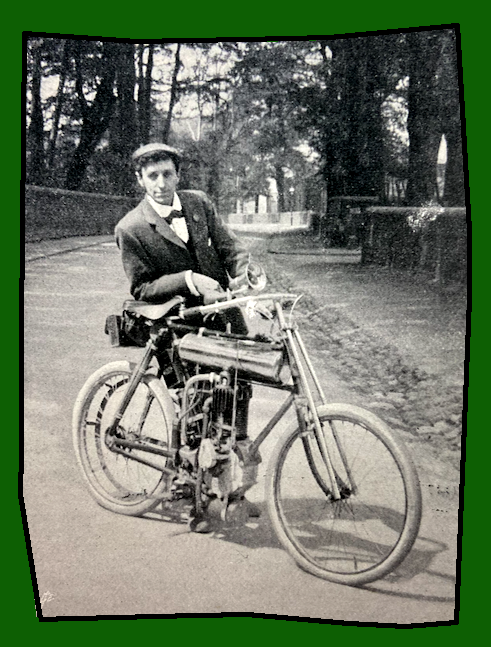
In addition to which one is always able to dismount by the pedal without fear of jamming the brake on hard and skidding the wheel, to the detriment of the tyre,. which can, easily happen. I have seen many an awkward scrambling fall this way, and on one occasion I remember the rider left a portion of his facial cuticle upon the granite kerb. However, we all have our fads and fancies—fortunately so, perhaps. Everything about the machine appears to be in perfect trim. My friend has assured me the accumulator is freshly charged, the petrol tank is full, as the float rod indicates, and there are numerous spare parts in the toolbag; so I don my coat and gloves and set forth cheerily. Except for a dust-laden wind, the weather is perfect, the sun shining brightly and roads in good order. With switch handle screwed home, connecting plug firmly in position, and throttle open, at the second stroke of the pedals the bicycle commences to fire feebly, although I have not yet touched the lever retarding the spark and actuating the exhaust valve lifter. This indicates a need of adjustment, as it is not a well-regulated exhaust lift that allows sufficient compression in the cylinder to enable a charge to fire even feebly with lever right over. I dismount and tinker with this somewhat, but am unable to obtain complete satisfaction. Remounting, in a few minutes I quickly clear the tram terminus at Purley, and bowl along at an enjoyable speed towards Foxley Hatch, at one time one of the most lovely specimens of Surrey scenery, but now, alas! the undulating upland pastures are dotted with numerous villas. But the Philistine builder has been less unkind than usual, and a certain daintiness hovers o’er the place even now. Picking my way at half speed through the new patches of stones, a turn to the right brings Wallington—the home of sweet lavender—into view. Unfortunately, having omitted to advise the good folks of my intended visit, I find the prevalent odour to be that of fish manure; but let us not be unduly critical, or people may object to the smell of burnt oil. A fine run down past the station, through winding lanes, past the Hackbridge Dogs’ Home (would that every dog were there), and past Mitcham golf links, leaving, sundry agitated persons in red coats busily occupied in raking among the furze with hockey sticks for mushrooms. More mazy turnings, round some of which awkward contretemps are narrowly escaped owing to the incapacity of the holiday bikist and my inaptitude with the Bowden brake lever which is on the left hand, and unusual with me. Meanwhile, the little engine throbs contentedly along at moderate speed, the spray carburetter exhibiting a commendable attention to business. ‘The George’ at Morden. In obedience to the ‘advance spark’ my steed dashes away at an exhilarating speed, and my eyes stream with water owing to the pace and strong wind; but the goggles have been left behind, so this inconvenience must be borne. Through the Splash. Easy now! The ‘Spring at Ewell’. A detour via Hook taking en route the ‘splash’ which crosses the road at an abrupt turn. Two cyclists call out to me, ‘Go ahead! the splash is nearly dry,’ Spoofed! I rush forward to find I am plunging through at least a foot of water. which cascades all over me and the machine, while those unveracious cyclists grin hugely. Pushing forward at full speed in order to top the steep hill before me, my mount here proves its climbing capabilities, surmounting the brow without assistance from the pedals and with very slight retarding of the ignition. The road becomes somewhat bumpy, and an unpleasant clang-clang in the tank commences to get on my nerves. Now people are apt to think that, because a motor bicycle is by nature noisy, a little clattering and banging about of the accessories can make little or no difference to the comfort of the rider. In my case, while I absolutely enjoy the ” ‘purr’ of the engine, any noise, such as a commutator rod rattling against the tank, or the accumulator jumping about, is as irritating to my nerves as the sight of the tax collector. I find
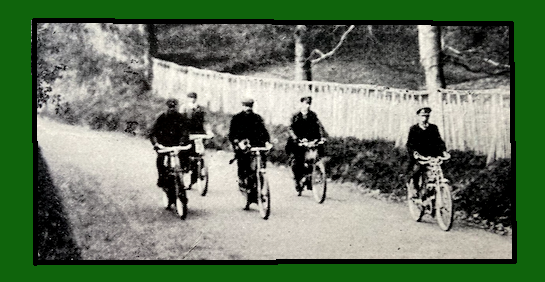
the ‘clanging’ in question proceeds from the float in the petrol tank washing about and knocking against the sides. This is not only damaging to the float itself, but is likely to cause a leak sooner or later. A little thought, and I improvise a simple cure by passing a short piece of butt-ended spoke which I find in my toolbag down the top of the projecting float rod; when the cap is screwed on the float is held firmly down and the noise ceases. Through Claygate—aptly named—and out by ‘The Bear’ at Esher on the Portsmouth Road. My ride so far has been a somewhat lonely one, but I find the famous highway alive with cyclists, motor bicycles, and cars galore. Beyond Esher Hill I essay putting a charge of lubricating oil from the oil tank into the crank case; but the pump, fitted with a ‘two-way’ tap is fixed on the seat-post tube under my left thigh where it is almost out of my reach and quite out of sight, so I merely succeed in getting my hand smeared with oil. I dismount and inject the necessary charge of lubricant into the engine. The union of the pump tubes is a somewhat bad fit, and a lot of the oil exudes and makes an unsightly mess on the frame and mudguards; but this is a detail. ‘Horseshoe Clump’, ‘Fair Mile’, ‘Cobham’, and likewise ‘Pain’s Hill’ are negotiated in style, the engine responding to every touch of the levers in a most admirable manner, and I congratulate myself upon my freedom from trouble and worry—two commodities not unknown to the motor cyclist, especially when out on a strange machine. Flying down the road near Wisley Hut, there is a sudden cessation of the explosions, and with some amount of interest I search systematically for my steed’s sudden ailment. M’yes! compression good, therefore nothing wrong with valves! Carburetter floods readily by agitating float—not choked evidently. Hullo! no spark at trembler, and naturally enough, for the wire is broken away from a terminal. To remedy this is easy, so I am away again. The famous Ripley—with its discreditable police trap—is.now at hand, so I steady down to walking pace, as do also two cars just ahead of me. As we cross the bridge into the village, a police officer, clad in plain clothes and equally plain foot gear, is seen standing with
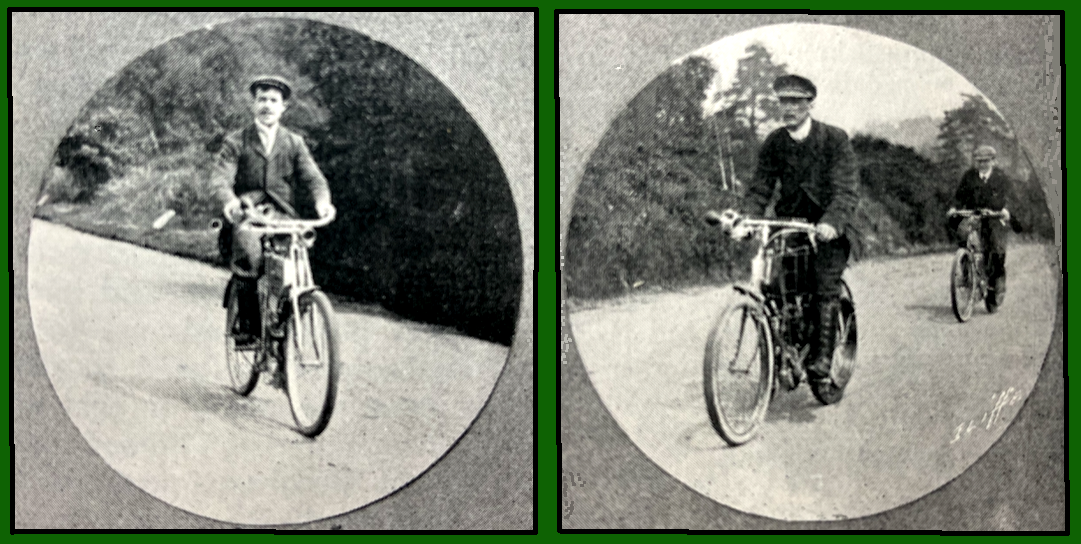
Waterbury* in hand, and there is doubtless a constable hiding at the other end of the village. But the 176 yards of measured road have no attractions for us just now, and we pass the watchman at 1mph, ironically saluting, while anxiously enquiring the exact time of day. Strange that we, a spirited, self-governed people, pay the police thus to waste their time. Away from this unpleasant scene, and out on the open highway towards Guildford. The pace increases, the cars disappear ahead, and I am over-taken by a morocco-bound, begoggled effigy. The scarecrow one and I fraternise and exchange criticisms on motor matters until, becoming impatient, he leaves me. Guildford, with its old-fashioned gabled shops and overhanging clock, is reached, and halfway down the steep descent I halt for a light lunch. I stay sufficiently long for my engine to cool thoroughly—so much so that I find my piston stuck fast on attempting to restart. A drop of paraffin, of course, will remedy this at once; but where is the necessary aperture for injection? Missing! What an oversight! True, I can take out the sparking plug or plug bolt in the top of the head, but what an unnecessary nuisance. The plug, however, is removed and replaced, and I start back towards London, branching off to the right when clear of the ‘kidneys’. for ‘Merrow’, the ‘Clandons’ and ‘Horsley’. Hereabouts my belt is slipping badly, and the engine is racing in consequence on some of the steep shoots, so I run the belt off the pulleys and give it a twist or two; but getting it on again is a matter of considerable difficulty, for the stays are built so close to the rim there is no room for the belt to run on at the top in the usual way, and it cannot be got on the bottom because machine will not wheel backwards owing to the back-pedalling brake. However, without loosening the back wheel axle nuts or disconnecting the brake, I manage to force the thing on, although in doing so I notice the engine is forced out of position to one side. Examination shows the clamp nuts to be very loose, so these are tightened up to avoid further trouble. I also find the oil feed pipe leading from the oil pump to the crank case is actually touching the belt, and as the said pipe is smothered with leaking oil, of course the belt gets liberally anointed also, so this pipe is bent back out of the way. A wild rush down Bookham Hill, a steady climb through Leatherhead, and over Ashtead Common Hill like a bird, to the unconcealed envy of the occupants of two low-powered cars which are scrunching up laboriously. There is no mistake about it—a car for comfort perhaps, but a bicycle for speed and climbing. A sharp look-out for wily bodysnatchers in Epsom town, then away to the right on
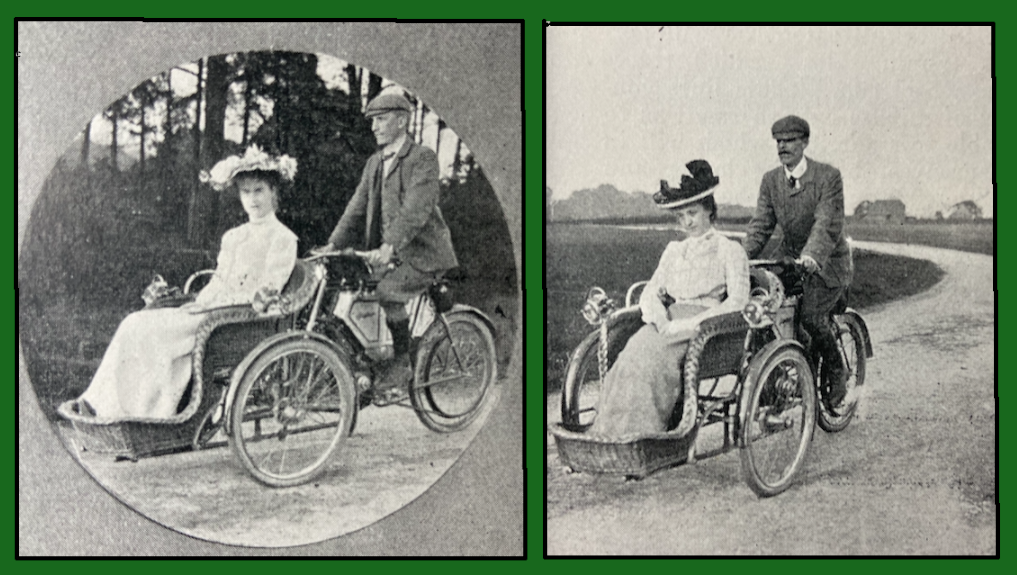
to the breezy Downs, leaving the racecourse on my right, and here presently is Cosmo Bonsor’s country seat at Kingswood Warren. A beautiful country this, but a trifle dusty just now. A halt on the top of Reigate Hill to admire one of the finest views in the kingdom, a discreet negotiation of the winding descent into the town, and then a magnificent straightaway run over the undulating roads to Crawley, where I look in on the Jovial Terry, and imbibe the cup—that is to say, the tea—that cheers; what time a violent storm descends on the place, and as rapidly clears off. Now back towards Croydon, bearing away to the right at Povey Cross, near which a fiery untamed horse challenges me to an impromptu game of ‘hop-scotch’ which I decline in some trepidation, and leave him as he is trying to climb into the sky with the rider’s affectionate embrace round his neck. Dangerous quadrupeds, these horses. We shall never be safe on the road until they all have to carry a number on an enamelled iron plate 3ft square; for purposes of identification. On Earlswood switchback my trusty engine falls unaccountably weak, though firing regularly, and I pedal frantically in order to surmount the first rise. Once over the brow it gathers speed, but at the next incline falls away to stalking pace, and then stops exhausted. This is puzzling. I pronounce a benediction and investigate. Here is the cause right under my nose—the plug in the top of cylinder has jarred loose, and can be turned with the fingers. The spanner is a bad fit but I manage to tighten the nut, and the engine starts up as strongly as ever. A swoop round Gatton Corner, and the engine again stops suddenly. No need to search for the cause this time, for there is the high tension wire which has come adrift from the coil, dangling on the hot engine. Faugh! An easy repair, so on past the Feathers at Merstham, travelling well, picking op en route a facetious youth on a 3hp mount who enquires if I want ‘sewing up’. An affirmative reply sets him swooping ahead over the hill, but to his chagrin I overhaul him on the run down to the ‘Old Man’s’ at Coulsdon, which should not be surely, yet he is ‘all out’. A teeth-chattering ride along Smitham Bottom, once more I hear the ‘ding-dong’ of the electric Juggernauts at Purley Corner, and so home. Analysing my day’s experiences, I index the following for reference: That an exhaust lift actuated by a Bowden wire from the handle-bar, so that the valve can really be lifted to its full extent independently of the spark lever, is a sine quâ non. That the place for an oil pump is forward, where you can both see and reach it comfortably. That wire ends at terminals should be neatly twisted, soldered with resin flux (not spirits), and held with two nuts. That Hooydonk’s paraffin injector valve, or some other provision for the same purpose, is indispensable. That I have no use for back-pedalling brakes, which do not permit the machine to be wheeled backwards. And that, above all, motor cycling is the thing. All of which, of course, I knew before.”
Archie Barr.
*Archie mentions a cop holding his ‘”Waterbury”; it seems that bargain-basement Waterbury pocket watches were so common that “Waterbury” evolved into a generic term for a watch—Ed.
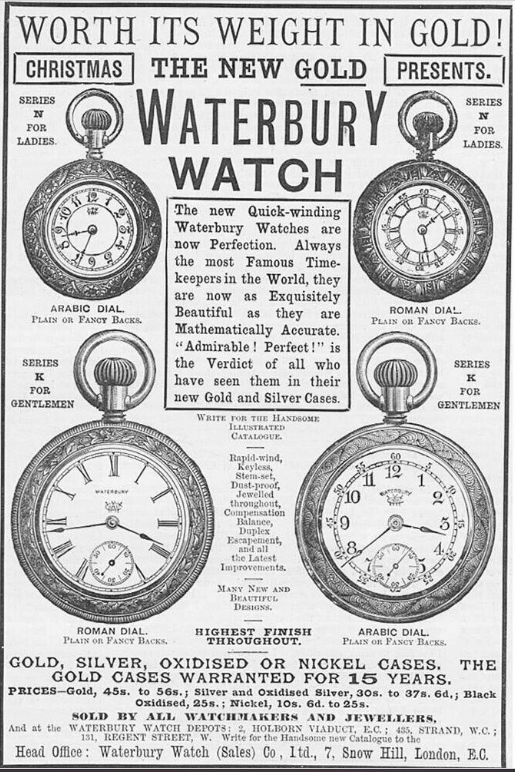
THE AUTOMOBILE CLUB of St Petersburg staged a road race; three of the motor cycle classes were won by FNs leading one pundit to remark: “As the course over which the three races in question were run was on a Russian high road, we think that to those who know how bad the Russian roads are, this will speal volumes for the reliability and strength of this make of motor bicycle.”
THE PHOENIX SURFACE CARBURETTOR incorporated baffle plates and a large surface area; the manufacturers claimed: “No amount of road bumping will upset or even alter the mixture…a constant level is maintained owing to the petrol tank being absolutely airtight, so that as soon as the petrol in the carburetter falls belopw the air pipe, a further supply from the tank is admitted,,,The silencer is placed close to the carburetter, and this keeps the petrol at a sufficiently warm temperature…[the carburettor] cannot choke, stick or flood.”
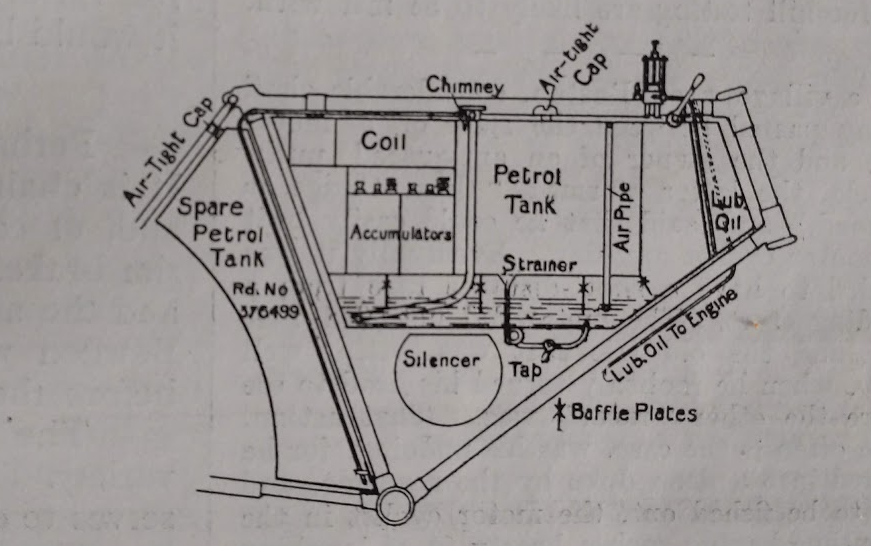
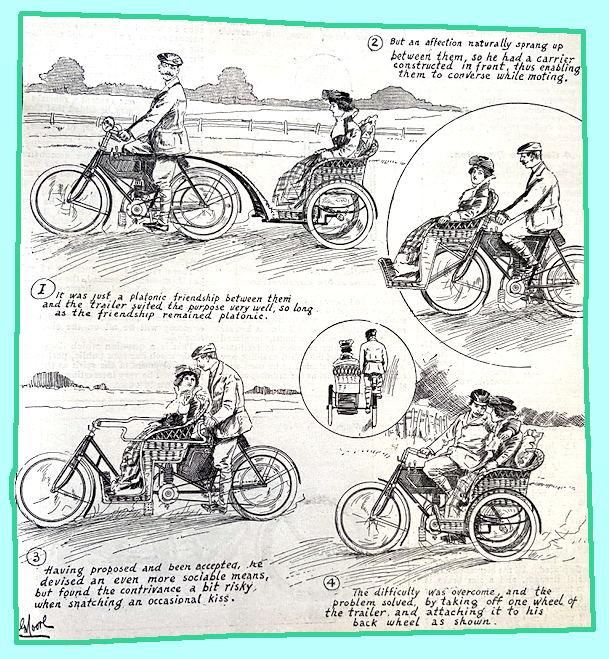
“GRAHAM BROS, THE PARADE, Enfield Town, are now supplying the ‘Liberty’ Sociable Attachment for motor-bicycles. This is a well-finished little carriage, readily attached by stays and clamps to a motor-bicycle in such a manner that the two riders sit side by side, instead of one behind the other, as with a fore-carriage or trailer. The makers claim that it is particularly safe to ride, and impossible to turn over, and soon attached or detached from the bicycle. It can be supplied suitable for BSA, Components, Ariel, Minerva, Eadie, Perry and Chater-Lea motor-bicycles. It has a ‘Liberty’ 2in motor-bicycle tyre. Price £13 13s.”
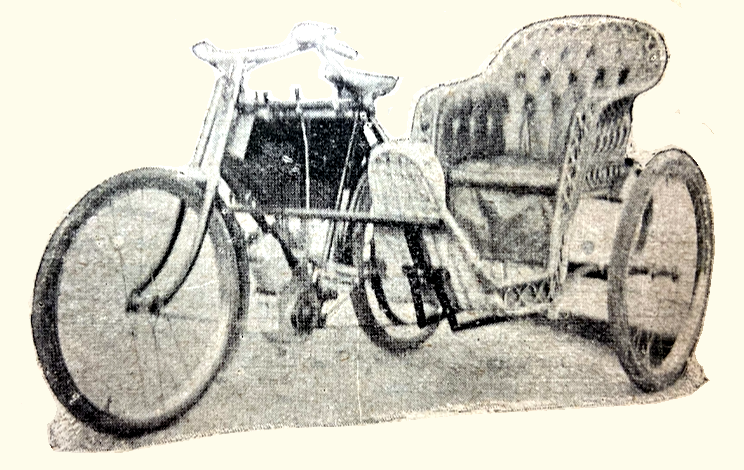
ALONGSIDE ITS PICTURE OF the first ‘sociable’ Motor Cycling reported: “An Iowa motor enthusiast has devised an attachment for motor bicycles for carrying an extra passenger or two, if the motor is sufficiently powerful. The device is rigidly attached, being secured to the bicycle at three points. The designer claims that it is perfectly satisfactory in practice, and is almost devoid of side draught. It appears from the illustration to have rather too ‘wide a tread’ to be suitable for crowded roads.”
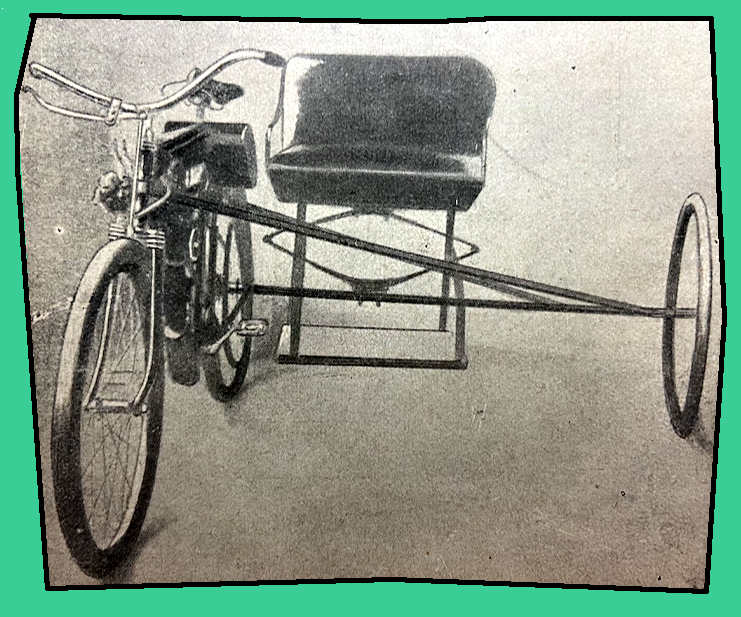
HISTORY RECORDS THAT FRED Graham designed and patented a sidecar which was made for him by Mills & Fulford. The Motor Cycle later reported: “…we made our first trial trip on a sidecar built up by the inventor of this popular attachment, Mr Graham, of Enfield. We were so pleased with this method of carrying a passenger that very soon after we ordered a sidecar from the Ariel Co, who started to manufacture under licence from Mr Graham.” Other firms including Liberty, Montgomery and Trafalgar, also claimed to have built the first sidecars; the Liberty Sociable was the first to be widely advertised. In any case one Richard Tingey had built a chair-on-a-wheel for his bicycle some years earlier . The Motor Cycle reported: “Messrs Mills and Fulford, who were the pioneers of the motor cycle trailer attachment, and whose sidecarriages and forecars have been so popular during the last year or two, have lately turned their attention to the flexibility of the sidecar attachment. The novel point consists of connecting the sidecar wheel by means of steering rods to the front wheel of the bicycle. The inventors have so set out the steering levers that when the front wheel of the bicycle makes a certain curve, the angle of the sidecar wheel describes the exact radius required to follow it without putting any side drags upon the wheel. This is one of the most practical improvements in sidecar design which has yet been introduced.”
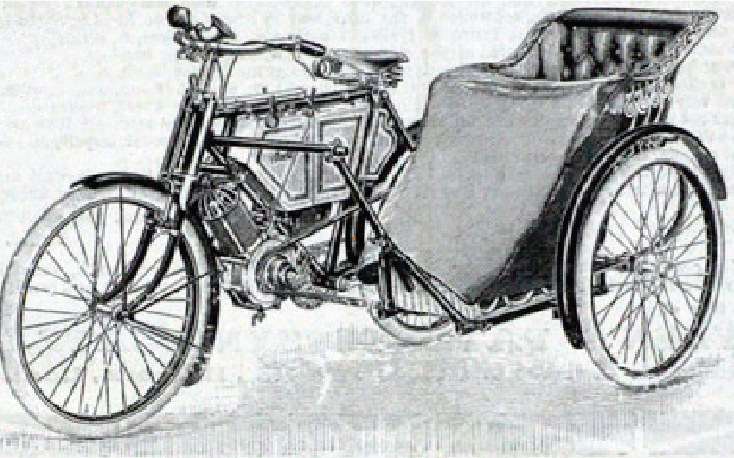
“FOLLOWING UPON THE FIRST, the ‘Liberty’, invented by Messrs Graham Bros., of Enfield, comes another side-carriage called the ‘Trafalgar’, designed by Messrs. Lyons and Co, of East Street, Baker Street, London, W. In order to attach this, a tube is fitted to the motorcycle on the back axle, fastened by the usual nuts, really forming a continuance of the chain stays round the back wheel. Another tube from this to the seat pillar bolt makes the preliminary frame-work rigid. It is proposed that these portions shall remain on the bicycle, as they do not interfere in any way with ordinary riding. When the side-carriage is to be used it can be fitted in two minutes. It is placed in position, and when two butterfly screws are twisted tight the vehicle is ready for its passenger. The connection is sufficiently flexible to allow the bicycle to remain a bicycle so far as steering is concerned, the rider being able to lean to the right or left, according to the turn he desires to take. A short spin through traffic convinced us of the practicability of the invention. It answers equally well with the side-carriage empty.”
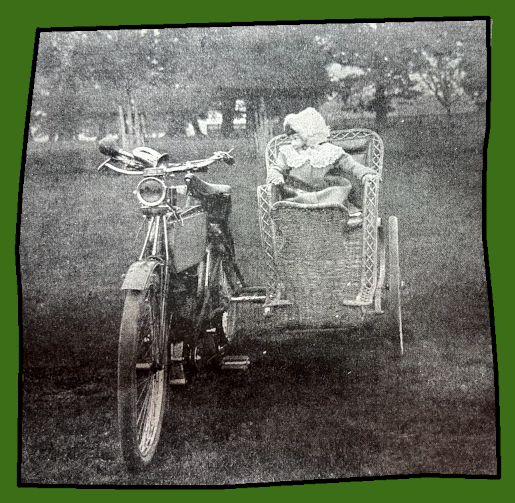
“THE ‘TRAFALGAR’ MOTOR-BICYCLE is manufactured by Messrs Lyons and Co, East Street, Baker Street, London, W, the patentees of the ‘Trafalgar’ side-carriage. The fittings for the purpose of fixing the side-carriage are permanently attached to the machine. They consist of a continuation of the chain stays round the back wheel, and a tube from this to the lug of seat pillar. The motor is of 2¾hp, the carburetter is a Longuemare, with throttle operated by ratchet lever on the top tube. Exhaust lift on left handlebar by Bowden lever and wire. This also cuts off current at a certain point. There are front and back rim brakes actuated by levers on the right handle-bar; these can be operated separately or together as desired by use of one hand only. Other details are a brush contact, trembler coil and spring. seat pillar. The price is 38 guineas, or with 3¼hp engine £2 10s extra. The plan shows the metal under-frame of the side-carriage. The connections are two, each fastened by an ordinary nut and bolt. There is no front bar. The side-carriage can be fixed or detached in two minutes. A special point is that the axle of the side-carriage wheel in 7in behind the axle of the bicycle wheel. This was found to be the best practice by experiment to give easiest steering. The flexibility of the connections is sufficient to allow for the curve of the road and any ordinary obstruction, so that if the side-car should pass over a brick, the bicycle rider does not feel the bump, and vice versa. The combination steers exactly like a bicycle; the rider leaning over to right or left when rounding corners. It can be ridden without a passenger, the writer having driven through miles of London traffic with the carriage empty, on the first occasion that he used it and also since. With regard to side-slip, this risk is eliminated provided a passenger is carried, but without one there is a possibility in grease, about equal to that of an ordinary motor-bicycle. Over an extended trial it was found to be a perfectly practical conveyance. The price of the side-carriage is £8 6s upwards, or motor-bicycle and side-carriage complete £48 6s. This latter sum secures the £10 10s pattern side-car.”
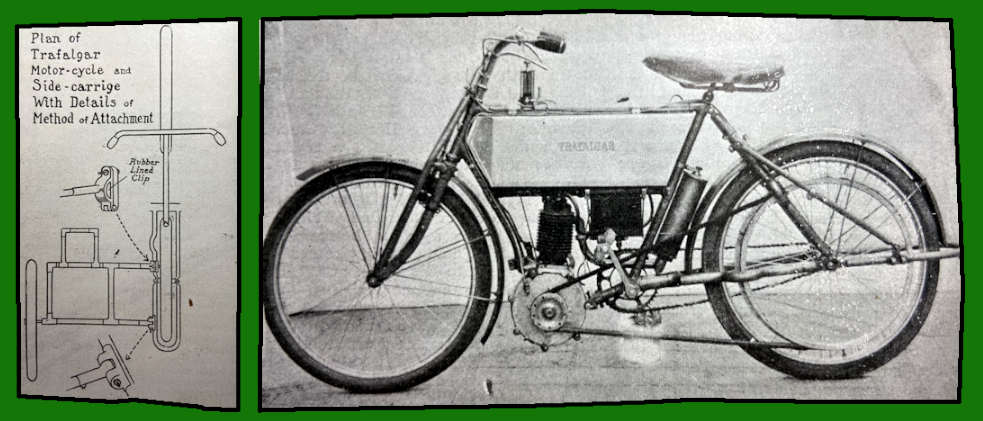
“A SIDE CARRIAGE ATTACHMENT for a motor-bicycle, embodying some special features, has just been introduced by Messrs G Featherstone and Sons, 234, Bethnal Green Road, London, E. The framework is specially designed to stand excessive strains, being of a double tubular type, and the whole well stayed, making same extremely rigid. The body is sprung on double C-springs and coil springs at the front, absorbing all vibration and making same extremely comfortable. Means are provided for adjustment of the driving band or chain without interfering with frame of attachment. The axle carrying the wheel of side carriage is made of the very best steel 1in by ¾in.”
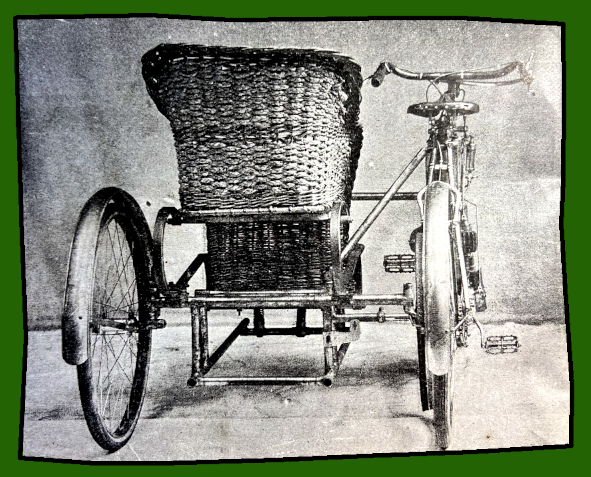
MESSRS MILLS & FULFORD, who were the pioneers of the motor cycle trailer attachment, and whose sidecarriages and forecars have been so popular during the last year or two, have lately turned their attention to the flexibility of the sidecar attachment, and have patented the idea which we show here. It will be noticed, on reference to the illustrations, that the sidecar occupies a much more forward position than usual in relation to the bicycle. The attachment of the sidecar frame to that of the bicycle is practically the same as those of the rigid pattern which Messrs Mills & Fulford have previously supplied. The novel point in connection with the design consists of connecting the sidecar wheel by means of steering rods to the front wheel of the bicycle, which can be clearly seen in our illustration. The makers inform us that they have made several experiments between the rigid sidecar and this pattern, and in every case they found that the rigid attachment required more power to propel it than the new one. The first question that will be asked is, Does not the position of the sidecar wheel necessitate a different turning angle from that to the steering wheel of the bicycle? This has been provided for by the inventors, who have so set out the steering levers that when the front wheel of the bicycle makes a certain curve, the angle of the sidecar wheel describes the exact radius required to follow it without putting any side drag upon the wheel. After a careful examination of this new invention, we think that all those of our readers who have had any experience with the sidecar will agree with us when they see it that this is one of the most practical improvements in sidecar design which has yet been introduced. We say this all the more confidently from the fact that up to the present the only thing which militates against the growing popularity of this form of motor bicycle attachment is that a certain amount of difficulty is experienced in turning corners, particularly when the side-car is on the inside, this difficulty being, of course, caused by the fact that in the older designs the wheel of the side-carriage has been so fixed that the direction in which it runs is always parallel to that of the rear wheel of the propelling bicycle.”
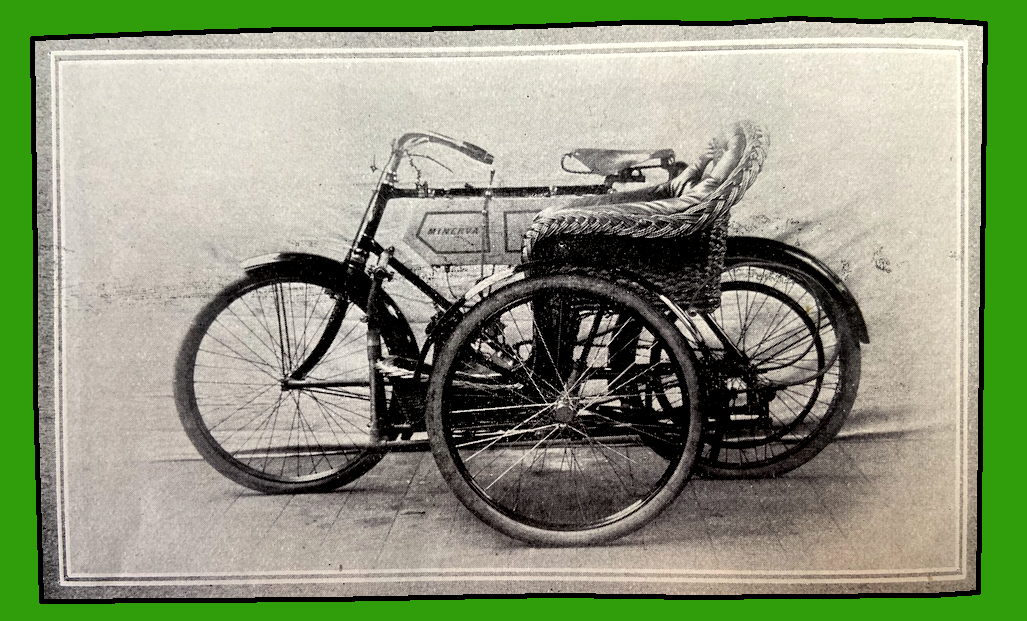
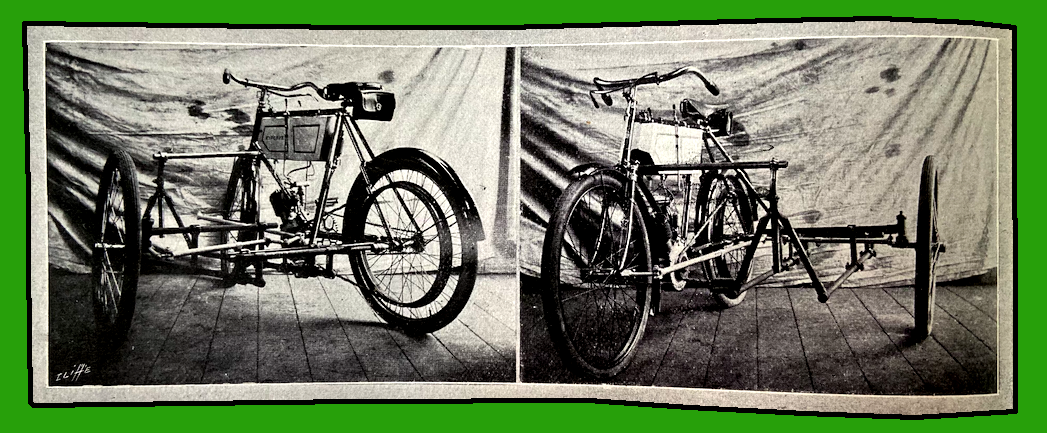

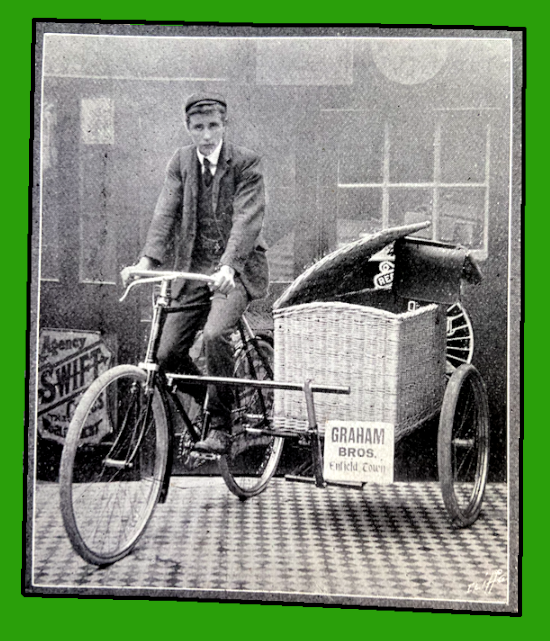
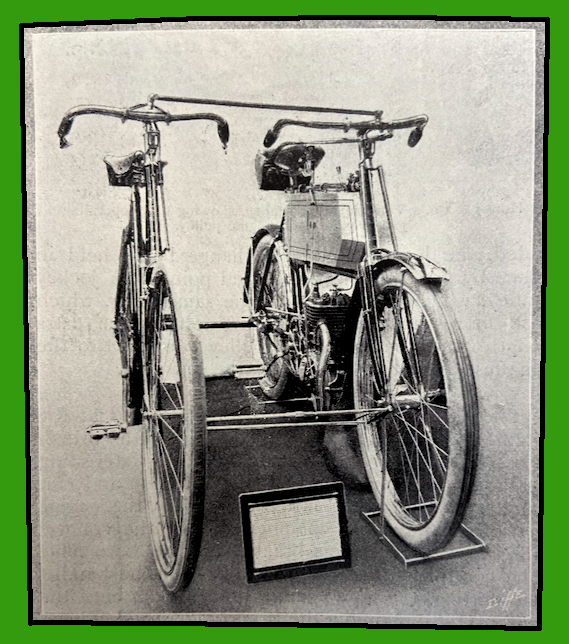
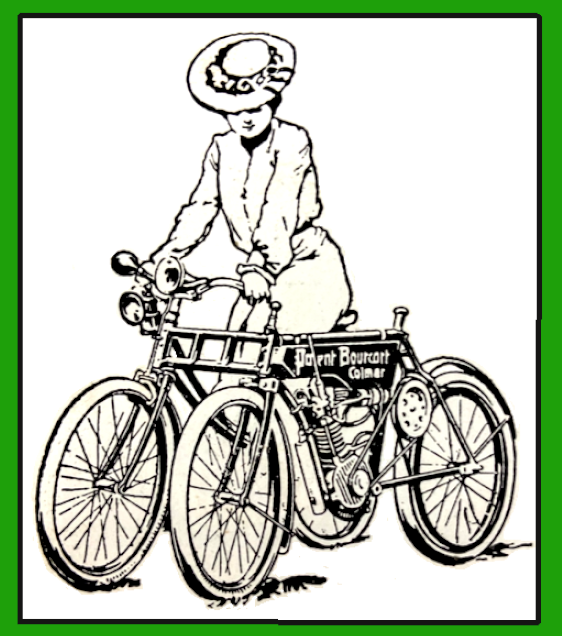
Reproduced from La Locomotion Automobile.”
JOHN MARTON HAD BEEN producing Sunbeam bicycles since 1887; in 1903 his deputy works manager patented the ‘Little Oil Bath’: a fully enclosed chaincase for motor cycles and experiments were made with a Sunbeam bicycle fitted with a lightweight Motosacoche engine. That all came to an end when an employee was killed on a prototype motor cycle.
A GP WROTE TO The Lancet: “The advantages of motorcycling as a means of locomotion for professional men are not sufficiently appreciated. In March last I purchased a motor bicycle and had no difficulty in familiarizing myself with its working…In the second week of April I was able to dispense with the services of one horse and in the first week of June with those of a second…The machine has given me a great deal of pressure, and I have been able to get over my work in much shorter time. My health is also much better as I am compelled to take more exercise…”
SPEEDING RIDERS were faced by a growing number of speed traps and unsympathetic courts. This prejudice was equally prevalent on the Continent (though the French seemed immune); some Swiss cantons banned all motorised vehicles.
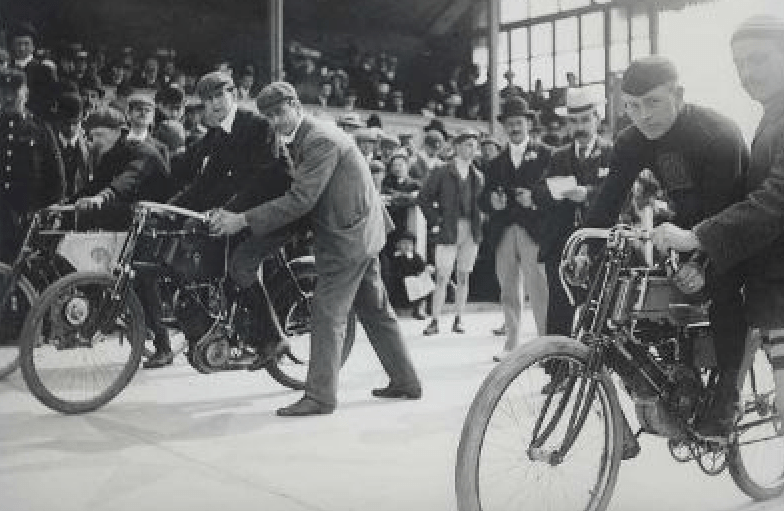
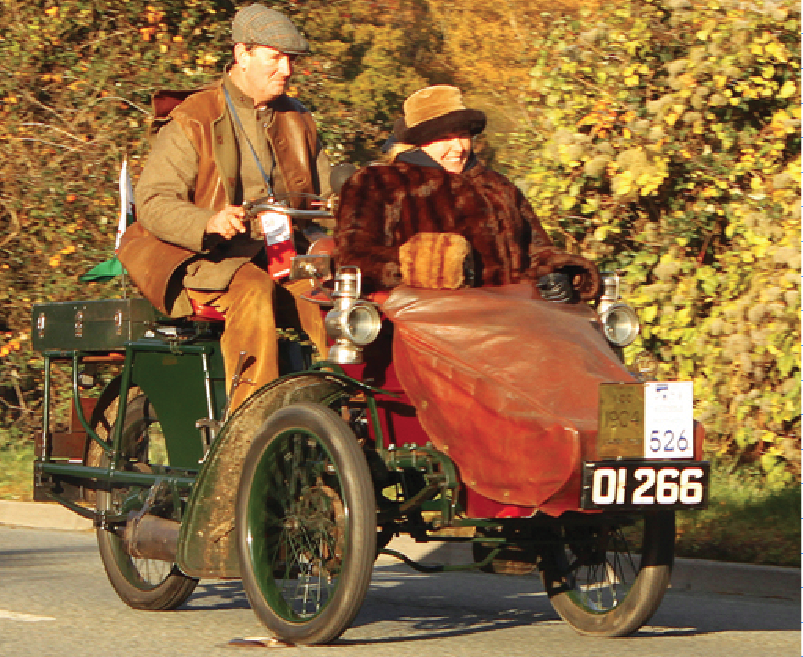
THE SCOTTISH AUTO Club staged the Glasgow to London Non-Stop Trial and asked for motor cycle entries. Nine worthies answered the call; seven of them turned up: LB Tucker and Jas Paterson (2¼hp Triumphs); Bert Yates and JF Crundall (2¾hp Humbers); Thom Silver (2½hp Quadrant); E Herington (2hp Ariel); and FE Coles (2¾hp Brown). [To 21st century enthusiasts accustomed to horsepower in three-figure doses it’s interesting to see four models rated from 2-2¾hp!] According to a contemporary report: “Worse weather or nastier roads could hardly have obtained for motor cyclists; grease [mud] was everywhere and the atmosphere was charged with moisture. In addition, rain fell with frequency throughout the day, the wheels threw the road grit up terrible, and there were belt troubles in consequence. The ‘Quadrant’ and the ‘Ariel’ men did not look a bit as if they like it as we passed them on the outskirts of Glasgow; and getting further on when descending Beattock summit, we overtook the No 1 ‘Triumph’ worried by tyre troubles in that desolate region. Two miles south of Lockerbie we net the rider of No 6, the ‘Ariel’, walking back on his tracks, but though we shouted and asked him what ailed him he only waved his hand and passed. When four o’clock had struck in Leeds, only Bert Yates on the Humber was in the garage, and had been delayed six miles out by petrol famine, which was only
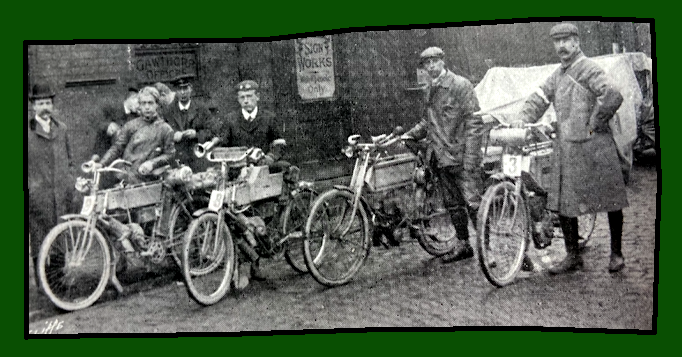
relieved by some kindly sould in a car heaving him a canful. The next to arrive was the other Humber, ridden by Crundall. But for the petrol stop mentioned above, Bert Yates would have made a non-stop run, but Crundall is credited with a non-stop run—a very fine performance…a wire was recived from Paterson to the effect that he had stuck at Kirkby Lonsadale. There also came telegraphic news from Herington, who announced from Preston that he had abandoned the trial on account of some .725 petrol and that he was on the rail for home…just after Alconbury we passed the Brown and the two Humbers close together while the Quadrant was not far ahead…at Biggleswade, Crundall, who had up to that point made a non-stop run, was obliged to dismount to dig earth out of his carburetter. We only marvelled that all were not affected with similar troubles. Just before Eaton Socon, rising a hill, we passed Bert Yates doing some powerful pedalling and licking his lips in a particularly thirsty way. The cyclists had some difficulty i getting to the club in Picadilly to report in, as a huge crowd had gathered to watch the arrivals; but at 5:13 FE Coles on the 2¾hp Brown ran up, followed closely by the Quadrant ridden so pluckily right through by Silver. At 5.43 Bert Yates on his Humber was reported, and at 6.12 Crundall on the sister machine turned up, his run spoilt by his bad luck at Biggleswade.
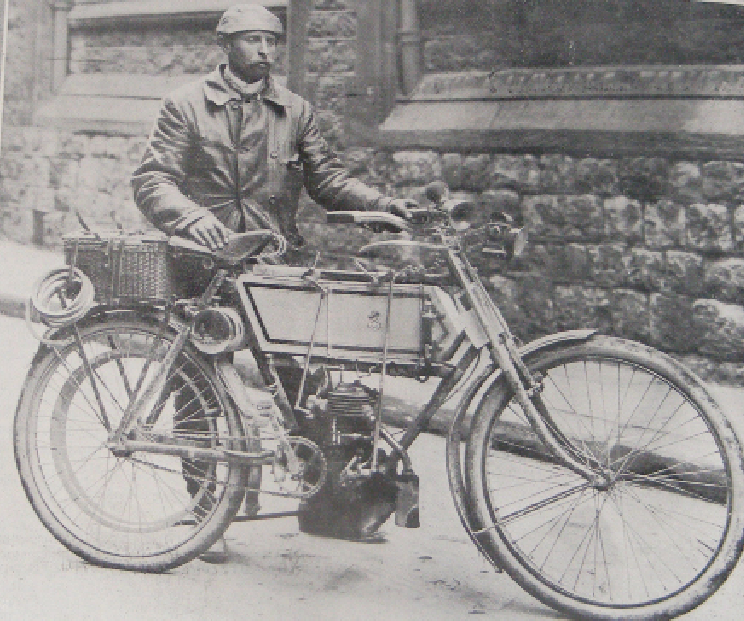
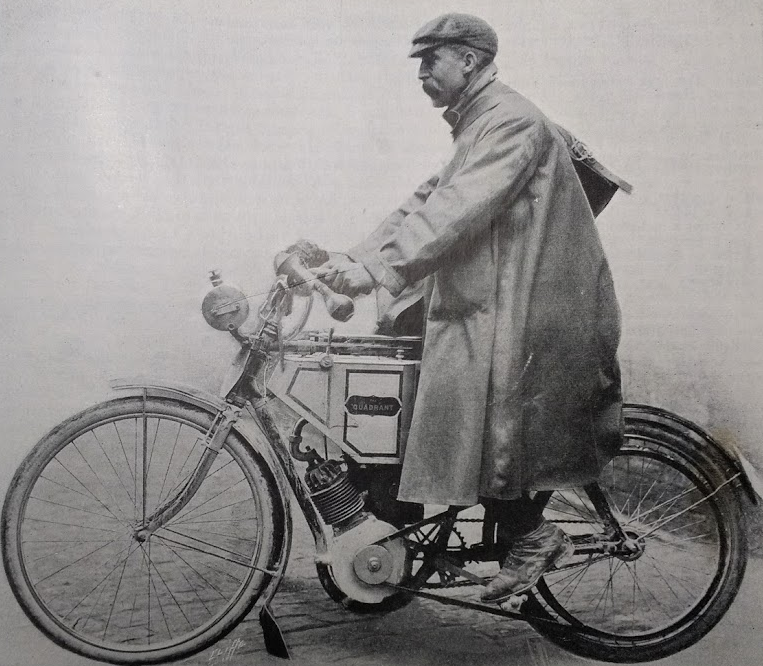
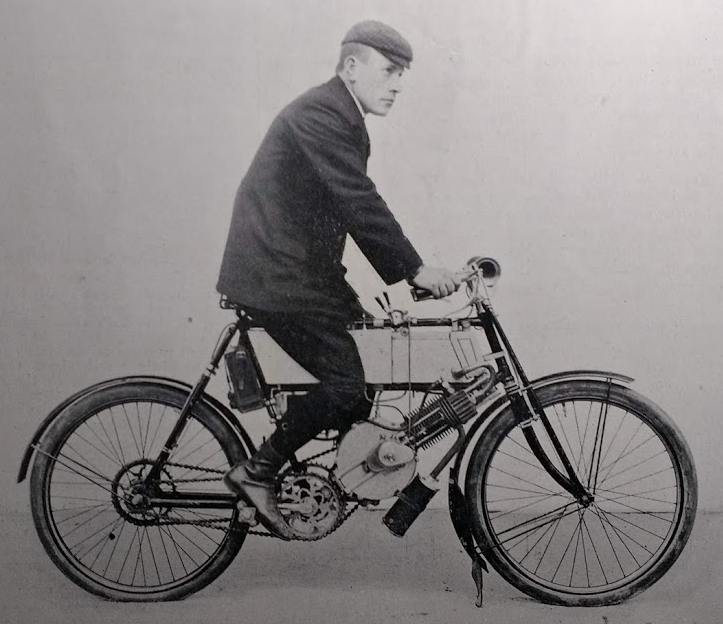
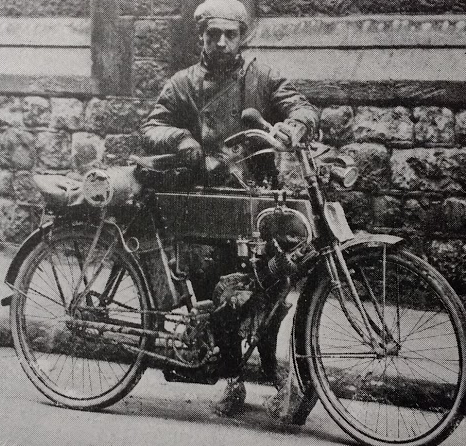
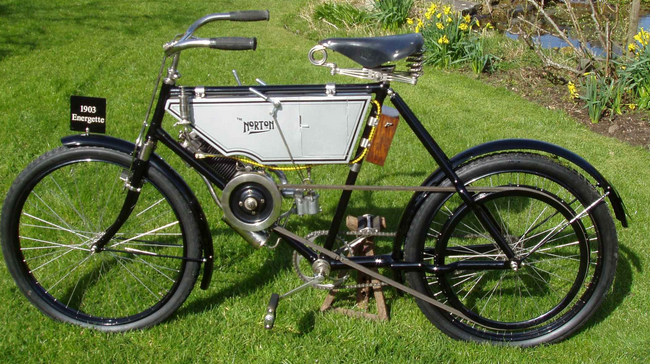
“WHEN THE new Motor Cars Bill was being discussed in the House of Commons an amendment was passed to the effect that no one under seventeen years of age should be permitted to drive a motor vehicle. To allay the anxiety of motor cyclists we wired the President of the Local Government Board as follows: ‘Does clause in Motor Cars Bill refer to motor cycles as well as cars? Presume it does not – The Editor, The Motor Cycle.’ The reply is as follows: ‘Age limit for motor cycle, fourteen.’”
HUSQVARNA GOT Sweden into the game by fitting Belgian FN engines into its bicycles. Like BSA, Husqvarna had its roots in guns; it had been supplying the Swedish army with longarms since 1689.
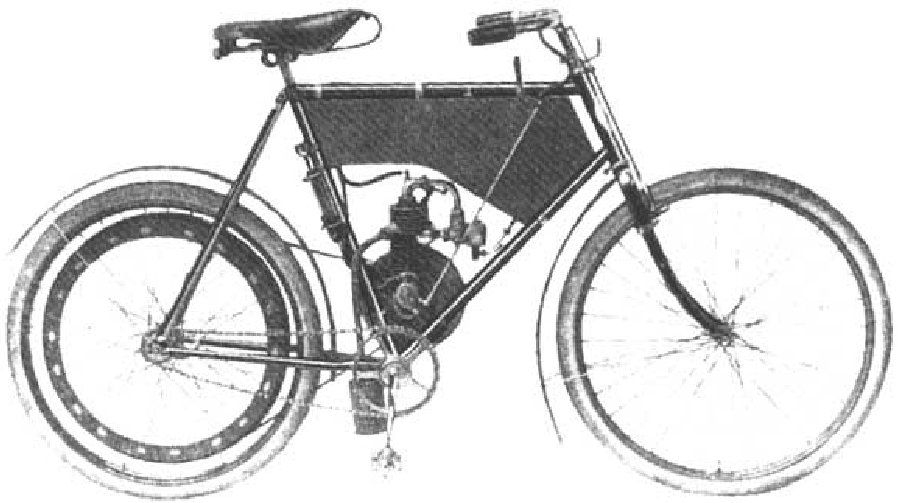
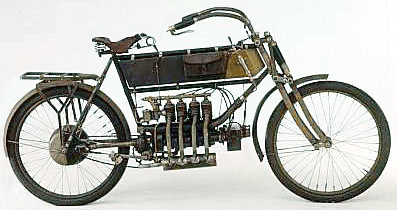
ALBERT CHAMPION set an American five-mile record of 5min 35sec on a 10hp four-pot Clement at the Empire City track in Yonkers, NY.
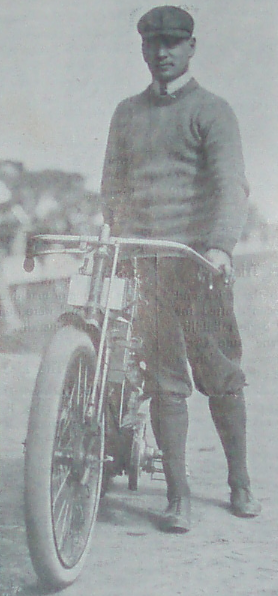
THE CYCLISTS’ Touring Club arranged a spring tour for motor cyclists. They left Marble Arch at lunchtime for a run to Salisbury, via Basingstoke and Andover. The next day’s destination was Exeter, via Dorchester, Blandford and Bridport or Shaftesbury, Yeovil and Honiton. The third day’s run passed through Taunton and Bridgwater to Bristol. Day four, Worcester via Gloucster and, finally, back to London via Evesham and Oxford.
NEWCOMERS TO motor cycling were warned to take out a licence for 15 bob or risk a £20 fine.
“SCORCHING MOTOR cyclists, we are sorry to say, appear to be on the increase on some of the chief main roads out of London at the weekends. Riders of this class who adopt low bars and racing positions may perhaps create the sensation they desire, but they do the motor pastime no good. Were a collision to ensue between them and a pedestrian or a cyclist the consequences might prove very serious. Motor cyclists, favoured by a string of ‘hangers on’, are also becoming a nuisance along the Bath and one pr two other roads, though, as a rule, they do venture very far afield.”
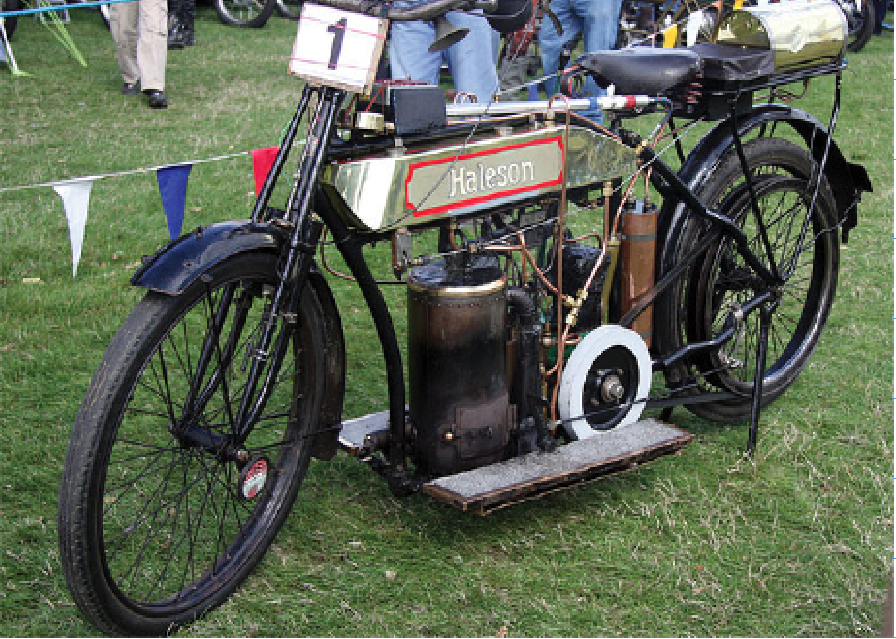
“THE NEW LOCOMOTION has fascinations and exhilarations all its own. The ability to attain and maintain speed of which they previously could but dream, to vary it at will, to dash uphill and dart down dale, to care not which way the wind blows nor how hotly the sun shines—to be almost literally as free as a bird and to skim the earth like the bird and with less effort and to do it seated man fashion astride a saddle, with ability to start or stop by merely twisting the wrist, to go faster or slower by touching a lever, and to pedal when, where and how long he will—these are the joys which only a motor bicyclist can experience; no three wheeler or four wheeler or no motorless bicycle permits of them; they defy ready description; they must be experienced to be appreciated. It is rare that once initial nervousness is overcome the experience does not make a convert and an enthusiast. The control of a motor bicycle is so simple, so instantaneous land so absolute that most of those who feared have remained to wonder why they feared.”
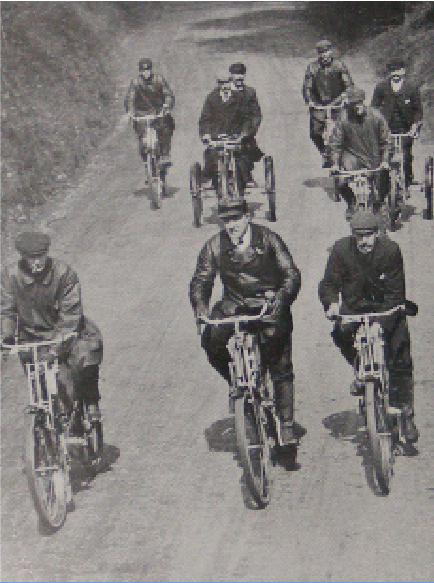

JR BEDFORD hosted a meeting for motor cyclists living in and around Birmingham. About 20 turned up; they formed the Birmingham MCC, based at the Colonnade Hotel in MNew Street. In its first year the club held a series of local social runs, a hillclimb and a 100-mile non-stop run.
THE FIRST motorcycle sold in Japan was a Mitchell.
AN ENTHUSIAST named Archie Barr made a prediction: “Personally, I have an idea that we shall find leather clothing recedes from favour for motor cyclists. It is not aesthetic, hygienic or smart. Some of the woollen materials being supplied by the specialists in that particular line are much more taking and equally serviceable.”



“FOLLOWING SO SOON on the heels of the Stanley and Palace Shows, and the famous Paris Salon, the motor cyclist visiting the Stanley Motor Show at Earl’s Court cannot reasonably be surprised if there is no marked change or development in motor-cycles shown there from those he has so recently inspected. Rapid as development is, new patterns are not brought out every month. The machines to be seen, though limited in number, are representative of the best types. The ‘Minerva’ motor is well in evidence on several stands. A couple of typical American machines are shown on Shippey Bros’ Stand in the Ducal Hall. Careful inspection of these machines reveals much detail originality in design. in the Queen’s Palace the ‘Altena’ motor-bicycle will merit close investigation. The Hamilton Motor Company, Priory Works, Coventry, show four machines and also a trailer and fore-carriage. The motor fitted is the firm’s speciality. It develops 2¼hp, and is shown fitted in both the vertical and inclined positions. The regulation is effected by a Bowden lever which lifts the exhaust valve and breaks the sparking current. The engine itself has many good features. The crank pin is formed from two fins on the fly-wheel forgings ; one sockets into the other, and there is thus an entire
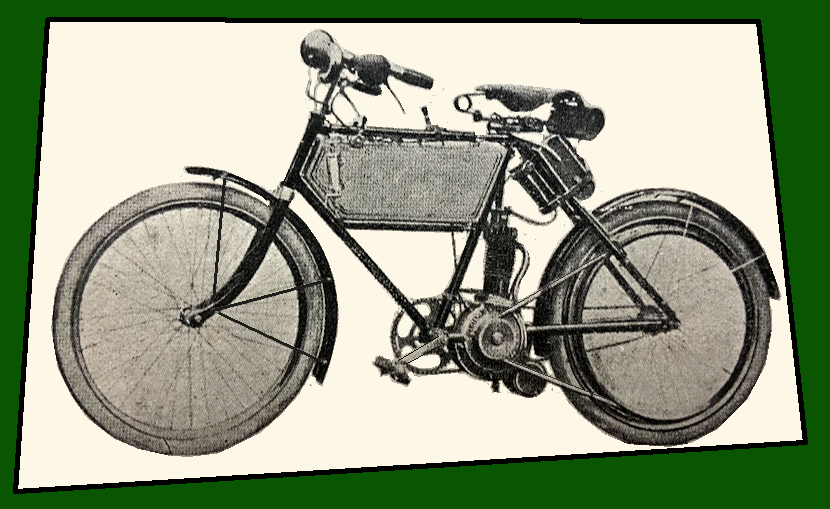
absence of nuts or screwed parts. The valves are extra large, and ample radiator surface is provided. The sparking-plug points are protected by a drilled cap inside the combustion chamber, and thus the sparking is entirely unaffected by oil getting on the points. An interesting feature of this stand is a double-cylinder 4½hp motor-bicycle. The motor is supported in a split loop piece that clamps firmly on to the main tube just in advance of the bottom bracket. This machine has duplicate front forks and extra large tank. The single-cylinder machine is priced at £47 5s, and the two-cylinder at £66 3s. On Stand 11 will be seen the ‘Borham’ motor-bicycle, made by the Borham Engineering Company, Hammersmith Road, London, W. These are smart-looking mounts fitted with the new Minerva motor. Two powers are supplied, viz, 2 and 2½hp. The front forks are a specially strong piece of work, the tubes being carried right up to the ball head. The bicycle parts of the machine are of the highest grade, and the finish in aluminium and black enamel looks very handsome. The East London Rubber Company, Shoreditch, make an excellent display on Stand 35 of the Kerry motor-bicycle, motorcycle frames, motor parts and fittings generally. The Kerry is a capitally finished machine, embodying the latest ideas. The engine is 2¼hp, placed almost vertical in a specially designed loop frame, the crank case being secured to the diagonal and down tubes. A spray carburetter is fitted, and a warm air intake is provided close up to the cylinder. The petrol capacity is large, equal to about 120 miles running. A silencer of good dimensions is fitted,
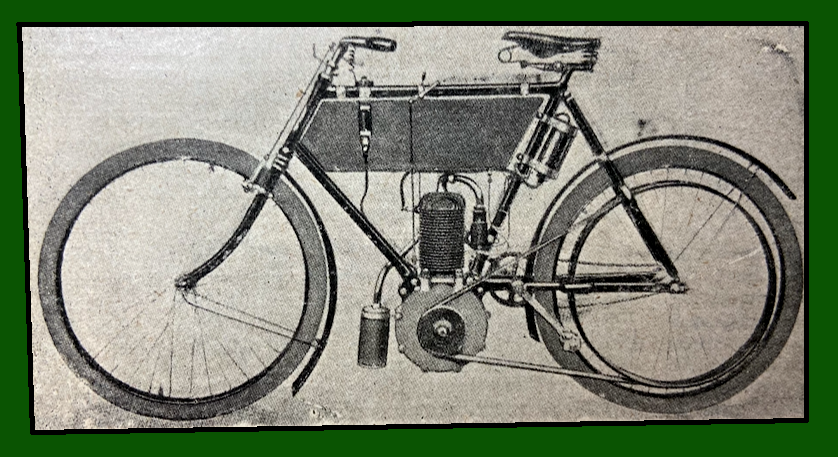
this being supported on the bridge tube from bracket. Lubrication is effected by a pump feed, with transparent barrel. Brown Bros show a well- finished machine, with vertical engine in a special frame with double horizontal tubes. The motor is of 2½hp, fitted with spray carburetter of the Longuemare type. The tanks for oil and petrol are specially large, and the regulating levers are placed in a convenient position well forward on the horizontal tube. Waddington & Sons Motor Company, of Middlesbrough, show a 3hp motor-bicycle. In this the motor is fitted vertically in between the main tube and bracket, the crank case being bolted through to special lugs. A silencer, cylinder, and combustion head are in one piece, and the inlet and exhaust valves are readily getatable. An excellently-designed machine is made by a Dutch firm having the fearful title of the Haarlemsche Automobiel en Motorrijwiel Fabriek of Heemstede-Haarlem. The general lines upon which the machine is built are distinctly pleasing. The motor is an ‘Altena’ mounted vertically in a frame of special design, and develops 2hp. The ignition is effected by a magnet which fires at any speed from 200-2,000 revolutions, and it is possible to advance or retard the ignition easily. The control is effected by two handlebar grips. Drive is by means of a flat belt on to a turned wood pulley clipped to the wheel spokes. A Bowden rim brake is fitted to the rear wheel. A large well-sprung saddle and efficient mudguard are also features of the equipment. The Bimlington
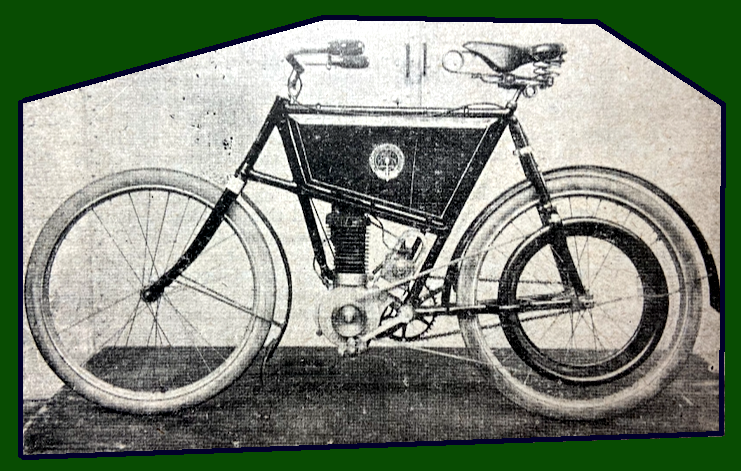
Carriage Co show the ‘George Eliot’ motor-bicycle. The novelty about this lies in the crank case of the motor, which is built into the frame. The carburetter is of the surface tips. Duplex front forks are fitted, and also very effective brakes. Price, with Clincher tyres, £45. Shippey Bros, King Street. Cheapside, London, exhibit a couple of typical American machines. One is the ‘Merkel’, made by the Merkel Manufacturing Company, Milwaukee, Wis, USA. The motor is 2¼hp, well supported in an inclined position inside the frame. The carburetter is placed close up to the inlet valve, and petrol supply and coil are carried in a case supported from the top tube. The batteries, of the dry type, are carried in a rather bulky case on the back forks. The drive is by as endless raw hide belt, adjusted by means of a jockey pulley. A back-pedalling hub brake is provided. Control of speed is effected by adjusting the spark. The other machine is the Thomas Auto-Bi, made in Buffalo, NY. The motor is placed in between the seat-pillar and bracket, and takes the place of the diagonal. The petrol is carried in a tank supported on the back stays, and coil and battery are carried in cylindrical cases fastened to the main tube. The silencer is provided with a cut-out for fast running. Lubricating oil is carried in the top tube. The West London Cycle and Motor Repository, Walham Green, show the ‘Rocket’ motor-bicycle. It is fitted with a 2hp vertical motor, spray carburetter, coil ignition, valve lifter, and large petrol tank for 150 miles, and is priced at the remarkable low figure of £35, excellent value, as will be admitted. A similar machine with a 2¼hp motor is £37 10s. The Ewart-Hall motor-bicycle, made by Ewart-Hall, Goldsmith Street, Nottingham, has a 2½hp motor placed inside the frame, and driving by means of a Lincona belt. The motor cylinder and head are in one piece. Ignition is by a trembler coil. The carburetter is the firm’s speciality, extremely- simple and effective. Price £45. The Holden motor-bicycle is to be seen on the Motor Traction Co’s stand. It is probably the only direct driven type of machine on the market. The FN 1¼hp motor-bicycle is also shown, and these are being sold at £37 10s. each. J Lucas & Son had a most interesting show of motoring accessories. A speciality was shown in the ‘King of the Road’ head lamp. Back lamps, burning petroleum, could. be seen, in which the new locking device on the oil vessels was fitted. Other accessories were motorcycle lamps, cyclorns, motorcar horns, lifting jacks in various sizes, and also samples of the Wells Lucas motor oils. The Starley
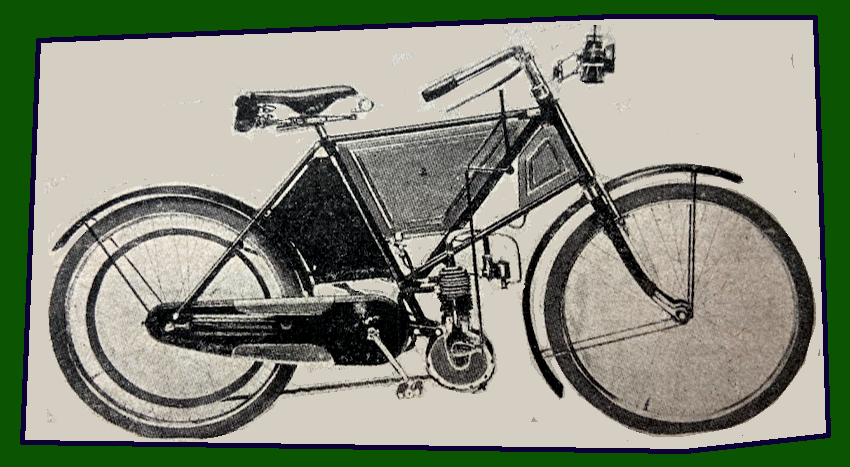
motor-bicycle was on view in the Ducal Hall. The design of frame is rather novel, the motor being placed vertically just in front of the bracket, and special stays run from the crown to the diagonal. The motor is the AV, 2hp, with a stroke of 3in, bore 2⁹⁄₁₆ [336cc]. It has inside flywheels weighing 12lb, the motor complete weighs 23lb. The carburetter is a float-feed spray. The petrol tank is fitted to the frame without clips and has a capacity for 140 miles. The contact maker is of the brush type actuating a trembler coil. The accumulator has a capacity equal to 1,000 miles running. The front fork is of extra strength, and the steering column is made of thick butted tubing. Brakes consist of a front rim and a back-pedalling type. The drive is by means of a belt. The general finish about the machine is of the best possible. The price
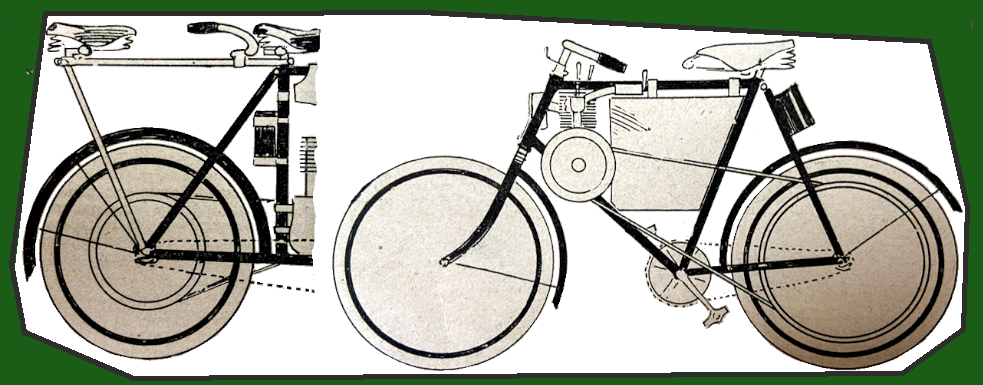
complete with gear case is 50 guineas. JH Hobson, Basinghall Street, London is showing the Rudge-Wedge motor-bicycle, in which the 1¾hp motor is placed inside the frame. The drive is by means of a V-belt. The lubricating pump is placed alongside the steering socket. Ignition is high-tension electric. The petrol tank has a large petrol capacity, and all the bicycle components are of special strength. The mount is excellently finished and equipped. Price is £40. The new electro-catalytic ignition plug is also shown on this stand. The Eagle Engineering and Motor Company, Oakfield Road, Altrincham, Cheshire, show six ‘Eagle’ tandems. These machines have practically all the equipment of a small car, including a water-cooled De Dion engine of 4½, 6 or 8hp to order. It can be had fitted with wheel or lever steering as desired. The front carriage is comfortably sprung and upholstered, and the drive is by special chains, having two speeds. Ignition is on the usual high-tension electric system. The machine is equipped with effective mudguards, particularly the driving wheel, and the band brakes fitted are very powerful. W King and Co, Cambridge, stage four chain-drive motor-bicycles with 2¾hp motors. These have a patented spring transmission device and free engine. The carburetter is an FN spray, and the motor is the well-known Kelecom. Regulation is by throttle and spark advance. An eccentric bottom bracket adjustment is provided for the pedal chain, and draw bolt adjustment for the motor chain. Tyres, special Palmer. Another machine is fitted with the Minerva. motor. Price £42. Chain drive 2¾hp, £52 1Os; 2¼hp,

£50. Dennis Bros, Guildford, show an elaborately finished motor-tricycle and quad. The motors have water-cooled heads and two-speed gears. The drive is by means of gearing. The carburetter is a large spray type, and ignition is by coil and accumulator. A novelty is a back rest attached to the saddle, this also having unusually long springs. The free engine clutch and gear are actuated by a lever on the right of the saddle. The quad has a Dupont two. speed gear fitted. The fore-carriage on this machine is very nicely finished. This is priced at 115 guineas, and the tricycle 82 guineas. The Rex Motor Manufacturing Co, Coventry, have a good show of ‘Rex’ motor-bicycles. These are all fitted with 2¾hp motors. The machine embodies many special features, including vertical engine and strong mode of attachment to the cradle in frame. The silencer is incorporated with the exhaust chamber, giving a very neat finish. The carburetter is a specially designed surface pattern, giving a good supply of gas under any condition of atmosphere. Ignition is high-tension electric, and transmission by special V-belt. Ample brake power is provided, and a good point is the ratchet positive
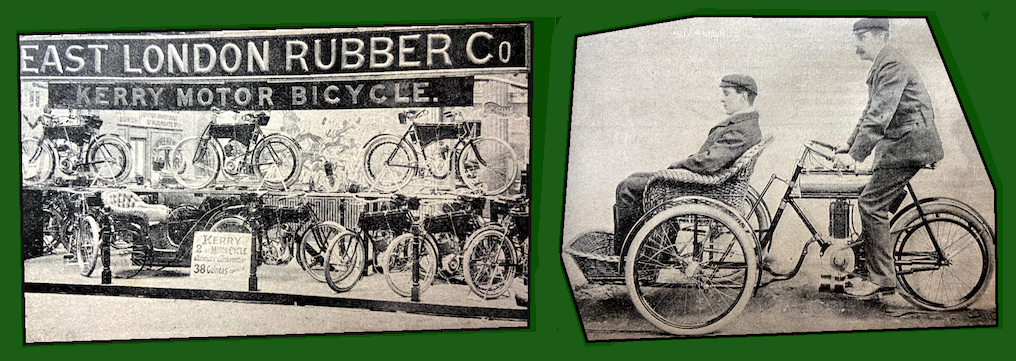
adjustment for the spark advance. The finish throughout is excellent. Humbers, Beeston and Coventry, make a splendid display of their chain drivers, fitted with 1¾ and 3hp motors. Spray carburetters are now fitted, and a special feature is made of the ignition, which is high-tension electric with trembler coil. The ‘Olympia’ forecarriage combination, with 3hp motor, is finished off in the firm’s best style. In addition, a tricycle is also staged. This is particularly neat in design, and follows the lines of the standard bicycle to a large extent. A tradesman’s light carrier is the latest departure of the firm. In combination with a 3hp motor, this looks a thoroughly useful machine. The Firefly Motor Co, Croydon, display several ‘Excelsior’ motor-bicycles. Several of these have the 2¾hp motor fitted, and one has a standard Minerva 2hp motor fitted. The front forks are carried right to the ball-head, giving great strength to the fore part of the machine. Large mudguards, ample brake power and first-class equipment throughout are notable features. Branson, Kent and Co, Goswell Road, London, EC, show a very complete line of accessories, for motor-cycles and cars. Notably amongst these are the BK sparking-plug, the BK non-slipping pulley, accumulators, belts, coils, voltmeters, etc. A ‘Royal George’ motor-bicycle is shown. This is equipped with the 1903 2hp Minerva motor with mechanical inlet valve and spray carburetter and V-section belt drive. It is a well-finished mount at a reasonable figure. J van Hooydonk is showing seven motorcycles fitted with the New Minerva 1¾, 2, and 2½hp motors. These include one ‘Phoenix’ tandem; priced at £60; one ‘Phoenix’ tricycle with 2½hp motor, £57 10s; and the New Phoenix ‘Trimo’ attachment, £60. In addition a new variable gear will be shown suitable for motor-cycles, belt, chain, or gear driven. The whole of the exhibit is
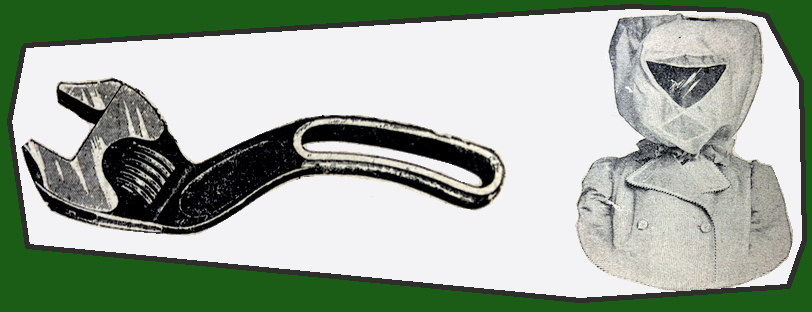
characterised by excellent finish and equipment. The ‘Rising Sun’ Motor Works, Brockley, London, SE, show the Westfield ‘Autobike’. This machine is fitted with a well designed 2¾hp motor fixed vertically in the frame between the down tube and bracket. The carburetter is an FN spray, and ignition by coil and accumulator. Regulation is by two levers only. A tandem fitted with the ‘Kelecom’ engine looks a thoroughly well-designed and finished machine. The rear part of the frame is dropped to accommodate a lady. The ‘Leonard’ Avant Train attached to an autobike is one of the neatest things of its kind we have yet come across. It is provided with large-diameter Clincher tyres, is well sprung, and has a
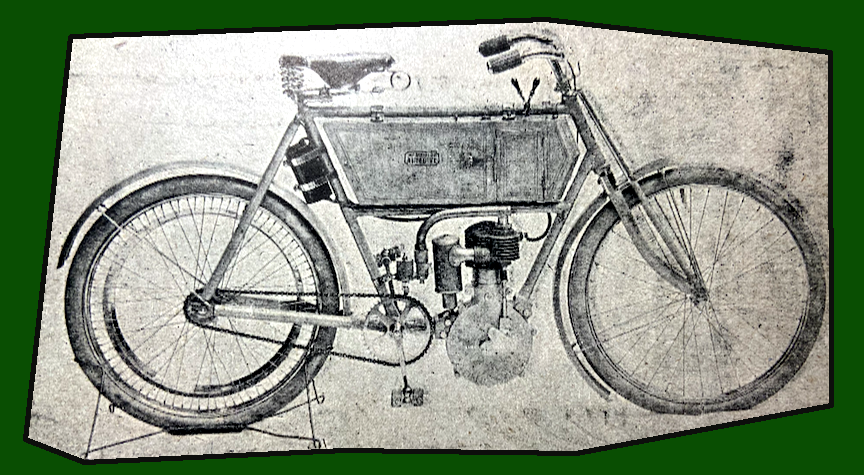
very simple and effective attachment. It is priced at 11 guineas net. Another motor-bicycle is also shown, with motor placed behind the diagonal. This is characterised by an excellent finish. A full range of parts are also shown. Douglas S Cox, Selsdon Road, West Norwood, London, SE, shows Minerva and Ormonde machines and a new line in the 1903 ‘Barter’ motor. The drive in this machine is by a wide flat belt running from a pulley keyed to the 2 to 1 shaft. The carburettor it a float-feed spray and ignition is by coil. A tandem attachment is fixed to this machine. The.motor develops 2¼hp, and the price complete is 40 guineas. A novelty on this stand is a featherweight 1½hp racing motor-bicycle. This has a direct chain drive, long wheel base, spray carburetter and coil ignition, and scales a little over 50lb. It
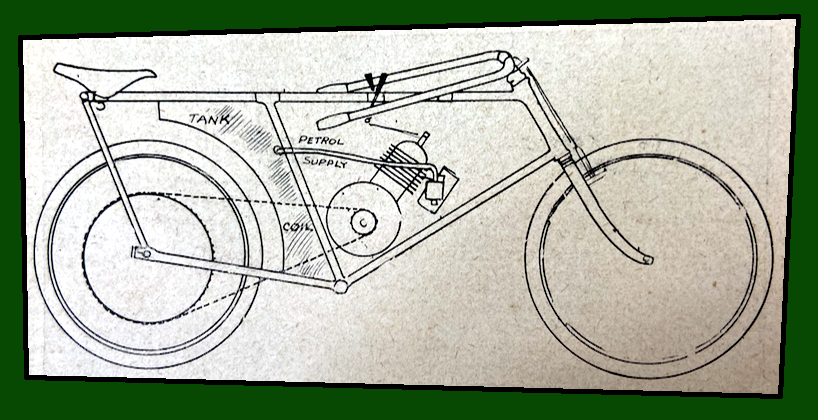
can be handled easily with one hand. Barter motor-bicycles are manufactured by Humpage, Jacques and Pedersen, Ashton Gate, Bristol. The working parts of this motor can be inspected. A novel point about it is that the flywheels, instead of being fixed to a running axle, are mounted on fixed pins, the real driving axle being that carrying the 2 to 1 gear.” “The Greville Motor & Cycle Co had a motor-bicycle on view presenting some novel features. The 1¾hp motor is mounted inside the frame between the down tube and diagonal. It drives from a two-speed pulley by a round belt on to another pulley mounted on an adjustable bracket clipped to back forks and compression stays. This wheel carries a small pinion, which gears into a toothed ring, keyed to the driving wheel hub, and thus gives the necessary reduction in gear. The drive, although short, seemed effective, and the double pulley on the motor shaft allows of a reduction of gear being made simply by taking the belt off the larger pulley, then shortening it, by giving it a few twists, and placing it on the smaller pulley. Thus, if the rider comes across a stretch of hilly road, or has a head wind against him, he can easily reduce the gear to meet the adverse conditions. The Bowden Patents Company have now adapted their transmission wire to a special form of throttle valve suitable for motor-bicycles. It consists of a hollow piston that can be drawn up against a spiral spring, and which gradually reduces the area of the supply pipe till it is quite closed. It can, of course, be worked from the handlebar by means of a ratchet or friction lever, but the company recommend the twisting handle as being more capabIe of delicate adjustment. The valve complete, with wire and twisting handle, is priced at 30s.
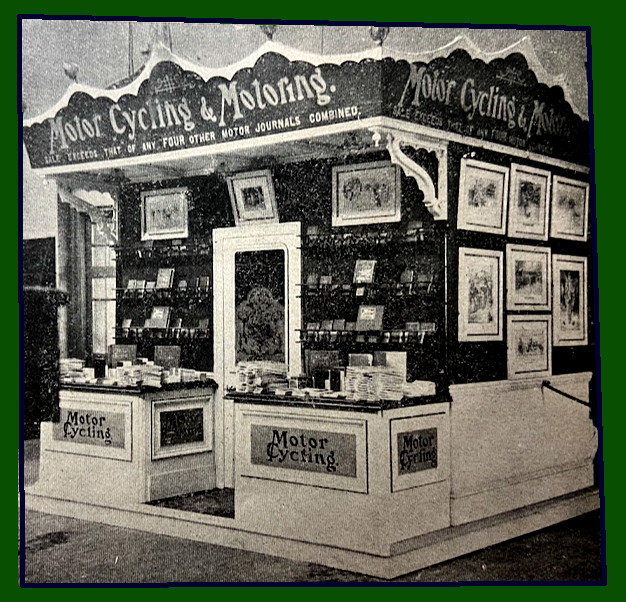
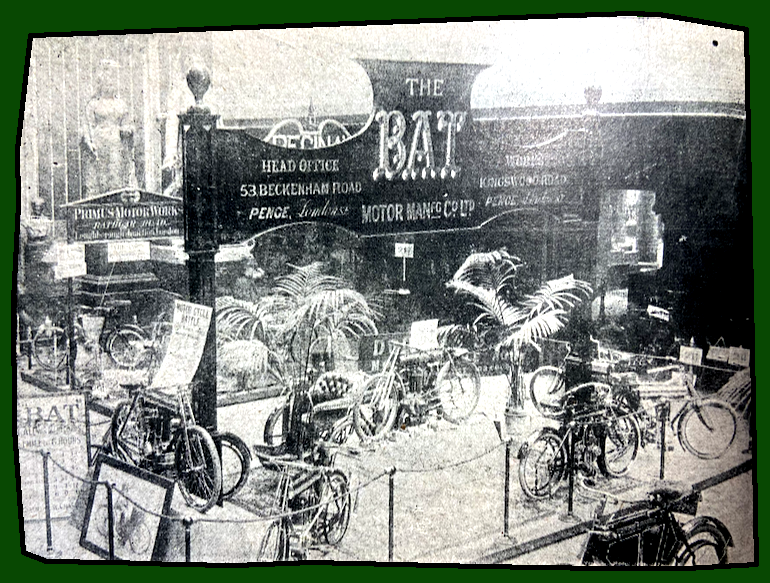
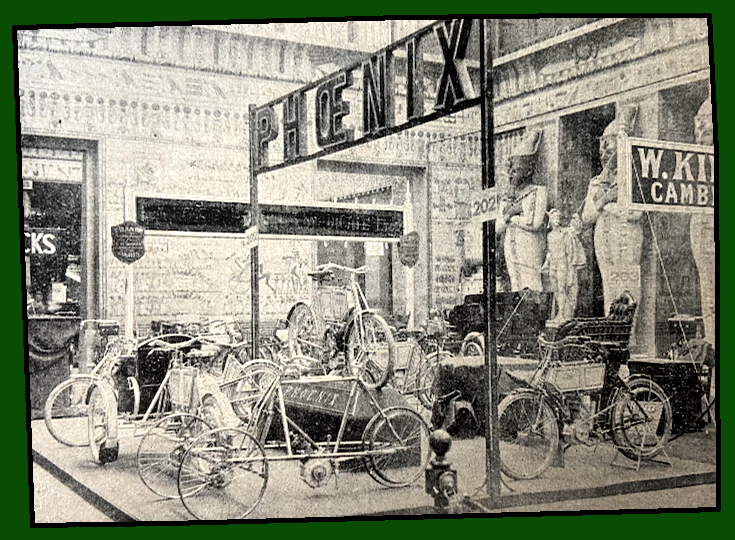
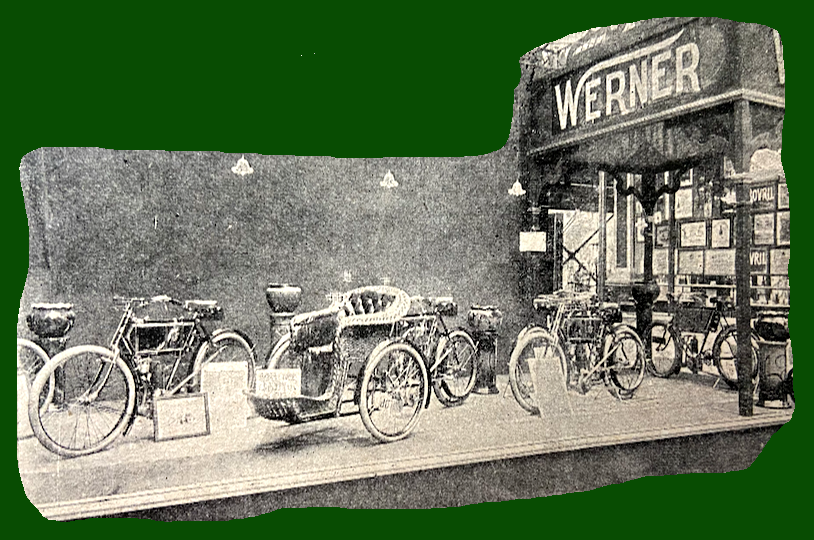
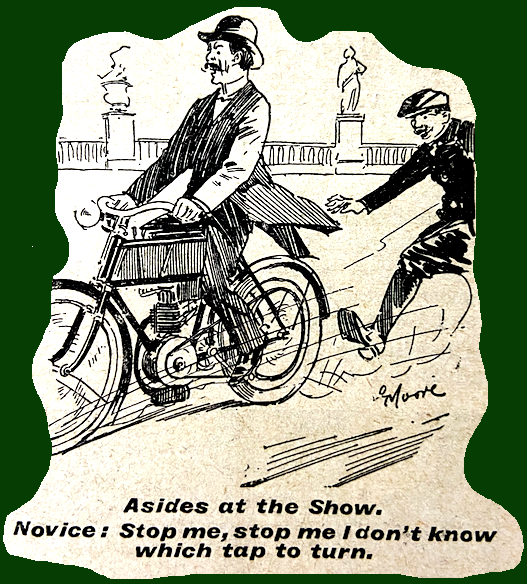
“THE 1903 NEW HUDSON motor bicycle possesses many distinctive features, chief amongst which is the special frame. The engine is the New De Dion of 2hp placed vertically in a particularly well stayed frame, and duplex front forks are fitted. The tread is very narrow, being only 5½ inches. An exhaust valve regulator of novel design is incorporated, giving facility for easy starting and very quiet running in traffic. The contact breaker is of the positive-make pattern, and the accumulator has a capacity of 20 ampere-hours. The carburetter is a special form of float-feed spray. Petrol capacity is equal to 100 miles running—about one gallon. Lubrication is effected by a very ingenious form of automatic sight feed lubricator patented by the New Hudson Company. With this device the engine can be lubricated by a slight movement of a lever, and on moving the lever back the lubricator fills again ready for use. Drive is by means of a V-section belt. The weight complete is 87lb, inclusive of heavy motorcycle tyres. The finish and equipment are of the highest possible class, and the price comes out at £45.”
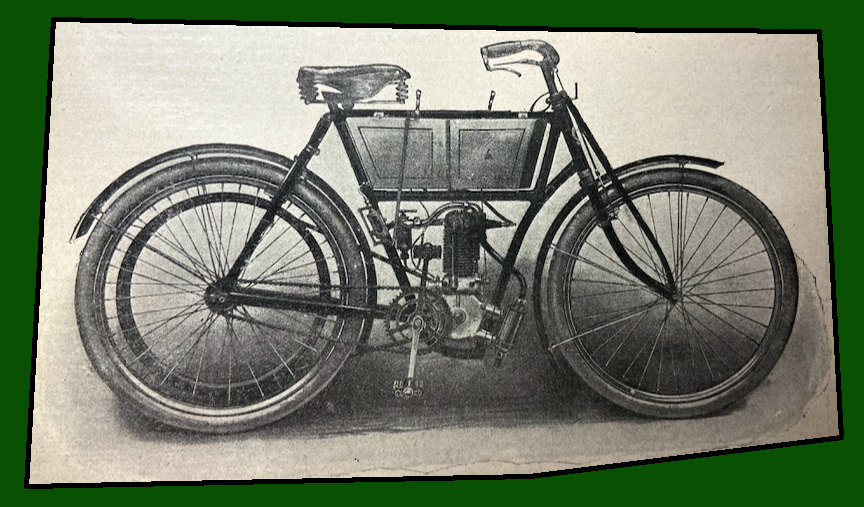
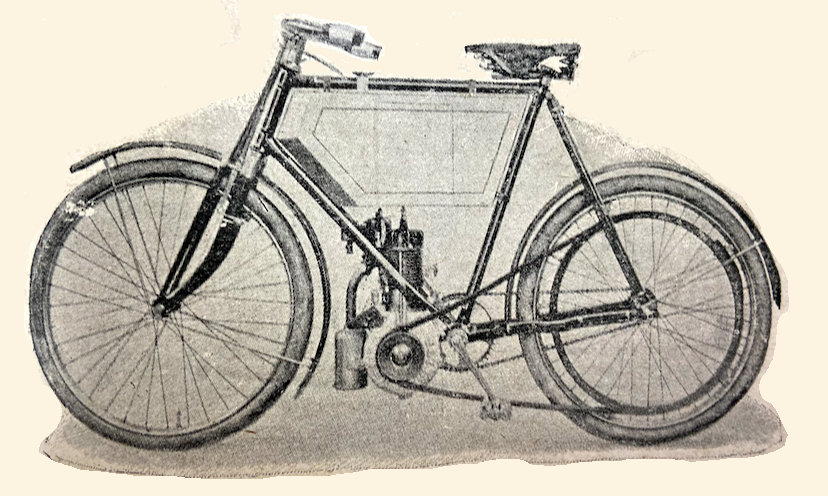
“THE KERRY MOTOR-BICYCLE has rapidly worked its way into popularity. The engine is finished with extreme accuracy, has two cranks, one on each side of crank chamber, thus securing absolute rigidity. The bore is 70mm, and the stroke 80mm. A full 2¼hp is developed at 1,400rpm. Both valves are easily accessible, and the timing gear can be inspected by the removal of five screws. A very effective automatic spray carburetter is fitted with independent throttle, and power is transmitted by a V-belt. The petrol tank will hold five quarts, and the lubricating oil tank one quart, sufficient for a journey of 100 miles. The general design of the machine is symmetrical and pleasing. We have had an opportunity of trying the ‘Kerry’ machine on the road, and our experience with it fully confirmed the favourable reports we had previously heard. The motor spirit used was the heavy .720 specific gravity, yet we had no difficulty in starting, the engine commencing its work at the fist few turns of the pedals. A good feature about the machine, we observed, was the absence of petty troubles. When a lever was adjusted it remained securely in position. The jolting of a rough road did not advance the sparking or throttle the gas supply. The petrol tap really turned off the spirit, and there was no leakage. The crank case especially is perfectly oil-tight and does not distribute the lubricant through faulty joints on to the belt and other parts of the machine. Perfection in these little details greatly add to the pleasure of riding. The machine is comfortable to ride and easy to control. The throttle valve enables economical use of spirit, and by careful manipulation we accomplished a journey of 100 on one charge of petrol, and at the finish the tank still contained a small supply. The makers under-rate rather than over-rate the capacity of the machine, so that when it is discovered to do more than is claimed for it satisfaction is assured. We gave it a further trial, with a trailer and passenger, over a fairly hilly road with good surface. Without distressing the engine, an average speed of 16mph was maintained.”
“IT HAS BEEN MY LOT to attend many a cycling club dinner, and on occasions to really enjoy myself, but the first annual dinner of the Motor Cycling Club was absolutely the most enjoyable function in all my experience. The sameness of the average club dinner, the coldness of Englishmen when dining with strangers, the uninteresting character of the majority of the speeches and the usual lack off freshness about the musical programme all tend to send one homewards with a feeling of gladness that ‘that is over’. The MCC dinner was totally different to all this, not only in itself, but in its effects. There were no laudatory speeches, not a touch of harmony except when we spontaneously sang, unaccompanied, ‘Auld Lang Syne’. But for all that—no doubt, in consequence thereof—the evening was enjoyable in the highest degree and the end came all too soon. The programme was unique. In fact, my lengthy experience does not enable me to recall anything of a similar nature. Five subjects were brought forward for discussion, the introducer being allotted ten minutes for the reading of his paper or for his speech, whilst a further ten minutes was allowed for discussion. Thus the whole thing was ‘sparked up’, so to speak: the author of a paper had to keep to the point in order not to exceed his time limit, and then a series of short, sharp criticisms would follow, and, as a consequence, the hour and three-quarters spent on the five subjects was gone as is if in a flash. Then Mr SF Edge, who made an admirable chairman, interested everybody with his comprehensive survey of the whole of the subjects, and he cleared up one or two matters in a way which one would not unnaturally expect from one of his experience. The Motor Cycling Club has set an entirely new fashion in dinners, and I hope to see the idea extensively adopted. Of course, with such a `live subject ” as motoring, and with so many points about it at issue, there is much to talk about, and will be for some little time, time, for which fact let us be truly thankful.”
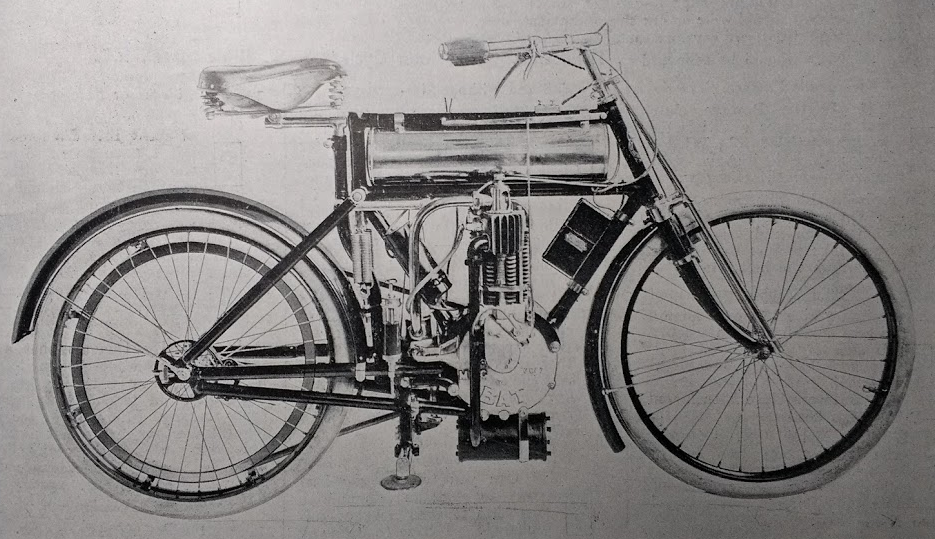

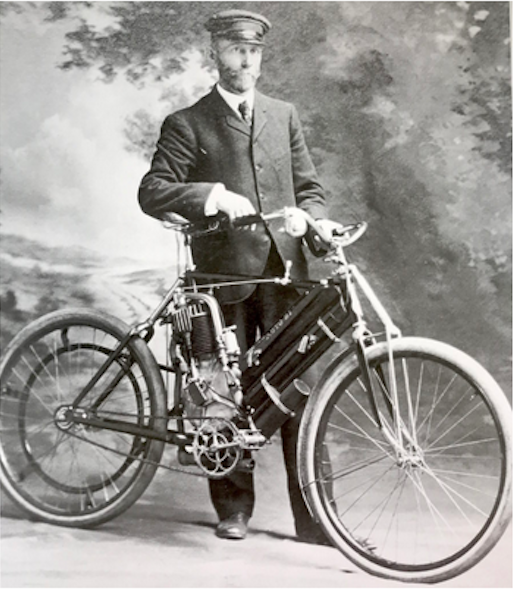
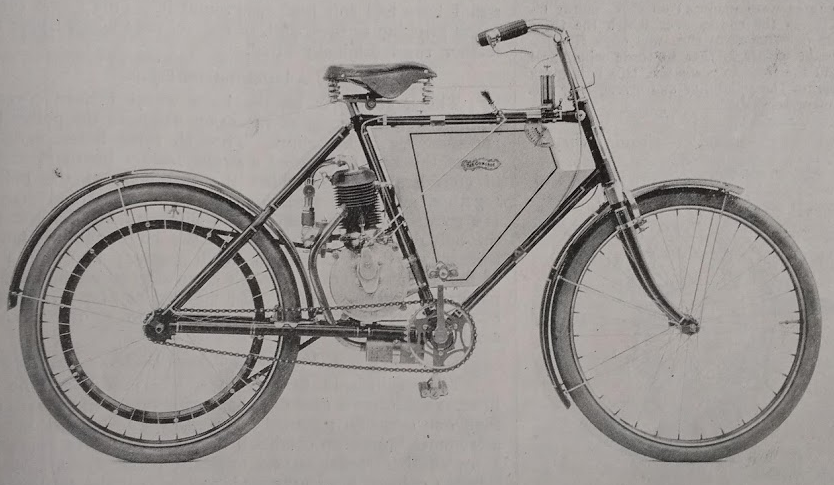

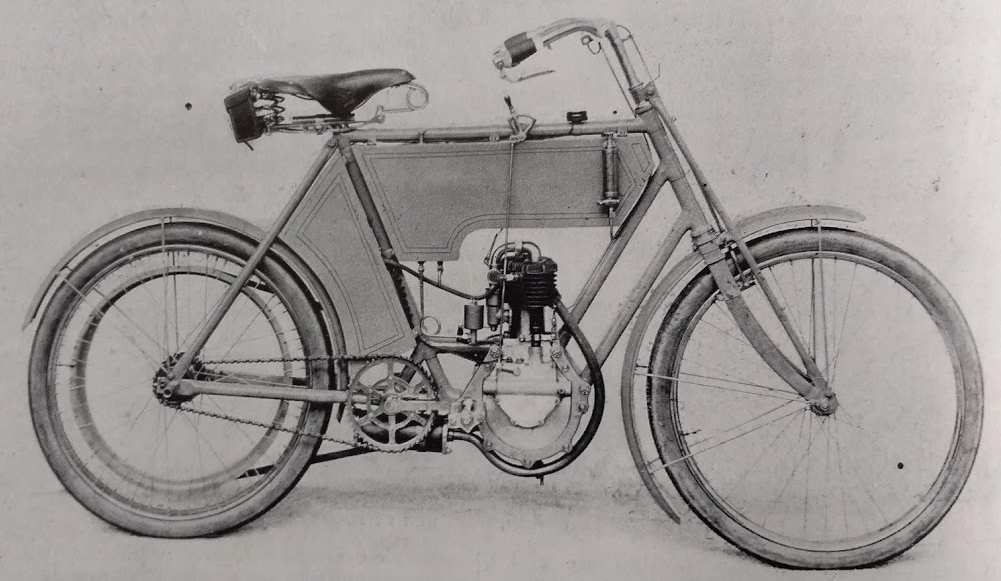

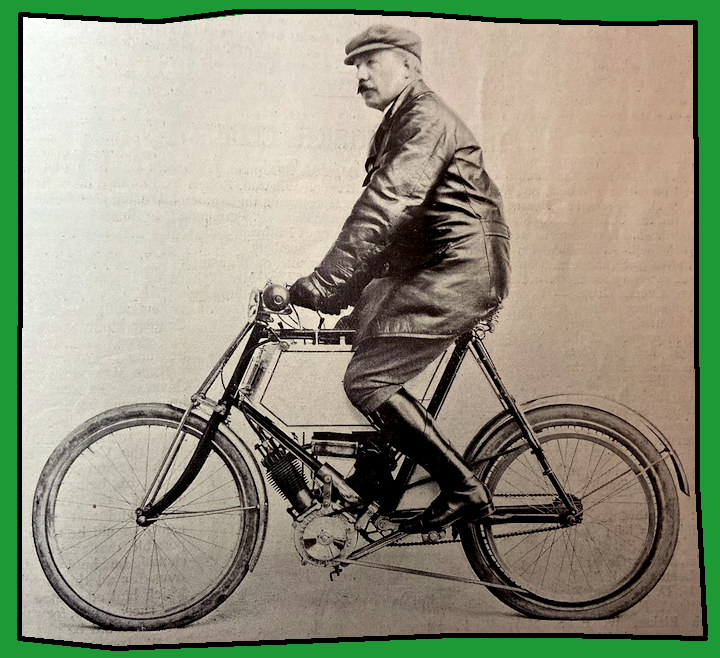
“The ‘Rochet’ racing motor-bicycle. The two-cylinder motor is supported in a hollow arch-shaped lug joining the main tube to the bracket. The accumulator is carried on a bracket supported from crank case. No pedals are provided, but a pair of foot rests are screwed into the crank case. The machine is also minus an exhaust box.”
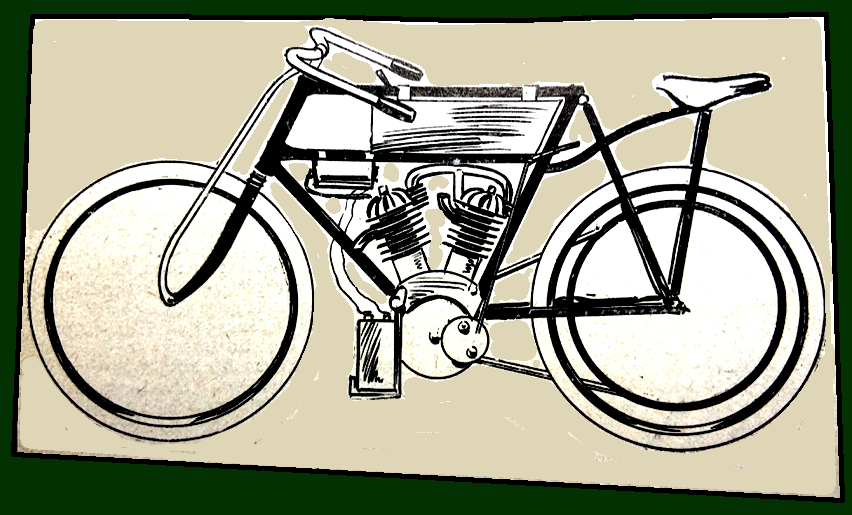
“WE ARE NOW ABLE to illustrate a motor-bicycle built throughout by the celebrated French firm of De Dion Bouton. The photograph shows clearly how the motor and its equipment are disposed on the frame but the spray carburetter does not appear on this particular machine. The motor is placed inside the frame, with a small inclination forward. The coil is clipped behind the seat pillar, and the accumulator is carried in a case strapped to the diagonal. The spark-advance lever can be seen right forward on the horizontal tube, and the exhaust valve lifter a little behind it. The silencer is carried well down alongside the bottom bracket. The drive is taken by a ⅜in round belt passing over a jockey pulley. The carburetter shown is the original De Dion surface pattern, with a warming tube coming up from the exhaust. The machine complete weighs 85lb.”
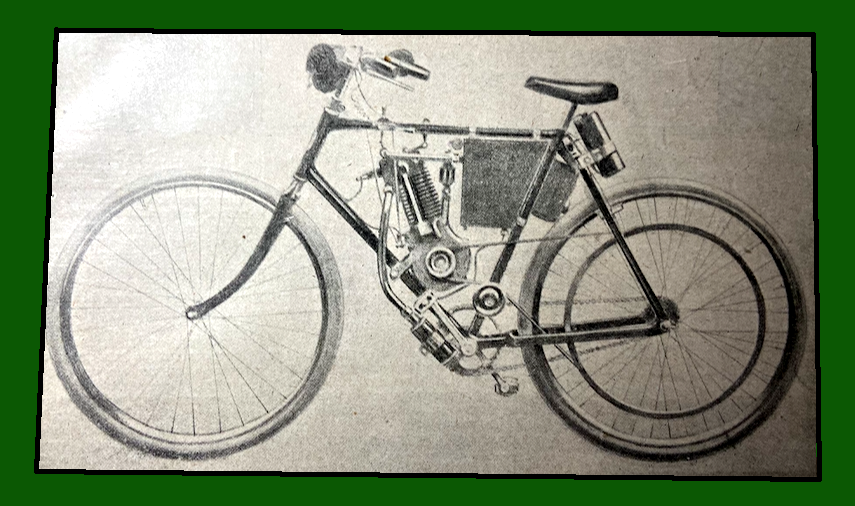
“RECENTLY WE HAD AN OPPORTUNITY in Coventry of examining and watching the behaviour of the latest product of the firm of Hobart, Bird & Co while a member of their staff rode the machine over the greasy, muddy roads of that city. The bicycle ran very sweetly, and so efficient was the silencer that at a short distance the explosions of the motor could hardly be heard. The machine has been specially designed as a motor-bicycle. The length of wheel base at a first glance seems abnormal, but judging by the steady manner in which it ran over greasy patches and through heavy mud, the machine is well balanced, thus affording every security against side-slip. The engine is a 2¼hp British made throughout, and is bolted into the curved frame in a vertical position. A spray carburetter, with simple manipulation, is fitted. The lubricating pump is placed within easy reach of the rider ; in fact every detail has been very carefully thought out to ensure simplicity and efficiency in the highest degree. The petrol capacity is equal to 120 miles.”
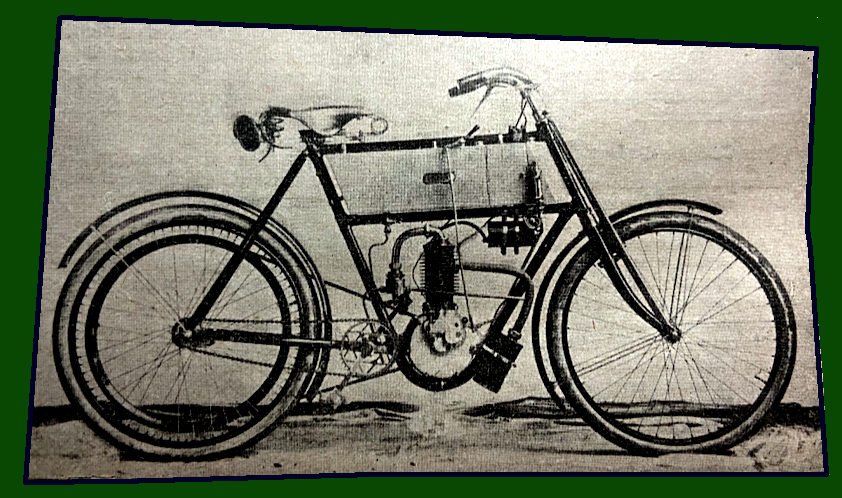
“THE TENDELOFF MOTOR-BICYCLE. This machine was shown at the last German motor exhibition, when it created considerable interest. The special feature about it is that the motor is started up by turning a crank by hand. The transmission is by means of a leather covered roller pressing on the rear tyre. This roller runs on ball bearings and drives off the motor-shaft by a series of spur-wheels encased in a dust-proof box. The ignition is by means of a magneto actuated by a long lever from the motor 2 to 1 shaft. The ignition can be varied to give speeds between 6 to 25mph. The motor is supported on the main tube inside the frame. Regulation of gas supply, lubrication and advance of spark is effected by the levers mounted on the horizontal tube. The carburetter and petrol tank are supported under the horizontal tube. machine it is claimed, will take hills 1 in 10 easily.”
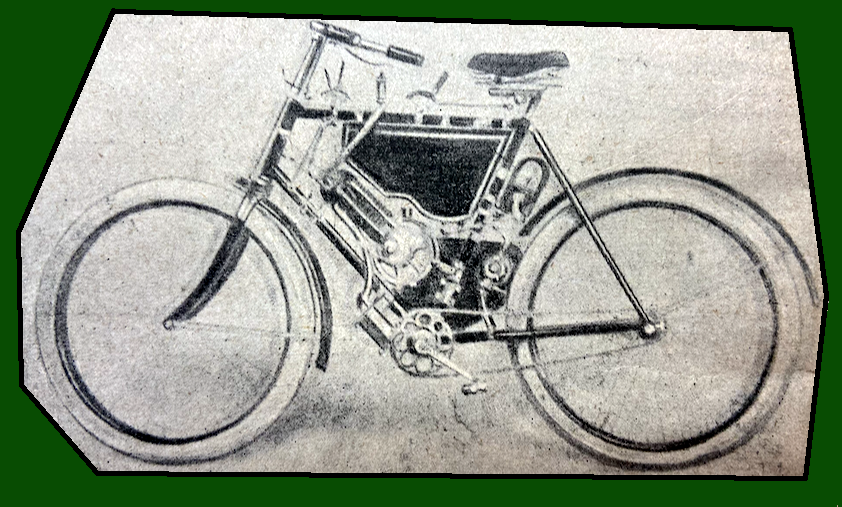
“THE LIBERTY MOTOR-BICYCLE is being put on the market by Messrs JC Meredith, Summer Lane, Birmingham. The motor is a two-cylinder pattern, air-cooled, and driving by means of a belt. The machine i shown is of 2hp, but it can also be had in a 3hp size. The frame is provided with a wide loop, in which the motor is clamped. The carburetter is a special form of spray, which the makers claim works equally well with alcohol, petrol, or paraffin oil. Ignition is by means of an accumulator and coil, and lubrication is well provided for by a sight feed pump. A double exhaust valve lifter is provided, and speed is controlled by the spark advance. Alongside the motor-bicycle can be seen a single cylinder, air-cooled, and also a water-cooled engine of similar make, and both adaptable for motor-bicycles. Various sizes of accumulators and a rear frame petrol tank will also be observed.”
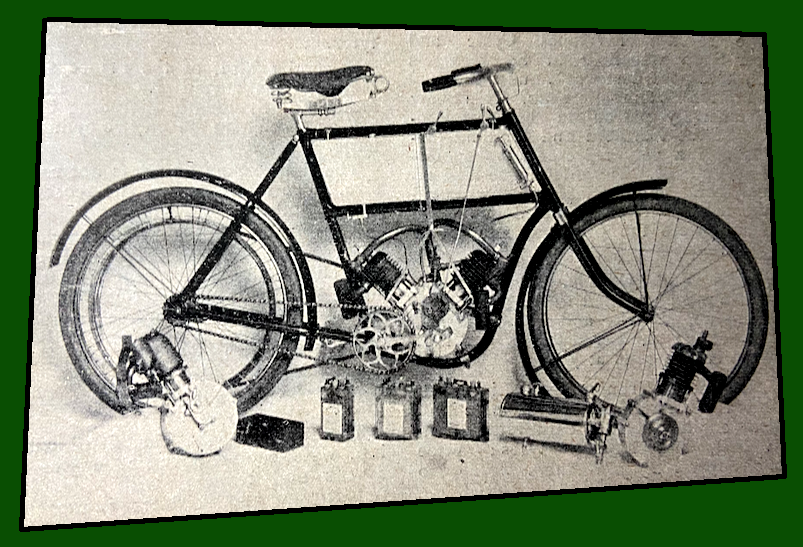
“THE PROGRESS MOTORCYCLE WORKS, of Charlottenburg, Germany, were one of the first German firms to construct a combination of cycle and motor, and the first pattern, which is still on the market, has the motor fitted over the front forks, which have been strengthened by a second pair of blades. The 1¼hp motor fitted is of very simple construction, and is fired by means of a special form of magneto-electric ignition. A single hand lever serves for starting and stopping the motor, and also for the regulation of speed. A newly patented carburetter is used: it is of the surface type, and the tank holds four litres of petrol, sufficient for a 100 miles run. Another innovation is the spring bearings of the motor attachment to the frame, giving vibrationless running. The front position of the motor provides effective cooling and assures efficient working. All parts of the motor are get-at-able, and are well protected against dirt and dust. The exhaust is well muffled, and is practically noiseless. The weight of motor and ignition is 22lb, and that of the whole machine and accessories 75lb. A speed of 25mph is possible, and hills up to 10% gradient can be taken without the use of the pedals. The ignition is controlled by a slight movement of the brake lever, which instantaneously stops the working of the motor, a feature riders in traffic will appreciate. As soon as the lever is set free the motor is again started. The firm constructs another model, in which the a 2hp motor is placed in front of the bottom bracket, and rests at the lowest point in a loop frame. The carburation is also automatic; six litres of petrol can be carried, sufficient for a distance of 150 miles. The oil reservoir for lubrication carries sufficient for 300 miles, and the pump works automatically. The 2hp motor is equal to a speed of 35mph, and has proved very reliable.”
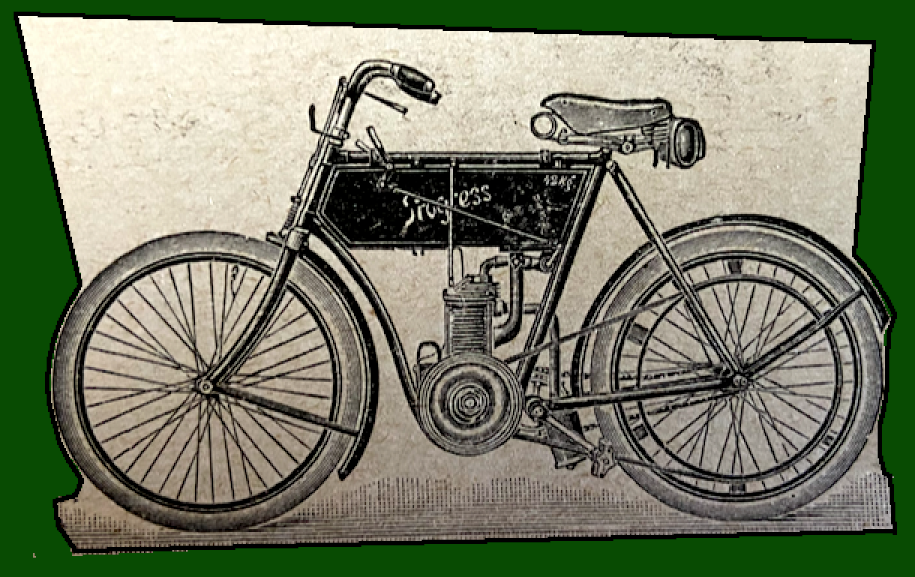
“CROWDEN’S IMPROVED MOTOR-BICYCLE, fitted with driving wheel on the rail-ring principle. An old Wolfmuller motor-bicycle has been converted, to test the principle of the rail-ring tractor, as applied to cycles. This machine, which was originally driven by a small back wheel direct, has now been substituted by a small heavy fly-wheel running in a rim without any spokes, held in position by two guide rollers extended with springs. The invention, the makers claim, overcomes the difficulties of driving direct, rendering the use of gears, chains and bands unnecessary. The arrangement also permits of great elasticity in running over rough ground and obstacles. The vibration of the engine and shock are not felt by the rider in any way, and with this driving arrangement a spring frame is not required. The machine was only adapted for experimental purposes to test the system which up to now, the makers say, has given excellent results. The bicycle can be fitted with pedals, which permit of the engine being started or assisted if required.
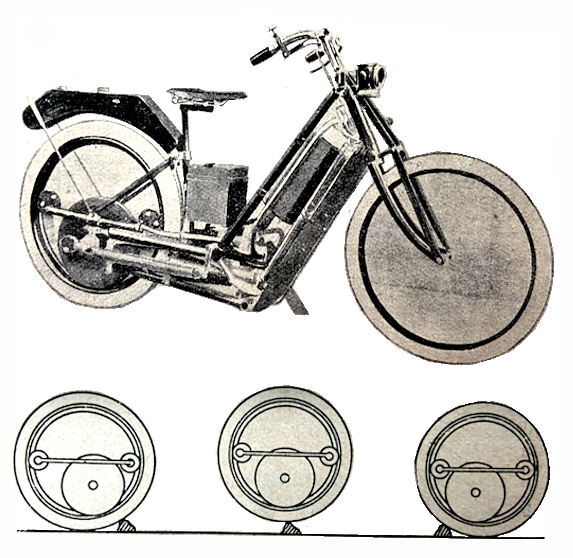
That was The Motor’s description of the Crowden ring-railer; here’s the same story from The Motor Cycle:
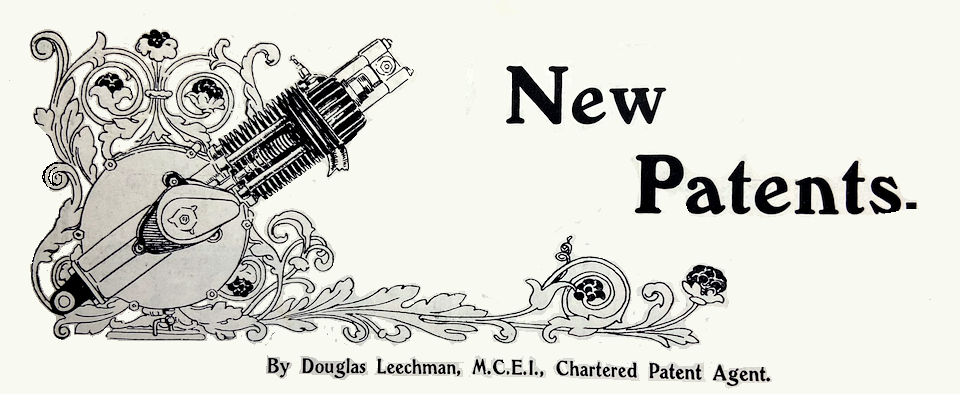
“AMONG THE INVENTIONS which have been published recently, one of the most interesting is Mr CT Crowden’s Ring Rail Motor Bicycle. Constructed with two motors it has a common flywheel arranged between them. This flywheel 3 and the small spoked wheel 22 form, in a sense, the back and front wheels of the bicycle, as the rims and tyres 5, 6, 23, and 10, really serve as ring rails for these small wheels to run on. The wheel 3 is formed with a groove which engages a rib 4 on the interior of the back rim 5. The frame 2 of the machine is fixed to the motors, so that the weight of the frame and rider rests upon the wheel 3, and causes it to grip the rim 5 with sufficient friction for driving purposes. Guides 13 are fixed to the frame-work of the machine, and carry rollers 17. These rollers are forced into contact with the interiors of the rims by springs 15. Hence when the machine is ridden over an obstacle the front springs give way and the small wheels begin to climb up in the rims; and as the obstacle is passed the springs gradually return the parts to their normal positions, and in this manner vibration is considerably reduced. The pedal gear acts upon the friction wheel 3, and means may be provided for lifting this wheel out of contact with the rim to facilitate starting. In another form Mr Crowden dispenses with pedals, the construction being more on the lines of the old Wolfmuller; indeed, he has converted a Wolfmuller to his new system, and the results are very promising.”
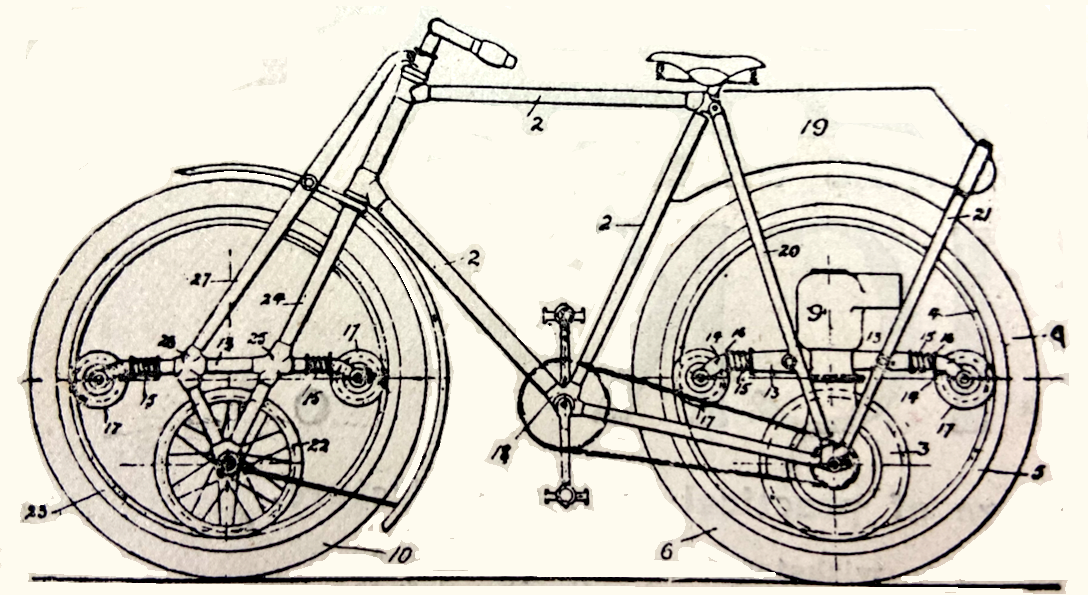
“THE POSSIBILITY OF EMPLOYING the turbine system for automobile propulsion has been more than once discussed. Mr G Plaskitt evidently believes in it, and has had the courage of his opinion to the extent of applying for a patent. The ram E is preferably operated by the weight of the rider, the saddle W being mounted on the rod of the ram, and such ram forces the liquid on to the paddles or vanes A1 of the fluid-driven wheel A, so driving such wheel around, the wheel in turn rotating the driving wheel of the velocipede through the medium of the pulleys U and V, and a belt, or their equivalent. The liquid, when it leaves the wheel A, passes into the tank G, and is pumped thence back to the ram cylinder, being thus continually circulated and used. In cases where the ram is not operated by the weight of the rider or operator, it may be forced down by means of a spring or by other suitable means. The pumps H H are placed at the front of the fluid-driven wheel A, and an intermediate gear wheel is employed to connect the pump wheel L with the-wheel K on the water wheel axle. A valve R is employed for regulating the quantity of liquid forced by the ram on to the water wheel, and such valve may be operated In a handle Rl or by a suitable connection running to the handle-bar or to a point within easy reach of the rider.”
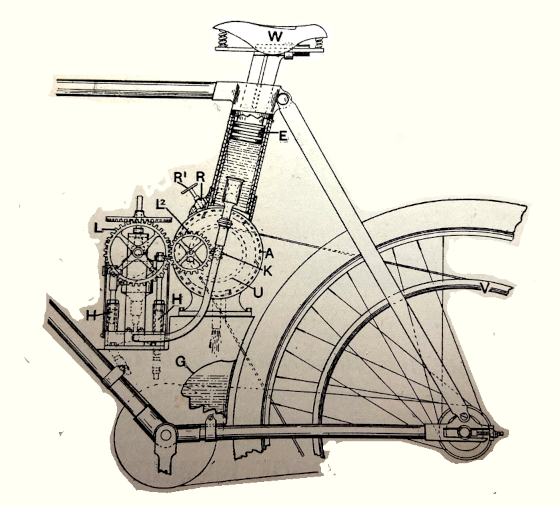
“AMONG THE PATENTS OF special interest to motor cyclists is one recently brought out by Mr Thomas Ashburn (of 14, Chad Street, Newtown, Leeds), who introduces spring buffers in a second or strengthening head, as well as in the rear part of the frame. As will be seen from figs 1, 2, and 3, the inventor proposes to fix in front of the steering head or stem a short length of tubing A (figs 1 and 2), giving the bicycle somewhat the appearance of having a second steering head. In this latter, he places two springs B and C (fig 3), acting in contrary directions to each other against a stop or buffer plate D, which is fixed inside this (so to speak) second head, about three-quarters of the way up. It will also be seen that the lower spring B is contained in and rests on the lower extremity of a tube E, which rises from and is affixed to the fork crown, which tube is allowed to work up or down in the secondary tube or strengthening stem with a piston or telescopic action. The upper spring C, resting with its lower part on the buffer plate or stop D, supports on its upper extremity a disc of piston G, which is allowed to slide freely up and down in what may be termed the upper division of the front stem or head, and so acts as a buffer spring to take up the recoil from the lower or main spring. To provide for staying the lower ends of the two fork tubes H H, these latter are attached by hinged stays to the lower end of a member or support I made of two lengths of D tubing, the upper end of which is affixed to a lug Jon the lower end of the steering pillar. We must also mention that by means of sheet iron fixed between the D tubing an efficient mudguard is also provided. With a slight modification in attaching the back fork stays, it will be seen that the same arrangement can be adapted to the rear wheel.

“WE HERE ILLUSTRATE a very well-made and serviceable motor cycling outfit for wet weather which we have lately had an opportunity of examining. The upper part consists of a short kind of covert coat made of light but strong mackintosh, having a high collar which can be closed tightly round the throat, also a very useful idea in the way of two vertical slits on each side, by which means tools, etc, can be taken from the pockets of the inner jacket without entailing the unbuttoning of the front. The lower ‘weather defences’, which are also made of mackintosh, but of lighter material than the coat, recall somewhat the old-fashioned gaiter leggings and overalls so dear to our sporting grandfathers, and are obviously none the worse for following the lines of such old and well-tried types of ‘bad weather’ garments. We were at the same time shown a very useful ‘fine weather’ suit for motor cycling. This consisted of a well-cut Norfolk jacket lined internally over the back and chest with soft leather, and made of strong tweed. The knickerbockers provided with the suit are double lined, with an excellent and novel arrangement for excluding draught at the knees. To complete the costume, curved ‘puttie’ gaiters of cloth are provided, rising from the ankle to the knee. The makers of both the above are the well-known firm of tailors, Messrs Holding & Son, 7, Maddox Street, London, W.”
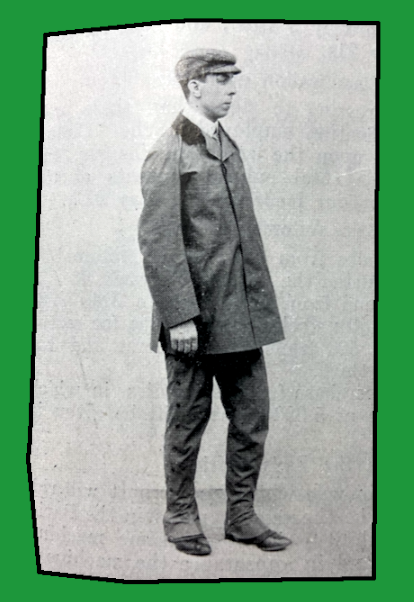
“THE “POWERFUL” MOTOR-BICYCLE is made by HW Clarke and Co, Gosford Street, Coventry. It possesses many good features, which should place it in the front rank of motor-cycles for the coming season. A special point about it is the excellent ‘Buchet’ motor made by the celebrated Paris firm which is fitted. This is of 2¼hp, has an outside fly-wheel and is fixed along the down tube. The carburetter is a spray with float feed. The frame is thoroughly well equipped with brakes, and the finish throughout is of a high order.”
“The Royal George Motor-bicycle is a speciality of Messrs Bransom, Kent and Co, Goswell Road, London. It is designed on the standard Minerva lines, and is fitted with the 1903 2hp motor with mechanically operated inlet valve. The carburetter is of the spray type and the drive is by means of a belt. The frame is built up with an extra long wheel-base; specially strengthened head and duplex forks are provided. The wheels are made with Westwood rims and special BK motorcycle hubs. Two brakes are provided, viz, a BK front rim and a Bowden back. The saddle is a motorcycle type with large springs. The mudguards are made extra wide and have adjustable links, to allow of the wheels being adjusted, and mudguards to follow the curve. Well finished throughout, the machine conies out at £45.”

“ANOTHER NEW MOTOR CYCLE is the Austen, made by the Austen Cycle Co, of Lewisham, London, SE. As the illustration shows, the design of the machine departs somewhat from the ordinary. A strong stayed loop frame, of the firm’s own design, is used; the engine, a 2¼hp Kelecom, being placed vertically and securely braced both to the additional stay and the lower portion of the loop. A long belt drive is thus secured. Duplex front and rear forks are fitted, and with Clincher A1 tyres and Westwood rims the machine comes out at £40. The firm are also prepared to fit their own form of combined chain and belt drive, in which power is transmitted by a chain from the engine to an intermediate pulley fitted to the diagonal, and thence transferred by means of a flat belt drive to the pulley wheel.”
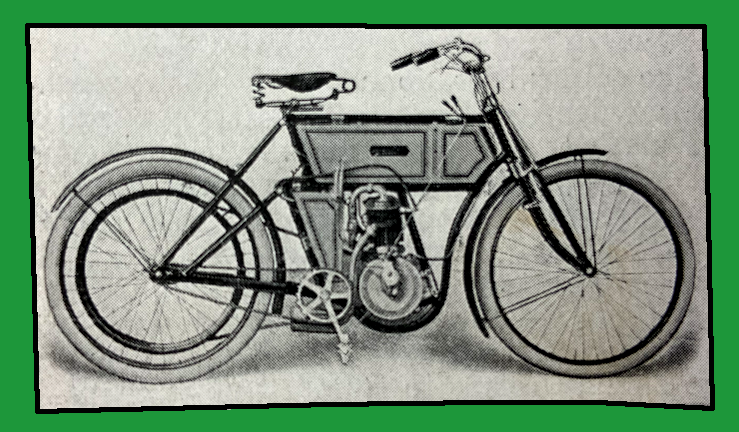
“THE STIRLING MOTOR KIT. Carried in a leather wallet provided with a flexible rack, is a very useful and complete set of tools. The side wings of the wallet wrap over and a pocket is provided at one end for loose sundries. The whole rolls up into a small compass, and is secured by a pair of straps. The tools are well assorted, and in quality they are of the very best. Each tool has been selected for the work required of it, and thus the set is reliable and useful. It is sold by the South British Trading Company, of Victoria Avenue, Bishopsgate Street Without, London, EC.”
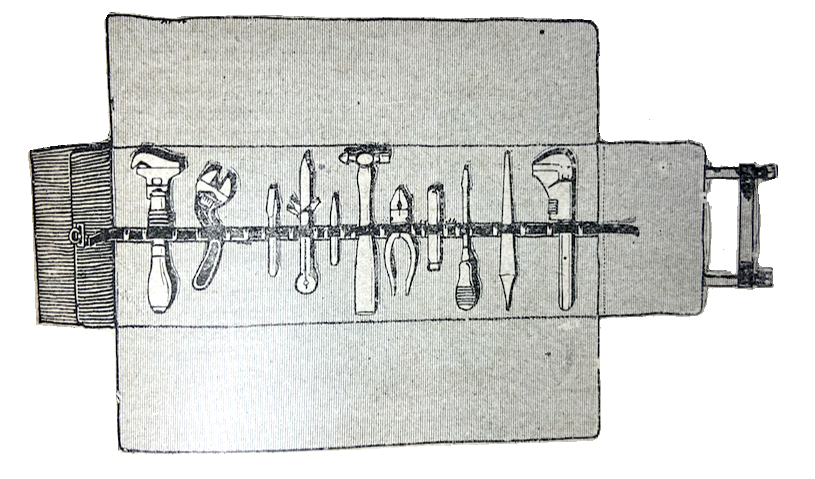
“SIR,—I ENCLOSE A PHOTOGRAPH of my motor-bicycle, and hope you will have the goodness to illustrate it. In 1901 I went up to the Stanley and Crystal Palace Shows, spending one day in each show, with the idea of buying a motor-bicycle. Previous to visiting the shows I had fixed ideas of what I wanted, and although I saw many smart and handsome machines, I did not see exactly my idea. This machine was made for me by Mr. Taylor, Redfield Road, St George, Bristol, and I must say it reflects the greatest credit upon his good workmanship and ingenuity. Briefly, the description of the machine is as follows: Aster engine, Aster coil, Longuemare carburetter, P&R accumulator, EJC sparking-plug, and a special arrangement consisting of two-speed gear, also giving free engine and free wheel, all operated from the seat by one lever. This arrangement was made for me by Mr Taylor. This two-speed gear, etc, is invaluable. I can free-wheel down all hills, and on low gear can mount absolutely any hill. In fact, I have never seen a hill which I have not been able to ride up, and I have the satisfaction of knowing the machine does the work, as I have footrests only. A few days since I had occasion to go up a hill in Bristol known as Nine Tree Hill, which is short, but excessively steep, and altogether impossible for any sort of horse-drawn traffic, and as far as my memory serves me, I think this hill is really steeper, although not so long as the Gas House Hill, Norwich. My top gear is fast enough to be pleasant on a road, and enables me to hustle along at anything up to 40 on a decent .surface; at the same time, I am able to take all ordinary hills, such as Park Street, Bristol, on top gear. For really fast work I have a special gear wheel, which can be attached in a few minutes. I find the free engine most convenient, as I can try it, or start it with a handle in a similar way to a car. I have Clincher 2in tyres, with a Bates band on the back wheel. My saddle is Brampton’s Multispiral, to which I have added a seat spring, which absolutely absorbs all vibration. This spring differs from everything else I have seen; it was made for me by Mr Taylor. The machine runs remarkably steady at any speed, and the position of seat and footrests are both comfortable and secure. My twelve months’ experience of the Longuemare carburetter proves it to be one of the best, and, in my estimation, is the best under all conditions. The Aster engine is really magnificent, and with it I am a stranger to contact and valve troubles, of which 1 read so much. I took a fancy to the Aster engine at the Show of 1901; in fact, the engine on my machine is the same one. If any of your readers wish any further particulars of my machine I shall be most happy to explain. I may add that previous to having this machine made I rode two motor-bicycles of different makes, and, although nice machines, they did not fulfil my ideas and requirements.
Thos Roberts, Bristol.”
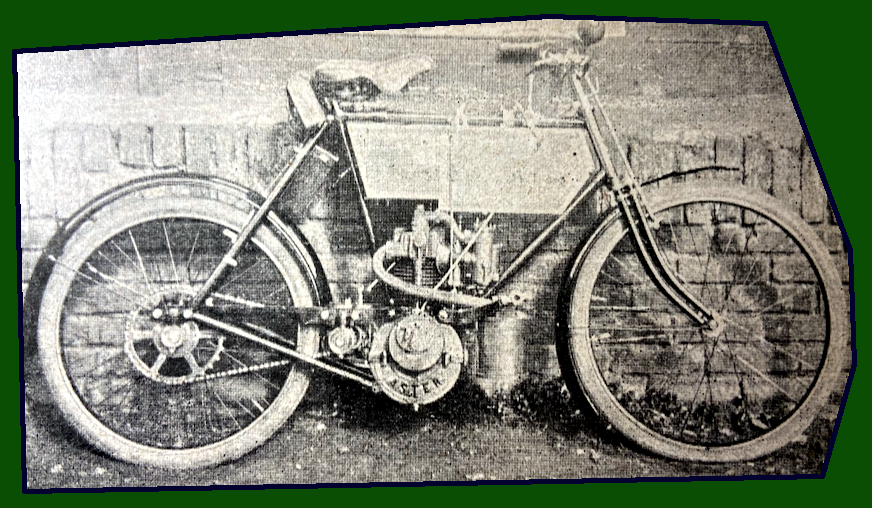
THIS IS ONE of the the first ‘new products’ stories to be published in The Motor Cycle: “A good, resonant, sweet-sounding bell is certainly a far preferable method of giving warning of approach than the somewhat raucous, nerve-distracting horn; and we are pleased to notice that Messrs Markt and Co, of 21, Chapel Street, EC, have been quick to notice the necessity by marketing a special bell for motor cyclists’ use. It clips to the handle-bar in the ordinary way, but is made just about double the usual bell size. The domes are made to revolve so that a very sweet flowing sound is produced, which can be graduated from a single stroke to a continuous volume of sound sufficient to penetrate the ear of even the deafest pedestrian or driver. We have had one of these bells in use on our motor cycle for some weeks past now, and it has certainly given every satisfaction, whilst at the same time gaining the encomiums of our pedestrian friends, who are rabid haters of the motor horn.”
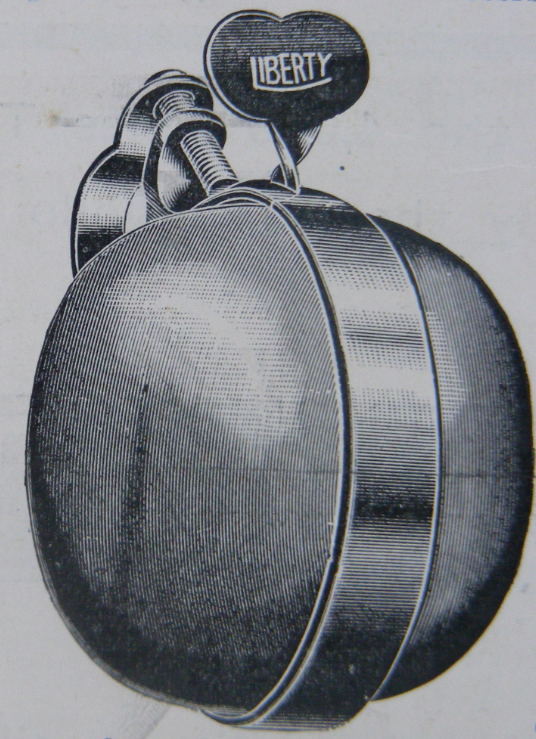
…AND HERE’S ONE OF THE last ‘new products’ published by Motor Cycling before it morphed into Motor (incorporating Motor Cycling and Motoring): “This is a special type of horn, designed to supersede the present type with the rubber bulb. In the pattern illustrated the bulb is encased in a jointed metal ball, the upper portion being provided with a plunger moving in a socket so that when influenced by the pressure of the hand the bulb is compressed and an instantaneous signal given. A series of either long or short signals can be given. It can be attached to existing horns by metal flexible tubing—the large pat-tern for cars is 15s., and small size for cycles 8s. 6d. The makers are Cutmore’s Patents, Queen Victoria St, London, EC.”
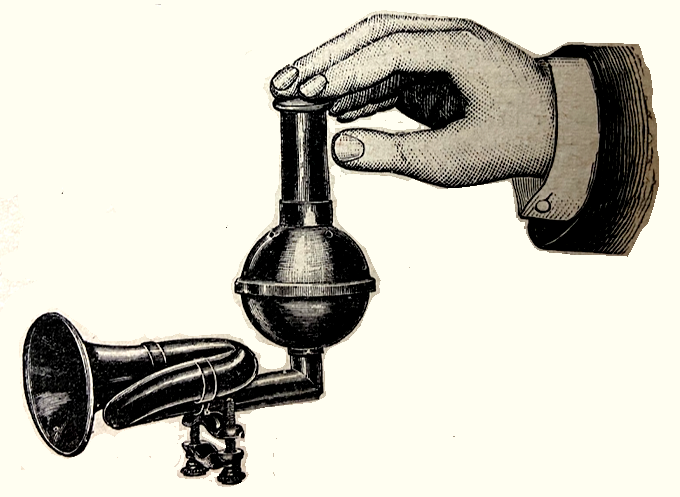
“THOUGH BICYCLE ENGINES are being built larger every month we still find that the demand for more power continues. This will probably cease at the 3hp limit for the present, and it may fall back in future years, provided only that an engine and its gear are so arranged as always to give its rated power. For example, the 3hp Humber, which made the best performance, viz., 21mph on the ‘Trial’ Hill [at the Crystal Palace Trials] only developed 1.59hp, according to the apparently fair calculations of the Automotor Journal.”
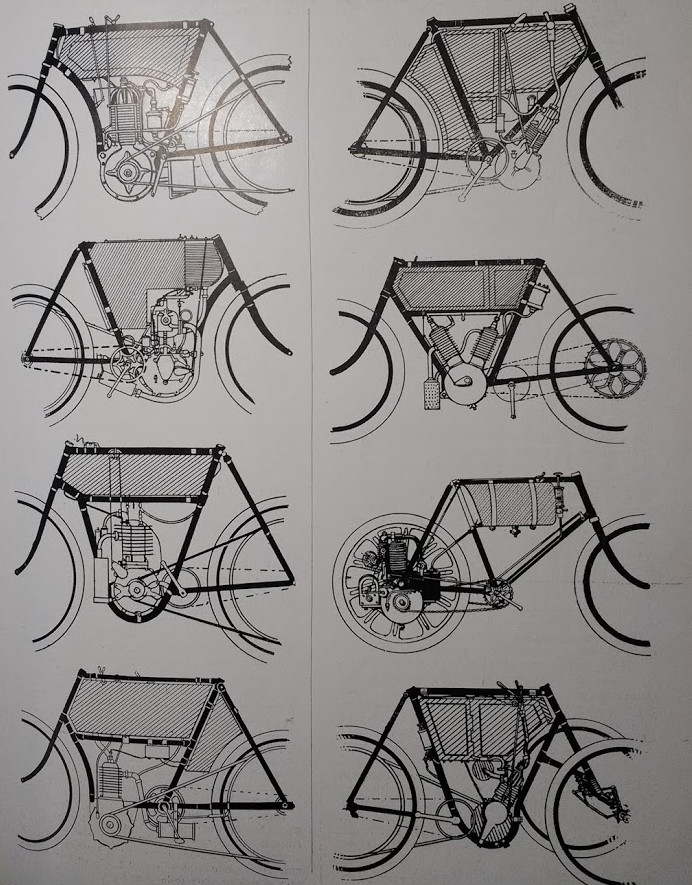
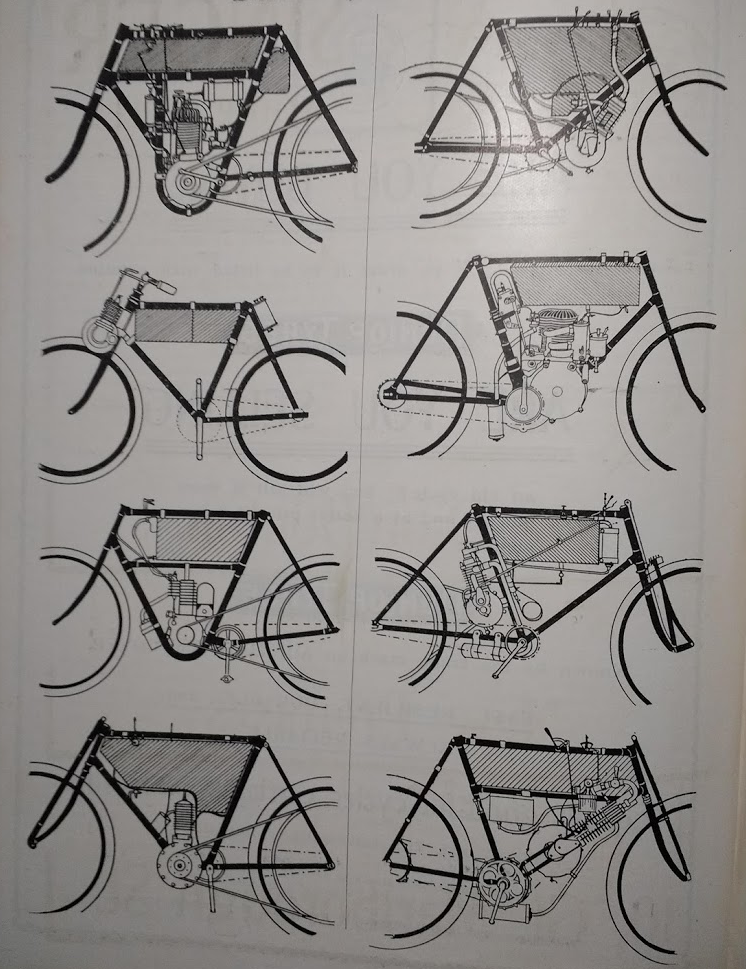
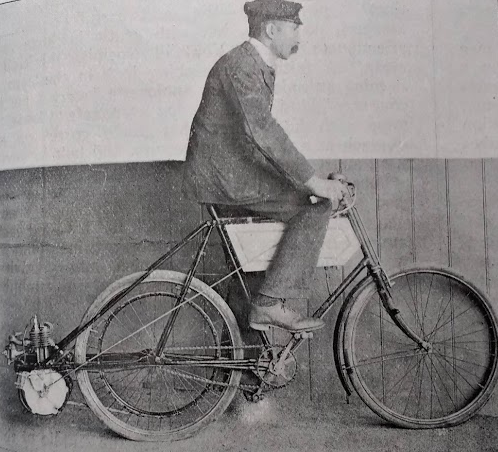
“A MOTORCAR STOLEN. For the first time in the history of motoring we have to record the theft of a motorcar. The car is the property of Mr H Arland Hood, and the theft was an audacious one. The motorcar was taken from the coach-house by an Englishman and a short Frenchman, the Englishman having been introduced to the caretaker as being the new driver by a late driver in the employ of Mr Hood. The car had been put away for the winter. The car has since been recovered, and the man captured.”
“AN INVENTOR OF THE name of Herz, said to have been formerly connected with the Daimler Co, has produced a muffler or silencer which converts the lost heat from a petrol motor into electricity. Out of every hundred heat units generated in the motor only 18 are transformed into power, 17 escape with the exhaust, and 65 are carried away by the cooling water. The inventor utilises the 17 heat units lost through the exhaust. The apparatus he uses generates an electric current strong enough to light a head light, or it can be stored in accumulators for igniting the charge in cylinder.”
“THE LORD MAYOR OF SYDNEY recently stated that, since the experiments in connection with the laying of dust with oil in that city had proved successful, it was desirable that the municipal council should proceed further with the work. It was pointed out that by purchasing the oil in bulk a large saving could be effected.”
“A MOVEMENT IS ON FOOT to form a motorcycle club for Brighton and district. A meeting of riders interested is to be held on Thursday next, February 19th, at 72 Marlborough Place, Brighton, commencing at 9pm, when a good attendance is hoped for.” [PS: The ACU reported, on 17 March 2022: “The Officers of the Brighton and District Motorcycle Club met on the 17th February 2022 to discuss the future of the club. The President proposed that as the club was no longer affiliated to the ACU and had not run any events for over seven years that the club bank account should be closed and any residue of funds donated to The Martlets Hospice and Sussex Air Ambulance. He said: ‘As President I would like to thank everyone who over the past 90 years contributed to making Brighton &DMCC a name to remember in all disciplines of motorcycle sport and activities. We promoted events at all levels, from closed to clubs through to British Championship rounds in everything except Road Racing. We even went to International level with the Clubman Sidecar Trials. We are not sad at the closing of the club, it has run its course, and we all have a lifetime of happy memories to look back on.'” The club had a roadriding section too; I had some wonderful times at Brighton &DMCC Devils Weald rallies. Happy memories indeed—Ed.]
“LIVE TO CARDIFF FROM LONDON in a day. I made the above run on my Birch 2hp motor bicycle, fitted with magneto ignition. Starting from North London at about 7 o’ark Corner, Hounslow, ultimately arriving at Maidenhead, although this was after I had made several stops to discover a certain loss of power which I had noticed from the start. At this latter place then I had my exhaust valve ground in, and with the very gratifying result that I found the machine was now about 10mph faster than before. Starting again at about 11, I soon arrived at Reading. Just beyond this town I overtook, and was in turn overtaken by, what appeared to be a 9hp Renault car. I endeavoured to at least keep up with it, but as it could go just about 3 to 5mph faster than I could, it gradually crept away and left me behind. At Marlborough I had to refill my petrol tank, and on enquiring the price from the shop attendant, was informed that I should have to pay 2s per gallon, and even at that price they did not care whether they sold it or not. However, after filling up, seeing apparently that I was only the owner of a humble motorcycle and not a car, he relented and charged me 1s per gallon only. When between Caine and Bath my Lincona belt began to slip, so that it had to be shortened. Continuing on I reached Bath about three, and, on arriving at Bristol, purchased another half-gallon of spirit, in case I should had any difficulty in obtaining it in South Wales later in the evening. Here also I took some refreshments. From Bristol I made for Patchway, to cross the Channel by the Severn Tunnel. At this village I gave my machine a general look over and made an adjustment or two. At the station the booking-clerk did not know what to charge for the carriage of the machine, and took so long to find out that I almost lost the train. After a three-quarters-of-an-hour’s ride, or thereabout, the train arrived at Severn Tunnel Junction, where I got out and started off for Newport. The next ten or twelve miles’ ride was certainly exciting, and one I shall not forget for some time. The night was unusually dark—the light of the moon and stars being absent. The road was very narrow and tortuous, and, perhaps worst of all, alternate patches of greasy and dry road were come upon in turn. Arriving at Newport, about nine, I filled up the well of the oil lamp—this is kept in reserve in case the acetylene one should give trouble. Except for the slipping of my, belt on a particularly stiff hill, I had an enjoyable ride on to Cardiff, which I reached about an hour after leaving Newport. Originally, I had intended to make Swansea my destination for the night, but as it was then late (something after ten), and the latter place 47 miles further on, I had to remain satisfied with a ride which was, according to my cyclometer, one of about 166 miles.
WH Shutes.”
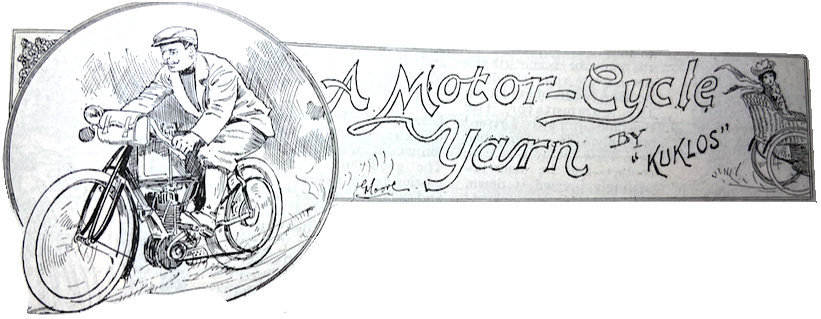
“YARNS ARE BEST SPUN when the spinner is telling his own experiences. I have to fall back on others, however, for my own motor-bicycling career has so far sparked very evenly. This story was told me by a dare-devil, all-weather rider, who has actually covered over 20,000 miles on the chain-driven Humber. Indeed, it depends largely for its incident on the fact that both the machines and the riders were in the experimental stage. It has to be confessed that it was on a Sunday morning that my friend and another left Halifax for a pleasant little run of the ‘back-to-tea’ order. So merrily did their motors mote, however, that they soon found themselves over the Pennines and in Oldham, which is a vastly picturesque town in Lancashire. Fired with new fervour and an infusion of ‘Souchong’ provided by friends, they said, ‘Let us adventure as far as Liverpool.’ Having passed through Manchester and reached Altrincham, one’s battery petered out, and the other towed him into Liverpool, where—being men of easy circumstances—they put up at the Compton Hotel. The battery taken to be charged in the morning and promised for noon, they visited the briny breezes of New Brighton, and returned only to be told that the accumulator had been found to be broken. So they bought a second-hand one for a guinea, and while it was charging, No 1 set off for an afternoon run to Ormskirk. The motor began to run like a boat-horse, however, and he found himself without lubricating oil. The best that Ormskirk could do was salad oil. With the cheerful optimism of the novice he poured salad oil plentifully into his crank-case and, to the accompaniment of a fearful stench and a poisonous smoke, set off back to Liverpool. Owing to a leakage in his high tension wire through
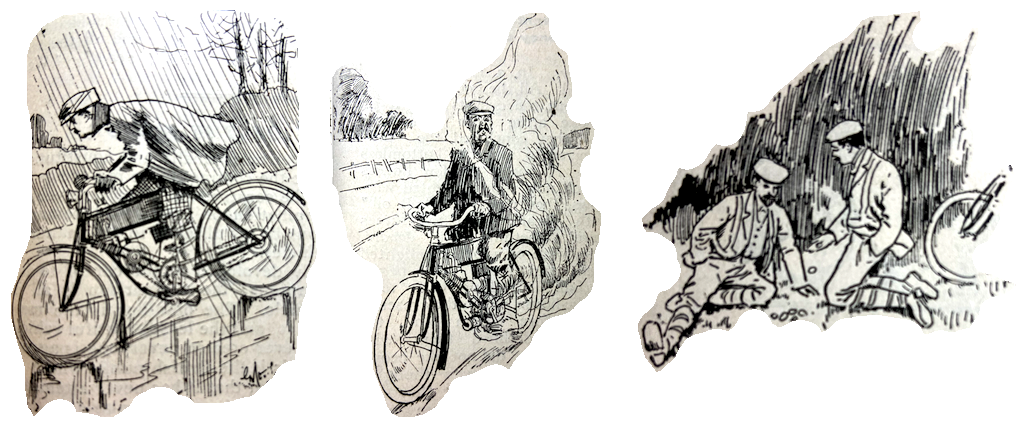
friction with the frame, he periodically became the conductor of the whole force of the coil. For insulating purposes he asked a passing tramp for string. Weary Willy had none. ‘I will give you threepence for your boot-laces,’ said our dauntless chauffeur. The delighted wanderer speedily divested himself of the laces, but the protection they afforded from the insidious current was but partial, and when the galvanised cyclist eventually rejoined his wondering friend in Liverpool, his description of the ride was coloured with electric blue. The second night of the ‘home-to-tea’ run was thus also spent at the Compton Hotel. Tuesday morning saw a fair start home, however, though the new accumulator proved too big for the case and had to be tied on behind the saddle with string. Nearing St Helen’s, the ill-fated Peto & Radford slipped its moorings, fell on the road, broke, and spilled the contents. A roadside council of war was held. Dismally pooling their money on the grass, their united funds were found to reach elevenpence in copper. The sparkless bicycle was towed by the other into St Helen’s. The only likely saviour they could hear of in the town was a doctor who ‘had a motorcar’. This gentleman proved to be a Good Samaritan of the first water. He gladdened their drooping hearts with distilled barley-water, made a valiant if unsuccessful attempt to mend the broken battery, and finally fitted them up with one of his own. About six pm they resumed the journey to Halifax, of which about fifty hilly miles remained. The route they were ignorantly taking is one of the worst in England—densely populated and execrably paved. Forthwith a tyre began to go down with diabolical regularity. Many times was it removed before it was found that a block of the back Bowden was touching the valve and opening it quite intelligently. It was the fault of the valve; and the difficulty was got over by changing the tyre on to the front wheel, where there was no brake. It was getting dark when one motor began to misfire badly; nor could he fault be seen. As the disconsolate rider stood reflecting with one foot on the commutator, the machine jumped forward suddenly. The spring had been loose—it was a wire contact—and he had un-wittingly pressed it down. The mystery was solved! Bumping into Wigan, they spent their last penny in a new lamp-wick. But the lamp would not burn, and the oil-well was found empty. In a roadside ‘working-men’s club’ they begged for oil. All the good colliers had was what they called ‘pit oil’, but the cyclists took it gratefully. Such dense yellow smoke arose from that lamp that they concluded the ‘pit’ referred to was the bottomless one. At one of the few houses which now showed
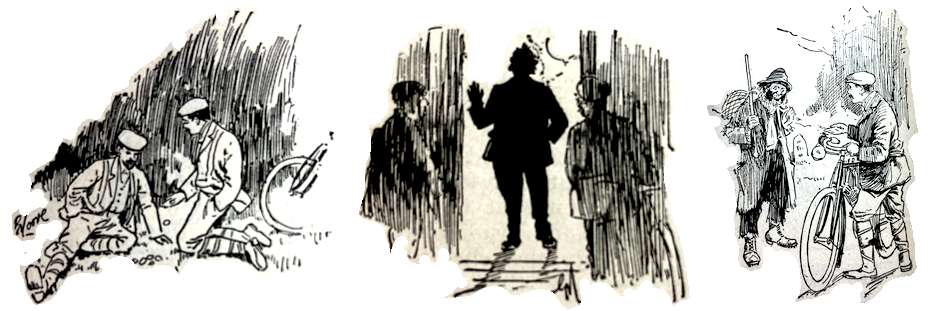
lighted windows, they mixed the ‘pit oil’ with paraffin, and the fumes were something less deadly. They were on a rough, unlighted road, and heavy rain began to fall. Walking back to a public-house, which they reached just before eleven pm, the landlord declined them with them with thanks. He did not like people without money, even though their cycles were worth £50 apiece. He thought they might be able to get put up at the next inn, three or four miles back. A black-faced, clean-hearted collier volunteered to find them shelter, if not beds. When the two motors were wheeled into the little living-room it was .about full. One man ‘dossed’ on the couch and the other on the hearth-rug. Six times during the night the pitman descended to warm some milk for his ailing child, and each time he put the friendly query, ‘Are ye all reet?’ Breakfast was at six am. The goodwife was preparing a succulent dish of eggs and bacon, whose savour was simply god-like to the half-starved chauffeurs, when the fire and the frying-pan and all its contents were suddenly smothered order a heavy fall of soot. The travellers wept silent tears. Nothing daunted, the pitman sallied forth and secured more bacon; and the ‘back-to-tea’ jaunt was resumed—Wednesday morning it was—by the two grateful and invigorated adventurers. Nothing much of moment now occurred until Bacup was reached and passed. From here to Todmorden the road rises sharply to a height of 1,300 feet. No 1 flew up to the top—there is nothing like the chain-drive for this sort of country—but he missed his friend and waited on the summit. Presently No 2 came up smiling. At a cottage down below he had asked for a drink of water by way of dinner—it was high noon. The good lady took compassion on his hollow cheeks and hollower stomach, and plied him with hot coffee and a hot North-country delicacy known as ‘fatty cake’, or ‘oven-bottom cake’. But his joy was short-lived. Fasting people should be careful how they eat, and ere long he fell grievously sick. At Luddendenfoot, which is in sight of Halifax, and is locally known as ‘Fooit’, one engine groaned and gave up the ghost for want of petrol. By way of a respectable entry, they cleaned up the machines and one pedalled and the other puffed triumphantly to their club in Halifax. ‘We’ve just ridden from Liverpool,’ they said, lightly. ‘Have you come all the way from Liverpool on those things?’ ‘Oh, yes!’ ‘We’ll, I’ll be ——-!'”
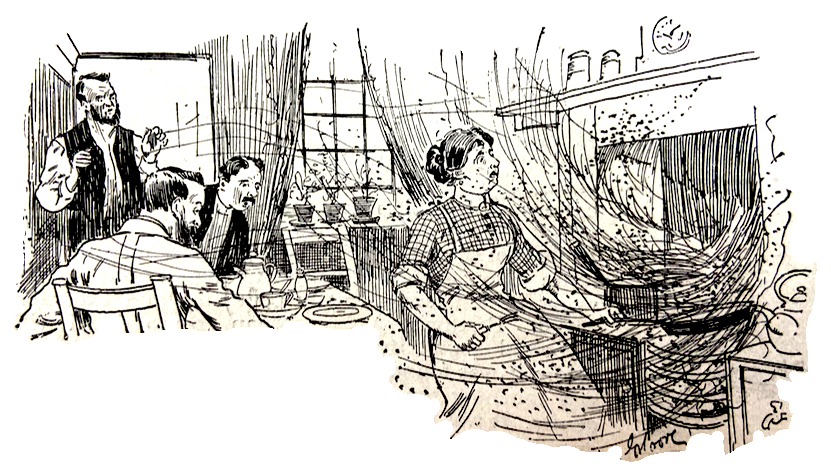
“THE FIRST AMERICAN WOMAN to practically use the motor-bicycle is said to be Mrs FP Kent, of Waltham, Mass. The Thomas Auto-bi, upon which she is mounted, has been used by her for over twelve months. Although her parents own a motorcar, which is always at her disposal, she believes that for real pleasure nothing can compare with the motor-bicycle.”
“THE PRINCE OF MONACO is a keen motor-cyclist, and has for some time ridden a French machine. We happened to call at Mr Asbury’s depot in Queen’s Road, Bayswater, the other day, and learned that he had just sold a 2¾hp Beeston Humber motor-bicycle to his Royal Highness: The Prince had taken the standard machine as fulfilling his ideas of a practical motor-cycle, and had desired no alteration to be made. It goes to his yacht at Portsmouth, and will first be ridden by the Prince on French roads.”
“MAURICE FOURNIER, WHO IS now over in England, tells us that he is open to ride against any motorcyclist in England at any distance from one to fifty miles for a sum up to £250 a side, the event to take plan on any outside track to be decided on. Fournier is at present riding a motor bicycle with a Carreau frame, fitted with a 4½hp Soncin motor.”
“TWELVE MONTHS AGO I purchased a Thomas Auto-bi (American machine), and it has given me considerable pleasure. Unfortunately, it is rather expensive to run.- Petrol is 27s 6d. per 8-gallon tin here, and for the first 7,000miles I used one gallon of spirit for each 80 miles. ‘Cyclomot’ records a run of 106 miles on 6½ pints, and ‘Magneto’ a run of 80 miles on 4 pints. What would be appreciated by motorists abroad is a clear statement showing what can be done with various machines, giving minimum and maximum speeds, consumption of oil per 100 miles, petrol-carrying capacity, weight, price, hill climbing tests, etc. A statement such as this would be of great value to those like myself who are unable to. attend the exhibitions and see for themselves.
EH Short, Government Railways, Cape Town.”
HERE’S A WHIMSICAL reminiscence that offers an insight into club life: “On tour and in club runs it has always been legitimate to penalise a rider who knows too much and talks too much by putting his machine temporarily out of commission. A fussy and self-important motor cyclist can be amazingly funny when his tank has been secretly filled with paraffin, or his magneto points separated by a tiny disc of paper, or the plug wires of his twin crossed, or his air wire coupled to his throttle or vice versa. Perhaps the best trick of this sort on record was perpetuated on a dark night when Binks was refreshing himself inside an inn. One of his pals wedged a billet of wood between the back tyre and the mudguard. After lengthy potations Binks came our and attempted to start his single-geared bus. He dosed his apprently seized engine repeatedly with paraffin. We were all very helpful, and with five or six of us pushing Binks at last got away in clouds of blue smoke and proceeded at about 8mph, sooting a plug every mile or so. He naturally needed further refreshment at the next town, and while he was obtaining it we removed the billet of wood. We have never dared to tell Binks the facts; he still muses over the queer conduct of that engine. I am all against any real mechanical interference with a pal’s machine. But in the case of a frightful bounder who needs a real lesson it may occasionally be permissible to retime his magneto. This should not be overdone, substituting full retard for full advance being far better than transferring the spark to the exhaust stroke, or to solder up the passage connecting the float chamber to the jet chamber. In one priceless case of this sort an unspeakable person was despatched to Scotland for a whole week by his firm, and for his soul’s good, his riding associates took his engine entirely to pieces and substituted a new connecting rod considerably shorter than the original part. The resultant engine symptoms baffled several experts, who were not in the know, for quite a time.”
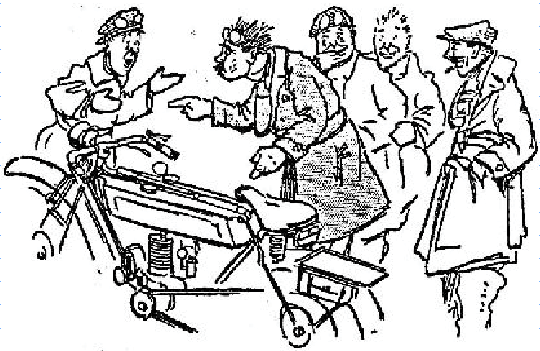
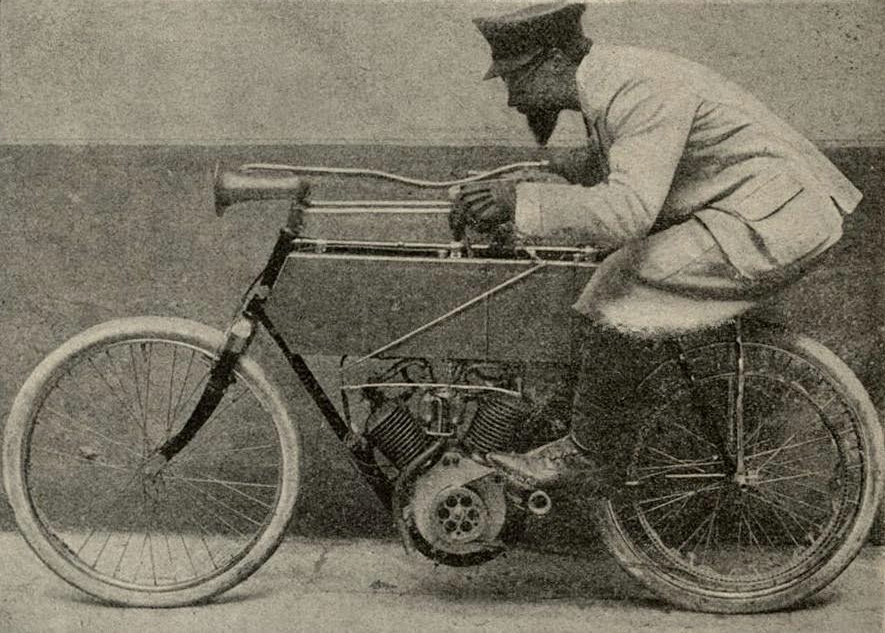
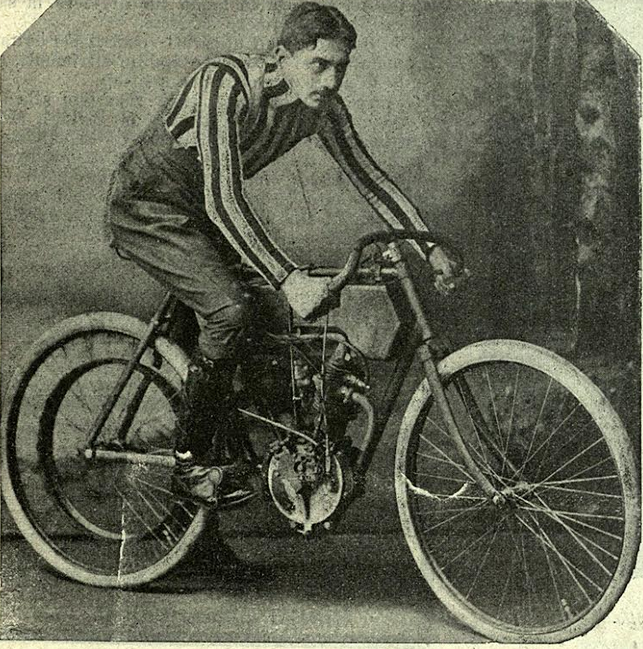
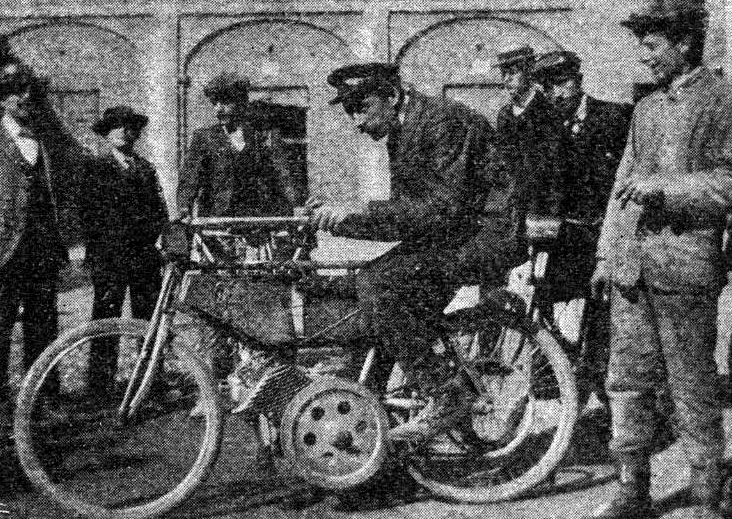
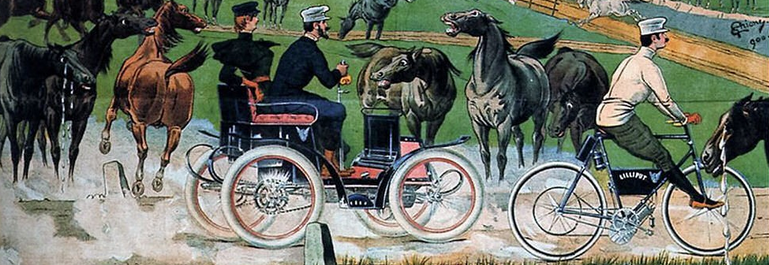
“MOTOR-BICYCLE IN A BALLOON. The we11-known motorist and balloonist Mr L Bucknall uses his Werner motor- bicycle for a novel purpose. Frequently in his balloon trips he descends mites from a town or railway station, and he finds the machine which he takes in the balloon with him very valuable to get quickly to his destination.”

“THERE WAS SHOWN at the New York Exhibition an ER Thomas motor-bicycle which had a distinct novelty fitted to it in the way of driving belts. This consists of a narrow bicycle chain encased throughout its length with a strip of twisted leather. This runs over the usual V-grooved pulleys, and the makers claim that the belt is quite non-stretching, the one shown having run 2,000 miles On the same machine was shown a cushion spring fork, which is fitted with a view to absorbing the shocks and vibration from the front wheel. This consists of an additional pair of forks which run up from the axle to the head clip. On the rear stays of this machine there are fitted a pair of telescope spring pistons and tubes to

absorb vibration at this part of the machine. “The ‘Marsh’ is a rakish-looking mount, made by the Motorcycle Manufacturing Co, Brockton, Mass. The motor is a 2hp air-cooled built into the frame in a substantial manner between the seat-post and the bracket junction. The pedalling position, however, looks distinctly an awkward one, as the rider is far too much forward. By reversing the T-pin it would be somewhat of an improvement it it did not bring the rider out of reach of the handlebars. The ignition is by means of dry batteries carried in a case on the back forks and induction coil. The carburetter is a float-feed spray fed from a tank carried by the horizontal tube. The silencer is of the cylindrical type and looks of very effective proportions. A good feature in the frame design is a girder head, jointed up at the axle crown and top ball race. The drive is by means of a flat belt running over a jockey pulley. “The ‘Merkel’ motor-bicycle is made by the Merkel Manufacturing Co, Layton Park, Milwaukee, Wis. This has a 2¼hp air-cooled motor clamped in a slightly inclined position in a loop tube, which is carried up to the seat lug and also forms the diagonal. There is no exhaust ,box, as the spent gases are turned into the main tube at the support near the combustion head The ignition battery, of the

dry type, is carried in a long cylindrical case clipped to the diagonal. The induction coil is fitted in a case below the petrol tank. This tank has a capacity of nine pints, to run one hundred miles. Belt transmission is used with jockey pulley adjustment. The carburetter is a special form of spray, connected direct to the combustion head. A triple steering head is used, giving ample strength at this vital point. Speed regulation is by advance spark lever and exhaust valve lifter. “The ‘Metz’ machine is produced by Chas H Metz, Waltham, Mass. It has the special features of an outside fly-wheel motor of 3hp built into the frame, and has a direct chain-drive. No exhaust box is used, the gases passing into the main tube, which acts as a muffler, and the connection tube also helps to support the motor. A flexible clutch is incorporated into the motor sprocket, and this is capable of adjustment to any tension. Ignition is by means of a coil in the seat-pillar tube and a set of dry batteries carried in a case in the angle between the main tube and back forks. The carburetter is of a special type, so designed that a uniform level of petrol is always obtained in spray jets, of which there

are three, no matter what the angle may be the machine occupies in going up a steep hill. The framework of the machine is of a very stout gauge and diameter throughout, and special attention has been paid to the front forks. The horizontal tube serves as a lubricating oil reservoir. The motor is controlled by turning the left handlebar grip, which actuates the spark advance and the exhaust valve lifter. The brake equipment consists of a powerful band brake worked, by back-pedalling. The wheel base is 46in and the tyres are 2¼in diameter on steel rims. This machine is capable of reaching a speed of 40mph and weighs, complete, 115lb. Price is £36. The motor tandem made by Cecil E Gibson, East Ohio Street, Indianapolis, Ind is fitted with a Merkel motor, 2¼hp, clamped inside the rear panel of the frame. The carburetter is a spray type supplied from a tank fixed on the horizontal tube. No exhaust box is fitted, but the rear handlebar tube serves as a muffler. Belt transmission is used. A sight feed lubricator is used for supplying the crank-case. Ignition is by dry batteries and coil, and speed regulation by spark advance and exhaust lifter; duplex girder front forks are fitted. The price of this machine is £38. “The Mitchell Co, Wisconsin Wheel Works, Racine, have recently brought out a racing motor-bicycle. This they term the ‘mile-a-minute machine’. The motor is an air-cooled one, giving’ 3½hp at a maximum speed of 1,400rpm. The frame is a specially designed one, braced at the crank bracket and head by curved and web trusses, and duplex or girder front forks are fitted. The motor, which has a bore of 3½in. and a stroke of 4in, is placed in a loop with a forward inclination and is supported by lugs on the crank bracket. The wheel base is unusually long, being 55in. Ignition is by dry batteries and coil, and the drive by a twisted hide-belt. The pulley ratio is 4½ to 1, and the carburetter is of the mixing valve type.”
“THE COLUMBIA MOTOR-BICYCLE is made by the American Cycle Manufacturing Co, Hartford, Connecticut. It is distinctly American in its design, and is fitted with a 2¼hp air-cooled motor placed behind the diagonal tube, and driving by means of a chain. The carburetter is a float-feed pattern, on the lines of the F.N, the petrol supply tank being placed behind the saddle. The entire control is effected by means of the front brake lever, which is arranged to open the exhaust valve with a slight movement, and by reversing the movement the valve shuts. Further movement advances the spark, and drawing back the lever retards the spark, then lifts the valve, and finally puts on the brake. In addition to the front rim brake, a back hub brake is fitted. There is a spring clutch for the chain drive. Ignition is by coil and dry batteries, these latter being carried in a cylindrical case on the main tube. The complete machine weighs 1281b, and is priced at £45.”
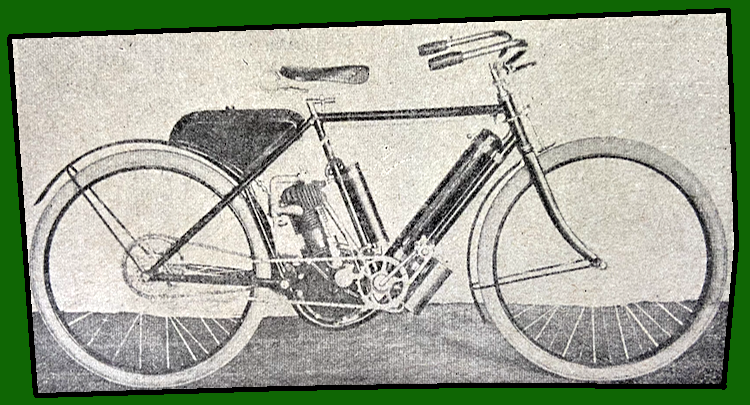
“THE ‘WAGNER’ MOTOR TANDEM bicycle is made by the Wagner Cycle Co, St Paul., Minn, USA. The motor used is 2½hp and has tapered radiating flanges. This is clamped in a loop tube and slightly out of the vertical. The transmission is by a flat belt, a jockey pulley being placed close to the rear belt rim. The rear part of the frame is dropped to enable a lady to ride it if required. A notable point is that the exhaust gases are carried away by the looped tube to which the motor is fixed. A dry battery and induction coil are carried in a wedge-shaped case secured to the back forks. A spray carburetter is fitted and a supply of petrol and lubricating oil is carried in the case seen supported from the horizontal tube, only one brake is used, this being a ‘New Departure’ hub brake. Controlling of speed and lifting of the exhaust valve is done from the front handle grips. The mudguards are of a better type than usual on American machines and there is also a guard over the chain.”
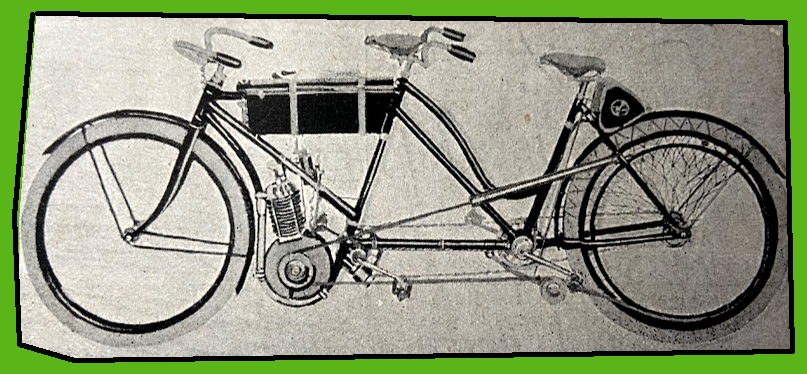
“THE MOTOR TANDEM MADE by the GH Curtis Manufacturing Co, Hammondsport, NY has a 2½hp motor supporter, somewhat ‘a la Werner’. A special feature of this motor is the main bearing. This has a set of 25 steel rollers held in bronze retainers. The silencer is of large dimensions, and the carburetter is of the mixing valve type. Ignition is by an induction coil and set of dry batteries, supported in typical American fashion in a case on the back stays. The transmission is by twisted belt with an adjustable jockey pulley, fixed to one of the compression stays. Only one brake (of the hub variety) is fitted. Special control is effected by spark advance and valve lifter. Petrol and oil supplies are contained in a rectangular tank fixed between the two horizontal tubes of the frame. It is geared 7 to 1, giving a maximum speed of 30mph. It has girder front forks, and the weight comes out at 160lb.”
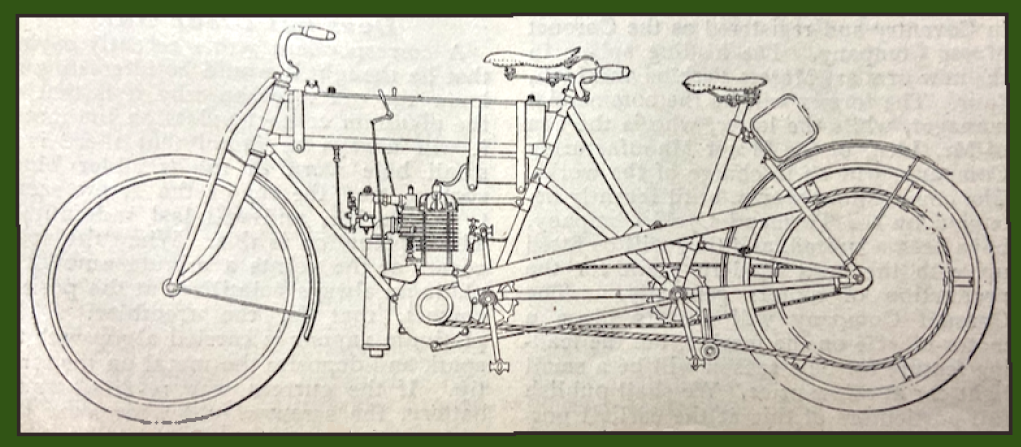
“THE ORIENT MOTOR, which is fast becoming a favourite, is a much larger and more heavily constructed machine than any other motorcycle made, and is distinctly in a class of its own. It has been found from long experience that it is necessary for safety and comfort that a motorcycle which has sufficient strength to stand the great strain of its motive power must also have weight enough to absorb the vibration of the motor. A light-weight motor-bicycle is not a practical or successful machine, and even should it not actually break down and injure the rider, the vibration from the motor would be so excessive that the operator would very likely tire of his mount after a few ordinary rides and the machine would be well shaken to pieces. All these conditions, it is claimed, have been carefully considered in the building of the Orient. No working advantages have been sacrificed to try to make the machine look like an ordinary bicycle, nor has there been any attempt to make the motor or other working parts serve as portions of the frame, to the disadvantage of both. The frame of the Orient is heavily constructed of cold drawn steel tubing, strongly brazed in suitable connections. The motor and operating parts are strongly secured to the frame in the position that practice has proved to be the most desirable, and in a manner to admit of their convenient; removal when required.”
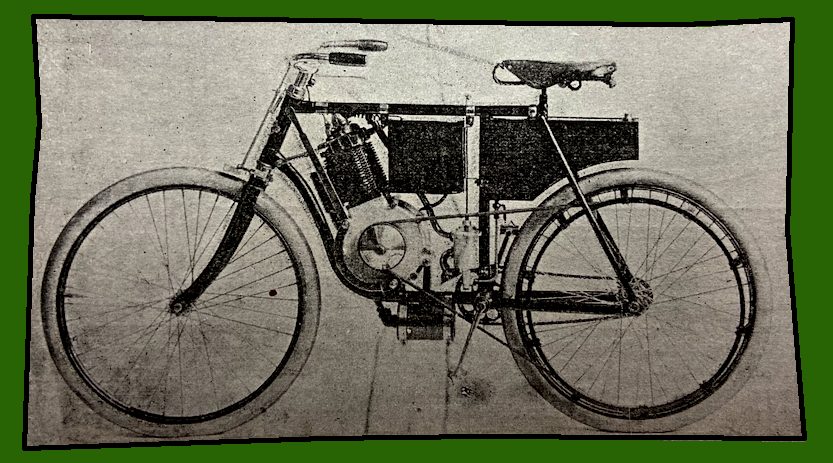
“A MOTOR-BICYCLE MADE by the Queen City Cycle and Motor Works Co, Queen Street West, Toronto, Canada is rated at 3½hp, and has the motor placed in between the diagonal tube and bracket—a favourite American system. The petrol tank is of cylindrical shape, supported from the horizontal tube, and supplies the motor by a spray carburetter. The drive is by means of a half-inch round leather belt, an adjustable jockey pulley being fitted. The induction coil will be seen just below the petrol tank, and a supply of electricity is obtained from a set of dry batteries carried in a rather bulky looking case behind the rear forks. Speed control is effected by an advance spark lever and throttle on the carburetter. The only brake apparently is a rear hub brake, and there is a notable absence of mud-guards, except an apology for one on the rear wheel. A four-plate crown is fitted and single tube tyres. The firm also make a 5½hp tandem.”
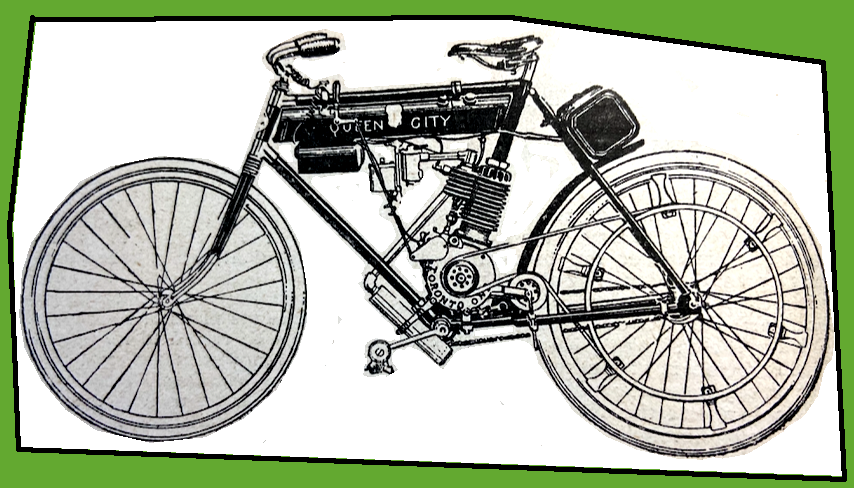
“THE MEMBERS OF THE Motor Cycling Club gave evidence of the possession of considerable pluck on Saturday week, for despite the fact that the roads were a quagmire, they met at Purley Corner, after safely negotiating greasy tram lines and erratic traffic, and then hied them away to Brighton. The President of the club, Mr SF Edge, drove his 16hp Napier car, with Mrs Edge and Mr JW Stocks on board. Mr Perman drove his Gladiator, being accompanied by Mrs Perman, Mr Swindley and Mr CH Smith. Mr Munn also had a party on his De Dion car. The motor cyclists included Messrs EH Arnott, GE Roberts, E Perman, J Pennell, Mr and Mrs Johns (the latter in a trailer) and Messrs Hayes, Ridings, Fairfax, Marsh and Brett. The road from Purley to Merstham. The road from Purley to Merstham was really wicked, and many years of experience of the Brighton road warrants us in saying that it has never before been in such a fearful state. The riders left Purley at 3.30, reached Crawley soon after 4 o’clock, and left again at 5.15, and within an hour the first man reached the ‘Old Ship’ on the Brighton front. This was Mr Hayes, riding a 2¼hp Empire. His machine was fitted with the pair of sup-ports which are raised and lowered by movements of the feet. He thinks them invaluable on muddy roads, as they absolutely check side-slip. Mr. Edge’s car had drawn up a couple of minutes earlier, and at a quarter-past six Mr Perman’s Gladiator car arrived. Then at 6.25 Arnott on a speedy Werner and Ridings on a Bat came easily in, the latter looking as if he had just come from a potter along the front. The remainder came in at intervals, and soon after seven o’clock all had arrived. At the dinner the riding party was strengthened by friends in the locality, and a very pleasant evening was spent under the chairmanship of Mr SF Edge…in his short address, Mr Edge referred to the suggestions now circulating for an international motorcycle race to he run immediately after the Gordon-Bennett race had been decided, and expressed the opinion that the idea was not practicable. He made the pleasing announcement that he was willing to put up a prize to the value of £20, to be won outright by any member of the Motor Cycling Club in a competition to be organised by the club. Members should be allowed to make individual rides, accompanied by two observers, of a distance of 200 miles, at a week-end. The pace should not exceed 17mph, and every stop, except those authorised for meals, should count against the rider.”
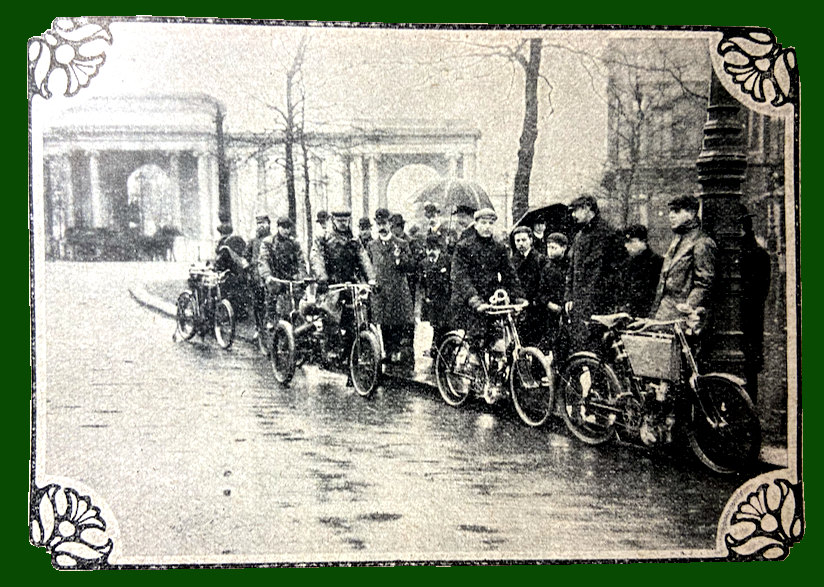
“On the occasion of the run of the Motor Cycling Club to Brighton I had the opportunity of observing the behaviour of the patented device of Mr Hayes, known as the Empire support, and I was struck with its extreme utility. It was an emergency support, a stand, jack, or an anti-skid, according to the needs of the moment. Riding through traffic, the cyclist was able, when forced to pull up, to drop the two legs to the ground, and thus provide himself with a couple of struts or supports until the traffic once more moved forward. When the rider gave a stroke to the pedals, he not only propelled his machine, but the clutch on one of the cranks raised the supports a few inches from the ground, when they folded in close to the frame. Going through the grease it was noticed that the rider kept his supports out in the extended position, so that in case his back wheel slipped, the small wheels at the lower end of the leg on the falling side, would immediately touch the ground, and thus avert the skid, The supporting legs were raised or lowered by the simple movements of forward or back pedalling. As a support in the coachhouse, or as a jack, the device was extremely useful because it was in position whenever it was wanted. This, of course, was its most valued feature, because there was no need to precariously prop the machine against the wall, to the detriment of the plating, and the help of another person was not necessary in order to place a movable stand in position. The device struck me as being so good in practice and, at the same time, by no means unsightly when fitted up, that it well merited a word of recommendation at my hands…One of our staff recently put its claims to a practical test on the road, and can state with assurance that by its use side-slip was absolutely prevented. When grease is approached the two small wheels are moved downwards and outwards by back pedalling. Then should the back wheel slip, one of the small wheels instantly grips the road and the slip is stopped before it has gone far enough to be serious. The device is supplied also as a support or jack only. For this purpose it is invaluable, because it adapts itself to any shape of road. Few roads are flat, but in spite of this with the usual pattern stand a flat surface must be found or it is useless. On the crown of a road or in the gutter the Empire Support will hold up the bicycle to which it is attached. It can be operated instantly, does not interfere with luggage, and the bicycle can be wheeled backwards or forwards as desired. After having had it in use for a period and discovered its many advantages the writer felt quite at a loss when riding a motor-cycle without the attachment. The price as a jack only is £1 1s, or complete with back pedalling device, £2 l0s, and the makers are The Empire Motor Cycle Co, Bulwer Street, Shepherd’s Bush, W, who will supply any further details required.””

“THE CLISSOLD MOTOR BICYCLE. The accompanying illustration shows a form of motor bicycle designed to stand upright whether mounted or unmounted. By its use much of the convenience of a motor tricycle can be obtained, while the great and distinctive advantages of a bicycle, speed, compactness, a single track, etc, are not in any way impaired. The special feature is the support. This consists of an arm or crosspiece, at either end of which are two small rubber tyred wheels, which crosspiece or arm is suspended in the middle to two members or stays, these latter being pivoted at their centre on pins fixed into the compression stays of the bicycle close to the crank-bracket. When not in use the support is kept in an inclined position by a spring which lifts the small wheels some inches from the ground. It is put in action by rotating the handle-bar, with which it is connected by a cord. It appears to us to be a practical device which will be useful to novices and elderly riders. It is made by the Clissold Cycle Co, 77, Green Lanes, Stoke Newington, N.”
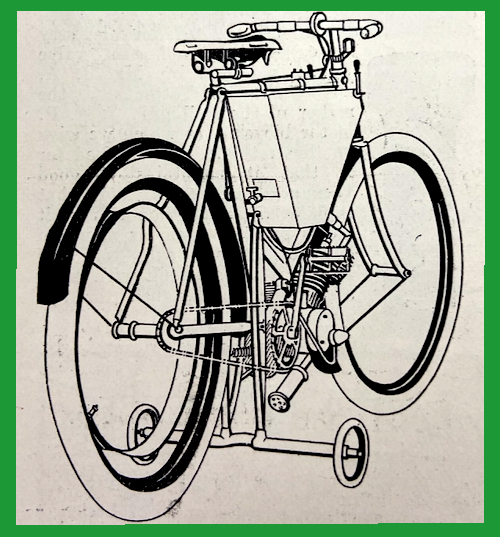
“THE SERIES OF MATCHES between Maurice Fournier and Charles Barden were run off last Thursday at the Canning Town track before a large ‘gate’ of over 4,000 people. The events were a couple of one-mile races from a flying and standing start respectively, making four altogether, with a decider if necessary. There is little need for a lengthy account of the matches, Fournier easily winning the first three of the series, Barden at no time appearing in front, and being almost the length of the straight behind the Frenchman at the finish of the first event. Time 1min 14⅗sec. The standing start mile was won by Fournier in 1min 23⅗sec; Barden’s time was 1min 40⅗sec. In the third match, flying start, Fournier’s time was 1min 18⅖sec. It was certainly a most hollow victory.”
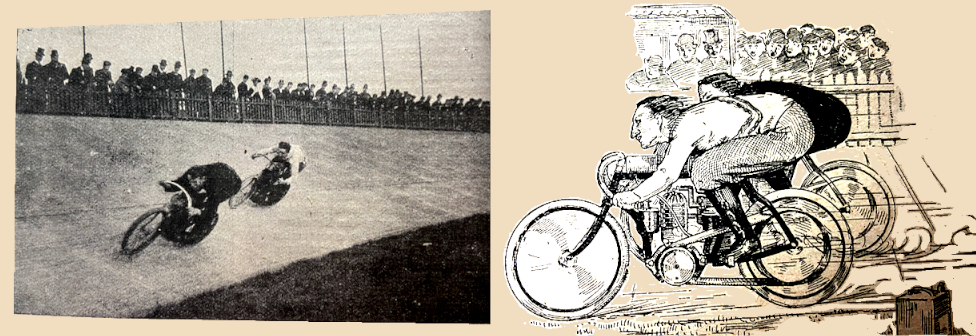
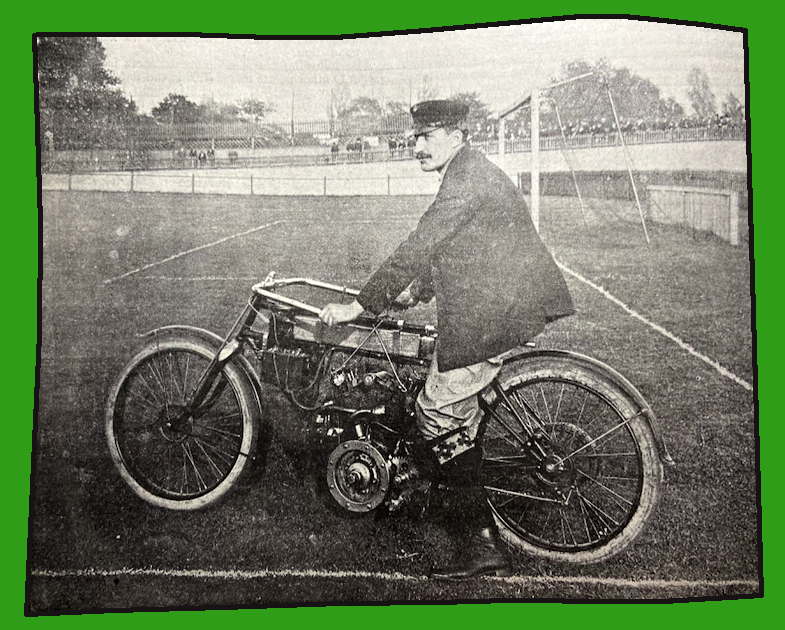
“THE LATEST PRODUCTION in motor-bicycles of Messrs Pearson Bros, of Elm Grove, Southsea, is a fine piece of work, doing credit to its designers, and one which will give pleasure to its users. The frame is specially designed, and it will be seen that great strength is provided at the head—usually- much weaker when high-powered motors are used than is generally thought. There should be no possible ground for hesitation about the frame in this case, because of the support which proceeds from the base of the ball head socket to the motor which it completely encircles. Moreover, the design permits of the motor assuming a vertical position. The motor is a 2¾hp De Dion, with carburetter and coil of the same make. Other features are Peto & Radford’s armoured accumulator, automatic oil pump, an exhaust valve lift operated by a Bowden wire, large tanks, giving capacity for 1½ gallons of petrol and 1½ pints lubricating oil, NAB spring seat pillar, Clincher motor tyres, two powerful brakes, and rear mudguards in two pieces, so that the tyre can be reached readily in case of puncture.”
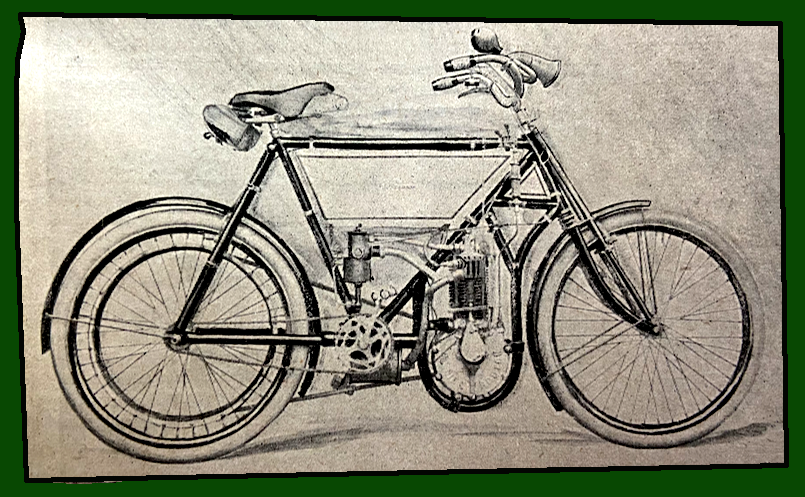
“The ‘Bowdon’ Motor Cycle is designed and manufactured by H Cragg & Sons, Church Street, Altrincham, Cheshire. There are some special features about the design worthy of notice. The drive is by a special double ½in pitch chain of Hans Renolds make. This transmits the drive to an aluminium pulley, which is grooved out to admit a raw hide belt. This is shrunk in and forms a bed for the chain and admits a good grip being taken up by the side and middle plates of the chain. The motor is a 2hp Simms, fitted with magneto ignition and a clutch giving a free engine at will. This can be thrown in and out of action by means of a lever. The carburetter is a spray pattern. A lever on the forward end of the horizontal tube is used to advance and retard the ignition. The frame is very strongly built and the down tube is trussed and the motor placed inside. A Bowden back rim-brake is fitted, and also a lever brake for the front wheel. The chain-drive machine costs 50 guineas, and if a belt drive is fitted instead, 45 guineas.”
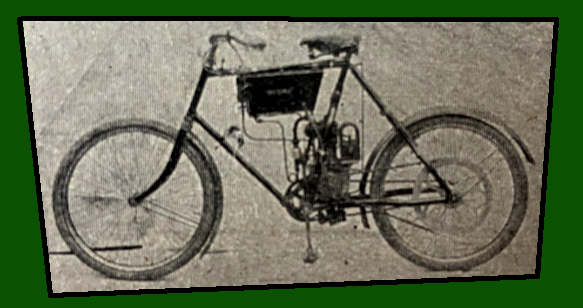
“THE THIRD OF THE 1903 London motor-car exhibitions is now open to the public at the Agricultural Hall, and a brave show it makes. The fact that it has been preceded by two earlier shows, one of them—that at the Crystal Palace—of considerable magnitude, does not seem to have detracted to any very great extent from its success, although it has to be admitted that there is much needless repetition, many of the exhibits having already been shown in London and fully illustrated and described in these columns. At the same time novelties are not, by any means, scarce, and they are to be found in all sections of the exhibition. The Coventry Eagle Co show their standard 2½hp touring machine. In this the motor is placed vertically in a loop of a special frame which has an extra long wheel base; duplex front forks of great strength are fitted. The motor is made by E Buchet, of Paris, which name is a guarantee of good work. The carburetter is
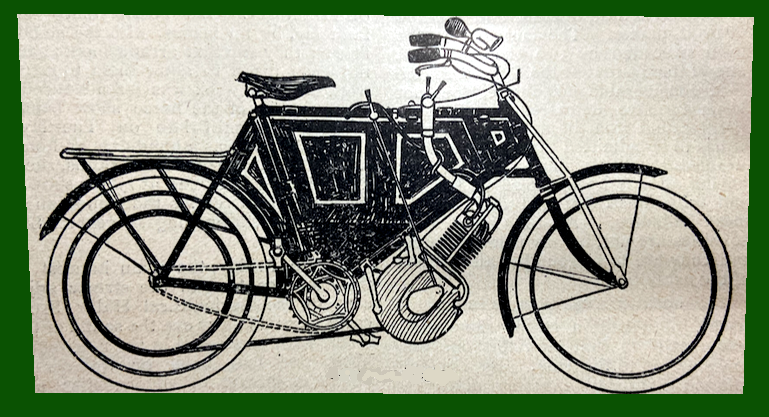
of the FN type. A noticeable feature is the large exhaust box used. Ample brake gear worked by Bowden wires is fitted and the transmission is by a Lincona belt. A high-powered machine fitted with a 5hp Buchet motor calls for special notice. The whole of the space inside the frame is fitted in with the tank compartments, and the machine is equipped throughout as a long-distance machine. The Coventry Eagle fore-carriage looks a thoroughly serviceable and well-finished vehicle. A number of trailing cars are shown, one of these has a reversible body. The springs and upholstering of these little vehicles is excellent. HP Salsbury, Harvist Road, Kensal Rise, London, exhibit the 2¾hp Humber chain driver, which has earned such a well-deserved reputation for sale. The Garrard Manufacturing Co’s Magneto Works, Birmingham, have an interesting display of motor-bicycles and tandems. All the machines are fitted with the famous Clement motor, and in addition to the featherweight motor 1⅓hp, there are several new patterns. A 2hp size is only a. few pounds heavier than the 1⅓hp size. The 65-pounder now has 26in wheels, extra long wheel base and excellent brake and guard equipment. The fork crown fitted on the models is a very strong one. A 3½hp twin-cylinder machine comes out very light, and looks a fast mount. The two-speed gear and chain-drive is now fitted to the 1⅓ and 2hp sizes. Many minor improvements have been made, chiefly in the arranging of the regulating levers which now work in notched quadrants. The larger powered motors have tanks fitted inside the frame. The tandem which is arranged for a lady on the rear saddle is made with a 2hp and a 2-speed gear, and also 3½hp direct belt drive The wheel base is
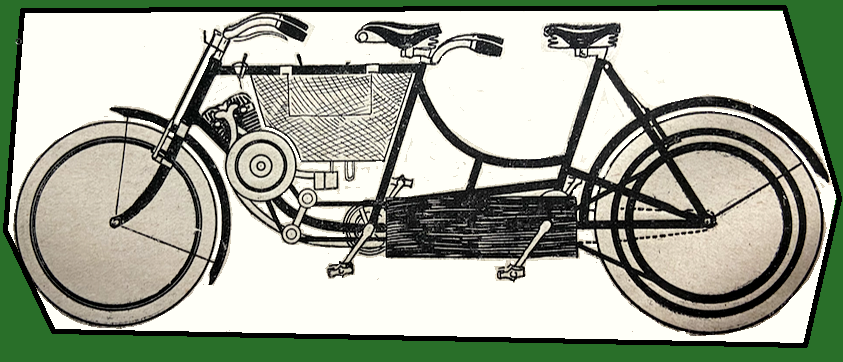
abnormally long; the frame is graceful in outline and amply stayed. The belt is protected by a special leather guard. All machines have the new Garrard Maxfield ignition. The four-cylinder racer is also shown. Bayliss, Thomas & Co, Coventry, have a fine stand on which they display six of their 2¾hp machines. The frame-work is of special strength and design throughout, the girder head connection calling for special notice. The front forks are very massive, and are carried right up to the top ball race. The drive is by means of a Lincona belt. Both surface and spray carburetters are fitted, the latter being the Longuemare type. A very neat and efficient exhaust valve lifter is fitted. Lubrication is effected by means of a sight feed pump supplied from a small tank placed in the angle between the diagonal tube and back forks. Rim brakes are fitted to both wheels. FA Powell, Digbeth, Birmingham have a handsomely finished and well designed motor-bicycle. It has a 2¼hp motor, placed vertically in a cradle in front of the crank bracket, and drives by a flat leather belt. The carburetter is a spray of the FN type; in fact, many parts of the machine bear evidence of the high-class work of the FN Co. The tank is fixed in the large panel of the frame, and is finished off in dark bronze. An effective looking band brake is mounted on the front wheel hub. Coxeter & Sons, Abingdon and Oxford show the Abingdon motor-bicycle, fitted with the 2½hp Minerva motor. It has a Longuemare carburetter and a noteworthy feature is a spare petrol tank placed behind the diagonal. The lubrication is effected by a sight feed pump, and the drive is by means of a Lincona belt. The machine is well equipped with brakes, and nicely finished throughout. It is priced at £45, fitted with special Liberty tyres. AW Gamage, Holborn Viaduct, London shows the Red Star motor-bicycle. This has a 2hp vertical engine partly supported in a truss from the diagonal tube, and also between the compression stays and main down tube. The carburetter is a special type placed right on top of the inlet valve. The petrol and oil for lubricating are carried
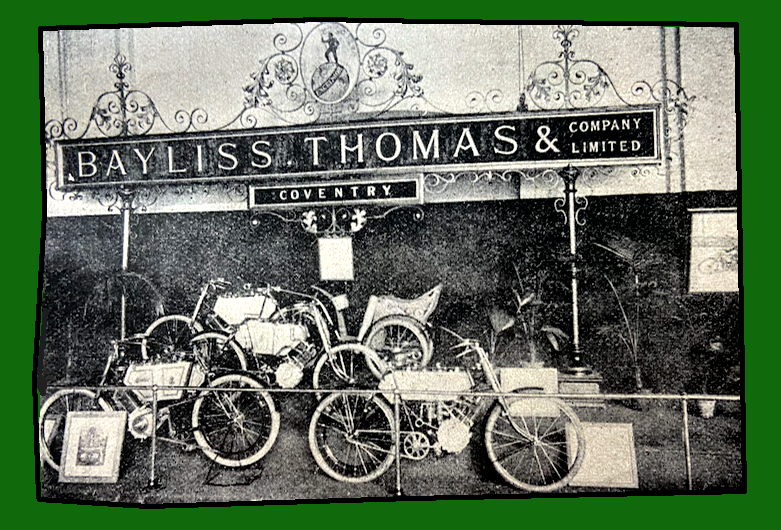
in a cylindrical tank supported from the top tube. The ignition is high tension electric, the accumulator being carried in a leather case behind the saddle, and the coil is clipped on to the diagonal. A special feature of this machine is that the regulation of speed can be entirely effected by the handlebar grips. Special Dunlop tyres are fitted. Here also will be found a varied assortment of this firm’s goods. New types of goggles, with detachable shades, which will be appreciated by fast riders and several new types of head protectors for ladies’ use are shown. Different forms of the new spark gap, one to fix on the dash board, and other types enclosed in glass tubes. The new Hydra and Pyros sparking-plugs may be seen, and give evidence of being all that could be required. A spray carburetter for engines up to 2hp, retailing at l0s 6d, with petrol tap as well, seems a well-made and exceedingly cheap article. The Lancaster Motor Garage, Lancaster Gate, London, W, showed the ‘Hurtu’ motor-bicycle, fitted with a vertical 2hp engine with tapered radiators. The drive is by means of a V-belt on to a large-diameter belt rim rivetted to the tyre rim. The motor has a large pulley also. An FN carburetter is fitted; ignition is high tension, the coil being clipped behind the diagonal tube. The lubrication is provided by a force pump fitted inside the tank. The tyres are Dunlop 2¼in; the brakes consist of a New Departure hub brake and front tyre brake. It is priced at £35. The Pebok Motor Cycle Co, Leadenhall Street, London, exhibited a ‘Pebok’ Model de
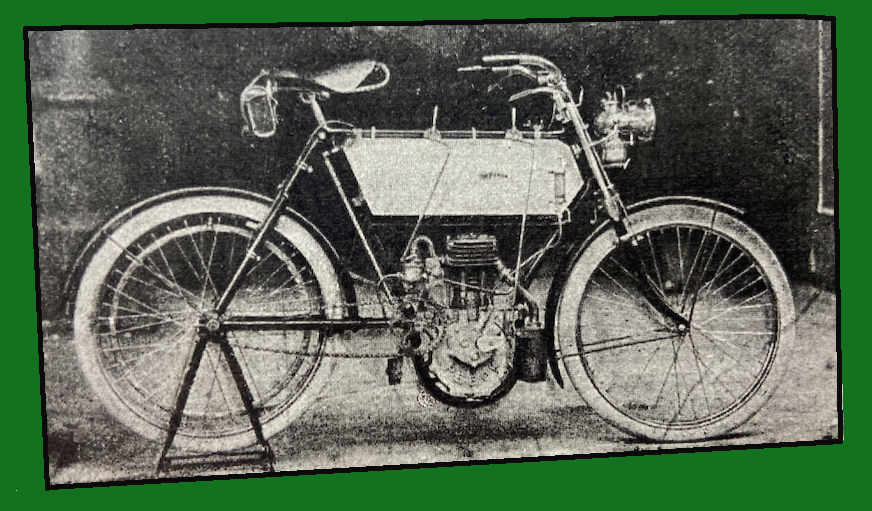
Lux motor-bicycle. This has a 2¼hp vertical motor, fitted in a loop frame, having a triple head. It can be readily detached by unscrewing two bolts. The carburetter is a float-feed spray; the ignition is by coil and accumulator, the transmission is effected by a three-ply V-section belt. The length of wiring is kept very short, thus avoiding short circuits. There are front and back rim brakes, and good size mudguard, The ‘Goodyear’ puncture proof tire is fitted. The price is £38. The ‘Eysink’ motor bicycle is a splendidly finished machine of Dutch make by the Amersfoortsche Rijwiel-Automobielen en Machinefabrick, Holland; it was shown on the Chenard & Walcker stand. It has a 2hp vertical motor, with cylinder and head in one piece. It is very rigidly stayed at a point below the bracket, and also by a lug to the main tube. It has a single lever control valve lifter and contact breaker acting together. The carburetter is a float-feed spray, and a good feature is the shape of the exhaust pipe, which has only a very slight bend, and thus puts no back pressure on the motor. The transmission is by a wide-section V-belt, and the tank is divided up into a series of compartments for the petrol (200 miles capacity), lubricating oil, coil and accumulator. The wiring is reduced to the minimum length, and two rim brakes are fitted, the rear one being actuated by a Bowden wire. The wheels are 26x2in. A special point is made of the balancing of the motor, and the machine is remarkably free from vibration. The ‘Eysink’ is being handled in England by the Farman Automobile Co, Long Acre, London. It is priced at £40 and should command a large sale.”
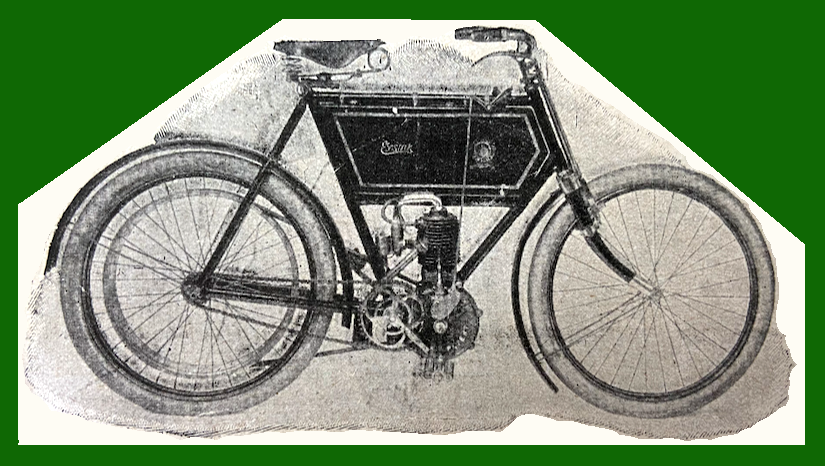
“THE ‘EMERALD’ TWO SPEED GEAR motor-bicycle. Douglas S Cox, Selsdon Road, West Norwood, London, is now making two powers of two-speed gear machines, viz., a 1¾hp at £45, and a 2¾hp double cylinder, £55. The engine is placed in a loop midway between the two wheels. The special features about the motor are: (1) the cylinder is perforated at its base, which assists in the cooling and is useful for examination of the piston and connecting rod; (2) the spring of the inlet valve is outside the cylinder; (3) the bearings are long, and the valves of large diameter, and the cylinder and combustion chamber are in one piece; (4) large radiator surface. Ignition is high tension electric. Either the Longuemare or FN carburetter is fitted and drip-feed lubrication is used, which is quite automatic, it only being necessary turn on the oil tap at starting and turn it off when stopping. The makers guarantee that the 1¾hp motor will take any hill without pedalling, and the 2¾hp will take a fore carriage or trailer up any hill without pedalling, Two rim brakes are fitted, and also good wide mud guards, and any make of tyre can be had. The weight of the 1¾hp is 75lb, and the 2¾hp 95lb.”
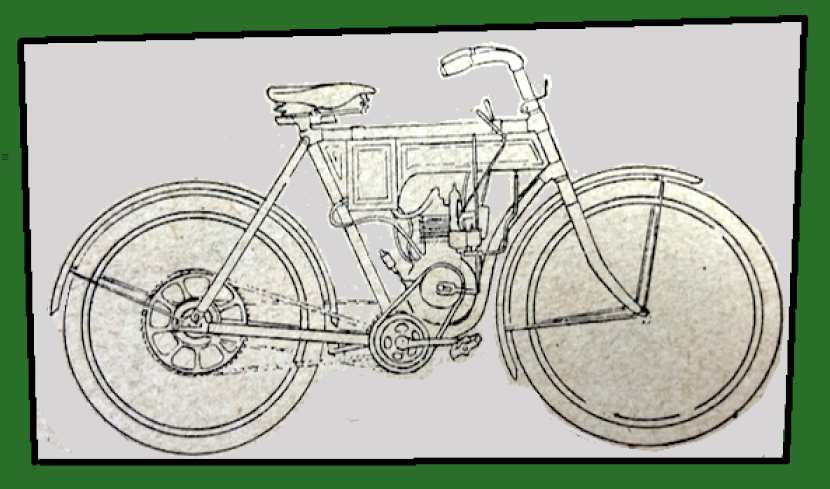
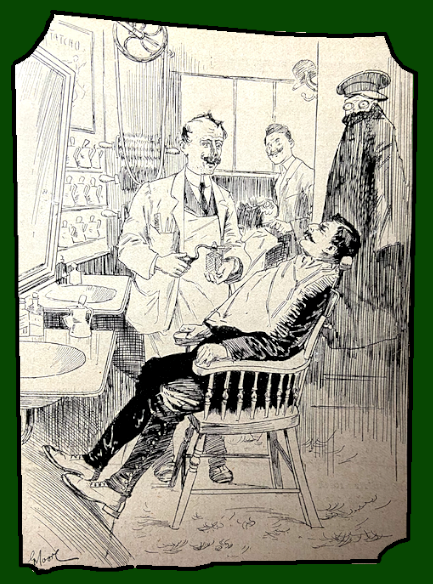
“OUR ESTEEMED CONTEMPORARY, The World, is of the opinion that the motor-bicycle, as soon as the fine weather arrives, will be largely used by many of the people who took to cycling four or five years ago, for the motorcycle has certain charms which appeal very strongly to those who are accustomed to the ordinary pedal-propelled machine…it is far more likely that recruits to motor cycling will continue to come from the ranks of the old cyclist—the man who has ten or 15, or 20 years of cycling experience behind him. The society cyclist who first learned to ride a bicycle in a panama hat five years ago has scarcely mastered that art, so that he is hardly to be regarded as fitted for the control of a motorcycle.”
“A GOOD MOTOR. We have recently had under inspection a 2¼hp motor made by JA Prestwich & Co, Lansdowne Road, Tottenham, London, N. We have no hesitation in speaking of it as an excellent piece of workmanship in all its details, every part having that sharpness of finish so pleasing to the mechanical eye. The cylinder is 70mm bore and 76mm stroke (2¾ by 3in), and has the combustion head cast in one piece with the cylinder. The contact breaker is very substantial, and operates in conjunction with an exhaust valve opener of clever design. Another specially good feature is a vacuum valve to keep a good vacuum in the crank case, and prevents the oil being blown out of the bearings. The top of the cylinder is provided with a handy screw tap for admitting paraffin at starting. The silencer is neatly made in sheet steel, and looks as if it would prove very efficient. The firm supply a complete set, including carburetter, coil plug, switch and accumulator wires. They supply through the trade only.”
“THE SIMMS MFG CO, OF SOUTHWARK Park Road, Bermondsey, SE, are putting an improved type of their well-known Simms bicycle motor upon the market for 1903. The power of this motor is 2¾bhp actual. The cylinder dimensions are 75x75mm [327]. The firm have experimented exhaustively with mechanically operated inlet valves, and the result of their investigations and experiments proves to their satisfaction that an increase of power does result from their use. They have decided, therefore, to fit these to the small motors. The arrangement of the valves is clearly shown in the photographic reproduction given herewith. We notice that the camshaft actuating the valves is enclosed in an extension of the crank chamber, this crank chamber being easily opened for examination by the removal of five screws which are located on the opposite side of the crank chamber and, therefore, are not visible in the illustration. An exhaust valve lifter is fitted to release the compression or start the motor, or for driving through traffic. The small lever operating this is seen on the extremity of the camshaft chamber, and is the external lever of the machine excepting, of course, the connections to magneto ignition. The smaller details of the motor have been particularly well attended to and the user’s convenience studied in every respect. For instance, there is fitted to the top of the cylinder a very useful form of tap which admits of a ready introduction of paraffin or petrol into the cylinder for cleansing or starting purposes. The usual drain cock to the crank chamber is also fitted, and the release compression valve to the crank chamber has been so designed and placed that the usual fountain of oil which is injected from the majority of motors after running awhile is entirely done away with. Therefore, the annoyance of spoilt clothing and the trouble of greasy slipping belts are overcome. As will be seen, the spray type of carburetter is fitted. The height of the motor over all is 15⅜in, the length 10¼in and extreme width 6¼in; and the total weight of the machine, complete with magneto ignition and carburetter, is 50lb. As the care in selecting materials and the quality of the workmanship put into the Simms motors are so well known and generally recognised, comment on these points is superfluous.”
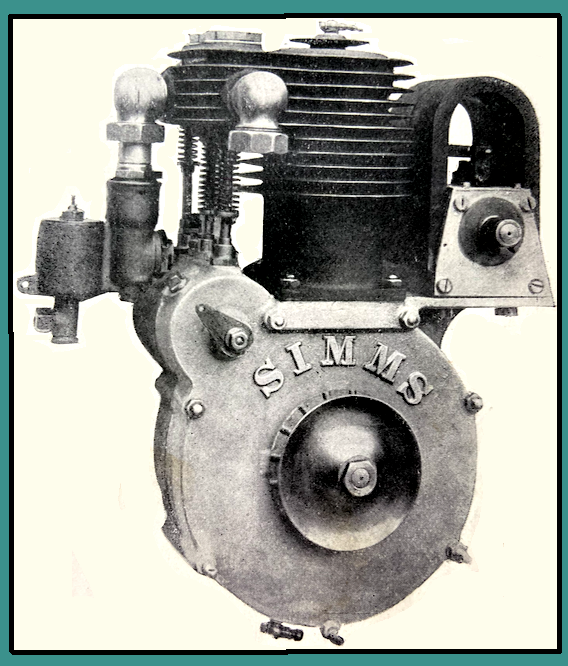
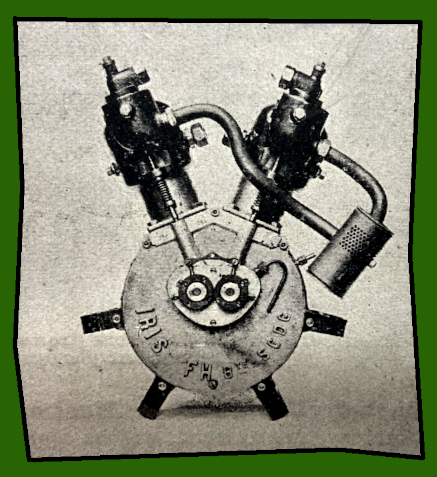
“The accompanying illustration shows a Singer motor-bicycle to which has been fitted at the instigation of the Singer Cycle Co, one of the Trimo forecarriages made by J van Hooydonk. The tout ensemble is exceedingly neat and effective.”
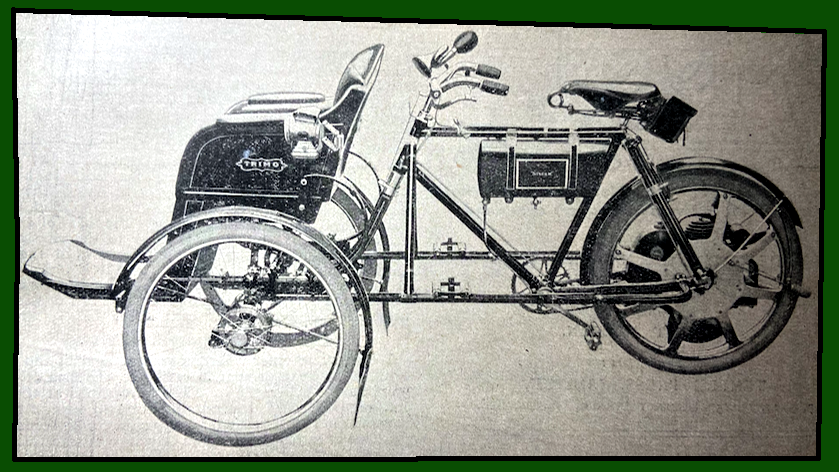
“SIR,—HAVING MADE A MOTORCYLE, of which I send photo, I am desirous of trying it around a track. Perhaps some of your readers will be kind enoUgh to inform me how to proceed for obtaining admission to a track in the London district, and which one would be the most suitable for a novice to ride on. I have had no previous experience of track riding. I must thank you for the valuable information, re wiring of De Dion coil, which I received by post. I might say that the machine is geared to 160 and fitted with aDe Dion 2¼hp engine.
A Constant Reader.”
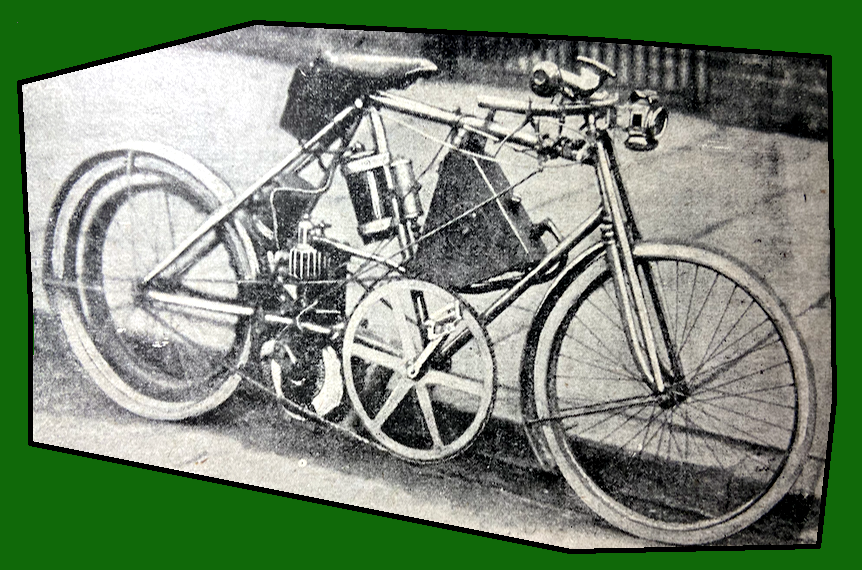
“MOTORCYCLES ARE NOT ALLOWED to be ridden in Paris unless fitted with two efficient brakes, and the Prefect of Police has refused to pass brakes of the back-pedalling hub-type. Rim brakes are, as a consequence, in much demand, and, there is at present a big run on the Bowden pattern.”
“THE AUTO-CYCLE CLUB. The Automobile Club has given earnest of its intention to cater thoroughly for motorcyclists by adopting the scheme which was drafted by a member of the Motorcycle Advisory Committee who has had many years’ experience in administrative matters in connection with the pastime of cycling. It has been carefully discussed and amended in committee, and is now finally approved by the Club, so that in its elements it should be thoroughly sound and practicable. The aim of the Automobile Club and of the motorcycling members has been to make the new body as much as possible a part and parcel of the parent Club, but leaving so clear a line of demarcation between the two that the member of the motorcycling organisation should not be able to think that, being a member of a branch, he was therefore a member of the Automobile Club. The Auto-Cycle Club is the name chosen, and it is the one which is open to the fewest objections.”
“A LADY’S PLAINT. “Motorina” makes a practical suggestion in the Motor Cycling Club Gazette. She rides in a trailer, and appeals to speed cyclists not to ‘hang on’. She says: ‘A woman’s nerves are easily up-set; a weird grunt uttered within a few feet of the passenger’s head,-which sounds as if it were coming from the depths of an unoiled back wheel hub, is very alarming.'”
“WE ILLUSTRATE THIS WEEK two Continental made motor-bicycles, both possessing many interesting features. One is made by Thein and Goldberger, Vienna, and has the motor clamped vertically in an angular bracket, forming an extension to the main tube and bottom bracket. A special feature is the ignition, which is on the ‘Eisemann’ high-tension magneto system, in which an ordinary spark-plug is used. The armature of the magneto dynamo is driven by a chain from a sprocket on the 2 to 1 shaft. The current then passes into an ordinary coil shown behind the diagonal tube, and this raises the pressure to give a jump spark. The silencer is of a special type, with two expansion chambers, and the drive is by means of a round belt. The spark in this form of ignition is advanced by moving a contact breaker on the magneto. The other machine is the 1903 Laurin and Klement, for which the agents in England are Messrs Hewetsons, Tottenham Court Road, London. The frame has been considerably modified, and the motor is placed rather lower than previously, being supported in a loop formed by the main down tube. The ignition is by means of a low-tension magneto dynamo, mounted below the motor, having a rotary armature driven by chain. There is a make and break inside the cylinder, and the spark can be advanced at will. The surface carburetter is retained, and included in the large tank fixed in the rear panel of the frame. The regulation of speed is mainly effected by a throttle valve and exhaust valve lifter, coupled up to a lever seen alongside the horizontal tube, and then this joins up a lever under the handlebar. The lubricating oil is carried in a cylindrical tank just over the motor, and this supplies a small force pump. The transmission is by a flat belt, with a jockey pulley for adjusting the tension. The rear belt rim is spoked on to a separate hub, instead of being fastened to the driving wheel spokes. A special feature of this machine is a powerful band brake, acting on the front-wheel hub. The wheel base length of this machine is above the average, and the hill climbing capacity very high.”
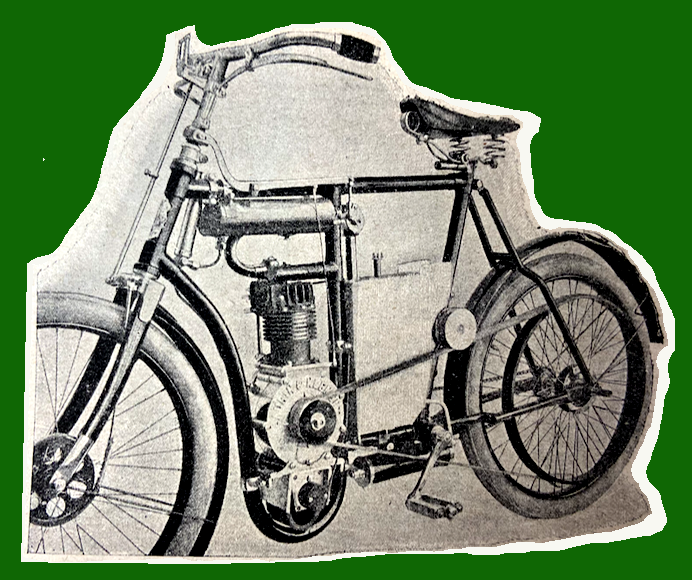
“A VERY SIMPLE TYPE of fore-carriage is made’ by Laurin and Klement, Jungbunzlau (Bonnen), Germany. It consists of a tubular framework and cushioned seat which is supported just above the front wheel of the bicycle. The attachments consist of a heavy clamp fixing on to the steering socket and a curved extension tube which clamps on to the main tube of the frame just below the crank case of the motor. This attachment certainly has the merit of simplicity and easy attachment without having to remove the front wheel; but what is rather a doubtful point is the effect the attachment would have on the steering, especially as the weight does not move in the. same plane as the steering wheel.”
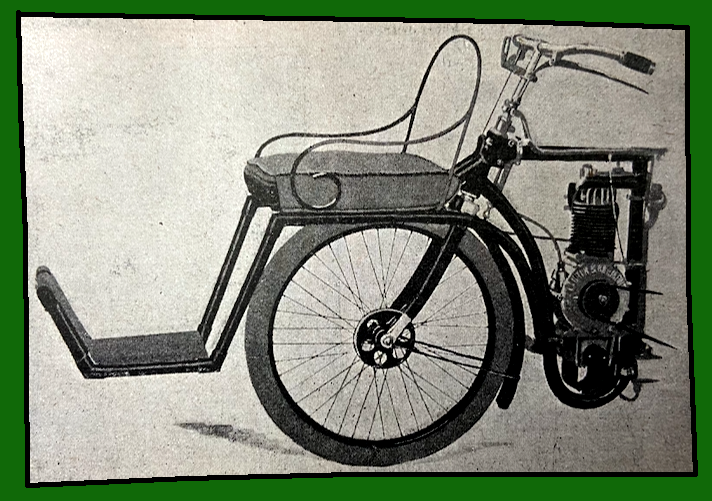
A MOTOR-BICYCLE FOR LADY’S USE is made by Laurin & Klement of Jungbunzlau, Germany. It is a novel type inasmuch as it is built with a drop frame, to enable a lady to ride it. The motor is a 2½hp type, having a rotary magneto ignition, placed below the crank case. The carburetter is mounted just above the bracket tube. A somewhat ornamental belt guard, which will appeal especially to the ladies, is a rather notable feature. The petrol supply tank is fitted in between the diagonal and back fork tubes. All lever control is effected from the handlebar. Judging from appearances, we should say the weight of a machine of this type would render it very difficult for a lady to start and handle.”
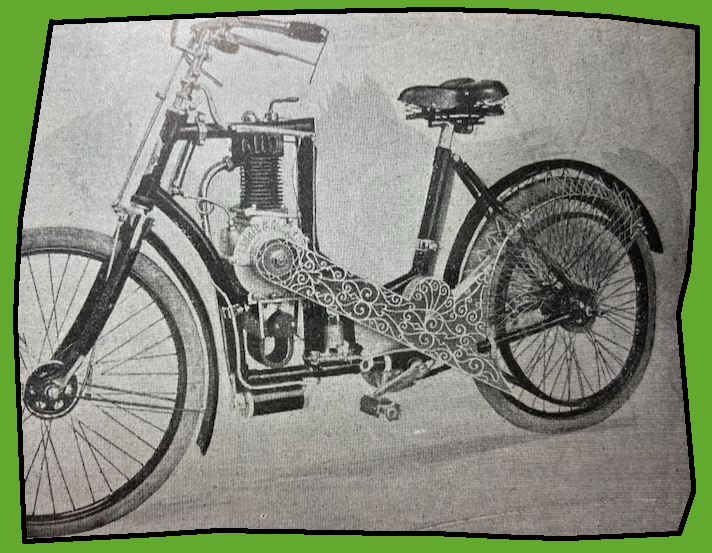
“SIR,—I BEG TO ENCLOSE a photograph of a Minerva motor-bicycle designed and built by the Booth Motor Co, Putney, which I venture to think you may consider worthy of production in your paper. Mrs Hulbert, my wife, has now ridden the bicycle 900 miles, her longest journey being to Bath and back, in two days, and she is constantly to be seen riding about the neighbourhood of Putney, either by herself or trailing another lady. She hopes to make good use of her bicycle this season, riding to and from her various tennis matches, thus saving time waiting for trams, etc, and she is quite of the opinion that ere long the mode of progress will become most popular among members of the fair sex. Shall be pleased to send further details if you so desire.
F Hulbert., Putney.
[Although we publish Mr. Hulbert’s letter, we hardly think that the motor-bicycle is a vehicle to be generally recommended for the use of ladies.—Ed The Motor.]
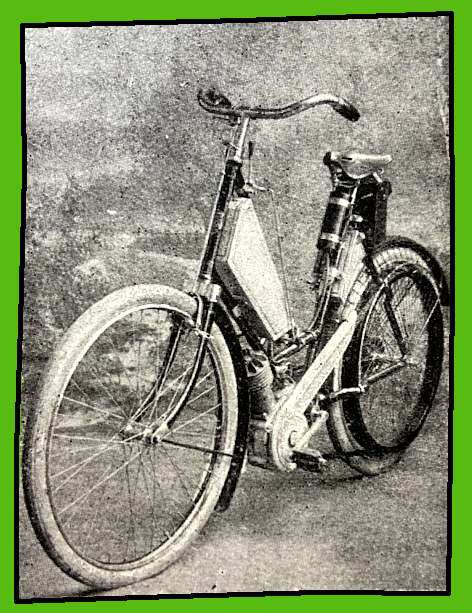
If Mrs Hulbert was irritated by the smug-gittishness of The Motor’s editor, she was no doubt mollified by the photo and caption that appeared in the second issue of The Motor Cycle. You’ll find more examples of the prejudice faced by pioneer women riders in the feature ‘Wake Up Ladies!”.
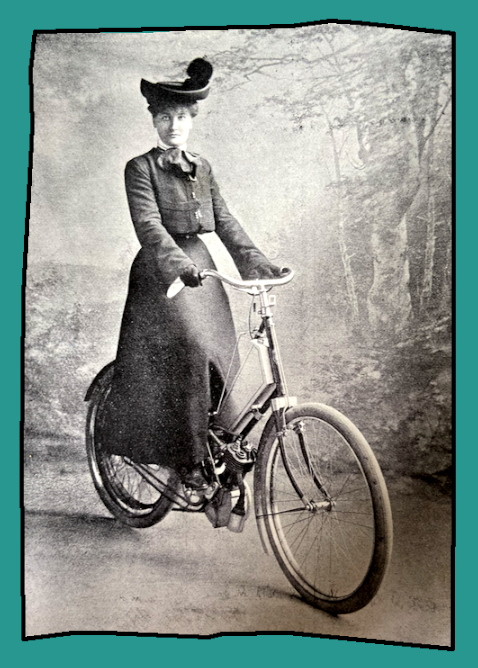
“WE HAVE PERSISTENTLY advocated motor cycling for ladies, and are always glad to hear of a machine likely to popularise the sport among the fair sex. We herewith illustrate the Crownfield lady’s motor bicycle, made by Mr James Perkins, of 299, High Road, Leyton, E. The frame is of registered design and carries the engine low down in a cradle. The forepart of the frame carries a tank which holds lubricating oil and two accumulators, while to the rear of the saddle a spacious petrol tank is fitted. The throttle and spark advance lever are placed in a most convenient position on the top of the front tank. The engine (a 2¼hp Kerry) is ample for the work required. The carburetter is an FN, and 28in. wheels are fitted to avoid vibration. In spite of this the saddle is sufficiently near the ground. We had a short run on the machine and were much pleased at the result. The control was very simple and the engine could be lain at a very slow speed.”
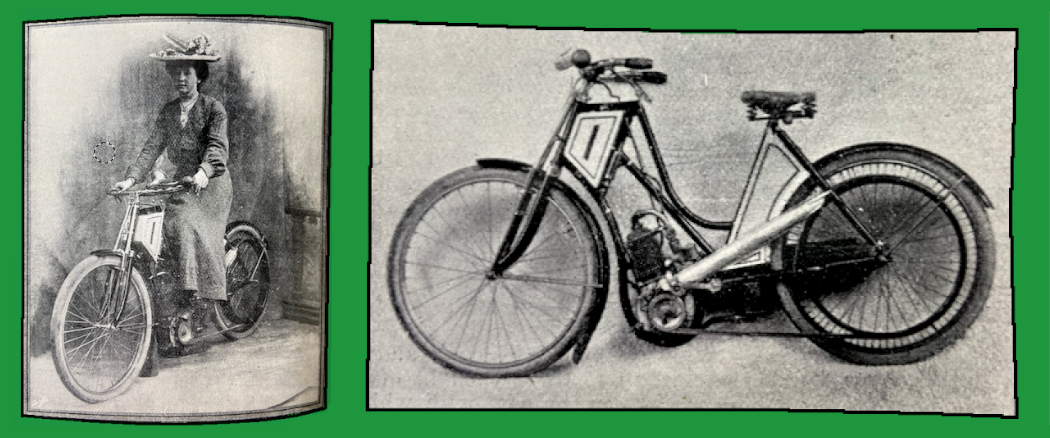
“ON MARCH 27TH MR HW CLARK, of AW Clark and Co, of Coventry, met with an accident while passing between two electric trams near Kew Bridge, on one of the firm’s motor-bicycles. It seems that the tram, which was approaching him, caught the back wheel of the bicycle just as he was moving out of its way, causing the front of the machine to swing round so that the rider’s face came in contact with the tram, inflicting a severe cut; the other tram then struck him on the back of the head, fracturing his skull. He was removed to the West London Hospital where he was immediately operated on, a portion of the skull being removed and filled in with gutta percha tissue. He immediately commenced to recover. He has since felt no ill effects from the accident, and in less than two weeks from the accident he was up, and has returned to his business.”
“THERE SEEMS NO REASON why a cyclist and motor-cyclist should not go on a tour together. A medium-powered machine, we should say from experience, was the most suitable. With a little practice the cyclist can hold on to the saddle of the motor-bicycle, and can thus free wheel 25 miles out of 30, and do his own pedalling up-hill. This method seems to be preferable to a tow line because the cyclist can immediately clear himself on corning into traffic. At Brighton recently we saw an ordinary cyclist hanging comfortably on to a slack belt round a motor-cyclist’s waist. The two had evidently journeyed some distance—probably from London—in this way.”
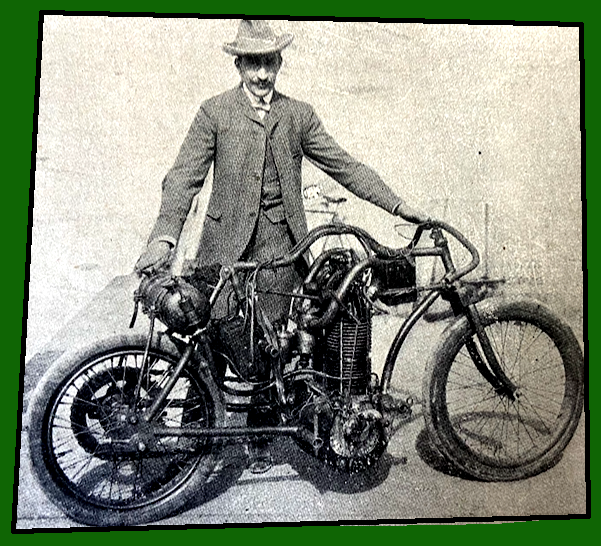
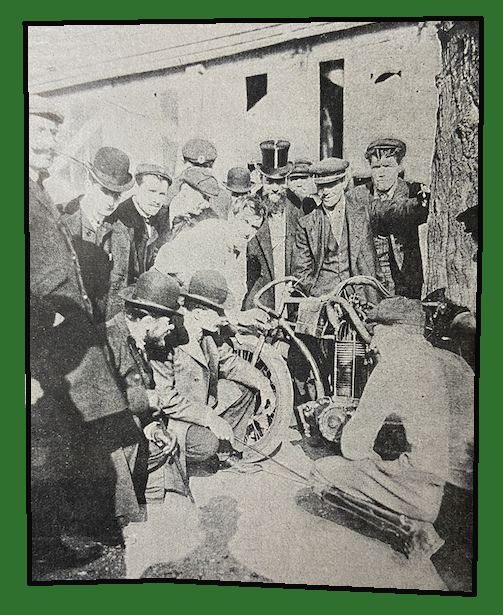
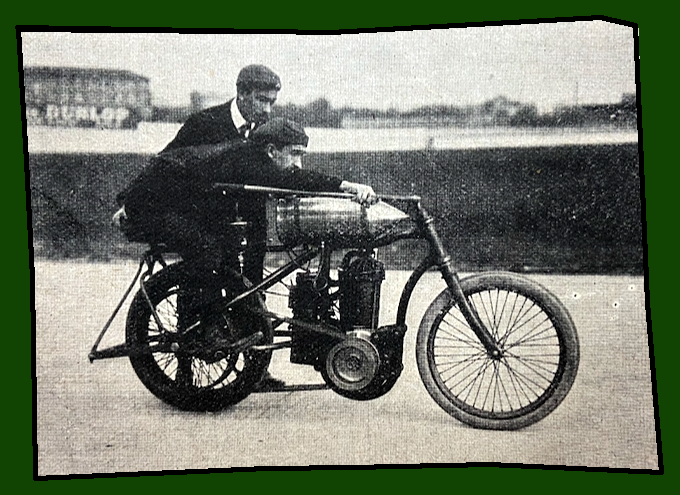
“THE ENFIELD COMPANY have recently introduced a new 2½hp (actual) motor-bicycle, with an interchangeable cylinder, so that either air or water cooling may be adopted. It is chain driven, but has only one chain. This runs remarkably silent and smoothly, as we proved by experience when trying one of these machines up and down the hills and dales round about Redditch. The back hub is fitted with a friction cone clutch, which allows of the engine being started while on a stand or resting on the ground, an advantage over starting by the ordinary means of pedalling. The whole of the driving chain is enclosed in a gear-case, which fits on the projections shown on the aluminium crank chamber of the engine. There are only two levers on the machine, one to operate the throttle on the carburetter, and the other to advance or retard the ignition. The exhaust valve lifter is operated by a Bowden wire. Two brakes are fitted, one a band brake on the rear hub, and the other a front rim brake, actuated by a Bowden wire from a lever on the left side of the handlebar. Several minor improvements in the machine have been effected. To enable the rider to more easily get at the exhaust valve and inlet valve the metal tank case has been cut in half. The front half is the water tank, while the other half is for petrol. To increase the capacity a special tank is also fitted between the down centre tube and the two back stays. A better silencer has also been added, and this is now placed just in front of the engine and behind the front mudguard.”
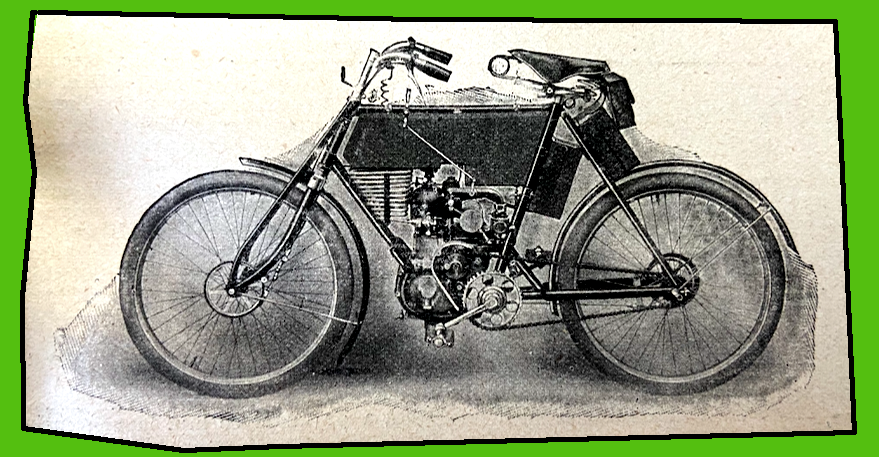
“THE ARIEL CYCLE COMPANY, Bournebrook, Birmingham, have recently put a perfected model of their 2¼hp motor-bicycle on the market. The engine is mounted vertically, well in front of the bottom bracket, and drives by means of a three-ply V-section belt. A surface carburetter is a special feature, this having a warm air byepass from the exhaust. The petrol capacity is about equal to 120 miles. The ignition is by trembler coil and wipe contact, and speed is controlled by a spark-advance lever. A novel feature is a separate case, in which the accumulators fit. This is supported on a bracket clipped to the diagonal. The silencer is claimed to be specially effective and is brought well down to the base of the machine. Two rim brakes are fitted and also a chain guard. The price complete is £50 with Dunlop tyres.”
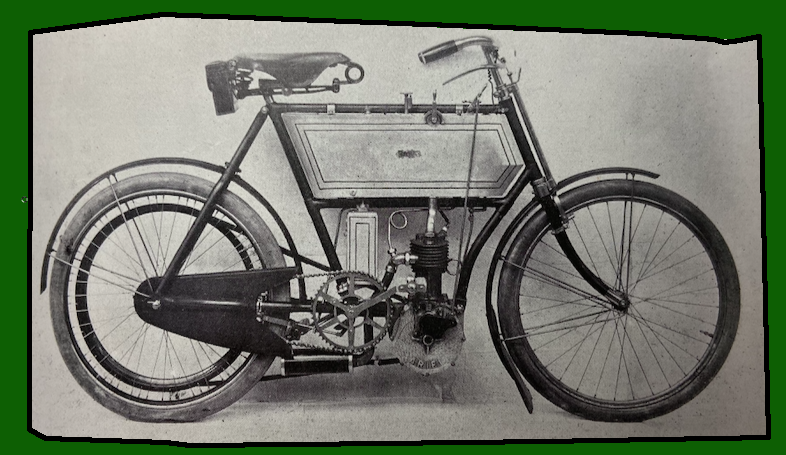
“A NEW FORECARRIAGE HAS just been introduced by the Rex Motor Manufacturing Co, Coventry. The Rex Company do not believe in making the carriage detachable, as they are of the opinion that but few motorists who purchase the double machine will go to the trouble of removing the bicycle, replacing the front wheel, etc, in order to obtain the single machine. They have, therefore, designed a specially light, but strong framework, which should minimise vibration as much as possible, and also allow of the whole vehicle coming out at a much lower weight than the old-fashioned ‘quad’ or, they claim, than the other types of forecarriages on the market. The engine is a 3½ (actual) horse power and is as simple in every respect as the Rex bicycle motor. The back wheel is strengthened both as regards the spokes and rim, and also has a heavier tyre. The front passenger is accommodated in a nicely upholstered wooden body, this being provided with a leather cover. The machine will be known as the ‘Rex Tricar’.”
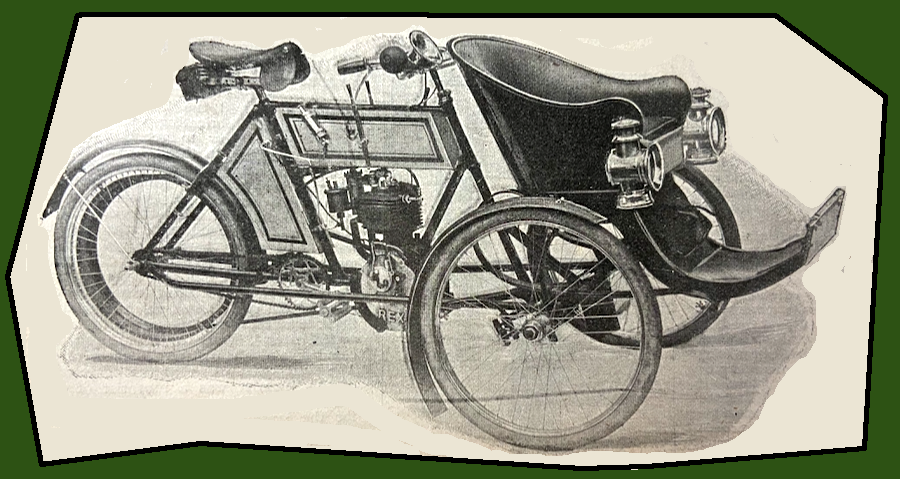
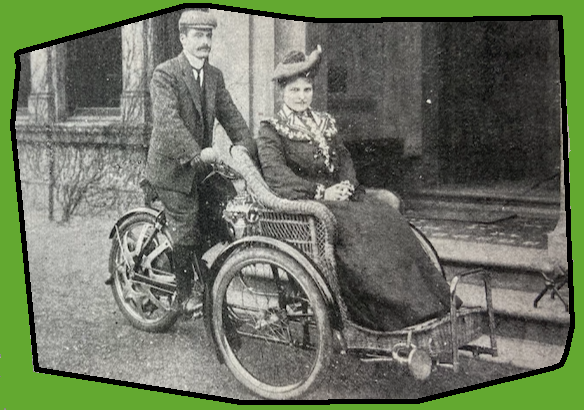
“THE EXCELLENT PROGRAMME provided by the Midland Cycling and Athletic Club at Villa Park last Saturday was greatly marred by the most unpropitious weather. Shortly after two o’clock rain began to fall steadily and the track was soon wet and treacherous. The motor-cycling events, in consequence, lost much their interest and excitement, and several riders had very nasty falls when going at 35mph, but fortunately they were only bruised. The state of the track deterred many of the men from starting; but Martin, Yates, Wright and Kennedy gave very fine exhibitions of driving under most risky conditions, and were much applauded for their pluck by a crowd of about 4,000 spectators. Had the weather been dry, exceptionally fine racing would have been witnessed, as some thirty or forty motorcycles had entered for the various events. CG Garrard had a 14hp machine geared for a speed of 90mph, but it would have been suicidal to have attempted to use it. Details: Three Miles Motor-Bicycle Handicap (Open) for engines not exceeding 2hp. One Mile Motor Bicycle Time Trials (Open Handicap), for engines not exceeding 3hp. Twenty-five competitors entered for this event, which was run off in pairs. Each had to start separately from a mark about 80 yards behind scratch, the time being taken from the moment the line was crossed. No pedalling was allowed in the actual race. This proved the most thrilling event of the meeting, two of the men coming down. Kennedy fell when travelling at about 40mph and slid nearly twenty yards, but was unhurt. Starting again, he finally won in 1min 34⅖sec, with a handicap allowance of 8sec. Harry Martin did fastest time, 1min 30 ⅖sec from scratch, and was second. Result: 1, WWC Kennedy, MC and AC, 8sec; 2, Harry Martin, Croydon MC, scratch; 3, AE Coleman, Birmingham MCC, 6sec. Five Mile Motor-bicycle Handicap (Open). This brought out Harry Martin, Bert Yates and Sam Wright, all record holders, and on the now rapidly drying track some excellent and exciting speed work was seen. A remarkably fine bit of driving was witnessed in the second heat. Yates took the lower bank too high when going at a high speed, and ran so near the boarding that he lost a a pedal, and was all but badly thrown. He recovered marvellously and stuck to it gamely, with only the left pedal to steady him, the other foot hanging. He came in for a great ovation at the finish which was certainly merited, as such a piece of plucky driving has rarely been seen on a racing track. Results: 1, S Wright, Excelsior CC, scratch; 2, T Tessier, Essex, 20 sec start; 3, AE Coleman, Birmingham MC, 25sec. Time, 6min 53⅕sec.”
“THE FIRST MEETING OF the committee of the Auto-Cycle Club was held at the Automobile Club premises last Wednesday, the chair being occupied by Mr GF Sharp. The Automobile Club had nominated Professor Boys, the Rev A Whatton, Dr Whitehall Cooke, Messrs Edge, O’Gorman, Todd, Smith, Duncan, Pennell and Shipton as being its representatives on the General Committee of the Auto Cycle Club. To these, who thus formed the nucleus of the club, were added 17 new members, and as more names have been received the membership already exceeds thirty. To the committee were added from the body of the members Messrs Slurp, Perman, Walford, Wilson and Ilsley, and the Master of Ruthven. Mr Roger W Wallace, KC, was elected president, and the only other office filled was that of hon treasurer, Mr Candler being elected to that post.”
“SIR,—MANY READERS SEEM to be troubled with their motors getting ‘tired’ on hills, especially those used with trailers. If they will but try the following they will be amply rewarded, as I can vouch for, having fitted the arrangement to a machine of my own. I allude to a small fan on side of combustion head, driven off a small V-pulley bolted to the motor pulley. Most practical amateurs could carry out the alteration. In any case it will cost but a very few shillings. I send a rough sketch of my own arrangement for a vertical engine, which will explain itself.
‘Amateur’.”
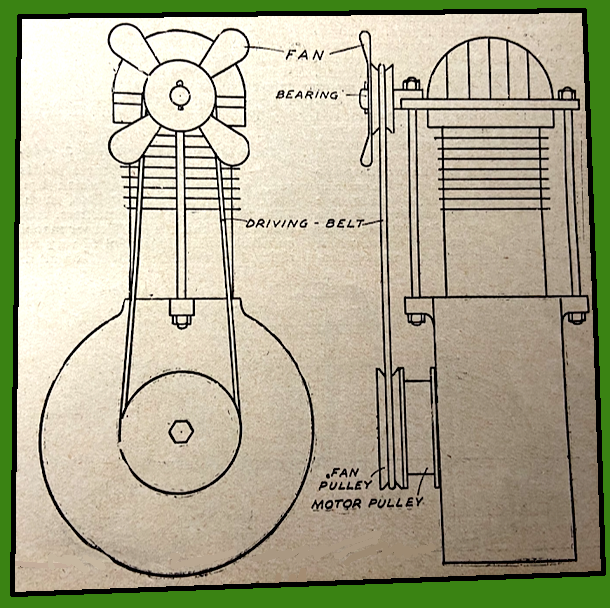
“WE HAD ARRANGED WITH our Irish correspondent for a report and photographs of the Motorcycle Union Hill Climb at Glenamuck, and the following reaches us just as we close for press: ‘A very large number of motorcyclists were entered for the climb, and were present at Glenamuck Hill this afternoon, but after four pair of competitors had gone up the police arrived on the scene and commenced operations with their notebooks. They took the names of several competitors, so a committee meeting of the Motorcycle Union was held and the trials declared abandoned.'”
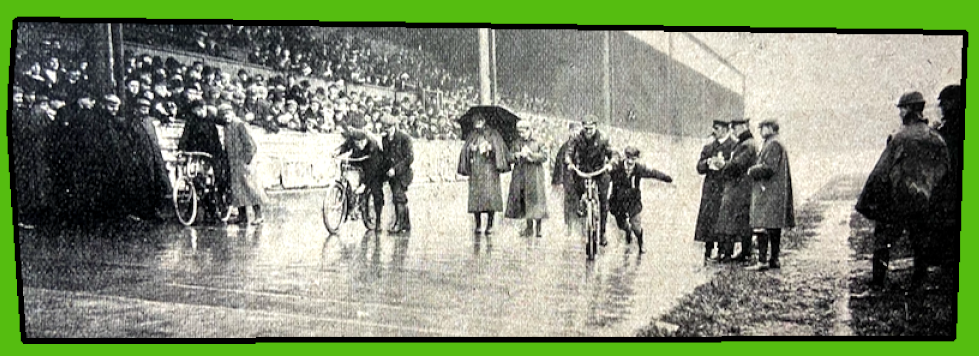
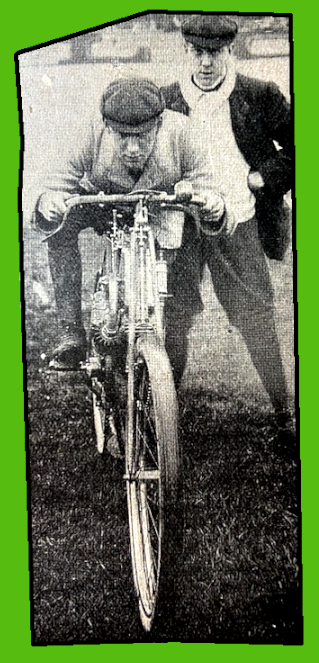
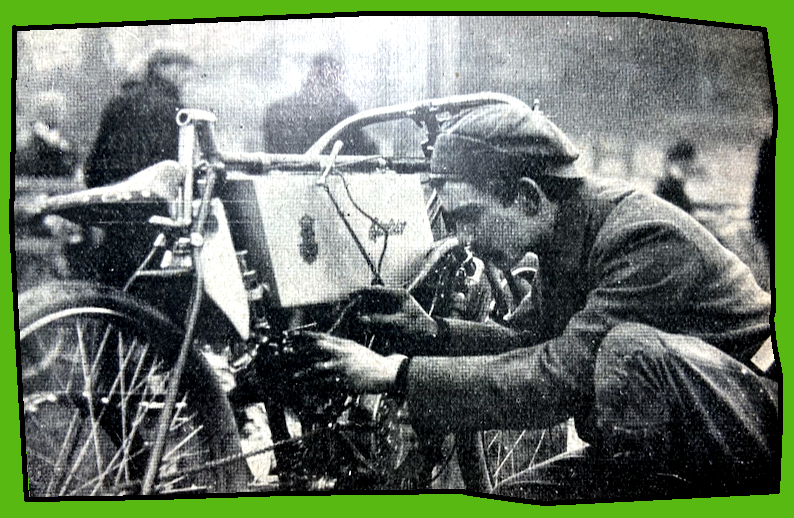
“THE LATEST VICE: MOTOR DRUNKENNESS. The distinguished French physicist Monsieur M Hachet Sonplet gave a lecture recently before the Paris Society of Hypnotism and Psychology in which he dealt with the extraordinary intoxicating effect of high-speed motoring. He says the moral and mental state of the driver becomes abnormal; thus he becomes aggressive, vindictive, and, like the habitual alcoholist, quite regardless of what the consequences may be. Dr Bertillon said that police court trials were quoted which went to prove that gentlemen of education and entire self-control became as mad as dancing dervishes once the speed takes effect. The flying landscape produces a wild and dangerous intoxication, under which influence the driver would run down those nearest and dearest to him.”
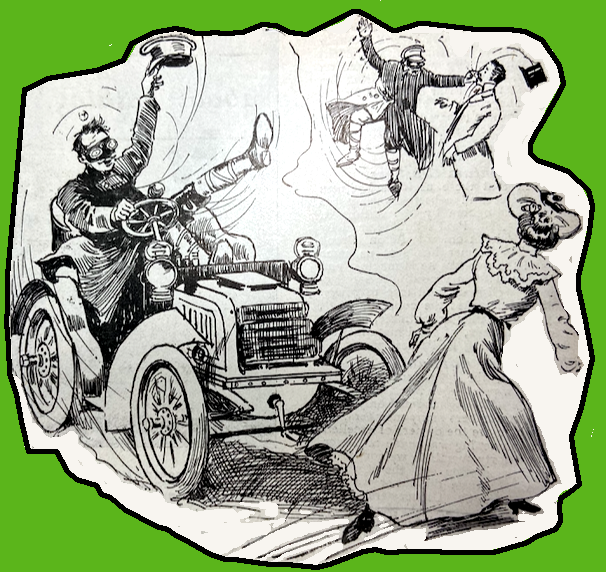
“A BAD MOTORCAR ACCIDENT happened at Kingston Hill early on Saturday morning. The car was occupied by Lord Alan Percy, the Hon.Ponsonby Myers and Major Russell, and the driver. Near the bottom of Kingston Hill a carrier’s cart emerged from a side road, and the driver applied the brakes suddenly, when both rear tyres collapsed, with the result that the car got out of control and dashed back first into the window of a draper’s shop. All the occupants, with the exception of the driver, were more or less seriously hurt, the Hon Ponsonby Myers being detained at a house near by and attended by a local doctor. While the wreckage was being cleared away from the shop the King drove past on his motor-car, and stopped to view the proceedings and enquire after the injured gentlemen. The, latest reports are that all are doing well.”
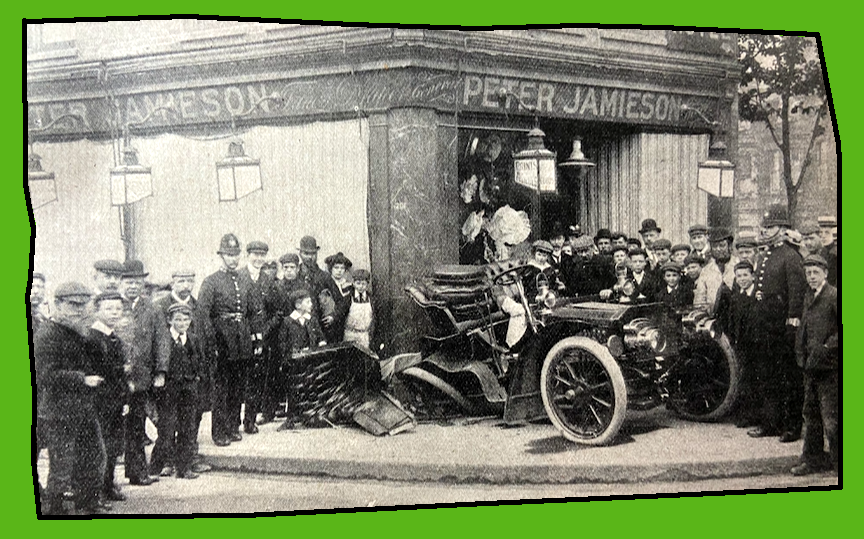
“ON SATURDAY LAST (9TH INSTANT) two balloons left the Crystal Palace at 2.30pm, this being the fourth ascent this season out of a series of twenty to be carried out by the Aero Club. The two balloons, each of 45,000 cubic feet and constructed by Messrs. Spencer and Sons, were the Graphic, with Mr Frank Butler in command, and Messrs CF Mead and Micklethwait as passengers, and the Aero Club No 2, with Mr CF Pollock in command, and Messrs Leslie Bucknal and Myers as passengers. Within the balloon enclosure were Mr Boger Fuller, with his 6hp De Dion car, and Mr Huntingdon, with his 7hp Panhard car, ready to give chase after the balloonists. Other cars and motorcycles were expected to take up the chase from outside the Palace grounds. After Mr Percival Spencer had superintended the inflation and other necessary details connected with the balloons, and seen the amateur aeronauts and their friends comfortably on board, he gave the word to let go, and both balloons rose steadily away from the cheering crowd, a light south-west wind carrying them away in the direction of Woolwich. The Panhard car was soon in pursuit, but had some difficulty in getting through the ring of spectators. The Graphic rose to a greater height than the Aero Club No1, which is a new balloon, this being its second trip. The Aero Club, however, seemed to find a faster current of air, for it gained steadily on its companion. As only a light air was moving no anchors were taken, but each carried the now usual long trail rope, which is so useful in steadying the balloon in the descent. We learn from Mr Spencer that he has a new airship on the stocks with an engine of much higher power than that which propelled his successful Mellin’s No1 airship of last year. Result: The balloon was lost to view in the thunder clouds and eventually evaded capture not more than three miles away from the Palace Grounds.”
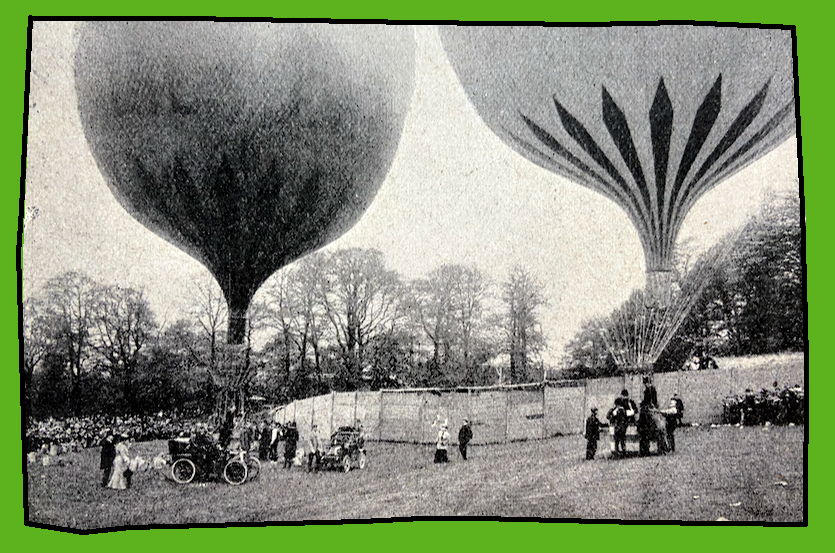
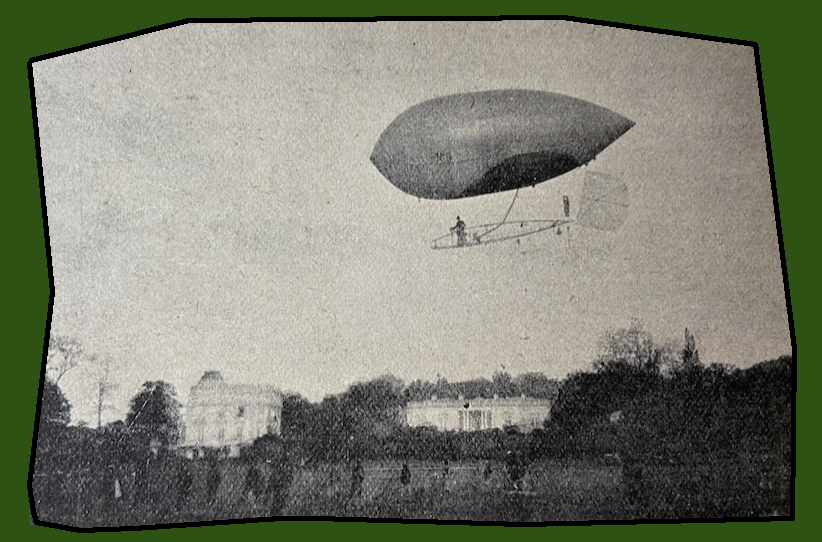
“SIR,—LAST YEAR WHEN taking my motor-tricycle between Cowes and Southampton I was rather surprised to find that whilst my own ticket was only 1s 6d return, my motor-tricycle ticket was 10s, and pier dues 2s. On writing to the manager of the Royal Mail Steam Packet Company, I received a most courteous letter in reply, and after some correspondence with him I have received the accompanying letter: ‘Sir,—Referring to your letter dated January 19th, respecting the charges for motor-bicycles, etc between the mainland and the Isle of Wight, I beg to say this matter was brought before the members of the Traffic Conference recently, and the following rates will now be charged: Motor-bicycles, Cowes to Southampton, or vice versa, 1s; motor-tricycles, ditto, 2s 6d; with an additional 1s for a trailer.—Yours faithfully, LT Wilkins, Manager.’ I think you will agree with me that the charges mentioned are most reasonable when you remember that the steamers are only intended for passengers and their personal luggage. I should recommend motorists coming to ‘the Island’ to choose this route, as the approaches to the boats, both at Cowes and Southampton, are good, there being no steps to negotiate. There were a great number of motors in the Island at Easter, and no prosecutions either for exceeding the legal limit or for furious driving. Unless I am wrongly informed, the Standing Joint Committee have given most wise and judicious directions to the Island police, so that motorists here are only prosecuted under the old Highway Act. If this good example were more generally followed, much of the bitter feeling and indignation now aroused would be done away with. There would be no more necessity for hiding police in hedges, for measured miles, and stop-watch timing, and there would be no more of the ridiculous prosecutions under the Light Locomotives Act, in which the magistrates, if satisfied that the law has been infringed, feel compelled to convict. The Island is an excellent place for about a week’s tour. There are over 300 miles of pleasant roads, and many places of interest; but it is no place for scorchers, as the roads, though generally good, are mostly narrow.
H Eldridge Stratton, Newport, IoW.”
Today (2023) a Southampton-Cowes return, including the rider, costs £55 for anything from a moped to a V8 trike. Allowing for inflation Mr Stratton paid £103.50—but following that courteous correspondence, the Royal Mail Steam Packet Company reduced the trike/combo fare to £46.50; the solo rate plummeted to £35.—Ed.
“SIR,—IN VIEW OF THE INTEREST aroused by the use of chemicals to increase the explosive force of petrol, perhaps a few particulars of the properties of picric acid—most generally used—may be interesting. Picric acid is generally said to explode by heating, but this takes place only when very small quantities are heated very rapidly. If heated in any quantity it melts and vaporises, and will burn with a luminous flame, but without explosion. Under ordinary conditions, picric acid will not explode either by percussion or heat, unless, as aforesaid, minute quantities are suddenly heated. The picrates, on the other hand, are readily exploded by heat or percussion. Picric acid in masses, obtained by compression, and mixed with gum arabic solution, or suitable fat or oil, or 3-5% of collodion, can be exploded in closed vessels. Fused picric acid cannot be exploded in the open air by detonation with three grains of fulminate of mercury, although, if melted and cooled slowly in closed vessels, it can be readily detonated, the explosion being one of the most destructive known. ‘Melinite’, one of the most powerful explosives invented, is said to consist solely of compressed picric acid. Re its effect in cylinders of motor. We have tried various solutions and mixtures, and succeeded in making a solution, using a percentage of acid and four other ingredients, that caused an explosion of such intense power that with a retarded spark, or incorrect air supply, we succeeded in running a motor at 25% more revolutions per minute than the best hitherto attainable with the spark fully advanced and using ordinary petrol. In fact, we simply dare not advance or give a correct amount of air. Had we done so, it is doubtful if this would have been written. Upon examining the cylinder, we found a very soft, dry carbonaceous deposit, denoting incomplete combustion. This we attributed to the insufficient air supply. Our experiments lead us to believe that we shall soon be in a position to place upon the market an acceleration oil, which will both drive and lubricate the engine, and at the same time add considerably to its power. During our experiments with this mixture we have not had a single case of over-heating or misfiring. One method of using picric acid is to put a quantity into a vessel with petrol, and allow the spirit to ab-sorb as much as possible. The product must be very carefully strained (after standing two or three hours), and then, for economy’s sake, a small quantity of paraffin may be added. This experiment will not be successful with surface carburetters.
Jas L Norton.
“DEAR SIR,—TO SHOW HOW very simple and easy it Is to take up the motor cycle, my experience may be of interest. I suddenly got the ‘Fever’ during the last day of the last motor show, and I spent the afternoon at the Agricultural Hall examining machines. During the next week I obtained every paper and book on the subject, but it was not until the Thursday before Easter that I dared to try a machine. Twice round Hyde Park on a 2¼hp ‘Kerry’ convinced me that there was nothing better, so without waiting for my enthusiasm to cool, I bought the machine and took it home by train. Though I had only ridden it five miles, I did not fear to set out for Stratford-on-Avon, which I reached in splendid time with only one mistake, which resulted in the piston sticking, as in the delight of rushing along I had forgotten to oil during 30 miles. In the three days I covered 238 miles, and on the Sunday covered 95 miles most comfortably, riding from Oxford home in two-and-a-half hours.
Fred Duncan Hindley.
“NEARLY 49 MILES IN THE HOUR. Following up his record breaking form of the previous Saturday, GA Barnes, mounted on the same 2¾hp ‘Bat’, made a most successful onslaught on the hour motorcycle record, from a standing start, on Wednesday last. Despite the fact that a cold, blustering nor’-wester prevailed throughout the ride he managed nevertheless to compile the fine total of 48 miles 1,395 yards within 60 minutes. Getting away to a good start, he started with record at the first mile, beating his own previous best by 1⅕sec. From that point to 27 miles inclusive he was outside his own record, but from 28 miles to the finish he chipped large pieces off Freddy Chase’s previous figures. At this stage he was 3min 27⅘sec inside record and this was well maintained to the end, when Barnes did nearly four miles better than the previous record. In the half hour he rode 24½ miles, and he ‘shut off steam’ at the 49th mile, but would have completed the 50 only for the interference of some unauthorised busybody, who signalled him to stop.”
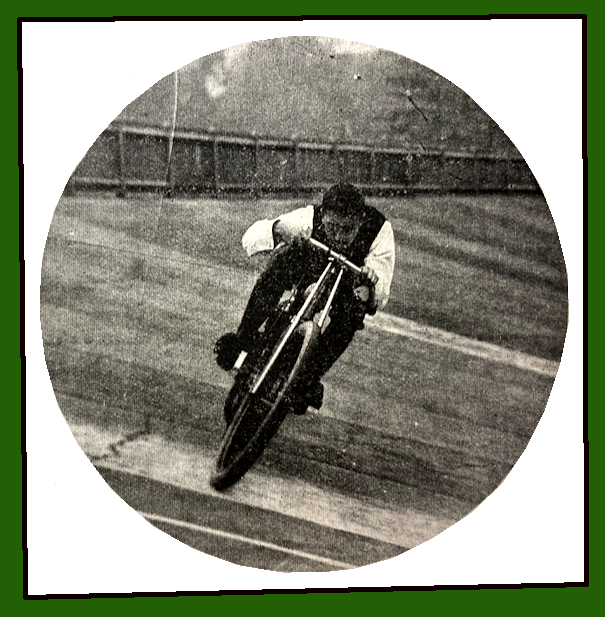
“THE HUMBER CYCLE DEPOT in Reading was recently the scene of much excitement, owing to a fire which was caused, it is stated, by an employee having filled a kettle with petrol, thinking it was water, and placing it over a gas bracket to boil. The vapour became ignited, and huge volumes of smoke poured forth in all directions. The fire brigade was soon on the spot, and, with the aid of a smoke helmet, an engineer of the force was enabled to Iocate the fire, and the hose was played upon the seat of the, damage.”
“THE BRENTFORD MAGISTRATES recently fined the driver of a dog-cart £5 for striking Major Sellars of the 4th Dragoon Guards across the face with a whip. Defendant was driving on the wrong side of the road and refused to move when the motor came along. When remonstrated with he raised his whip and struck Major Sellars. The Bench considered it a very bad case and imposed the full penalty.”
“THE HANDSOME ‘PEERLESS’ MOTOR BICYCLE is made by Bradbury and Co.Oldham, Lancs. This firm have a splendidly equipped factory, and have earned a well-deserved reputation for the accuracy and finish of their light engineering work. In the ‘Peerless’ motor-bicycle the motor forms an integral part of the frame, the crank case being brazed by lugs to the main tubes. Either a 2 or 2½hp motor can be supplied. The wheel base is an extra long one, and duplex front forks are a special feature. Either a surface or a spray carburetter can be had at option. Ignition is by means of a Basseè & Michel trembler coil, and special type of roller contact on the motor. The cylinder and head are in one piece. The tank for the petrol has a capacity of five quarts, and there is lubricating oil capacity for 300 to 400 miles. A novel form of switch and exhaust valve lifter is a special feature. The gearing of the 2hp machine is 5 to I, and the 2½hp 4½ to 1. The transmission is by a Lincona belt, and the tyres are Clincher A Won motorcycle type. The finish of the machine is the best possible, and the prices are £45 and £50 for the 2 and 2½hp respectively.”
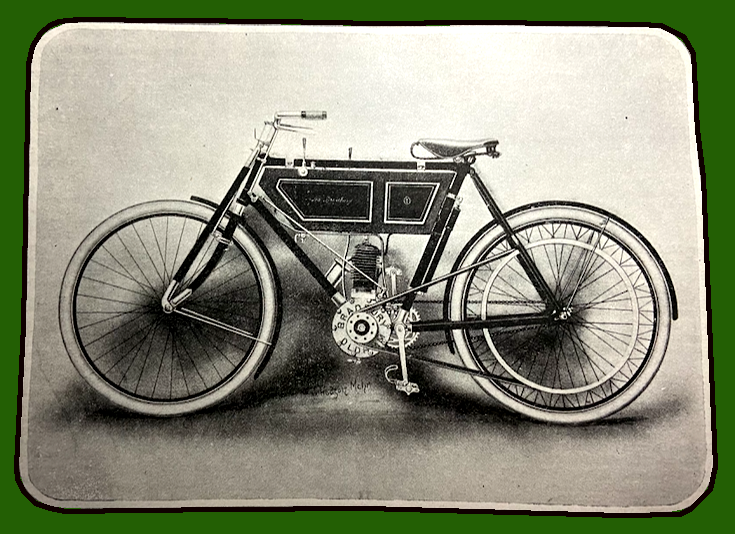
“THE AUSTRIAN MILITARY authorities are convinced that for campaigning in a civilised country the motor-bicycle will play an important part in the future, and orders have been placed for 20 machines to commence with. These will be used in trials connected with despatch carrying, scouting, inspection of posts, etc. If the experiments are successful, the number of machines will be largely extended.”
“THERE WAS A LETTER in The Times of May 18th from the mother of a boy who was killed whilst motor-bicycling. He was knocked off his machine by a motor car, which also ran over him. It appears that a considerable number of letters had been written to the mother, under the mistaken idea that the accident was attributable to the motor-bicycle. She writes in reply that her son was a clever and safe rider, most careful and thoroughly to be trusted, and it would have been the last thing he would have wished that any carelessness or want of control of his machine should result in damaging the reputation of the motor-bicycle in general.”
“A DECIDEDLY NOVEL MACHINE has just been placed on the market by Evart-Hall, Long Acre, London. It is propelled by a four-cylinder engine, with chain transmission. The engine is started by pushing a foot lever, the rider then takes his seat and raises a clutch lever, when the machine starts away, the rider placing his feet on the rests. The seat is a comfortably upholstered spring bucket seat, and placed very low down, so that the feet are always within easy distance of the ground. The makers claim it has unlimited hill climbing powers, and is capable of running up to 50mph The price, complete, with 2¼in tyres, is £70.”
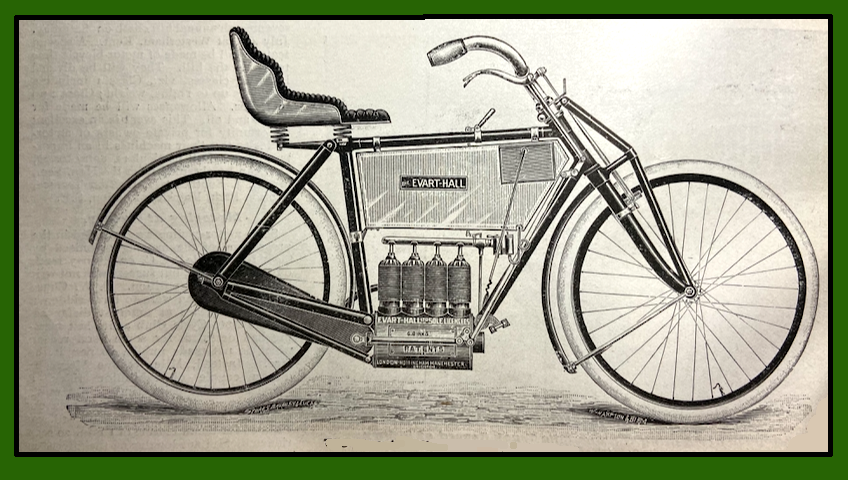

HERE’S A RARE TREAT—what I believe to be the debut article from BH Davies, a young priest with a passion for motor cycles. This appeared in The Motor but within a few months he would be writing for The Motor Cycle as Ixion, the greatest motor cycle journalist of all time. “The forecarriage is a new arrival, and though they are coming out in shoals with the fine weather, few of us have yet had much experience of them. Even the makers have scarcely had time to give the invention that ‘gruelling’ on rough roads which brings out the weak points of a machine; and the natural result is that some early purchasers may at first be somewhat dissatisfied. The writer has driven a good distance over very bad roads on a high-priced machine; and were he placing an order for a motorcycle and forecarriage to-morrow, several considerable alterations would be made in the specification. Every forecarriage that has passed through my hands up to date has been attached to the bicycle (i) at the fork-ends (for steer-ing); (ii) just below the ball head; (iii) either to front tube by a second clip below (ii), or to bottom bracket, or to lower front tube of diamond, or to lower back forks. The steering attachment is the same on all machines, and (ii) also offers no material difference in the various types. It is the third attachment that is vital. In one well-known pattern two long tubes run from the forecar to a point near the steps on back forks; and this forms an exceptionally rigid connection. Such makers as did not care to take a license for this idea have been compelled to think for themselves; and many have run two tubes, gradually uniting into a single connection to the diamond frame or bottom bracket. In my humble opinion, this attachment is not safe. On my second ride, when driving downhill at 18mph, the whole forecar twisted bodily round, owing to this single clip shifting, and a nasty accident would inevitably have resulted had not the road been wide and free from traffic. In the work. shop we tried leather packings, iron washers, and big wrenches, but the clip could not be made secure enough to withstand our tests. It could always be shifted by a violent wrench, even with the engine idle, a smooth surface, and an empty chair; so off it came, and a new clip was forged, making a double connection with three strong cross-bolts through. This embraces both the main down tube and also the front lower tube of the diamond, and no power can shift it; nothing short of actual breakage can occur at this place. The next point is that all vital nuts should be secured by a stout split pin passing through a hole drilled in the bolt end. This is absolutely necessary in the case of the nuts securing the two steering axles. Lock nuts are not sufficient; and the driver can see the split pins from the saddle, and rest assured that his fair passenger is safe. Brakes are a detail in which most manufacturers are conscientious. Two band brakes on the front wheels are essential. The compression on my machine will support 14 stone on the pedal, but with four hundredweight going down a long hill, compression is soon overcome. A good brake on the back wheel will always be required. My Bowden wire snapped after 200 miles, and a second one is chafed nearly through. A first-class band brake applied by steel rods is, in my opinion, more suitable.
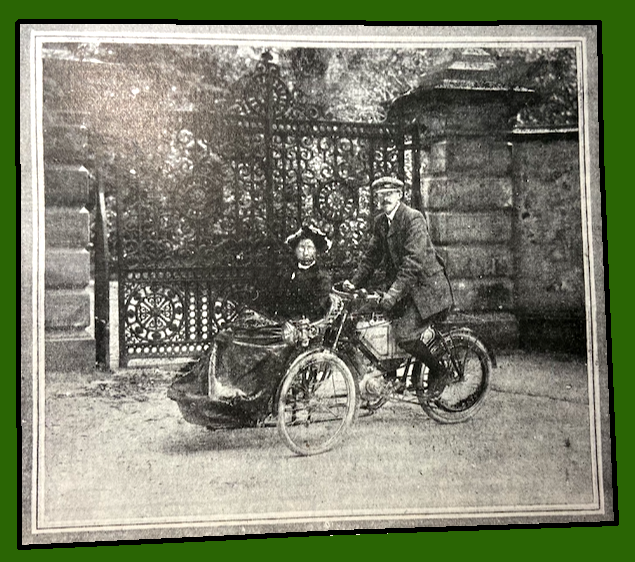
Ease of adjustment is a point to provide for. My Bowden brake was originally minus the usual tightening screw, and a large workshop could not produce a spanner that could each those on the two front band brakes. The greatest weakness of the machine is still to be mentioned. The back wheel of the ordinary motor-bicycle is not constructed to take the additional strain; 300 miles were enough to buckle the rim and to cause the collapse of several spokes in the machine under notice. A very large hub and specially stout spokes should be fitted. In spite of these seeming complaints, the motor-bicycle and forecar constitute a most simple and fascinating vehicle for two persons. With a 2¾hp engine, an average speed of 20mph can be maintained on ordinary roads. The front passenger notices no odour from the exhaust, and suffers from no dust, except with a head wind; while conversation is easy, and comfort considerable. The forecarriage has come to stay, and has rung another stroke in the knell of the fast disappearing quad. With reasonable skill the engine will never overheat, and moderate gradients of two or more miles may be surmounted at a good pace. The engine should be given floods of oil; my 2¾hp MMC De Dion in hilly countries uses a charge every 12 miles without sooting. The throttle should be used unsparingly. On the level, one-third gas will drive the motor at 20mph with the sparking well advanced. Steep hills must always be rushed. and hence a steep road in a town under police surveillance is a sad nuisance. Always throttle the gas if the gradient eases for a few yards, as strict economy in this respect will help the machine up many a long slope. If the engine slows perceptibly on a steep stretch, a walk may usually be avoided by jumping down and steering the machine and passenger as you run; but with room for a rush, and a fairly, straight road, a 2¾hp engine will take two up any hill ornamented with the CTC. caution board. To expect an air-cooled engine to trot two passengers up a ‘danger’ hill is a little too exacting. The tip is to drop the passenger, sail up up yourself, and wait at the top, thus cooling the cylinder and enjoying a cigarette. Go easy round the corners. If you stand on the inside pedal and the passenger leans over, you can swing round at a rare speed. But remember your front axles are only finger-thick, though of hardened steel. For night driving two lamps are needed, and one should be gas. I use a Perfecta Motor type which gives a magnificent light, but requires an additional spring to withstand the vibration, unless the bracket is on the C-spring portion. If you haven never driven any motor vehicle wider than a bicycle, remember you now need a good slice of the road, and beware of the restive horse. Handlebar control is most desirable. Have a Bowden exhaust lifter on the right grip, and a quick switch-off on the other. Man has only two hands: there are two brakes, a horn and three levers, and less room to manoeuvre than with a bicycle. So I have fitted to the left grip a tiny rocking lever switch which responds to the merest touch. The steering is mastered in ten minutes, and actually does not tire the arms so much as a motor-bicycle, for there is no balancing to be done. Foot rests can easily be fitted to the front connecting rods, and the driver’s position, being variable, is quite comfortable, but oh! so dusty. Don’t expect to go 200 miles on a gallon of spirit, and if you want a ride solus, allow two hours for the job of con-version to a single. You can beat most cars on the level and on an ordinary hill. You can go 85 miles to the gallon of spirit, and you’ll make friends, if you’re short of them.”
…and here it is, BH Davies, before adopting his nom de plume, making his debut in The Motor Cycle, which would be his literary home for the next 60 years. Enjoy!
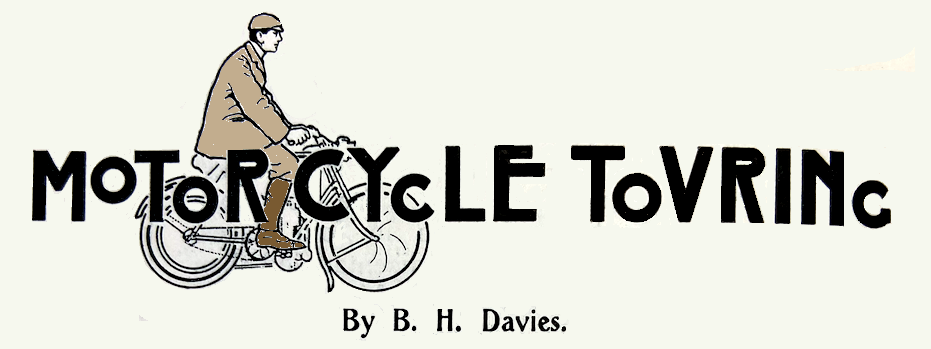
“THOUGH A GOOD MOTOR BICYCLE, kept thoroughly in tune, is always ready to start out of the shed at a moment’s notice, it is, par excellence, a touring vehicle. It is not so much an economiser of time or exertion as a means of covering a wide extent of our beautiful England in the most comfortable and healthful manner. This being so, it is remarkable how ill-designed most makes are With reference to a main essential—the certainty of being able to cover long distances without professional assistance and recourse to motor supply stores. Comfortable touring implies certain requisites: (1) Good machine, (2) good engine, (3) ample oil and petrol storage, (4) adequate electrical gear, and (5) luggage-carrying provisions. Racing machines, we may premise, are of first-rate workmanship, both as regards frame and engine; and most carry enough lubricating oil for several hundred miles. But here their suitability for touring ceases abruptly. It is hard to find a machine that, while satisfactory in these points, also carries plenty of petrol and affords room for luggage, spare parts, carbide, and so forth. All manufacturers consider this deficiency is due to two points—weight and appearance. Appearance is a minor detail. You arrive at the hundredth milestone, begoggled and dusty. The colour of your enamel and the shape of your tank are out of mind. Or you run out of petrol in the prehistoric village of Pokeington-in-the-Mud. Do you admire that elegant plated cylinder, now gurgling its last driblets? or do you abuse its maker ? Weight is a more serious matter. But let it be remembered that a motor cycle is meant to go. If you have a good machine and are master of it, it is going ninety-nine hundredths of the time it is out of its shed. And when it is going, weight is of little account. If it breaks down, it is generally your own fault, and you deserve the penance of pushing it; while if your business consists in dawdling from house to house, by all means get a featherweight. In the present stage of the industry, given a fairly experienced rider, the ideal touring machine is a 2¾hp of good carrying capacity. If it is good and you are capable of keeping it ‘in tune’ (the real test of a driver), never mind if it does weigh 190lb all on. It will take you up any hill at a good pace, and you have a range of speed from 10 to 28mph all day long. For those who agree with these premises, it is not worth while entering into details of specification, especially with regard to tank accommodation; but a few notes on general specification may not be out of place. Simplicity should be the tourist’s keynote. Touring is a stern school on an intricate machine, and the main object of touring is not (to most riders) a lesson

in amateur mechanics. So the belt drive and a surface carburetter are not to be scorned. Nothing can happen to either that need delay you. Numerous hints appear constantly in this paper on belts. There is no reason to be in-credulous about them. A good V-belt will not slip or pull through if you follow those hints. A Lincona will slip if it is allowed to get dry and dirty; the novice then shortens it. It next pulls through, and he writes a letter of abuse to the makers. Much loss of temper will be saved by the use of a Lycett’s V-belt. It is first rate, and as the holes are ready bored and copper lined, any-one can ‘get through’ quickly with it. A Lincona during last May pulled a forecar with 300lb ‘up’ over 55 miles of hilly road in three hours, and, wait a minute, it was pouring with rain, there was not a level mile the whole way, and the mud lay so heavy on the roads that the engine was driving even down two ‘boarded’ hills. The first slip occurred at the 52nd mile, though all the way the surface water was being swished up against the hot engine and blowing off in steam. As regards carburetters, authorities are much divided. Adherents of the he spray have two watchwords: (1) The spray will use bad petrol; (2) why are all cars fitted with sprays? The Minerva carburetter, in my experience, will always start on fresh spirit. The new .700 Carless and .718 Pratt’s have so far caused me no trouble. I am not a chemist, and do not know (perhaps an expert on the staff will enlighten me?) if there is a difference between fresh .700 petrol new from the tin and .680 staled to .700 by exposure to the air and heat. I admit my carburetters give trouble with the latter. Starting difficulties with the surface type are generally due to petrol being left in overnight. The bottoms, of course, are dense, and staled by the heat of the exhaust box. But the careful driver so arranges things that he always reaches home with his float low. He throws none away. As he switches off at the shed door, his float is always jangling near the bottom of the carburetter; and next day he lets in more, and sails away at once. What a comfort, too, should a stop occur on the road, to know you have only the ignition to test. With fresh petrol in your tank gas must reach the engine, and so—where’s the spark ? And then forward! Of course all cars use the spray. A car engine runs at a steady pace, and you have enough to do with your gears without any mixture changes to allow for. Then on a car the carburetter is snugly tucked under a bonnet, and grit and dust are effectively barred. For an engine on a bicycle that must run from 500 to 2,000rpm at your will, the surface is equally efficient, and I find the air lever a fascinating study. Let tank design come last, as it arises out of what we are saying. We have a good engine, simple transmission, simple carburation, all on a good frame. Next comes that elusive sprite, electricity. This force is certainly feminine in sex. What so adorable as the buzz of a fat spark, the hum of regular explosions? What so annoying as a dull glow lamp or an unresponsive trembler blade? There is no doubt this is the tourist’s chief anxiety: he must carry a full kit of spares—spare plug (eschew porcelain), spare trembler and screw, and why not a spare battery? Most makers fit a 20 ampere-hour accumulator. Splendid things they are; they will carry you 800 miles on their best behaviour. But a bad jolt, a little carelessness in packing, a short circuit (these are mostly our own fault), and the battery will run out in ten miles. Then you are stranded. It is far better to carry two accumulators, even if they are only ten or eight ampere-hours apiece. With rubber packing one may be lucky for months. But it is a very small thing to carry two; and remember if you have only one, and for any cause it fails, you cannot possibly fire your engine. This is a point for designers. Hooydonk and the Humber people are pre-eminent here. One or two other firms fit one portly accumulator and leave a neat little empty compartment, labelled in sections ‘Spare parts’. Every time you open the battery box, out drop your ‘spare parts’, till, to save your pockets, you entrust nothing more precious to that niche than a plug of cotton waste. Knock out that silly partition, sell your big battery, and squeeze in two small ‘Invictas’. Then you may wave your hand to a departed spark, even on the top of Ben Nevis. At length we come to petrol storage. We read our harassed expert’s replies to would-be purchasers. ‘The X————— 2¾hp carries sufficient petrol for 70 miles; but it is possible to clip a small cylindrical tank behind the saddle.’ So it is; but we have a rear carrier, with all our week’s impedimenta, a poncho, and a corpulent toolbag there already. Not much space to spare.
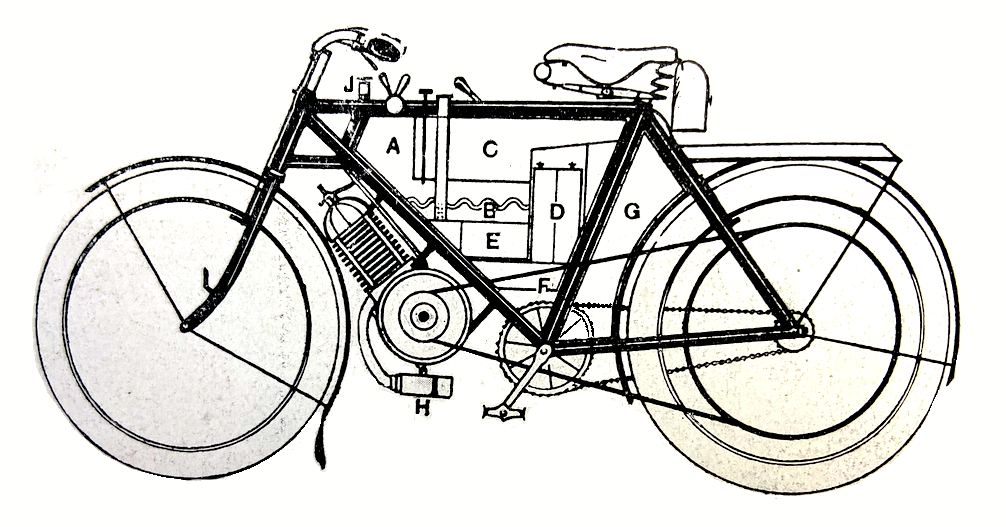
F, Oil tank; G, Spare petrol tank; H, Silencer; J, Oil pump.”
Why has the maker wasted so much valuable room between the back wheel and the seat-pillar tube? and, again, below the tank in the diamond frame? That gap just in front of the back wheel has been covered by a registration. The man known to the trade as ‘having his head screwed on the right way’ has already annexed that for himself. You pay him a small royalty, and it is worth it. It adds little to the weight when empty, and on a tour is invaluable. The space below the tank is usually filled by a silencer—in shape ugly, in quietness deficient, and generally too near the surface carburetter to give the best heating results. Heat is chiefly needed in starting, and then, of course, none is at first obtainable. When thoroughly going the big silencers nearly boil the petrol in the carburetter; and, further, on many machines warm up the accumulator as well. The sketch shows the silencer in a far better position. A narrow byepass tube from the elbow of the exhaust pipe goes through the carburetter. A further refinement is to fit a cock outside the carburetter, insulated from heat by asbestos packing. This device is not unlike that employed on the famous Ariel tricycle. Smaller details are the pump, which may be carried along the top tube; the carbide carrier (Gamage supplies a long thin cylinder, which may be carried down the seat-pillar tube); and a second lamp-bracket can be fitted to the forks. There is a reason, of course, for the position allotted to each thing in the tank. Petrol and oil must be above the carburetter and engine respectively, except on the air pressure method. Air pressure feed is used for the back petrol tank and for the oil in the bottom of the diamond frame. The oil tank is admittedly not very accessible. A projecting nozzle can be fitted at the side; but for the machine under notice a long filling tube projects up, through the petrol reservoir to the top of the tank. Battery and coil should be near the engine, theoretically, to keep the wiring short. But if the wire be of high quality, and the terminals not soldered, but shaped of copper and compressed on the wire, long wiring gives no trouble. The Excelsior, which has very long wiring, gives no more trouble than the Ormonde, on which the wiring is reduced to a minimum. The oil pump is best fitted either on top tube (another Phoenix patent) or in the position of last year’s Excelsior—on the front end of the tank, lying against the triple head. Notice how compact the machine is; nothing can be damaged by an ordinary fall except the crank, and that protects the contact breaker, because it projects further. If that occurs, footrests on the forks support your feet, and a running mount is necessary for a start. Dust will hurt nothing but the belt. If you like, you need not clean the machine between rain and rain, barring always the belt You have petrol for 200 miles, plenty of oil, room for your luggage and toolbag, and a reserve store of electricity. If you can spend from £50 to £60 on a good motor, may these minor matters bring you all comfort and confidence on your tours.”
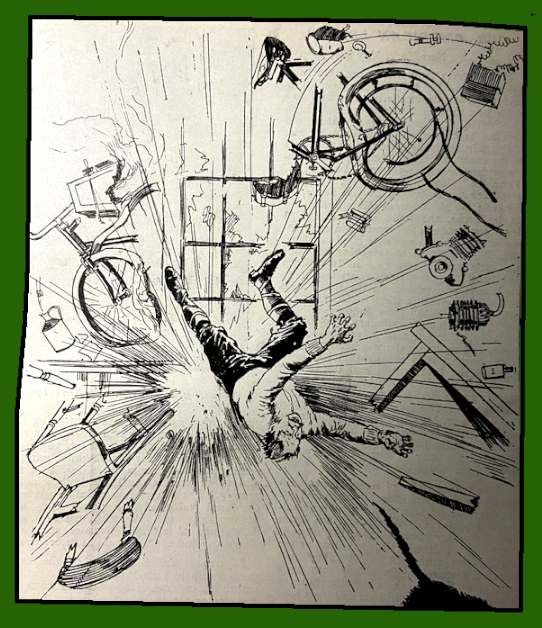
“THE ULSTER SECTION OF THE Motor Cycle Union of Ireland certainly holds its competitions under very different conditions to the Central Section of the Union. As our readers will remember, the competition. arranged for Glenamuck was stopped by the police. But on Saturday, although the police were again present, and in considerable numbers, it was not to interfere with the competitors, but to assist officials, as the race was held under special permission of the Bangor Urban Council. Although the hill was a good one to test the capabilities of the motorists and their mounts, its situation was not the one that would have been selected by the committee as a considerable number of residences abutted on to it. However, when prizes are offered, and the Union invited to promote motoring interests in a certain district by a competition, the committee felt they would fail in their duty if they did not do everything in their power to meet the wishes of the donors. The race had every prospect of being a huge success, 30 competitors being weighed in by the handicapper, but a drenching morning deterred many from facing the 14 mile ride to Bangor, and only 13 actually started, with the following result: 1. ‘Patrick’ (Centaur 2¾hp) 52⅗sec; 2. Ireland (Humber 2¾hp), 60⅘sec; 3, Stewart, (Centaur 2¾hp) 61sec; 4, Mallon (Quadrant 3hp) 61⅗sec; 5, Wilkinson (Triumph 2hp) 62⅖sec. The distance was only 720 yards, but the hill had an average gradient of 1 in 12, while about 200 yards near the top a gradient of 1 in 8 proved the most trying point for all.”
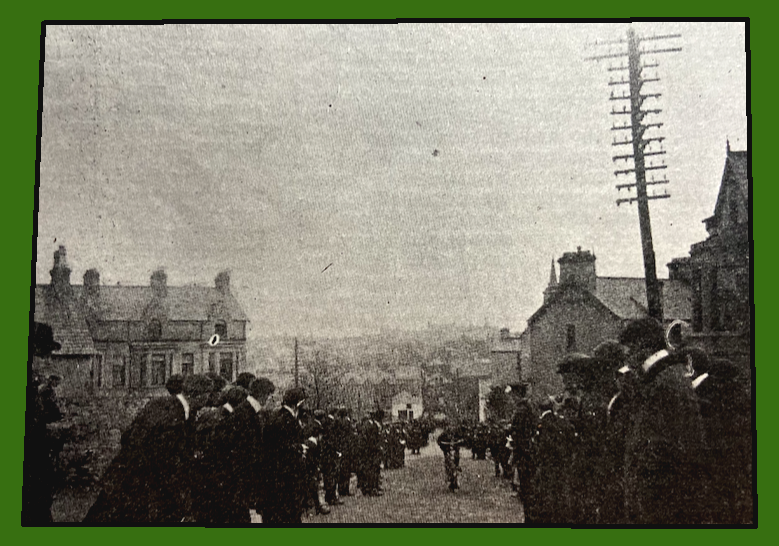
“MR EG YOUNG, OF NOTTINGHAM, sends us a photo showing what a 2½hp motor will do. The motor is an ordinary Minerva, with suction opened inlet valve. He was out with a fore-carriage and trailer and passengers—in itself a huge load for a 2½hp machine, and he came across a beginner who was learning to drive a fore-carriage. The motor on this machine had gone wrong, and would not move, so Mr Young decided to take this machine in tow home. Despite the enormous weight of machines and passengers which worked out at well over half a ton, the motor proved quite equal to it, and pulled the lot in fine style much to the astonishment of passers by.”
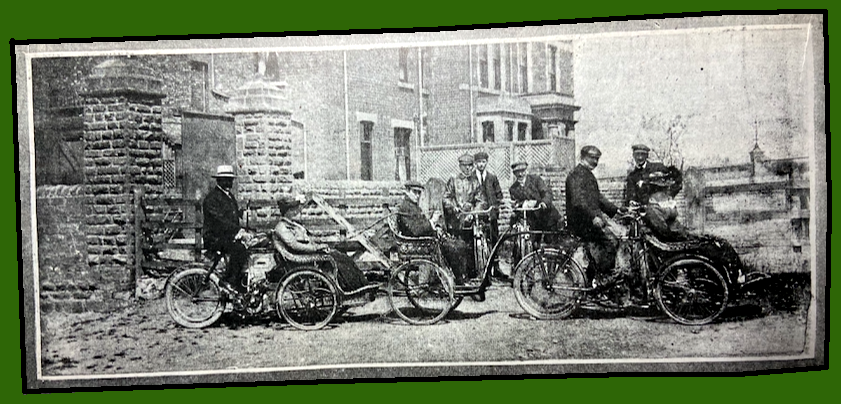
“ALTHOUGH [IN THE USA] THE MOTOR-BICYCLE is frequently described as the connecting link between the automobile and the bicycle, motorcyclists have evinced a disposition to flock by themselves, to organise their own clubs, to promote their own contests, and generally to direct and attend to their own affairs. A year ago there was but one motorcycle club; to-day there are half a dozen, and as many more are in prospect. It is now the ‘Massachusetts Bicycle and Motorcycle Club’, the good old Boston organisation having at a recent meeting taken under its wing a motor-cycle contingent. The move has been on the tapis for some little time, it being a question whether the rapidly growing motorcycle interests should form a club of their own or join forces with the Massachusetts Club. The latter decided at a special meeting to add ‘Motorcycle’ to its corporate name, and there are now a round dozen members using motorcycles.”
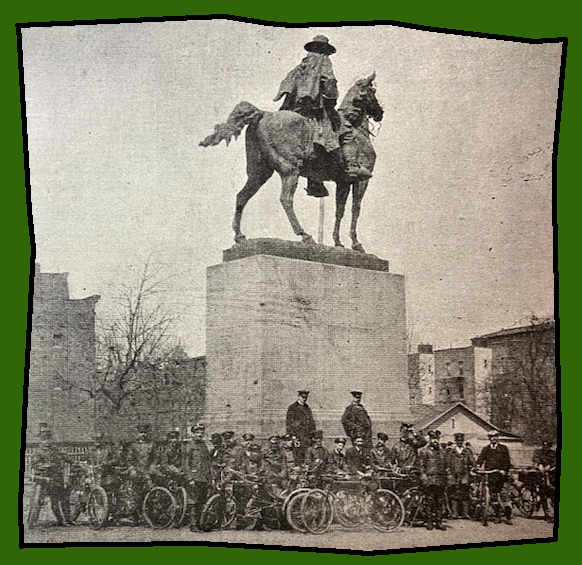
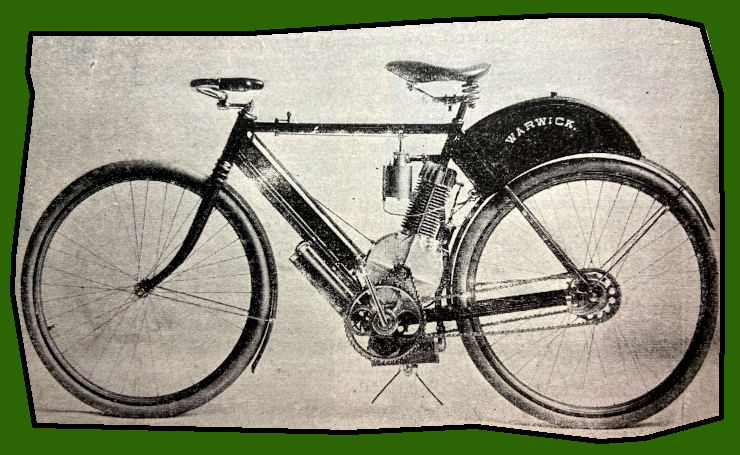
“SELF-PROPELLING WHEELS, which can be used with or without the motor, are the newest in motor science. FE Steffey, of San Diego, California, has just invented a motor-bicycle which bids fair to do away with the present much used wheel. The motor mechanism is remarkably complete, and the machine generally has a wonderfully neat and compact appearance. The motor is of the gasoline variety, weighs about 25lb, and develops 1hp. It occupies a space 15½in in length by 3½in in thickness, the design being so thin that it can be placed within the diamond frame of an ordinary bicycle without interfering with the pedals. Freedom from vibration and noise is one of its main features, and a speed of 25mph, with ability to surmount 10% grades are claimed for the Steffey machine. A few minutes’ work with a single tool—a screwdriver—to detach the motor from the bicycle, practically gives the owner a motor-cycle and an ordinary bicycle in one.”
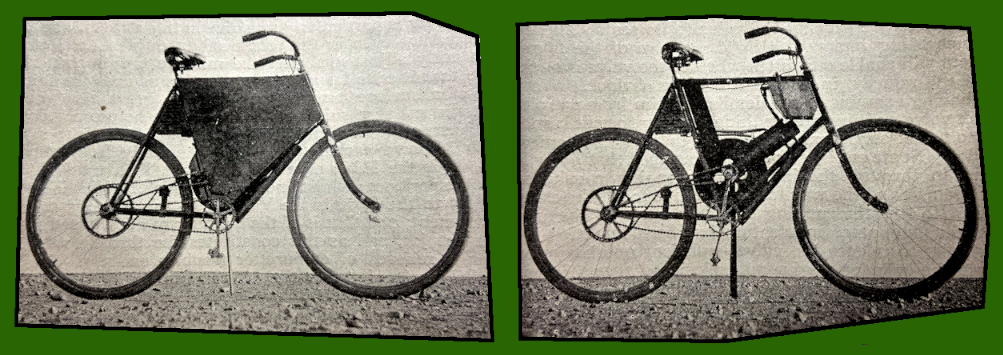
“MR MORTON PONDER, of the Auto Cycle Club, was the victim of a Bank Holiday bounder at Whitsuntide, but the bounder has had to pay the piper since. Mr Ponder was riding his motorcycle with a trailer attached along the Redbridge Lane be tween Wanstead and Ilford, and gave warning to a group of four men walking in the road. Whilst passing them, one of them, named Ernest Beckett, thrust his stick into the spokes of the back wheel. Mr Ponder was, by this action, thrown, but the only damage to the machine was to the mudguard. The man swore that he had been knocked down, and that the stick had got into the wheel in consequence, but the evidence of the rider and his friend in the trailer was corroborated by Dr Marsden, who was passing at the time. Mr Tabrum, Chairman of the Bench at Stratford Police Court, said that he was of opinion that the defendant had had too much drink, and had performed a very dangerous action. He would be fined 5s, and have to pay the costs and damage in addition, amounting altogether to 9s 6d. Defendant asserted that this was ‘because the other side had black coats,’ to which the Chairman replied that if he had worn a black coat the fine would have been a sovereign.”
“IT OFTEN STRIKES ONE as strange that there should be such a difference in the noise made by motor-bicycles of different makes. Passing along Oxford Street the other afternoon the writer took note of three machines as they went by. A Minerva 2hp with the mechanical inlet made a sharp penetrating report that drew one’s attention to it at once. A Humber 3hp on the other hand had a distinctive, but not unpleasant, ‘swish, swish’ that seemed to harmonize with the purring of the chains. A Quadrant 2 hp gave out a peculiar drum-like sound.”
“THE MACHINE ILLUSTRATED is made by the Eclipse Motor and Cycle Company, John Bright Street, Birmingham. The motor has two cylinders set in a loop frame, and it will be noticed that the wheel base is extra long. The motor is so arranged that either cylinder can be worked in-dependently, and thus 2 or 4hp can be obtained as required. The transmission is by a V-belt. The petrol tank has a sufficient capacity for 150 miles running, and there is also a compartment that will hold two accumulators, spare inner tube and belt. The carburetter is the well-known ‘Clement’ type. Two rim brakes are fitted. The makers claim that the machine will take a fore-carriage or trailer up almost any hill.”
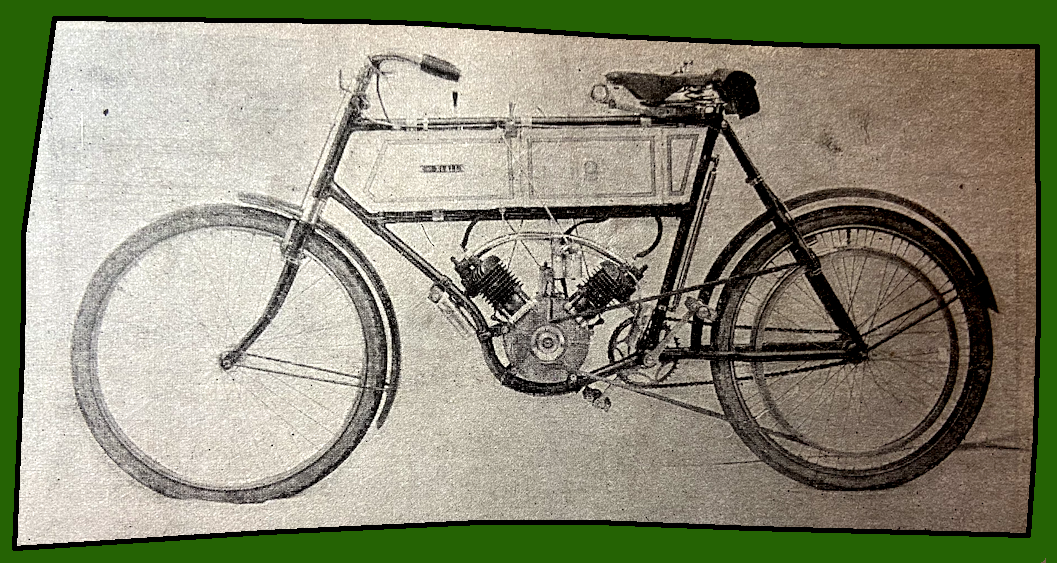
“THE PRIMUS MOTOR WORKS, Rathgar Road, Loughborough Junction, London, SW, have recently introduced a type of motor-bicycle suitable for a lady to ride. A two-stroke motor is arranged in front of the steering column, and drives by means of a friction wheel on to the front tyre. The petrol tank and surface carburetter are mounted in between the handlebar. The induction coil is placed below the down tube, and the accumulator is strapped behind the saddle. The motor is readily thrown in and out of gear with the front wheel by means of a lever near the handlebar.”
“AS A PRELIMINARY TO THE Circuit des Ardennes, two races were held on Friday last at Huy, open to vehicles entered for the big event. The races were one kilometre, with a flying start of about a further kilometre, and a hill climb, the length of the hill being 1,352 metres…Griet, on a Griffon motorcycle, did 37sec, or 60½mph. The other times in the cycle class were all very fast, no less than eleven exceeding 45mph. In the hill climb Griet again made fastest time for cycles, 54sec.” This, to the best of my knowledge, is the first report of a bike doing a mile a minute—Ed.
“AT CANNING TOWN, ON SATURDAY, several interesting motorcycle events figured in the well-arranged programme of the West Ham United FC’s first meeting of the season. A 25 miles scratch race was won by Sam Wright, on an Excelsior, in 30min 38⅘sec; JF Crundall (Humber) being second, and TH Tessier (Bat) third. Crundail had at one time an excellent chance of victory, but this was spoilt by him losing his pedals in the twentieth mile.”
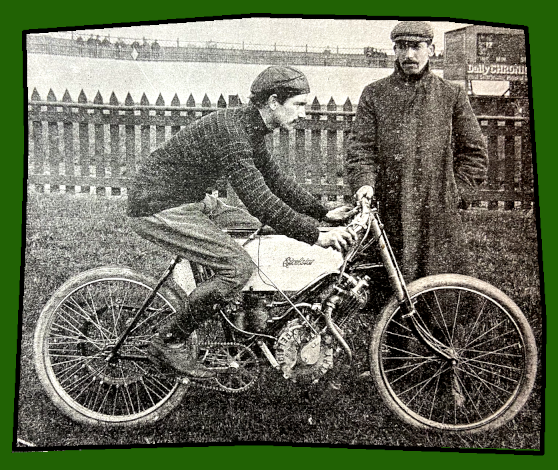
“THE TRIUMPH CYCLE CO, COVENTRY, have just got up to their London depot one of their new 2½hp machines. It impressed us as being a very nicely designed machine. The motor is specially made by the company and is mounted just above the bottom bracket in a slanting position. The carburetter is a surface pattern, having an extra large petrol capacity. Ignition is by trembler coil, this being mounted behind the back forks. Transmission is by ‘Lincona’ belt, the pulley having a large diameter. A very neat sight-feed lubricator is placed in a convenient position near the steering pillar. Two brakes are fitted, viz, a special rim brake for the front and a ‘Triumph’ band pattern for the rear wheel.”
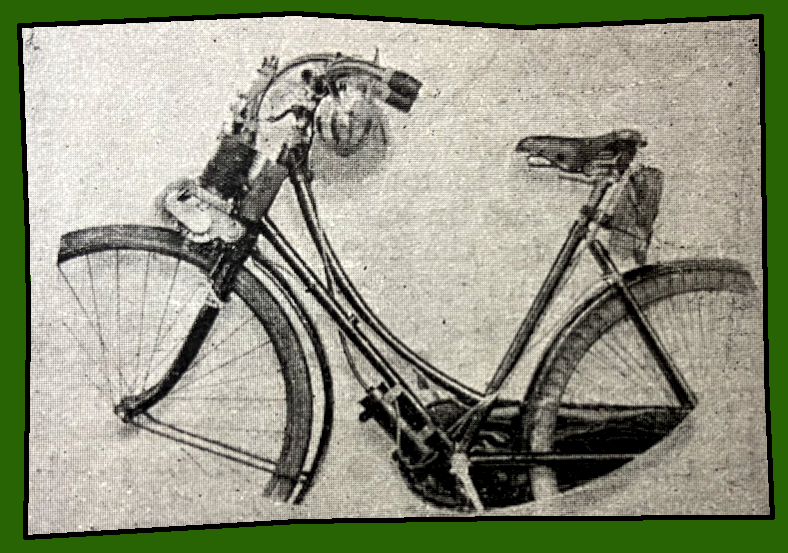

“ON THE SATURDAY, at tea time, we had scarcely thought it, and had not even purchased our motor-bicycle. Neither my brother nor myself had had very much experience with the motorcycle; in fact, he had never been on one before. I had previously hired a motor-bicycle of last year’s pattern from time to time and had ridden, perhaps, 100 miles, but I may say that we had thoroughly mastered the working details of the motor with which the particular machine we rode is fitted before we started. The outcome of our decision was that we purchased a new 1903 pattern motor-bicycle, and resolved to spend our Whitsuntide in Switzerland. At first sight it seemed hardly possible that a 2hp motor-bicycle would carry my brother and myself, but by a little contriving an ordinary luggage carrier was fixed over the back wheel, and two or three cushions strapped on for a seat, two straps attached as stirrups, and on the Sunday afternoon we had a preliminary canter up and down the Edgware Road. At 6.45 on the Sunday evening, having filled our 2½ gallon tank with Pratt’s ‘A’ spirit, we strapped our belongings on the machine, I jumped into the saddle, my brother got on his seat at the back, we tootled our horn and made for Newhaven, with plenty of time to catch the 10.40pm boat for Dieppe. Westminster Bridge Was negotiated and then came Streatham, where we were misled by the sign-post. The result was that we did 100 miles instead of 59, and of course missed our boat, and had to wait till 11 o’clock next morning. A surprise awaited us on going aboard. All our petrol had to be wasted, as the steamboat company will not allow any one to take a drop of petrol on board the steamer. We duly arrived at Dieppe at four o’clock after a very nice passage, expecting to get to Paris the same night, but we reckoned without the Customs authorities, who demanded from us 110fr 25c (which works out at about 2fr 20c per kilo). A hasty consultation took place, and then we discovered that our combined funds only amounted to 75fr. Entreaty and explanations proved of no avail, and there we had to stop until we got the money. We telegraphed to England and again experienced trouble—Bank Holiday prevented the £3 which we had wired from reaching us until 10.30 on the Tuesday morning, and now as we had not reckoned on our hotel bill and other expenses after paying duty, this only left us exactly 15fr to do our journey on, and we had petrol to buy. We found a most obliging man in the person of M Barter, Quai Duquesne, Dieppe, who gave us some useful tips and supplied us with some excellent petrol, and here, let me say, there are at least half-a-dozen kinds of petrol in France, so one has to be careful, and it works out much dearer than in England, so that our 15fr dwindled very considerably. At last, at noon, we were fairly on our way, but nearly had a collision on leaving Dieppe, on account of our riding experiences in England, always keeping to the left; here, in France, it is the rule to keep to the right. The differences between many of the English and the French roads are at once apparent, the roads in France, in the main, being beautifully kept, broad and straight, and the guide posts are—as the Americans say—fool-proof. Sometimes we could see the road in front of us, straight ahead, for miles, and we travelled for long distances without meeting a soul, and when we did meet anyone and asked if we were right for Paris, the answer was always the same, ‘Oui, oui! toujours tout droit.” Arcques was soon reached, the motor going beautifully, then on to Neufchâtel-en-Bray, when bang! a tyre puncture! However, we had come (as we thought) well prepared, and took the matter very coolly, but when we came to look amongst our kit, we had left all our tyre repairing outfit behind. Fortunately, we were within a few yards of ML Hernault, who quickly repaired our puncture, so1d us a repairing kit (which further diminished our store of cash) and gave us what proved most useful—a small Michelin guide-book. We then got away Gournay, through Pontoise, Courbevoir, to Paris. About 15 miles from Paris the road is very bad, consisting of great cobbles pavé badly kept, and we were not sorry when we were pulled up by the gendarme at the Octroi gate. They carefully measured the petrol in our tank, and we had to pay a further Octroi duty of 40c. We reached Paris about 6pm, and found comfortable quarters close to the Port de Vincennes. We had a stroll to
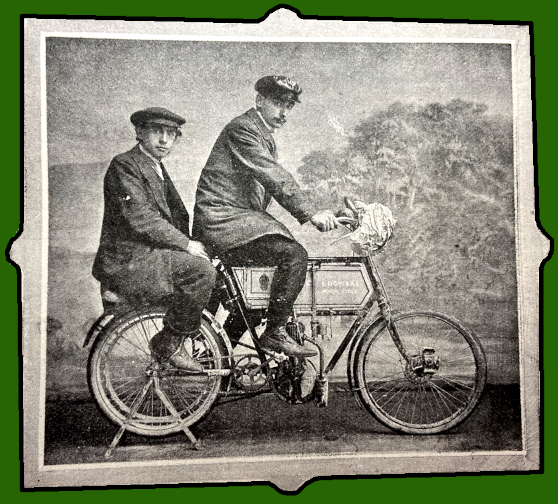
stretch our legs, and started off at five in the morning with only 7fr left. At the gate a curious little surprise awaited us this time-3d of our ‘octroi’ was re-turned, as on measurement it was found that we had used one pennyworth of petrol in Paris. Even this was acceptable now as our funds were so low. We had again to negotiate 15 miles bad road, which resulted in another puncture, but this we easily managed to repair, and were soon off again. Here we have pleasant recollections of a motor-tricyclist, who kept with us for about 20 miles, sometimes a little behind, sometimes a little in front, but he dropped behind at last, as our machine proved a little too fast for his tricycle. At Fontainebleau we filled up the tanks with petrol, and then away we sped to Montereau, past Leno, Tonnerre, Monthard, reaching Dijon at about 6.30. On and on without stopping—we could not afford to stop; we must keep our remaining 1s 4d in case of emergencies. But we were consoled with the thought that there was plenty of money awaiting us on the frontier. We scarcely noticed what villages we came through until we arrived at Pontarlier, at the frontier. There was nothing to worry us, the motor was going well, we were both comfortable, and, best of all the road was straight and good. Without any difficulty we received from the Customs officials our 110fr back, and fortified ourselves with some of the good fare at the Buffet-la-Gare. After a short rest we again mounted and arrived at Lausanne soon after ten. Our machine had gone beautifully, o’er hill and dale, without trouble. The journey from Dieppe to Lausanne occupied about 46 hours, including stoppages, nothing very wonderful, unless you remember that there was an extra passenger, who only had to get down once because of the great hill outside Pontarlier during the whole of distance. On the following Sunday at eight o’clock we started back. Paris was reached at seven on Monday evening, and then came a hard run against time for the midnight boat from Dieppe. The last 30 miles of the trip brought us blinding rain and was the worst experience we had during the ride. We got soaked to the skin, but fortunately we caught the boat at Dieppe and ran up to London comfortably on the Tuesday morning from Newhaven, reaching home at eight o’clock. It was an enjoyable trip for both of us, the shortage of cash providing us with many recollections which we can now laugh at. But the credit of the performance is entirely due to the machine, and we are looking forward to a round of experiences with it which shall at least be as pleasant as our trip to Switzerland. For the benefit of readers who may intend making a similar tour, the following particulars may be of some assistance: The charge for taking the motor bicycle across, without petrol, is 6s from Newhaven to Dieppe…We saved considerable money at Dieppe by stripping the machine of its batteries, the rear seat, and sundry parcels, so we actually only paid duty on the weight of the machine alone, viz 2fr 20c per kilo. Every detail was put on the receipt. We were not required to obtain any identification number on our machine, but we understand that if a rider stays in the country long he would require to register the machine. The frontier office is open day and night, and on presentation of our receipt we were immediately handed our money back. (The plan usually adopted in England to get waiters and other officials to accelerate their movements was adopted!) We now had to pay 65fr to go into Switzerland, and the same formalities had to be gone through as when entering France. When coming back we obtained our money from the Swiss frontier, and having joined the Swiss Touring Club in the meantime, we got into France without difficulty, on presentation of our Swiss Touring Club badge and card. The machine which carried us so well throughout the journey was an ‘Edgware’, which we purchased from the Cycle Trade Supply Co, Edgware Road, London, W.”
Motor cyclists were certainly ‘going foreign’ by 1903 to try their luck in the great inter-city continental races. But this is the first example I’ve come across of a couple of chaps loading their bike and heading over the Channel on a whim—and they seem to have invented the pillion seat (with stirrups, forsooth!). You’ll have to go forward to 1905 to find another individual example; pillion riding didn’t become at all common before the Great War. And they were surprised to find Frenchmen driving on the right. Pioneers indeed, bless ’em, and we don’t even know their names—Ed.
PASSENGERS WERE carried in forecars, trailers and most recently sidecars but pillion riding was definitely a novelty. As The Motor Cycle reported: “The two London riders who recently carried out a successful Continental tour on a motor bicycle converted into a tandem by the simple expedient of fitting a make-shift seat on the luggage-carrier over the rear wheel are to be commended for their enterprise. At the same time we do not in the least anticipate that this novel method of carrying an extra passenger is ever likely to seriously rival the trailer or forecar. In the first place there be but little spring in the luggage-carrier, and, secondly, there is always the chance that it may swing down and let the rider suddenly on to the road.” Rather than resorting to the carrier some pillion passengers were carried in luxury…
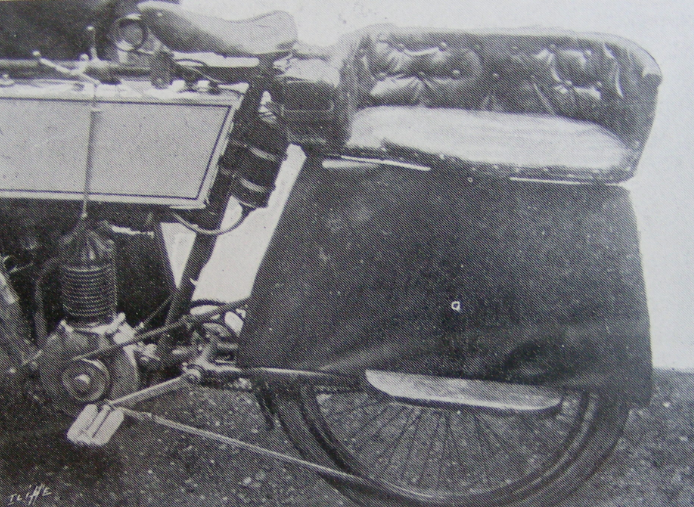
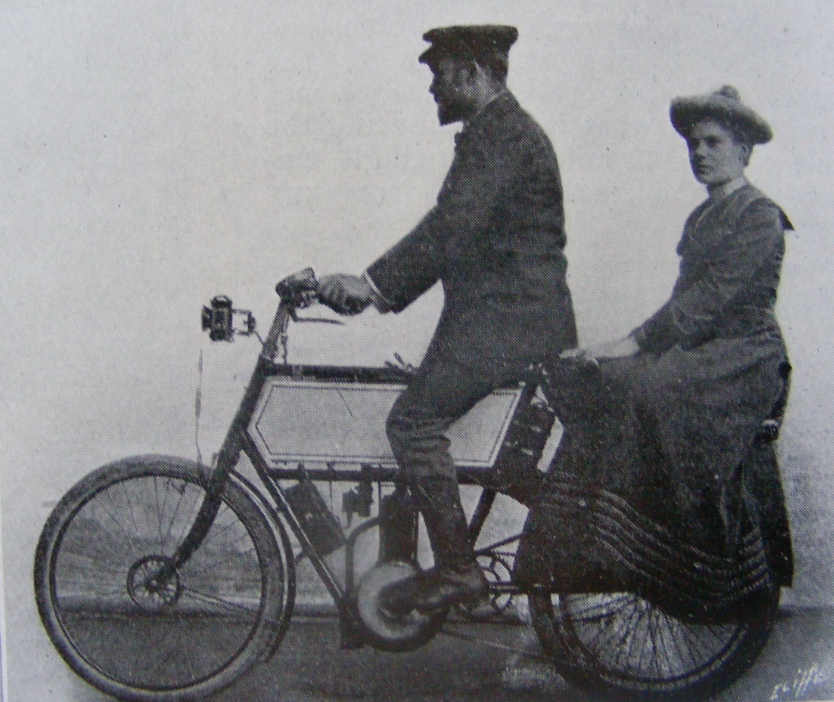
“GA BARNES ATTEMPTED to ride his Bat motor-bicycle fifty miles within the hour at Canning Town, but owing to a mishap to his front tyre he fell and broke his arm in two places.”
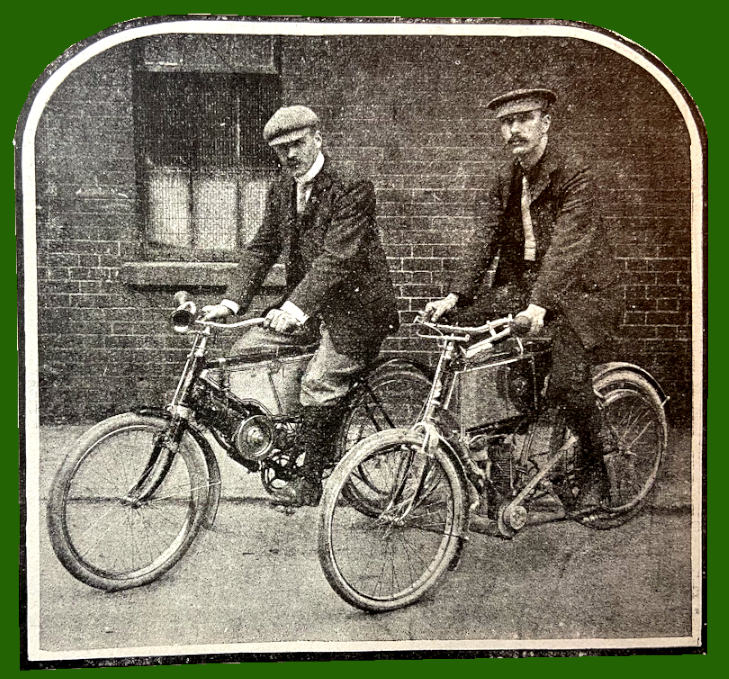
“ALTHOUGH BY NO MEANS so big or so important as the Paris-Madrid race, the Circuit des Ardennes is now one of the classical events, and the fact that it has been run off year after year without the occurrence of any grave accident, and particularly because this year’s event, in which cars identical with those taking part in the Paris-Madrid race were competing, was so successful, it looks probable that it will escape the fate of prohibition which has this year befallen the classical French contests. Should this be the case we may find the Circuit des Ardennes has become the great classical race on the Continent in future. [Cars did six laps of a triangular course totalling 318 miles; the bikes did two laps of a different course totalling 185 miles.]…At 10.10am the first of the motorcycles went away. The starters were: Dacier (Clement), Pascal (Clement), Oster (Clement), Blondeau (Bichrone), Narbel (Bichrone), Flamant (Minerva), Elscamp (Minerva), Kuhling (Minerva), Olislager (Minerva), Rigaut (Antoine), Kinet (Antoine), Andre (Red Star), Philtjens (Sarolea), Verschaere (Sarolea), Fagard (Sarolea), Demester (Griffon), Lamberjack (Griffon), Meura (Minerva), Cissac (Peugeot), Momo (Peugeot), Lanfranchi (Peugeot), Griet (Griffon), Prost (Doue), Jolivet (Pecourt), Berger (de Pontherey), Lionel (Griffon), Marnaffe (Sarolea), Ken (Sarolea), Charent (Antoine), Barret (Burman), Bossut (Rivierre), Desenfaus (Antoine), Rene (Antoine), and Pieri (Minerva). All of these machines came within the weight limit of 50kg. The last cycle was dispatched at 11.43, and then it was observed that English cycles and English riders were conspicuous by their absence; neither Arnott on the Werner nor the two Humbers, all of which had been entered, had put in an appearance at the weighing. Verschaere was the first to get back to Arlon, having covered the course in 2hr 18min 50sec, but he was closely followed by Demester, who was less than a minute behind, but as Verschaere had started five minutes ahead Demester was already four minutes to the good. Of the 34 starters only 18 finished the first round, and of these seven were inside of 2hr 40min; six more exceeded 3hrs; while Pasco took 5hr 40min. Punctures and other tyre troubles were mainly responsible, but the bad corner on the outskirts of Arlon caught a good many napping, and there were three falls here, but they were not very serious, fortunately. Dacier made fastest time in the second circuit, which was slower all round than the first. His time was 2hr 44min 48sec, but in his case it was an hour faster than his own first round. Dethester occupied only 11sec longer than Dacier, and as his total time was 4hr 59min 46⅗sec he won with plenty in hand, his nearest opponent being Andre, who rode very regularly all through, and who covered the distance in 5hr 23min 26sec.” Only eight other riders completed their two laps.
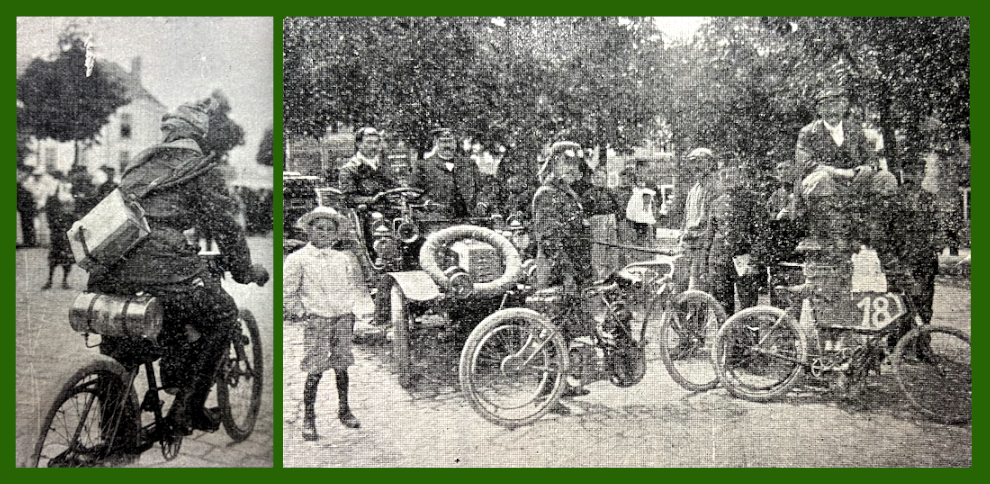
“AS THE DAY OF the ill-fated Paris-Madrid race gradually recedes, we observe, with keen pleasure, that the dispassionate view of the incidents of that event, taken by our own representative at the time, is becoming more general, and it is now being recognised that scarcely one of the awful accidents need have occurred. Bad organisation, ineptitude on the part of those entrusted with onerous duties, and slovenly carelessness, coupled with senseless rashness in the presence of danger on the part of the spectators, were the causes of nearly every one of the accidents, the only two (one of them fatal) which could be ascribed to neither of these causes being due—we regret to say it—to the unsportsmanlike behaviour of a certain class of French drivers…we shall live in the same hope that some suitable punishment had been levied on the individuals concerned. However, it has been clearly proved from the painful accidents of the Paris-Madrid race that accidents, even at the high rate of speed of well over a hundred kilometres an hour, need not happen. Take the Circuit des Ardennes…the cycles travelled at a pace which people in this country are given to glibly describe as ‘furious’. They contemplate the possibility of travelling from London to Brighton in an hour with a large amount of horror, but, as a matter of fact, they are utterly ignorant of what the pace means, and paint the terrors of motor speed with their brushes dipped in pots of crimson-red and vermilion…We are glad that the Circuit des Ardennes has passed of without accident, because it confirms the opinions express in these columns that racing well controlled is not so very deadly, and it will, perhaps, silence the shrieks of those who scent danger in the Gordon-Bennett race. Our opinion is that this event…will off as quietly and without accident or incident as if i were a mere procession, simply because, in the first place,, proper precautions have been taken, and secondly, because, we are proud to say, Anglo-Saxons are better balanced mentally in the presence of danger.”
THE GORDON BENNETT RACES were a great success; they were followed by a fortnight of motoring and motor cycling events in Ireland, including a hillclimb at Castlewellan and several tours. Here’s an indication of the attitude which incensed the Irish nationalist community: “The contrast in the reception of people and animal accorded to our car was very funny. The whole of the way we were constantly doffing our hats in exchange for the enthusiastic welcome given us. If it had only been possible, many in the party would have liked to have given a ride to some of the peasants, particularly to the pretty Irish girls. In the villages we saw faces which would create a sensation in a London drawing room, whilst the unaffected simplicity of their owners constituted a great charm…”
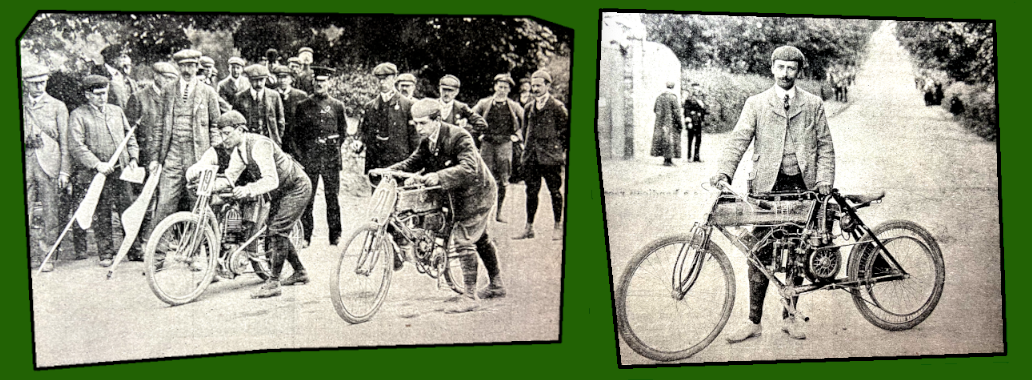
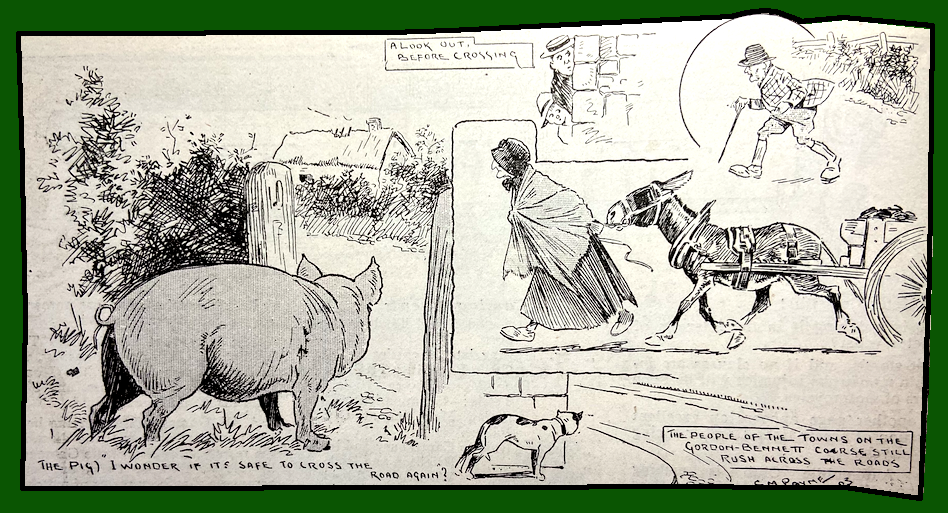
“WE ARE ABLE TO GIVE the following particulars of an entirely new machine to be placed on the market by the well-known Rover Cycle Company, Coventry. The frame has been specially designed, and is registered. The engine is carried vertically in front of the crank bracket by two cradle plates, one being of horseshoe shape, the other being similar, but having a horizontal member across the top. The plates are fixed by bolts passing through T-lugs, brazed on the ends of tubes. Extra large ball bearings are provided for both wheels, and steering head. The engine being placed well forward of the crank bracket, allows of a narrow tread, whilst still retaining straight cranks. The bicycle has a long wheel base and is fitted with 26in wheels. The engine is 2¼hp. The carburetter is of the float-feed type and is fitted with a throttle valve. The tank contains petrol and lubricating oil only, each division is of great capacity, and is separated from the other by a double partition. Two sets of accumulators and a high-speed trembler coil are fitted in the case at the back of the seat tube, the case being lined throughout with cork. A two-way switch is mounted on the top tube to allow of either set of accumulators being used. The engine is lubricated by force pump. The throttle valve and ignition are actuated by levers on the top working on racks. The back wheel is fitted with a back-pedal expanding brake, actuated by a clutch on the crank axle; the clutch has a throw-out arrangement, allowing the machine to be wheeled backwards, and a safety catch, in case the rider omits to throw his brake in action before mounting. The front wheel rim brake is applied by the right hand inverted lever. This lever also cuts off the spark by means of a special design of switch contained in the handlebar. The left-hand inverted lever works the exhaust valve lifter by Bowden wire, and has a retaining catch. With their wealth of experience and skill, the Rover Company may be relied upon to have produced an article which will give every satisfaction.”
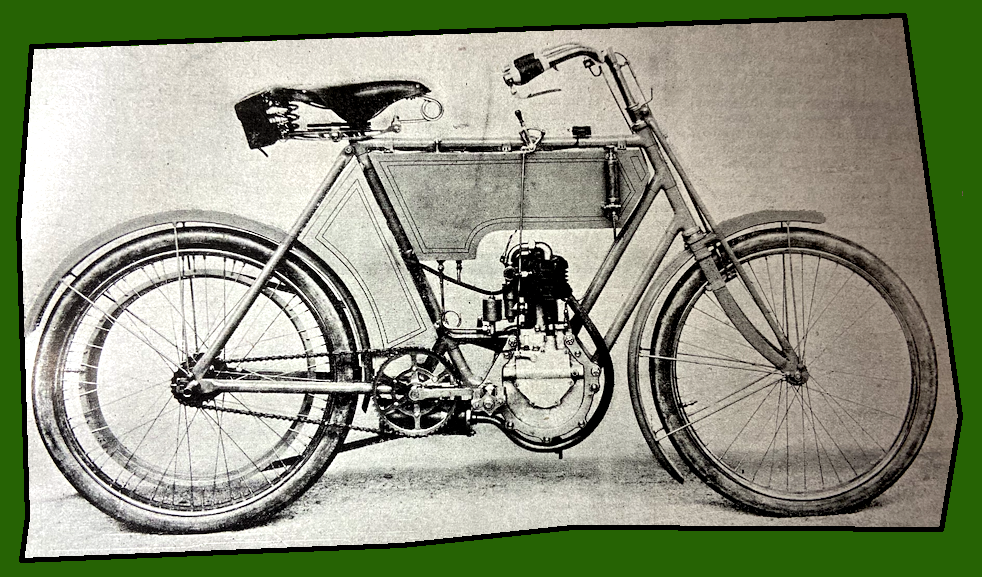

“SATURDAY LAST WILL REMAIN a memorable day in the annals of motorcycling, for the inauguration of a series of tests to prove, if such proof were needed, that the motor-cycle is a machine capable of travelling long distances and giving as little trouble to the rider as an ordinary pedal-driven cycle. The Motor Cycling Club, as the premier club of its class in the country, some months ago decided, with a view to popularising the pastime, to promote reliability test runs over a distance of 200 miles. The President of the club, Mr SF Edge, generously offered a handsome trophy to be awarded to the rider who gets his machine through the distance without a stop for effecting any adjustments whatsoever. An entry of 20 had been obtained, and, on the Friday night, all the competitors and officials made their way to the town of Hatfield, on the Great North Road, which was to be the starting and finishing point of the test. The machines were all safely locked up at the Red Lion Hotel, and no competitor was allowed to touch his machine after delivering it. As the start was timed for 6am, the whole party were up at the Red Lion for breakfast by 5 o’clock. At 5.45 the scene outside the hotel was an animated one. The morning had broken brilliantly fine, and gave promise of a day of glorious sunshine. There was not the slightest element of a race about the trial, as any competitor whose speed at any point was found to exceed a limit deter-mined upon by the committee was disqualified. The following competitors were assembled at the start with their ma-chines: AS Wilson (2¾hp Ormonde); RA Leckie (2¾hp Humber); FR Johns (2¾hp Humber); CW Brown (2hp FN); J van Hooydonk (2½hp Phoenix-Trimo); Bert Holmes (2½hp Minerva); HE Cowles (1½hp Phoenix); H Fairfax (2¾hp Werner); Leonard Jones (1¾hp De Dion Clement tricycle); Chester Fox (2¾hp Werner); JH Reeves (2hp Minerva); T Silver 3hp Quadrant); F Hulbery 2¼hp Booth); and CA Vandervelle (2¾hp Ormonde). The first stage of the run was Hatfield to Stoney Stratford, on the Holyhead road, then returning to Hatfield, making 73½ miles. Next there was a run to Hitchin and return to Hatfield, making a total distance of 100½ miles.). The competitors were started in groups of three, at intervals of a few minutes, the last group left at 6.20. H Fairfax had a stroke of ill luck before he had gone 200 yards, his back tyre going flat through the valve tearing out of the air tube. This mishap put him out of the trial. The route selected

consisted of splendidly surfaced roads; to prevent possibility of any competitor missing his way a map and printed instructions were supplied to each. The first group to return from Stoney Stratford consisted of Johns, Leckie, Hooydonk and Holmes, who were ob-served passing through Dunstable all well at a steady 15 an hour. CW Brown early experienced very bad luck with his tyres, having several punctures, one being from a big rusty nail which pierced about half an inch of rubber in the cover and went through both sides of the air tube; he repaired and continued, so as to obtain the distance certificate. Just about twelve o’clock Johns, Leckie and Holmes arrived at Hatfield, the others following at intervals of several minutes. The puncture demon, however, lay in wait for Chester Fox just outside the hotel, and his back tyre went flat a moment before he dismounted. Hooydonk had a puncture on his way back, but quickly repaired, and reached Hatfield at 12.27. Leonard Jones, on his tricycle, and Silver and Reeves got through the first stage without touching their machines. Leckie retired at the end of the first stage. An hour was allowed for lunch at the hotel, and then the second stage was entered upon. This stretch was first to St. Albans, then by the Watford road to two miles beyond Berkhampstead, where the competitors were checked, turning back for Hatfield, distance 51 miles. Competitors began to arrive at Hatfield about 3.25, and beyond more punctures and one competitor running short of petrol, no stops for motor adjustments were recorded. Brown reported more ill luck with tyres, but motor running well. Hooydonk experienced no trouble at all with his motor, and it was so far remarkable that belt and ignition difficulties were totally absent. The final stage was Hatfield to Hertford, Wades Mill, Puckeridge Royston, and back to Hatfield. This route was the only one where any stiff hills were met with. There is a winding drop into Hertford, and then, after passing through the town, a long hill, and again, after Wades Mill, there is a very difficult hill to Puckeridge. This necessitated slight pedalling with even the higher powered machines. The first competitors through Hertford were Brown, Holmes, Jones and Johns, followed by Reeves, Hooydonk, Silver, Hulbery, Cowles, with only a minute or so between each, all going well. Very considerable interest was now centred at the Red Lion Hotel to await the return of the competitors. The open space in front of the hotel was pretty well crowded with motorcars and motorcycles, many prominent riders having run
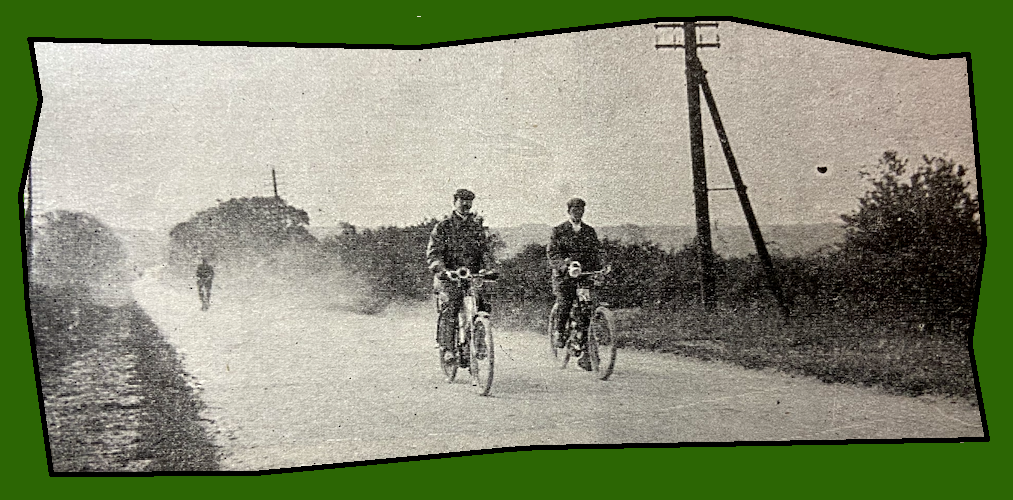
up to see the finish. The first to return was Johns, on his Humber, at 7.37; the next to come in was Jones (tricycle), at 7.39, followed by Vandervelle at 7.44, and Brown at 7.55. The latter reported wretched luck with his tyres, having four punctures in the last 50 miles. Hulbery arrived at 8 o’clock, followed by Hooydonk at 8.1, Silver at 8.3, Cowles and Reeves at 8.4, Holmes following later. A. ovation awaited the competitors, and each group was photographed as it rode up. Each rider handed in to the marshal a card filled in with particulars of any stops en route. The tyres had proved a source of trouble to the majority of the competitors, the road surface in parts abounding in small sharp flints, which pierced the stoutest covers. Those who experienced the best luck with their tyres were Leonard Jones, Silver and Reeves, who got through without a stop. HE Cowles rode exceedingly well on his 1½hp. Phoenix, but had one stop for a puncture. Considering the distance accomplished in the day, and the intense heat, none of the competitors showed signs of undue fatigue at the conclusion. It was surprising that no ignition troubles of the slightest were reported, and Jones’s ride speaks well for the De Dion-Clement tricycle. Hooydonk lost a minute with his spray carburetter, but had not to touch any other part of the machine, which had previously run several thousands of miles. All agreed that the test had proved enjoyable, and others would be looked forward to with interest. The result so far is that Jones, Silver and Reeves tie, having all got through without a stop, and the manner in which the tie will be run off will have to be decided by the committee. The test made a real good sporting event, and it was conclusively shown that a ride of this nature can easily be carried through without the slightest inconvenience of any kind to the public. But whilst we commend the Motor Cycling Club upon the all-round excellence of the scheme under which the trial was run, we think that they will agree that, arising out of the experience gained on Saturday, certain modifications would be desirable in future contests of the kind. Thus, the maximum limit of pace might well be increased to 20mph, leaving the minimum at 11. This would shorten the time occupied on the road, and would be a more comfortable pace for the riders. Then, some means must be devised in order that a mere puncture should not put out of the race a motorcycle which was going well all day. Punctures are all a matter of chance, and the mere fact of a pair of tyres going through a long day’s journey by no means proves that they were sound or reliable. As a matter of fact, some old tyres went through on Saturday, when brand new ones were getting punctured by flints. Moreover, we take it, the main object of such a ride (after deciding to whom the awards shall go) is to demonstrate the motorcycle’s reliability, but if the report is issued that, out of 14 starters, only three were able to accomplish the task of covering 200 miles without trouble, more harm than good will have been done among prospective purchasers of motorcycles. This point has been well considered and suitably provided for in the scheme for the forthcoming reliability trials of the Auto-Cycle Club.”
The MCC DID indeed go ahead with a series of four reliability trials; having donated a trophy club president SF Edge came up with a cup. For coverage of the fourth round let’s switch from Motor Cycling to The Motor Cycle…
“SATURDAY MORNING BROKE DULL and misty, when at six o’clock eight members of the Motor Cycling Club started on the final round for the SF Edge Cup. Ten of the previous competitors for these trials had qualified for the final, but of these Messrs H Fairfax and JH Reeves were unable to be present. The men, who started at intervals of one minute, were: JF Crandall (3hp Humber), F Clarke (2¾hp Werner), HE Cowles (2hp Minerva), BC Holmes (2½hp Vinco, Minerva engine), WR Heighten (2½hp Vinco, Minerva engine), AS Wilson (2¾hp Ormonde), Leonard Jones (1¾hp De Dion tricycle, to which, by the way, he had ingeniously fitted a chain drive with great success), and Milligan (2½hp Bradbury). All made an excellent start, and in a few minutes were lost to sight in the thick mist…” Clarke dropped out after 20 miles with a misfire caused by a dodgy accumulator. Crundall retired after lunch with a blocked fuel pipe. Heighton, Wilson and Holmes were excluded for reaching a checkpoint four minutes early. “…Messrs Milligan, Cowles and Jones were now left to fight it out. By midday the drenching mist had disappeared and the sun came out, leaving the competition to be continued in glorious weather. At teatime the three survivors duly arrived without a hitch, though Mr Cowles was rather doubtful whether one of his tyres would hold…Towards six o’clock the excitement became great as to who would finish, and whether all three would make non-stop runs. At 6.5pm HE Cowles (2hp Minerva) came swinging round the
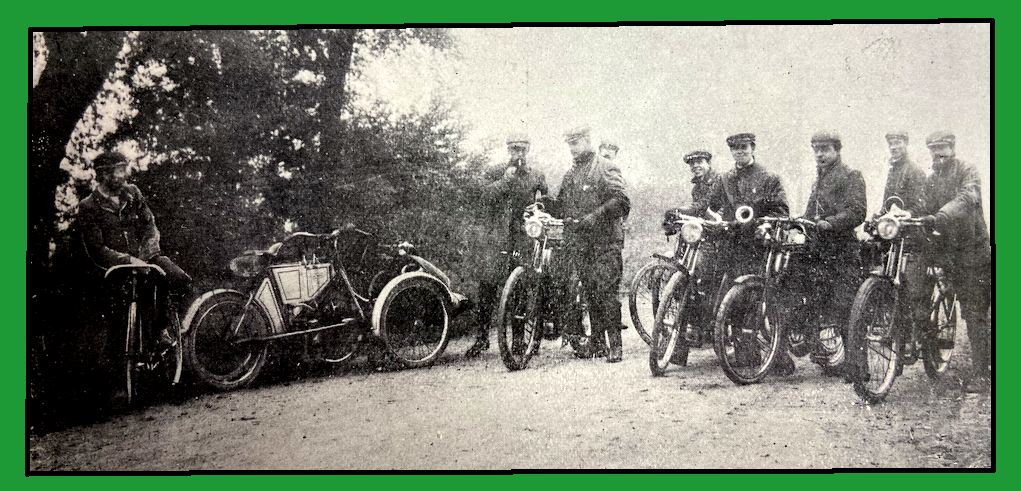
corner from the Hertford Road. Fifteen minutes later Leonard Jones (De Dion-Bouton tricycle) and Milligan (2½hp Bradbury) also arrived with several motor cyclists who had ridden the last portion of the trip with them. Each one of these three had come through without a hitch, so it yet remains with the committee to determine how the final tug-of-war is to be decided. There have now been four rounds for the SF Edge cup, and it is most satisfactory to note how consistently the machines have behaved. The conditions of a non-stop run can hardly be realised by the ordinary tourist. Imagine the belt requires adjustment—a matter of five minutes or less, an item the tourist would not think of any importance. If any of the competitors in these trials stops for so much as the tightening of a nut, the chances of the cup are lost to him for ever…These trials have been throughout a splendid testimonial to the reliability of the modern motor bicycle. There have been in all three rounds and a final—30 competitors having taken part in the three preceding contests; ten out of this number made an absolute non-stop run for over 200 miles on give and take roads, and in all conditions of weather. Eleven more actually covered the 200 miles but lost a few marks for minor stops. When it is taken into consideration by the average rider that this minor stop might mean a few seconds for tightening a belt or a few minutes for mending a puncture, which not even the best and most reliable machine can possibly avoid, it will become apparent to him what a splendid test it is both of the machine and rider.”
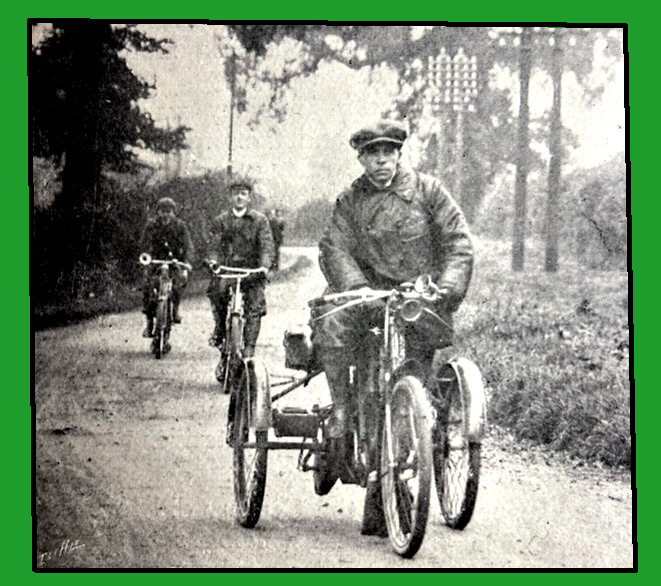
Three riders finished the fourth round without a stop so the MCC staged a final. One of the three finalists and the timekeeper overslept; a number of marshals didn’t turn up. The other two finalists made non-stop runs. Undaunted, the club staged a sixth and final trial, with the promise that in the event of another tie the winner would be decided on his bike’s general performance. The Motor Cycle’s correspondent rode with them…

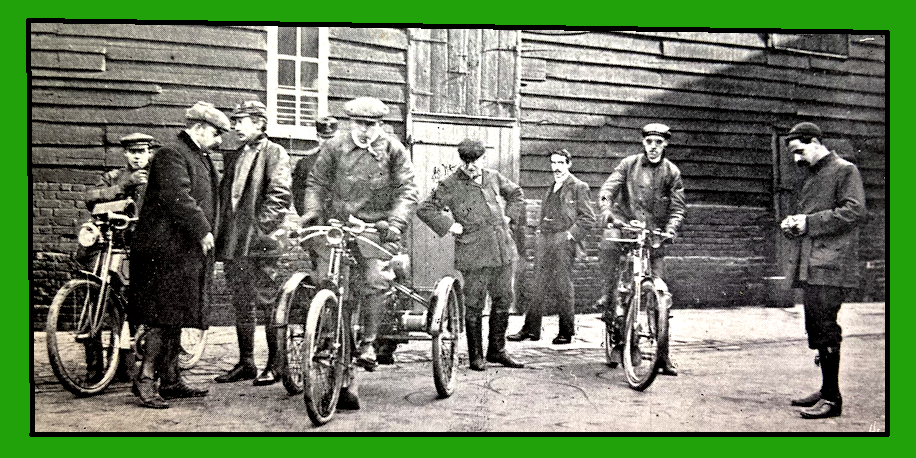
“AS WE SPED ALONG the Great North Road through the bitter cold of Friday evening, and saw the moon rising over Hatfield Park, we expected that the Motor Cycling Club would, as usual, be favoured with fine weather. The roads were in excellent condition, and as soon as London was left behind greasy patches were few and far between. On Saturday morning at six o’clock the moon was shining brightly, and the cold intense, as Messrs DK Hall and Jackson marshalled the three competitors—Cowles, Jones, and Milligan—in line together with a 10hp Gladiator car carrying the officials which Mr SF Edge had kindly lent for the occasion. At the word ‘Go!’ all three started simultaneously with lamps alight and wrapped up as if for an Arctic expedition. All got off well, Cowles’s machine spitting fire through the exhaust box at the first few explosions in a weird manner. This time the committee decided to alter the course. The first run was from the Red Lion, Hatfield, to Hockliffe, on the London to Holyhead Road, and back to Hatfield, the men being turned at the 37th milestone from town. The second run was to Hockliffe again, past the Red Lion, and on to the bottom of Potter’s Bar cutting, and then back to the hotel for lunch. Shortly after the start Cowles returned, having had to stop a short distance from the hotel, as the screw holding his main Hilton carrier came loose. By the rules governing this competition each competitor is allowed five minutes after the start fo effect any slight adjustment, after which he must be started again. Unfortunately for Cowles he came back 13 minutes after starting time, and was disqualified. However, DK Hall started him again, and he arrived at Hockliffe only two minutes after the others. At the end of the first run all three arrived without mishap. At the time when they were due at the Red Lion at the end of the second round we were requested to check the men at the cutting so hurried off and duly arrived at the turning point—the second signpost at the base of the hill. After a somewhat tedious wait they all duly arrived, the Gladiator, carrying Messrs CW Brown and Jackson, bringing up the rear. As soon as they had turned we rode back to Hatfield—a distance of about four miles—with the men.
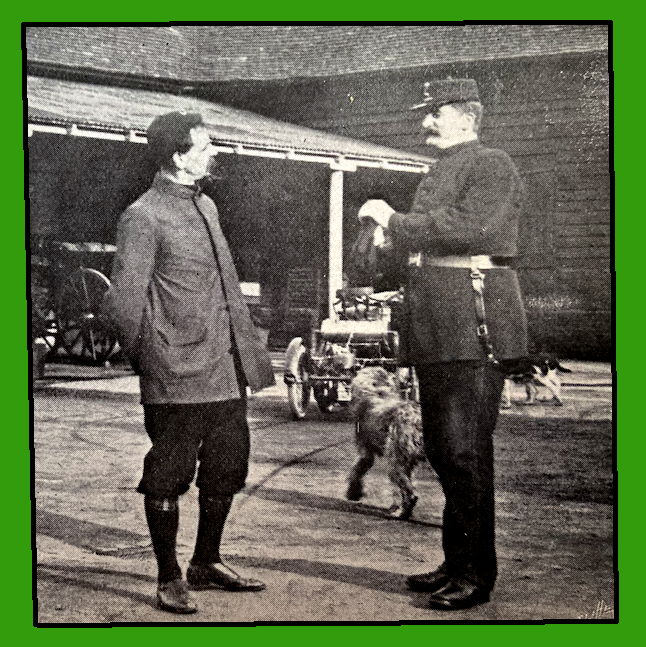
All were going in splendid style, and none up to lunchtime had had the slightest trouble. After lunch a start was made for the third run. This was to [Ivel designer] Dan Albone’s place at Biggleswade, and then again to Hatfield. The number of the competitors was now reduced to two, as Cowles had been disqualified for reasons stated. The day having turned out a glorious one, though still rather cold for motor cycling, we decided to run through with Jones and Milligan as far as Welwyn. The road, save for a short greasy patch here and there, was in fine order, but after leaving Welwyn we found new metal in large quantities spread over the whole width of the road. A bicycle could just worm its way through on one side, but the tricycle, owing to its three tracks, had to keep two wheels on the stones. After leaving Stevenage there were no more stones, but two minutes after we left that town we ran into a thick bank of fog of a most unpleasant nature which, had we not been well clad, would have wet us to the skin. This continued to Biggleswade; and as the grease was most dangerous in places we found the riding far from agreeable. After a few moments’ chat with Mr Albone we set out on the return journey, having heard first that the course for the next run would be to Hockliffe, back to Potter’s Bar cutting, and the, home. A mile or two beyond Stevenage we again, to the delight of all, emerged into clear atmosphere and bright sunshine. Once more the invincibles came through unscathed. At Hatfield there was quite a gathering of interested motor cyclists, several of whom brought quads, to greet us on our return. No interval was allowed for tea, as the men again left for Hockliffe, whence they eventually returned without experiencing any trouble whatever, though one little incident on Digswell Hill almost lost Milligan his chance of the cup. His engine almost stopped, but he found just in time that the vent hole in the tank had become unexpectedly closed. The run was continued on Monday, Milligan on the Bradbury eventually winning, Jones having punctured on a heap a stones near Hockliffe.”
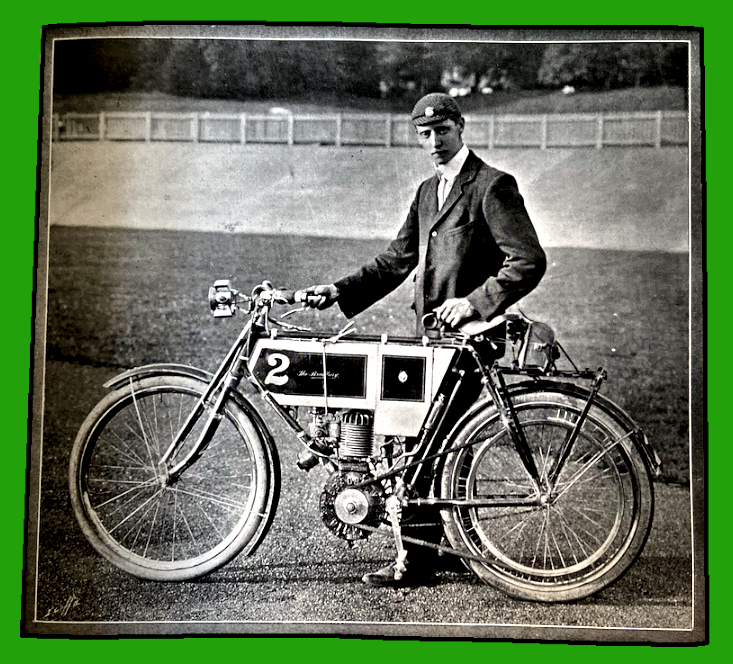
The Motor Cycle remarked: “We hope the next time the Motor Cycling Club make an attempt to finish these trials things will be better managed.” The MCC’s hon sec wasn’t going to let that one pass…
“MY ATTENTION HAS BEEN DRAWN to your report of the attempt of the Motor Cycling Club to run off the final trial for the SF Edge trophy on Saturday, October 31st. Your representative would do well in future to make certain as to the accuracy of his information before misleading your readers. My committee are agreed that an adequate number of checkers had been arranged for—nine, in fact, having promised to assist the timekeeper and marshal. Unfortunately, the checker who had agreed to turn the competitors at the first turning point—viz, Stony Stratford—did not put in an appearance at the appointed place. This was the only disappointment as for as checking was concerned. In what manner your representative considers me responsible I fail to understand, but I am willing and waiting to be enlightened on this point. I am afraid the fact of one intended competitor and an official having overslept themselves must be taken as the real cause of the abandonment, as the other two competitors and my committee are agreed that had the third competitor started the question of abandonment would never have been suggested.
Geo E Roberts, honorary secretary.
[We publish the above letter not because of any materiel inaccuracy in our report, but to give Mr Roberts, the hardworking honorary secretary, an opportunity to explain his personal connection with the matter. Unfortunately, the fact remains that the competition was postponed, and as this is the case the promoters must take the onus of failing to bring it off.—Ed.]”
“THE RILEY COMPANY are about to place on the market a new type of motor-bicycle, in which will be embodied all the superior equipment of their 2¾hp machines. The engine is a 2½hp (75x75mm) [331cc] placed in an inclined position, the Longuemare carburetter with float feed and throttle is used, Basse Michel trembler coils are fitted, both coils and accumulators, of which two sets are supplied, being carried in a neat wooden case behind the diagonal tube of the frame. The exhaust valve lifter is operated by a twisting handle and it is practically decided to control both the throttle and the cut-off from a twisting handle also.”
“A TRIAL RUN ON THE ‘IRIS’ motorcycle. This novel motorcycle. introduced into England by the Iris Motor Co, of Holland Street, Brixton, is notable because of its water cooled free engine. We recently tested one of these machines and can give an account of its behaviour on the road. The machine is rated at 2½hp and we found it easily capable of attaining a very high rate of speed. Harnessed to a trailer (a very comfortable ‘Trixo”), with the sparking well retarded, it did its work satisfactorily, pulling for miles at a regular steady speed just under the margin of the legal limit. On hills its power is surprising, the engine retaining its speed to a much greater extent than when air cooling is used. The engine can be started by hand, a pulley and strap supplied for the purpose being temporarily fixed to the end of the crank axle. A tug at the strap and the engine starts, but the bicycle remains at a standstill. With the engine running the rider mounts the machine and as soon as he is under way, gently throws in the clutch by releasing a Bowden wire handle on left handlebar. For riding through traffic the speed is regulated to a nicety by using the clutch; thus there is no necessity to run alongside the machine to start and if it becomes necessary to stop the bicycle, it can be done without stopping the engine. The ‘Iris’ motor-bicycle should become a popular mount.”
“THE LATEST PATTERN PEUGEOT’ Motor-Bicycle. This excellent machine of French construction has recently undergone many improvements in detail. The motor will develop 2½hp, and is fitted with a Longuemare carburetter. There is also an exhaust valve lifter added. The front forks are of the duplex pattern, and two rim brakes are provided. Transmission is by ‘Lincona’ belt, and lubrication by force pump. A luggage carrier is fitted which can also be used as a stand.”

“WERNER MOTORS, REGENT STREET, London, have a strictly limited supply of 3¼hp machines, identical with those that ran in the Paris-Madrid event. Preference will be given to those orders which include a fore-carriage. Th price of the machine is £60. The fore. carriage can now be supplied with the connecting arms from the fore-carriage taken to the axle of the rear wheel, or to the main fixing bolt of the engine as previously.”
“I ENCLOSE A PHOTOGRAPH of a motor-bicycle that I manufacture. It has combined belt and gear drive, neat in design and light in weight. I might mention that a long-distance road race for motor-bicycles (limit 3⅛in bore and 3⅛in stroke) from Warnambool to Melbourne (first road event) will be run off in about four weeks’ time.
Edgar Tozer, Swanstone Street, Melbourne.”
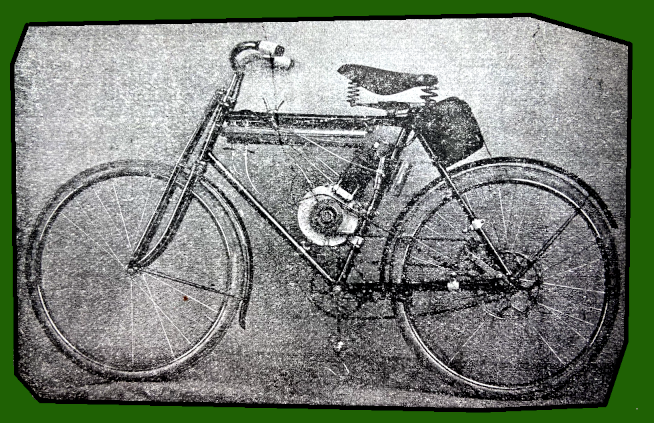
“LORD BALFOUR OF BURLEIGH introduced Motor-car Bill into the House of Lords last Tuesday. We fear that motorists—even those who have clamoured for legislation—will hardly find the provisions of this Bill wholly consoling…the Bill is sufficiently drastic to satisfy the most prejudiced anti-motorist, and, we fear, sufficiently stringent to afford a check to the motor movement in this country. Registration and number-ing come first in the clauses of the Bill as was expected. The fee for registration is to be five shillings. Then it is provided that professional drivers are to be licensed, and the usual pains and penalties are duly set forth. At present it is not proposed that amateur drivers shall be licensed, but this omission on the part of the Government has already been subjected to criticism by Lord Rosebery, and it is possible that an alteration may be made before the Bill becomes law. As to the speed limit, this is repealed ‘except as respects any special limits or special place to which the section is applied by regulations made by the Local Government Board with a view to the safety of the public on the application of the council of any county or county borough in which the special limits or places are situated’. The first clause with a view to the safety of the public on the application of the council of any county or county borough in which the special limits or places are situated.” The first clause of the section dealing with reckless driving is ambiguous and unsatisfactory. It provides that: ‘If any person drives a motorcar on a public highway recklessly or at a speed which is dangerous to the public, having regard to all the circumstances of the case, including the nature, condition and the use of the highway, and to the amount of traffic which actually is at the time, or which might be expected to be on the highway, that person shall be guilty of an offence under this Act.’ This leaves a policeman too wide a scope, for he can assert that anything ‘might be expected to be on the highway’, and the last state of the motorist in such circumstances will be worse than the first. The penalty for an offence under this Act is to be a fine not exceeding £20, or, in the discretion of the court, imprisonment for a period not exceeding three months…the scope for prejudice is greatly extended, and this is the feature of the Bill which we consider most open to objection…the anti-motoring party…condemn the absence of a speed limit, and amendments will be proposed fixing a speed limit of 20mph and providing for the licensing of amateur as well as professional drivers…It was generally thought that this Bill would not apply to motor-bicycles, but it seems to us that it does. The expression ‘Motorcar’ in the Bill has the same meaning as the expression ‘light locomotive’ in the principal Act, and the motor-bicycle comes under that definition. On the whole we regard the Bill as a blow to automobilism, and if…the licensing of drivers is extended to amateurs, the motor industry of this country, which is just beginning to recover from the effects of the hampering legislation of ten years ago, may receive a very serious set back.”
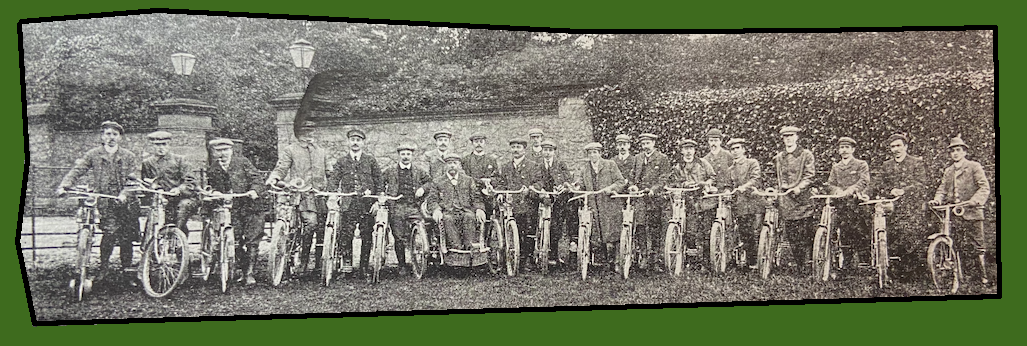
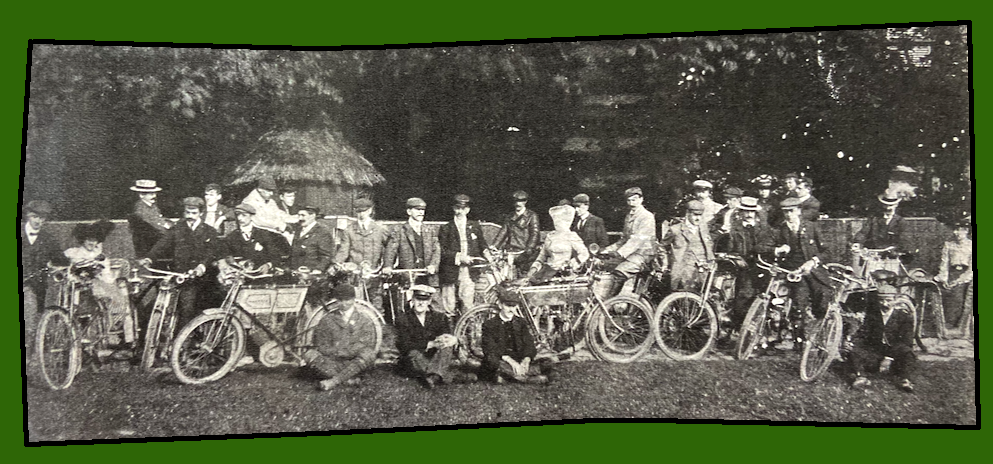
“MOTORCYCLISTS AND THE BILL. The Motor Bill as it stands includes motorcycles, as these vehicles come under the definition of ‘light locomotives’, and if the Bill passes through without being challenged and amended in this respect a monstrous injustice will have been done to users of motorcycles. As the bill stands a motorcyclist is liable to a fine of £20 for an offence under the Act, and it is surely the height of injustice to fine an offender to the extent of half the cost of his vehicle, or, at the option of the court, to imprison him for three months! We have another complaint to offer on behalf of the motorcyclist. The enactment that a traction engine with a trailer may not exceed a speed of 6mph is still left open to apply to motor bicycles drawing trailers at the will of prejudiced magistrates. This absurdity should be removed for all time, and it is astonishing that advantage was not taken of the opportunity afforded for removing the possibility of gross miscarriages of justice by the insertion of a short clause exempting motorcycles from treatment as traction engines. There is still time to remedy this great injustice.”
“OIL LEAKING THROUGH CRANK case joints. When oil persists in leaking through the joint of a crank case it almost invariably shows that the edges of the case have not been accurately faced up when fitting together. It is sometimes possible to make the joint tight with a thick brown paper packing, or a thick cement of red lead and linseed oil spread on the faces or edges of the case.”
“SPRAY CARBURETTERS SHOULD BE periodically cleaned out. The spray carburetter is not likely to give uniformly good results if it is left to take care of itself indefinitely. Grit and particles of foreign matter are enemies to efficient working. Every 500 miles the carburetter should be taken apart, taking great care to keep all the nuts and screws safe in a small box meanwhile. A considerable amount of fine sandy matter will be found at the bottom of the float chamber, and there is almost sure to be some of it in the spray tube. Some carburetters have a small screw cap under the spray, which can be taken off. A piece of fine wire should be pushed up the tube till a clear way can be seen through. The float valve might also he gently ground in; to do this a little crocus powder is the best.”
“AN INTERESTING RACING MOTOR-BICYCLE is that made by Messrs Humber and Co. This comes out at only 70lb total weight. The engine weighs 31lb, and is a standard 1¾hp size, and it will be seen that it is minus radiating flanges on the cylinder. The total weight of the chain gearing (comprising three chains and six chain wheels), frame, coil, tank, accumulator, carburetter, saddle, etc, is only 39lb. The wheels are 26 inch, with 1⅝ tyres fitted, and the frame has a double horizontal tube. This machine proves instructive, inasmuch as it shows what really can be done in the way of saving weight.”
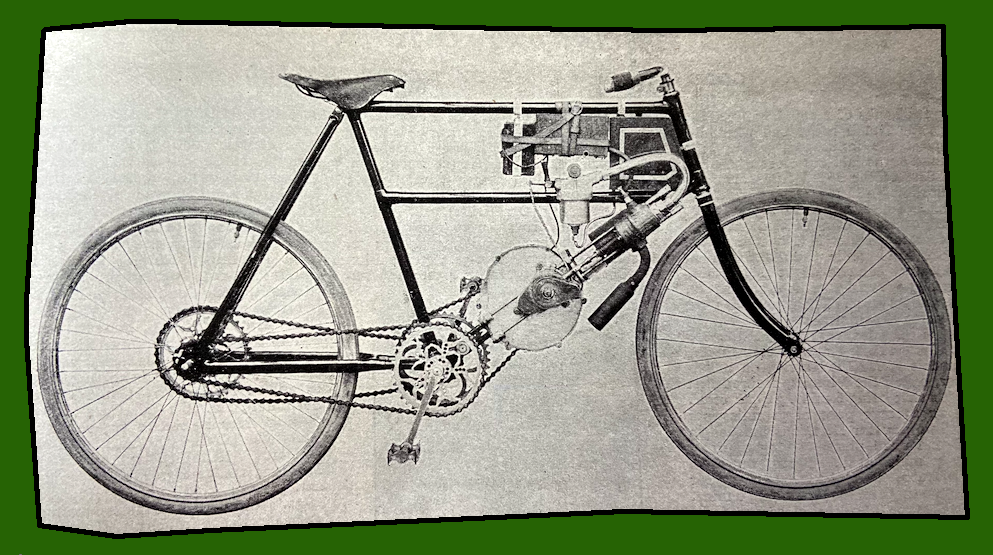
“MESSRS. HUMBER HAVE lately placed on the market a 2¾hp chain driven motor bicycle, differing in a very small degree from their higher grade machines, at £45, a price which comes well within the reach of those who require one of the best motor cycles, and who cannot afford a heavy outlay. The engine is the same as is fitted to the Coventry and Beeston machines, while the carburetter is of their own make, of the float-feed spray type. There is one accumulator, and a slightly cheaper trembler coil than is used on the higher grades. We cannot speak too highly of the reliability of these motor cycles. Recently we had the opportunity of testing one of them—a 2hp Coventry special. We were remarkably pleased at our experience, especially as we made three non-stop runs from London to Eastbourne, Hastings, and Worthing, on three separate occasions.”
“PRIVATE TRACK FOR TUITION in Motor Cycling. It will be of interest to prospective motorcyclists in London to know that there is a private track in Leytonstone where tuition in driving can be obtained. The terms are l0s 6d for five lessons, and use of motor-bicycle and petrol is included in this charge. Car driving is also taught at equally moderate terms. The address is Mr G Tufnell, 527, High Road, Leytonstone, E.”
THE MOTOR CYCLE INVITED its readers to submits drawings of their dream bikes—first prize was to be a brand new motor cycle, with a sidecar or trailer for the runner-up. “…separate detail drawings may be sent, and when necessary sectional drawings may be made. We are glad to say that many of the manufacturers are taking a great interest in this competition, for although, of course, they are unable to compete—only amateurs being eligible—they are interested for two reasons. In the first place they have no doubt that the ideas of practical amateur motor cyclists will be of value to them. Others think the competition a good thing because it will show the amateur designer how difficult it is to introduce improvements into the motor cycle. It is recognised by all that competitions of this kind tend towards the evolution of the machine, and help, in however small a measure, to bring it nearer and nearer to perfection.”
“IT WILL BE FOUND THAT a very welcome change of position from the usual pedal position can be obtained by having a pair of good quality foot rests fixed to the front forks of the motor-bicycle. These should be of good length and very securely clamped on to the forks, because if a rest slips down the fork when one is resting the feet thereon it is likely to upset the steering…see that they are fixed as close up to the crown as can be done with comfort, otherwise the steering is not so sensitive as it should be. A type of foot rest that suits some riders very well is the form which clamps on to the main down tube within a few inches of the crown, but it is not every make of motor-bicycle that allows of this, as the tanks may be in the way, or the wheel base too short to prevent the legs being cramped up.”
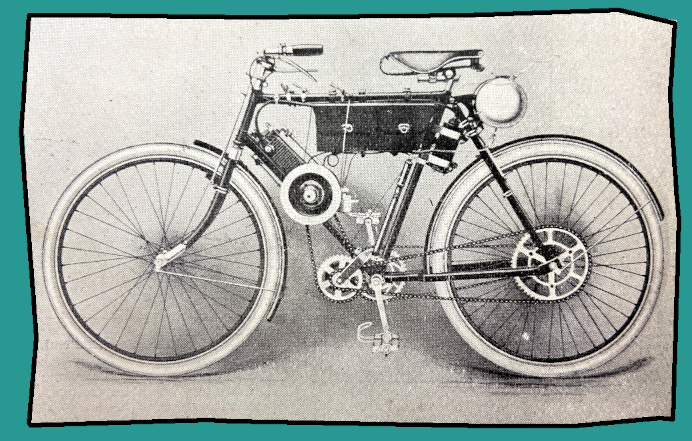
“SIR,—WITH FURTHER REFERENCE to the description of the two-stroke engine which appeared in The Motor, the engine has been carefully tested, and gives 4½hp easily at 500rpm, and runs equally well on petrol or paraffin up to 1,500 or more rpm, at high speed and using paraffin, the air scavenging tap being wide open. It is impossible to back fire into the crank chamber, and the engine runs quite silently, the only noise being the whirr of the flywheel going round. The bore of the engine is 4in by 5in stroke [1,037cc], height over all about 2ft, and weight complete with flywheel and iron crank chamber about 1cwt. The idea at first was to make it to run as a two-stroke engine at slow speeds (about 500rpm) and a four-stroke at high speed (about 2,000). I now find it is not necessary to make it as a four-stroke, as it runs at any speed you like to advance the sparking to, and there is perfect control of the air and oil admission. The engine has been built by Mr David Smith (well-known to readers of the English Mechanic), to whom I am indebted for various hints, and also for the perfect silencer. I shall be pleased to show the engine running in London to anybody interested, if they will kindly give me three or four days’ notice. The engine is patented in England, America and on the Continent.
Thos Kelly, 2, St John’s Villas, Sutton Road, Southend-on-Sea.”
“SIR,—THE POLICE HAVE taken the village of Minfield under their wing. It would therefore be well for motorists not to exceed the legal limit going down this hill, which lies between Hastings and Eastbourne.
‘Switch’.”
“SIR,—A POLICE TRAP Exists on the Bath Road here, between the milestone at the top of Castle Hill to the turn in the road. A private resident is doing all he can to aid the police. Another trap is when entering the town from London, from the toll gate over Maidenhead Bridge as far as one can see. The police are very vigilant; though, to do them credit, I know several of them dislike ‘man hunting’, and some of the borough magistrates vie with each other in their fanatical desire for anyone’s blood who happens to possess a motor. It behoves every motorist to be very careful within the confines of Maidenhead.
‘A Correspondent’, Maidenhead.”
“SIR,—IN ANSWER TO your correspondent, re ‘Sociable’ experiences, I have had a Sociable attachment, made by Graham Bros, of Enfield Town, some two months. I find it much safer and easier to steer than an ordinary tricycle, and conversation is a pleasure instead of an effort. I can take my attachment off or put it together easily in five minutes. I consider it far preferable to either fore-carriage or trailer, both of which I have had.
‘Another Reader of The Motor’.”
“SIR,—I READ WITH PLEASURE the letter in a recent issue, signed by HR Ricardo, in which be describes his ingenious and (in my opinion) practical idea for a steam driven cycle. Its only fault seems to be the rather ugly appearance of the back wheel. I beg to send a sketch of an alteration in the design which I think would remedy this. One great advantage not previously mentioned, is that whereas petrol and charged accumulators can only be obtained at certain centres, paraffin and water can be procured at almost any little village in the British Isles. This certainly makes the steam motor-bicycle an ideal machine for the tourist. Why could not a few of those interested in steam cycles get the capital required between them and get some firm of engineers to manufacture the machines as the orders are booked, and so place a much wanted machine on the market?
Victor Nightingale.”
You’ll meet Harry Ricardo again in 1915, 1917, 1921 and 1922 and there’s a summary of his astonishing career in the Gallimaufry.
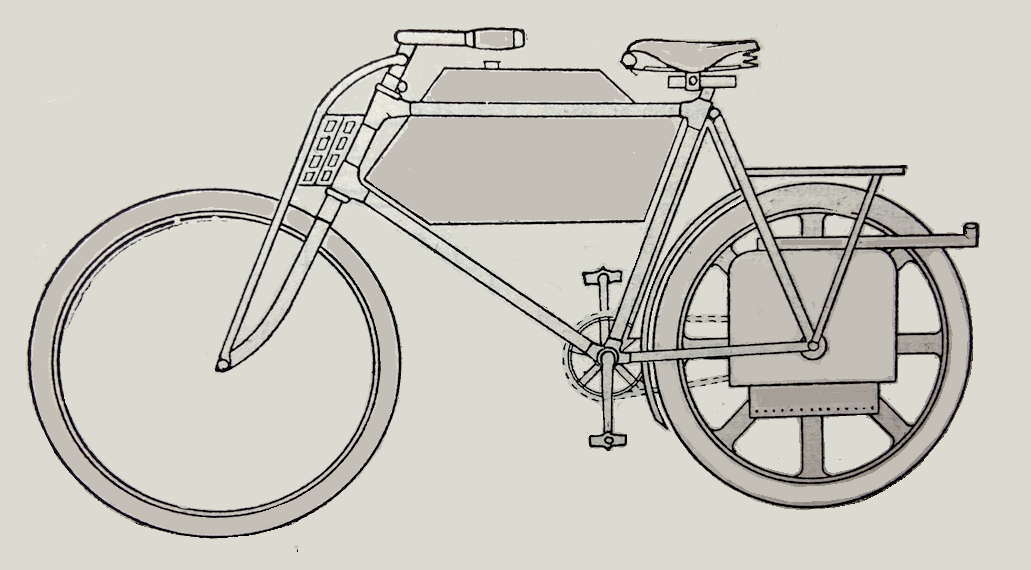
“AS IT SEEMS LIKELY that the fine and sunny weather so long due to us has at last arrived, it is probable that some of our readers may be thinking of camping out this month, or later in the summer. If so, we think they will be wise if they purchase one of the camping outfits designed by Mr TH Holding, of 7, Maddox Street, W. That weight has been cut down to the lowest point possible will be very apparent when we quote from the catalogue that a tent can be supplied weighing from 11oz. to 2¼lb, thus bringing them well within the carrying capacity of a motor cycle.”
“THE FOLLOWING IS A DESCRIPTION of a motor-bicycle frame, constructed, as far as possible, of sheet metal, in such a manner as to provide ample accommodation for petrol and oil supplies, coil, tools and equipment. We are so accustomed to see frames constructed entirely of tubes that no one seems to have thought it possible to use anything but tubes; and undoubtedly there is good reason for this, considering their strength and lightness, but a tubular frame, in the writer’s opinion, is inconvenient for fixing engine and tank to, and limits the size of the latter too much. As will be seen by a glance at the diagram, the writer’s idea is to make the middle part of the machine from sheet metal and only have the back stays and front forks made of tubing in the usual manner. Special lugs for connecting the back stays to the sheet-metal frame would have to be designed, which would be a Comparatively simple matter. The steering head would pass through the front part of the petrol tank, and the top of the tank could be curved up a little, so as to be at right angles to the centre line of the steering head. This would enable a good gas-tight joint to be made. The front part of the tank could either be square or form a semi-circle round the front of the steering head. The distance between the sides of the frame is just enough to allow the crank case, without the end covers, to fit in, the end covers being fixed on the outside of the frame by bolts passing through them and the sheet metal. The case thus grips the sheet metal frame on each side between the crank case and covers. A circle is cut out of the frame to correspond with the inside diameter of the crank case, so that flywheels or shaft can be passed through in fixing the engine in position.”
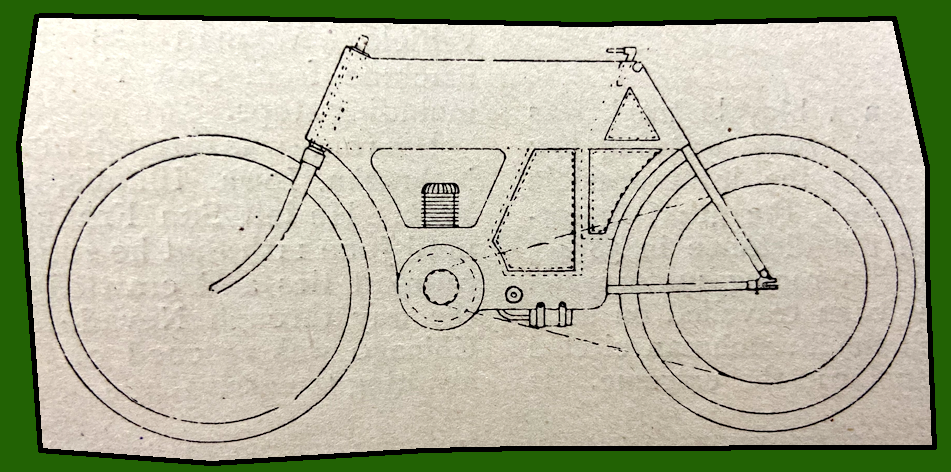

“A MILE IN LESS THAN one minute on a bicycle track was made, and a new world’s record was set when, bending low over his handle bars in order to make the least possible resistance to the wind, Albert Champion, the great motor-cyclist and pace follower, travelled the distance in 58⅘sec at Charles River Park on his racing motorcycle. This is the fastest mile that has ever been travelled on such a machine, and the manner in which the Frenchman circled around the five-lap track was spectacular in the extreme. It was a hair-raising exhibition of masterly management and of speed. He was in and out of the stretches almost instantaneously, and to the spectators looked as if he was flying through the air rather than following the smooth board surface of the circular track. The machine used by Champion was a long, 14hp four-cylindered affair, with a wheel base as long as the old tandem machines, and requiring handle bars about five feet long and bent almost semi-circular in the middle to enable him to grip them tightly. The motor is placed between the wheels, and in a position to give it an even balance. His management of the machine was perfect, and the ease with which he followed the black line at the pole of the track was a marvel to those who witnessed the feat. It took him but three laps to get warmed up to his work, and then he was off like a rocket in his endeavour to beat the mark of 1min 3sec, which he established on the same track last Tuesday night. Before people could realise how fast he was travelling, it was all over, and when the time was announced the spectators simply went wild.”
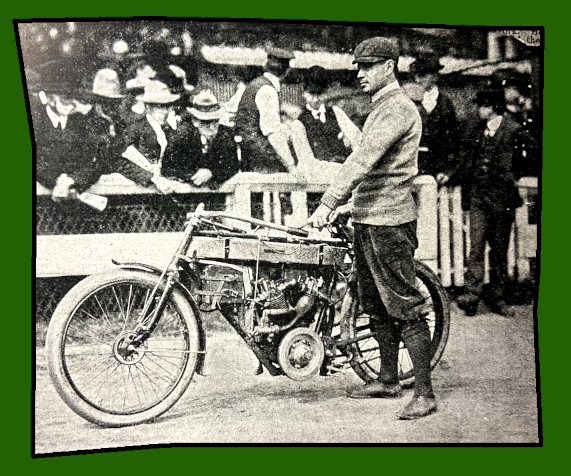
“WHEN AA HANSEN, OF Minneapolis, started after the 24 hours motorcycle record, he hardly expected to better the cycling record of 624 miles, held by A. E Walters, the Englishman. His was the first attempt on the record for twice round the clock for a mechanically-propelled bicycle, and he hardly knew the powers of the machine for such a journey. He had expected to reach the 600-mile mark, but thought the Walters’ record a little too far for him. Therefore, when the sheets showed 634 miles 75 yards at the completion of the grind, Hansen and his friends were greatly elated. In making the record he averaged 28mph, not including the stops at the end of each 100 miles to reload the gasolene tank and to eat a bit. Hansen rode his first century in 3hr 15min 57sec, which completely casts in the shade the road record of 4hr 28min. For 200 miles his time was 6hr 54min 56sec, as against the road mark of 8hr 35min, which shows how much superior the track is to the road for record riding. The 500 miles were covered in 19hr 35min 11sec. Hansen claims that if the electric lights had not been turned off at night he could have beaten 700 miles. At that time he was left in darkness and was afraid to take any chances going at such a high rate of speed and consequently had to slow down, losing many valuable miles. He rode a bicycle equipped with 2hp, and carried the colours of the Congress Cycling Club.”
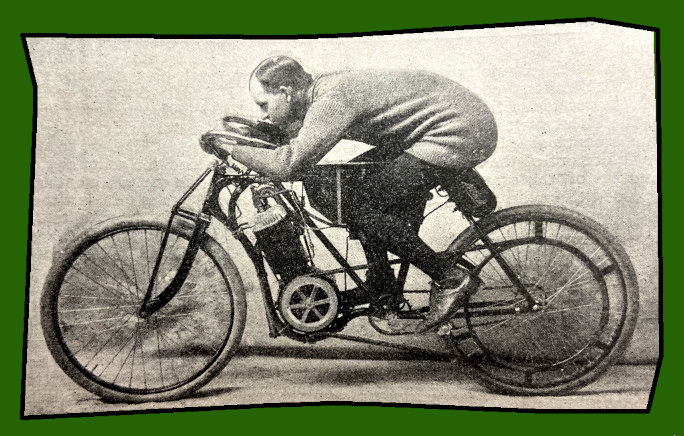
“MOTORCYCLE NUMBERING IN USA. The Massachusetts Highway Commission have experienced some difficulty in determining exactly how motor-bicycles should be labelled to comply with the new regulations. It was at last decided that every machine should carry a number on the headlight and saddle. The numbers will run from 1 to 9,999 and then a new series ‘A’ will commence from 1 to 9,999.”
“A CORRESPONDENT SENDS ALONG a cutting from a Yorkshire paper, which records the utterances of a clergyman in supporting a resolution to protest against the Motor Bill. He said that personally he had a great objection to ‘the Johnnies who endanger life and limb of the public, and who are pushed about by half a-pint of petrol, and who are seated upon an odoriferous half ton of scrap iron.'”
“A MEMBER OF PARLIAMENT has received the following extraordinary communication from the Vicar of Hurley, Berks: ‘It is my full intention to decline in future to vote for any candidate for Parliament unless he pledges himself to go in for the total abolition of all motors. There is no language of any sort half strong enough to express my detestation of these damnable engines of Satan.'”
“MOTORCYCLES RENDERED SUCH very valuable service to the Automobile Club during the Gordon-Bennett race that the War Office have quite awakened to their extreme value in war time. They are offering 10s a day with petrol to motorcyclists who will take part in the forthcoming military manoeuvres, which take place on September 5th-12th. All those motorcyclists who are willing to act as temporary officers of His Majesty should communicate, without delay, with the secretary, Auto-Cycle Club, 119, Piccadilly, W. It is not necessary to be permanently enrolled in this smart Volunteer corps in order to take part in these manoeuvres, but it is hoped that it will lead to a very large permanent increase in this useful body. The War Office are applying for any number of men.”
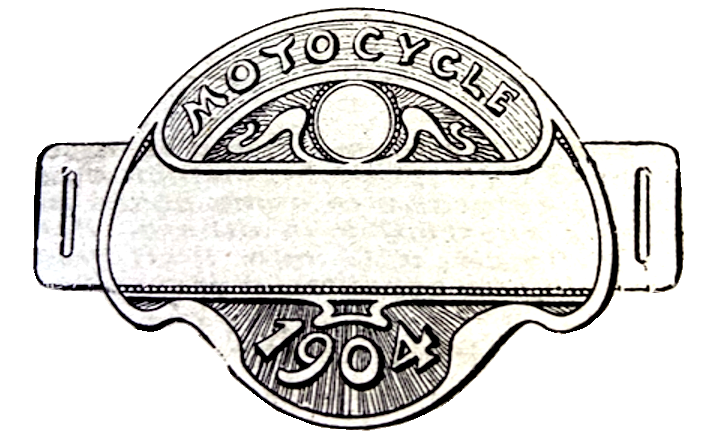
“NOW THAT SO MANY motorists will be touring in France and running on to Paris, it is well worth remembering that there is a splendid collection of motor relics, from Cugnot’s old road-carriage down to De Dion’s experimental machines, to be been at the Musée des Arts et Métiers, which is convenient to the centre of the city, and open all day. “
“T TESSIER, ON HIS 2¾HP BAT, travelled well at Canning Town on Bank Holiday; in fact, he eclipsed himself, paradoxical as that may appear to be, in the five miles handicap. During his heat in the race he beat the world’s record for the flying mile, his time for the journey being a min. 4⅘sec. This was ⅕sec better than the previous record. Later on, in the final, which he won somewhat easily from JF Crandall, he went one better, by riding the flying mile in 1min 4⅖sec, which was ⅖sec better than his effort earlier in the afternoon. His full time for the five miles was 5min 44⅖sec. A three-mile motorcycle race between H Martin and J Crundall resulted in a win for the latter by a quarter of a lap, in 3min 25⅕sec. Subsequently the pair contested a mile match, and this was won by Martin, only by the very narrow margin of half a length, in 1min 9⅘sec. Both events were contested from a flying start. The motor races were watched with the keenest interest by some 7,000 with the weather being of a glorious summer character. ”
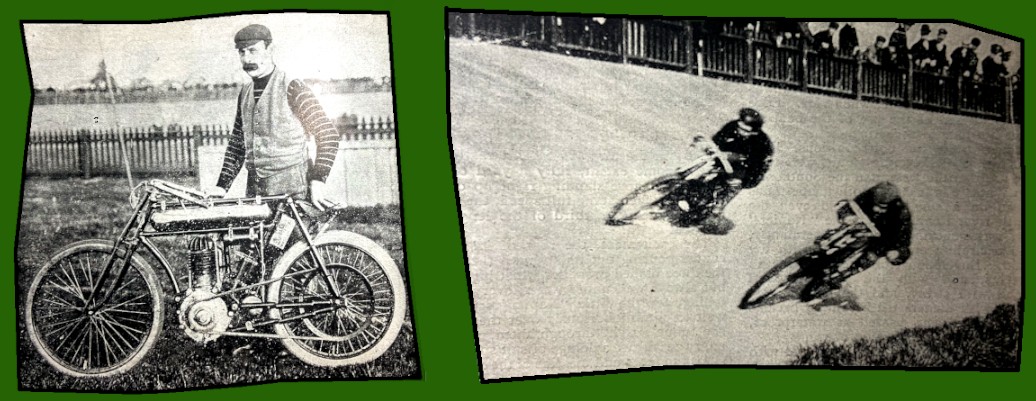
“FOUND: A V-BELT. We have a letter to hand from Mr A Overton Jones, Struan, Fassett Road, Kingston-on-Thames, in which he states that he found a V-belt off a motor-bicycle on the road just outside his house on Thursday, July 16th. He will be pleased to return same to the rightful owner if he will communicate with him.”
“IT NEVER PAYS TO venture out for a long ride on a motor-bicycle without seeing that the toolbag is well stocked: (1) a spanner of the adjustable type, and it should be tested to see that this will take any nut on the machine; (2) a pair of flat-jawed pliers, with cutters for wire; (3) a couple of screwdrivers, one having a wide blade, say, ⅜ in., and the other a narrow one, ³⁄₁₆in; the handles can be quite short, but preferably broad, so as to get a good grip. With these two screwdrivers it should be possible to reach every screw about the machine. (4) A small but good quality file, round on one face and flat on the other; this should be of a medium cut and about 4½in long. (5) A piercer, or belt awl—better, in the writer’s opinion, than a punch. This should be made of a good piece of steel rod, well sharpened and tempered, and firmly secured in a short handle. A penknife is also indispensable, but it is to be supposed a rider will always carry one.”
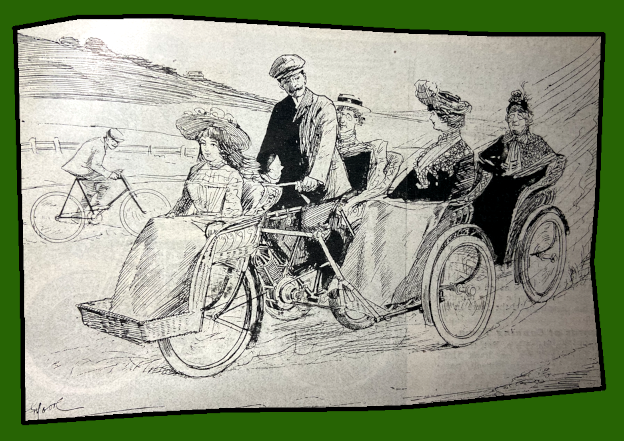
“SIR,—I OWN A HEAVY 2¾hp machine, weighing, I suppose, 150lb. I find it a most perfect mount for traffic work, and always use it for short runs into Cardiff and about the town, in preference to an ordinary pedal-propelled machine. To show its handiness, I had occasion recently to come through Merthyr on a Saturday night. The main street is very narrow, there is an electric tram line down the middle, and it was packed with people from pavement to pavement. Imagine trying to ride down the pavement of Oxford Street or Piccadilly and you have it. There were a lot of bicyclists about, and every one of them dismounted and walked. I, with my heavy machine, rode the whole way without pedalling a yard, just switching on the engine for a few seconds whenever I saw a chance, and went the whole way without touching or frightening a soul. This, I think, speaks pretty well for the handiness of a hefty machine. On the open road one can go gaily ahead, and never fear the many and steep hills hereabout. The weight is certainly a nuisance t carry up steps, but then one keeps a motor-bicycle to ride, not to keep on the mantelpiece as an ornament.
CRWA.”
“SIR,—AS I THINK many of your lady readers who would like to become ‘motorists’ may be interested in my experience, I am sending you a photograph of our tricycle, to which we have lately had a motor attachment fixed. We got the idea from a letter which appeared in your paper from Mr Tatchell, of Bristol, who had a motor attached to his tandem bicycle with very satisfactory results by Messrs Morrish and Co, of Redcliff Hill, Bristol. We at once consulted Mr Morrish, who advised a 2½hp Minerva motor, fitted with Lincona belt, and a surface carburetter of his own make, a new front wheel with Palmer motor tyres, new forks, and the frame strengthened. I learnt to drive it in one lesson. My husband being totally blind, the entire control and management rests with me. We have now ridden between 600 and 700 miles, and have found it a complete success; the steering is very much easier than before. Everyone who has seen our machine has endorsed our opinion that it has been very cleverly thought out, both for safety and simplicity. It is a most delightful way of getting about. We have had the machine geared low, as we do not go in for fast riding, safety being the first consideration.
(Mrs) MA Tuckett, 4, Prior Park Buildings, Bath.”
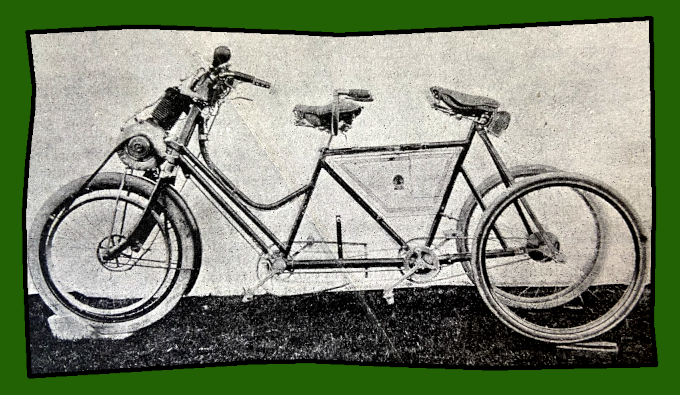

“IT IS NOT MY INTENTION to keep the mind of the reader fixed on any particular make of motor-bicycle, but rather to let the results be deduced from a general survey and criticism of the many excellent motorcycles at present on the market, and to suggest various improvements on such as have been found to be valuable from past experience. With regard to the cycle…that the wearing parts should be of ample strength, the tubes of heavier gauge, the spokes and rims of stouter material, goes without saying. More comfortable saddles, with spring seat pillars, would be a decided advantage, and combined with spring handlebars would tend, in a. great degree, to make the motor-bicycle a two-wheeled car in reality. Luggage carriers are essential in every tourist’s outfit, and if the machine be heavy, an excellent device whereby the carrier can be converted into a stand is now on the market…A good horn will scatter those pedestrians who delight in taking up the whole road better than two or three bells. I have tried one of these latter in the form of a 2¾in sheep gong electric bell, rung from the motorcycle accumulator. It made a tremendous racket, being actuated by a push button let into the handlebar end, but the awkwardness and cumbrousness of the arrangement, as compared with a neat effective horn turned the scale in favour of the latter. Regarding lamps, the makers have catered well for the motorcyclist. Acetylene lamps in spite of their little peculiarities and defects, have the undeniable advantage of illuminating the road. Paraffin lamps do not appear to have received sufficient of the makers’ attention…Lamp brackets are now having the attention paid to them they deserve, so that the flimsy sheet metal brackets which do duty for the lady cyclist’s baby lamp are, so far as they concern motor-cycles, being relegated to the scrap heap. To go, however, to the other extreme and have a ¼in-thick heavy malleable iron casting bolted to the tube is not wise, and the result is not ‘goodly to look upon’…A guard for the belt is absolutely necessary, but as yet I do not know of a single machine with this fitting. A motor-cyclist wishes to look respectable when on the machine, but how can this be done when the belt greases his trouser leg, and an old pair of pants has to be donned, or a pair of overalls or long leggings? An additional guard, at the side of the wheel, to prevent the mud from splashing up on to the belt, is also a desideratum. A two-speed gear for starting and assisting the motor would be a good thing, but the price would be prohibitive, perhaps. Anyhow, there could be a speed cone on the driving drum, and one on the motor pulley, so that were a hilly district being traversed the belt could be changed from one pulley to the other as in the case of machine tools…The motors used at the present time are of two distinct types; two-cycle and four-cycle. To do without valves and gears is, no doubt, an excellent thing and is worth a few other considerations in exchange, but the drawback of a poorer mixture and the one or two other really big drawbacks which seem to follow, from all accounts, in the wake of the two-cycle motors (although I have bad no practical experience with such), have compelled makers to adopt four-cycle engines almost universally…An exhaust valve may require grinding occasionally, or the inlet valve may stick and the burnt oil refuse to be removed with petrol applications. These should be easy to take out and replace without disturbing the cylinder head with its customary pipes and connections. To have to remove the sparking plug in order to inject paraffin to commence with is a nuisance. A removable plug is of great assistance, both for slightly lubricating the piston rings which have stuck with the thick oil and for observing the spark. A valve or little cup for injecting petrol into the inlet pipe facilitates starting. The fewer nuts there are inside the cylinder and crank case the better, and the more gear there is accessible the more convenient it is…The use of a spring clutch in chain-driven machines has been the only factor which has tended to make this type at all feasible; but the not infrequent snapping of chains in hilly districts seems to show that some makers have a little to learn yet in the design of this appurtenance, although it is approaching perfection every day. A free engine, whether belt or chain driven, is extremely useful, but a clutch capable of giving free engine at will is a step in the right direction, and for machines of over 2¾hp a separate starting device would be very convenient and beneficial to the motorist. Twin cylinder engines for higher powers than 2¾hp are coming to the front; and to those who desire economy, vibration minimised, and power, these in the writer’s opinion, are the coming things. When the machine exceeds 2¾hp the work required to start such a motor must be very considerable, especially with a fore-carriage, or up hill, or, perchance, with a trailer. Now with a two-cylindered engine one cylinder can be shut off on the level, and then when the hill is approached the other side is in fine form to take the incline. Without water cooling, above 3hp is too much for one cylinder to dissipate the heat generated unless air fan cooling is resorted to, at least that is my experience. Whether the flywheels shall be inside or outside is a moot point…my contention is that inside flywheels are hidden mysteries draggling in oil; I prefer to be able to see if the flywheel is firmly fixed to the shaft, and to be able both to test the compression and also to prevent the belt from jumping the pulley…Handlebar control is a splendid thing, and if a few brains were set to work on this important point the motorcycling community will be benefited thereby. Riding in traffic, especially in damp, greasy weather or dry water-cart fiendish is tricky; two firm hands are wanted on the handlebar, and the control should be from this point of vantage. When the exhaust valve is lifted, however, the spark should be broken as well and simultaneously with the same lever, so that one hand in emergency can control the machine. For adjusting the gas and air, of course, we can alter the respective taps when out of the madding crowd. For flooding carburetters which are provided with cork or metal floats, sticking a pin (when you have one) into a small hole is very unmechanical, and all carburetters so constructed ought to be provided with a depressor which will spring back…An additional air or petrol inlet on the gas supply pipe effects a saving of petrol sometimes, as it prevents overflooding of the carburetter; for, instead of pushing down the float, you inject a little petrol from the can, and the gas generated thus starts the carburetter into action…A good tank, one that will not leak, and that will keep its petrol intact, without evaporation, is a great boon; but if we had a good gauge or indicator a correct estimate could be obtained from the contents as to how many miles so many pints should carry one…a new petrol gauge with a protected glass sight is the desired object. Petrol and waste oil drain cocks are generally conspicuous by their absence on the motor and tank, a square or hexagonal headed set screw usually being employed, so that if the motorcyclist wishes to empty the dirty oil out crank chamber he gets a hot, filthy concoction, which was once oil, on to his hands, making him like a sweep or stoker…This is the development of detail which appeals to the novice. A good inlet should be fitted to the tank for filling purposes, and separate funnels for oil and petrol should be provided. A useful accessory is the petrol or paraffin squirt for clearing out grit; this is unequalled, especially for hubs, free wheels and the like, and for injecting petrol or paraffin into the cylinder it will be found an exceptionally convenient article. The levers used on many makes of motor-bicycles are far too short. To get a fine adjustment when going over rough roads is well nigh impossible. These should all be constructed on a ratchet principle, so that to shake over is an impossibility…Automatic lubrication has been talked about a grey deal, but hitherto not much practical good has resulted…I purchased an automatic pump a few days back, thinking that I should be able to dispense with the two-way tap and its disadvantages; but the principle was wrong, and it wanted a single-way tap, in addition to various locking devices, so I discarded it and got a two-way tap pump with sight feed. These pumps are, in my opinion, made too heavy; one weighed over 1lb. Economisation of weight in the equipment of the gear necessary for every motorcycle is of great importance. The pump should be placed where it can be seen. I have no patience with the out-of-sight lubricator. Either the hand is smeared with oil, or oil does not go into the case; such mishaps are bound to occur if the motor is attended to with your eyes shut. Better to be tempted to oil up too frequently than too seldom; the former can be cured, the latter cannot until too late. Passing on to the electrical details—here, indeed, is considerable scope for the ingenuity of the manufacturer and the designer. The electrical equipment of the motor-bicycle is the key to the machine. If the motor be of ever so excellent quality and material, and the batteries, coil, etc, be of poor quality, the bicycle becomes a wreck and a nuisance to its owner. Be sure of getting a certain spark, and the rest will go on all right. A fly or a speck of dirt may upset the working of the motor and carburetter, but a slight amount of vibration will upset the electrical gear altogether if not of good, sound, solid and substantial design. The best battery I ever came across was of Continental make. I have had no trouble with it, and many miles have been travelled by its assistance. The military manoeuvres at Aldershot during Whit week were successfully gone through by a friend who borrowed it for his 2¼ De Dion motor bicycle. It is not my intention to complain about the British made article, but accumulator manufacturers here do not appear to have fully realised the enormous amount of vibration which a motor-bicycle has to stand when going over rough roads at a high speed. Instances of short-circuiting and the damaging effects it causes are becoming very rare, but in an accumulator designed for solid filling, liquid acid should not be used. The solid filling is improving in quality daily, and may eventually supersede the liquid acid, which is so destructive to clothes and other impedimenta. A non-corroding metal for the terminals must be more extensively used to win that satisfaction from the motorist necessary to provide trade…The coil is, I venture to say, required to be the most reliable of all the details necessary to perfect a motor-bicycle. But only a few English firms make coils. As parting advice to beginners, I say, do not be led into the belief that the larger the coil the more perfect is it; this is not so. The coil I use is very small, but very efficient. The contact breaker is at times ‘tricky’ in its behaviour, and the verdict goes to a wipe contact and trembler coil as being the most satisfactory. There are contact breakers, however, which do away with the trembler coil and yet give uniform results, and as my experience has been with these latter varieties I can say that they are as near perfection as anything can be…The switch handle has come in for its share of blame on the score of unreliability, stranded wires causing circuits instead of a complete break. A good switch is on the market to clip to the handlebar, but if we could have one in the form of a small trembler to fit inside the handlebar, it seems to me that a neater arrangement could be made, as it would (or could) have the advantage of being waterproof. The method of breaking the spark by depressing the brake lever has found favour with some good makers, but a sort of spring buffer requires fitting, for the reason that when going sharply over a rough piece of road the lever is apt to jump out of its place and so cause misfiring occasionally. Returning once again to the motor itself, the question of silence deserves attention, and if this was more looked after an increased sale would be the result. If every motor manufacturer sold a motor which would run (so for as the explosions went) silently, he would not only be comforted by the reflection that the silky running of the roadster bad been brought back to civilisation, but the demand for his goods would be so great that the supply would fall short. It is not the speed which the man in the street so much objects to, as the earsplitting noise and terrifying tootle of the horn. Although I have written at some length, I have not yet exhausted all the numerous accessories, such as cyclometers, sparking plugs, belt fasteners, mudguards and tyres, all of which are receiving attention in their respective quarters. The last item is not so perfect as might be wished for.”
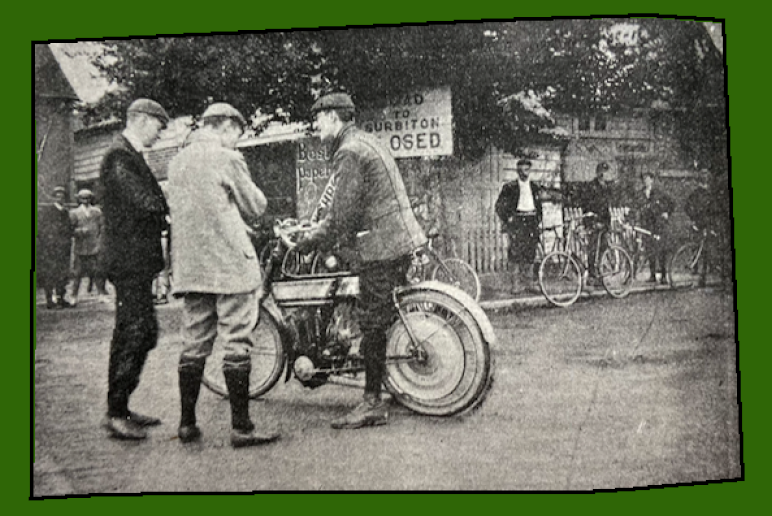
“THE FOLLOWING IS THE itinerary of the end to end tour which has been arranged by the Motorcycle Section of the CTC: Mon, 28 Sept, Land’s End to Exeter, 120½ miles; Tues, 29 Sept, to Worcester, 136¼; Wed, 30 Sept, to Preston, 125; Thurs, 1 Oct, to Hawick, 130½; Fri, 2 Oct, to Perth (via Edininboro), 116; Sat, 3 Oct, to Inverness, 115¾; Sun, 4 Oct, rest; Mon, 5 Oct, to John o’ Groats, 136¼. Although the tour proper will commence at Land’s End and finish at John o’ Groats, an informal party will be made up to do the double journey thus: Thurs 24 Sept, London to Yeovil, 122½; Fri, 25 Sept, to Okehampton (via Exeter), 69¼; Sat, 26 Sept, to Land’s End, 100¼; Wed, 7 Oct, John o’ Groats to Inverness, 136¼; Thurs, 8 Oct, to Perth, 115¾; Fri, 9 Oct, to Glasgow, 50; Mon 12 Oct- Wed 14 Oct, Glasgow to London, about 410. Motorcyclists who wish to join in the tour should send in their names at once, either to the secretary of the CTC, or the chairman of the Motorcycle Section, A Chandler, 1, Lime Grove, Shepherd’s Bush, W.”
“SIR,—I SEND YOU photo prints of an Australian built motorcycle which will, no doubt, prove of interest to many English manufacturing firms, and also to many of your readers, on account of its departure from the ordinary lines of the standard motor frame. The machine has just been turned out by the Carbine Cycle and Motor Co, of Melbourne, being built to the specification of a Melbourne motorist, Mr HB James. The machine has been built up with a view of absorbing vibration on the rough Australian roads, many of which are only fit for drays, etc. Another idea aimed at by the designer is the overcoming of wind resistance and consequent gain in power, and at the same time the production of a machine which should be safe on muddy roads by reason of its low centre of gravity. Following are some particulars: The most striking feature is the frame, which is built fairly high in the front, and then sweeps down until the saddle pillar lug is only about 15 inches above the bottom chain stays, whilst the top of the saddle (Brooks B90 is only some 33in froth the ground. The frame provides a long wheel base, being 52in from centre to centre of wheels, and the full measurement over all is 80in. The motor is a 2¾hp MMC set vertically well forward in the frame; it is fed through a Longuemare carburetter. The transmission is by 1½in flat belt, 8½ft long, built up of two thin pieces of English tanned leather, sewn near each edge with copper stitching. The wheels are 26in, fitted with Dunlop tyres, the back tyre being extra large (3in on 2½in Dunlop-Welch rim), with a view of absorbing vibration. The photo of the rear part of machine gives a fair idea of the size of tyre and belt. Provision for petrol, cells, lubricating oil, coils, tools, and repair outfit is provided for in one large copper tank, so that everything is kept dry and clean, and out of the way. The ‘tout ensemble’ is compact and very racy looking, the rakish lines of the frame and front forks giving the machine a graceful appearance. Trial runs over some 400 miles have proved the machine a comfortable riding one, easy of control, with a speed range of from 4-30mph. The gear is 4 to 1, the engine driving pulley being leather lined, and even with this high gear it is a good hill climber. The machine weighs empty (ie, without oil and cells) about 170lb, and 200lb with cells. These latter are four ‘Obach’ dry cells, which weigh 13lb, and a supply of petrol sufficient to carry the motor from 130 to 150 miles. The back wheel weighs 19lb. complete with tyres, etc, whilst the copper tank weighs 17lb. The machine is enamelled black, lightened up with red rims and red lines on the tank; the complete machine gives an idea of great strength, which is the feature mainly wanted on our roads.
‘An Australian Subscriber’.”
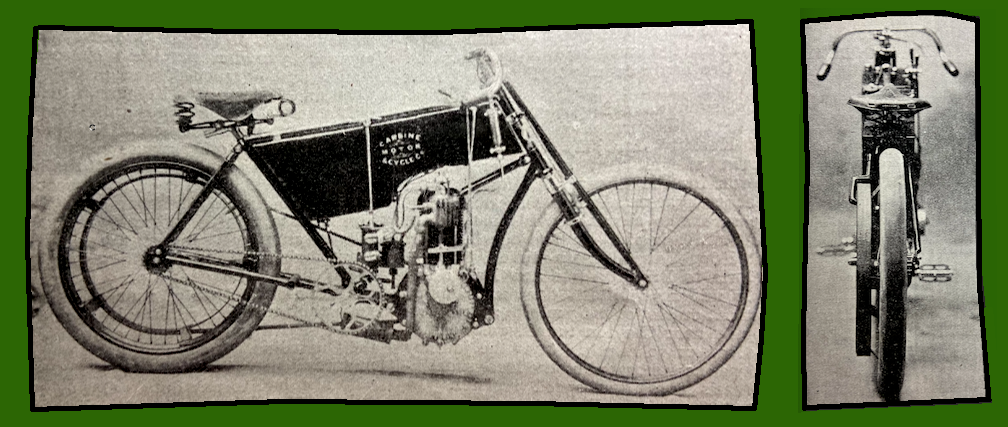

“MY FIRST RIDE I SHALL never forget. I knew nothing about motors, and had not ridden 50 miles up to that time on a motor cycle, and I started away from Menzies with a 350 miles trip in front of me. I was advised by my head office to carry a good kit of odds and ends and plenty of naphtha; so I started. I had a spare tank over the back wheel holding 2½ gallons of naphtha, besides what was in the machine tank and carburetter, spare valves, springs, cotters, tremblers, and screws, and spare accumulator. I might add here that the machine was a front-driven Werner. The first 10 miles on my trip I walked and pedalled alternately. The confounded thing would not go; but all of a sudden, just as I had made up my mind to turn back, the engine started, and I did not give it a chance to stop till about 50 miles out, when I was running down a hill, full gas on, lever as for advanced as I could get it, and in the best of spirits, when I struck a nasty little gutter running across the track, about a foot or more wide and the same in depth, with the consequence that I was nearly thrown off my machine. I stopped to view the damage, and found that I had knocked eight spokes out of the driving wheel. Well, I fixed it temporarily, and with 40 miles between me and the nearest repair shop I proceeded along, driving very carefully. The next check I received was a lake. These lakes are more often dry than otherwise, but this time there was nearly a foot of water, to say nothing of the mud. Well, off came boots and socks, and I commenced to push the machine across it, with the result that I got fairly bogged in the centre, about 40 yards from the shore, and it took me just over two solid hours to get that machine out. I journeyed back about five miles to a wayside inn and stopped for the night. Next morning, after going a mile, the driving rim fell off, the arms were broken, and I then had to pedal into Rookynie (20 miles) with all my load up, and from there caught the train back to Menzies. We have no roads on the goldfield—they are just cleared tracks—but owing to the great number of camels engaged in the carrying trade they are kept in good order. A string of about 30 camels loaded up will make a good solid path over the heaviest sand; at the same time these paths are usually too winding to allow of anything faster than about 20mph. We use naphtha—here branded ‘stove naphtha’—but never yet have I been bothered with stale spirit as you seem to be at home. For instance, I have left the machine standing for a week, and then the spirit has exploded first revolution; have repeatedly ridden120 miles on one gallon with the 1½hp front-driven Werner. I have no use for a sparking gap; never yet have I had reason to complain of dirty plugs, except after, say, a 200 or 300 miles trip; never found the need of a starting lubricant for the engine either. Naphtha can be bought all over the fields except in the remote places. Just lately I fixed a 1½hp front Werner engine on a lady and gentleman’s Raleigh tandem, made a copy of the Werner carburetter, and it is a decided success. The wife and myself have some good rides occasionally. The machine will do about 20mph. I am now riding a 2hp rear-driven Werner. It is very fast; in fact, too fast for our paths, but when the road will allow it the pace is everything that can be desired. Both The Autocar and The Motor Cycle are very newsy, and the hints I have found very useful; and not only that, they often cause me to smile, especially when someone wants to know why some thing won’t do its work. I remember my first ride! Since writing you last I have added 480 miles to my total. I wish I had kept an exact tally of my mileage; it would have been more interesting.”
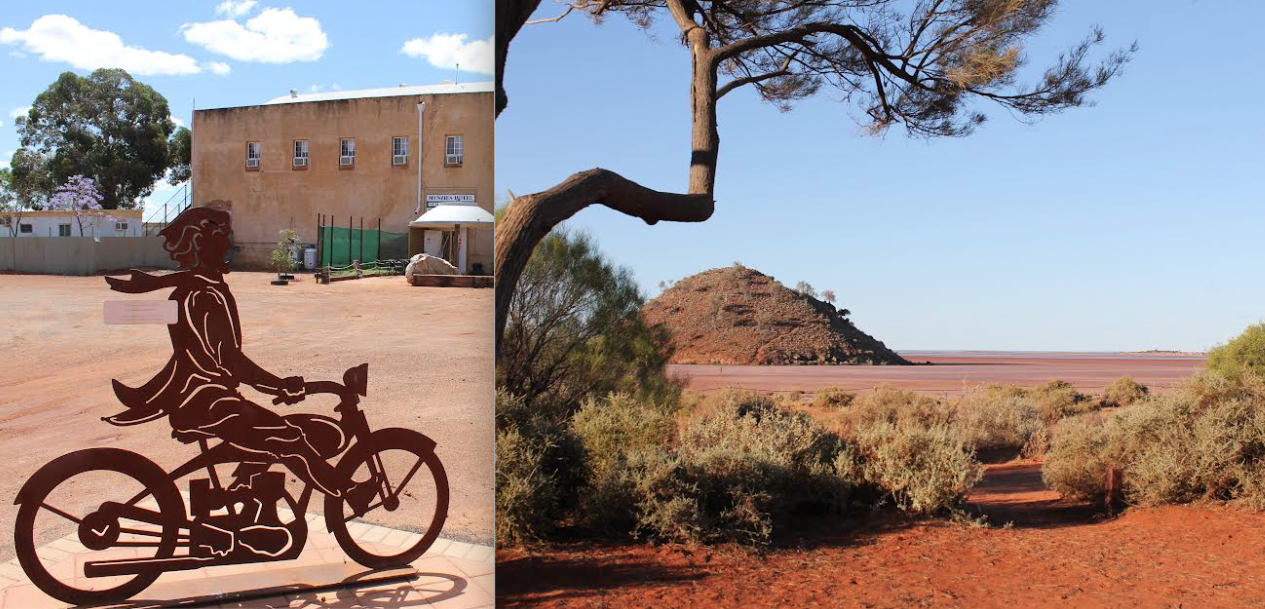
AUSSIE ENTHUSIAST (AND DUNLOP tyre salesman) Harry James invited every motor vehicle owner in Victoria (30 car owners and 60 motor cyclists) to lunch where they formed the Automobile Club of Victoria. He went on to organise some gruelling long-distance trials, including the 1,148-mile ‘Military-Dispatch’ relay race from Adelaide to Sydney.
“THE CLARENDON MOTOR COMPANY, Earlsdon, Coventry, have now added a 3hp motor-bicycle to their list. The frame has been specially designed and strengthened in various ways. The motor is a 3hp actual, with mechanical inlet valve. A special feature of the Clarendon machine is the firm’s patent outside ball bearing for the belt pulley, which considerably reduces the strain on the bearing when starting. It also minimises vibration, thus adding to the comfort of the rider. A Longuemare carburetter is fitted, and the machine has a petrol capacity for a run of 120 miles.”
“MANY ATTEMPTS HAVE BEEN made to solve the vibration problem on a motor-bicycle. The need for isolation from the severe road shocks is pretty generally admitted. The main difficulties in designing a spring suspension fork were the working joints becoming ‘shackley’, or if springs were used to avoid working joints, then it was impossible to keep the wheel stable in a vertical plane, that is to say, it rolled over sideways. The Garrard Company claim have overcome both objections. The motion is like that of a parallel ruler, so that the wheel can only move in relation to the machine in a vertical plane; it cannot possibly roll over sideways in the least degree. The chief feature in the construction is the joints. It is well known that Mr Garrard is a past master in the choice and treatment of steel; the joints are ‘Garrardized’ by the ‘B process’, that is, the metal is treated in such a manner that it is harder than the silicon (of which road dust is chiefly composed), but this is not all; it has the remarkable property that it cannot seize or drag. This admits of making the joints coned at an angle of 29°, and a spring washer of the Thackery type pushes the cones together all the time; a pair of lock nuts are locked up hard, and the joints, the makers claim, will not require attention beyond a little oil for years. It may be objected that such a joint produces friction; the makers admit this and mention the fact that so do the leaves of all laminated springs. It is even advantageous to have some friction in these joints, as after a big bump the springs come to rest sooner. With Garrard’s suspended fork, a small light high-speed engine and their two-speed gear, the makers claim that the motorcyclist is provided with the most comfortable machine.”
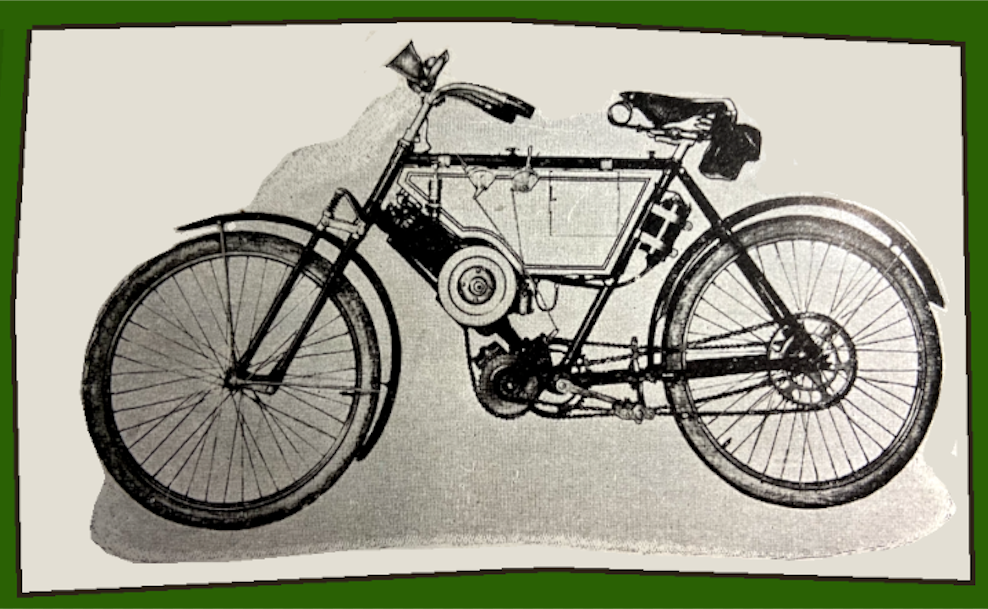
“SIR,—WITH REGARD TO VIBRATION on motor-bicycles, I noticed in your issue of the 9th ult a description of a new spring fork brought out by The Garrard Manufacturing Company. This is a most excellent invention, but I think it is only fair that I should mention that for the last two years I have been riding with every satisfaction a motor-bicycle fitted with a very similar arrangement patented by Mr JL Thomas, of High Barnet. If your readers could realise what an immense advantage such a spring fork is on rough or bumpy roads I feel confident that it would not be long before every first-class machine was fitted with a similar device. Mr Thomas’s arrangement consists of the most simple mechanism. I have ridden my machine for over 3,000 miles on roads of every description, including Yorkshire moors, never once having oiled or touched the joint which does not show the least sign of wear or side-play. For some time past I have been intending to send you a description of the most excellent contrivance, having personally derived so much advantage from experiences of the readers of your most valuable journal, which I have taken great pleasure in reading from the famous No 1.
James B Peart.”

“SIR, I NOTICED IN The Motor some correspondence with regard to spring forks for motorcycles. I enclose a photo of a spring fork which I have invented and patented, and which I think might perhaps interest your readers. There is a supplementary pair of forks, which slide in guides attached to the fork crown and ball race respectively, the movement being controlled by a spring. As will be seen, the wheel is pivotted to the forks in a similar manner to Mr Thomas’s arrangement, as mentioned in Mr Peart’s letter, but I think my arrangement is neater and more compact.
H Drew.”
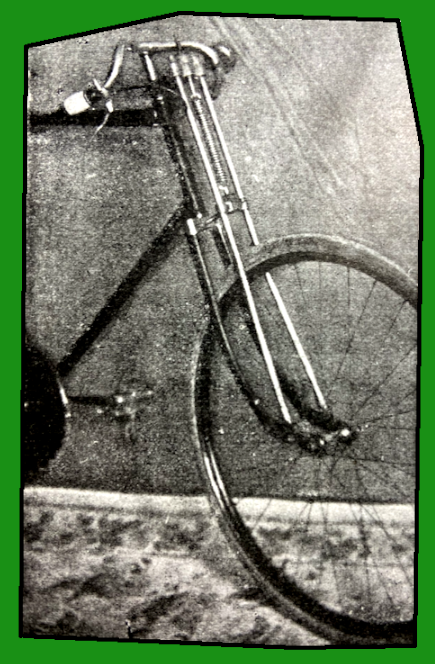
“SIR,—IN THE SEPTEMBER 23rd issue of The Motor an article on the subject of vibration and its remedies by ‘Cyclomot’ strikes a responsive wave-thought which vibrates in tune to his vibrations on the subject. It seems very strange to me that from the days of the old bone-shaker up to the present time no one has successfully produced a spring attachment fitted where it is most needed, viz, at the axles, to insulate them from the frame. Spring seat pillar makers do not seem to realise that when the rear wheel of a cycle rides over an obstruction or drops into a cavity the direction of motion which the rider experiences is more than 45° to the angle at which the seat pillar plays up and down, so that a binding effect is produced, robbing the rider of the full benefit of the springs. The spring handlebars, on the contrary, are fixed in a plane parallel to the up and down motion of the front wheel (throttle your engine and ride behind the other fellow and watch him shiver, and you will be convinced). If the makers of spring seat pillars want to confer a boon on jolted humanity, let them apply their spring-pillar to the axle and frame in an inverted position to both wheels, as per sketch. This idea properly carried out would convert every cycle, whether pedal or motor propelled, into a comfortable machine, besides doing much by taking the severe strain off the tyres to prolong their life. This would perhaps lead the way to lighter machines, as the severe racking that the frame has to withstand at present would be lessened; also the practice of fitting motor sets to roadster cycles would receive an impetus…I have lately tried that scheme of ‘Magneto’s,’ which I read about in ‘The Motor’ some time past, of using the exhaust gases for cooling the engine on my California, and think it is an excellent suggestion, for I obtain far more power, though perhaps part of this may be due to the lessened throttling effect of an enlarged escape. I hope soon that we shall have all motor control effected from the handles, and when the perfect two-speed and free engine pulley at a reasonable price appears I hope the makers will exhibit it at the Shows.
W. Turner.“

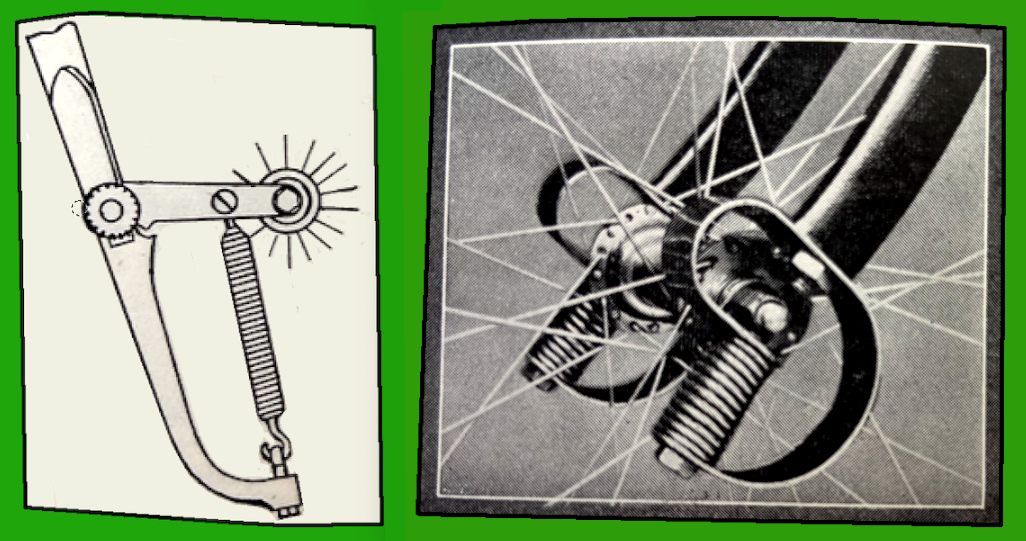
“THE GARRARD COMBINATION STAND and Carrier. The latest invention from the Garrard Manufacturing Company’s works consists of a light, yet strong, attachment to fit on the back axle of a motor-bicycle and forms a convenient stand, so arranged that the rear portion of the mudguard comes away with it and thus the tyre is getatable for inspection or easy repair. When folded up in its normal position a capacious luggage carrier is formed. It is held securely in position by a clip to the back stays. There is no doubt that the mudguard on a motor-bicycle becomes a nuisance at times when the rider wishes to remove the cover of the tyre quickly, and the idea of making it in two sections and securing the rear part to the carrier is a capital one, and will doubtless be much appreciated.”

“THE ‘SPARK’ MOTOR-BICYCLE, which is a machine not as yet well known, has a 2hp engine with outside fly-wheel. The motor is vertical, and is held in position by three clamps from crank case to loop of frame. The drive is by V-belt, and the driving rim is held by bent lugs, which allow a certain amount of spring. A surface carburetter is fitted and a special system of magneto ignition. Control is by levers on the top tube. The right-hand one regulates supply to the inlet valve and the left-hand lever lifts the exhaust. The front brake lever when lifted cuts out the engine by short-circuiting the magneto. This machine will, we understand, shortly be made with specially designed BSA fittings, girder front forks and two rim brakes.”
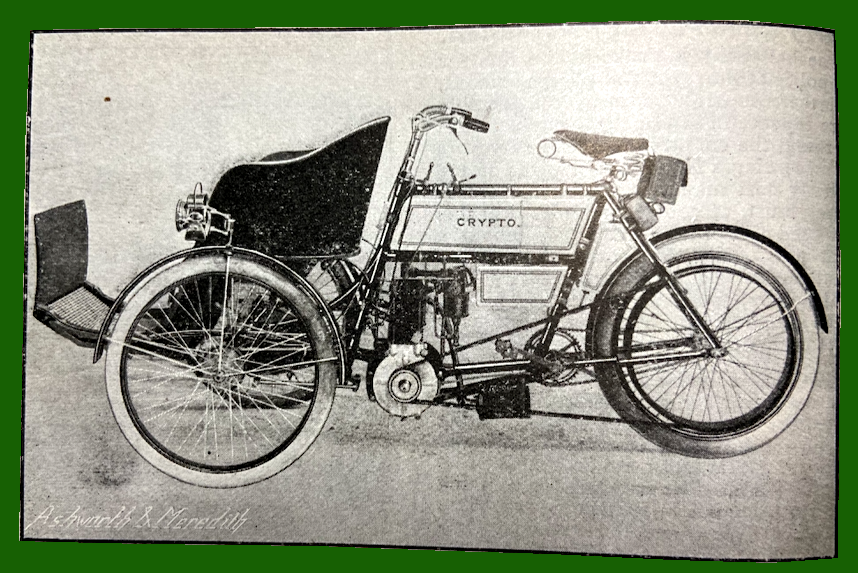
“THERE IS NO DISPUTING the fact that a simple and reliable stand is now an absolute necessity on a motor-bicycle. It is no light task having to start up the engine by pedalling the vehicle in the roadway. In case of a puncture in the back tyre a stand is a great saving in time, health, and temper. Recently, when in Nottingham, we met Mr Fred Fletcher, the safety champion of 1890. Fletcher is of an inventive turn of mind, and is eminently practical in whatever he undertakes. The new ‘Starteasy Motorcycle Stand’, as it is called, is the simplest thing of the kind yet brought to our notice. It is always ready for use, as will be seen by the first illustration. On reaching a point when the rider desires to stop it is not necessary to walk round to find a wall or improvise a stand to place the motor-bicycle against. All that has to be done is to push the machine backward and slip the top end of the stand out of the catch. The machine may be mounted in this position, as it stands as rigid as possible The stand will fit any recognised make of motor-bicycle. It is retailed at 17s 6d, and all particulars may be obtained from Fletcher Bros, Bath Street, Ilkeston.”
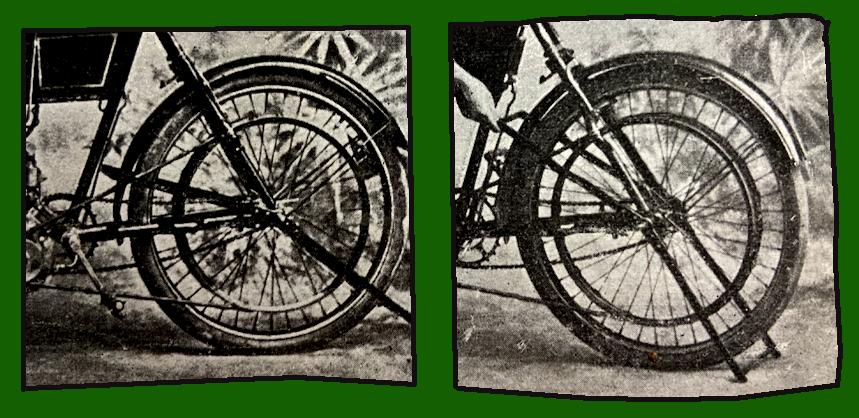
“THE SÉE MOTOR CAR Supply Company, Hills Place, Oxford Street, has the sole agency for the Lamaudiere motor-bicycle in England and the Colonies. The engine develops on actual brake test over 2½hp, and really forms part of the frame, taking the place of the down tube. Inserted brazed-on lugs are used where the motor is attached. A chromated raw hide twisted belt transmits the power. A jockey pulley, adjustable by lever from the top tube, enables the rider to free the engine at will by slackening the belt so that it loses frictional contact with the engine pulley. This is particularly useful in traffic, as the bicycle can be brought to a standstill, the rider remount and dismount with the engine running all the time.”
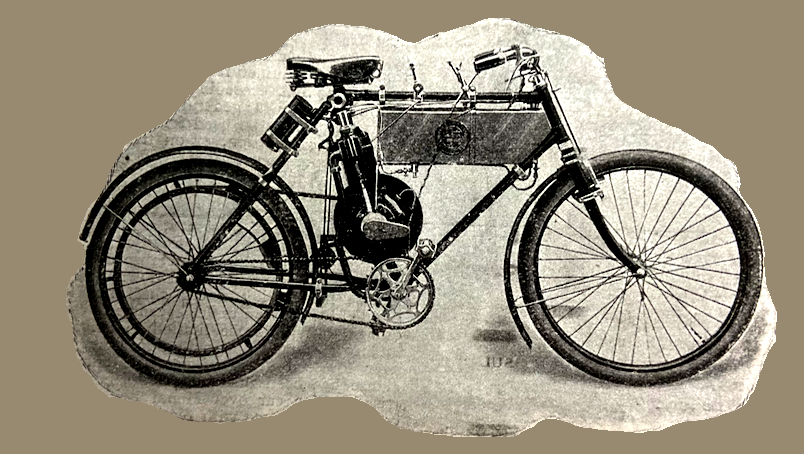
“SIR,—THE ACCOMPANYING ILLUSTRATIONS may interest motorcyclists as showing a simple and safe contrivance for towing. I rigged this up on a run with a friend from Surbiton to Clapham and, needless to say, it was successful. It consisted of a piece of thin cane, 4ft. long, lashed to the top and bottom stays at the part cranked out to take the driving pulley wheel. One end of a 6ft tow line (Venetian blind cord) was made fast to the seat pillar, and about 3ft from this was fastened to within 3in of the end of the cane by what is known as a clove hitch, so that when taut the pull was direct from the seat pillar and leaving about 2ft of cord to hang free with a curtain ring 1½ to 2in in diameter fixed to the end. When the towee casts off the line is drawn up free of the wheel by the springing of the cane, and it can be easily caught again while the motorcycle is running, and the motor-cyclist can dismount in the usual manner, the cane bending and allowing either leg to pass it.
Hy Salsbury, Blackfriars, SE.”
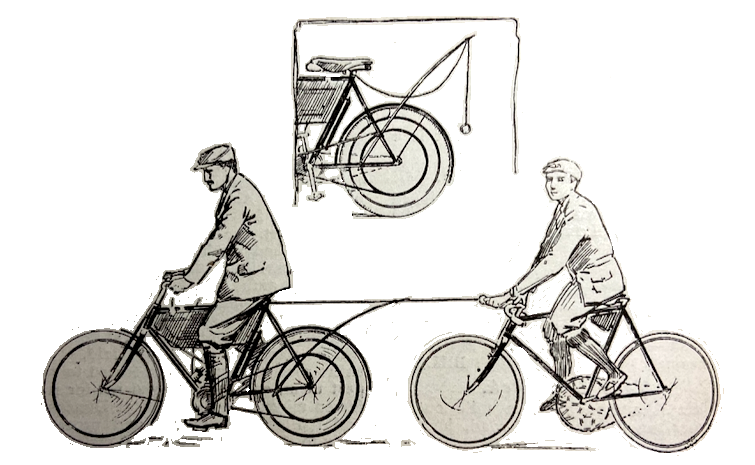
“A LARGE STOCK OF PETROL is carried by Phoenix Motors at their works, Blundell Street, Caledonian Road, London, N. They can supply .680 spirit, but also carry a stock of .700 and .720. A special store, in accordance with the latest regulations laid down by the London County Council, has been built, and 200 gallons is the quantity generally in stock.”
“THE CLINCHER AL TUBE is one that might well serve as a pattern for other makes. It is of really sensible thickness, and we know of more than one prominent motor cyclist who will use no other. Being of grey rubber, repairing is an easier matter. One or two of the riders who used Clinchers in the 1,000 miles are loud in praise as to their behaviour.”
“ONE GREAT ADVANTAGE of the motor bicycle is the opportunity it affords of visiting hilly districts, which, on account of the trying nature of their roads, find little favour with cyclists. Most motor cyclists, if anything, have a preference for hilly roads, as apart from the better scenery and views obtained en route, the frequent opportunities afforded of testing the engine on various gradients undoubtedly add a charm to the ride.”
“MR HOARE, THE WELL-KNOWN cycle and motor clothier, Central House, High Holborn, is now selling a most useful suit of overalls for motor cycling. These simply consist of a jacket and trousers which may be slipped over any respectable suit, no matter how good it is. A motor cyclist can thus visit his friends, or go to a croquet or tennis party in the lightest of flannel suits, slip off his overalls, and arrive fresh and clean. We have been using such a suit on several occasions of late, and have found it of great service.”

“THE EVER INCREASING POPULARITY of the fore-car, trailer and side-car attachments for motorcycles suggested to the committee of the Motor Cycling Club the idea of organising a 100 miles non-stop test for this class of vehicle, on the lines of the 200 miles trials for single machines held recently. Accordingly, it was decided to hold the test on Saturday last, September 12th. The route selected lay on the south side of London, the starting point being Godstone, 22 miles from the City. The route was one practically free from traffic, and had the advantage, for trial purposes, of being hilly enough to show up the weak points of a machine. A condition of the trial was that the passenger in the trailer, fore or side car had to be a lady. About 15 entries had been received, and the competitors assembled at the Clayton Arms, Godstone, by 11am. The ‘natives’ of this pretty little Surrey village had their curiosity tickled as to the meaning of the crowd of men and strange looking machines outside the hotel, and many were the comments made thereon.” The passenger vehicles completed two laps of a 25-mile course, sat down to lunch at the Clayton Arms Hotel in Godstone and did it again in the afternoon. The Motor reported: “The road is good and slightly undulating to East Grinstead, but beyond there it gets hilly, the surface being poor in places, and a few heavy showers had made the going dangerously greasy at several points.” There were 10 starters. A Lagonda bike and trailer dropped out with a snapped drive belt; a Werner bike and trailer was knocked out by a cracked spark-plug “The others were going well, but in most cases had to pedal hard up the stiffest of the hills” but AC Wright’s 2¾hp tandem “took all the hills without pedalling”. A chap named Milligan (Bradbury fore-car) declined to rejoin the event after lunch. A Humber Olympia tandem was stopped by ” fragile fuse wire connecting two accumulator cells breaking with the vibration or melting”. F Garner (3hp Rex and trailer) “experienced a curious mishap on the return, as he was climbing the long rise out of Grinstead. The hinged joint between the trailer tube and bicycle snapped, but he effected a rep[air with a couple of straps. This mishap suggests dangerous possibilities in the event of a trailer breaking away on a steep hill…The five remaining competitors reached Godstone about six. All except Lord (Ormonde tandem) had slightly exceeded the speed limit…The distribution of the awards in this event are as follows: Wright, on Ormonde tandem, and Hacking, on Ormonde and side-carriage, divide the main award, both these competitors having completed the distance without a stop, and within the limit of the speed provided by the regulations. Messrs Lord, Johns and Hooydonk will also receive a medal, or some other award, from the funds of the Club. Each of these three competitors completed the distance as a non-stop, but they slightly exceeded the limit of pace. The maximum pace allowed by the rules was 17mph, and the approximate time to run the distance at this pace would be 5hr 53min. The times taken by the five successful competitors were as follows: Wright, 5hr 53min 49sec, Ormonde tandem; Hacking, 5hr 58min, Ormonde bicycle and side-carriage; Hooydonk, 5hr 48min 22sec, Phoenix Trimo; Johns, 5hr 49min 35sec, Humber and trailer; Lord, 5hr 43min, Ormonde tandem.”

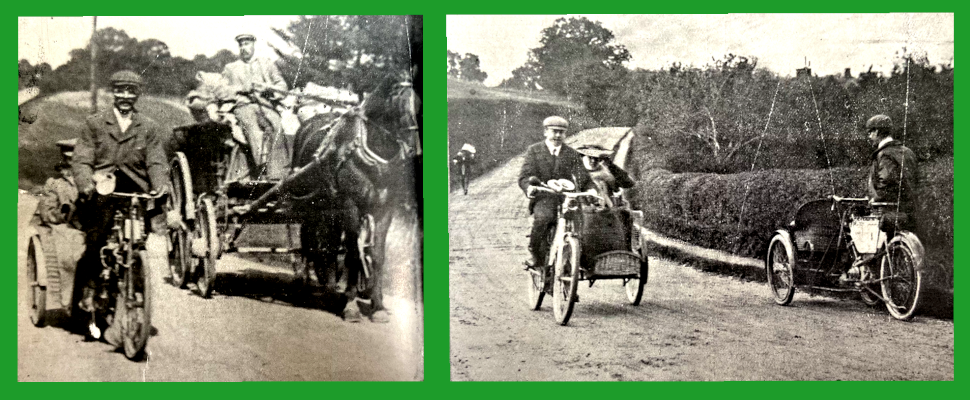
carriage, near Godstone.”
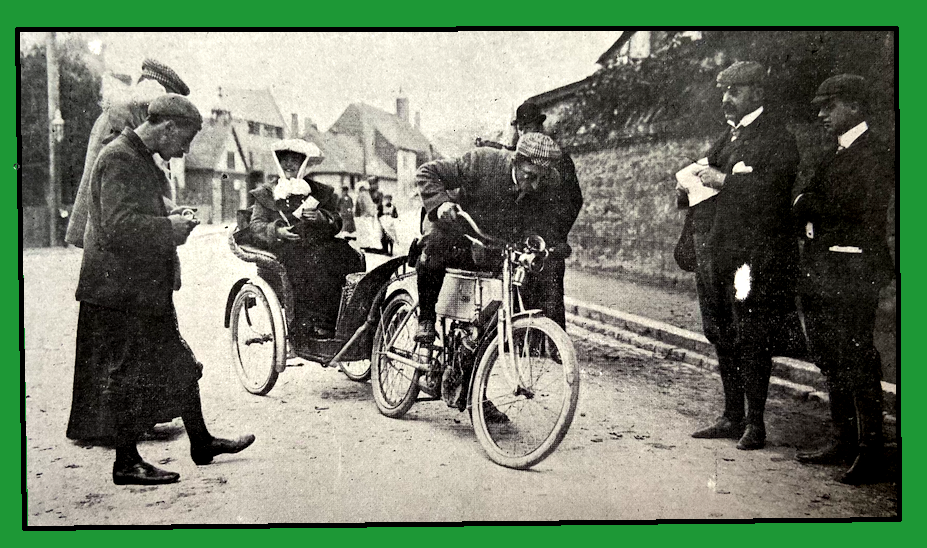

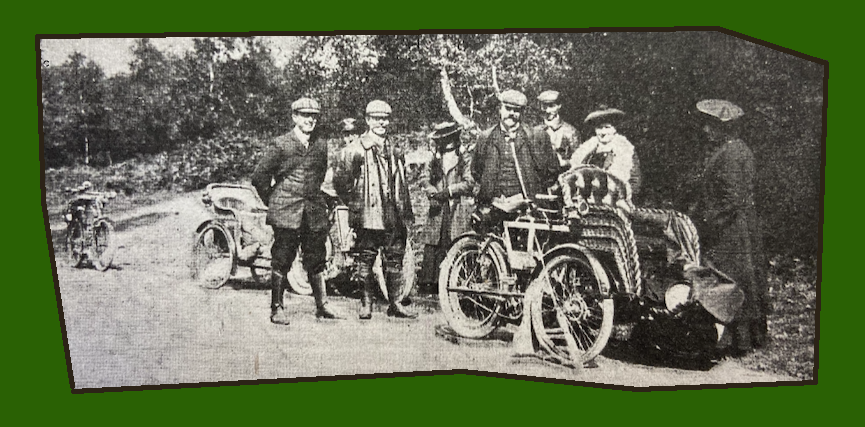
“SIR,—IN REPLY TO H BAILEY. who recently enquired about a Holden motor-bicycle, I may say I was the possessor of a ‘Holden’, and hope to be in time to prevent him falling into the same error. The vibration I found was tremendous, owing to the direct drive, and for the same reason the tyres soon wear out. The lubrication seems all right, but it supplies the cylinders only and not the gear. The great fault, in my opinion, is the complication, and the difficulty of getting at the parts, especially the valves, of which there are ten. Often a few strokes of the pedals will keep an ordinary motor going on a bad hill, while on the ‘Holden’ you most push it up the rest of the hill, and 2cwt is no joke I can assure you. Finally, I find that my present 2¾hp machine at half the price is more powerful.
Norman F Rhodes.”
“SIR,—AS SEVERAL OF YOUR readers have enquired for experiences of the ‘Bat’ perhaps mine may be of interest. I have ridden 1,400 miles during the ten weeks I have had the machine and have not had the slightest trouble except with the tyres, which are Dunlops. My best ride was from Gainsboro’ to Wimbledon, about 180 miles, starting from Gainsboro’ at 4 o’clock in the morning and arriving, at Wimbledon at 1 o’clock mid-day in time for lunch. The first 105 miles were done on less than a gallon of petrol, which I think, sir, you will allow was not bad for a 2¾hp MMC engine. This motor to my mind is simply perfection, and the way it climbs hills with a trailer is a revelation. The return journey to Gainsboro’ by a somewhat shorter route with my wife in a trailer was done in exactly 12 hours, including all stops. The distance was 165 miles. The ‘De Dion’ carburetter always starts at once and works well with any quality of petrol. There is no tendency to choke, and I have not as yet had any occasion to open it up. The machine I find is a very comfortable one to ride, a fact which I attribute to the fixed footrests and the Lamplugh’s ‘Ride-easy’ saddle. Though it has no pedals it will take a trailer up all ordinary hills; in fact, on the run down to Gainsboro’ from London there was only one hill, at Grantham, which I could not get up without dropping the passenger. Without a trailer it mounts easily any hill I have come across. Trusting these experiences may be of interest to your reader,
HA Neal, AMIME.”
“Sir,—In reply to your correspondent, ‘GAB’ (Sutton), re side-carriages, I have now been riding one for some time, and I have no hesitation in recommending them in preference to either the fore-carriage or the trailer, as I find from experience that I can surmount hills which I had to walk up with a trailer. Also the engine is not screened from the air, as it is with the fore-carriage, and one can carry on a conversation with a passenger much more comfortably. From experience I should recommend Messrs Mills & Fulford, as they themselves are using a 2¾hp Excelsior motor. I recently paid them a visit with a friend, and Mr Mills took us in the side-car, himself on the motor, and also a workman on the back axle, all round Coventry, over the tram lines and rough stone setts, in order to prove that it was strong enough. I think this was a convincing enough argument. I am in no way connected with the firm, but I am using one of their side-cars myself, and am perfectly satisfied with it, therefore I have no hesitation in recommending it.
Fred A Austin.”
“THE MACHINE ILLUSTRATED [below] is built by the Beauchamp Cycle and Motor Co, Chapel Street. Prahran, Melbourne. Every part except the front hub and cranks was made at the company’s works. The motor is of 2hp, belt drive and fitted with spray carburetter and high-tension electric ignition. Duplex front forks are fitted. On the whole the machine is well designed and does credit to the makers.”
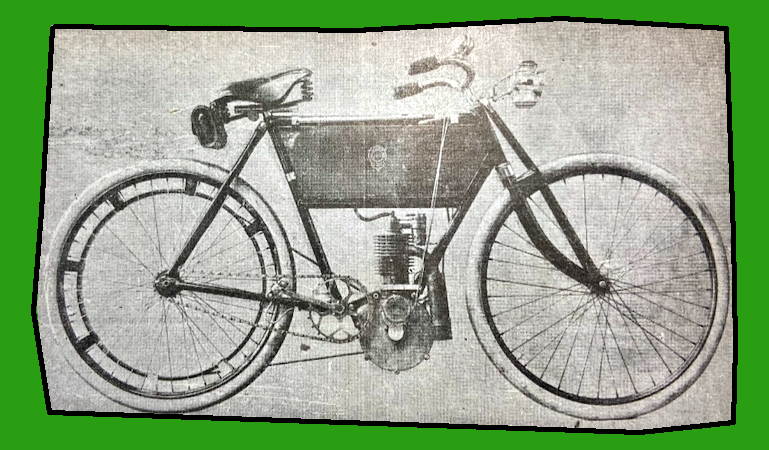
“THE MACHINE ILLUSTRATED [below] is made by Strettons, Cheltenham, and is named the ‘Millionmobile’. The engine is an ‘Aster’, of 3¼hp, fitted with Longuemare carburetter and trembler coil ignition. The shape of the frame and length of base (57in) are rather out of common. The engine is attached to the loop of frame on two solid steel forgings bolted to the tubes, and it also rests upon the bottom of the loop frame on two spring-steel clips. Ample mudguards are fitted, and petrol and oil storage are provided for over 100 miles running. The tyres are Palmer motor-bicycle type, 28×2½in. Transmission is by Lycett’s V-belt, with patent eyletted rivets. There are special levers for actuating the carburetter, one working inside, the other for moving the air and gas inlets.”
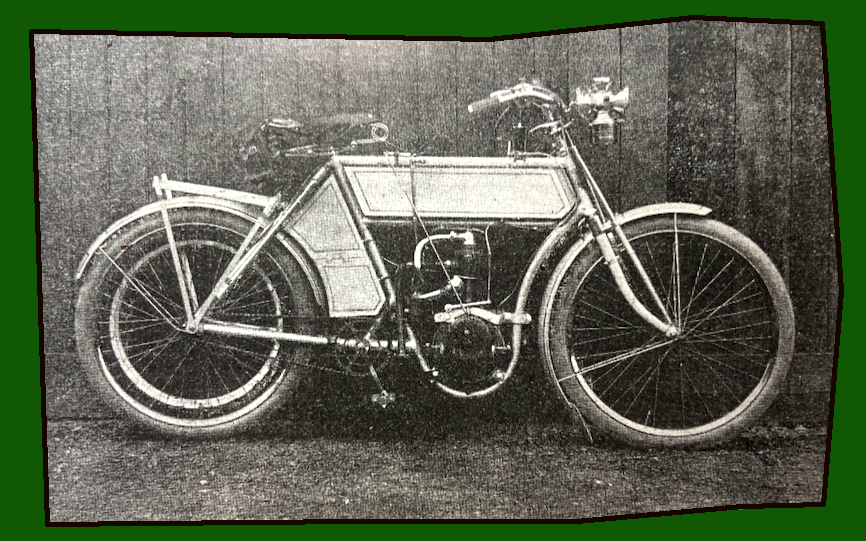
“THE TWO-CYLINDER ‘IRIS’ BICYCLE is driven by a 5hp water-cooled motor and has a free engine clutch. It weighs 150lb, and will carry water sufficient for a run of 200 miles. As will be noticed, it has no chain. Fixed foot-rests are provided, and these are fitted with pedals simply to allow for a variation of the position of the foot of rider. A good show of ‘Iris’ bicycles will be exhibited at the Stanley. The motor is mounted in a specially designed loop frame, and drives by a flat belt. The accumulators are carried in a box on the back forks. Two brakes are provided, viz, a rim brake on the front wheel and a band brake on the rear hub. The machine is started in the manner usual with pedalless motor-bicycles by running alongside for a few yards and then jumping in the saddle. The great reserve of power enables the machine to take the steepest of hills and for a side or fore-carriage attachment the power is ample.”
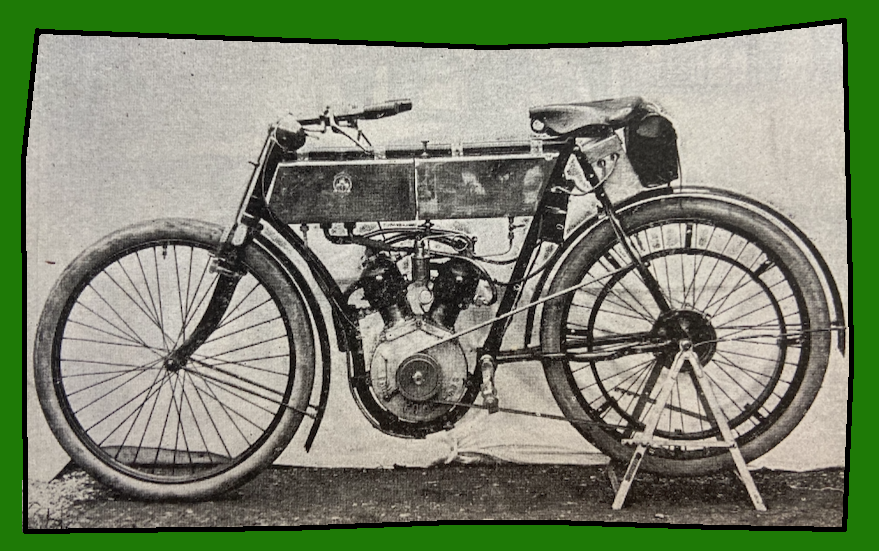
“THE BENTINCK, MADE BY EG Young and Co, London Road, Nottingham, is equipped with a 3½hp Minerva motor, with mechanical inlet valve. The frame has a double horizontal tube, and the motor is securely held in lugs. The regulating levers have ratchet adjustments, and the petrol tank carries 2 gallons and the lubricating oil tank ½ gallon. There are two accumulators, provided with a two-way switch, so that either can be used. The carburetter is a Longuemare. The induction coil is enclosed in the case behind the diagonal. Duplex front forks are also fitted, and the exhaust is carried well down below the frame.”
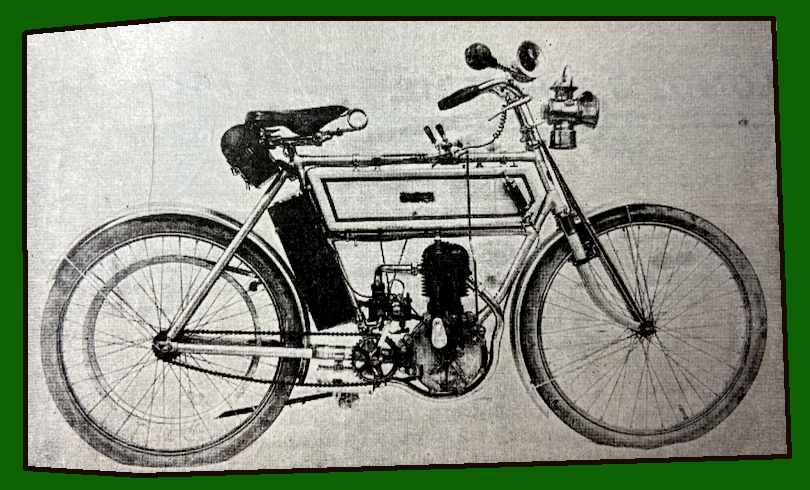
“A TANDEM MOTOR-BICYCLE WITH dropped rear frame is made by Pitcher and Bartlett, 119A, Holland Park Avenue, London,W. The motor fitted is either a MMC 2¾hp or a 2¾ or 3½hp ‘Minerva’, according to the purchaser’s wishes. It is mounted vertically in a central position in the frame and drives by belt—either V or the 1¼in flat type. The carburetter is a Longuemare. Provision is made for carrying 1½ gallons of petrol and lubricating oil sufficient for 200 miles, and ignition is by P&R accumulator and Bassée Michel coil. There are two brakes, the application of one cutting off the sparking current simultaneously. The control levers are mounted in a convenient position forward on the horizontal tube. The wheels are 28in diameter fitted with 2½in tyres. Price of the machine is £60.”
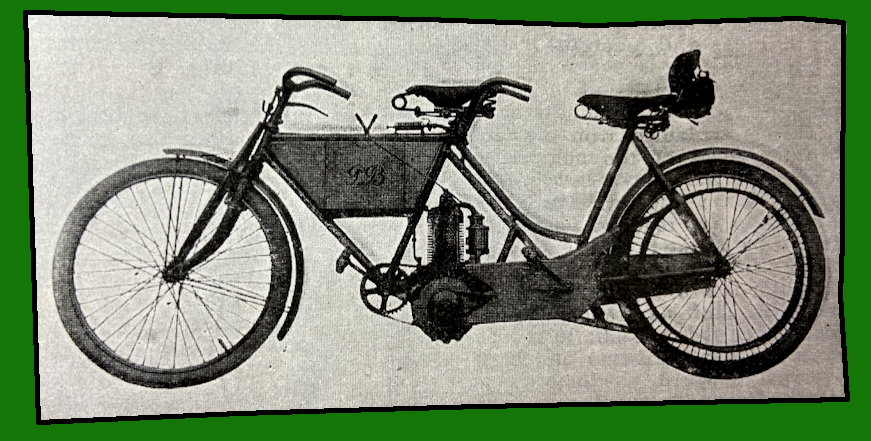
“THE PRINCIPAL POINTS OF INTEREST in the Aeolus machine are the novel means by which the transmission of the power is effected. The engine, which rotates in the same direction as the line of travel, is securely bolted in a vertical position to the frame. Upon an extension of the engine crankshaft is a bevel wheel, at right angles to which is fitted a light shaft having at either bevel wheels in constant mesh with that on the crankshaft and a toothed wheel fixed to the hub of the rear road wheel. All these wheels are entirely encased and run in grease. A special form of clutch is fitted on the propeller shaft, operated by the hand lever in starting, and the speed is usually controlled foot pedal, providing a free engine for traffic, descending hills, etc. The transmission is thus direct to the road wheel with no appreciable loss of power, far less than by ordinary methods. Footrests* are provided, enhancing the rider’s comfort, but if desired, ordinary pedals and chain can be had instead. The engine is of the company’s latest type with extra strong crankshaft; and the valves, which are mechanically-operated, are placed across the front of the motor, instead of at the side as usual, consequently receiving a full current of air for cooling. The cylinder and head are a single casting. A spray carburetter of special design is fitted, and the ignition is by means of brush contact with accumulator and trembler coil…The makers are the Motor Transport Co, Comeragh Road, London, W.”

“HILL-CLIMBING IN LIVERPOOL. The steepest street in Liverpool is said to be Havelock Street, Everton, with a. gradient of 1 in 5.75. It is surfaced with cobbles, and has a right-angled turn at the bottom, so that riding up on a motor-cycle has hitherto been thought to be impossible. J Edge, the well-known Anfielder, who owns a Bat motorcycle, and is captain of the Liverpool Motor Cycling Club, announced his intention of trying his luck on the hill at 2pm on Saturday, and quite a crowd gathered in anticipation of a great struggle against failure. As it happened, rain fell for most of the morning, and this made the turn at the bottom extra bad. At his first attempt Edge came along well, and then essayed the turn, but his machine skidded away, and he had to come off. The next attempt resulted in the same fate; but ‘third time lucky’, and the corner was negotiated somewhat trickily but successfully, and then, increasing pace, the machine went up between the pillars about half way up the hill, and then to the top in fine style. Edge is thus the first motor-cyclist to surmount this steep little pitch.”
“AN INSPECTION OF THE inside of the combustion chamber of a small motor that has been in use for a considerable period will show that a more or less thick deposit of burnt up lubricating oil has formed on the cylinder walls and the interior of the combustion head. It may not be generally known that this deposit directly affects the efficient running of the motor, inasmuch as it tends to cause overheating, especially in cases where the motor is mounted in rather a sheltered position on the frame. This lining of charred oil is a perfect non-conductor of heat and prevents a certain amount of heat—that it is important to get rid of—from being carried to the radiators. It is one advantage of having a detachable combustion head that it is an easy matter to clear away this deposit. Although it is of a hard cement-like nature, a fairly sharp penknife will remove it by careful scraping. The head of the piston also gets encrusted, but to clean this properly the cylinder must be taken off. If an abnormal amount of charred oil is found in the combustion chamber it will show that oil gets past the piston freely, and that the rings want renewing.”
“METALLIC PAINT FOR MOTOR PARTS. A new preparation that should be welcomed by motorists who are troubled with parts of their engines getting rusty is ‘Silverskin’ just introduced by Messrs Kay Bros, Stockport. It gives a silver-like coating to parts such as the radiators, crank cases, supply pipes, etc. It is claimed to be water and oil proof, and practically heat proof. It was found that the ‘Silverskin’ had the same conductivity as the metal itself. It is useful for coating electric wires and cables, forming an excellent protective coating. We have a sample of this preparation now undergoing a test.”

“QUITE UNIQUE IN ITS CONCEPTION is the meeting which was held last Friday and Saturday at Southport on the Lancashire coast. As a rule, officialdom looks some-what askance at the motor-driven vehicle; its owner demands such perfection of roads, and (so it is asserted) does not hesitate to travel fast and so cause the surface to be sucked up. In fact, officialdom, so far, has gone out of its way to find cause for complaint against the motor-car, but the Mayor and Corporation of Southport have taken the first step to-wards the alteration of all this, and by handing over the whole of the magnificent parade in a suitable condition for motor racing, have shown that they are fully alive to the important part which the motorcar must, of necessity, play in the future, and that they are desirous of actively encouraging the movement. With these ends in view, neither expense nor trouble had been spared to provide a suitable course…The promenade on the sea-front consists of an asphalt road, with footways on either side. It is quite a mile in length, and practically fiat…The Corporation had repaired all the defective spots in the roadway, and the gutters had been filled up with asphalt, so as to strike a level from the pavement to the centre of the road. Thus no kerbing is to be seen from end to end, because the asphalt now stretches from side to side, with a very slight crown in the centre. The width in the
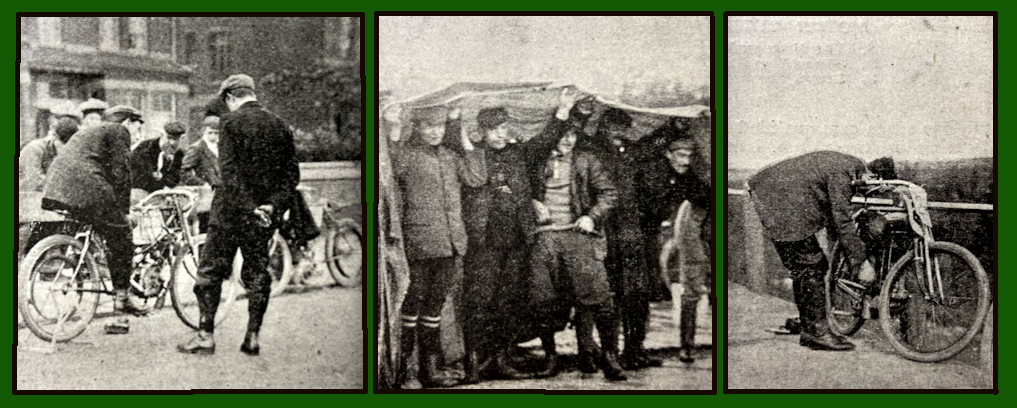
narrowest part is 40ft, and in the widest 60ft. All obstructing lamp posts and electric light standards had been removed, and even the big fountain which stood by the pier entrance had gone for the time being. From end to end of the course a heavy timber barrier was erected to keep the crowds back, and a further wise provision was that against dogs, wire netting having been carried along on the barriers. Southport having gone so far towards providing an entertaining programme, the Automobile Club and the Liverpool Self-Propelled Traffic Association could not but enter into their part of it with vigour and verve, and, so well had the programme been planned, that no less than 189 entries were received.” While the trials were dominated by cars, there were four motor cycle events: a scratch race for lightweights up to 114lb/70x70mm (269cc) with eight entries ; a handicap for bikes up to 170lb/84x84mm (465cc) with 21 entries; a local handicap in the same class but restricted to Lancashire riders with 12 entries; and an open scratch race for any bike up to 170lb with 18 entries. The length of the course was “seven furlongs with a further 300 yards at the top end for slowing down”. [For the benefit of younger readers, a furlong is 220 yards, or 40 rods, or 10 chains—Ed.] “The start was set down for 11.45, but just before that hour rain fell in torrents, and as the machines were out in the open against the railings of the Parade, overcoats, mackintoshes and ground sheets were, for a few minutes, at a premium. By a stroke of luck, some cute rider noticed that a large house on the Parade was empty, and when he ran his machine into the porch many followed his example, whilst the late ones discovered a covered side entrance and an open gate which led to the rear garden where there was a fine cycle house. This at once became the receptacle of tool bags and accessories, and on the whole the motorcyclists came off well, thanks to their enterprise…After the heats on the Friday, “the Mayor and Mayoress (Mr and Mrs TTL Scarisbrick) invited about 35 members of the Corporation, of the Automobile Clubs, and of the Press to Greaves Hall, about five miles out, to dinner. The guests met in the Mayor’s Parlour at the Town Hall, and were taken out in carriages, the weather now being finer. The experience was unique in every way. Greaves Hall is only about five years old, but is built on the lines of an old baronial mansion. The guests were received by the Mayor and Mayoress, and the tables were graced with the presence of other lady members of the Mayor’s family. The function was most enjoyable, and, with a few unpretentious speeches, the proceedings were carried on till past eleven o’clock…At four o’clock on Saturday morning the rain was falling in torrents. At breakfast time a raw chilly wind was blowing up the track, and many an official could be seen during the day clad in his heavy motor clothing…” The Manchester Courier and Lancashire General Advertiser reported: “…the barriers along the whole length of the promenade track were thickly lined by spectators. As the hours advanced the weather improved considerably and an occasional gleam of sunshine did something to compensate for the powerful wind which, as on the previous day, swept along the course dead in the teeth of competitors. By half-past two it was estimated that 50,000 spectators were present, the scene along the front, as viewed from the lofty elevation of the press stand, being one to be remembered. The grandstands erected in front of the hotels and principal houses were packed with fashionably-dressed ladies and gentlemen whilst behind the stout barriers along the roadside thousands men, women, and children struggled to catch a glimpse of the competitors as they flew past on their machines.” Back to The Motor: “The first events were the finals of the motorcycle races. In the contest for the small machines the opponents were Richards (Minerva), J Spencer (Ariel), Crundall (Humber) and Wright (Ormonde). A very good start was effected and Spencer pedalled all he knew up to the permitted limit, and thus gained a good twenty yards. This gap the others were unable to dose. Crundall worked up into second place, and then, by the Pier, Richards came up, travelling fast. He got into second position, but could not overhaul Spencer, who won by about three yards, the same distance separating Richards and Crundall. The force of the wind will be gauged when it is

stated that Spencer’s time was 2min, equivalent to a speed of about 26mph. For the handicap there were five competitors: S Wright (Excelsior), H Rignold (Riley) and B Yates (Humber) on scratch, T Tessier Bat), with 5sec start, and JF Crundall Humber) with 10sec. The scratch men soon caught and passed their opponents, and in processional order, with a gap of about ten yards between each pair, they finished in this order: Wright, first, 1min 37⅗sec, Rignold, Yates, Crundall and Tessier bringing up the rear. A very hot fight was witnessed between Wright, Yates, Rignold and Crundall in the final of the high powered class. Crundall (Humber) had the most powerful engine, its dimensions being 89mm bore by 102mm stroke [634cc]. Yates’s Humber engine was 89x89mm [553cc], and those of the other two were 84x84mm [465cc]. There was a capital start, but hard pushing was the order of the day. Crundall at first forged ahead, but Wright gradually overhauled him, and won by 10 yards in the fine time of 74sec, Crundall being second, and Rignold third. The local handicap was a close race resulting in a for Threlfall in 79⅕sec, with Rignold second and Edge third. It was afterwards found that Threlfall was ineligible to compete, and we understand that the first prize has been withheld. Now came the open race for motor-cycles of any cylinder capacity that could be packed into the weight limit of 170lb. Weird noises like a concealed firework display on an extensive scale had been proceeding from the aforementioned porch, and now there was produced Tessier’s Bat, with a Soncin engine, measuring 87mm by l08mm [642cc]. Crundall, too, had got a special Humber, 89mm in the bore and 102 in the [663cc], whilst Watson’s mysterious Ormonde was no less than 125mm in the bore and 120 the stroke [1,472cc]. It was all engine, and scarcely any bicycle, for it is said to only weigh 111½lb. However, the latter did not get tuned up in time, or its presence might have created a stir.” Crundall completed his run in 1min 12⅘sec, ahead of Rignold (1min 21⅕sec), Yates (1min 22⅘sec) and Wright (1min 54⅖sec). “The ordinary programme of events having been completed, the course was reversed, so as to race with the wind, and attempts were made to lower the world’s records…The sensation of those events was Tessier’s performance on a motor-cycle. He covered the course at the rate of 62.75mph. In the evening the prizes were presented to the successful competitors by the Mayoress.”
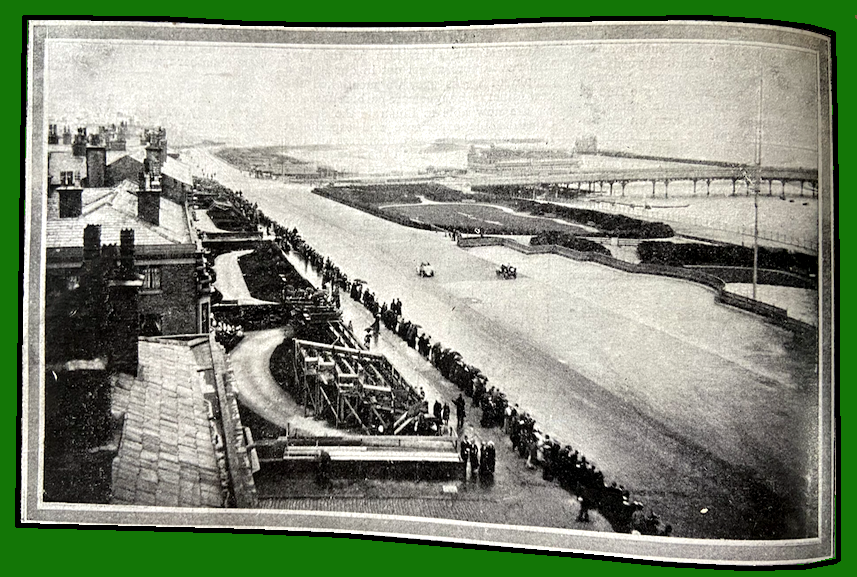
“SOUTHPORT CORPORATION’S EXPERIMENT will, without a doubt, open up a new era for motor racing in this country, and those who look to it to provide sport and amusement and (to dive oven deeper) to provide an incentive towards the continuous improvement of the touring car and cycle, will welcome the innovatIon because, up to the present, speed has had to be sternly repressed, and the value of it as a test has been lost. The use of the public highway has never been permitted, naturally, and we have a demonstration in the Gordon-Bennett event of all that is entailed if a section of the highway is to be closed for a day for the purpose of a speed contest. And so the only alternative, up to the present, has been the use of a private road. We know what a fiasco occurred at Bexhill, where the Lord of the Manor, in ignorance of his exact rights, permitted racing over a portion of the Marina—an experiment which has been prevented from repetition by an injunction granted to a householder whose premises fronted the course. The Duke of Portland has permitted speed runs upon one of the roads at Clipstone, within the confines of his Welbeck estate, but all who have seen that narrow road, suitable only for one car at a time. with but scanty accommodation for sightseers, even presuming that sightseers would go to such a comparatively out-of-the-way place to see speed alone without the single element of sport, will agree that it is quite useless to attempt to conduct motor racing there. But Southport’s Corporation has come forward with a method and, with characteristic energy, has, instead of talking about it, set to work and put it into practice, and as a result, we witnessed a meeting which, even if it fell short of the ideal, at. any rate possessed all the necessary elements to enable it to rival the famous Continental meetings, such as those at Nice and Ostend.”
“THE HEREFORDSHIRE AC HELD a hill-climbing contest on Friday last on Dinmore Hill, which is 1¼ miles long, with an average gradient of 1 in 12. It was open only to the motor-cycling members of the club. The time was taken from a flying start; no pedalling was allowed. Owing to the unsettled weather, there were not so many present as there might have been, and only 10 competitors attempted the climb. All managed to get up without pedalling, though it was thought doubtful if all would negotiate the nasty corner half-way up without slackening, especially as the road was greasy. Hall, Quadrant (Quadrant engine, 3hp), 2 min 46sec; Marriott, Marriott (De Dion engine, 2¼hp), 2min 52sec; Ekins, Minton (Minerva engine, 2hp), 2min 57sec; Groom, Excelsior (MMC engine, 2¾hp), 2min 58sec; Simpson, Triumph (Minerva engine, 2hp), 3min 6sec; Godwin, Coventry Eagle (3½hp), 3min 19sec; Langford, Rex (Rex engine, 3hp), 3min 28sec; Passey, Victor (Minerva engine, 2hp), 3min 41sec; Weale, Ariel (Minerva engine, 2hp), 3min 53sec; Chave, Excelsior (MMC engine, 2¾hp), 3min 59sec. It is only fair to Mr Chave to say that he entered the contest unprepared, and upon examination his contact breaker was found very dirty.”
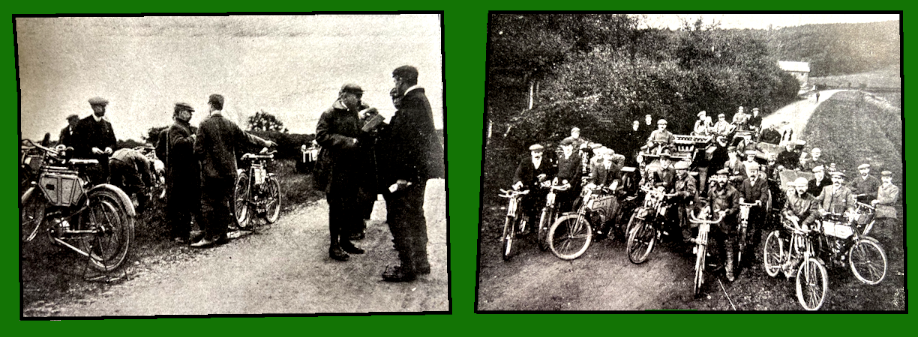
“THE CUP RACES—A PROTEST. With reference to the disqualification of my machine in the ACC’s meeting on Aug 22nd, I should like to state the facts of the case, and leave your readers to form their own opinion of the fairness of the club’s decision. I entered in the five miles handicap and mile time trials on a machine which, owing to the conditions imposed had to be specially built at a fortnight’s notice. In the handicap I won my heat in 7min 26⅗sec, and, after a lapse of about one hour, subsequently won the mile time trial in 1min 15sec, being 4sec faster than any other competitor, and my time being officially marked up on the boards at the track. On getting to my mark for the final of the five miles, I was informed I had been disqualified for not having an efficient silencer, and this was the first I heard of my disqualification. The machine I rode was of exactly the same type as I have used on the track all the year in races held under the ACC’s rules, and never having had the slightest objections made before, I naturally concluded that the club accepted my definition of ‘efficient’. On making enquiries of the officials as to what they actually meant by ‘efficient’, I could get no satisfactory answer, they, in fact, admitting that it might mean anything, and the only reason that machines with silencers that they considered inadequate had been running on the track all the year was that they could not have a representative at every race meeting held in England; in other words, they are not capable of governing motor cycle racing, and the consequence of their incapability is that manufacturers may be put to the expense of building special racing machines which they are led to believe conform to the club’s rules, only to find, as in this case, that after winning an important race they may be disqualified at a moment’s notice.
CR Collier, For H Collier & Sons, Plumstead.”
“SIR,—IN REPLY TO ‘North Road’, who wrote in The Motor to say that police trap notices are a mistake is utterly absurd, I should like some proof as to the absurdity. There is no ‘if ‘ about my having ridden 4,688 miles (now 5,132), and why ‘North Road’ should doubt it I am unable to see. I would ask him to do me the honour to believe me when I tell him that I have never yet seen a police trap in either England, Scotland, or Ireland; nor has an officer ever spoken to me about my speed. I have always found the police most reasonable with regard to speed, and only a short time ago a superintendent told me he could see no harm in any speed which was not a danger to the public. Anyone going down a slope at more than 12mph, in my opinion either requires to be shut up, as not being able to take care of himself, or, if sane, fined. With regard to motor cads and law breakers, I may say that, fortunately, the former are not very common, and belong almost entirely to a few of the car users; but the latter to car and cycle users, and comprise nearly all not included in the former.
Alfred Meigh“
“SIR,—I FOUND BY a few simple experiments that the difficulty in starting with stale petrol in a surface carburetter is chiefly due to the fact that after the machine has been standing still for some time the air space in the carburetter is not full of petrol vapour but of air. Hence firing cannot occur till all this air has been pumped out by the rotation of the engine. If a few bubbles of ordinary illuminating gas are passed down the chimney of the carburetter the engine will start with the first turn of the pedals. A simpler plan to get easy starting is to blow air down the carburetter chimney. A more convenient plan is to arrange an ordinary india-rubber ball pump, which remains permanently attached to the top of the chimney. A few compressions of the ball are ample to fill the air space in the carburetter with explosive vapour and ensure easy starting.
EH Hankin, Agra, India.”
“SIR,—IN YOUR ISSUE of September 16th in reply to V Burrow (Morpeth) it is stated that the average life of a motor. cycle is 8,000 to 10,000 miles. This estimate seems to me rather wide of the mark, and it is a very interesting and important point to arrive at a correct conclusion about. A motor expert who often changes his mount cannot, in my opinion, be as good a judge as a private owner who usually sticks to one machine. If 8,000 miles were all one could guarantee how could one justifiably recommend a motorcycle to a medical man? Many country doctors average 20 miles or more a day on their rounds, and this would reduce a motor to scrap iron in a little over a year, by your estimate. My experience is that a good motor will do much more, and I have one that has done over 13,000 miles without turning a hair. If your expert would kindly let readers know the make of machine that has worn out in 8,000 miles we should be much obliged, and know what to avoid. With regard to the use of motorcycles for country medical men, I can only say that they are simply invaluable and will soon become an absolute necessity in these days of keen competition and rapid locomotion.
‘Scalpel’.
[In our reply to Mr Burrow we expressed the opinion that 10,000 miles was as much as one could reasonably expect from a motor without having to replace at least some wearing part, such as a bearing bush, piston rings, cam or pulley. Of course, the main components of the motor will last indefinitely. Doubtless in the hands of a very careful rider who attended well to the lubrication and did not strain the motor by forcing it up hills with spark forward and full throttle a greater distance than 10,000 miles might be accomplished—Ed.]”
“THE VALUE OF THE MOTORCYCLE as a medium of locomotion and an aid to geographical knowledge is very strikingly exhibited just now in the Quadrant Cycle Co’s window in Newgate Street wherein is shown a 3hp Quadrant machine that has just been through a tour of 2,172 miles in one month. The rider was the Rev R Oakley, of High Wycombe. He commenced his tour on August 25th and made for Oxford, Gloucester and Chepstow and thence to Cardiff, Swansea and Carmarthen, 205 miles, reaching here 24 hours after the start. Next day was to Malvern via the Herefordshire Beacon, Kidderminster, Shrewsbury, Chester, Warrington, Preston and right through the Lake District to Selkirk. He then turned south for Twickenham near London, going via Moffatt and over the Kirkstone Pass. He ran into a ford at night in this district, but did not injure the machine. He reached Twickenham, but not without a smash through running into a wall in the dark, breaking a pedal and lamp. After having these details repaired he ran on to Andover, Salisbury to Exeter, and made this town a centre for local runs. The return was via Crediton, Tiverton and Wellington, Southampton. Chichester, Brighton, London and home to High Wycombe. There were four separate day runs of over 200 miles each, the longest being from Grasmere to Watford, 264 miles. The machine alone weighed 133lb, luggage, etc, 941b, rider 13 stone 10lb, totalling 419lb. Rev Oakley’s trip is “flagged” out with little red flags on a large map of England, and there are very few patches on the map which are without a flag: practically in the short space of a month—during which the average holiday maker explores part or the whole of one small county—the motorcycle has taken its rider throughout the length and breadth of his native land. The map, with the machine rigged out for the road in the background, is surrounded with autographed picture postcards from the various places stopped at en route. Large crowds have been gathering round the window all last week.”
“THAT MYSTERIOUS MALADY known to the vulgar as ‘the hump’ and to the refined as ‘the blues’ is stated to be disappearing since the advent of the motor.”
“MESSRS BROWN BROS, GREAT Eastern Street, London, EC, are now supplying a motor-bicycle set, comprising the following parts: Motor 2¾hp, 74x76mm [327cc]. Tank with oil pump and fittings, such as throttle and advance, sparking rods, clips, tubes and unions. The carburetter is a genuine model E Longuemare. Bassée Michel square non-trembler coil. Accumulator of 18 ampere hours capacity. High and low tension wires, sparking plug, interrupter, switch handle, 7ft 6in V-belting, belt rim, frame, handlebar, seat pillar. The sets are only supplied to the trade.”
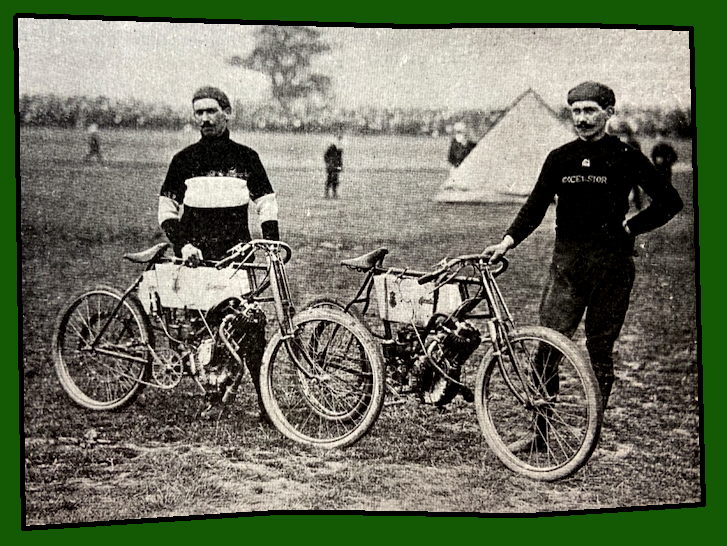
“IS THE AUTOMATIC INLET valve superior or inferior to the mechanically operated valve? This question, which many makers put to themselves at the present day, says La Locomotion, involves two very distinct points of view, viz, simplicity and efficiency. In the first case the question is immediately decided, because it is quite evident to everyone that the automatic valve is of simpler construction than the mechanically operated valve: its use, then, is recommendable for small motors where simplicity is an essential. Secondly, as to efficiency. In a communication to the French Society of Civil Engineers, May 17, 1901, dealing with improvements and modifications for augmenting the efficiency and specific power of internal combustion engines, the following remarks were made respecting automatic inlet valves: ‘Our colleague also alludes to loss caused by inertia of the inlet valve: it does not shut instantaneously at the compressing stroke of the piston. Thus, during this period, part of the sucked explosive mixture is forced into the air through the carburetter: the remedy for this loss would be mechanical control of the suction valve by a mechanism identical to that of the exhaust valve.’ The following year the idea was applied to all their motors by the German company which constructs the Mercedes car. Since then mechanical inlet valves have made their mark in the leading French motor works. As many makers, however, are not yet convinced of their advantages, judging from the discussion at the second International Congress of Automobilism (June, 1903), it will be useful to draw attention to the following experiment, which can be made by anyone: Place the nose near the opening of the supply pipe of a motor with automatic valve, and one will find that there is always a characteristic odour of petrol vapour, and a blowing back is noticeable, more especially in certain motors fitted with too weak a spring on the automatic valve, and supplied from a spray carburetter. This expulsion of explosive mixture is emphasised to such an extent as to be accompanied by a regular spitting of condensed petrol: this is never met with in motors with governed valves.”
“HANDLEBAR CONTROL, EXCELLENT AS it is, must have a limited scope for application. The ingenious devices fitted on the handle-bar for actuating the brakes, valves, throttle, etc, are too numerous to mention, but inventors must not lose sight of the fact that nature has only provided man with one pair of hands, whereas there are enough devices on the handlebar in many makes of machines to find work for several pairs when occasion arises for simultaneous action at a critical moment. It is clear that there is an opening for a simple and thoroughly reliable form of foot control, these useful members having at present no duty assigned to them on certain types of motorcycles which are becoming increasingly popular. Our illustrations (which are from photographs of a recently patented model) show how pedal control ma be installed on Trimos, Quads and fore-carriages in general having side tube frames. The inventor of the following system is Mr VA Holroyd, Earlsdon, Coventry, and it is one that strikes us as being particularly simple and effective. The arrangement is as follows: An ordinary cycle pedal is mounted so that it is free to revolve in a bracket clipped on to the side tube. In its normal position when at rest, this pedal is inclined at the most comfortable angle for the rider’s foot and serves as a foot rest. By depressing the foot (and pedal) horizontally, movement is imparted to the lever (of which two kinds are shown) and thence the movement is transmitted to the exhaust valve lifter, throttle or whatever part it is desired to open, the reverse movement closing it again. It may be reasonably argued that pedal control is more suitably adapted to such ‘positive’ movements as brake application, clutch and variable speed gear movements, whereas for throttle and spark advance it is desirable to regulate these by hand by reason of the greater sensitivity of adjustment obtainable. For the popular ‘Trimo’ class or vehicle, which promises in the near future to be equipped with variable speed gear and free engine clutch, this system should find an extensive field of application.”

“0 FALB, FALB!* WHY WERT thou not consulted by the German Motor Club before thou crossed the Styx? Did not thy weather prophecies come true—now and then? You have predicted what was in store for us in Berlin on the 18th. Yet there is no knowing. Perhaps the late Falb was no friend of the motor, in which case he might have wickedly foretold glorious weather just to spite us. The Westend trotting course is no ideal place for a motor race at the best of times, but the copious and persistent rain of the morning and the days and nights previously had converted it into a veritable swamp. A course a mile long, ankle-deep in yellow mud, plentifully bestrewn with pools and possessing no banking worthy of respect, this was the scene of Berlin’s first motor races under the auspices of the German Automobile Club. The weather failed to put a damper on moting enthusiasts; they moted down, cabbed down, trained down, trammed down, braked down, walked down in hundreds, took up their stand at the barrier’ turned up their mackintosh collars, opened their umbrellas, and bade the elements to do their worst. Proceedings opened with a motorcycle event for professionals and amateurs. Nine heroes lined up. The condition was that the cycles should be pedalled into motion. It was all very well to talk about setting the motors going by pedalling, but another thing to do it. Herr Wondrick, astride a ‘Laurin & Clement’, which bore the number 17 vigorously got to work, and after truly terrific exertions succeeded in conveying the impression that he was moving. Then another ‘put his back into it’, and was rewarded with like success. Similarly a third. As for the rest, they—stuck in the mud! Wondrick having secured the lead, retained it to the end, ploughing through .the five ‘ miles of swamp in 14min 9sec. A ‘Progress’ made a bad second, and a ‘Presto’ a worse third.”
* Rudolf Falb was an Austrian priest with an interest in astronomy, earthquakes and meteorology. He was famous for apparently correct predictions of several seismic events and long-term weather forecasting.
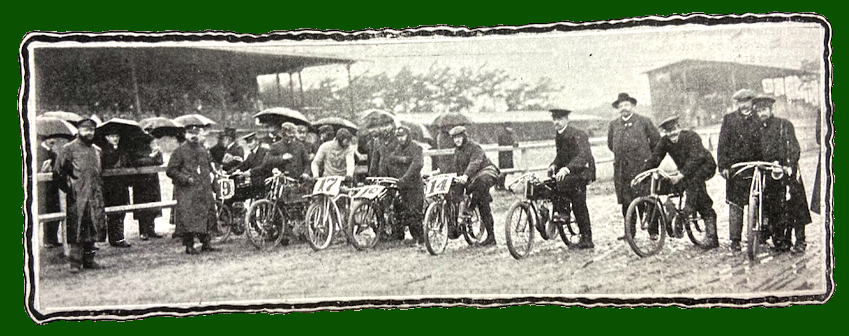
“ONE GENERALLY EXPECTS TO find something sensational in the columns of the halfpenny Press, but as a choice specimen of clap-trap the following culled from the Evening News would be difficult to beat. The paragraph is headed ‘Bullet-proof War Cycles’ and says: ‘The German War Department has given instructions for the manufacture of 100 motor-cycles of a peculiar character for scouting purposes. The wheels are protected by a covering of steel sufficiently strong to stop the ordinary rifle bullet. The motive tower is to be a small battery capable of carrying the machine 100 miles without recharging.’ Here then we have what thousands of people are waiting for. The idea of a small battery storing a vast amount of electrical power is delightful. The best that has been done up to this discovery is a battery scaling about 1½ tons. Edison will assuredly now have to look to his laurels. The pity is that so many people believe such stuff as the above, and immediately worry the motor papers as to where such machines can be obtained, and full details as to price. We have only to say that the millennium is not yet!”
“THE FLYING KILOMETRE TRIALS organised by Le Monde Sportif, which were to have been held at Dourdan last Thursday, were unfortunately interrupted and finally stopped by persistent rain: only a few trials could be run off, the remainder being postponed till Thursday next…the trials were open to all classes of motorcycles and cars, tourists and racer alike. One hundred and seventeen entries were received, including 57 motorcycles…The course selected was a country road about two miles from Dourdan with a good surface, free from curves, and some 40ft in width; sloping banks on either side afforded an ideal vantage ground for spectators. The events completed last Thursday included the touring motorcycle class…Results as follows (¼ litre cylinder capacity): 1, Momo (Peugeot), 47⅕sec); 2, Lanfranchi (Peugeot), 48sec; 3, Sencier (Moto-Cardan), 49⅖sec.”
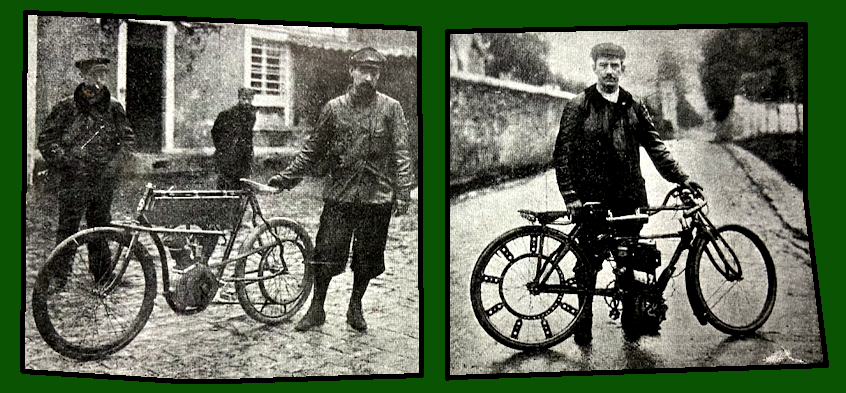

“THE LION CYCLE CO, London Road, South Lowestoft, have just introduced a new form of expanding brake for motor-cycles. There is a shoe made of steel which embraces nearly a third of the circumference of the belt rim. This shoe is lined with leather or fibre and is put into action by means of a lever movement which can be operated by hand or foot. One end of the brake shoe is secured by a flat spring to a clip which grips one of the back stays. At the other end there is a lever movement which causes the shoe to expand and grip the belt rim. The makers claim that the brake has been thoroughly tested and will hold a fore-carriage with two heavy riders on the steepest hills with ease.”
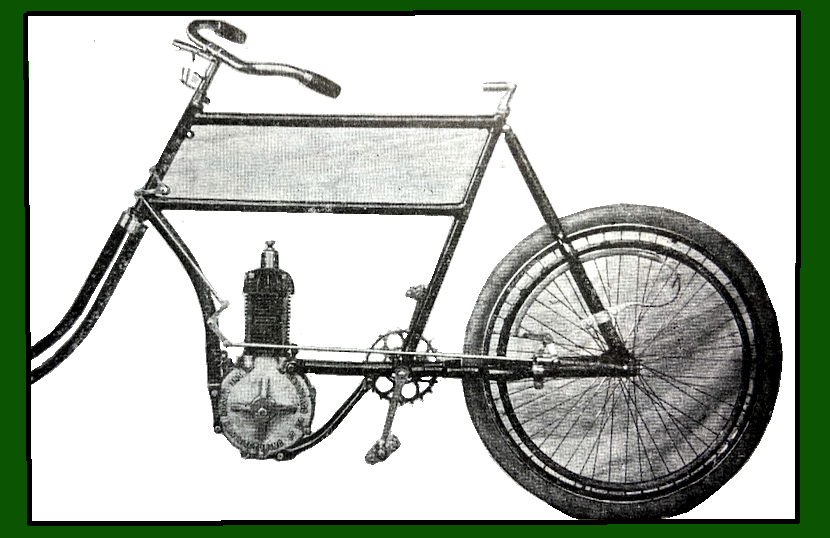
“ON FRIDAY WHEN AT the works of the Centaur Cycle Co, Coventry, we were afforded an opportunity of inspecting the new motor-bicycle introduced by that company. The most notable feature of the machine is that the engine is built up as part of the frame. This is arranged by the method of bolting the silencer to the bottom of the head-tube, and thus dispensing with the down tube. The engine is of 3hp, with mechanically operated valves, and it is claimed that the position of valves and silencer is so arranged as to allow of the maximum cooling effect being attained.”
“THOSE OF OUR FOREFATHERS who were responsible for such roads as the one up Westerham Hill cannot be congratulated on their ability as road engineers. There is no earthly reason why the gradient should exceed one in fifteen anywhere if it had been properly laid out. Horses and motors suffer alike, and it is a wonder some of the former do not drop dead under the strain of hauling loads up one in seven for a considerable distance.”
“‘WHY DO I BELIEVE in a powerful engine?’ said a well-known cyclist in response to our query. ‘Because one has power in reserve. Even if the engine be of high horse-power it is possible to run it at moderate speeds by retarding the sparking or closing the throttle. Where its advantage lies is, of course, in tackling stiff hills or in facing head winds. And the glorious knowledge that you have high speed when required! Yes, big engines have their disadvantages, but their advantages far outweigh these.’ Thus speaks a motor cyclist whose experience dates back to the earliest days of the 1¾hp front driver.”
“THIRTY-NINE MOTORCARS and 54 motor-bicycles were observed to pass through Redhill on the Brighton Road between nine and one on the morning of Sunday, October 18th: during the same hours 34 cars and 34 motor-bicycles passed through Reigate.”
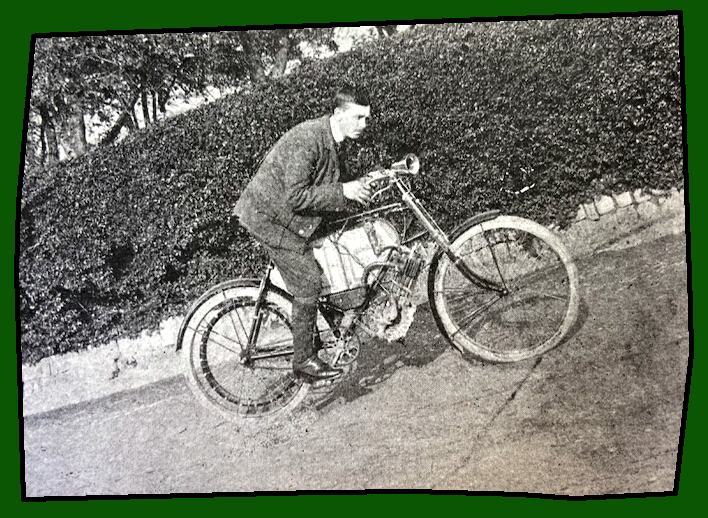

BRADBURY & CO WILL SHOW ‘Peerless’ motor-bicycles. These will be fitted with 2¾hp motors instead of 2½hp as formerly. Two accumulators will be fitted, also an improved contact breaker, ratchet levers and many small detail improvements…Bransom, Kent & Co will exhibit their novelties. The new Longuemare carburetter with automatic air regulator will be a strong line, and the firm are also showing an automatic air regulator that can easily be attached to existing carburetters. The BK auto-trembler for converting non-trembler coil to trembler is a speciality and also dead beat voltmeters will be shown…The new patent two-speed gear and free engine will be Phoenix’s leading item in the way of novelties. This gear is claimed to be the simplest form of two-speed gear yet made. It is entirely dust-proof, but every part is easily accessible. In the many severe tests which have been given to the gear it has always kept absolutely cool: in fact, after a five miles’ run on the low gear all the time the gear was cold. In the ‘Phoenix’ special spray carburetter it is impossible for any dust to penetrate to the interior. All the air necessary for the carburetter is drawn in through one gauzed funnel running close to the engine. The adjustment of mixture and throttle is automatic, while the spraying nozzle is made adjustable. The petrol and oil gauges (registered) are let into the side of the tank, enabling the rider to see at once the quantity of oil and petrol in the tanks. The improved combined stand, carrier and mudguard answers the usual purpose of a carrier, but when in use as a stand it carries with it the top of the mud-guard, thus leaving the tyre easy of access for repair…The Raglan Cycle Co are introducing a motorcycle for 1904 which, by reason of its many good points and special features, promises to rank amongst the first flight. It has a 2¾hp engine, a special float feed spray carburetter and belt transmission. It is worked by two levers situated on the top tube, actuating the throttle and the ignition, which is by wipe contact. An exhaust valve lifter is fitted and actuated through the medium of a Bowden wire terminating in a pull-up lever under the right handle. An extra tank is fitted into the back part of the

frame which will contain a gallon of petrol…The Bowden Patents Syndicate will be showing a large variety of improvements especially connected with the Bowden motor-bicycle. The special feature about this machine is the Bowden chain drive and friction clutch which has proved so successful, and is still further improved for 1904. The firm’s handlebar control system by the Bowden wire transmission is certain to prove a highly interesting exhibit. The throttle valve, spark advance, valve lifter, front and rear wheel brakes and clutch and automatic circuit breaker are all wire controlled. A clever development of the Bowden principle is the firm’s new flexible tube for oil or petrol connections. This obviates the nuisance caused by the fracture of rigid copper pipes by vibration. The 1904 FN engine of 3hp will be fitted…Chas Peacock & Co, Clerkenwell Road, London, EC, have many novelties for 1904. A new 4½hp motor, with twin cylinders will be very suitable for driving fore-carriages. The workmanship throughout is very substantial. The crank case is provided with clamps for attachment to a loop frame. A new style of accumulator will also be shown. This has many good points; for instance, the positive plate is of a deep ribbed section, and formed by the Planté process, giving very great capacity and strength. The terminals are of a non-corrosive metal, and the vent is made perfectly acid-tight
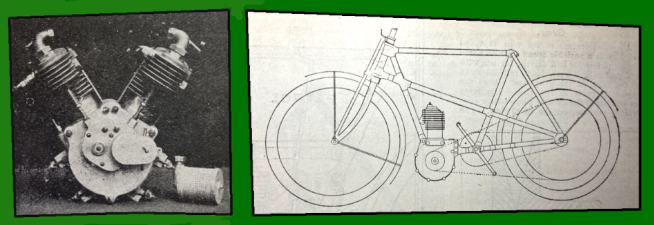
by an ingenious arrangement…The exhibit of motorcycles on the Crypto Works Co’s stand will consist of three specimens of two different model motor-bicycles, and two specimens of the Crypto tri-car. The new pattern Crypto bicycle has been designed to fill the requirement for a comparatively light bicycle with ample engine power. The frame is exceptionally strong and symmetrical. The engine fitted is a 2½hp Peugeot. The whole machine weighs 100lb. The other motor-bicycle will be of the now well-known Crypto type, fitted with a 3½hp MMC engine. This machine is specially suitable for racing and for trailer and fore-carriage work…A special feature of the 1904 Princeps machine is a variable speed gear and free engine pulley for belt driving for use with a V-pattern belt; it gives a ratio of 25-30% in the gear, and allows the engine or cycle to run free. The lever for operating the gear is placed in a convenient position on the handlebar. The pulley flanges are made in two parts, the inner one being fixed to the shaft and the outer one allowed to move laterally on four studs by means of a 2in-pitch triple-threaded worm operated by a ratchet lever on the handlebar. By moving the lever so that the flanges of the pulley come together, it gives a large diameter driving pulley and consequently a high gear, and by allowing the flanges to separate, the diameter of the gripping surface of the pulley is decreased, giving a reduced gear. By separating the flanges to their full ex-tent the bolt drops on to a loose ring and allows the engine to run quite freely, or the machine can run with the engine stationary. By this arrangement the rider is enabled to reduce the gear according to the work the engine is required to do. This is a distinct advantage over other two-speed gears, as in this case the low gear has to be low enough to take the stiffest of hills. A good feature of this

variable gear is its comparative simplicity and certainty of action…The 1904 Brown motor-bicycle will be made in three powers, viz, 2hp (64x70mm) [225cc], 2¾hp (74x80mm) [344cc], and 3½hp (82x90mm) [475cc]. The prices of these will be £38, £42, and £49 respectively. The motors are fitted with mechanically operated valves, and the fly-wheels are ¾in larger in diameter than formerly. The new Longuemare carburetter is fitted, also an improved exhaust lifter. The machines are all fitted with a combined girder and triple head. There are many improvements in the tank details, and an additional compartment is provided for a spare battery. The silencer is also made on improved lines…Perhaps the lowest priced motor-bicycle yet introduced is the £29 machine manufactured by the Noble Motor Company, of Pocock Street, Blackfriars, SE. The engine, of 2½hp, is of original design. Petrol capacity is 1¾gal, and room is provided in the tank for two accumulators. A L’Eclair trembler coil is fitted with a wipe contact. The carburetter is a D&R fitted with a throttle which is regulated by a lever easily reached by the rider. The lubricating pump can also be easily operated while driving. The machine is well finished in black enamel, or an aluminium finish can be had for an extra 10s…The Rover Cycle Co will show their 1904 motor bicycle. It has a 3hp motor fitted vertically in a special cradle. The inlet valve is mechanically operated. The ignition is by brush contact and trembler coil and two accumulators are provided, the two way switch being fitted on the forward part of the horizontal tube. Transmission is by V-shape belt. The frame is exceptionally well-stayed by a double down tube and a series of tubes at the crank bracket. The front forks are of the
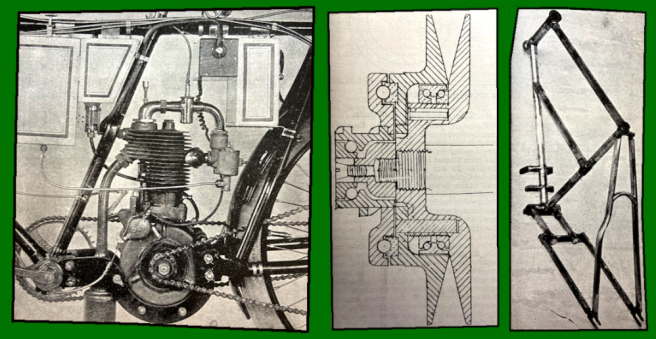
duplex pattern. The motor cylinder and head are cast in one piece, and a special paraffin valve is fitted. The sparking plug is placed vertically .over the inlet valve. The case at the rear of the frame carries the accumulator and the coil…The special feature of the Eadie motor-bicycle is the design of the frame. The chain stays are quite straight, without any lugs, giving great strength, and enabling the wheel to be easily removed. Another advantage is that it is easy for the assembler to manipulate the fittings, as there are no cranked lugs to braze and ample clearance for the belt drive is also provided within the stays…Mills & Fulford will have a large and interesting display of side-cars, fore-cars and trailers. There will be several new designs of fore-cars with improved steering on the lines of a motor-car. An entirely new pattern will be one intended for tradesmen’s use, fitted with a box or hamper for the delivery of goods. Side-cars will be shown fitted with the firm’s new steering system, and others with compensating joints. The County Chemical Company will have a complete exhibit of lubricating oils, calcium carbide, celluloid cement, picric acid, rubber solution,

enamels, lacquers, motor grease, belt dressings, and a. new searchlight inspection lamp; and, in fact, all materials for motor purposes…The Rising Sun Motor Co will exhibit the Westfield Autobike. This has a motor with cylinder 74x78mm [335cc] 2¾hp, large fly-wheels and long bearings. The regulating gear is controlled from the handles. The silencer is of special design and two brakes are fitted, viz, a band brake in the rear hub and a rim brake on the front wheel. The front forks are duplex and of great strength. Two-inch Clipper motor tyres are used, and extra wide mudguards with front extension. The makers can supply a variety of sizes of driving pulley to suit various classes of work such as fore-carriage work, ordinary road work and racing. These pulleys are interchangeable and detachable. A special 3½ model is also made…Messrs Strauss & Co of Upper Thames Street, London, EC, will be exhibiting the Fafnir motor. It is a well designed motor, made in two sizes for motorcycles, viz 2¼ and 3hp, these being 70×75 and 75x80mm bore and stroke [288 and 353cc respectively]. The exhaust valve is fitted with a governor. The cooling ribs are larger and more numerous than usual, and cylinder and head are in one piece. The ignition is by a plain make and break. The FN carburetter is fitted, and also an extra silencer. The weight of the 2¼hp is 38Ib, 3hp 40lb…The Clarendon Motor Car & Bicycle Co, of Coventry, will exhibit 12 of their 3hp ‘Clarendon’ motor-bicycles, having decided to make this machine, a standard pattern for 1904. All machines made by this firm will be fitted with their patent adjustable outside pulley bearing which has been improved for next season. A specially designed 3hp engine is fitted, the bore and stroke being 77x81mm [377cc]. A mechanical inlet valve is one of the improvements for next season, also an effective silencer…A motor-bicycle fitted with a 5½hp air-cooled De Dion engine is especially built for fore-car work. Bicycles built from Chater Lea fittings, and fitted with 3hp Fafnir engines will also be exhibited. These are retailed at 30 guineas by Messrs May Brothers, of Clapham Road, London…The Triumph motorcycles will include 2½hp and 3hp machines, and also a fore-carriage with
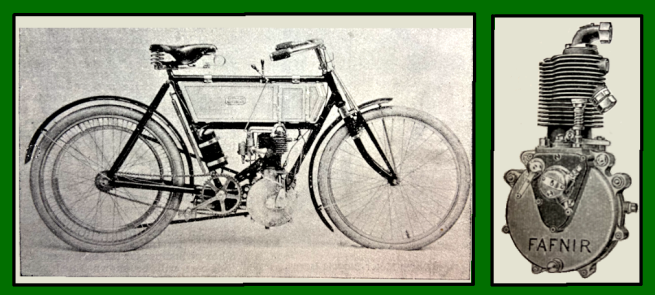
water-cooled motor. The standard pattern machine motor is 70x76mm [292cc] and provided with a Dunlop silencer and exhaust valve lifter. Twin accumulators with two-way switch and Bassée Michel coil are used. Transmission is by V-belt. Wheelbase is extra long and girder forks are fitted, the weight comes out at 120lb. The 3hp machine designed for heavy riders and hilly countries has a motor 75x80mm [353cc] and Longuemare carburetter. Transmission is by a V-belt. Two accumulators and double switch are fitted. The contact is an improved make-and-break pattern. The motor is fitted in a low central position; a rear band brake and front rim brake are provided. The wheels are built up with extra stout spokes and fitted with 26×2¼in Clincher tyres. The petrol capacity is 1½ gallons. All control levers have ratchet adjustment. The fore-carriage motor will be provided with a honeycomb radiator…Messrs Alldays & Onions will have an interesting exhibit of their new pattern motorcycles and fore-carriages, made throughout by Messrs Alldays & Onions, and all parts are interchangeable. The frame is designed with a special cradle (registered) for carrying the motor in an upright position. Lugs are provided on the crank case which correspond with faces on the cradle, and are securely held by four bolts. This invention affords great strength to the frame and rigidity of the motor and obviates the necessity of clamping to or bending tubes. The tank has compartments for two accumulators, coil, lubricating oil and sufficient petrol for 160 miles. A float register is provided and always visible for showing the quantity of petrol in the tank. The weight of the machine complete does not exceed 110lb. The machines fitted with fore-carriages are strongly built, and a specially designed frame is constructed for carrying a well-finished and smartly upholstered bucket seat…A distinctly novel feature of the Quadrant Tri-car is the use of two separate motors of 2½hp which can be run singly or together simply by moving a foot lever. This feature of employing two motors gets over the difficulty of cooling a large single motor. The transmission is by means of a V-belt from each motor driving on to each side of the back wheel. The carburetter used is the ‘Quadrant’ surface type, and has a capacity for two gallons of petrol. Twin accumulators are used. The back wheel has a Quadrant back pedal brake and the side wheels have band brakes actuated by Bowden wires. The driving tyre is 2½in and side wheel tyres 2in diameter. The front carriage is coach built and is suspended on extension coil springs. The principal spring is adjustable to different weights. Footrests with rubber mats are provided…The Enfield Cycle Co have now equipped an entirely separate factory for the production of motorcars and motor-bicycles, and from this it will be seen that the Enfield Company do not look upon motor-bicycles as a ‘side line’. The Royal Enfield
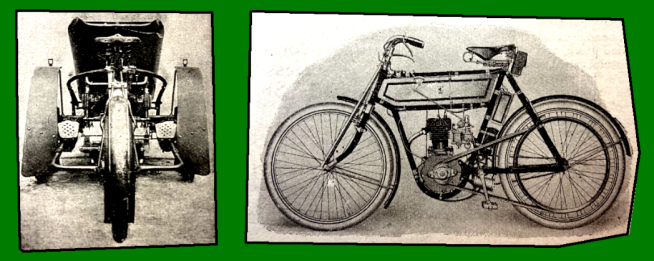
belt driven motor-bicycle is equipped either with 2¾ or 3½hp vertical engine, spray carburetter and specially large silencer. Great attention has been devoted to the strength of the frame and front forks, and the bicycle has a very handsome appearance. The Royal Enfield chain-driven motor-bicycle is a machine which attracted so much attention at last year’s Show; the engine, which is made by the Enfield Company, is of the vertical type 2½hp, and one of the chief features of this bicycle is that only a single driving chain is employed…Werner Motors will exhibit their new models for 1904. Their exhibit is always looked forward to with special interest, as having been engaged in the trade from its very commencement, they are responsible for the introduction of many of the leading features now adopted in the generality of motorcycles. Originality has always been a remarkable feature in their productions, and this year 12 distinct improvements will be introduced, several of which are of a very important character. Two types of machines will be marketed of 2½ and 3¼hp. The engines are of an entirely new design, and are fitted with large fly-wheels and a new style of carburetter which is automatic in action and gives remarkable results. An entirely new device for providing a free engine will be a conspicuous feature of these machines, and a special arrangement of the engine pulley will render the possibility of belt slip very remote. The frame of the machine is longer than in last year’s patterns, and the front forks are stayed on the girder principle. Special attention has been paid to the brakes and a new system for the one on the back wheel will be shown. The new silencer is of larger dimensions and of different internal construction in order to give maximum efficiency with the higher-powered engines…Hobart, Bird & Co will exhibit three motorcycles fitted with their standard 2¾hp engine, and one fitted with a larger engine, viz., 3¼hp. The makers have somewhat altered the design of the frame for the coming season to secure larger tank capacity, whereby they are enabled to enclose the petrol, the oil, the trembler coil and two accumulators of ample size. Important and original novelties have been introduced, the chief of which is an emergency handlebar control. This consists in the adaptation of an inverted lever on the left handlebar, by which three operations in succession are performed. First, the electric circuit is broken; secondly, the exhaust valve is lifted; and, thirdly, a ,powerful Bowden brake is applied to the rear wheel. This arrangement allows of either operation being executed alone, or in combination…An engine on quite original lines, designed for fitting to full roadster bicycles, is the Faceler; it has a chain drive through a spring mounted gear wheel. The special features of it are: arrangement of fly-wheels and gearing so as to give a narrow crank case. Intermittent motion of second shaft, giving quick opening of valves without use of cams. Inlet valve opening automatically, closing mechanically. These engines
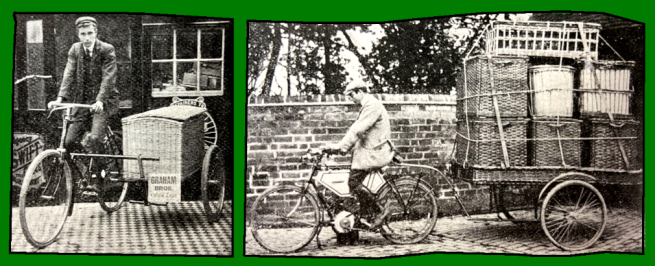
will be manufactured for the trade by the Faceler Motor Syndicate. They are of 2hp, and it is claimed that by their use an ordinary roadster bicycle can be transformed into a fully-powered motorcycle…When our humorous artist, Percy Kemp, contributed a sketch to Cycling depicting the delight of a household goods remover who, having secured a 2hp motor-bicycle, attached it to a loaded pantechnicon, he was only looking well ahead. Two illustrations on this page depict the motor-bicycle put to utilitarian uses. One shows a side attachment to be used as a tradesman’s carrier which has been introduced by Messrs Graham Bros, Church Street, Enfield, N. The other shows a carrier trailer in use by Mr Max Lindner, of Hanbury, near Bromsgrove, who runs a poultry farm for show and utility purposes. His machine is a 3hp Quadrant; the trailer is 6ftx4ft 6in, by Mills and Fulford. The photo shows a load of empties with a crate of fowls on top. As the farm is a long distance from any railway station, Mr Lindner finds his motor and trailer extremely useful…The Anglian motor-bicycle is manufactured by the recently formed Anglian Motor Co, of Beccles. The engine is a 2¾hp De Dion, and the latest pattern De Dion float-feed carburetter with throttle is fitted. Lubrication is effected by a sight-feed pump that can be easily operated while the machine is being ridden. Transmission is by heavy Lincona belt. Two four volt accumulators are supplied, one as spare, and a Bassée & Michel coil. Control is by switch handle on the left and Bowden twist handle on the right, operating an exhaust valve lifter. The price complete is £60. Lamp, horn, combined stand and carrier, spare parts and a full kit of tools are included, and other advantages such as self-sealing air tubes are in the specification. One of ‘ours’ had the privilege of trying the machine on some Surrey roads. The bicycle ran marvellously well, and with perfect steadiness over some greasy stretches, and when a dry surface was reached, gave full evidence of possessing all the power that a speed man could wish. It mounted a long tricky hill, with sharp turns and a rather loose surface, without pedal assistance, leaving behind a motor-cycle of a different make rated at the same power, which failed to rise to the occasion and had to be pushed to the top. Over heavy roads it made light work of a trailer with passenger…Griffon Motors’ exhibit comprises a range of 1903 pattern Griffon motor-bicycles fitted with the special Griffon 2½hp motor, combined spark and exhaust valve lever, special girder forks, copper tank, containing accumulator coil, and capacity for one gallon of petrol and one pint lubricating oil, new pattern plug, and special front and rear wheel brakes. Weighing complete only 110lb. Also the new 1904 pattern Griffon 3hp motor, with new mechanical inlet valve, automatic Longuemare carburetter and spring forks. There will also be shown the identical Griffon on which Lamberjack won the Chateau-Thierry Hill Climb and the identical Griffon on which Demester won the Circuit des Ardennes…Special lines to be exhibited by the Simms Manufacturing Co include the 1904 pattern 2¾hp bicycle motor fitted with Simms-Bosch magneto ignition, one of which will be shown running on coal gas, and one fitted to a motor-bicycle complete. In addition will be shown the new 3½hp Simms bicycle motor fitted with the Simms-Bosch ‘Arc-light’ (high-tension) magneto ignition, which the makers claim as one of the greatest novelties for the coming sea-son. This system of ignition consists of a magneto machine which produces a ‘jump’ spark without the aid of a coil, the machine forming a complete outfit in itself. Further, it is fitted with a lever by means of which the spark may be advanced or retarded. It is also applicable to any motor, as all that is necessary is to arrange a suitable rotary drive, and connect one wire from the terminal to ignition plug. One of these 3½hp motors will be shown fitted to a Chater-Lea frame with Mills and Fulford fore-carriage…A 3½hp chain-driven motorcycle will be one of the prominent features of the Raleigh display. All taps and levers are dispensed with, the machine being controlled from the handlebar by means of twisting handles and Bowden wire. The engine is fitted with a governor which allows the machine to be driven from a mere crawl up to 35mph. The machine may be controlled entirely by the use of the governor only, the elasticity of the engine being remarkable. The drive is by a Hans Renold motor chain from a spring clutch on the engine pulley to a countershaft, and from thence to a spring chain wheel on the driving wheel. The drive is very resilient and absorbs the vibration. The 2¼in tyres, exceptionally long wheel base and a specially sprung motor saddle help to make the machine as comfortable as is possible even on bad roads. The weight complete is 145lb. Two accumulators with two-way switch are provided. The new Raleigh-patent two-speed gear may be fitted to machine if specially ordered. No

pedals can be fitted however. A 3hp belt machine on similar lines will also he exhibited, and whilst catering for those who pin their faith to the belt drive, is also a cheaper model. Another novelty will be the ‘Raleighette’ three-wheeled motor tandem with fore-carriage. It is fitted with a 3¼hp water-cooled engine, with chain transmission and the two-speed gear, which enables the machine with two passengers to climb any hill without over-heating the engine. The front seat or fore-carriage is entirely suspended on springs, whilst the back seat and the tanks are so arranged that a lady can drive. Pedals are dispensed with as these are unnecessary, footrests being provided for the feet. The engine is started with a handle and thrown into gear by means of a leather-faced clutch, actuated by means of a pedal worked by the left foot, whilst the right foot pedal puts on the brake. Two band brakes on the front wheel and a rear rim brake on the driving wheel are provided. A 2hp chain-driven motorcycle and a 2hp belt-driven machine, both of their selling at a very moderate price, complete the exhibit…The Clyde Motor Car Co are showing their standard 2¾hp model, with many improvements in detail in connection with the valve mechanism, advance sparking, etc. They are also introducing a new type 3¼hp (nominal) for 1904, air or water cooled; this engine has been tested to develop 3¾hp and is fitted with a new arrangement for make-and-break contact provisionally patented. Magneto ignition is fitted on all models, but the makers have arranged to fit the ordinary high tension where customers prefer same. The Clyde fore-carriage is made with a new attachment for motor-bicycles which is de-signed to give great rigidity. Another new feature is an internal expanding drum brake with compensating arrangement…AC Davison, Camden Road, London, N, and Viaduct Works, Coventry, will exhibit 2 and 2¾hp Davison motor-bicycles featuring magneto ignition and a new system of handlebar control by which two or more levers can be conveniently operated by the thumb of one hand. A new trussed front fork made on scientific lines will be shown, with all the members straight and directly in the lines of stress. The Davison self-lifting motor-bicycle stand and patented system of petrol and oil gauges will also be shown…The Motor Manufacturing Co’s exhibit includes the MMC 2¾hp bicycle motor with automatic inlet valve, loose head and cylinder in one casting. The 1904 water-cooled MMC 4hp bicycle engine, de-signed specially for fore and side-carriage work, trailers, small boats, small cars, suitable also for many other purposes…Mr Stephen A Marples will exhibit a complete’ machine, called The Mercury. It will have a 2½hp engine, spray carburetter, and will be exceptionally light in weight. It is offered to the trade only at a particularly low price, less tyres. Engines of 2½hp will also be on show, and these like the bicycle are manufactured by a leading French firm…A non-slipping band of excellent quality will be shown by Messrs W&A Bates, of Leicester. It is called the HB pattern. One of our staff has ridden a machine. with this band fitted to a back tyre during the season, and has reason to speak highly of its wear-resisting powers and non-slipping efficiency. The firm is making a feature of prompt repair of motor tyres, and such work could not be placed in better hands…The Kerry motor-bicycle will be well in evidence at the Stanley, on the stand of The East London Rubber Company. For 1904 three powers of engine will be available, 2¼hp, 2¾hp and 3½hp. These will be absolutely upright and will be shown hung on the bottom tube, fitted in a loop frame, and bolted into a cradle. The workmanship and finish will be right up to the well-known Kerry standard. Improvements have been made in connection with the timing gear, gudgeon pins and a contrivance to prevent leakage of oil from crank chamber…The South British Trading Co will show the Vindec Rapid motorcycle, a new machine possessing a number of novel features. The FN engine and carburetter are used. The engine is 2¾hp, 70x80mm [308cc], set vertically in a specially constructed frame built to stand vibration without weakening the joints. The forks are very substantial, being continuous with the handlebar, thus making breakage at this point impossible. A novel hinged rear mudguard greatly facilitates the removal of the rear wheel. The cylinder is designed to give great radiating surface, particularly around the inlet and exhaust valve. Another special feature is the tank, which is so constructed as to contain separate compartments for the petrol, lubricating oil, accumulator and coil; each compartment being a complete structure in itself, thus making leaks or rattling impossible. Both front and rear band brakes are fitted on the hubs. The levers which actuate both brakes also either cut off the electric current or lift the exhaust valve before applying the brake…Messrs JA Prestwich’s display will include several machines made up of the various component firm’s parts, fitted with the JAP motor sets, namely, 2½hp inclined motor with surface carburetter; 2½hp inclined with spray carburetter; 2½hp vertical motor with spray carburetter; and also the new 3½hp. motor. This engine has several new features. The valves are placed on top of the cylinder, and are secured by one central stud. The
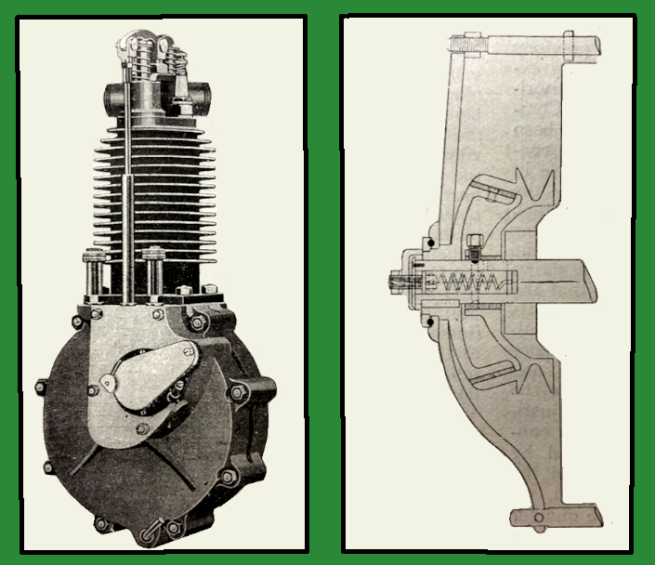
unions can be twisted in any direction to facilitate fixing of various silencers and carburetters. The valves are worked by a single lift rod. All long ports have been avoided, and the least possible area in the combustion chamber is exposed to the flame, and the exhaust cases are carried away from the cylinder on leaving the exhaust valve; thus the engine will keep cooler than with the usual arrangement of valves. The inlet valve is operated mechanically without extra mechanism…An extensive display of ‘Motorities’ will be made by A Dunhill. These include all kinds of motor clothing, and motorcyclists will be interested in the new ‘hand protector’ which obviates the necessity of wearing gloves. As riders well know, it is not possible to have the same control over the machine with a thickly gloved hand. The new protectors are of leather, fur-lined. Motor lamps and headlights will form another interesting exhibit, particularly the new ‘Duplex’ headlight. This is an acetylene lamp of 2,500cp with a double lens. The Dunhill speed indicator is sure to prove an interesting item. There are two sizes registering up to 28 and 42mph…One of the chief features in the new Riley Moto Bi is that the inclined engine of old is discarded and the more popular vertical position has been adopted. This is effected by a patented design of attachment. The system is a neat and effective one, and owing to the rigid manner in which the engine is fitted, vibration is reduced to a minimum. Another special feature is that the engine fitted will be made expressly for the company by the Riley Engine Company, Coventry, embodying a narrow crank case in conjunction with bearings of great width, valves of substantial proportions, mechanically operated on a system recently patented by the Riley Engine Company. The fittings comprise a Longuemare carburetter, two P&R. accumulators with unspillable electrolyte and Bassée-Michel trembler coil. The Riley Moto Bi will be made in 2¼hp and 3½hp, this latter is specially designed for fore-car, etc, use. The company are exhibiting two new designs of fore-cars, also side cars, etc, completing a most comprehensive programme for the coming season…The J&B clutch is supplied by the Central Rubber and Cycle Accessories Co, Norton Folgate, Bishopsgate, London. The clutch consists of a metal driving pulley, recessed so as to also form the female portion of clutch. It is free on the engine shaft and is bushed with phosphor bronze. The male portion of the clutch is leather covered and is kept in contact by means of an internal spiral spring in the outer end of the shaft which is bored out to receive it. This male part is held to the shaft by a feather, but is free to slid laterally on the shaft. The clutch is operated by lever and wire from the handle-bar, and a suitable arm on the clutch is connected therewith; the clutch is drawn out by pressing a lever on the handlebar. A ball race takes the thrust when the arm is out, and the thrust on the clutch and pulley, caused by the internal spring, is overcome by means of a groove turned on the spindle in which three set screws (which are screwed through the boss of the pulley) run. This invention can be applied to any existing engine. For high-power fore-carriage motors this clutch should be specially adaptable.”
“SHOW TIME WHICH IS WITH US this week, is a much more interesting period with motor-cyclists than it is to those who confine their attention to the push-bicycle. The two and three-wheeled self-propelled machines have developed wonderfully during the past twelve months, and those who examined them last year and then deferred taking an active interest in them will be astonished at the strides made in so short a time. Even I was surprised the other say when I was reminded that it is not a year ago since the fore-carriage was introduced, yet the three-wheeler has passed through quite a number of stages of development since then…The newest design in two-seaters—the side-carriage—suggested by one of our artists as a joke and nothing more, has become quite a popular little vehicle, yet it appears in an exhibition for the first time this week, and, moreover, it will be shown in its improved and most up-to-date forms. Truly, we are moving quickly, demonstrating to our foreign rivals that we are neither slow in appreciating a good thing nor lacking in ability to develop it to its fullest extent. It is very evident that chain transmission, free engines and variable gears will be the features of the Shows, and thus we shall see the motorcycle more like a car than it has ever been.”
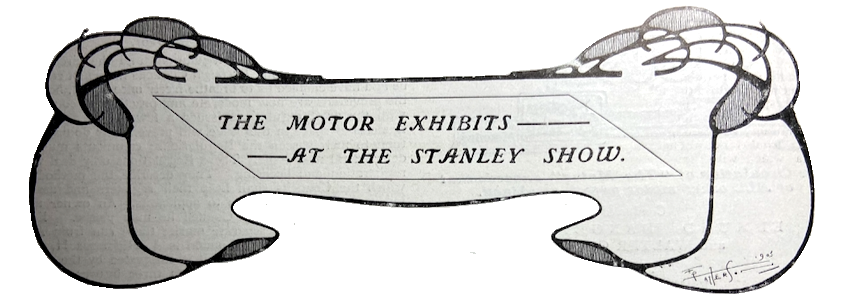
“MINERVA MOTORS, HOLBORN VIADUCT, EC, are making a complete display of Minerva motorcycles. For 1904 there are three sizes of engine, the 2hp, the 2¾hp and the 3½hp, and each size can be obtained for either the upright or inclined position. We must say that we have not hitherto been at all sweet on curved tubes, whilst the attempt at securing symmetry was apt to look over-done, but the machine with the engine placed vertically, when seen in actuality, presents a particularly neat and workman-like appearance—as a matter of fact the curved diagonal offers structural advantages at the bridge piece and in the space between it and the mudguard for a tank or shaped tool-bag. All Minerva engines have mechanical valves, this improvement having been a great success. Elswick Cycle & Motor Co, Newcastle-on-Tyne. This firm shows a twin-cylinder engine of 4hp, which they claim to be lighter than the ordinary
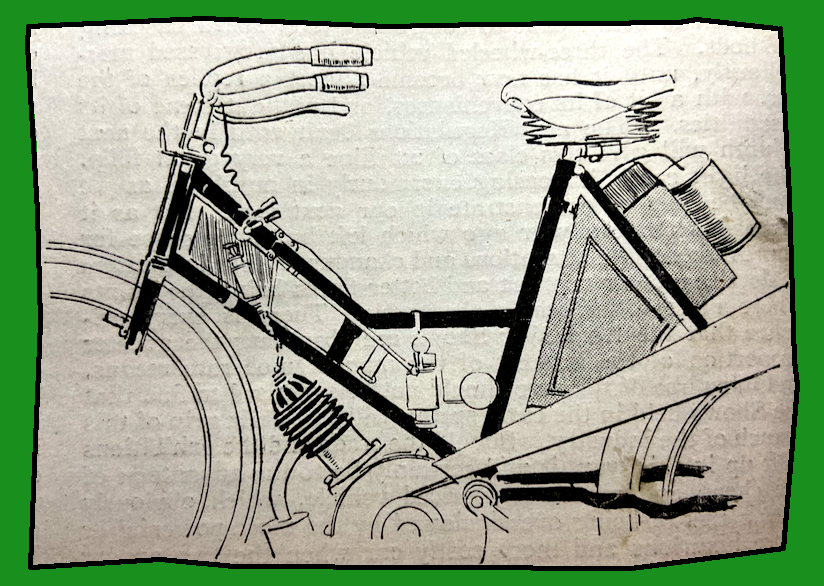
single engine: it is built into a specially constructed frame of the loop pattern. Provision is made for using either one or both of the engines at the same time. A special form of carburetter of the spray type is used. The front forks are worthy of consideration, differing from the usual form of the duplex type in that the side; tubes are joined together over the tyre and form a single tube which is attached to the head by a strong fastening. This makes a very neat form of strengthening the front forks. The brake is of the compensating type, and double in action. Bransom, Kent And Co, Goswell Road, London, stage eight motorcycles, including a trailing car. The BK motor-cycle is made in three sizes, 2, 2¾ and 3½hp. These are all fitted with mechanically operated valves, Minerva-Longuemare carburetter, V-belt and improved spark-plug and silencer. The frames are built throughout with the firm’s own fittings, extra long wheel base and girder front forks. The mudguards are extra wide, with extended front, and Lynett’s La Grande motor saddle is fitted. The makers can supply either a- vertical or inclined position for the motor. One of the machines is shown with a handsome aluminium finish, the others being part aluminium and black enamel finish. The trailer is a smart-looking little vehicle, at a reasonable figure. The Jehu Motor Co. The well-known Jehu motor-bicycle is shown in several powers, most of the specimens on view having free engines and chain drives. In the pattern with direct chain drive the clutch is on the engine pulley and is operated by a lever on the left handle grip by means of a Bowden wire. Another pat- tern has a short chain from the engine pinion to a countershaft behind the bottom bracket, the clutch being situated on the countershaft, from which another chain (giving a further reduction in speed) runs to a pinion on the road wheel. All engines are vertical, and are dove-tailed into the frame. Werner Motors, Regent Street, London, W. The founders of the
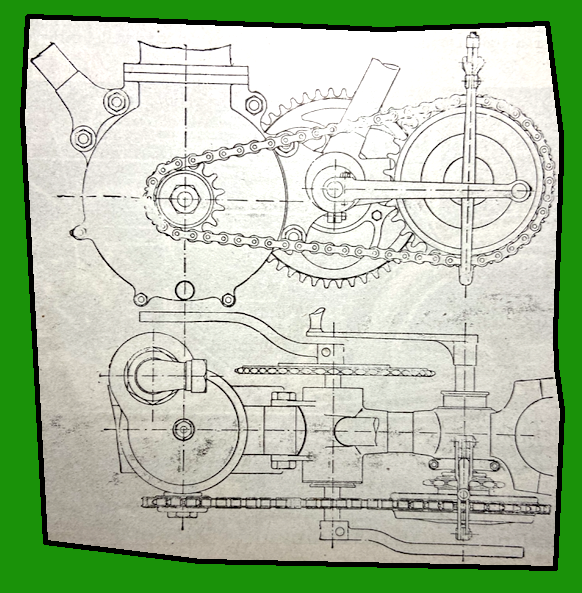
motor-bicycle industry are well up to date—the new Werner simply bristles with improvements. The powers for 1904 are 2½ and 3hp. The combustion and valve chambers are cast in one piece with an air space between, and radiating flanges completely encircling the valves. The carburetter is situated in the tank, an inspection door hiding it from view. A free engine is obtained by expanding the. flanges of the engine pulley to enable the V-belt to slip on a free running ring. The bracket spindle is divided so that both cranks can hang down together, giving a comfortable ‘freeling’ position. Directly the left pedal is released, a spring in the bracket brings it back to its normal position for pedalling. The inlet valve is now mechanically operated, and there is a most ingenious system of regulating the speed automatically when the free engine clutch is thrown out—an electrical device causes the spark to short circuit every other revolution instead of jumping the plug. This is effected by a rotary contact piece which comes into action when the engine is thrown out of gear at the handle-bar. The compression tap is another clever device which allows a certain amount of air to be drawn into the cylinder at high speed and assists in giving a perfect mixture and cooler engine. The exhaust tube is now carried as nearly straight from the engine as possible to get the exhaust gases clear away. The ignition details are really excellent, especially the circuit breaker combined with the brake lever. One machine is shown with a substantial luggage carrier. British Steam Traction Co. A cure for all tyre punctures is shown here in the shape of Millennium, sold, in pumps, by means of which the puncture closer may be forced into the inner tube through the valve. The pump is screwed direct on to the valve stem, and is thus very convenient for rapidly inserting the preparation. A pocket electric lamp and battery at a very low price is shown. C Lohmann, Aldersgate Street, London is showing a varied range of accessories for the motorcyclist. The well-known Perfecta acetylene lame has been further improved this year: it is fitted with a really strong and practical rigid bracket which holds the lamp on both sides. The lamp is of solid construction throughout and the carbide and water containers are of ample dimensions, the lamp burning five hours on one charge. A gas bag is fitted at the back of the parabola reflector, thus ensuring a steady flame; the water valve is fitted with a wire, so there need be no fear of its becoming clogged as it can be instantly cleaned. A rubber tube connects the generator with the burner, the risk of a dangerous explosion being thereby minimised. This lamp marks a distinct advance in motorcycle lamps, and should not be missed by those on the look-out for a satisfactory article. A new design of swing crank, actuated from the handlebar, and fixed or free at will, is also shown. Several useful types of leggings and leather clothing merit attention. The Superba saddle is priced extremely moderately, whilst motor horns, goggles, funnels, and, in fact, everything requisite for the motorcyclist will be found here. The Paradox Variable Gear Co, of Lincoln, whose change-speed gear has proved so serviceable for bicycles, have now had it redesigned to suit the motor-
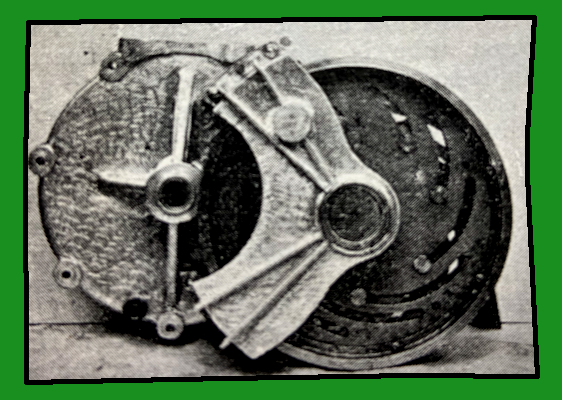
cycle. It is being made in two forms, so that it can be clamped on to the crank case of the engine, or can be screwed on to the hub. When fixed to the engine case, a small pinion is fastened to the crank shaft and engages with the spur ring which is attached to one of the changing discs. The changing mechanism is duplicated for the sake of strength, and the chain ring is sandwiched in between. The changes are easily made whilst the drive is constantly maintained—a very important factor in motorcycle driving. Seven changes of gear are provided, and a single chain communicates the power to the road wheel. In the pattern which is screwed to the hub, the power is taken by chains from the sprocket on the engine to the chain ring on the gear, a counter-shaft being used in order to get the first reduction of gear. The chain ring being contracted or enlarged increases or decreases the gear within the range provided. The change-speed for motorcycles will be placed on the market in a few months’ time, and it promises to be a very great success. Clarke, Cluley and Co, Coventry. The Globe motorcycle is the speciality of this firm, made by them throughout. A revolving float shows the height of the petrol in the tank. There is also a special feature in the contact maker—besides the usual brush contact a separate blade contact is provided, making a perfect earth, and it cannot fail to act even up to 3,000rpm. Adjustable ratchet levers for all control gear, large Longuemare carburetter, and an easy mode of obtaining access to the valves are provided. Two-way switch, high-speed trembler coil, and Invicta accumulators make up a very neat and compact machine. Price’s Patent Candle Co, of Battersea. This well-known firm has an exhibit of various kinds of oil for cycles and motors. Prices motor lubricants are guaranteed absolutely neutral and free from any oxidising or gumming tendency. Among the specialities are Motorine for air-cooled and water-cooled cylinders, gas engine oils for water-cooled cylinders, Bilmoline for axles and bearings, and Rangraphine for motor and cycle chains. Hobart Bird and Co, Coventry. The general design of this motorcycle is similar to that of the past season, but the makers have added several improvements worthy of attention. An emergency handle is provided, which is of the inverted type, and its first action on being applied is to break the connection; further application lifts the exhaust valve; and finally applies the back-wheel brake. The engine is of the vertical type and is made by the firm, as are the carburetter, throttle for the air supply, two-way switch, Lincona belt, and two powerful brakes. On the fore-carriage either a 3½hp air-cooled or 2¾hp water-cooled engine is fitted. G Goldschmidt, Green Lanes, London, N, displays an imposing array of motor lamps, horns, goggles, oil cans and funnels. The leading line is Schmitt’s acetylene lamp for motorcycles: this is complete with bracket and cleaning pin for the water valve. Its principle feature is a gas bag which feeds the burner and, it is claimed, prevents the light from failing through vibration or strong winds. JC Hencke, Seething Lane, EC. Four nicely finished belt-driven motor-bicycles fitted with the well-known Bichrone engines are the chief features here. These engines, as
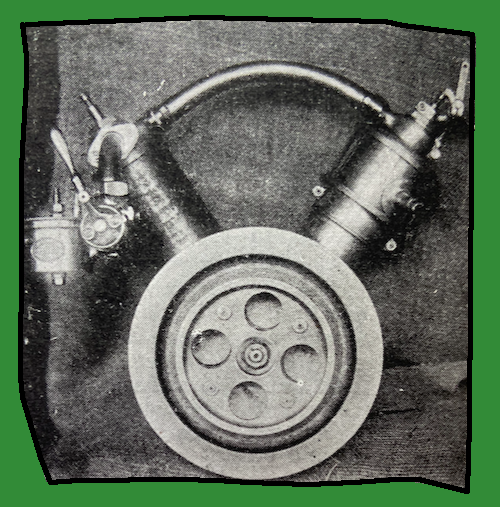
we have stated on many occasions, are made on the two-cycle system, ie, the impulse of driving is imparted at every revolution instead of at each alternate revolution as in the four. cycle or Otto types. A large number of Invicta accumulators are shown; and a new form of contact breaker of the wipe type, which works a non-trembler coil: this latter is well worthy of close inspection. Humbers, Beeston and Coventry, devote a stand entirely to their motorcycle productions and there is always an interested crowd inspecting these excellent examples of chain driving. The new introduction in Humbers is the lightweight Beeston. It is designed on Humber lines, with the engine in the inclined position, and carried by the four tubes from the bottom of the head to the bracket bridge. The engine is 70x70mm [269cc], developing 2hp. A Longuemare carburetter, wipe contact, trembler coil, two accumulators in the case fixed on the diagonal tube, chain drive through a spring friction clutch on to 26in wheels; these features of the Humber are all retained, yet the machine only tops the scale at 112lb, or a little over. This machine will sell at £50. The 2¾hp Beeston, selling at the reduced price of £55, has the free engine and clutch, with an improved clutch lever. Another improvement (there is really little or no room for improvement in the Beeston) is the fitting of an exhaust valve lifter worked from the
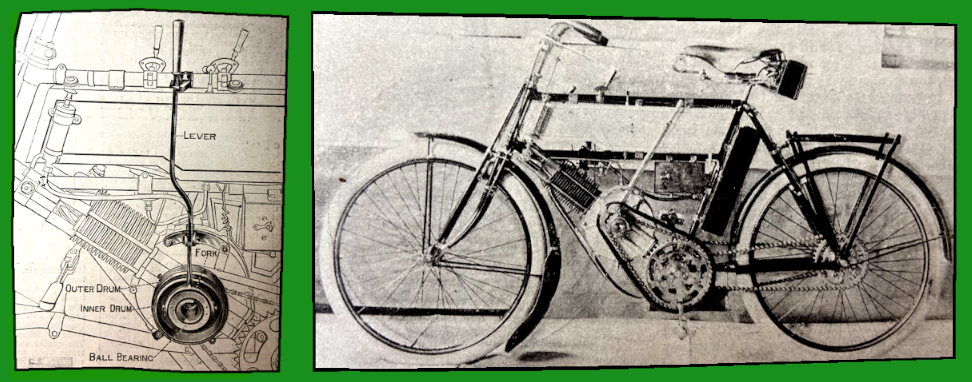
front brake lever. The Coventry Humbers have the Humber pattern carburetter and a single accumulator case with sliding door. The lightweight has 26in wheels, weighs about 112lb and sells at £42, whilst the 2¾hp sells at £45, the free engine and clutch adding three guineas to this price. The Coventry Humber Olympia tandem has a water-cooled engine, with the tank on the head just behind the body and radiators projecting from the ends of the tank. A fore-car built for the GPO exhibited on the stand presents a very fine appearance. The exhibit is one if the most interesting in the Show. JA Phillips & Co, Birmingham, are making a speciality of a motorcycle brake adjustable to suit large diameter tyred wheels, and a pedal of extra strength. These lines are of excellent finish and come out at a moderate figure. JH Martin, Southampton, show inner tubes, wearing treads, and outer covers. This firm also supplies V-section raw hide belting, motor- mats, solid tyres, and other rubber goods for motorcycles and cars. Their Dreadnought motor clothing is vulcanised after it is finished, thus making it strong and very waterproof. JA Prestwich and Co, Tottenham, N. The JAP engines for motorcycles have gained such popularity, and have been so frequently described in our columns that we content ourselves with referring to the 3½hp type, which has only just been introduced. This engine is distinct from the 2½hp inasmuch as the inlet and exhaust valves are now fitted to the top of the cylinder: the plug is also given a similar position. The firm claim that this method keeps the engine cooler, as the exhaust gases have a direct exit. The valves are mechanically operated and can be adjusted to suit all makes of exhaust boxes. The engine in no way competes with the other design, but is especially manufactured for fore-carriage and trailer work. WR McTaggart, Wells Street, Oxford Street, London, W. The FN motor-bicycle is almost, too well known to need a description at our hands. The engine—now 2¾hp—is in the same position as last year, vertical in front of the bracket, clipped to the down tube, which is divided to surround the cylinder. An additional and adjustable stay runs from a point on the down tube to the crank case—which, by the by, is an iron casting. A wide flat belt takes the drive to a wooden belt rim; or a V belt is fitted, if required, in which case a metal belt rim is used. A novelty is a sight gauge, showing the amount of oil actually in the crank case. Bowden Patents Syndicate, Baldwin’s Gardens, Gray’s Inn Road, London, WC, have an extensive display of all possible
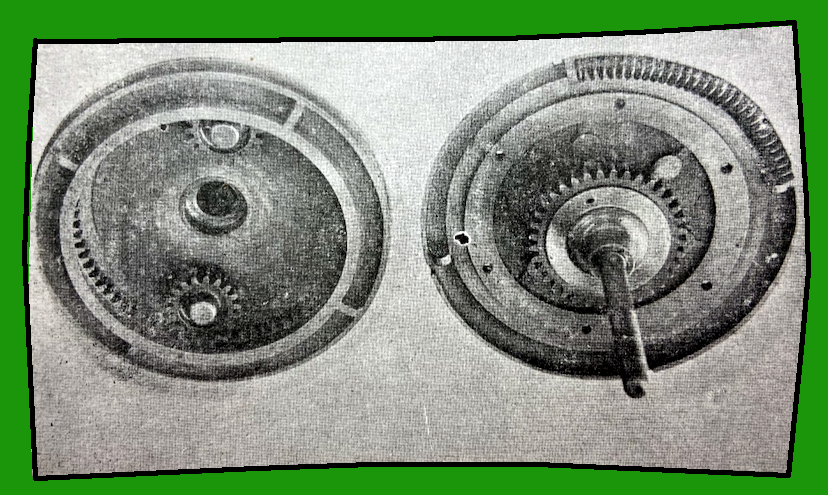
applications of the Bowden wire transmission. The brake gear, of course, is a great feature; but in addition are shown carburetter regulators and controllers, change speed controllers, band brake mechanism, ship signalling gear, Bowden patent flexible oil tube, etc. There are five Bowden motor-bicycles shown, having the new 2¾ to 3hp FN motor fitted, and also a chain drive and special friction clutch, which has proved eminently successful during the past season. Entire control from the handlebar is by wire transmission. A very neat and well thought out electric ignition arrangement is fitted, in conjunction with a circuit breaker on the back brake. Two fore-carriages are also shown. The most interesting feature about these machines is the pedal starting gear, which is very ingenious, and dispenses with the starting handle. Patent compensating brakes are fitted to the front wheel. One of the fore-carriages has a pedal-actuated system of band brakes which is most effective. This particular machine has a novel hand starting device consisting of a piece of gearing on to the back chain wheel which drops automatically out of gear when the starting handle is removed. W King and Co, Cambridge. The original King motor-bicycle, which secured the gold medal at the Crystal. Palace in
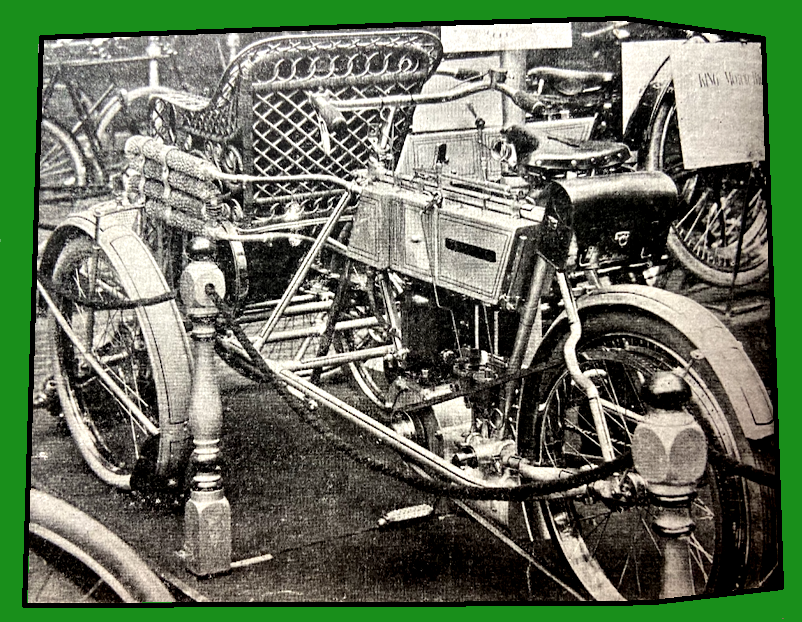
February last, is on view here. Bicycles with various engines are shown, from 2¾hp, air-cooled, to 4hp water-cooled, the latter having 10ft of small gilled radiating tubes in front of the head. Longuemare carburetters are used on all models, also duplicate accumulators with two-way switch. One machine is fitted with foot-rests built out from the crank case of the engine and a spring seat pillar. All levers have ratchets, to prevent their position being altered by vibration. The King silencer is of ample dimensions, and is oval in section, so that it can be slung between the pedals, under the bottom bracket. Bluemel Bros, Globe Road, London, E, are showing their motor-bicycle saddle, which follows the usual lines; also a large motor pump, made of celluloid, and fitted with a gauge. This pump is fitted with an aluminium foot, and is unusually light for its size. The firm makes a speciality of celluloid fittings, such as mudguards, gear-cases, etc. A high-class accumulator, of the best quality, is sure to be examined. Alfred Dunhill. The articles here exhibited cover every requirement for the motorcyclist’s or motorist’s use The new Bobby Finder is a combined goggle and small field glass which may be attached and detached with. rapidity, enabling a motorist to see clearly objects at a distance. The new hand protectors, which will fit any handlebars, are a great comfort in cold weather. A combined gaiter and legging is very smart in appearance and is easily put on to the leg. Some cheap stout drencher proof cloth jackets lined with camel fleece lining, and a very chic eider skin cap which is light, water-proof and warm are worthy of inspection. A new back lamp, burning paraffin oil, is now ready for 1904: it has a red back light end throws its main light on to the registration number. The Stern Sonneborn Oil Co, Gracechurch Street, London. Every variety of oil and grease appears on this stand, from the heaviest kinds required for heavy work to the thinnest for finely adjusted mechanism. The company have oils for internal uses with flash points as high as 800°, proving the perfection which has been arrived at by them. The Garrard Manufacturing Co, Ryland Street, Birmingham, stage four machines, all bristling with interesting
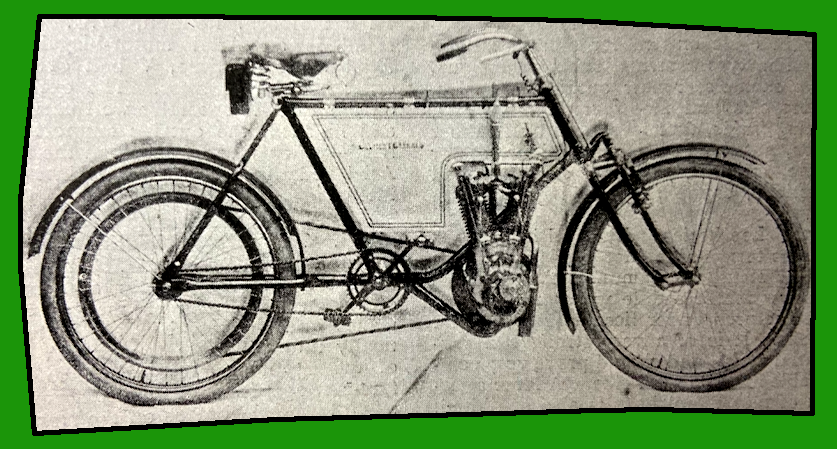
details. The Paris-Rome model machine is a remarkable line, sold at 29 guineas: it has the famous little featherweight engine, mounted vertical, and driving by a long belt. The surface carburetter fitted has a very large capacity, and lubrication is by pump: the wheels are 26in, with 2in tyres. The Paris-Rome model chain driver has a two-speed gear, long wheel base, spray carburetter, front rim brake, and back-pedal brake: this machine is priced at £40. The twin-cylinder machine is 3hp, with vertical motor in a most rigidly constructed frame, surface or spray carburetter, long belt drive, very large diameter driving pulley, the new spring forks, large petrol capacity and 26x2in wheels: price £57. The Phoenix Park model has a 2hp motor fixed on the down tube, combined chain and belt drive, spring forks, and aluminium control levers: these are fitted to all machines; the price is £44. The finish on all these machines is of a very high class. The very special feature of the CG machines is their recently patented handlebar control, with indicator mounted in the centre of the handlebar: this system consists of a of flexible shaft fixed in the handlebar, and gearing on to the indicator, thence by another shaft down the steering column to the spark advance; the positions ‘slow’, ‘half’, and ‘full speed’, are marked on the indicator. The spring fork is now made lighter, and the general equipment is in every way of a superior order. The mudguards are extended, and a new nickel finish has been introduced for the wheels. The practical rider will find this exhibit most interesting. AR Macbeth and Co, Holloway Road, London, N. One specimen of the Macbeth motor-bicycle, with Minerva engine and V-belt drive, is shown by Mr Macbeth. It has an Eadie frame, with long wheel base, duplicate front forks and an extra petrol tank in the rear panel. Thomas Motor Celeripede Cycle Co, Barnet. The motor here fitted is the ordinary Minerva which calls for no particular description, but the point to which
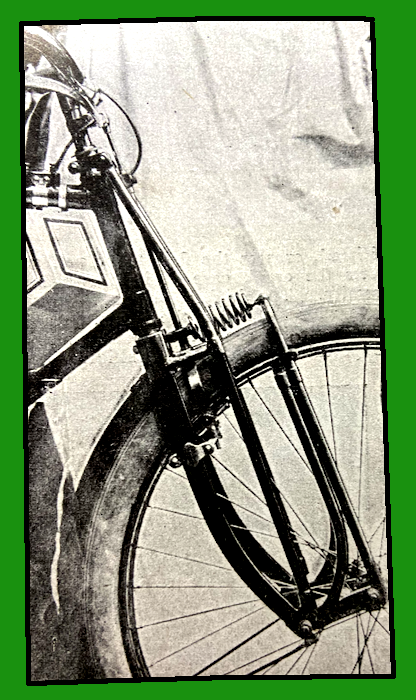
this firm especially draw attention is their patent spring fork. A secondary fork of triangular form is pivoted to the fork ends proper, one on each side, which are joined together in an arch-fitting clear of the tyre; these side forks are made adjust-able for any size of wheel. Between this arch and the crown of the front forks a powerful spring is placed in compression, so that the vibration of the front forks is absorbed by the action of the spring. The East London Rubber Co, Great Eastern Street, London, show their special line in the Kerry motor-bicycle, which has earned a great reputation for reliability. The motor of 2¾hp is mounted vertically, drives by a V-belt and has all the good features of last year’s mount. In addition, there is here a most comprehensive line of accessories, including accumulators, coils, carburetters, new lamps, radiator parts, lubricators, pumps, sparking plugs, and interchangeable parts for standard engines. The Kerry set of motor-bicycle parts is a strong line. Ammeters and voltmeters, possessing new features, and, in fact; practically all accessories the motorist requires, are to be found here. The compact and simple lines of the motor-bicycle should be noted. There are minor improvements in the engine, especially about the 2 to 1 gear, that are worthy of close attention. NSU Cycle and Motor Co. This is a fine exhibit, and includes motor-cycles, a motor-tricycle with front seat for a lady, a motor carrier tricycle, various powered motors, and parts for motorcycles and cars, all made by this firm. All the motorcycles are belt driven, have vertical NSU engines built into the frame, and powerful front brakes acting on a drum on the front wheel. A 3½hp, with a longer frame than the smaller hp machines, and long handles coming well back, looks a speedy mount. The motor-tricycle, with wicker front seat, is convertible into a bicycle, and has a pleasing appearance. The Crypto Works Co, Clerkenwell Road, EC. This old firm have three motor-bicycles and two tricycles on

view, with engines of various makes and powers, but all bolted vertically into the cycle frames. A feature of the Crypto tricycle (built to take a fore-carriage) is the fitting of expanding—metal-to-metal—brakes on the front hubs. A new frame, of registered design, has a through tube from the bottom of the head to the back wheel axle, leaving clearance beneath for the engine. Another tube runs from the top of the head, crosses the first tube, and supports the crank case at its forward extremity. The higher powered Cryptos have wide flat belts, the 2hp machine having a V-drive. Mr James is to be congratulated on his fine exhibit. The High Level Brand Co, Newcastle-on-Tyne. This firm makes a speciality in cycle and motor oils of all description, tyre cements, rubber, solutions, black enamels, repair outfits for cycles, motorcycles and motorcars, lamp wicks, brazing fluids, tyre levers, and all rubber goods, patches of ail descriptions, motor grease, and a new liquid cement called Phasticko, capable of sticking anything. Leatheries, Birmingham. Various forms of leather goods are shown on this stand, and amongst the novelties is a new motor saddle with girder frame, manufactured under licence from Messrs. Brooks. It is of a very strong and substantial make, and should prove very comfortable for the motor ride. A large selection of motor tool bags is also exhibited. A special motor mud flap for front mudguards is a very useful fitting: it is made of two-ply leather and is secured by two screws to the mudguard. H Miller and Co, Birmingham, show lamps of all sizes for motors. The new motor Cetolite is remarkable for its light weight, this being slightly over one pound. The back is fixed, and is adjustable to any bracket. The addition of a gas bag contained in the back ensures a steady flame. The drip of water from the reservoir is regulated by a disc, while an extremely ingenious disposition of the handle ensures safety from explosions. The handle is hollow, and is connected to the generator. In the event of more gas being given off than the gas bag and generator combined can retain, the overflow finds its way through an orifice in the handle, and the pressure is thus relieved. The burner can easily be unscrewed for the purpose of clearing it with an inflator, should it become clogged. The front glass is detachable, and the lamp presents a neat appearance. A lamp burning colza oil, and adapted for motorcycles, is also shown. This has a spring back, an extra handle, a lens front, and detachable aluminium cone and reflector. The firm also show a new side lamp burning petroleum. Illustrations of some of this firm’s specialities are crowded out. The Referee Cycle Co, High Holborn, London, WC. On this stand is an Ariel motor-bicycle, with Ariel vertical engine, V-belt drive, and other popular features. The cycle work on the Ariel is specially well carried out and finished, the outside support to the head—which was a feature on the famous Ariel pedalling quads and quints—being fitted. C Lohmann, Aldersgate Street, EC, shows a motor-bicycle with a patent adjustable swing crank. The specimen produced betrays much careful thought in its construction, and should be closely inspected by visitors. The workmanship leaves nothing to be desired. Griffon Motors, Upper St
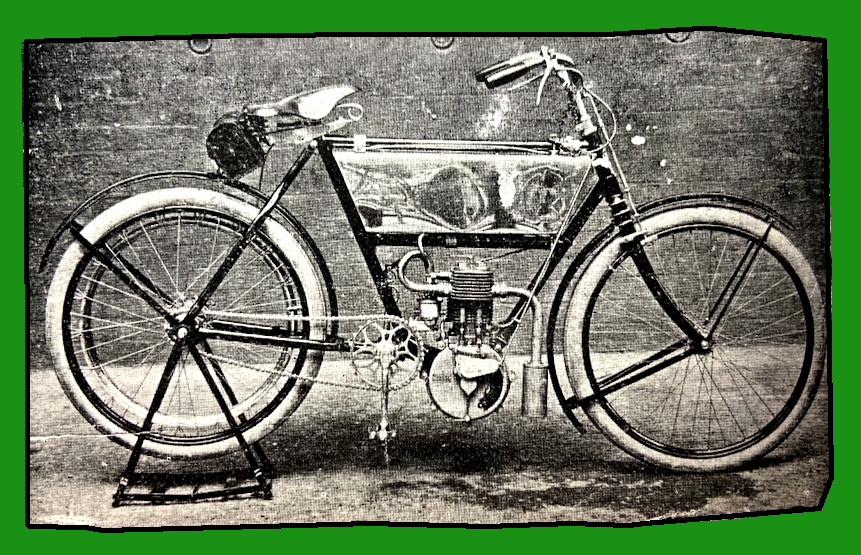
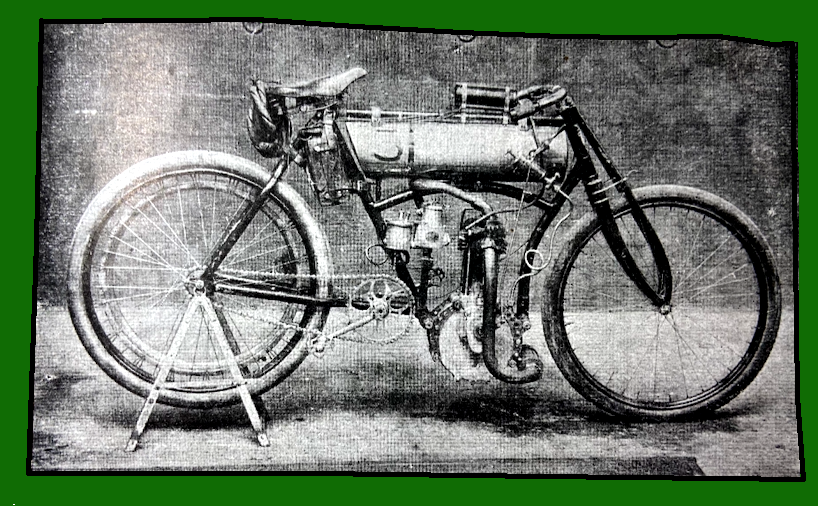
Martin’s Lane, WC. The latest Griffon motor-bicycle is one of the lightest machines in the Show—the whole structure, when ready for the road, only weighing 110lb. It is fitted with a 2¾hp vertical motor which has mechanically operated valves. A new exhaust box has been designed which, it is claimed, gives the least possible back pressure with the minimum of noise. A Fulmar 20 ampere accumulator is adopted, as is the Nilmelior coil. There is an eccentric chain adjustment in the bottom bracket giving rigidity to the rear wheel, and the forks are of the girder type. Clipper tyres may be fitted if desired. The actual machine on which Demester won the Circuit d’Ardennes is an interesting exhibit. Messrs Kynoch, Birmingham, show for the first time a motor-bicycle of excellent design and finish. The engine is of 3hp, mounted in an oblique position and fixed between the bracket and the head socket. The transmission is by chain on to a countershaft and thence to a rear chain wheel. The Longuemare carburetter is used and ignition is on the usual high-tension system. The silencer of extra large dimensions, and a noteworthy feature is the substantial design of the control levers. A neat idea is provided for releasing the inlet valve at starting. Two band brakes are used, one on each hub. The electrical gear is contained within a wood case of ample proportions. The frame is of very graceful design, and front forks of duplex pattern are fitted. The front mudguard is provided with a sensible mudguard flap. Every part is made on the interchangeable system, and the whole machine is worthy of the most careful inspection. This firm has a great reputation for the accuracy of its light engineering work, a reputation which this machine will certainly enhance. Robert W Coan, Myddelton Street, EC, shows specimens of aluminium castings of every description for motorcycles of all kinds. Mr. Coan shows model cycle crank cases, forming a coin box. Graham Bros, of Enfield Town, have an exhibit of motorcycles; one—the Parade—is fitted with a De Dion 2¾hp engine, belt-driven, weighing 1121b; another—the Ariel—has a Minerva engine of 3½hp. A ‘novelty is the 2¾hp De Dion motor-bicycle fitted with a patent Liberty detachable sociable: with this attachment a motor-bicycle is made into a very light form of two-seated car. It is claimed that this machine is absolutely free from side-slip. Fixed to an ordinary bicycle and adapted as a carrier it makes a very useful tradesman’s carrier. Rex Patents, The Exchange, Clapham High Street, SW. It would require many pages to set forth all the various useful patents of this company, goods well-known for their handy adaptation to various parts of cycles, motors, etc, be it pump, clip or saddle. All wants are studied by this firm, the demand for a thing has but to be expressed and the Rex people have it on the market the next day. This season they give us amongst other things, the Midget motorcar for children, a miniature car which, luckily for our children, is driver by pedal-power and not by petrol, but it partakes of the form and shape of its well-grown prototype. They also show a 3½hp motor engine of London make. Clyde C&M Car Co, Leicester. This is one or the few firms which fits the magneto ignition on the Simms Bosch low-
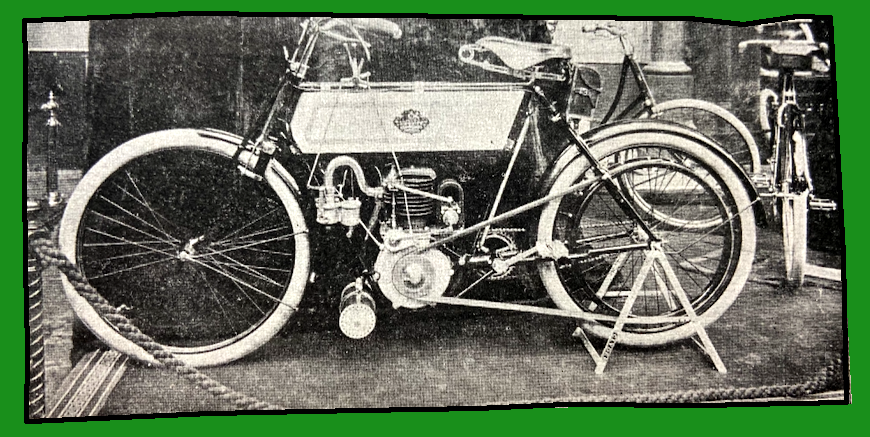
tension system. The engine is fitted in a loop frame of a registered pattern, and vertical in position. A new arrangement is adopted for the advance sparking, whereby the lift of the trip rod is constant, whether the spark be advanced or retarded. Special facility has been given to enable the valves to be re-ground, a point often forgotten by even good makers. The three levers for controlling the motions are all mounted on one shaft; a spring washer keeps them all rigid in position, although free to work. This firm can, if desired, fit the ordinary high-tension system with accumulators. R Talbot, Berlin and Paris. This firm is the agent for the Zedel motor for the British Colonies and Germany. A Zedel motorcycle, 2½hp, is on view, fitted with a Zedel carburetter. Errtee sparking plugs, coils, accumulators, brakes and batteries are also shown. This firm can supply a complete motorcycle, fitted with Zedel motor for export to the Colonies at a low figure. Lintine & Co, Gt Eastern Street, London, make a great feature of motor accessories, of which an immense variety are shown. There are some very special lines in coils and accumulators, and a neat enclosed spark gap calls for notice. Another good thing is a handle-bar switch of neat construction. Further specialities include lamps, tool bags, horns, oilers, tyres, jacks, saddles, motorists’ clothing, etc. The firm also stage a motor-bicycle with 2¾hp vertical motor fitted in a loop frame and possessing all the characteristic features of an up-to-date machine. The Imperial C&M Co, Birmingham. This firm make a specially constructed frame which they claim to be

mechanically correct in form, having, a cradle made in a loop form of T section steel, this loop carrying the case of the motor. The T-section starts from the down diagonal, and ends near the crank axle of the bottom bracket, and it affords a very steady bed for the motor. A second top tube is provided between the front post and the saddle pillar, and an extra back stay is fitted from its junction to the back forks. No doubt this frame must be extremely rigid. A point is made of the fact that the advance sparking lever, when brought fully back, raises the exhaust valve, thus dispensing with one lever. The engine is of English make, well designed, and [the frame is] fitted with strong duplex front forks. A one-way switch is fitted to the handlebar and operated by thumb pressure; [other equipment includes a] B&M trembler coil, P&R accumulators, Lycett belt and Longuemare carburetter of the latest pattern. Rover Cycle Co, Coventry. Rover motorcycles create an excellent impression, which is increased and enhanced as the delicate and beautiful work introduced into the machines is observed. The standard Rover is fitted with a 3hp engine, placed vertically in a complete cradle which forms the connection between the twin lower members of the frame and the diagonal tube. The engine is provided with mechanically operated valves. Twin accumulators and a Waterson coil are employed. The capacity of the tank is a gallon and a half: the oil reservoir is placed in the forward end of the tank with an outside

lubricator pump. The carburetter is the best that the company can obtain: in fact, the aim has been to secure the best of everything where the article is not made at the Rover Works. The power is transmitted by a V-belt. The coil and accumulators are carried in a metal case behind the seat tube. A well-designed girder fork, ample mudguards, a two-way switch on the top tube, two brakes and a Brooke’s special saddle form part of the equipment; the machine with Clincher A Won tyres selling at £55. The machines are all equipped with a portable stand and carrier, whilst the rear portion of the mudguard is readily removable in case of need. The silencer is placed behind the bottom bracket, conveying the gases clear away. The exhaust tube, it will be seen, is carried right round the crank case. The same machine fitted with a fore-car sells at £65. HG Turner, Eldon Grove, Manchester. The well-known Turner carriers are shown here and some novelties have been introduced. A new device which should prove very popular is a combination stand and mudguard lifter for either front or back wheels. The stand is collapsible and easily adjusted, and protects the end of the mudguard from the ground. In case at puncture the greater portion of the tyre is quickly and easily exposed. The new front stand carrier for motorcycles is fastened to the girder stays by means of a claw clip which automatically fits any width or section of the stays and is actuated by a screw terminating in a ring at the end of the carrier. In another form of back carrier and stand combined the base of the carrier and the stand form the mudguard. Riley Cycle Co, Coventry. Motorcyclists will have to be very critical if they are not impressed by the machines exhibited here. The firm are not
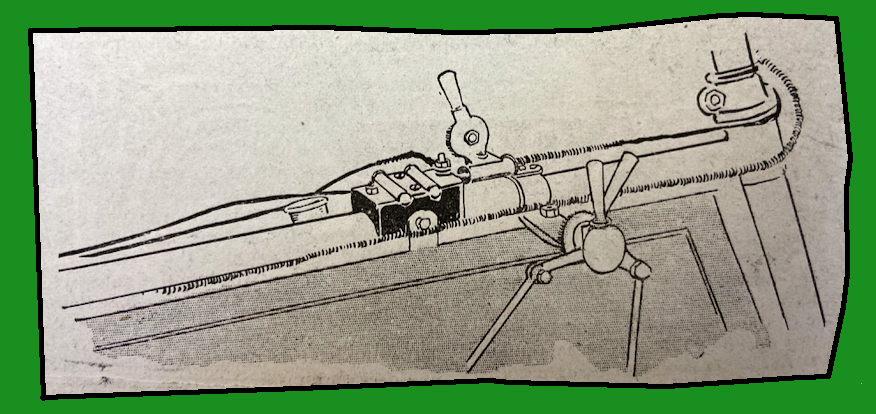
novices at motorcycle construction, and, as the result of several years’ experimental work they are in the position of being able to display really high-grade machines. The engine, which possesses. several interesting features, is placed in a vertical position, and is the work of the Riley Engineering Co. The standard motor is of 3hp, with a bore and stroke of 80x80mm [402cc]; but 2¼ and 3½hp engines can be fitted if desired—the latter are either air or water-cooled. A Longuemare carburetter and Bassée-Michel coil are fitted, while two Peto & Radford non-spilling electrolyte accumulators are adopted. The latter are operated by an extremely simple but ingenious two-way switch, the design of Mr Allan Riley, which is fitted on to the top rail. This device, which is connected with the usual handlebar switch by a Bowden wire, provides for the working of the two accumulators—either singly or together. The switch is on the plug or interrupter system, and its utility when the accumulators have run down can be easily understood, inasmuch as the use of two plugs gives an increased voltage. That is to say, the two sets of partly run down cells can be coupled in series, and still give considerable capacity. Crabbe Brake Co, Birmingham. Ingenious rim brakes are made by this firm, which is an offspring of Cycle Components. The front rim brake for motorcycles is actuated by a pull-up lever and has a powerful spring arch. It is a fine piece of work, and is likely to become as popular amongst motorcyclists as the lighter types are amongst the legion of riders who employ them on pedal-propelled machines. Alldays & Onions Engineering Co, Birmingham. An imposing array of 2¼hp motorcycles please the eye here. Exclusive of the coils and accumulators,
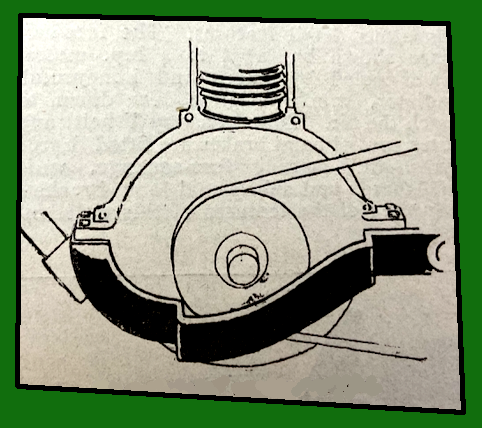
the machines and their component parts are entirely of Messrs Alldays & Onions’ own manufacture—a fact of which the firm are justly proud. The engine which is fixed vertically to an ingenious and registered design of cradle is excellently made, and runs at 1,400rpm. The crank and shafts are hardened and ground to dead size, and all bushes are especially hard and toughened. The radiating gills on the cylinder are closer, deeper and thinner than those usually seen, and as a result the tendency to overheat is minimised. The tank is of a very neat design, and is divided into various compartments to accommodate coil (high-speed trembler), accumulator, petrol, and lubricating oil. The petrol tank holds sufficient spirit for 160 miles, while enough lubricating oil can be carried for 250 miles. The carburetter is of the float-feed spray type, and the belt is of V-pattern. The contact breaker is of the trembler type and of improved design. The framework is very substantially built, the front forks being strengthened by side head tubes. Efficient brakes are fitted, and the machine carries detachable mudguards and stand. Buyers have.the option of either Dunlop or Reflex-Clipper tyres. There is no doubt that the ‘Alldays’ motor-bicycle is a beautifully finished and serviceable machine, all the parts of which are made to gauges and interchangeable. The Ormonde Motor Co, Wells Street, Oxford Street, London, W. Two patterns of Ormonde motor-bicycles are being marketed for next year: the old reliable, with engine behind the
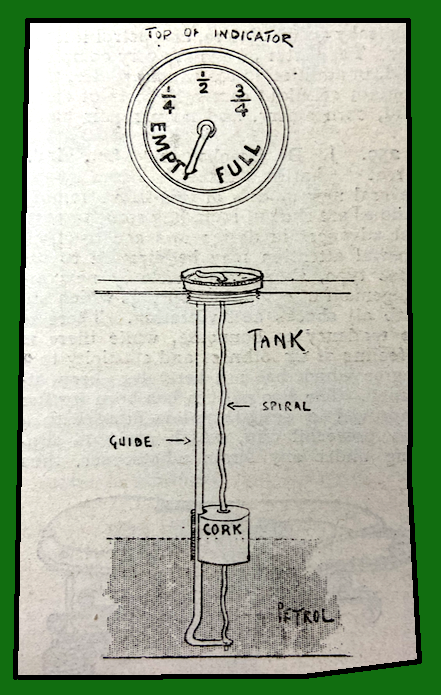
down tube is still supplied; a new pattern is being introduced which has a vertical engine, situated in front of the bracket; this engine has an unusually large fly-wheel. In belts the Ormonde Company have a new water-proofed cotton belt of U section and an original belt-chain, composed of flat pen steel blocks, lined with leather, with steel rollers on projecting pins; the rollers engage with the toothed flanges of the engine pulley, forming a positive drive, the back wheel carries an ordinary flat pulley. Inlet and exhaust valves are both mechanical and are interchangeable. The Ormonde Company have always made a feature of their automatic lubricator with sight feed, which relieves the rider of much anxiety as to whether his motor is being efficiently lubricated. Another good feature is the long wheel base, giving stability on greasy roads. A detail improvement has been effected at the vacuum valve in the crank case, making a leakage of oil impossible. The carburetter—which is, of course, a spray type—has been made larger and fitted very close up to the engine. The two-to-one gear has been so re-designed that a much finer setting of the timing can be effected. Another detail advance worth noting is the sparking plug being fitted right over the inlet valve where it meets the purer mixture. Needless to say the Ormonde machines are finished off in a style to suit the most critical. In the petrol indicator the rising float causes the spiral to turn, and so move the pointer. Chas Binks, Nottingham, exhibit a distinctly novel type of motor-cycle—or two-wheeled car, as they term it. The motor has four cylinders, giving 5bhp in one pattern, and 4½hp in another pattern. The motor is mounted between the two main tubes of the frame—longitudinally in one

pattern, and transversely in the other. The transmission is by clutch and chain, and ignition by the usual high-tension electric system.” [As if a choice of two four-pot engines wasn’t enough the Binks design featured an oil-bath drive chain and a “richly upholstered spring bucket seat”. Purchasers were promised “no vibration, no noise…on clutch being released the engine is automatically throttled. Speed—4-50mph. Hills—you need not consider them. Engine started before you mount by simply pushing switch or foot lever. You then take your seat, both feet being on the ground, raise the lever which operates the clutch, and you glide away with feet on rests.”] Meredith, Jones & Co, Century Tanning Co, Wrexham, exhibit a special motorcycle belt, in V and flat sections. This is specially treated, and of greatly increased strength, and unaffected by wet or other atmospheric conditions. It is also remarkably pliable Undoubtedly the great feature about the belt is its immense strength—a point that visitors should prove for themselves by visiting this stand and testing a sample. The firm also make a speciality of leather for motor clothing. Rushbrooke & Co, Moor Street, Birmingham, show motor lamps of various sizes, several small motors, and a motor-bicycle frame, with girder head, duplex forks, and large hubs, and made to take a detachable fore-carriage. A fore-carriage frame is shown complete, fitted with an aluminium body. A speciality of the firm is a motorcycle pedal, of large size, which obviates vibration and ankle strain. The Yelstan 3hp motor shown is light for its power, has a large fly-wheel and non-slipping pulley. The Vevo spark-plug is a well-made fitting with a very superior porcelain. A monster show model of this plug is exhibited. A complete set of motor frame parts of guaranteed accuracy is shown, and many other accessories. Lake & Elliot, Braintree. This stand is especially attractive to members of the trade, as a full range of the firm’s high-class tools for cycle and motor work is displayed. Motorcyclists will be interested in the new pattern combined carrier and stand: this is of neat design, and can be put into use without unscrewing nuts or clips. Birmingham Small Arms Co, Small Heath, Birmingham. This distinguished firm has an excellent array of
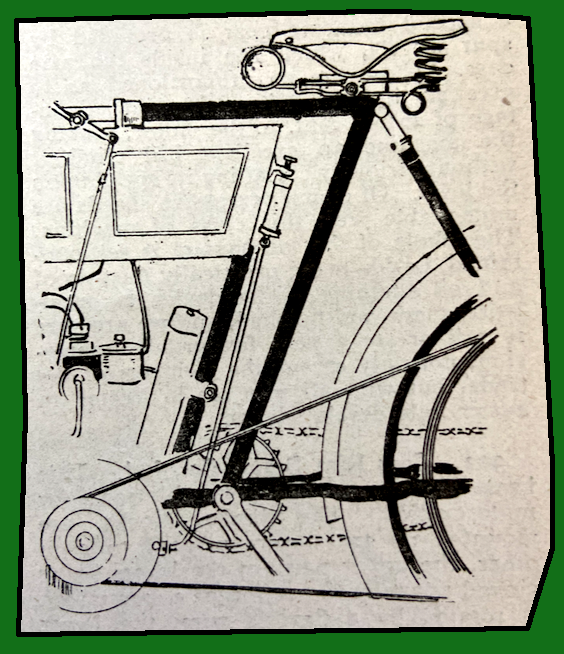
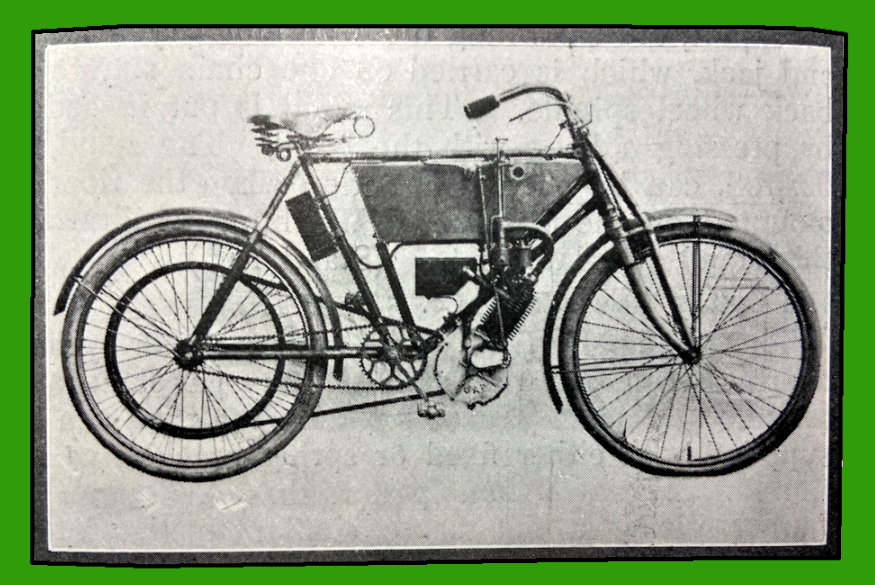
goods of interest to the motor trade. The BSA spring frame for motorcycles has been designed to overcome vibration, and will suit inclined engines from. 2hp up to 2¾hp. The BSA Bi-Flex brake is a combined back and front brake, hand applied by a single lever: it is fitted with the well-known BSA moderator spring and is under the complete control of the rider. The firm also supply motorcycle fittings of all kinds: these are beautifully made, and are of great reliability. The care bestowed upon their production has rendered them household words in the motor trade. We can cordially recommend all visitors to the exhibition to take careful survey of the various details: they will be amply rewarded for their pains. Salsbury and Son, Long Acre. The name of Salsbury is deservedly popular in cycle and motor circles because of the excellent character borne by the goods which emanate from this well known firm. Salsbury lamps are a house-hold word, and we can confidently recommend shoe visitors to closely inspect the Salsbury-Flare lamps and the Salsbury-Dietz lamps. Eadie Manufacturing Co, Redditch. This firm, among its many types of component fittings, is making a special set of fittings for motorcycles for the Minerva type of engine, both vertical and inclined. A special bridge has been registered, so that straight tubes can be used for the chain stays, the principal object being to enable the rider to remove the wheel without requiring to spring the stays. A speciality is also being made of a resilient front fork, which is composed of tubes running from D-section at the top to round at the ends, thus absorbing vibration. Not only do these tubes taper in section, but also in gauge. The continuation of these forks forms a triple head fitting. They are also showing the Fagan two-speed back hub, of which they are the sole licencees and manufacturers. J Lucas, Birmingham. Many new lines in motor accessories may be found here. Some new motorcycle and fore-carriage lamps for burning acetylene gas are shown, notably the ‘Acetyphote’ and ‘Luminator’, ‘The King of the Road’ is a powerful headlight for acetylene. Side lamps and back lamps in great variety for petroleum or oil may also be seen. There is a new back carrier on view which will be found convenient and useful. Engine cylinder oils and motoils embracing special qualities both for water and air-cooled motors are supplied for high-speed engines; these oils will endure at high temperatures and . remain limpid in winter: they are also free from any sticky tendency. Various motor pumps and horns are shown, and every article may be depended upon to be of the best make and of excellent finish. The Triumph Cycle Co, Coventry. The predominating feature of this firm’s display of motorcycles is the most symmetrical design and

exquisite finish of the machines The frame has a long wheel base, with the engine mounted vertically. The 2½hp machine has the. Longuemare carburetter, Dunlop silencer and V-belt transmission. The ignition gear has been most carefully thought out, and a special device has been fitted to obviate explosions occurring in the exhaust box. This cuts off the current before the exhaust valve is lifted. The petrol tank is made of a special lead lined sheet steel, quite acid proof, and of great strength. The spark adjustment is worked on a ratchet, giving a very fine gradation. The 3hp machine is on the same lines, petrol capacity equal to 120 miles’ running, double accumulators, handlebar switch, special speed governor on the exhaust, band and rim brakes, and numerous detail features. The fore-carriage has a 3½ to 4hp motor, water-cooled by pump and honeycomb radiator, which is fitted low down to catch the air. This drives by V-belt, and three special band brakes are fitted. Herbert Smith and Co, 29, Finsbury Pavement, EC, exhibits a quantity of cycle and motor accessories of every description, including instantaneous connections, pump connections, carboleum motor lubricant, sparking plugs, accumulators, switch handles, voltmeters, motor saddles, jockey pulleys, induction coils, tanks, belting, goggles, etc. Noble Motor Co, Pocock Street, Blackfriars, SE. Noble motor-bicycles long since sprang into popularity, and those on exhibition are well up to the firm’s reputation. The engines on the 1904 models feature mechanically operated valves, the inlet being also operated by a relief compression to enable easy starting uphill and on
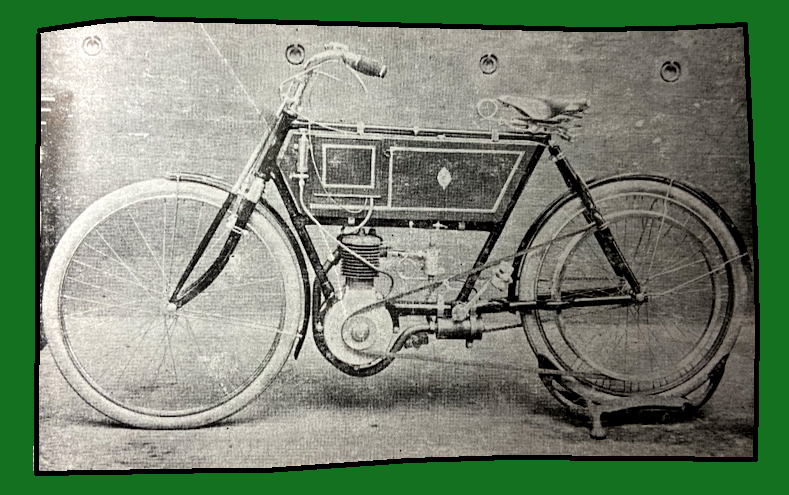
greasy roads. All the machines shown are belt driven, but if desired a chain drive can be substituted. As hitherto, the coil, accumulator. petrol and lubricating oil are all contained in a neatly designed tank. Complete engine sets are shown, and also a stoutly built motor launch. Bord Lightweight Motor Co, Finsbury Pavement. This firm show their 1¾hp motor which can be fitted as an auxiliary to the ordinary cycle—provided there is 3¼in. clearance between the back stays at 9in. radius—or to the other pattern of the specially built machine. The motor is slung to the top tube of the machine, and securely gripped to the down diagonal. The petrol rank, round in shape, is fitted to the handlebar, and will hold a supply for 100 miles. Wipe contact, ordinary coil, large accumulator, New Departure Hub, and front rim brake are supplied. The driving pulley is made detachable from the fly-wheel to facilitate renewal. The motor which is so placed on the frame as to balance properly, is supplied separately at £18 l0s, or on a specially built machine at £19 10s—a price far below anything yet attempted. A very ingenious mode of jointing the twisted hide belt is by forming two eyes, one on each end cf the belt, and on one end a tongue is also made: the two eyes are brought over each other and the tongue passed through. Mason & Brown, Leicester. A large display of switches, ignition coils, voltmeters, charging sets, testing lamps,
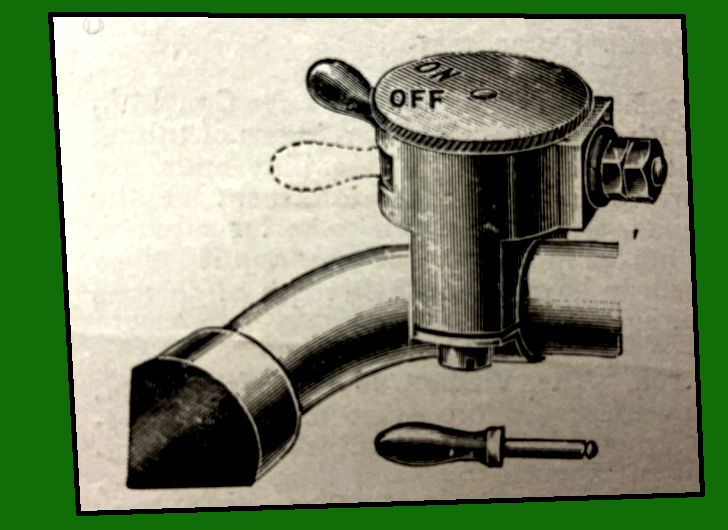
wipe contacts, accumulators, high- and low-tension wire attracts attention here. A 2½hp engine is exhibited; but the most interesting device here is the two-way handlebar switch for motor-bicycles. This arrangement consists of a nickel-plated brass case which is secured to the handlebar by means of a rounded plate and screws. This fixes it rigidly, and forms the connection to the frame. The other connection to the wire is made by means of a nut on the outside of the case. A pin is carried through to the inside. and is insulated by means cf an ebonite bush from the remainder of the case. The contact is made by an incomplete circle of strong German silver, inside the case, which is moved backwards and forwards by means of the detachable handle. Robinson & Prue, Chatham Street, Liverpool, are well to the fore with a splendid array of R&P motor-bicycles. The engine is built vertically into the frame, and two powers of motor are
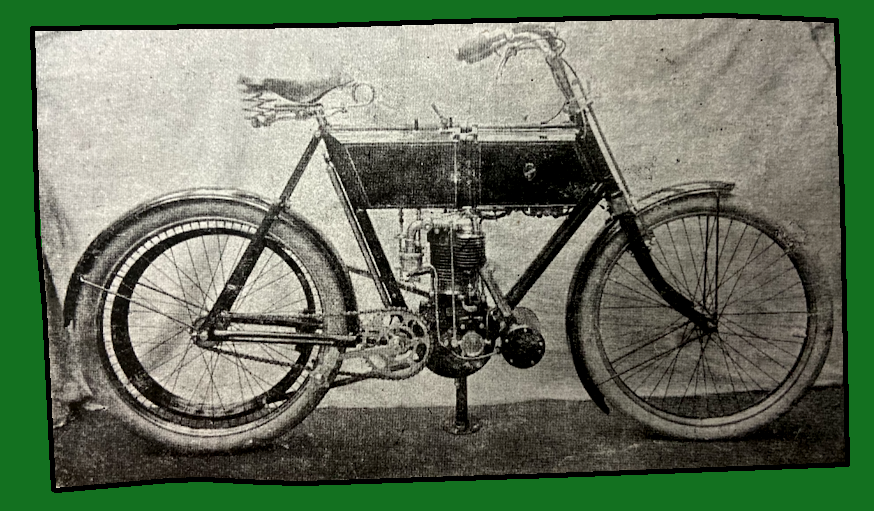
supplied, viz, 2¼ and 2¾. The silencer is extra large and effective, and an improved valve lifter provides for easy starting; all control is effected from the handlebar by Bowden wire, the wires being carried in channels between the tanks for protection. Lubrication is by sight feed pump, and petrol capacity is equal to 150 miles. The ignition is by brush contact and trembler coil, the high-tension cable being reduced in length to 4in. This contact breaker is a detail that should be closely examined, as it is undoubtedly one of the best designed of its class we have seen. The ‘wiper’ consists of a curved and hardened steel blade, adjustable through a considerable arc of a circle. A very small movement takes up any wear that may take place on the V-piece after prolonged use. The firm make a special feature of using enamel finish as far as possible to make the machine as weather-proof as possible. J Dawson and Sons, Lincoln, show the two varieties of their well-known Lincona for motor drives, the ‘Magna’ and ‘Standard’ together with hook and simplex fasteners and a suitable dressing for the belts. The quality of these belts is well-known, users being well satisfied with their lasting powers. Micrometer Engineering Co, Coventry. This enterprising firm have, as usual, a large number of their high-class specialities on view, including a free-wheel clutch of the ordinary Micrometer type— but extra strongly made—and a free engine clutch for motorcycles attached to fore-carriages. The latter is designed with the view of starting the engine with a handle on the lines of a car. It is claimed that there is an entire absence of end thrust when the clutch is is full work, and that the action of taking it out steadies the engine and prevents racing. The device is a fine piece of workmanship, every part of the mechanism having been carefully thought out. The well-known Duad lubricators are to be seen here, while the firm is also exhibiting a registered design of non-slipping tyre for motorcycles and fore-carriages. Phoenix Motors, Blundell Street, Caledonian Road, London, N, were early in the field with the motorcycle and they have always sought to improve and modify in order to make the popular motor vehicle a practical article in every
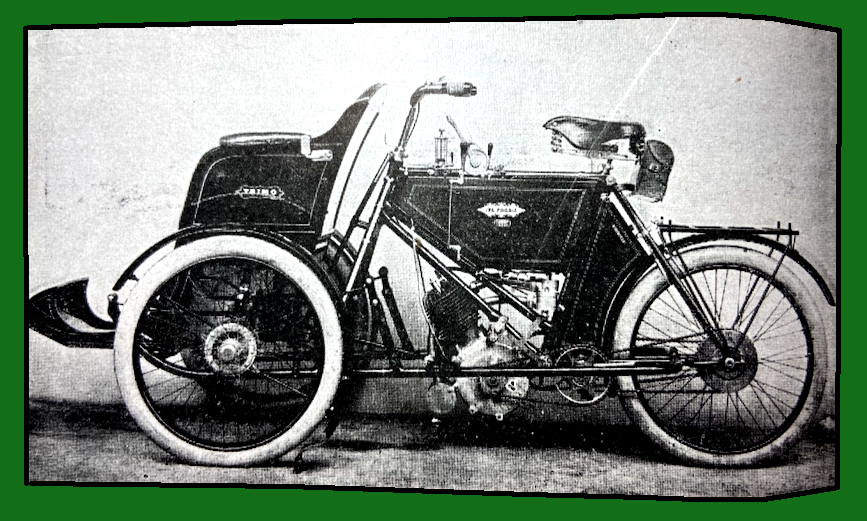
possible way. A number of the features of the present day motorcycle have originated with Mr Hooydonk and we should be surprised if some of the Phoenix novelties shown at the Stanley for the first time do not become general. Phoenix features set the fashion. The company show the 2hp and the 2¾hp Phoenix motor-bicycles, the former selling at 40 guineas, and the latter at 45 guineas; the new model, the 2¾hp motor-bicycle with chain drive and two-speed gear selling at £55. Besides these, there are four types of Trimo. With belt drive the 2¾hp sells at £60, and the 3½hp (twin belts) at £67 l0s. With chain drive, free engine and two-speed gear the 2¾hp Trimo sells at £70, and for a 3½hp engine the price is £75. The Phoenix tricycle without coach body for passenger can be obtained at a reduction on the above prices. To now deal with the new Phoenix features. The two-speed gear and free engine device drives solid on the high gear: in the intermediate position the gear is entirely disengaged whilst a clutch can be gradually let in, which brings an epicyclic train into operation, thus reducing the gear. The advantages when hill climbing or negotiating traffic are exceedingly great. The chain drive is taken from the engine to a countershaft placed behind the bottom bracket and thence to the rear wheel. There is separate and independent adjustment for each of the chains. The new carburetter is designed with a view to simplicity in adjustment and management, and it should prove one of the most successful features of the 1904 Phoenix. An improved luggage stand and carrier with a portion of the rear mudguard attached to it, the petrol and oil gauges and other items are well worthy of inspection. Lycett’s Saddle and Motor Accessories Co, Birmingham, are showing specimens of their new motor saddle, which is constructed on an entirely new principle, said to reduce vibration to a minimum. Owing to the special construction the peak of the saddle is prevented from rising. The L30 La Grande motor saddle is no less than 11½in wide at the base, and 12in long. The Rawide belt is V-section, with eyelets in place of the usual rivets, it being therefore only necessary to cut a short, piece off the belt when slipping begins, and to hook the fastener into the next eyelet. The belt is made in three sizes, the largest being suitable for the powerful motors used for fore-carriage work. An ingenious front wheel carrier, designed for a large bag and accumulator case is shown. The bag is 10½in long and 5½in high, is tin lined, and is fitted with pockets for all necessary tools and spare parts. Messrs Bransom, Kent and Co, Gowen Road, London, are showing accessories of every description for the motorist. A fine exhibit of motor horns and lamps, both gas and paraffin, is set out. Neat wrenches and screwdrivers of compact design, and accumulators of all sizes are shown. A handy screwdriver, only 4in long, should prove a useful addition to the toolbag. Further on are Longuemare carburetters in various useful sizes, the newer patterns being fitted with the automatic air regulator; while an attachment suitable for fitting to the older patterns is priced very moderately, and should prove a useful addition. A neat throttle, suitable for FN and similar carburetters, minus this indispensable accessory, is worth noting. The Watawata V-belt, for which the firm are the sole agents, is shown. Extraordinary pliability and power, with maximum efficiency and durability, are claimed for this belt, which, it will be remembered, is constructed on an entirely new principle. The price compares favourably with that of the first-class V-belts. Various useful forms of belt fasteners, suitable for V-belting, are included in the exhibit. Several motor-bicycles are also exhibited. These have all the latest improvements fitted, and are of good design and finish. The Patent Butted Tube Co, of Birmingham, show specimens of tubing with butt ends. These butt ends are formed to give a reinforcement at the joints, and are claimed to be far superior to brazed in liners. The tests applied show them to have a tensile strength of 50 tons per square inch. The Viaduct Motor Works Co, Coventry. On this stand are three Davison motor-bicycles, fitted with Simms’ engines, magneto ignition, long belt drive, handlebar control and other special features. The Davison frame is quite original, the engine being bolted to a half-cradle, just in advance of the bottom
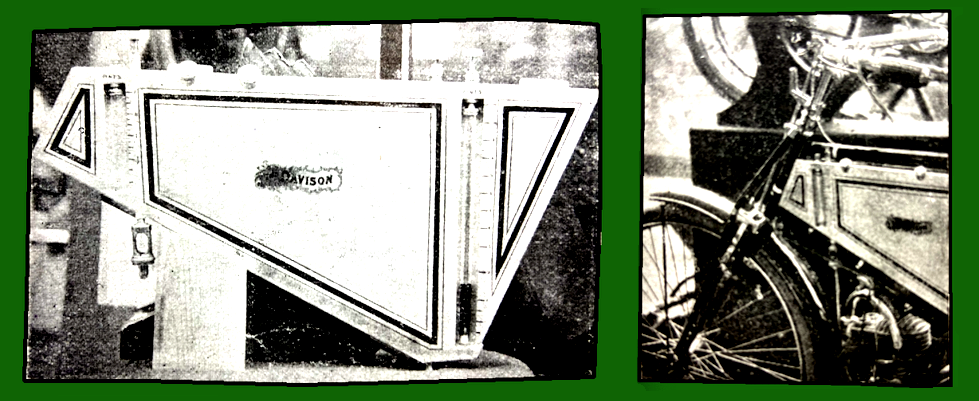
bracket. Glass gauges are fitted on the outside of both oil and petrol tanks, figured to show the quantity of liquid in the tanks. The weight of the complete machine is 100lb, and the work and material ‘British throughout’. Brown Bros, Great Eastern Street, London. The Brown motor-bicycles which are shown by this firm embody several important improvements fo the 1904 season. The 3½hp engine has been introduced specially for fore-carriages. The new 2¾hp and 3½hp cycles are fitted with a triple head and girder forks of special design, mechanically operated valves, and very large fly-wheels. The tank has been improved and increased in capacity. There are, in addition, a number of minor but important improvements, such as the fitting of a larger belt, a new front rim brake, extended mudguard, etc. The 2hp bicycle, having proved satisfactory, has not been altered, except in very minor details. Special attention has been directed to the construction of the crank case, which is absolutely air-tight. The belt pulley is also oil retaining, thus keep-ing the belt free from oil. An exhaust valve lifter is fitted: this, together with the advance sparking, are actuated by one lever. The Longuemare float feed carburetter with a throttle is fitted. Raglan Cycle Co, Coventry. Following in the wake of other cycle firms, the above company have, during the past year, devoted their attention to motor-cycles. They are showing two machines, one of which is fitted with an extremely comfortable and pretty fore-car. The engine, which is of their own make, is of 3¾hp, the crank-case being bolted to the frame low down. The cylinder has a water-cooling jacket, which is fed by a tank fitted behind the fore-car and on a level with the fork crown. This tank, which has a
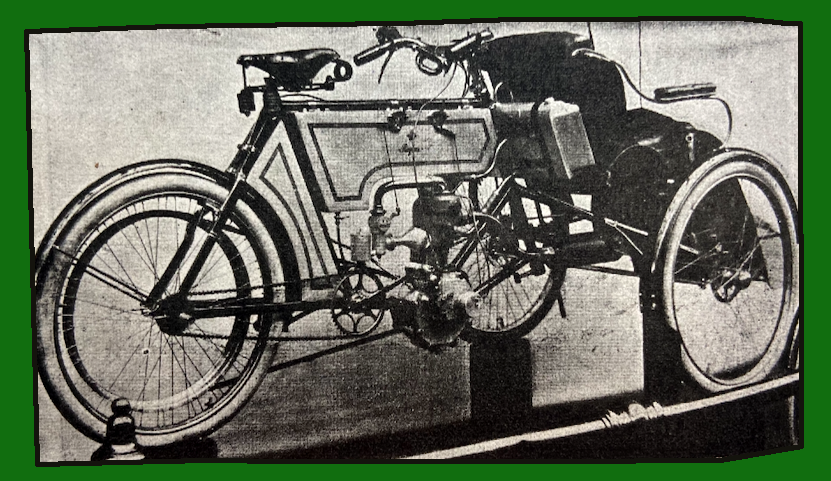
capacity for 1½ gallons, is cooled by two air funnels which pass through it. The exhaust valve is lifted by means of a Bowden wire operated from the handlebar. The sparking plug is placed in a vertical position on the top of the combustion head, and an efficient silencer is fitted. A band brake is attached to each of the front wheels of the fore-car, in addition to a Bowden brake on the rear wheel of the machine. The Ariel Motor Co, Bournbrook, Birmingham, show about a dozen motorcycles of a variety of types. This firm have come right to the front in the motorcycle trade by the sheer merit of their machines, the workmanship being of an order that could not fail to satisfy the most critical eye. The No 1 model motor-bicycle is made in 2¼ and 3½hp sizes. The engine is mounted vertically in bracket extensions. Transmission is by V-belt, and it is noteworthy that the free-wheel is fitted with a protector to keep the mud out. The No 2 motor-bicycle is a splendidly equipped machine with a 2hp Ariel-Minerva engine with mechanical inlet valve, spray carburetter, two rim brakes and Dunlop motor tyres. This comes out at the remarkably low figure of 35 guineas. The Ariel side-carriage should be closely examined. This is one of the very best things in this line we have yet come across. It has very substantial attachments and long springs and handsomely upholstered carriage. This complete is priced at 57 guineas with 3½hp motor. Old riders of the motor-tricycle will view with interest the Ariel tricycle and quad shown. The tricycle has a 3⅛hp motor with two-speed gear, and every detail has been most carefully thought out. The price comes out at 50 guineas. The quad is a splendid piece of work fitted with 3⅛hp motor, with water-cooled head and two-speed gear. The front carriage is supported on elliptical springs and is comfortably equipped. A notable feature about this machine are the foot controlled tyre brakes. This machine is sold at 100 guineas. The Ariel fore-carriage has many distinctive features. It is fitted with a 3hp engine, extra wide V-belt transmission, Longuemare carburetter, compensating band brakes on the fore-carriage wheels and a back pedal brake provided with an ingenious cut-out to enable the machine to be wheeled backwards. The inlet valve is mechanically
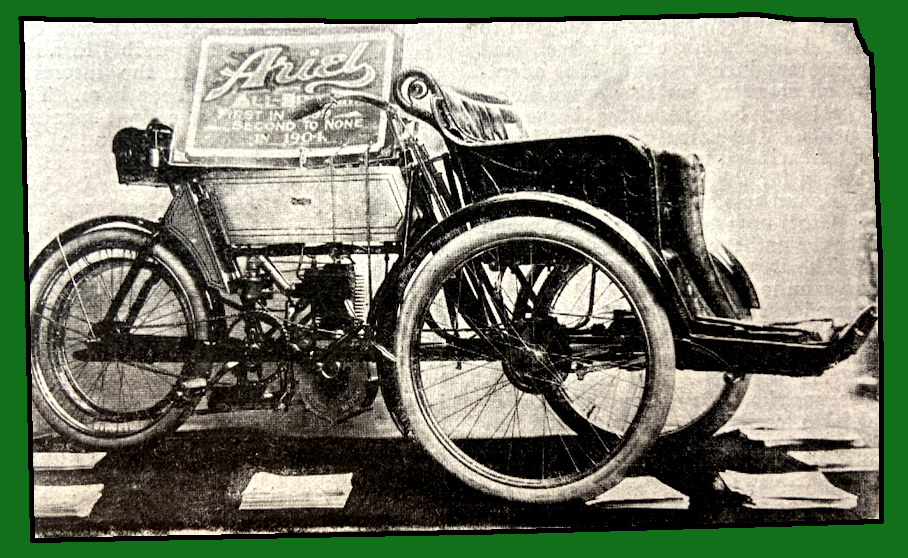
operated, and interchangeable with the exhaust valve. The contact breaker is visible through a window and a novel worm gear lubricating device is another of the numerous valuable features of the Ariel machine. A coupler is also shown for attaching a bicycle. It has compensating joints. The South British Trading Co, Wilson Street, London, EC. The Vindec Special motor-bicycle, with FN engine of 2¾hp, V-belt drive, triple head and bank brakes on both road wheels is the piece de resistance here. The back mudguard is hinged, to facilitate tyre re-pairing. The tool kit on this machine is worth noticing: a large leather bag is shaped to the recess in the frame between the down tube and the back wheel, and contains all spanners, etc, in pockets; the tyre inflater is fixed to the outside of this bag. Another good feature is a lamp bracket of sensible proportions, on which one may safely trust a valuable lamp. The SBT Co’s motto is a ‘first-grade machine at a second-grade price’, viz, £40, and it looks good value at that figure. Eclipse Motor and Cycle Co, Birmingham. Motorcycles fitted with 2½ and 5hp twin-cylinder engines are staged here. The particular feature of these motors is their extreme simplicity; one lever will bring either cylinder into operation, or will cause both to work simultaneously. Twin cylinder coils are fitted, as are two accumulators, and a special form of valve lifter. The firm inform us that they have patented a new form of drive, dispensing with belts, chains and cogs, which will give 100 different gears, and which can be fitted to all makes of motors. Two clutches are fitted to the back hub, and are connected to the engine by driving rods. On the engine is a variable-throw crank which can be altered whilst riding, and any number of gears obtained, as well as a free engine. The device will be on show during the week. The firm have just placed a new belt clip upon the market. This consists of two serrated steel plates, which are made to grip the faces of the belt by means of a nut-and-bolt fastening. The Pebok Motor Co, Leadenhall Street, London, are showing the very popular Pebok motor-bicycle. This has a 2¾hp motor mounted vertically in a loop frame. The carburetter is the I.onguemare, and transmission by V-belt. A specially good feature about this machine is the substantial type of regulating lever fitted. The inlet valve is mechanically operated on some of the machines. To avoid short circuits, the length of wiring is reduced to a minimum. The tank is made in four sections, the fore compartment carries lubricating oil, the second the battery, the third the coil, and the rear part has capacity for petrol to run 100 miles. The spark lever and valve lifter work together. Two brakes are fitted, and the mudguards are of extra width. The frame looks an exceedingly strong one, and the forks are extended right up to the ball head. The firm’s speciality for this season is a new 3½hp machine, with MO valve, two accumulators, extra petrol capacity, and Bowden back brake. The James Cycle Co, Sampson Road North, Birmingham, make a speciality of two types of motor-bicycle, one fitted with the new 2hp FN engine. The frame is of substantial build through-out, and handsomely finished. The transmission is by the usual flat raw-hide belt onto a wood belt rim. The wheels are 28in, fitted with 2in tyres, and the mudguards are of extra width. There are two rim brakes fitted, the rear one being the Bowden pattern. The carburetter is of the usual FN pattern, and ignition is by coil and accumulator. The other machine has a 2¾hp Minerva engine fitted vertically in a loop frame and driving by V-belt. A noticeable feature of this machine is the method of supporting the motor by aluminium bridge pieces between the down tube and diagonal, giving a very rigid support. The front forks of this machine look immensely strong, and are carried right up to the head. The carburetter is the latest pattern Minerva. Dunlop tyres are fitted, and also two rim brakes. The finish of this machine is of a very high order, and will stand a critical examination. Mecanique et Moteurs, Liège, Belgium. This Belgian firm shows a 3½hp air-cooled motor-bicycle; a 2¾hp water-cooled
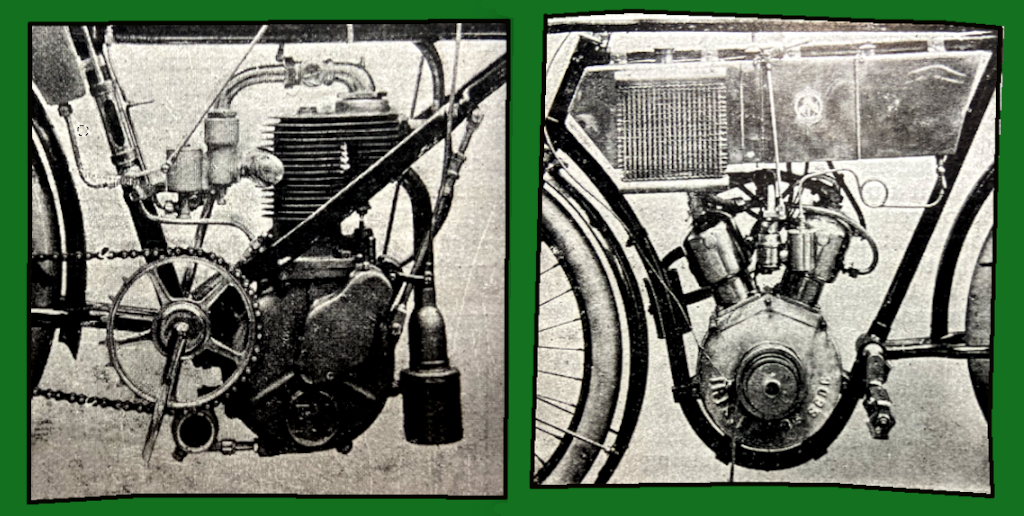
motor-bicycle; and a 12hp twin-cylindered Jenatzy-Martini car fitted with a patent magnetic clutch. Palmer Tyre Co, Birmingham. Mounted sections of all the tyres manufactured by them are shown, those for motorcars and motorcycles being the most prominent. Components Co, Bournbrook, Birmingham. It would be impossible in a brief notice to enumerate all the interesting novelties which may be seen here. There are, for example, very excellent specimens of motor-bicycles, of 2, 2¼, 2¾ and 3½hp, with sociable and fore-carriage attachments, Crabbe motor brakes for back and front wheels, Liberty special motor-bicycle tyres, cycle and motor rims and valves. The Components Co stock also the Fleet cycles. The Fleet motor-bicycle is of 2¾hp, and has a tank which encloses accumulator and coil, and is finished in aluminium, with black lines. It has Crabbe brakes back and front; the ball head is fitted with girder forks. The Liberty side-carriage for motor-bicycles is a beautiful addition. It is upholstered in red or green leather cloth, well hung on triple C-springs, with a waterproof apron. The Liberty sociable can be supplied for practically any motor-bicycle upon the market. A. number of reports of motorcycle exhibits are unfortunately crowded out. Dover Co, Northampton. The Dover gear-case was the first detachable gear-case placed on the market, and has ever since been in the foremost rank. It is made in a range of sizes to take up to 52 teeth, ½in pitch chain wheel, and from 17 to 20½in centres. It is adaptable to all standard variable-speed hubs, free-wheel and back-pedalling brake arrangements. The patent automatic brush lubricator included in the gear-cases is an easy means for the perfect lubrication of the chain, and acts as a preventive against rattle, Other covers shown are the Revod chain cover and the Revod tandem chain cover. The Dover people also exhibit the tubular exonite mudguard, and exonite compressed cycle handles. A novelty is the lighting-up time handle, which gives a perpetual lighting up calendar. Other exhibits are the DL steel socket spanner, the exonite inflator, and the Dover patent table-tennis ball. Special attention is drawn to the castings for the motorcycle and engineering trades in aluminium, gun metal, phosphor-bronze, and brass, including crank chambers, name plates, etc. The Dover people also carry out plating, enamelling, brassing, and lining for the cycle and motor trades. Perry and Co, Birmingham. In addition to an interesting display of motor-bicycle frames and fittings, the firm exhibits a neatly designed and well finished 3½hp air-cooled engine, complete, with contact breaker, sparking-plug and pulley. The bore is 84mm by 84mm stroke [465cc], and the driving power is sufficient for fore-carriage or trailer- attachments. A handsome fore-carriage, suitable for fixing to any make of motor-cycle, is also amongst the exhibits. The basket is hung on strong C-springs. Band brakes operate on drums on both sides of the axle and are manipulated from the handlebar of the cycle by Bowden wires. Lucien Allegre and Co, New Oxford Street, London, W. Motorists who had a desire to appear in public with clean hands visited this stand, where Savon des Chauffeurs, a special soap for automobilists, was on sale. It is retailed in collapsible tubes at 1s each, and will remove grease, oil, etc., from the hands. Edmonton Manufacturing Co, Angel Road, Edmonton, London, N. One of the lowest priced motorcycles in the Show was to be seen at this stand. It is fitted with 2¾hp Edmonton engine, a combined belt and chain drive, Vital tyres, hygienic saddle, large tool bag, girder front forks,
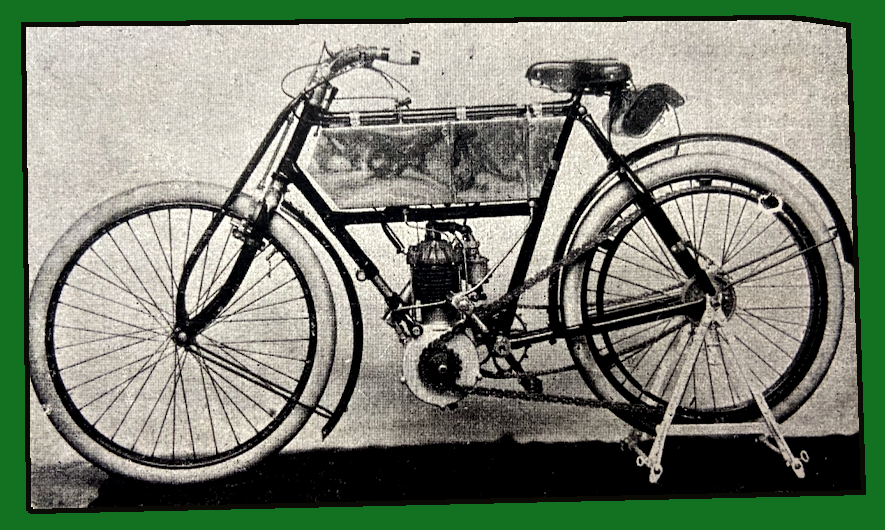
Bowden band brake on back wheel, Bowden front brake, plated tank, Longuemare carburetter. Mabon & Co, Clerkenwell Road, London, EC. This exhibitor showed three machines—the first a Mabon Trimo motor-cycle fitted with Minerva engine of 3¼hp, belt driven; the second and third being Mahon cycles fitted with Mahon engines of 3¼hp and weighing 110lb. A novelty is the blower for air-cooled engines to drive off the engine pulley. The machines are fitted with Clipper tyres and Bowden brakes. G Strauss & Co, Upper Thames Street, London, EC. This firm showed the well-known Fafnir engine, from 2¼hp to 24hp. The small Fafnir engines have an exhaust valve governor which is designed to be worked from the handlebar by a rod; this varies the lift of the exhaust valve, and so regulates the power of the explosion and the speed of the engine. The larger engines are governed on the inlet, and have mechanical inlet valves. The Fafnir engine is made by the Aix la Chapelle Steel Works. Steiner & Co, Houndsditch, London, EC. This firm had novelties in acetylene lamps which, when filled, burn one hour and a half; refills can be carried in the pocket at a cost of one halfpenny each; they are clean to carry, being in an air-tight box, which has to be broken before the refill can be used. Other items of interest were shown, such as horns, handles, saddles, toe-clips, oil cans, chain adjusters, etc. Thomas Smith & Sons, of Saltley, Birmingham. The forgings and drop stampings of this firm are so well-known as to need little description; every conceivable, part of cycles, motorcycles and car fittings was represented here. The. firm also make and sell to the trade a 2¾hp motor possessing many very practical points. The frame is particularly well made and thought out, combining strength with lightness. They also supply a complete set of the parts to enable the small maker to produce a finished machine. A very neat folding stand having its attachment to the chain stays and so permitting the wheel to be drawn or the bearings to be adjusted without difficulty was exhibited. Geo Norris. In addition to the Pedes-Cyclo shoes which are suitable alike for cyclists and motor-cyclists, this firm also showed the Utility boot, which is intended more particularly
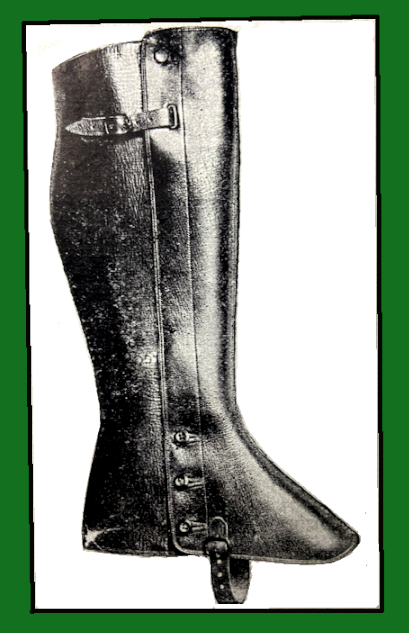
for riders of motorcycles. The lower part of this boot is fastened by a strap like the Pedes-Cyclo shoe, and the upper part is fastened with an additional strap. The straps are fastened with special buckles which do not pass through them, but merely press into them, thereby enabling the straps to be fastened at any point. This firm has recently put on the market the Moto-Cyclo legging which has a stiffened leg portion and soft upper and lower parts, making it easy for or walking. Some skins were on view showing the quality of leather employed in the manufacture of these goods. Ferrubron Mfg Co, Queen Victoria Street, London, EC. The ‘Gartor’ lubricant for motor and cycle chains was displayed. Users speak highly of this preparation, which besides acting as a preservative cannot clog or gum. Another thing in its favour is that it does not stain the hands or clothes. Cooper & Co, Manchester. At this stand were to be found a large number of useful accessories, including electrical novelties. A well designed motor-bicycle, priced at £35, was a prominent feature: this type is fitted with a vertically placed 2¾hp motor, having a 75x80mm bore and stroke [353cc]. Generally speaking it is built on standard lines, but a noticeable departure is an exposed inlet valve spindle, which if damaged can be repaired without having to remove any caps. The FN carburetter is fitted. The Motor Castings Co, Gray’s Inn Road, London, WC. A novel two-speed gear for motor-bicycles was exhibited here. This combines in one mechanism the following advantages—Two speeds, free engine, chain drive, spring clutch and great compactness. The whole gear and chain can be enclosed in a neat oil-retaining gear case. Castings for, as well as the complete, De Dion pattern engines were shown, in 2¾hp, 3½hp and 4½hp sizes, all air-cooled; also a 6hp water-cooled engine. The Motor Castings Co are fortunate in
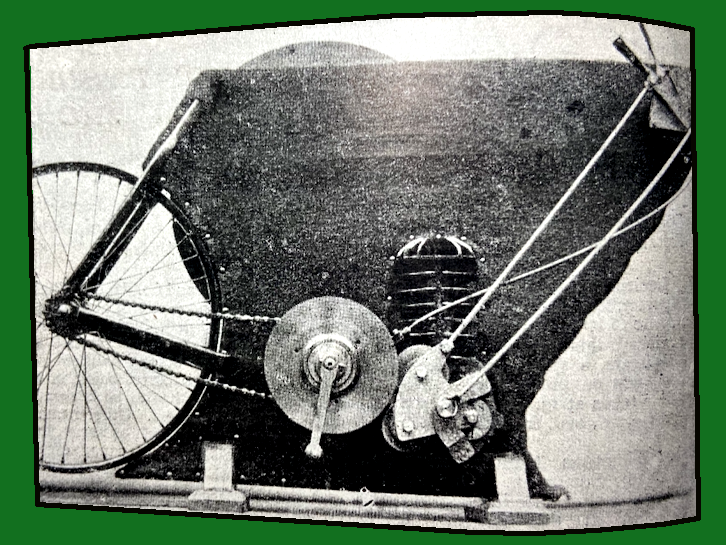
having a large stock of the new (genuine) Longuemare carburetters, with automatic air inlet, for motors up to 3hp. The trade should note this. Black Pneumatic Tyre Co, Glasgow. Black tyres for motorcycles and quads and made from Moseley rubber and fabric attracted considerable attention. Solution, tyre repair shields and air tubes were also noticeable: Flap covers for replacing worn out wired covers figured amongst the novelties, as also did the Clydesdale covers which have an improved non-slipping tread. James J Duffy, Carrickmacross Ireland. The exhibit of this firm consisted of a special form of spring claimed to be a universal non-vibrating device, applicable to cycle frames, front forks, saddle springs, etc; in fact, in every position where vibration is known to exist. The principle on which it is designed is as follows: A flat spring is so bent that it permits a spiral spring to be placed in tension between its points, somewhat in the form of the letter ‘C’, with the upper and lower points elongated so as to pass each other with the spring between. This idea permits of the tension being easily adjusted. AW Wall, Farringdon Street, London, EC, exhibited the Roc motor-bicycle, a machine having numerous novel features, and which proved a most interesting exhibit. The motor is 4hp, mounted vertically, and the frame is of extra length in the wheel base. Transmission is by V-belt on to a rear pulley, constructed in a novel manner from steel flanges stamped out. The inside of the groove is lined with a non-slipping fabric, which. should give an excellent grip. The ignition is another special detail, consisting of a small magneto dynamo driven by chain, and working through a special induction coil to an ordinary spark plug. The rear belt rim is so devised that it provides a free engine at will. There is a clutch on the inside of the wheel, and this can be put in and out of action by a foot lever. There are no pedals to this machine, but substantial foot rests are fitted. The sample frame also shown was a most substantial piece of work, the head being especially strong. The front forks are duplex. A handlebar switch, extra petrol capacity, vibrationless saddle, spray carburetter, and sight feed lubricator are good features. A well designed twin-cylinder machine of 4hp was also shown. The brake gear and clutch lever has a combined action, and there are numerous detail improvements. Terrot & Co, Dijon, France. Four motor bicycles of 2½ and 2¾hp were staged here. The engines themselves do not possess any special features, but in each case a new form of silencer is

fitted. The sparking plug, too, is attached to the combustion chamber in a novel manner, the sparks being seen through a glass observer. Powerful brakes are fitted, one of which acts as an interrupter. The carburetter is the well-known and widely used FN. The machines are belt driven, and are similar to those which have performed so well upon the Continent. The Cosi-Car Co, Warwick Street, Regent Street, London, W, exhibited the Cosi-Car. It is an attachment that fits centrally over the driving wheel of the motor-bicycle, and is made to carry one, two or three passenger. It can be manipulated from the saddle, or by means of a special handlebar. The body is of the ‘Tonneau’ pattern in aluminium, and room for luggage is provided under each seat. It is adjustable as to load, so that the weight can be equalised between the wheels of the car and the back wheel of the cycle. The price is 20 guineas. Reliance Engineering Works, Coleman Street, Southampton. The NAB spring seat pillar and handlebar shown at this stand have been somewhat improved for 1904, but the principle of ball-bearings between the two moving parts remains the same. A new method of controlling the carburetter and throttle on motorcycles was also shown. The handlebar is provided with a sliding knob near each handle. These knobs are moved by the thumbs and, by means of Bowden wires, actuate the carburetter lever and throttle lever. Geo Lyons and Co, East Street, London, W. The Trafalgar motor-bicycle and flexible side-carriage was shown in various patterns, powers and finish. The 3¼hp engine is situated in the popular vertical position and strongly bolted into the cycle frame. The axle of the near wheel of side-carriage is brought seven inches behind the centre of back wheel of the bicycle, the two machines being connected by a hinged flexible joint and a rubber lined clip. This enables the cycle rider to balance and steer his machine just as if it were free. FJ Anderson, Furnival Street, London EC. The Elswick motorcycle belt which is so widely used was prominently displayed. It is of V-section, and is made from chrome-tanned belting with two insertions of sailcloth. It is closely copper wire sewn. A non-slipping fibre cement pulley covering is a useful innovation. A good dressing for belts, styled Strapoline, was also to be seen, as was a clutch for providing a free engine, and a new form of speed indicator. The NSU Co, Neckarsulm, Wurtemburg, Germany, exhibited a delivery car with a 3½hp water-cooled engine featuring a mechanical inlet valve and magneto electric
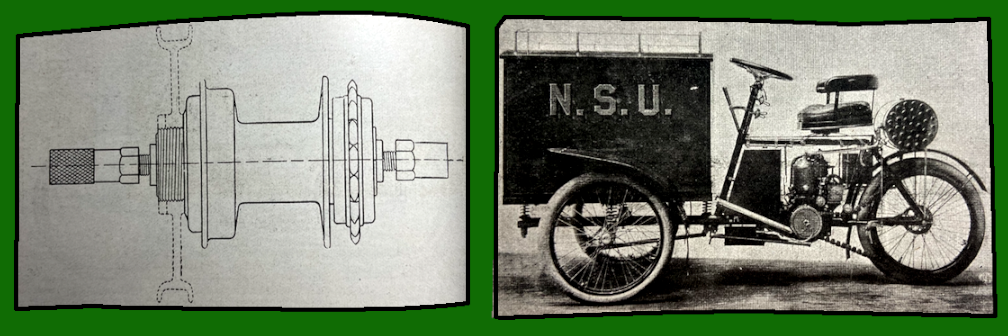
ignition. The transmission is by a combination belt and chain with jockey-pulley adjustment. Instead of an ordinary saddle a cushioned seat is provided. A spray carburetter is used. Hub Two-Speed Gear Co. For over a year the Hub Two-speed Gear Co of Salford, Manchester have been experimenting with a variable speed device for motorcycles. The experimental stage over, they have been able to produce a piece of mechanism which is not only as ingenious and as beautifully made as their widely used hub for ordinary cycles, but which is likely to be equally effective. As a matter of fact the motorcycle hub is to all intents and purposes a larger model of the older device, but stronger, and especially adapted for the work it has to fulfil. The hub is adapted for either belt or chain drive and can be fitted to any standard motorcycle. It is operated by a lever, fitted to the top rail of the frame. By pushing this forward the high gear is obtained; the low gear is secured by an opposite movement, whilst an intermediate position gives a free engine. As the result of tests the makers have decided on a gear ratio difference of 24%, as they consider this to be the most suitable for the general condition of British roads. Several well-known firms plan to adopt it as soon as arrangements for its manufacture are complete. The feature of its being adaptable to any ma-chine is a specially valuable one, as this will enable a motorcyclist to avail himself of the advantages of a two-speed gear without heavy expenditure on alterations. May Bros, Clapham Road, London, SW, exhibit comprised six handsomely designed and exceptionally well finished

motorcycles, which attracted numerous visitors, especially as the stand was situated in the entrance. Various makes of engines of different powers are fitted, including MMC, Minerva, Fafnir, Rex and De Dion. The most striking machine, however, was one with a 5½hp De Dion motor, which is specially designed for racing purposes. JE Hutton, Shaftesbury Avenue, London, W. Several excellent models of Princeps motor-bicycles were staged. These were of two types—chain and belt —and of various powers. We were particularly impressed with a 4hp chain-driven twin-cylinder model attached to a well-designed and easily steered fore-car. The engine, which has a bore and stroke of 70x72mm can be freed by the operation of a combined cone friction clutch and. spring drive mechanism, fitted to the to engine shaft, and carrying the chain wheel. It is put into action by the use of a small lever, which permits the engine to be started before the rider mounts, or to be stopped for coasting and cooling purposes. It is claimed that the gradual and progressive engagement of the clutch prevents any jarring strain on the chain when starting the machine, or when running at slow speeds, and that, with the action of the spring transmission, a smooth drive is obtained. Special adjustable valves are fitted, while the Vaur’s float-feed spray carburetter is adopted. The commutator is of special design; by its use only one coil is necessary for the two cylinders. The frame is strongly built and nicely finished, and the forks are of the girder type. The power of the.engine is conveyed to the road wheels by a Hans Renold ⅝ pitch motor chain, and the drive being positive no power is lost. An ingenious variable gear and free engine pulley is attached to the belt driven models. It is, we believe, the only appliance at present invented for providing a gear variable at will and free engine, in conjunction with belt driving. The Riley Cycle Co, Coventry staged the Riley tri-car, which is fitted with a

3½hp water-cooled engine. This is mounted vertically, and the power is transmitted by a long V-belt. It is convertible, and has an additional bearing close to the point where the rod is coupled to the steering post. This arrangement, which was adopted about five years ago on the Riley quadricycle, gives a very rigid form of steering. M Romain Talbot, of 67, Rue de la Victoire, Paris, had a distinct novelty in the Zedel 2½hp engine for motorcycles, inasmuch as the inlet and exhaust valves are operated by one cam only, which performs its work by setting in motion a series of discs acting directly on the valves. Not only is there simplicity of action, but it is claimed the method ensures accurate timing. The Zedel carburetter is also an interesting device. For cleaning purposes it has a patent spring needle, worked from the outside. It is, therefore, operated without having to open the carburetter, an advantage which will commend itself to many. Mr Talbot is the sole agent for the British Colonies and Germany for the Zedel motor and carburetter, but the English trade can be supplied with complete machines fitted with both, or the carburetter may be obtained separately. The Oxford Automobile and Cycle Agency, George Street, and High Street, Oxford showed machines including one fitted with a 2¾hp MMC motor, belt drive and weight 140lb. One was fitted with a 3½hp De Dion engine chain-drive and friction clutch, and another on similar lines with 2¾hp De Dion engine. The Morris fore-carriage has a 2¾hp MMC motor with chain drive and friction clutch. Special features of the firm’s latest machines are the chain drive, free engine and clutch, handlebar control, mechanical valves. The whole collection of machines was characterised by excellent design and workmanship.
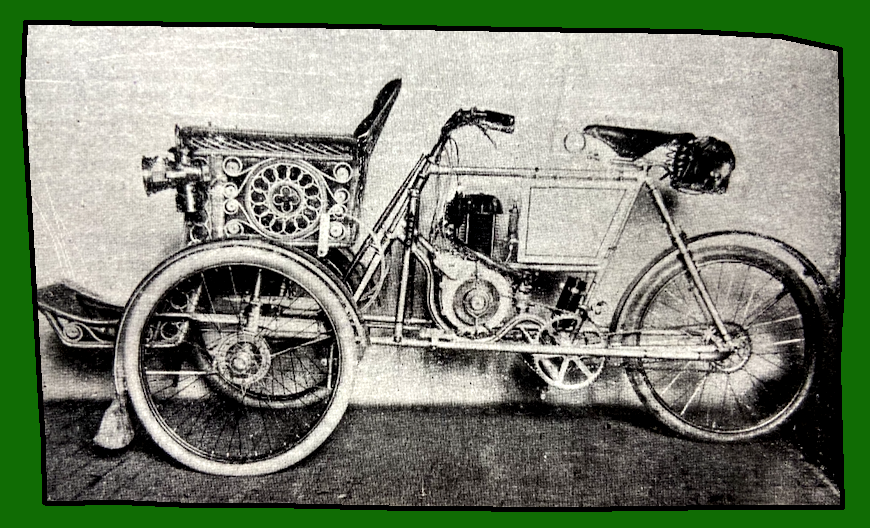
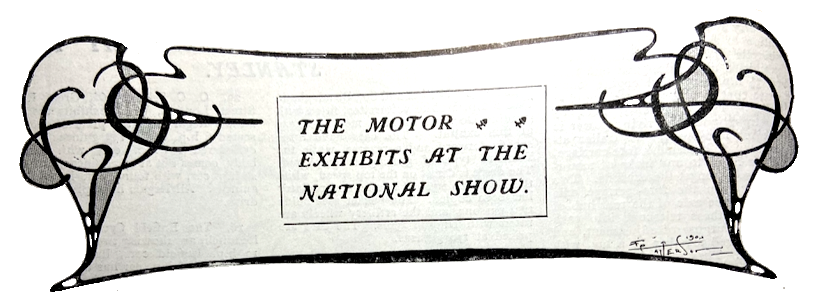
The Raleigh Cycle Co, of Nottingham, have come to the front with a bound. It has been obvious to all who know the company and its traditions and who were acquainted with Mr GP Mills that the reason why a Raleigh motorcycle (we mean in the full meaning of the word ‘Raleigh’) had not previously been placed on the market was that hitherto Mr Mills had not satisfied himself that he had secured or produced the best possible article. The new Raleigh is well in advance of modern ideas. It is driven by a 3hp governed engine, the governor permitting the machine to travel at any required speed. It is claimed that the elasticity of the engine is so remarkable that the machine may be entirely controlled through the governor. The power is communicated by chain from a spring clutch on the engine shaft to a counter-shaft and thence by chain again to a spring chain wheel on the driving wheel. This method gives great flexibility to the drive and overcomes all jar and shock. The machine is well equipped in every particular. Large tyres are used and the head of
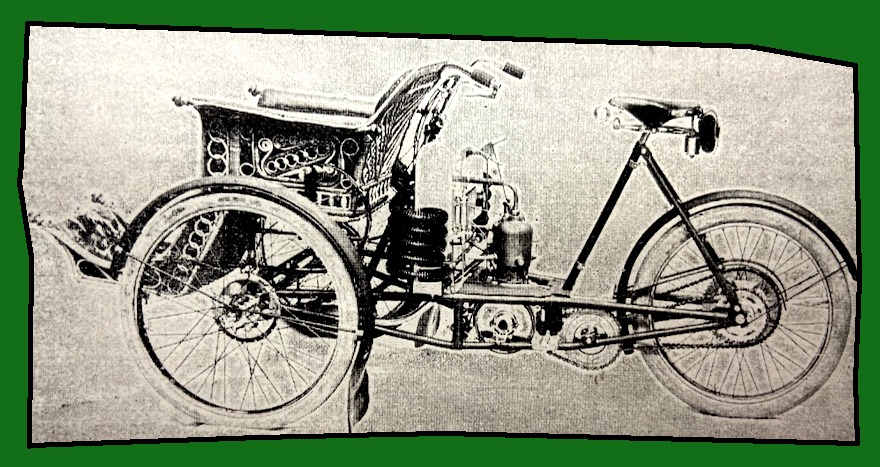
the machine is a sound piece of work. Twin accumulators with a two-way switch are provided, and every detail of the machine is rendered thoroughly accessible. If required the new Raleigh two-speed gear may be fitted at an extra cost. The machine is minus pedals, but these are rendered quite unnecessary in the circumstances. A similar machine, but with belt drive, is also made. Another Raleigh novelty is the three-wheeled motor tandem known as the Raleighette which is practically a three-wheeled car for two persons, the driver sitting at the rear on a large saddle, and the passenger sitting in the fore-carriage seat. The frame is specially designed, and is an excellent piece of girder work. The space between the driver and the engine is clear, and he is able to mount and dismount with the utmost ease, and to keep within the compass of the machine. The 3¼hp engine is water-cooled; the large tank in front has five compartments and carries the radiators on each side. The upper compartment of the tank is the water reservoir; below this on the left is the oil reservoir, and below that again is the compartment for the coil; whilst on the right hand side of the tank there are two compartments, one for tools and parts, and the other for the twin accumulators. The tank between the seat post and rear wheel is for petrol, with a further useful space below. Thermal circulation is employed for cooling, thus dispensing with the complication of a pump. A starting handle is provided and the engine is started and then thrown into gear with a leather-faced clutch actuated by a foot pedal, another pedal for the right foot applying the brake. The power is then taken by a chain to the countershaft, whence two chains carry the power to the rear wheel. On the left side is the high gear, and on the right the low gear, one or other being thrown into engagement with the hub by means of a twisting handle. The mid-way position provides the free engine. Band brakes to the two front wheels are provided. The new Raleigh method of controlling the engine by varying the lift of the exhaust valve is adopted, a twisting handle being used for the purpose. The engine is fed from a Longuemare carburetter. The price quoted is £95. Moderate priced motorcycles with 2hp engines are also staged. Altogether the Raleigh exhibit is one which must not he missed. Starley & Co, Coventry. One of the most interesting cycles in the Show is undoubtedly that staged, by the above
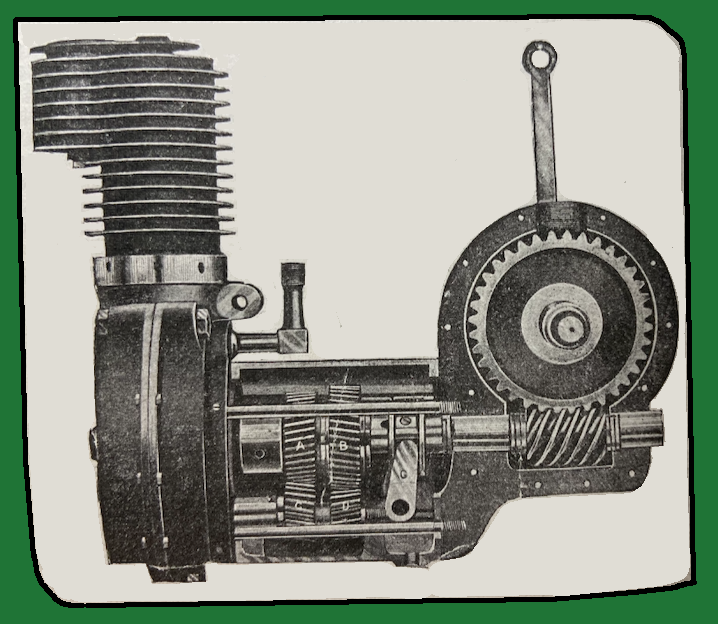
company. It possesses quite a number of original features. Its 2hp engine is of the single-cylinder vertical air-cooled type; it is free, and is fitted with a two-speed change gear. The motor drives through a single chain and a worm gear which is the most striking feature of the machine. This system of transmission not only gives increased power, but is more silent and less subject to vibration than those usually adopted. The worm has six threads and is so designed that it is reversible—that is to say, it works in unison with the worm wheel whether it turns forward or backward. The latter possesses 36 teeth and its speed therefore is one-sixth greater than the worm. A shaft passes through the worm wheel centre, to which are attached ‘the usual pedal cranks. A free-wheel clutch fitted between the crank spindle and the worm wheel enabling the rider to ‘freewheel’ at will. A similar arrangement is also attached to the back hub no that the engine can be freed at will for coasting purposes. By the aid of two tube supports the engine may be put in operation before starting out. The tanks are well-designed and not too bulky. Indeed the machine bristles with good points, and we are not surprised to hear that the demand for it is greater than the firm are able to supply; but this will soon be remedied. Mills & Fulford, Coventry. This exhibit, which is most tastefully arranged, was the first to be ready for inspection, and it is well worthy of a visit. A large number of forecars and trailers are on view, and the entire display reflects the greatest credit upon the enterprising exhibitors. The firm now supply motorcycles and cars complete, and several handsome combinations are noticeable, the two ‘Trykars’ being particularly striking. On one the fore-car is well sprung, and is made of raffia cane, tastefully upholstered in pegamoid. The other has a tonneau-shaped coach-built body upholstered in morocco. The engines are made by the Hamilton Motor Co, Coventry; they are cooled by fans connected with the driving pulley. Side-cars are also shown—one with a patent steering device being particularly comfortable—as well as de-livery cars, and a sample of the carrier which the firm supply to the postal authorities. The pioneers of sociability with the motorcycle, Messrs. Mills & Fulford are never content to stand still, but are always improving upon their past record. New Centaur Cycle Co, Coventry. Two handsome types of motor-bicycles—chain and
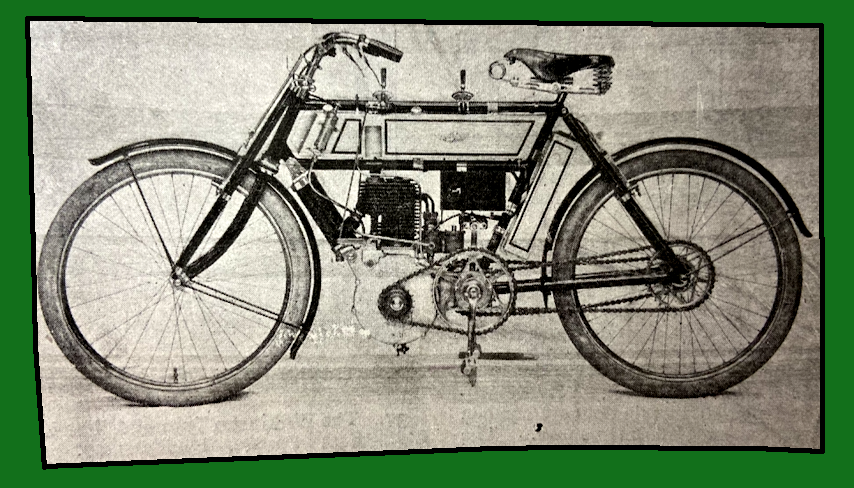
belt driven—are to be seen here. The machines, including the engines, were manufactured entirely in the company’s factory, and from their own designs. The engine on both types is placed in a vertical position, and although it is built into the frame it is easily detachable. It is described as 3hp, but as a matter of fact it is of higher power, as no motor is passed out of the testing shop until it registers about 3¼hp on the brake. The valves are readily accessible, the inlet being mechanically operated. An interesting feature of the machine is the novel form of silencer: this in reality forms a part of the frame—in fact it supersedes the usual down tube—and gives the machine a very compact and smart appearance, and is at the same time an exceedingly original and effective device. A patent anti-vibratory head is fitted. This takes the form of rubber buffers which are placed between the crown and the strong duplex forks which are a feature of the machine. A Longuemare carburetter and Carpentier coil. are used, while two accumulators, which are enclosed in a neat case, are provided with a two-way switch, which enables either to be immediately brought into operation. The chain-driven machine is fitted with a smartly designed friction clutch which, it is claimed, prevents any harshness in the drive. Both machines are well worthy of inspection, and we congratulate the firm upon the smart appearance and up-to-date features of their exhibits. The detail finish is well up to the firm’s high reputation which they have earned for their cycle work. WP Brough, Kettering and London, shows the 3½hp Marsh motor bicycle, which has an American flavour about it. The engine is built into the frame, the main down tube of the bicycle joining the top of combustion chamber. A flat belt is employed,
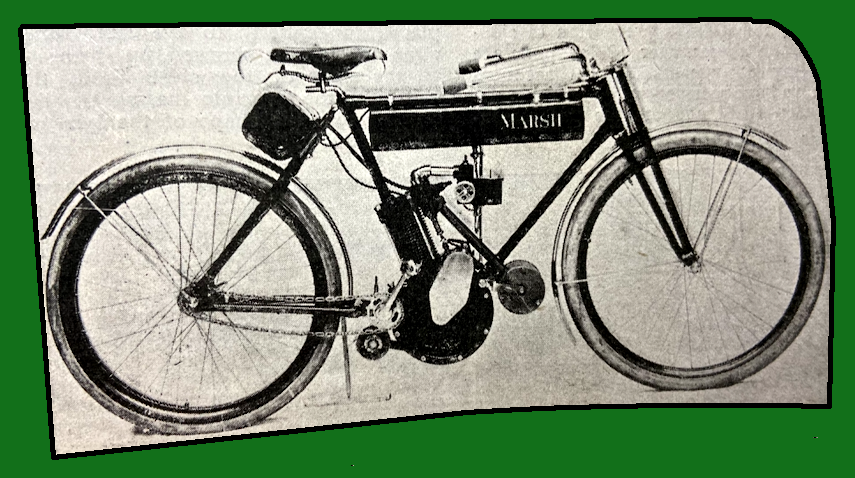
with a jockey for tensioning purposes. Features of the Marsh are its very large silencer, which is good, and its wood rims, which are not. Frank H Parkyn, Wolverhampton. This firm show six motor-bicycles. Last year they used the Minerva engine, but for 1904 they are making heir own: this is of 2¾hp, and is situated in the usual vertical position, the tube from head to bracket being looped under the crank-case of the engine. Spray carburetter, V-belt, and other modern details are embodied. Ignition is effected by accumulators and coil, and the contact breaker has good features. Self-Sealing Air Chamber Co, Hinckley Street, Birmingham, in addition to a fine display of general rubber goods, are showing a range of specially strong self-sealing inner tubes for car and motor-cycle tyres, in all sizes; also a new non-slipping tread. This maybe described as a series of Ws, raised on the tyre. It is named the Zig Zag, and should prove very effective. This firm make a speciality of vulcanising treads on to torn motor tyres. The Dunlop Pneumatic Tyre Co, Birmingham, London, and almost every-where else. The old original firm are still in the very front rank of tyre makers. They show Dunlop tyres for motors, bicycles, and vehicles of every description. The Dunlop non-slipping motor tyre is now well known, and the imprint of its corrugated surface is to be found on all roads used by motorists. The Dunlop

Rubber Works also produce waterproof motor clothing, rubber mats, driving aprons, in fact all rubber motor goods. The Dunlop stand is an elaborately designed edifice at the foot of the great orchestra, and prettily decorated with green trellis work and many mirrors. Montgomery & Co, Bury St Edmunds, have a very fine array of their patent side-carriages, no less than ten being effectively staged. A novelty shown by this firm is a double side-carriage. This is really a motor-bicycle, with 3½hp motor, fitted with a carriage on each side. The side-carriages, of course, have the patent compensating joints which have proved the secret of its success. The joints allow the carriage to ride with great smoothness over rough ground, and its ease of fixing is remarkable, only two bolts being used. The company make a speciality of fitting the Kerry motor, which they have found an eminently satisfactory one. The Ensign motor-bicycle is a special line, fitted with 2¾hp motor, 80x83mm [417cc], FN carburetter, with throttle and air levers and electric (high-tension) ignition is used. The silencer of this machine is large and effective, and the petrol tank has a capacity equal to 130 miles’ running. The duplex pattern front forks and a neat handlebar switch are good features. The finish on these machines is exceedingly good. Pitcher and Bartlett, Holland Park Avenue, London, W, show their P&B motor-tandem. This machine has several excellent features which should not be missed, notably the design of the frame and position of the engine. The transmission is by a crossed belt, which the makers claim has many advantages over a plain belt aides, The frame is adapted for a lady rider, and should prove a popular mount. The Clarendon Co, Coventry, show a collection of 12 handsomely finished motor-bicycles. The motor is mounted vertically in a loop frame, and has the company’s’ patent ball-bearing pulley fitted. The motor is of 3hp, driving by belt; Longuemare carburetter and high-tension ignition are used. The inlet valve is mechanically operated, and the front forks are duplex. The coil and accumulators are fixed behind the down tube. The machines are fitted with Dunlop or Clipper tyres. All the parts of this machine are standardised. The belt drive is unusually long. The levers are all fitted on friction quadrants, and the carburetter has a very convenient air regulating lever. The petrol capacity is equal to 120 miles running, and the accumulators fitted are the well-known Lithanode. Hillsdon & Co, Hungerford, exhibit their Eddington tandem
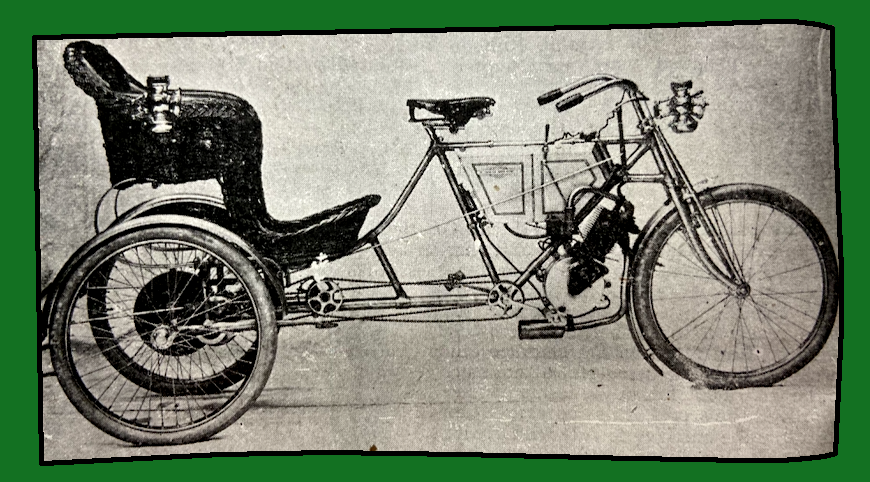
motorette, fitted with 4½hp Automotor engine, water-cooled. It is provided with a Dupont two-speed gear and free engine. A special point is that the engine can be started either by hand or pedals. The chairs are easily detachable, and a small parcels delivery box can be fitted for tradesman’s use. The tyres are 2½in Dunlops. The whole machine is distinctly on new lines, being similar to a tandem tricycle, with rear carriage. All the control levers are arranged for the front rider to operate. There are two patterns, the No 1 air-cooled motor, and No 2, as just described. In the smaller power machine the motor is mounted on the down tube, and drives on to the Dupont gear by a long chain, or the makers will fit a bevel gear and shaft drive. Another new pattern to be introduced will have a chain drive on to the back axle, something similar to the Locomobile steam car drive. There is also a 3hp motor-bicycle shown made up with Chater Lea fittings. Hans Renold, Manchester. This firm shows a variety of chains for many purposes, from that used on the ordinary pedal bicycle to that suitable for the heaviest type of motors, and although this make of chain has been four seasons before the public the makers do not see any necessity to make any radical alteration except as to price, so that whilst the price has gone down, the quality has remained constant. A special ⅝in type is made for the chain-driven motor, and amongst its users are Humbers, Centaurs, Singers, Raleighs and others. The Wilkinson Tyre and Tread Co, East Parade, Huddersfield. The Wilkinson non-skidding tread is now well-known. It is made in sizes and thicknesses to suit motorcycles or heavy cars, and consists of a tread or band of rubber into which are vulcanised innumerable wire spikes—similar to engineers’ file carding; these spikes project through the rubber and get a good grip of the road. The New Wilkinson outer cover is also on exhibition: this can be tilted over his tyres by the motorist himself, being held on by inflation; it acts as a prevention of side-slip, and a discourager (?) of puncture producing implements. From accounts a which we have received we believe that the Wilkinson tread answers the purpose intended. The Star Cycle Co,
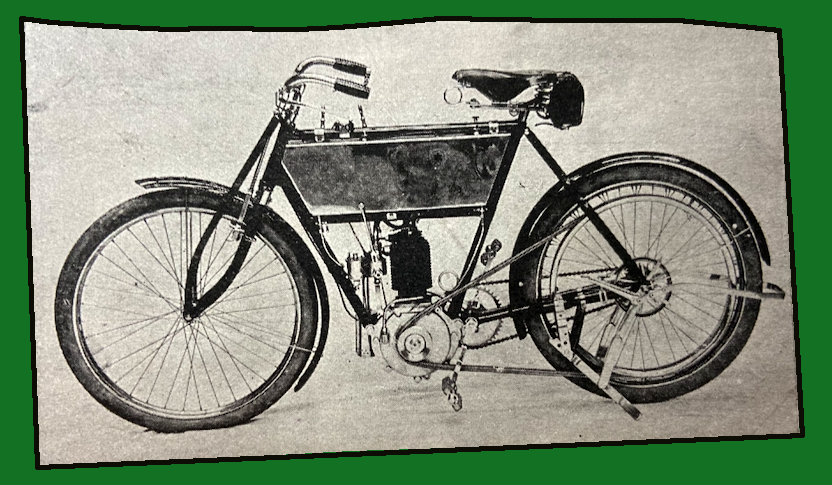
Wolverhampton, are displaying a fine collection of motorcycles built on popular lines. The engine is air-cooled, and is placed vertically in a cradle joining the lower tube which is taken from the ball head to the crank bracket. The engine is fed by a Longuemare carburetter with suitable adjusting levers. The tank holds a gallon of petrol, the accumulator, coil and oil compartment. The feed pump is contained in the oil tank, the oil being drawn in through an automatic valve which opens from the tank under suction, and to the engine under pressure. A compression tap is fitted to the engine. The drive is by a V-shaped Adachrome belt, the gearing being 5 to 1. The brakes are applied to the rim of the front wheel and to a drum on the rear wheel. The 2½hp machine sells at 40 guineas, and the 3hp at 46 guineas; the machine being equipped with tools and tool bag, guards and duplex forks. The Hamilton Motor Co, Coventry, who are fast coming to the front, have two of their 3¼hp engines fitted to fore-carriages on Messrs Mills & Fulford’s stand. The cylinder and combustion chamber of this motor is one casting, possessing large radiating gills which run half-way down the cylinder. The bore and stroke are 3⁵⁄₁₆in and 3¼in respectively [458cc—and an early example of an over-square engine];
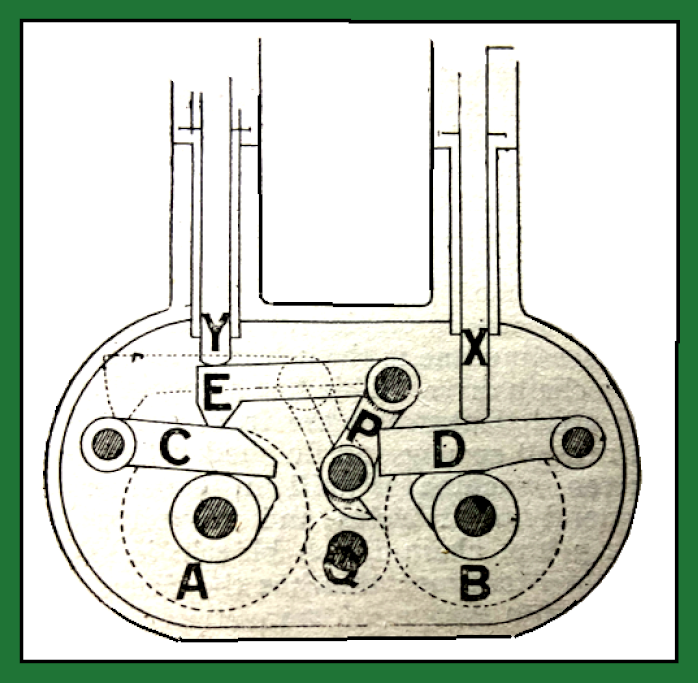
the width over contact breaker and pulley is 7½in while the total weight is only 581b. The contact breaker is of the wipe spark pattern, and the valves are mechanically operated. The fly-wheels have the crank pin and shafts stamped solid and have hardened sleeves pressed on; accordingly it is impossible for a wheel to come loose, while the system allows of the use of larger bearings. An interesting feature of the engine is the firm’s patent valve gear by means of which the induction valve is controlled by a Bowden lever hand wire from the handlebar. The gradual movement of this reduces the lift of the induction valve to zero, whilst a further movement lifts the exhaust valve and leaves the induction valve closed. The firm claims by this arrangement simplicity of control in traffic, the dispensing with throttle valve, greater economy, and higher speeds. Charles Peacock and Co, Clerkenwell Road, London, EC, have a highly interesting display of small motors and accessories, ignition accessories being a strong line. This firm have introduced complete sets of parts for De Dion, Werner, Minerva, Darracq, Panhard, Aster and other standard motors. The small motors shown comprise a 1½ and 1¾hp, beautifully made, for a narrow-tread machine. The inlet valve is readily accessible from the outside, and a clever idea in the way of valve lifters is fitted. A novel arrangement of oiling is used; thus the oil from the pump is carried direct to the bearings first, and then into the crank case. The spark plug is fitted right in the centre of the head. The two-cylinder motor shown is 4½hp, designed for driving a fore-carriage. The other novelty is a two-stroke
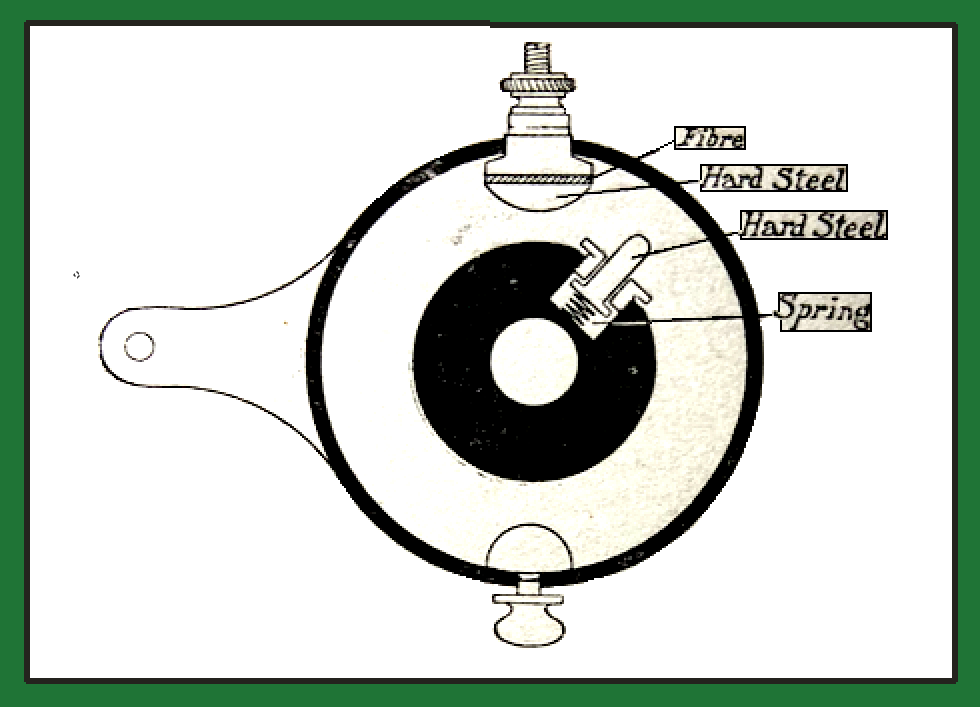
motor, remarkably light, weighing 18lb only, and claimed to develop 2¼hp at a very high speed. A very long bearing is a good point, and also an automatic oiler. The radiating surface is extra large. Other good lines are gear-wheels, lamps, horns, accumulators, pumps, speed indicators, measuring instruments, etc. The Buckley Motor Wheel and Carriage Co, Sheffield. A 2½hp engine is slung in an aluminium spoked wheel on the lines made popular by Singers, with the additional advantage of a through axle: a small pinion on the engine shaft drives the large gear wheel. White & Poppe, Coventry. This firm shows a motor, designed and made entirely by themselves, having many special points, amongst which is the great advantage of being able to detach both the exhaust and inlet valve boxes for cleaning, whilst the adjustment is made by a screw and lock nut. The valve is driven by a separate cam of special construction. Each of the cams drives a lever, and this operates the valve lifter. Special attention has been paid to the contact make-and-break so as to obviate wear and tear and ignition troubles. All the outside case bearings are in blind bushes. The working parts are well designed, proportionate, and of spring steel whilst nickel steel is employed on such parts as work under heavy strains. The firm also makes a speciality of what is known as gauge limit work, which provides the certainty of any part so made being certain to work without fitting. A very neat little screwdriver is amongst their exhibits, as well as machines for cutting threads, four-spindle drilling machines, the large gear, etc, the firm making a speciality in shell fuses fox the British Government. Chase Motors, Anerley, London SE. This firm shows a stand full of motorcycles
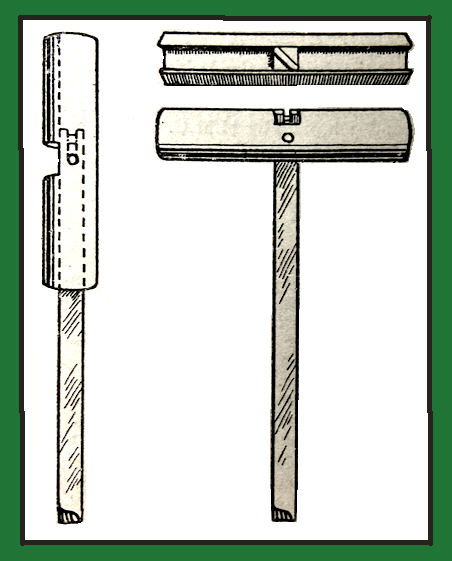
varying in power from the 2½hp ordinary road machine to the 3½hp special racer, although the latter size is equally adaptable to the former class. The engine is either the Ariel or the MMC, according to the size, the latter being for the 2¾hp and 3½hp, whilst the former is for the 2½ and 3hp. The MMC engine is so designed as to take the place of the down diagonal of the frame, being securely bolted into it within a pair of segments which are attached to the front and back members, thus allowing for the easy withdrawal of the engine. The engine is placed as far forward as possible, so as to allow of a long belt drive, a point often forgotten in the life of the belt; at the same time, this forward position produces a much longer wheel base, minimising side-slip and maintaining great steadiness in the machine. The Longuemare carburetter with throttle is fitted. The levers for advance sparking and the throttle are mounted on cone bearings with a Thackeray spring washer on each; thus a free but rigid lever is provided. Bowden wires operate the valve lifter and the back brake, and the main wiring is concealed as much as possible so as to prevent moisture getting to wires, or other damage. The combination tank provides for 1½ gallons of petrol, one pint of lubricating oil, two P&R accumulators, and either a trembler or ordinary coil, at purchasers’ option. The history of the Chase family is so well

known that the public can depend upon every point likely to occur in the design of a motorcycle being carefully thought out by them. It will be remembered that the Chase secured the Auto-Cycle Club’s first-class certificate in the 1903 Trials.
Chase also exhibit specimens of their patent Flexo raw hide belt, which is claimed to be superior to all other forms cf V-belt. The belting is composed of five plies of raw hide, cemented together, and sewn with copper. It can also be supplied as a flat belt, both single and double ply. The Whippet Motor and Cycle Co, Clapham Junction, have a well-finished fore-carriage, fitted with 3½hp Aster engine. The transmission is by belt, and carburetter is a Longuemare type. A novelty is a sight feed lubricator for the motor. This machine has the well-known Whippet two-speed pedal gear fitted. A motor-bicycle is also shown. This has a 2hp FN motor, fitted vertically in a loop frame: a Longuemare carburetter and sight feed lubricator are used, and a petrol tank of extra large capacity is a special feature. Dunlop tyres are fitted, and a noticeable detail is the two-speed pedal gear fitted in a gear-case. This gear is actuated by a lever mounted alongside the down tube. Anglian Motor Co, Beccles. Three well-constructed belt-driven bicycles are shown here, all fitted with 2¾hp engines. The arrangement of the tanks is neat and novel. Singer and Co, Coventry, have a splendid display of 14 motorcycles. The leading line is the 3hp fore-carriage with chain drive. The gear driven machine is still in considerable demand for tricycles and tri-voiturettes The 3hp chain-driven bicycle is shown for the first time; this has the firm’s very successful system of transmission. The very latest development in Singers is the belt driver 3hp engine fitted in a special cradle in the centre of the frame. This has magneto-electric ignition, spray carburetter, tank arranged parallel
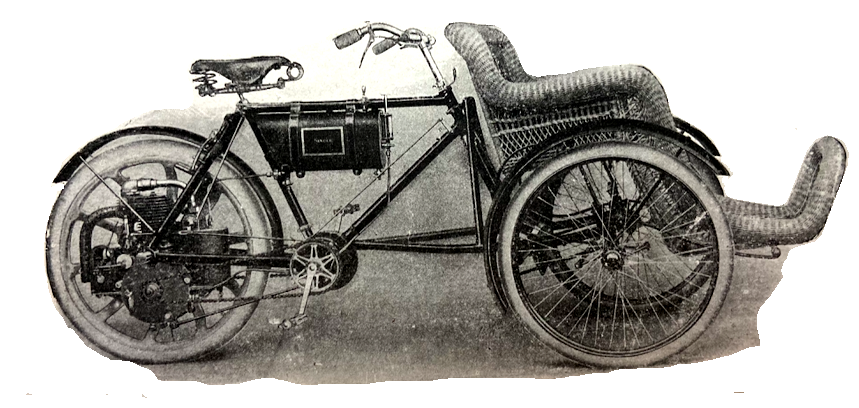
with the top tube, and a very special feature is a starting clutch for the engine. The control is effected by a single lever combined throttle regulator and exhaust valve lifter. The petrol capacity is equal to about 150 miles’ running. Duplex front forks and a very large and effective silencer are other excellent features. The finish of this machine is all that the most critical could desire. The price, with clutch, is 52 guineas, or 50 guineas without it. James Price & Sons, Fitzroy Place, Euston Road, London NW are showing their well-known Chez Lui enamels in an endless variety of colours. A speciality is an aluminium enamel for tanks, bonnets and radiators, and a transparent enamel for plated parts. Bayliss, Thomas & Co, Coventry, have an exceedingly fine display of Excelsior motorcycles on one of the largest stands in the exhibition. The 1904 Excelsior presents many novel features. The company are now making their own engines under
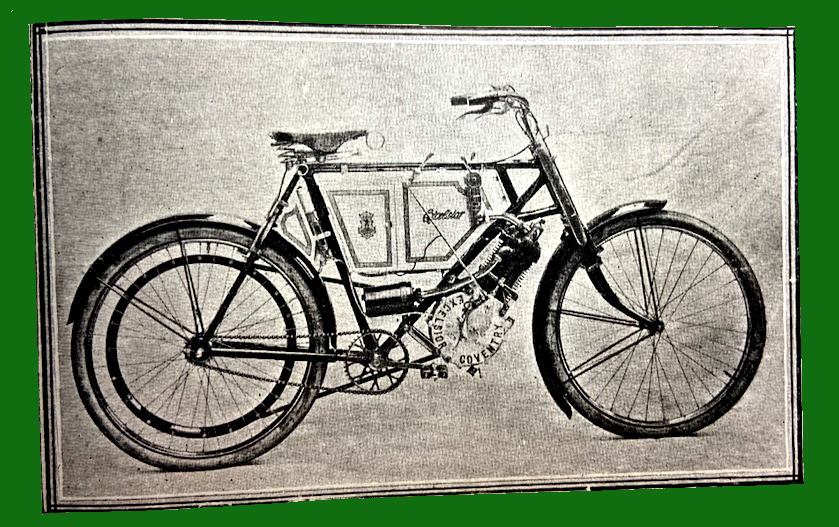
licence from De Dion’s, adopting the standards of that firm in the case of the two larger sizes. These are the 4hp water-cooled engine for driving fore-carriages. and the 3hp air-cooled engine for motor-bicycles, etc. A 2½hp engine is also being made. The leading line in Excelsior motorcycles is fitted with the 3hp engine, driving through a Lincona belt. We notice that the gear is now a shade lower than was the case last season. A very capacious tank is employed, taking about 2¼ gallons of petrol. Either the surface or spray carburetter is supplied, the former having a large surface area and feeding through a large mixture tap, the engine is never starved of explosive gas. The spray carburetter recommended as an alternative is the Longuemare, the adjusting levers of which are most conveniently placed. A wipe contact and trembler coil are being used, the contact being frictionless except at the moment of completing the circuit. Two Lithanode accumulators are used, the interrupter plug being employed to put one or other into the circuit. Special attention has been paid to brakes, and the new pattern of exhaust-lifting lever is particularly handy. With Clincher tyres, the 3hp Excelsior sells at 50 guineas. The same machine, fitted with the 2½hp engine, sells at £45. The Rex Motor Manufacturing Co , Coventry, make a really imposing display of motorcycles. No less than 50 samples of their 3¼hp
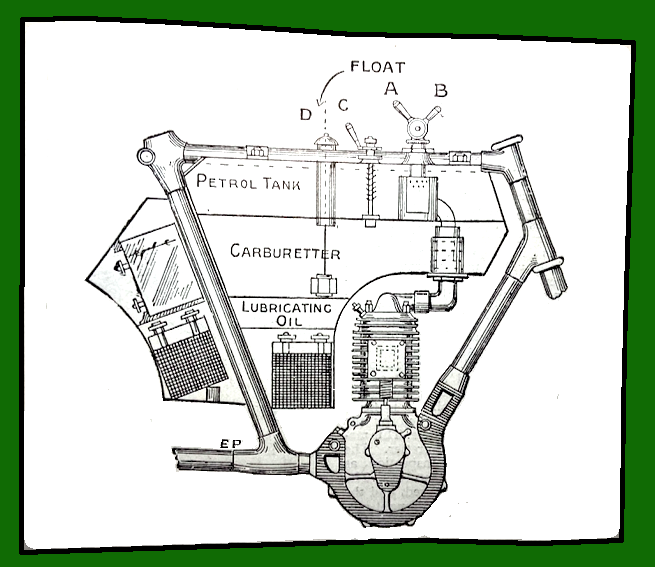
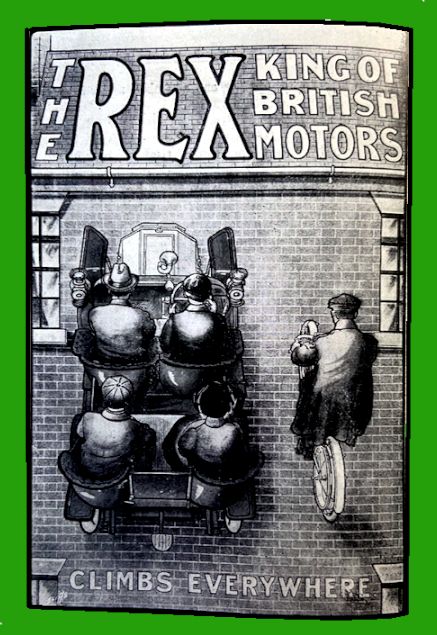
vibrationless motor-bicycles are shown on a stand occupying 100ft of space, the largest in the whole exhibition. Their high grade character is well-known, and their popularity is proved when we state that the firm have to employ an all-night staff in order to cope with the demand for them. The Rex system of silencing the exhaust is effected by the casting of an extra chamber on the side of the cylinder, from which the burnt gases issue through three baffle plates. This device does away with all back pressure, and there is no undue heating or loss of power. Further than this, the breaking up of the exhaust gases at the moment of expansion makes the silencer more effective. Another interesting innovation is an air passage between the exhaust chamber and cylinder: this gives a greater cooling area and it is claimed that it entirely prevents overheating. The coil and accumulator are now carried in the rear, thus reserving a capacious petrol and oil supply in the main tank. There is also space for a spare accumulator. The engine is now secured to the frame by only three bolts to a registered design of cradle. The carburetter is still of the surface type, but larger vaporising space is provided, the result being that a good mixture is assured, even if the petrol be above the ordinary density. The Adaptable Motor and Sporting Garment, Westbourne Park. The garment here displayed consists of the following combination which can be worn together, or, if desired, separately: Coat and waistcoat, frock coat, overcoat, knickers and driving apron. These articles of clothing are made of excellent material and are most suitable for automobilists. The prices range from £4 4s upwards. John J Plater & Sons, Birmingham. This stand is occupied by various carriage bodies suitable for attaching to motorcycles as trailers and fore-cars. All are of handsome design and mostly of the wicker type, but a coach-built wood fore-car with a circular back, painted and upholstered in green, is particularly attractive and comfortable looking. The Bat Motor Co, Penge, London, SE, have one of the largest displays of
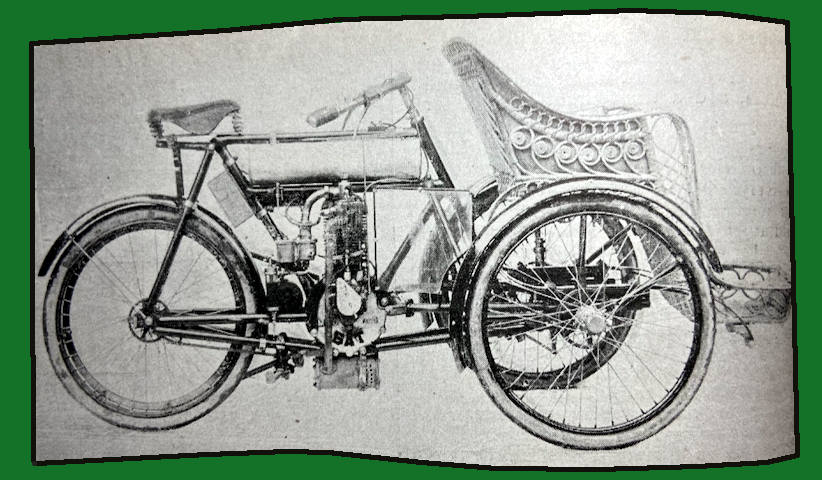
motor-bicycles in the Show, there being 24 machines staged. The No 1 machine is fitted with mechanically operated inlet valve, motor arranged vertically, trembler coil, Longuemare carburetter, new combined oil pump and reservoir, and a patent switch and brake lever device. The No 2 machine is made on racing lines, but suitable for the road. This has automatic valves, and the new Bat carburetter is fitted. It is controlled by a single lever fitted in front of the saddle. The spring frame machine will prove an interesting model. It is fitted with a new rim brake, applied by the thumb, and also a new foot brake. This machine also has the Bat carburetter. The fore-carriage has numerous special features. The frame is particularly well stayed, and the band brake gear is very well thought out. It is actuated by a foot lever, giving great power, and a clip is mounted on the handlebar for holding the exhaust valve up. The motor is a 3¼hp, fitted with the firm’s patent pulley, as are all their machines. The side-car is a very special line. The attachment is exceedingly strong and simple, and the motor fitted is 3¼hp and a special point is made of the fact that. the machine can be driven by the passenger when alone in the car. The firm are turning out a Special motor-bicycle, with many excellent features. The engine has a mechanically operated valve, new Longuemare carburetter with automatic air regulator, exhaust box, with a cut-out for hill climbing, and duplex forks, with a new system of adjusting the head. The coil is a Bassée Michel, and it is note-worthy that all the accessories about the Bat machine are of the highest quality. There being no pedal chain on the Bat machine, the belt can he readily adjusted by draw bolts on the rear axle. The handlebars fitted are of new shape and heavier tubing. This exhibit is bristling with good features, particularly the company’s new stand, lifting either wheel at will, and also a new air pressure lubricating arrangement. Quadrant Cycle Co., Sheepcote Street, Birmingham,
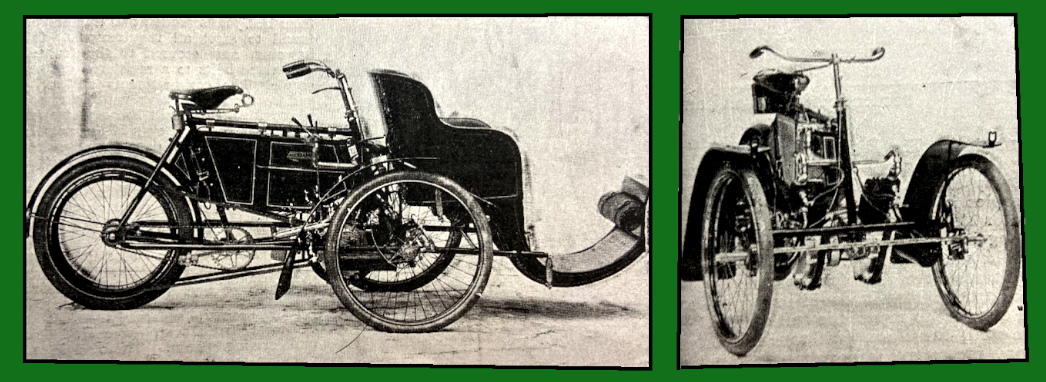
have nine motor cycles representing the firm’s latest patterns The motors fitted are 2 and 3hp. A special feature is a new spring fork which looks a most effective device for overcoming vibration. The front wheel axle is suspended on a spiral spring at each end and the amount of ‘give’ when pressure is applied to the handlebars is very noticeable.. This speciality in itself should render the Quadrant machines more popular than ever. The combined spring fork and anti-vibrating spring saddle should give quite luxurious riding. The make-and-break ignition gear is another strong point with Quadrants—its special feature is that self-adjusting. The lubricating device for the motor has proved very successful during the past season: it is impossible for leakage of oil to occur from the crank case, owing to the pressure being relieved through a small hole in the centre of the axle—a palace where none of the oil can remain, as it is thrown away from the centre by centrifugal force. An exhaust valve lifter is now fitted as an option. The firm make a special feature of their surface carburetter. The new tri-car has two motors of 2½hp, which can be used separately or together by means of an ingenious pedal clutch: the fore-carriage is hung on spiral springs which insulate it from vibration in a most effective manner. The transmission is by V-belt; the control is the firm’s well-tried single lever, with throttle in addition. There are three hub brakes fitted. The petrol capacity is equal to 130 miles and the accumulators are extra large: arranged on the pedal clutch gear is a cleverly designed contact to break the ignition circuit when one engine only is used. It will be observed that very large side wings are fitted, on the extremities of which are attached the lamp brackets. The body is readily detachable, making a handy tricycle of the machine. The general finish of this machine is excellent. The price is £97 l0s. CR Base, High Holborn, London, WC, had a very attractive exhibit of all classes of clothing for motorists in fur and leather. Also a new driving apron named the ‘Kezifit’—a capital article which should appeal to the motorist—and some good lines in caps and gloves for motorcyclists. Collier & Sons, Plumstead. The Matchless Motorcycle was shown on this stand, provided with a 2¾hp De Dion or MMC motor, fitted diagonally to a specially designed frame. It presents a very powerful appearance, and its capabilities have been well proved during the past season. All the controlling levers are fitted with fine-toothed ratchets so as to prevent them slipping by vibration. A two-way switch, two 20amp armoured P&R accumulators, and a De Dion coil and De Dion float-feed carburetter, with a tank to hold 1½ gallons of petrol are also fitted. A speciality is an automatic swing crank, which allows one of the cranks to be back-pedalled to the same position as the other, the releasing of the pressure on the crank allowing it to resume its proper position. This firm also showed a very neat belt punch, capable of cutting a rivet out. It is well made in silver steel so as to prevent undue wear. The Rona Chemical Company, Bradford showed Rona Motor Lubricant. This is a special preparation for bearings and chains, and is not affected by heat. Several varieties of rubber preparations were also shown. The Booth Motor Syndicate, Putney exhibited the Bramley motor-bicycle, fitted with a 2¾hp motor built

into the frame. It is provided with mechanical inlet valve and trembler coil ignition. The carburetter is a Longuemare, and transmission is by V-belt. Gauge glasses indicate the quantity of petrol and oil in the tanks. Two accumulators are fitted, provided with a two-way switch, and all wiring is, as far as possible, concealed in the accumulator box. The oil pump is fitted inside the tank. The free-wheel used is a special form, made as part of the hub. Two rim brakes and duplex forks are fitted. The firm make five types of machines, including a 3½hp fore-carriage and a 2hp lady’s machine which presented a very neat and compact appearance. We understand that they have already booked several orders for these machines, including one from that well-known lady motorcyclist, Mrs Kennard. The Wearwell Motor Co, Pountney Street, Wolverhampton, are adopting the name of ‘Wolf’ for their motorcycles. They had an extensive exhibit of motor-bicycles, several being fitted with fore-carriages. One of these has a 3¼hp water-cooled engine, chain drive and free clutch ; this makes quite a little car, and is splendid value for the £75 asked. The standard motor-bicycle has a 3¼hp air-cooled engine completely controlled from the handlebar by means of Bowden wires: the application of the back wheel rim brake cuts off the current; the throttle is worked by a twisting handle grip. Ignition is by the usual coil and accumulator system. The Wolf fore-carriage is specially easy of attachment and detachment; it is generally admitted that there was no better type exhibited at either Show. The See Motor Car Supply Co, Oxford Street, London, W. The Lamaudière motor-bicycle which competed in the last Bordeaux-Paris race was on view during the Show. The Lamaudière has a 2½hp engine situated centrally in the cycle frame—in fact the engine takes the place of the usual down tube. An out-side fly-wheel is used, and a free engine is obtained by lowering an adjustable jockey pulley (running on balls) and allowing the belt to slip. Also displayed was the Samson-Hutchinson non-slipping puncture proof tread for motorcycles and cars: this is composed of three layers of specially prepared chrome leather, studded with flat headed steel rivets.
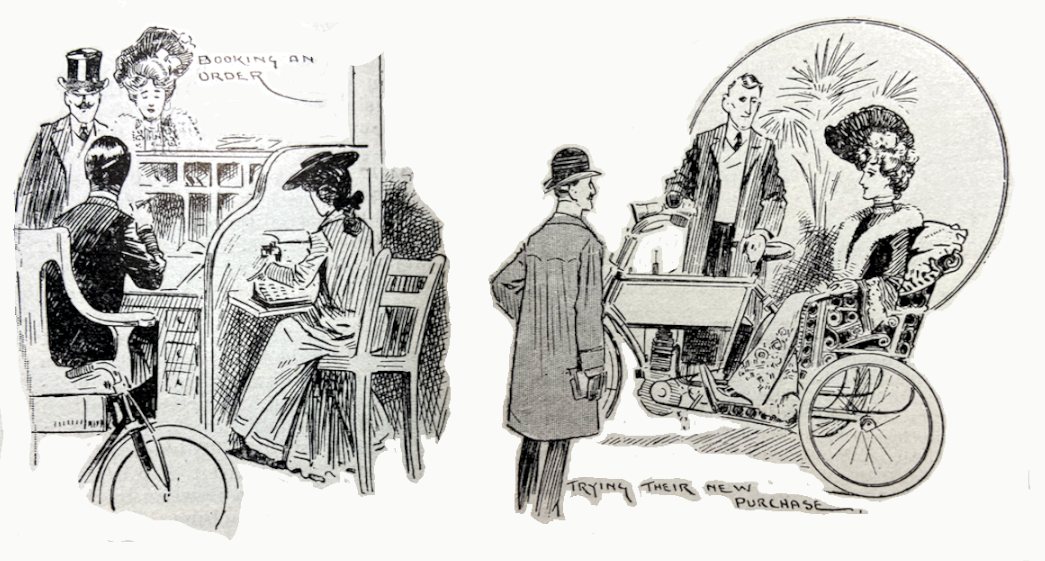
“AN INTERESTING FIGURE at the Shows was Mr JB Dunlop, the inventor of the tyre bearing his name. Mr. Dunlop, who is a venerable looking gentleman, appears to have lost very little of his inventive faculties. At any rate, he informed us that he was busily engaged upon an improved form of carburetter for cars and motorcycles, and that he had also designed a new silencer, in which, according to Mr Dunlop, explosions cannot possibly take place.”
THERE WERE 357 motorcycles at the Stanley show 247 at the Crystal Palace show, and about 10,000 in Britain.

“THE 1,000KM (620 MILES) RELIABILITY RUN for motorcycles promoted by the Motorcycle Club of France began last Tuesday (November l0th) and continued throughout the week. The trial consisted of six daily runs from Paris to some outlying provincial town and back, each day’s day’s run being different and the daily mileage varying from 120 to 70 miles. Thirty-six motorcycles were entered. The absence of some of the best known French machines, such as the Griffon and the Peugeot which did so well in the recent hill climbing tests, was a matter for regret; but with representatives of the Moto-Cardan, Werner, Georgia Knap, Walter, Iris, and that most recent addition to the ranks of motorcycles, the Gobron-Minerva, plenty of keen rivalry was anticipated. A feature of the event which will be interesting as a novelty to the English motorist was the presence of a lady competitor, Miss Jeanne Herveux, on a Walter cycle. Competing machines were ranged in two classes according to cylindrical capacity—(1) a quarter of a litre; (2) one-third of a litre. First day: Paris to Chartres and back—113 miles. Weather fine and roads in fairly good order. Of the 36 competitors who started 26 completed the run inside official time, failure to do this involving withdrawal from the competition; the withdrawals on this day were chiefly due to ignition troubles. Several falls, none serious, were recorded. Miss Herne came to grief at Versailles over an ungallant dog, but the fair moteuse soon remounted and completed the run in limit time. Breuil on a machine of the same name also met with canine troubles. Knap, on the No 1 Knap, collided with a milk cart; and Anujard ran over a paving stone left on the road by a waggoner. Kuhling, on the Gobron-Minerva, attracted considerable attention, this ma-chine running very sweetly and quietly. Second day: Paris to Gaillon and back —109 miles. Fog and rain, roads muddy. Twenty-six started and 20 finished, ignition troubles again being responsible for the loss of time which caused the withdrawal of the unsuccessful six, in some cases accumulators were found to have run out. Miss Herveux failed to arrive in time, as also did both of the Moto-Cardan machines and one of the Knaps. Side-slips were frequent, a few tyres punctured, and a belt or two snapped, but there was no accident worth recording. The competitors were received everywhere with acclamation by the public. Third day: Paris to Evreux and back—120 miles. This day’s run was the longest of the trials; nevertheless of 19 competitors who started only one failed to get back within schedule limit. The committee had previously decided that any competitor who succeeded in getting back to Paris, although outside the prescribed time, might start unofficially on the following day. Miss Herveux’s failure on the second day was due to the shocking state of the roads near Gaillon. A thin drizzle fell all Thursday, increasing the chances of accident considerably. The number of mishaps, chiefly side-slips, which befell the in machines was 66. The Gobron-Minerva, the two Werners, and one of the Knaps were still doing well at the end of the day’s run. Fourth day: Paris to Nonancourt and back—112 miles. In sunny weather 18 competitors started and 17 finished within schedule limit. A successful, but uneventful run, no mishaps being recorded. At Houdan, one-third of the way back on the return journey, a surprise brake trial took place, most of the competitors coming successfully through this. Large crowds of spectators awaited the arrival of the motorcycles in the controls. The only competitor to fail was Faron on a Lamaudiere machine. Fifth day: Paris to Beauvais (100 miles). Seventeen started, cf which 16 finished, the unsuccessful machine being the No 1 Werner piloted by Jovelet. Another bad day, cold and fog in the early morning, and rain—ending in a heavy downpour—on the return journey. We regret to say that in some way our photographs of this event have miscarried, as at the time of closing for press they had not arrived.—Ed.”
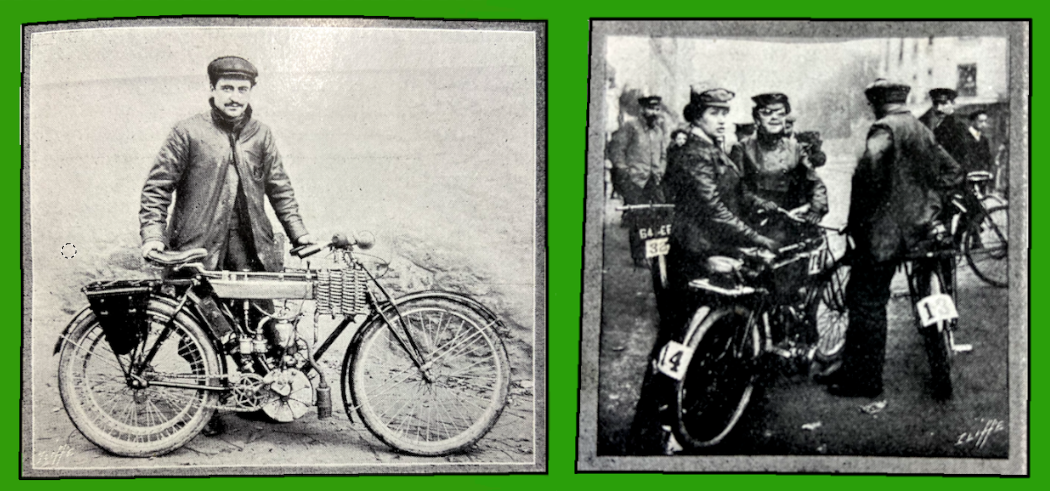
That report of the 1,000km trial came from The Motor; this review of the event appeared in The Motor Cycle…
“THE FRENCH 1,000KM TRIALS. 0n Sunday afternoon, November 15th, 14 motor cyclists arrived at the garage in the Rue de Villiers at Neuilly. They came in one by one, bedraggled and bespattered, and some of them were scarcely distinguishable through the coating of mud they picked up by succumbing too easily to the laws of gravitation. They looked as if they had done the 1,000km at one stretch instead of in six daily instalments. One of them declared that it was the hardest test he had ever gone through. A run of a little more than 100 miles a day for a week at a fair touring speed, with compulsory stoppages for meals, is not of itself particularly trying to the competitors, and at any other time of the year it would have proved a pleasant experience than otherwise, but the organising club purposely held the trials in November so that the machines should be tested under the most unfavourable conditions possible. The idea was to leave no chance to bicycles which did not fulfil all the conditions of reliability, and at the same time convince the public that the touring machine is capable of being used in all weathers. These results have certainly been attained. The public have marvelled at the behaviour of the little motors, which have carried the competitors over roads that seemed to be almost impassable for a single-track machine; but if the conditions of the trials have made the performances of the successful bicycles all the more meritorious, they have meant very hard lines for some of the competitors. On the first day no fewer than 10 out of 36 of the motor bicycles starting failed to return before the control closed. This was not due to the weather or to the state of the roads, but to the fact that a good many of the machines were not properly prepared for the test. So much time was lost on the way through faulty ignition, or in seeking petrol which the competitors had not provided for, that they did not arrive until the evening. In most cases there was nothing the matter with the machines. A limit of time, nevertheless, had to be fixed, and if they returned after the closing of the control they could not complain of being disqualified. The only consolation they had was in being allowed to continue on the following days, when their times were taken, but, of course, they were not included in the official placings. The second day saw a complete change in the weather, with drizzling rain and fog, which made the roads so slippery that it was almost impossible to ride on the granite setts. Several of the competitors came down, and others had no end of trouble with their ignition gear. Seven more unfortunates retired from the contest, utterly disheartened by the weather and their bad luck, and some of them undoubtedly threw up the sponge because the monotony of riding through the rain-sodden country was more than they could stand. On the third day the conditions improved a little, and not a single one dropped out, but on Friday a competitor failed to return in time, so that only 18 started on Saturday morning, or just half the original number of competitors. They had to run to Beauvais and back.”
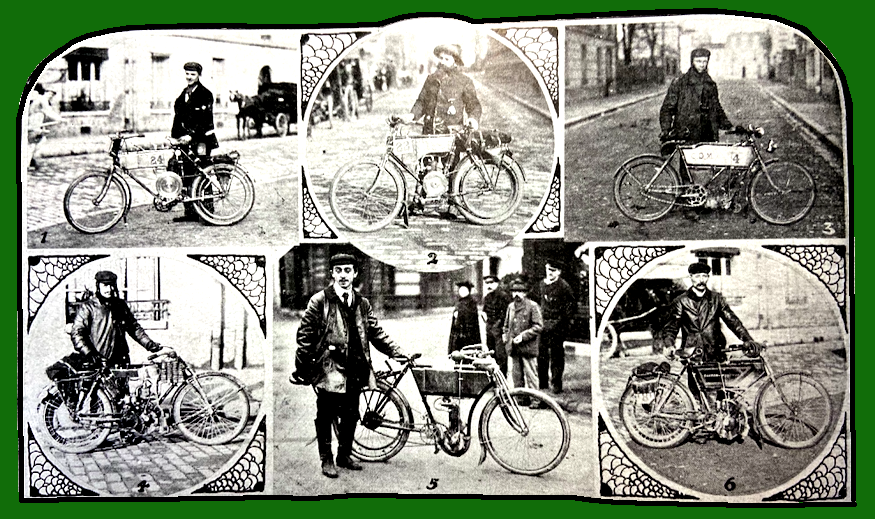
“THOSE PEOPLE WHO STILL HOLD BACK from participating in the pleasures of motor-cycling because they imagine the motor-bicycle is still an experimental machine, will be interested in the riding record of Mr THW Fox, of Wimbledon. This young gentleman has ridden a Rex motor-bicycle 6,453 miles in a year and his rides include the following: 86 miles non-stop in 2hr 47min; 120 miles with two stops for refreshments; 300 miles with a stop at York for the night—16 hours’ actual riding time. Mr Fox tells us he has ridden over 100 miles on a gallon of petrol. He speaks in the highest terms of his machine, which he was overhauling at the time of writing.”
“LADIES WHO TAKE TO MOTORCYCLING evince no lack of enthusiasm for the pastime. A lady who recently purchased a Singer motor-bicycle waxes eloquent in truly feminine fashion in the following extract from a letter which she has addressed to the firm: ‘I reached ———— all right, and had no mishaps. The motor simply flew. Part of the way the fog was dense, but the roads improved. The motor confided in me and told me why she would not start at ————. Temper, at being left out in the cold, while we went and had such an excellent tea. I comforted her, gave her some nice thick oil, and she has promised to be good! I cleansed her before (8.30) breakfast this morning, so you see I was not a bit tired after our glorious ride. I really must retard the spark and turn off the petrol.'”
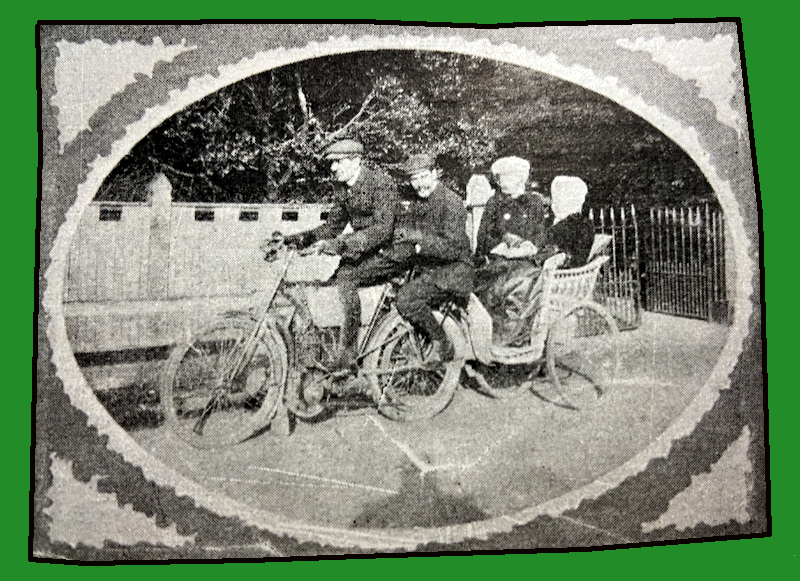
“IN AN AMUSING CASE AT HALIFAX in which a joiner sued a motorcyclist for injuries sustained by being knocked down by the motorcycle, the judge requested the defendant to blow his horn outside the court. On his return his honour remarked: ‘Isn’t it a public nuisance to make that awful row?’ to which defending counsel retorted: ‘If you don’t make a row there’s a row because you don’t.’ Finally, the judge decided that the motorcyclist, so far from showing negligence, had shown every precaution that he could, and gave judgment for him accordingly.”
“A CURIOUSLY WORDED CHARGE was brought the other day against a motorcyclist in Scotland. The actual offence which he was alleged to have committed was that of recklessly driving into a horse and van between nine and ten o’clock at night: be was charged with having ‘failed to keep a motor-bicycle on which he was riding to the left or near side of the road, whereby it ran with great speed, etc.’ It is not generally considered a legal offence to ride on the right-hand side of the road, although doing so would, of course, tell against one in the event of an accident. In the case referred to above, the cyclist successfully pleaded that the accident was caused by the absence of any lights on the van.”
“THE MACHINE MADE BY Messrs Guy and Wheeler, South John Street, Liverpool, has a frame of unusual length, the wheelbase being no less than 5ft 1in. The motor, a 3hp air-cooled Aster, is placed behind the bottom bracket. No pedals are fitted. Petrol capacity is two gallons, and two accumulators are fitted. A new form of wiring is fitted which gives a considerable increase of voltage on that usually obtained. This ignition makes the engine much more efficient. A large type of Longuemare carburetter is used. The silencer is very large, with a cut-out for obtaining full power when required. The G&W ‘picrator’ is fitted to this machine. Transmission is by chain to a hub giving two speeds and free engine, but the belt drive is also fitted when desired.”
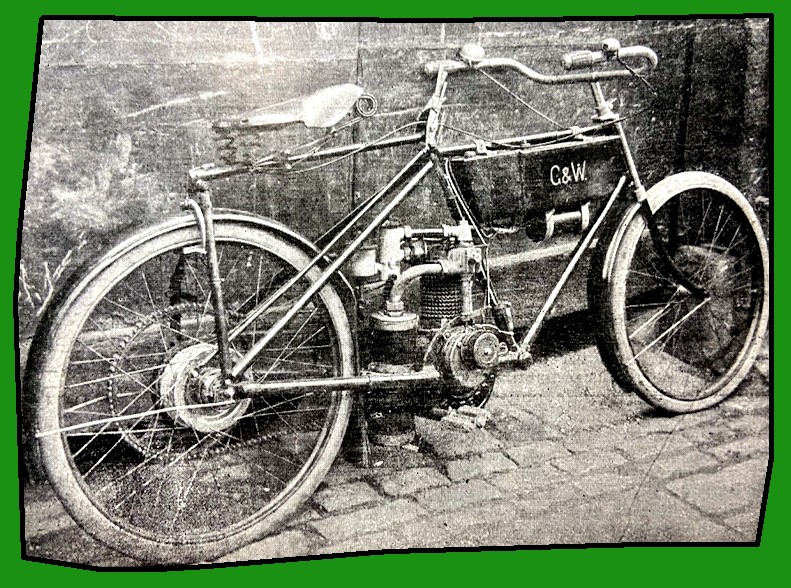
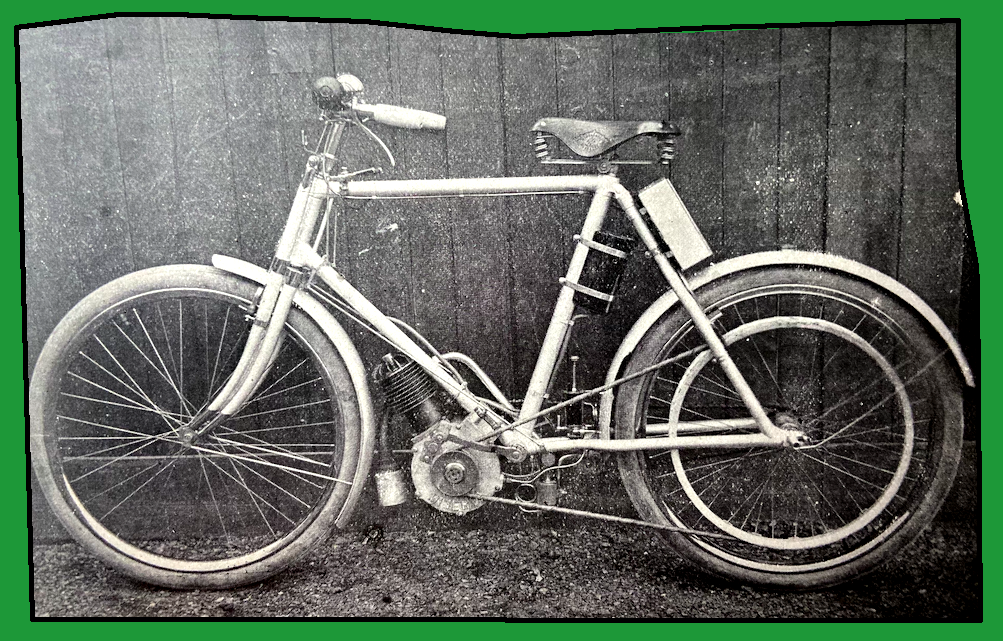
“IT WILL BE AS WELL to be prepared for cold weather in the near future and to see that the carburetter is provided with a means of being kept warm, either by a connection or by-pass to the exhaust or having the carburetter kept fairly close up to the radiators. There are many machines which have a fitting provided to the carburetter for connecting up to the exhaust, but the necessary pipe has been omitted in building up the machine. Unless this is seen to, trouble due to freezing up of the carburetter in cold weather is. likely to result.”
“THE AUTUMN IS AT HAND, winter—worse luck—is approaching, and the evenings are getting shorter and shorter. Woe betide the motorcyclist who has not an efficient lamp! Carts with no lights, cyclists who break the law in like manner, old ladies in black dresses, dogs, and other obstacles are all terrors to him. A lamp that shows every stone in the road is an absolute necessity. Such a light is only obtainable by burning acetylene gas. Now, acetylene lamps, unfortunately, have a lesser reputation for reliability than oil lamps. All know that at Dover there is an old cannon, on which one can read the following inscription, or something like it: ‘Wash me out, and keep me clean, and I’ll carry a ball to Calais Green.’ Now, if the users of acetylene lamps were to imagine this inscription to be written on their carbide chambers, and followed out its advice, we should hear of less trouble in the future with these excellent lamps than we have in the past.”
“‘WARE SHODDY. ALTHOUGH THE modern motor-bicycle is, when intelligently looked after, remarkably free from trouble, yet most people manage to find a good deal of it in one way and another; quite enough, in fact, to make the cautious buyer think twice before investing in a low-priced article. It is simply inviting disaster to expect hard work from a machine thrown together at starvation prices and decently painted over to hide its little blemishes.”
“THE NOVICE, STUDYING THE working of his new motor, is rather apt to underrate the amount of work done by the exhaust cam. It looks to be such an easy job, just to lift the stem a fraction of an inch—but the lifting involves not only the overcoming of the spring resistance, it also means pushing the valve open against the full pressure of the charge just exploded in the cylinder, although, of course, this resistance is removed directly the valve opens. On the whole, it is small wonder that the stem sometimes ‘loses its head’ and gives up the ghost.”
“IF ANYONE DOUBTS the necessity for wrapping the high-tension wire in such a thickness of insulation, let him fit a piece of thinly-covered, wire in its place and, holding the wire in his hand, gently agitate the contact-breaker. If he fails to see a star-shower of surprising brilliancy he may rest assured that his accumulators have gone wrong.”
“THOSE GERMAN WAR CYCLES. With reference to those marvellous motorcycles which the Evening News tells us are to be supplied to the German Army, we have been wondering how the poor private would proceed in case of a puncture. Mudguards generally get sufficiently in one’s way when repairs are in progress, but a steel plate covering the wheels! spare us!—’Heinrich! für das Lieb von Himmel, geben sie mir das Sar-dine opener! der Feind ist only ein couple of miles hinter, and-Ich can’t get diese blessed inner tube!’ (PS—If the German is not strictly according to Wittich, one must remember the natural agitation of the punctured private.—Ed.) As for the battery, it appears to us to be a case of assault and battery with plenty of (as)salt. Ahem!”
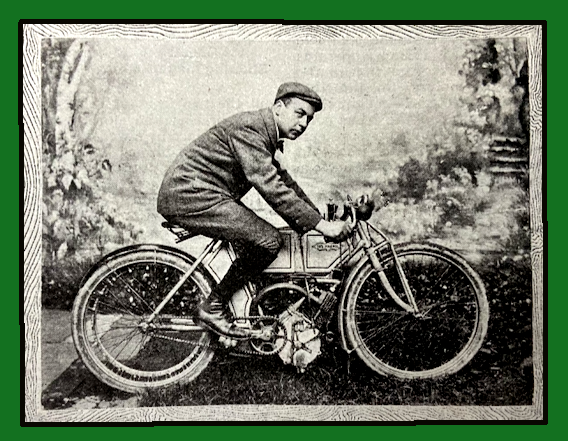
“A NOVEL CHAIN DRIVER. The illustrations depict a chain-driven motor-bicycle in which the motor is mounted in a curious position behind the steering column. The frame is somewhat on the lines of a lady’s drop frame. The transmission is by chain off a seven-tooth cog on the motor to a 22-tooth cog on a countershaft. This countershaft is carried on a bracket, which can be adjusted on the curved down tube. From the countershaft the drive is by another chain to a spring chain wheel mounted on a loose sleeve on the rear wheel hub. The springs, it will be observed, are arranged tangent fashion and are secured to arms held at eight positions on the rim. The maker claims that this drive has proved very successful, being very elastic and absorbing the engine shocks. The position of the motor conduces to effective cooling, but it is doubtful if it would be a safe machine on greasy roads, It will be noticed on the smaller illustration that the pedalling chain is carried over a cog on the countershaft for starting the motor. The maker is J Merchant, 26, Bohemia Road, St Leonard’s-on-Sea.”
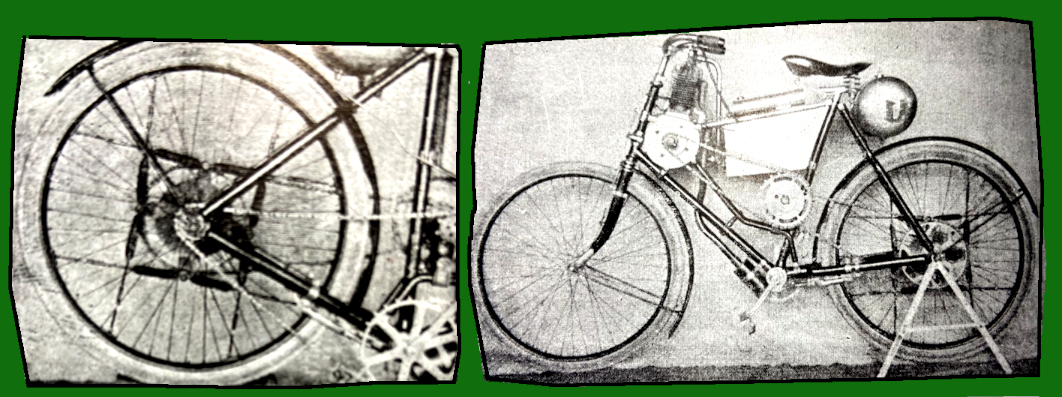
“THE LOCAL GOVERNMENT BOARD’S new series of regulations under the Act of 1903 comes into force on January 1st next. A motorist has new duties imposed upon him by these, regulations but it cannot be said that they are onerous. There are three, matters for him to attend to: 1. To take out a driving licence. 2. To register his car or motorcycle. 3. To pay the tax to the Inland Revenue. The licence to drive must be procured from the council in whose jurisdiction the applicant resides, but a car or cycle may be registered with any authority. A remittance most accompany the applications, the sum being as follows: For registration of a car, £1; for registration of a motorcycle, 5s; for driving licence, 5s. The driving licence remains in force for 12 months. The registration of a motor vehicle holds good until it be cancelled. Each vehicle owned by a motorist most be separately registered and a fee paid for each—we have come across persons who laboured under the impression that they had but to register one vehicle and get a set of numbers, and then use them on any car or cycle they pleased.”
“MOTORCYCLISTS SECURE FAIR TREATMENT. Motorcyclists may congratulate themselves upon the moderate treatment which has been extended to them by the Local Government Board. If the whole of the concessions originally asked for on behalf of motorcyclists have not been secured, the only exceptions are in those cases where the Board has made it clear that it had not the power to do as was desired by motorcyclists, but even in those cases concessions have been made which will go a long way towards smoothing away difficulties. This good end has only been secured by reverting to the course originally proposed by the Auto-Cycle Club. The danger in being grasping is the risk of losing everything—even that which is justly due, and we regard the attempt of a certain section (backed up by a journal which, had it genuinely had the interests of motor-cyclists at heart, would have been more discriminating and discerning) to secure the inclusion of the quad amongst motorcycles as having created a very grave situation. At one time the quad was undoubtedly a motorcycle, but the up-to-date articles are more entitled to be classified with cars than with the simple motorcycle. Only by deliberately abandoning the quad and drawing the dividing line at three wheels and a moderate weight was it possible to secure different treatment for the motorcycle that which is being meted out to the car.”
“VARIOUS SUGGESTIONS HAVE been made to the Board to provide a practical method of showing a lighted number on a motorcycle, but the only one which has been referred to, in the letter from the Board to the Councils, is one which has been followed up by Messrs. Joseph Lucas of Birmingham, who are prepared to supply plates and fixings.”
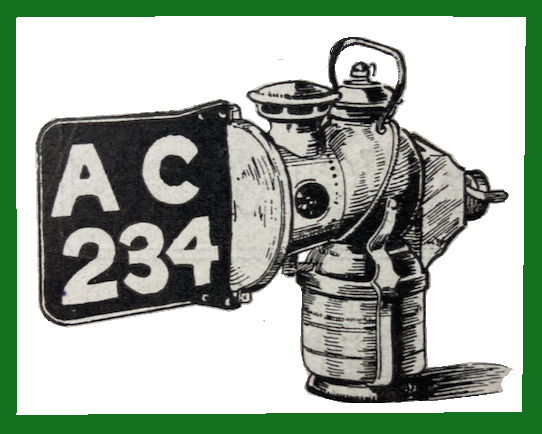
“A COMPACT LITTLE CHARGING SET for the accumulators of motorcars and cycles has been produced by Messrs. Gilbert Gilkes and Co, Canal Iron Works, Kendal, who are the leading manufacturers of turbines of all powers in the kingdom. Where one has an ordinary water supply with a good pressure—say not less than 40psi—the combined turbine and dynamo should prove invaluable. All that is necessary is to join up the turbine to the ordinary house tap and then the accumulator being connected up to the dynamo it is simply necessary to regulate the water supply so as to obtain the correct charging current, the necessary instruments being combined with the set. This little set is vastly more convenient than using a small gas engine. The price, complete, is £17 10s.”
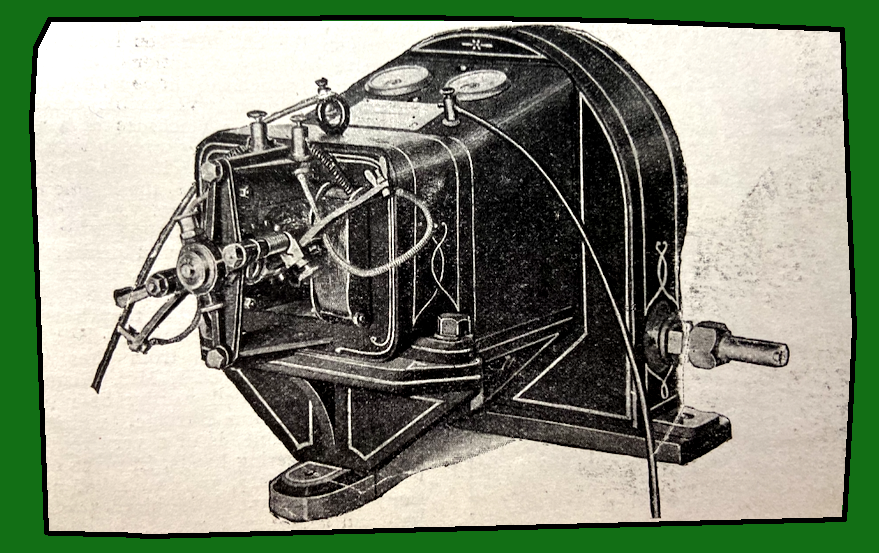
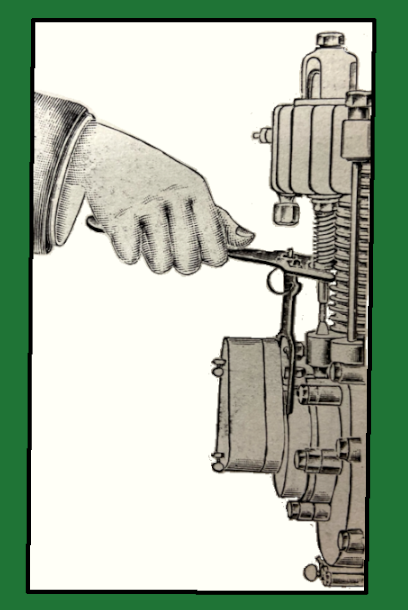
TO THOSE WHO SUFFER from chilblains and cold hands when motor cycling, a recent invention of Miss Biggs, of Richmond, will be welcome. This takes the form of a hand shield or muff fitted to the handle-bars. Two shields are prepared, one for each hand, each made of a framework of wire, wicker, buckram, metal, etc. Fig 1 is a perspective view of the wire frame-work forming the substructure to which the muff is fixed ready for attachment to the handle-bar of a bicycle, covered with suitable material, the cover-ing being continued all round the framework so as to fully enclose the hand of the rider. On the underside, where the framework is purposely left quite open, the covering is given a loose or bagged shape as at A. The portion nearest to the sleeve A, by which it is attached to the handle-bar, is preferably covered with leather, both in order to throw off the rain and to provide for the wear consequent upon removal and reattachment of the muff. Such a leather portion is shown at B. An opening in it is necessary. to enable the hinged collar to be opened out, and the muff to be removed from the handle-bar; this may be ordinarily left tightly buttoned or laced as at C.
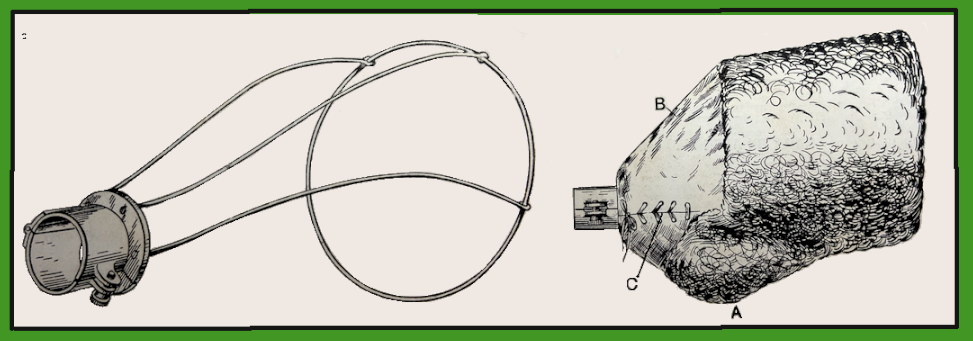

“THE USEFUL INVENTION, OF WHICH we give an illustration, is that of a speed indicator recently invented by Mr WGC Reed. The main principle embodied in this invention is the employment of the action of centrifugal force pulling on a small weight enclosed in a tube (up and down which it has a free passage), this weight being at the same time attached to a ribbon on the surface of which are figures indicating the various speeds at which the motor cycle is travelling, the other end of this ribbon being attached to a coiled spring, somewhat in the same manner as in the familiar spring tape measure. The tube is placed between the spokes of the front wheel, one end being clipped to the rim, the other being attached to and communicating with the case, this latter being attached to the hub, the whole mechanism thus revolving with the wheel. The action is as follows: On the wheel being revolved the weight is projected up the tube towards the rim of the wheel, and in doing this overcomes the tension of the coiled spring, with the result that the figures on the tape are pulled under the face of a glazed aperture in the case which is fixed to the hub. Conversely, on the bicycle slowing down, the spring overcoming the centrifugal force has a tendency to draw back the figured ribbon in the reverse direction, thus providing a very delicate and reliable speed indicator. We may mention that the device is manufactured and sold by the Civil Service Motor Agency, 292 High Holborn, WC.”
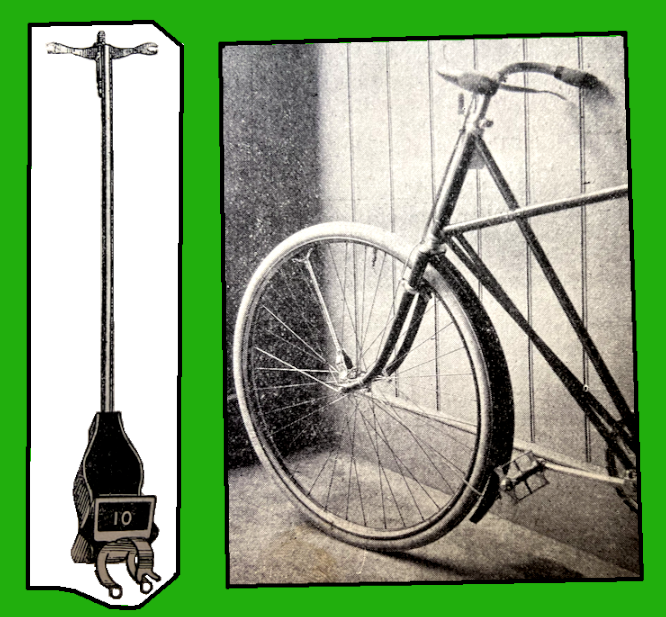
“THE LEONARD MOTOR-BICYCLE is made by Messrs. JJ Leonard and Co, Brockley Garage, Brockley Jack Hotel, Brockley, London, SE. It is fitted with the MMC 3½hp motor mounted vertically in a loop frame. The carburetter is a Longuemare, and a large supply of petrol can be carried equal to 100 miles running. The case behind the diagonal contains a 20 amp-hour Dinin accumulator and trembler coil, and ample space for spare parts and tools. The front forks are Duplex pattern. The transmission is by a long V-belt. An efficient silencer is fitted, and lubrication is by force pump. The tyres are new Dunlops, the rear one being 2½in diameter. The wheel base is long, giving very comfortable riding. The front mudguard is extended over the wheel. The price, with the liberal guarantee of 12 months for frame and engine, is 45 guineas.”
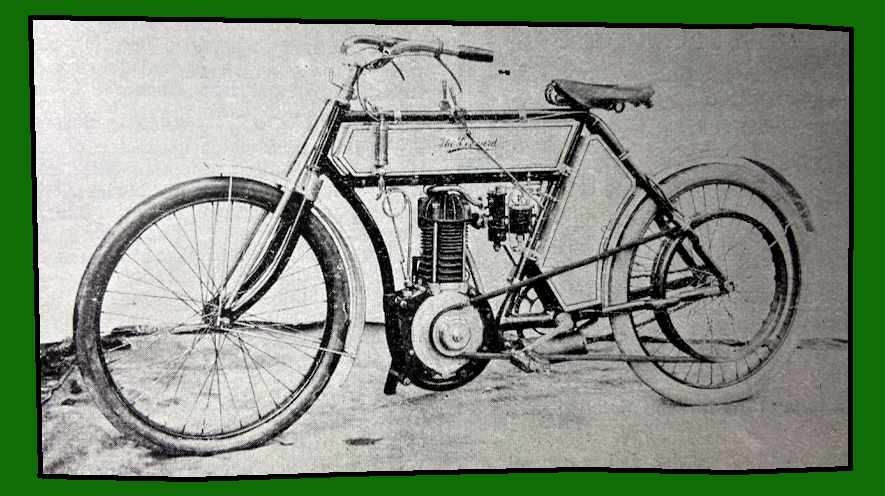
“THE AUTO-CYCLE CLUB DESERVES to be congratulated upon the success of its first annual dinner, held at the Automobile Club, Piccadilly, last Tuesday. The President, Mr Roger W Wallace, was in the char, and was supported by nearly sixty members and friends of the Club. A notable feature was the strong force in which members of the Motor Cycling Club attended the dinner, a courtesy which we feel sure will be reciprocated when the latter club holds its annual function next month.”
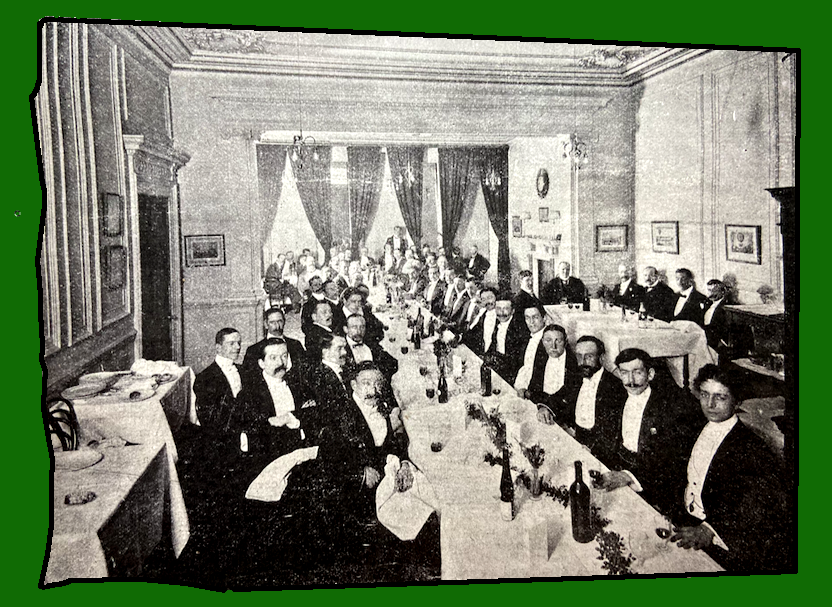
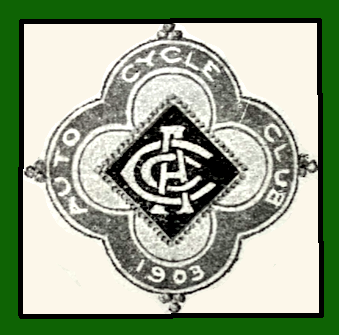
“THE MOTORCYCLING SECTION OF the Austrian Automobile Club does not intend to let the petrol in its tanks go stale for want of use. Amongst the many trials and competitions announced for the immediate future and for next season are hill climbing trials at Semmering and Exelberg; an international track race for the Lurion prize over a course of 100km (62 miles); an international road trial of 300km (186 miles) on Gordon-Bennett lines; a Vienna to Brunn race; an ‘express courier’ ride; a ‘balloon pursuit’ ; a ‘fuel consumption’ competition; and a ‘paper-chase’. A special excursion Homburg for the Gordon-Bennett race next June will also be arranged.”
“A SERIES OF MOTORCYCLE RACES were held at the WACA Oval, Perth, West Australia, in conjunction with the eight hours’ sports on 24th, 26th and 31st October. The first race was a ten mile handicap, in which seven competitors faced the starter, viz: Armstrong (2½hp Minerva), McKnight (2hp Indiana), Gilmour (1¾hp Werner), R. Sampson (1¾hp Werner), H Sampson (1¾hp FD Werner), Woods (2hp Minerva), Singe (1½hp Columbia). Before a couple of miles were run off Woods had to retire with a short circuited battery and a broken oil pump. Shortly afterwards Armstrong, who was going well, doing the mile in 1min 40sec, broke his advance spark lever and was thereby unable to get any speed out of his machine. Gilmour rode a splendid race and passed the finishing post first, with R Sampson second and H Sampson third. The three competitors rode Werner 1¾hp machines. Time 18min 23sec. The five-mile race proved a little more exciting than the ten mile. The starters were: Armstrong, Lovegrove, Woods, Gilmour, Jewell, Sampson, H, Sampson R, Singe, McKnight. H Sampson and Singe had to retire as their tyres blew off the rims before going very far. Lovegrove on a 2½hp Minerva made the pace hot from the start, but Gilmour stuck to him. Armstrong again had hard luck; some of the petrol splashed out of the tank, and was ignited by a spark as a result of one of the electrical wires coming in contact with the frame. Before he had gone far he was racing around the track enveloped in a sheet of flame. He quickly pulled up, however, and extinguished the flame. He was nevertheless burnt about the face and hands a little, but luckily no further damage was done. Lovegrove won the race, with Gilmour second. Time 9min 15sec. The five-mile race held on the 26th was ridden in the rain and only three competitors started, viz Armstrong, Gilmour and McKnight. The latter won from Gilmour by half a lap. Trouble was caused by the belts slipping, resulting from the mud and wet; so McKnight with a chain-driven machine had it all his own way. Great interest is being taken in the coming meetings and it is expected that a largely increased number will start. As an example of how motor-cycle racing is going ahead in Australia the following facts are interesting: In the eight hours’ sports, 1901, two machines started; in 1902, four machines; and this year ten started in the five miles and nine in the ten miles. Motorcycling, though only in its infancy here, is steadily on the increase, but the roads are against it.—’CATO‘.”
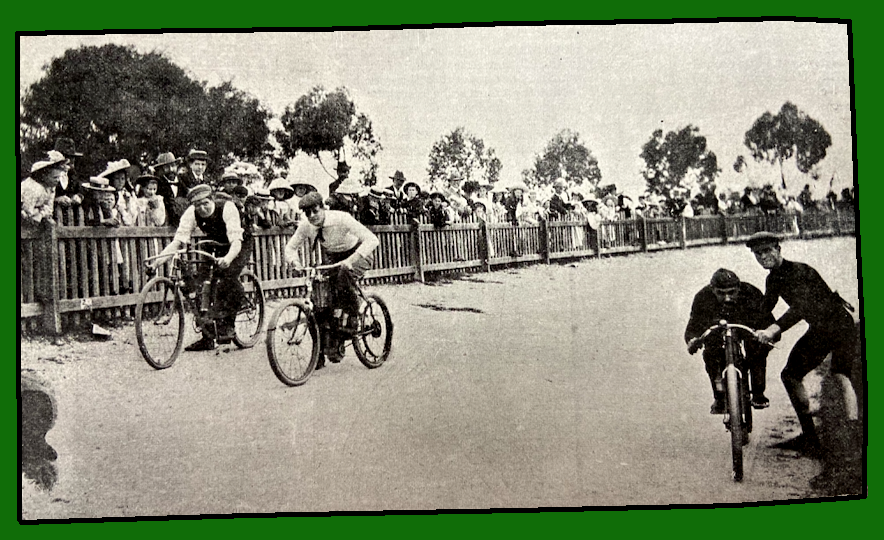
“AA HANSEN, A WELL-KNOWN American road and track motorcycle racer, made a remarkable ride in September at Garfield Park, Chicago. One of Hansen’s objectives is to ride 1,000 miles in 24 hours, and although he is nearly 300 miles away from his goal as yet, he hopes to do it eventually. In the ride under notice he had particularly bad luck with his tyres and with the weather, experiencing eleven punctures and being seriously hampered by, rain on eight different occasions: indeed so unlucky has he been in this respect throughout his racing career that he has earned the nick-name of ‘Rainmaker’. The actual distance covered in the 24 hours was 701 miles I,330 yards—67 miles better than his previous record. The actual riding time was estimated at 20hr 25min, 52⅖sec—about 29¼mph all through. He rode a ‘Mile-a-minute’. Mitchell motor-bicycle; and a companion, Geer, mounted on a similar machine, rode by him at intervals and handed him food and drink—also a big cigar which he lighted from the glowing stump, of Geer’s smoke and puffed at with gusto till it was finished.”
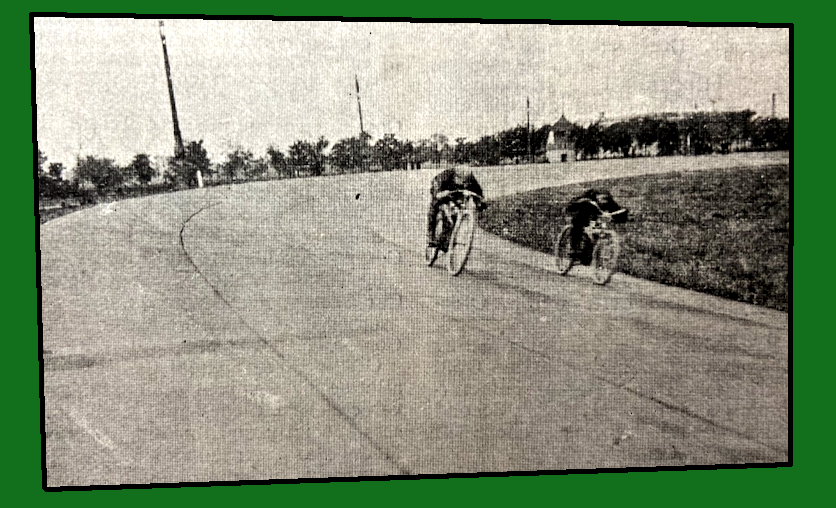
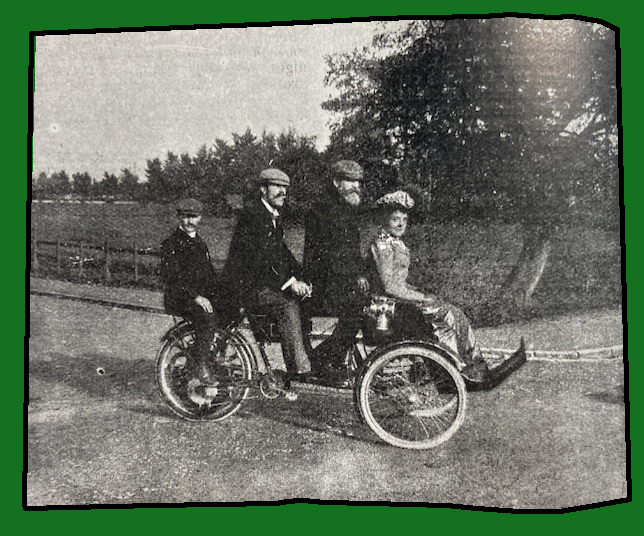

“ALTHOUGH THE VAST EXHIBITION is primarily a show of cars there is no lack of motorcycle exhibits to be found such as would take the enthusiast many hours to inspect even superficially. Although, as a result of the immensity of the Grand Palais, the motorcycles appear to be lost, on taking a bird’s eye view from one of the galleries, there are very few stands indeed which are without something of interest to the motor-cyclist. Glancing round at the exquisitely decorated stands—such indeed as make our efforts at home look puny by comparison—one sees in every direction names that have made motorcycle history—De Dion Bouton, Clément, Minerva, Rochet, Gobron, Peugeot, Werner, Société Francaise, Fabriques Nationales, Knap, Griffon, and innumerable firms of lesser note. At each succeeding exhibition the tendency seems to be to relegate the great majority of the motorcycle exhibits to the spacious annexes and galleries and underground areas, and it is in these departments that one is ever and anon coming across exhibits embodying strikingly original features. Although a visit to our recent shows proved that for good solid material and workmanship combined with high finish the British manufacturer cannot be excelled; the French machines on the other hand show
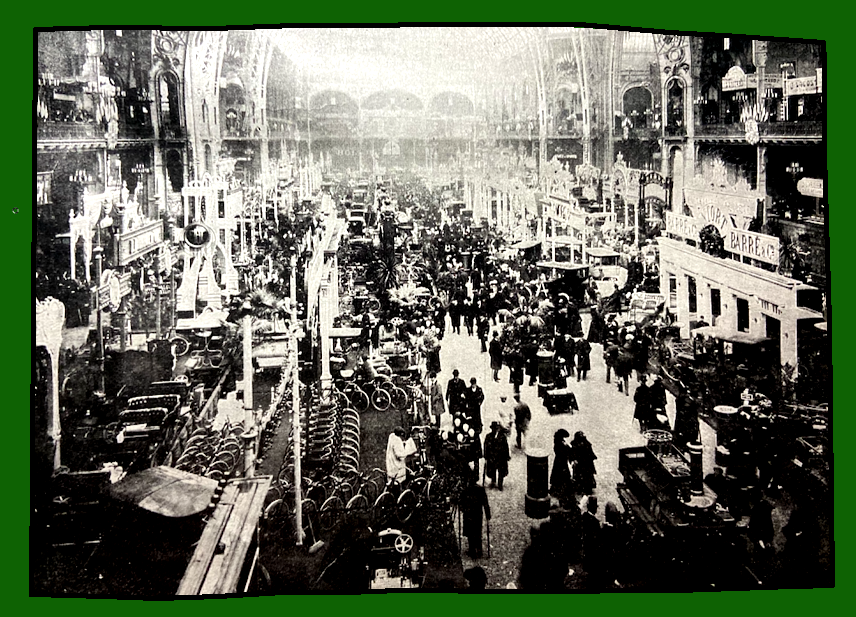
more originality in design, and there is much less tendency apparently to follow a fashion or to work in a groove than is the case with our own makers. Hence it is that each individual machine exhibited in Paris proves so interesting to the enthusiast. Ingenuity in design is the distinguishing feature—mach more so than superfine finish, speaking generally, although in some cases a finish that would satisfy the most critical eye is not lacking. The English visitor to the Show will be struck by the almost entire absence of machines of British manufacture. There can be no excuse for this short-sighted policy on the part of our manufacturers in not letting the elite of them Continental motoring world see that English talent can equal the best that the French and German can show us it the matter of sound workmanship and high finish. There is an impression abroad that we cannot make motor-bicycles to compete with the French and Belgian makers, and it is desirable that this impression should be removed, especially so as the probability is that less attention will be paid in the future to motor-bicycle manufacture on the Continent, owing to the fact that the cars will monopolise the attention of at least the French makers. A surprising fact—and one on which we can congratulate ourselves—is that there is very little in the way of fore-carriages or sociable motorcycles at Paris, whereas at our own Shows they formed the most important feature (thanks to the attention paid to this branch of motorcycling by the makers), and there is no doubt that in this respect we have a very great lead over the French.”
“THE BRENNABOR-FAHRRAD-WERKE, Brandenburg, Germany. These machines are built on somewhat conventional lines, with vertical engine and belt drive, spray carburetter, and high-tension ignition: the valve lifter and spark advance are operated together. The finish is very good, and the brake gear and mudguard equipment are of efficient dimensions.

F Haustgen, Paris. This maker is displaying some excellent samples of the ‘Iris’ machines. These have an excel-lent name on the Continent, and they created a very good impression at the re-cent Stanley Show. We noticed in Paris, however, that a new 4hp two-cylinder water-cooled racing model is now being made. In this machine our re-presentative noticed a new arrangement of radiators, which stand well away from the water tank. Cottereau et Cie, Dijon. Three belt-driven motorcycles are on the stand of this well-known company, including a lady’s model. The frames are very strongly made, the lady’s particularly so a 2hp engine is fitted to the latter, which does not depart much from the standard type, but is remarkable for its easy control. Of the others, the 2½hp is the more striking: the engine is fitted vertically in a special cradle, and magneto-electric ignition is used. Griffon, Courbevoie (Seine). The successes
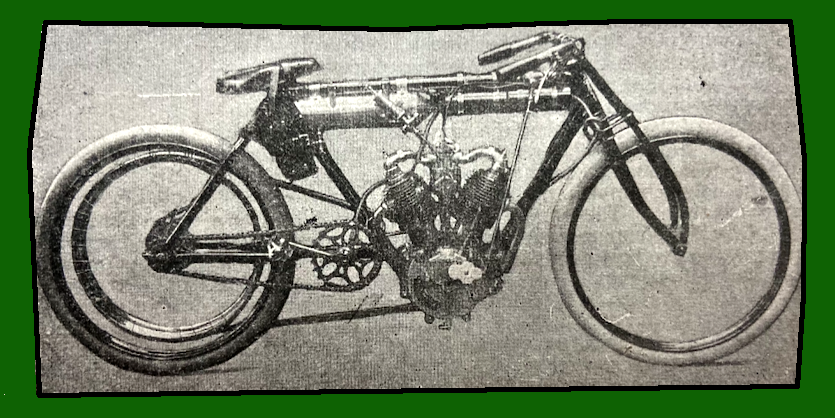
which Griffon machines have met with on the Continent in open competition have made them well-known in this country. Specimens also created considerable interest at the Stanley Show. The most striking machine on the stand is undoubtedly the 6hp double-cylindered air-cooled and-belt-driven racer: it is wonderfully light. The petrol and lubricating tanks and coils are attached to the top tube, and the accumulator is fitted to the diagonal tube just in front of the back stays. One carburetter supplies both cylinders, and the two exhaust lifters are actuated by one movement from the handlebar. A light lady’s model is also worthy of inspection. Societe la Touricyclette, Paris. Although not new, La Motosacoche is still looked upon by many as a novelty, and is attracting considerable attention. The name is given to a set of fittings (including an engine of 1¾hp), which can in a very short space of time be attached by the aid of four clips to an ordinary diamond-frame machine, thus converting it into a motorcycle. Although many people look upon the arrangement somewhat sceptically, machines fitted with La Motosacoche have not proved themselves freaks, but have
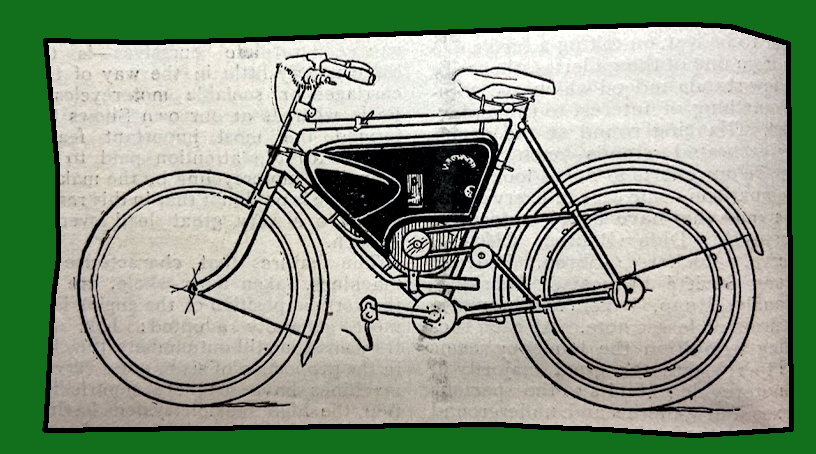
performed exceedingly well. The 1904 patterns are a great improvement over the older ones, being stronger and better finished. It will be noticed that air scoops assist in cooling the engine on this machine. Breuil, Avenue de la Grande Armée, Paris. This maker is exhibiting six serviceable looking machines. Although not remarkable for their finish, they are not unattractive in appearance. All are belt driven, some having round belts and the others flat. The Breuil engines are of 2hp, and all are fitted to special cradles in vertical positions. The engines are light in weight for their power and are well made. Including the non-slipping pulley, the over-all width in each case is well under 7in. A spray carburetter is used, and the contact breaker is of the trembler type. An improved form of silencer has been adopted. It is small, but we were informed that besides being a good baffler of the exhaust, there is no appreciable loss of power. The valves on the Breuil machines are very accessible, while the mounts are very easily controlled. Two powerful band brakes are fitted, and the wheels are shod with Colliere tyres. Struck, Amiens. Two motorcycles with belt drives occupy this stand. The engines, which are vertically placed, have a bore and stroke of 66x77mm [263cc]. The power of each is 1¾hp. Trembler contact breakers are fitted, as are spray carburetters; 1¾in belts have been used, and to the belt rim is attached a powerful brake, actuated by a cable from the handlebar. The accumulator, coil, petrol and lubricating oil are all accommodated in a nicely designed tank attached to the top tube of the frame. The machines are excellently finished and will repay a careful inspection. The Compagnie Generale des Cycles et Automobiles Rochet, Paris. Excellent specimens of the famous Rochet motor-cycles—with magneto and electric ignition—attract considerable attention. Both
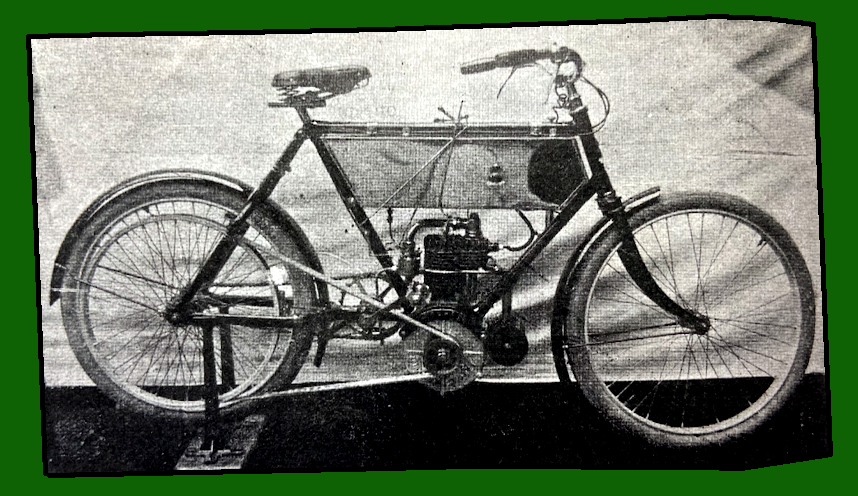
types are beautifully made, and suggest that considerable care has been taken in their construction. The magneto (new Simms-Bosch) model has a 2½hp engine, which is rigidly attached to the frame in a vertical position. It has a belt drive, the belt being rather wider than usual: All unnecessary weight has been eliminated, and the rakish appearance of the
machine cannot fail to appeal to many. A neat form of carrier is attached, while in addition to a back Bowden rim brake a powerful retarder acts effectually on the belt rim. Le Metals et Fils, Paris. Several of the widely-known 2hp NSU motor-cycles are exhibited by this enterprising firm. Most of our readers are fully acquainted with the details of these excellent machines—we need only repeat that the engines are fixed vertically, and that magneto, electric or high-tension electric ignition is fitted, according to the choice of the purchaser. The inlet valves are mechanically operated, and all the parts are readily accessible. The popularity of NSU machines may be gauged when we state that during the
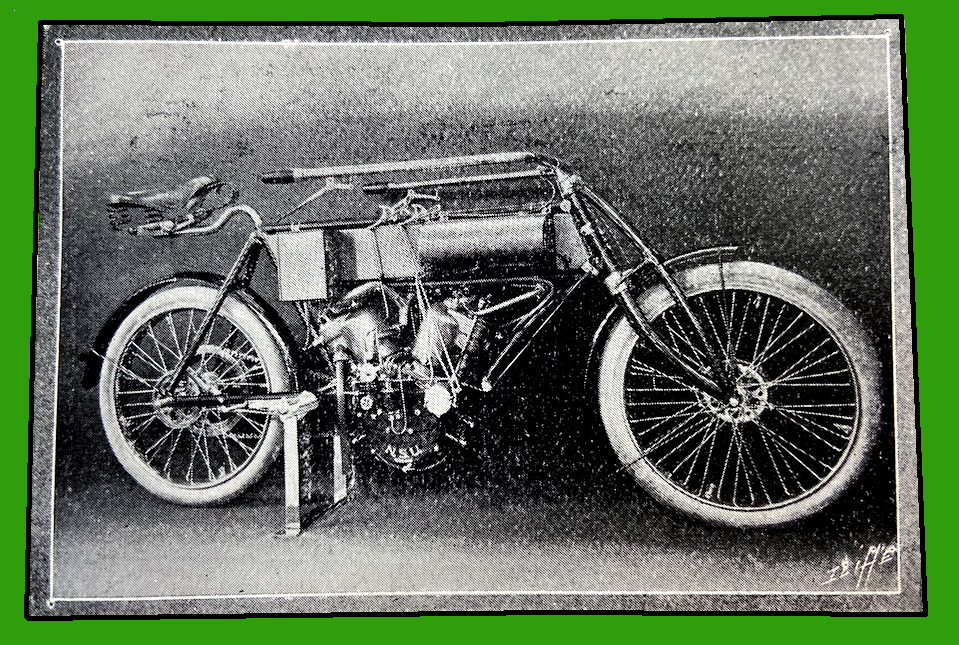
present year the firm have delivered over 3,000 of them. The NSU motor carrier was shown at the Agricultural Hall last month, is also on the stand. This is fitted with 3½hp water-cooled motor. The inlet valve is mechanically operated, and a two-speed gear is provided. A comfortable seat (not a saddle) is also fixed, while the carrier can be detached and a seat for a second person substItuted. Two brakes are fitted, and the carburetter and ignition (magneto) are easily regulated by the driver without any bodily inconvenience. NSU also produce racing motor-bicycle of 10hp, having a twin cylinder water-cooled engine. The radiators are of a rather novel pattern consisting of a tank on each side of the petrol tank proper. These cooling tanks have tubes passing through so that a draught of air rushes through them when the ma-chine is travelling at full speed. The transmission is by means of a clutch and Renold pattern chain. There are no pedals to this machine. It should be said that although the design is that of a racer it has road equipment in the way of guards and brake gear. On the whole this machine looks a fierce speed instrument and equal to anything up to 80mph. The weight is, of course, enormous. Amongst the curiosities shown at the Paris Salon one of the most notable is named L’Auto-Roue Roux, the agents’ address being Rue des Beaux-Arts, Paris. The motor is fixed inside the front wheel, which has no spokes, but the rim is supported by arms having rollers at the end. The power from the motor shaft is
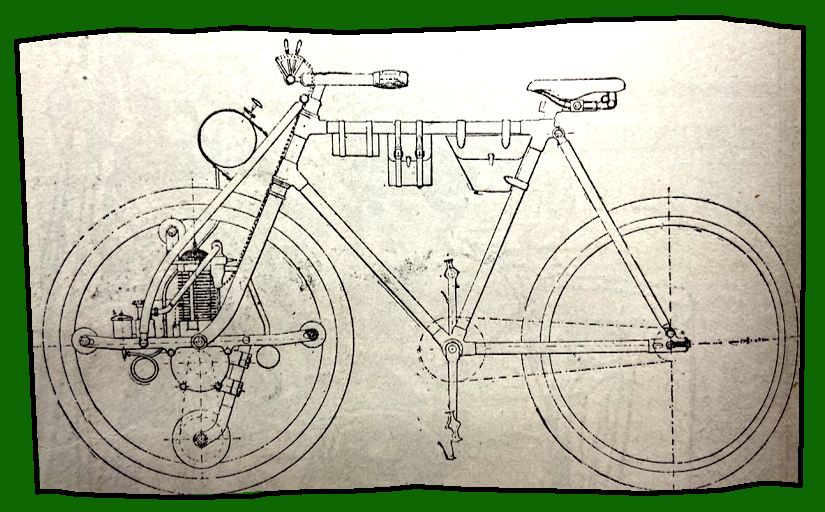
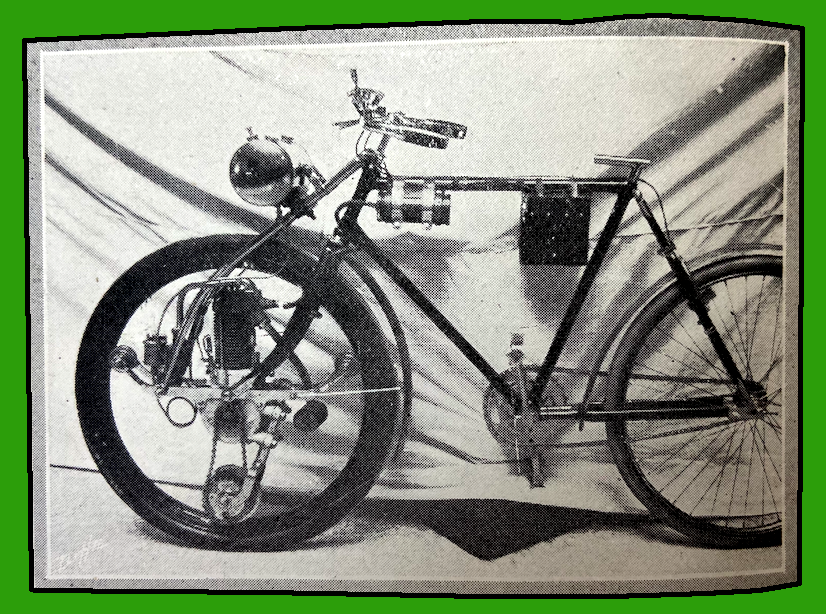
transmitted by a short chain gearing on to a friction wheel, this being held in contact with the inside of the wheel rim by an adjustable arm. The petrol tank is carried on supplementary forks and the controlling levers are placed just in front of the handlebar. The coil and accumulator are supported from the horizontal tube. The price of this machine is £24. The maker claims that the transmission is perfect—this is doubtful—it is very stable, easily manipulated and the parts are adaptable to any bicycle frame.” Clement et Cie have practically all their space filled by cars, but they show one new pattern motor-bicycle, having a vertical 2½hp motor and Longuemare carburetter. The coil and accumulators are carried in the frame tank, and transmission is by V-belt. Two brakes are fitted, one being on the belt rim, and one on the front wheel rim. R Rogers, Paris, has a fine show’. of Fafnir motors, from 2½hp upwards. The small motors are used by many well-known firms for motor-bicycles. Special features are the one-piece cylinder and head, positive make and break contact, extra large diameter valves, exhaust valve lifter, etc. The workmanship is very fine. In addition are shown some splendidly finished accumulator charging sets. Gladiator, Le Pré Saint Gervais (Seine). Among the imposing array of cars and pedal-propelled cycles to be found on this fine stand, a nicely made belt-driven 2½hp Gladiator motorcycle attracts attention. It is very light for its power; the cover of the contact breaker is made to act as a cam for lifting the exhaust. Rene Gillet, Villa Collet, Paris, shows several motor-bicycles possessing some novel detail features. They are fitted with 1¾hp motors placed almost vertically between the main tubes; the control is effected entirely from the handles by Bowden wires, one lifting the exhaust valve, and the other working the spark advance: a very powerful band brake is fitted on the rear hub: the diagonal tube is made to serve as a tyre pump, and the carburetter and ignition gear are all enclosed in a frame tank. L Garreau. An exceedingly light and neatly constructed motor-bicycle scaling 55Ib only is shown by this firm. The motor develops 1½hp and has an outside fly-wheel and one-piece cylinder and head: it is secured to the down tube by clamps on the cylinder and crank case. The surface carburetter, lubricator, and accumulator are carried in a case under the horizontal tube. Instead of an exhaust valve lifter the compression is released through the inlet valve when the spark is retarded. The transmission is by belt, and a back-pedalling band
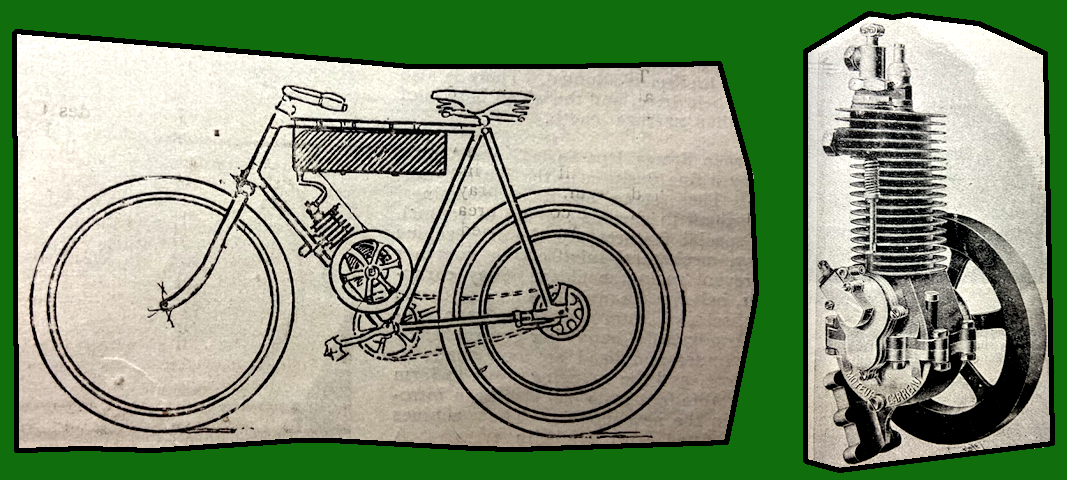
brake is fitted to the rear hub. EM Bowden, Paris. Three of the new pattern motorcycles are to be seen here. It will be remembered that they are chain-driven, and are fitted with 2¾hp FN engines, vertically placed in strong cradles. The control is effected entirely from the handlebar by Bowden cables, with the exception of the lever actuating the clutch attached to the big chain wheel. This lever is fitted to the horizontal tube of the frame, and its operation provides either a free or a connected engine as desired. The frame of the Bowden motor bicycle is unusually strong, and the forks are built on the girder system. The Bassée Michel coil is adopted, and, of course, the FN carburetter (spray) has not been dispensed with. The wheels are shod with Palmer tyres. On this stand there is also a very comprehensive display of adaptations of the Bowden wire transmission system. Gobron-Minerva show on their stand a racer evidently built for pacing in bicycle races, as it has a safety roller on the rear of the frame. The motor is 4½hp air-cooled, driving by a flat belt: the tank is of a torpedo shape and the coil and accumulator are supported on a bracket in front of the steering column: it looks a very speedy mount indeed, despite its somewhat freakish design. The standard road machine has a
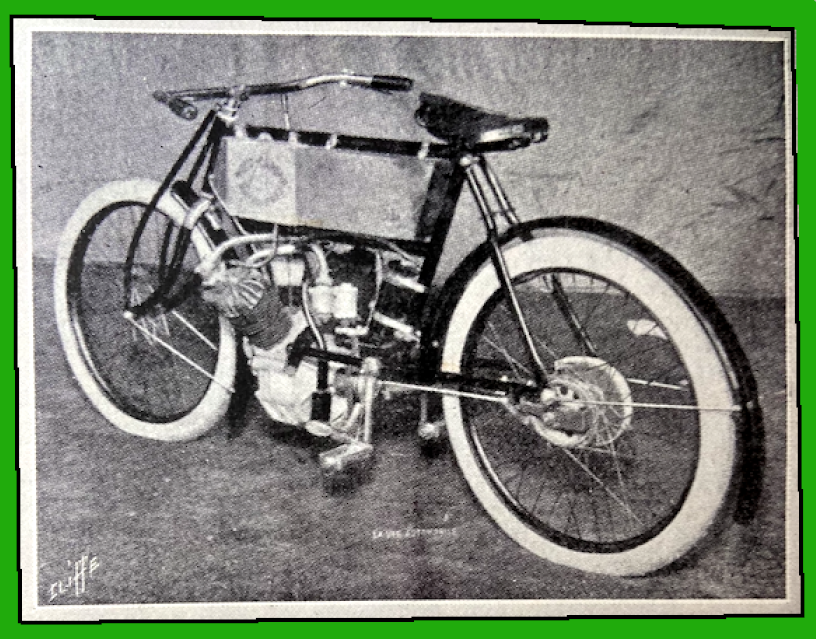
Reproduced from La Vie Automobile.”
vertical 3hp Minerva engine held in brackets between the main and diagonal tubes, and has the latest Longuemare carburetter fitted. The drive is by a V-belt of unusual width: only a single band brake on the rear hub is fitted and a new style of handlebar is used, being rather wide and brought well back. Altogether a most interesting display of cycles. G Givaudan, Lyons. In addition to a good display of motors—some of which have two cylinders—several complete motorcycles are shown by this maker. These vary in power from 2-3hp, and, although well designed and made, they are not distinguished by any remarkable departure from the standard types. The Societe Francaise have several 2¾hp motor bicycles on exhibition. The special features about the engine are the mechanical inlet and valve boxes placed in the front of the cylinder. The new l.onguemare carburetter is fitted, and transmission is by V-belt. Duplex forks are used, and a detail worth noting is the extra strength of the mudguard stays to withstand the vibration. A band brake, of the double lap pattern, is fitted on the rear rim. The valve gear is carried on a horizontal shaft in line with the main axle. The cylinder and head are in one piece, with the sparking-plug in the centre. In its general lines this machine is not unlike the new Werner, especially in the frame and engine design. Peugeot Frères show a series of machines of specially interesting types. One of these is a 3hp machine with an extraordinary form of spring fork suspension for the front

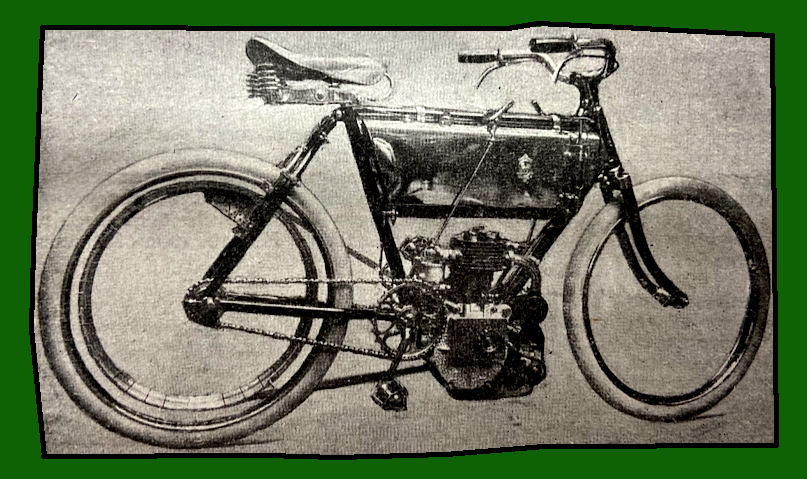
wheel: the wheel is carried by a series of jointed arms which work against a pneumatic spring concealed in the head tube. The arrangement looks ugly and complex: another feature of this machine is a back rim brake acting on the pulley rim by a Bowden wire. The standard pattern machine is very much on the lines of last season, except that a larger engine is fitted and also wide and extended mudguards. Another of these machines has the Simms-Bosch ‘arc light’ ignition fitted, and driven by a small chain. Another specimen has a Moto-Cardan transmission with the motor arranged transversely. A lady’s motorcycle shown has a ‘Zedel’ engine arranged à la Minerva, is also fitted with cushion forks. A 4hp racer exhibited has the motor constructed with a very small number of radiators: it has a belt drive and the usual features. A chain driver shown has a reducing gear on the engine and a spring controlled chain wheel on the rear; the chain is protected by a celluloid guard. Several of the machines are fitted with a double rim brake on the back wheel. WH Dorey, Rue Torricelli, Paris. A practical motor-bicycle clutch is shown, suitable for either a V or flat belt and able to transmit up to 4hp. It has a particularly easy action, very slight pressure of the lever being necessary to put it in gear. La Foudre et Cie, Paris, show several touring machines, with 3hp Buchet engines mounted vertically, and driving by a wide flat belt. Duplex forks, spray carburetter, and compression release on the inlet valve are notable points. The Buchet engines have the exhaust valve lift gear mounted on top of the cylinder. Gebr Koerting, Hanover, exhibit a line of 3hp two-stroke motors for cycles. The Crank case is used as a compressor for the charges of mixture, and the exhaust is automatically released through a port opened by the piston. Also on show is a fine two-cylinder set, coupled direct to a large dynamo, for lighting or accumulator charging purposes. Bonnet et Jaccard, Romanunotier Suisse. A 3hp belt-driven motor-bicycle is prominently displayed. The engine is fitted vertically to the frame and has a mechanically operated inlet valve. The carburetter is regulated by a disc indicator, and a well-designed form of trembler contact breaker is adopted. There is also a long belt drive, and the wheel base is of more than average length. Werner Frères, Rue de la Grand Armée, occupy a fine position in.the central transept. They stage 16 machines, finished off in various colours of enamel. The special features are the free engine pulley, mechanical inlet, engine governor to prevent racing, enclosed spray carburetter, belt rim clamped to a central flange on wheel rim, improved brake gear, efficient mudguards, handlebar control, etc. The cylinder and head are now made in one piece, and a swinging crank has been introduced to form comfortable foot rests. The machines are all fitted with Michelin tyres. A number of handsome trophies won by the firm’s machines are effectively displayed. Auto-Bicyclettes ‘Stimula’ all have 3hp engines fitted slightly out of the vertical and driving via a flat belt. A special feature is a back pedal brake acting on the face of the belt rim. A lady’s machine is shown here, but there is not sufficient dress clearance in the frame. The petrol tank is placed behind the diagonal tube. This machine has belt drive—unprotected by the way. A Paillard, Rue Daumesnil, Vincennes, exhibits a
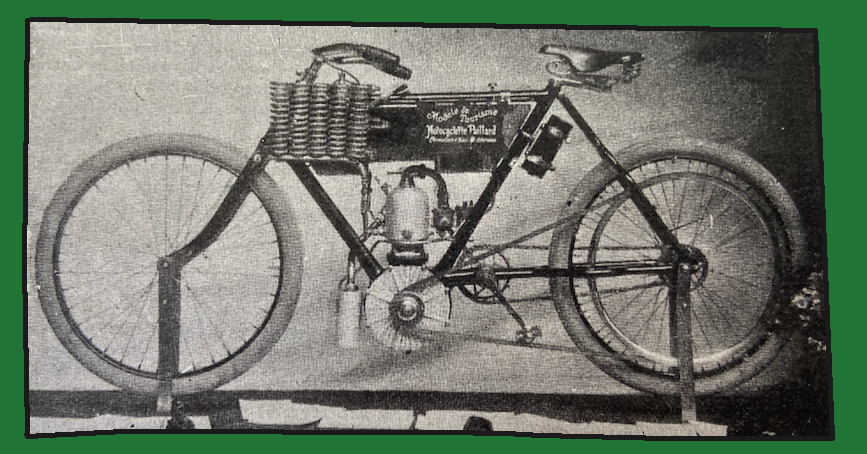
water-cooled motor-bicycle of 3hp. A striking feature of this machine is the arrangement of coil tube radiators in front of the tank: it has belt drive and band brakes. A popular model shown has a 2¼hp ‘Pipres’ motor, and carburetter fixed close up to the inlet. Terrot et Cie, of Dijon, have a series of rather well-finished machines with a 2½hp motor mounted vertically. The cylinder and head are in one piece, features include wide rear hubs, jockey pulley adjustment for the belt and an excellent cable brake. Hurtu, Avenue de la Grande Armée, exhibits a motor-bicycle on conventional lines except that the tank is cased in with wood. The motor is of 2½hp with tapering flanges and is fixed in a loop in the down tube, the main support being near the bracket à la ‘FN’. The cylinder and head are made in one piece, and a spray carburetter and belt drive are used.The ‘Pecourt’ exhibit boasts a good display of standard road machines fitted with 4hp vertical Zedel engines. In some cases the coil is fixed on the horizontal tube. These machines have two brakes, one acting on the rear rim, and one on the hub. The wheel base of the Pecourt miniature motor-bicycle is unusually long. This ‘Moto-

Cardan’ machine has a direct drive by means of a Cardan axle, very similar in fact to the transmission on a car; the motor is arranged across the plane of the machine. This type of machine is interesting from the fact that in some of the recent French motor-bicycle competitions it has done remarkably well. The mudguard equipment is better than on many French made machines. Ciguet Frères, Paris. A smart 4hp motorcycle is worthy of careful inspection here. The exhaust valve lifter is worked by the cover of the trembler contact breaker, and the cylinder and head are in one casting. The crown of the forks (girder type) is of a special arched design. Le Bichrone, Paris. The Bichrone motorcycles shown here. are similar in every respect to those exhibited at the Stanley Show. It will be remembered that the special feature of the Bichrone motor is that it is a two-stroke type, with separate pump for the inlet, and has an external fly-wheel. It is fed by a spray carburetter and has a wipe contact Debaralle, Argentieul, are exhibiting a particularly neat two-speed gear machine. The transmission is by belt with a 6in pulley on the motor and thence to a slightly larger one on the rear hub. The gear is contained in a box on the hub and is actuated by a finger lever on the handlebar. The motor is of 2¾hp. Another originally designed machine has a V-belt drive and a compact free clutch: it has two substantial band brakes. Still another machine on this stand has a single chain drive and free engine clutch in the rear hub. The Georgia Knap
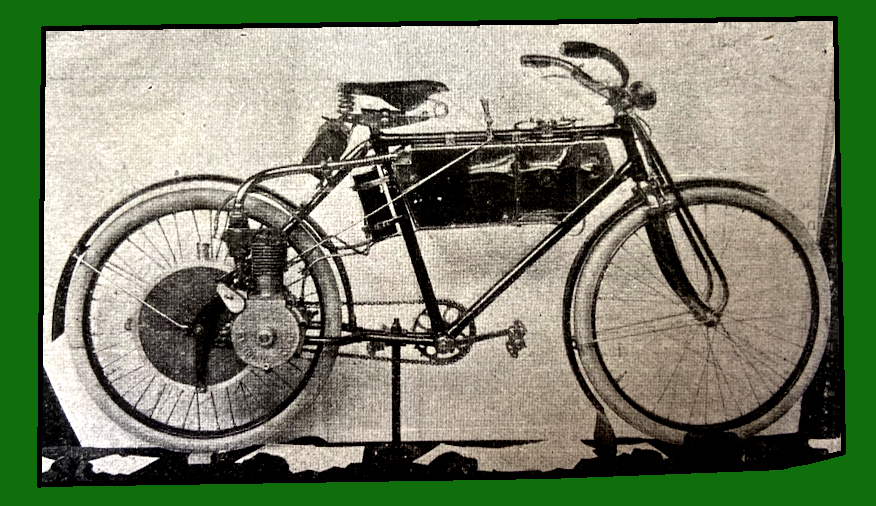
exhibit is always an interesting one. The motor is fixed on one side of the rear wheel and drives by gear and pinion, with spring buffers on the rim of the gear wheel. This make of machine is one of the very few fitted with surface carburetters: the gas is carried to the motor by a large diameter flexible tube. There are two rim brakes fitted and duplex front forks. To withstand the strain of the direct drive very strong spokes are fitted in the rear wheel. Several powers of motor of the air-cooled type are fitted. A Lambert et Cie, Paris. A weird-looking pedal-less belt-driven 8hp racing machine causes one to pause at this stand. The machine (the frame of which is enamelled in red) is the one which created a world’s record between Paris and. Arras, the distance covered being 216km (134 miles) and the time occupied only five hours. The spirit used on this occasion was alcohol, and it proved so economical that only two litres were consumed on the journey [252mpg]. A free engine is obtained by slipping the belt from the driving to a free pulley by means of a lever—this, is hardly good practice, for the belt gets considerably out of alignment, and as the belt rim is very narrow there must be a tendency for the belt to rise over the flanges causing undue stretching. The inlet valve is mechanically operated, and the control gear is exceedingly simple. The machine is somewhat ungainly, but its speed powers are remarkable, and after all a racer is built for speed. it is constructed by Lamaudiere and Co, Levallois. It is notable that some French makers use air-cooling for such a high power motor, and with a minimum of radiating surface. H Petit, Rue de Vaugirard, Paris. A two-speed gear machine is to be found on this stand. The crank case
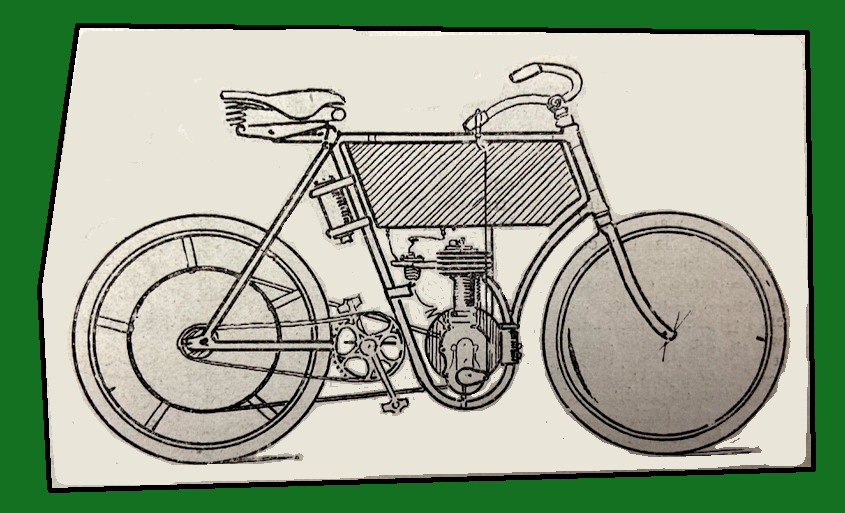
is of a very deep section and the change gear is concealed therein, being actuated by a lever on the top tube; the gear also gives a free engine. The motor has a one-piece cylinder and head with an outside fly-wheel. The main tube of the frame is bent into a deep U-section. A spray carburetter, high tension ignition and belt drive are used. Bailleul, Levallois, have a fine 3hp motor-bicycle with water-cooled cylinder, the jacket being of aluminium pressed on. The inlet is mechanically operated, and a free engine clutch is provided in the pulley. The drive is by a flat belt on to a built up wood rim. The inlet and exhaust valves are both fitted in the centre of the bead, and are arranged concentrically with each other, the operating rod for the exhaust being hollow, and having a central shaft through it to work the inlet. An inspection port and compression release is provided in the head. This machine is distinctly original in design. Specially good is a band brake on the rear hub worked by a Bowden cable. The cooling water is carried in the forward part of the tank, and an extra large capacity for petrol is provided. All the regulating levers are mounted on the top tube. The usual high-tension ignition is used, and the finish is above the average. Folding cranks are fitted to this machine. Cycles Liberator. On this stand is exhibited a machine to all appearances identical with the Kerry motor-bicycle, which is so popular in England. The motor is 2¾hp, fitted vertically in a loop frame. Lamaudiere, Mauger et Cie, Rue des Arts, Levallois-Perret, Seine, now make a 4hp engine, fitted vertically in front of the bracket, and specially designed for racing: this machine has an immense fly-wheel and a two-speed pulley. The 2¾hp machine is also made in a vertical pattern, in addition to the type in which the motor forms part of the down tube. A novel type of carburetter is used, and a jockey pulley for tightening the belt and freeing the engine. All the machines have triple fork crowns. “Messrs Chauvin et Arnoux have an interesting electrical speed indicator on view: this consists of a miniature dynamo with steel magnets, driven by a small belt from the axle of the car. The current then passes through a hot wire voltmeter which gives a reading exactly in proportion to the speed of the car.” P Bruneau et Cie, Tours and Paris, exhibit a fore-

carriage with chain transmission and free engine with water-cooled head. A centre of interest on this stand is a gear-driven machine. The engine gears on to a large cog-wheel, and inside this is a bevel wheel driving a shaft through the rear tube, and thence by bevel gear to the hub, exactly as in the gear-driven bicycles so popular a few seasons ago. Inside the large chain wheel a series of spring buffers are fixed to take up the shocks. The small pinion on the engine shaft is driven through a friction clutch operated by a lever on the horizontal tube; all the gearing is enclosed in aluminium cases. A standard pattern of chain-driven machine is shown, some being fitted with water-cooled heads. La Metropole, Rue St. Maur, Paris, have a motor-bicycle of light construction with a 1½hp motor placed vertically in the angle between the two main tubes. The petrol tank is fixed behind the saddle, and the coil and accumulator are clamped to the down tube. The drive is by a twisted belt. The exhaust lifting gear is of a curious type, being carried on a separate bracket. Another feature is that the carburetter is placed very close up to the inlet. The pedal gear on this machine is of the Acatene bevel wheel and shaft type*. There is also a double band brake, and duplex front forks are fitted.”
* I hadn’t come across the ‘Acatene’ bevel before so I looked it up. According to onlinebicyclemuseum, and they should know: “L’Acatene of the Metropole company, dating from 1893. The Acatene-Metropole was on the market from 1896 onwards and influenced the British market when Humber marketed it in 1897 under licence. Both American and British inventors patented chainless bicycles but, despite their revolutionary design, the American ‘League’ Chainless and the English Quadrant were not popular enough in their respective countries to warrant full-scale manufacture. France’s Acatene was therefore the first chainless bicycles to go into full production, followed by the FN in Belgium. The League was beset with problems and it was not until Colonel Pope of Columbia purchased the American rights to the bevel-gear patents of both Quadrant and Metropole that he was able to create a satisfactory American chainless bicycle, which became his most promoted model. Female versions of the Metropole Acatene were marketed under the Acatene, Metropole and Velleda names. The company’s most famous advertising poster showed the Germanic priestess Velleda who, like Boadicea in England, was a legendary leader of an uprising against the Romans. Both were immortalized by the Roman historian Tacitus. The bird of prey next to her is carrying chains in its talons, and the Latin motto ‘Vae Catenis’ or ‘Woe to Chains’ is displayed in the sun above its head.” Another reminder, if such were needed, that pedal and motorised bicycles were inextricably linked—Humber, Pope, Quadrant and FN were at the heart of the motorised bicycle revolution.
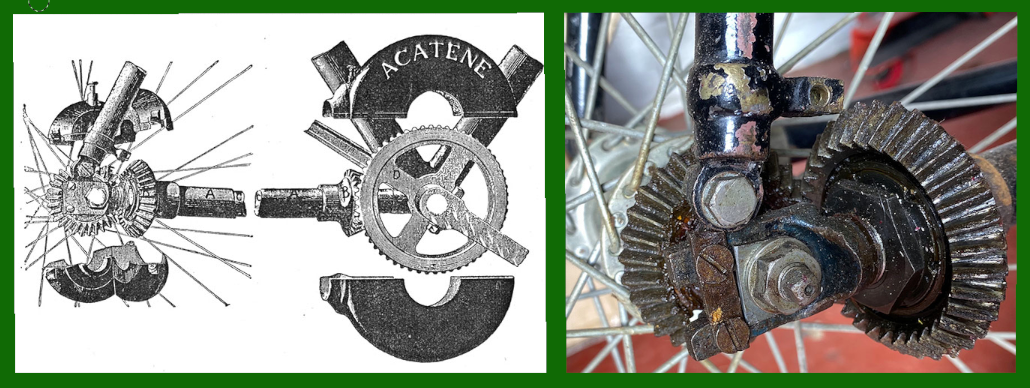
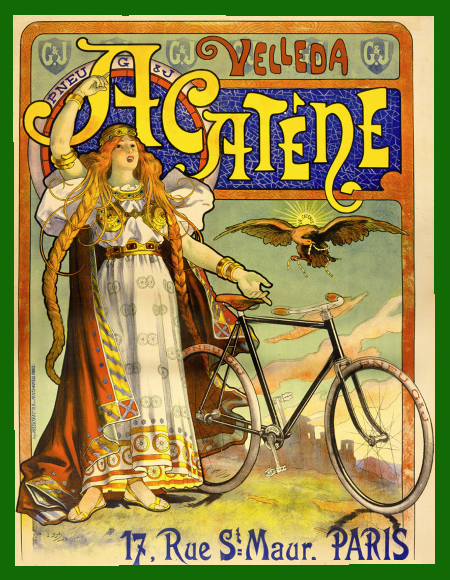
The Societe Anonyme de Constructions Mechanique de la Loire has two of the firm’s Automoto machines on exhibition. One, a 3hp water-cooled type, with a belt drive, is a particularly attractive motor-bicycle. The water jacket extends round the cylinder and valves. The latter, which are mechanically operated, are placed in a very accessible position. The sparking-plug is screwed into the top of the combustion head in a vertical position, and the carburetter is of the float feed type. The water tank is cooled by an extremely neat design of radiator. This really forms a part of the main tank, and is fitted just behind the head of the frame. The feature of the machine is the combined driving pulley and clutch, which provides two speeds and a free engine. The machine is powerfully braked, and has the advantage of being easily controlled. On the stand of Hurtle-Bruneau, 38, bis Rue de la Chine, Paris, is to be seen what is probably the lightest motor-bicycle ever designed, the weight complete being 481b. The engine although of toy-like dimensions, has been most ingeniously designed. The cylinder is simply a piece of steel tubing of 1¾in diameter with the exhaust valve fitted at the side, the plug opposite, and the inlet valve at the top. The tubing is simply pressed into shape; the drive is by belt, and the petrol tank, coil and accumulator are fixed to the tubes by detachable clips. The engine itself has many interesting features, designed. The cylinder is simply a piece of steel tubing of 1¾in diameter with the exhaust valve fitted at the side, the plug opposite, and the inlet valve at the top. The tubing is simply pressed into shape; the drive is by belt, and the petrol tank, coil and accumulator are fixed to the tubes by detachable clips. The engine itself has many
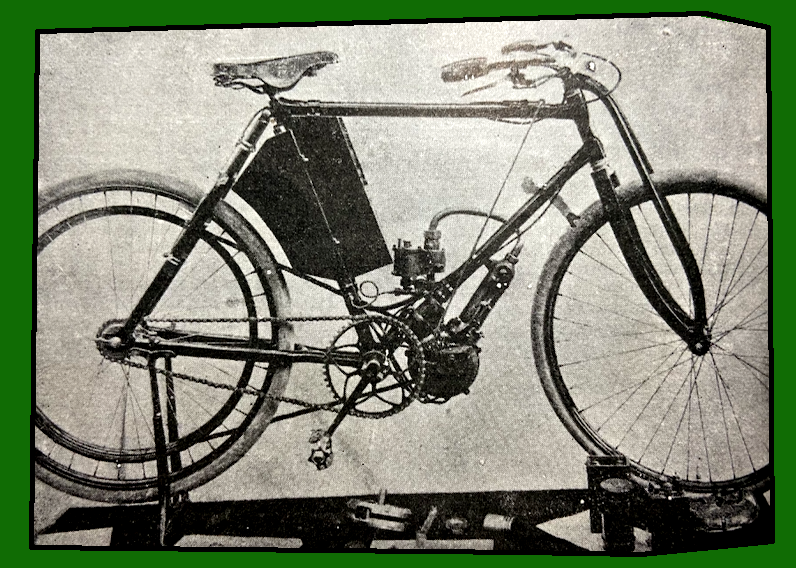
interesting features, particularly in the valve gear, etc—no silencer is used, the exhaust blowing straight out of the cylinder into the air. The power cannot be more than ½hp: this looks an ideal little motor for fitting to an ordinary pedal cycle for assistance against the wind and uphill, and is the thing that many cyclists are looking for. A gear and chain-driven machine of 2½hp is shown by E Gentil, Neuilly-sur-Seine. The system of driving is by a small pinion on to a large gear-wheel on the left side of the pedal crank axle; this gear-wheel has a series of springs arranged between the rim and centre, and drives a hollow axle carrying the ordinary pedal chain-wheel on the right side, from whence the drive is by the pedal chain to the rear sprocket. The free-wheel is fitted in the crank shaft bearing. There were three belt-driven Adler motorcycles, of German make, on the imposing stand of the Adler Fahradwerke, Frankfurt. The Adler machines have a good reputation on the Continent, and are fairly well known in this country. The best machine of the three was undoubtedly the 2½hp water-cooled type. The engine is rigidly attached to a strongly built frame in a vertical position. The mechanically operated valves are placed side by side at the top of the cylinder, and being well away from the tanks are very get-at-able. The water jacket covers both the valves and cylinder, etc. At the stand of H Deckert et Cie a number of air-cooled motors are to be seen, including one of 10hp. A remarkably high-powered engine for one that depends on the atmosphere for cooling. This motor, by the way, is governed on the exhaust. A 5hp racer is also shown. This an exceptionally large spray carburetter, torpedo-shaped brass tank, which carries everything with the exception of the coil—this is placed on the top tube of the frame.
“THE BICHRONE. RECENTLY A demonstration of the excellent hill-climbing capabilities of this ingenious form of two-cycle motor was given before several press representatives in the neighbourhood of Highgate Hill. A suburban road running parallel to the Archway road was selected, which, from rough measurements taken at the time, we estimate to have afforded about 300 yards of a gradient of one in 16. This ascent the bicycle, fitted with a a 2hp Bichrone motor, climbed several times in excellent style, its best performance being the conveyance of the writer’s 14 stones from the foot to the summit without a falter. The engine looks like a two-cylinder motor; but the forward plain cylinder is in reality a mixture pump driven off a second crank on the crankshaft within the crank chamber. This pump serves to draw mixture from the carburetter and to deliver it through an automatic valve and curved length of pipe to the engine cylinder proper. The gas obtains ingress to the latter through an automatic valve in the crown of the combustion chamber. Between the pump and the carburetter is another non-return valve. The exhaust port is formed in the wall of the engine cylinder and is uncovered by the piston at the bottom of its stroke, the exhaust products passing through this port to the silencer without the intervention of any valve. The crank working the mixture delivery pump is so set with relation to the engine crank that the pump plunger begins its upward or delivering stroke just before the engine piston uncovers the exhaust port. The result of this is that the incoming charge of fresh mixture chases the exhaust out of the engine cylinder, and the pump continues to deliver gas to the cylinder until the upward movement of the piston has compressed the new charge sufficiently to close the feed valve against the pump, and goes on to perform the further and final compression of the charge in the combustion chamber. So soon as the piston has reached the point of its highest travel and compressed the charge to the uttermost the latter is ignited, and the working stroke immediately follows. It will thus be seen that a working stroke of the piston is obtained for every revolution of the crankshaft, in lieu of every other revolution, as with the four-cycle type of engine. Whether this makes for efficiency or otherwise can only be determined by careful tests; but the fact that so small an engine—it weighs only 28lb—could propel our weight up the steep hill in the manner it did speaks volumes in its favour.”

“THE PRIME DISADVANTAGES OF all our existing macadam roads are susceptibility to wet and other climatic influences, with consequent lack of durability, cost and labour of repair, and dust and mud producing qualities. Wood paving is costly, unhealthy, and non-durable; whilst the various forms of asphalte roading are both expensive to lay and maintain, as well as dangerous to all forms of traffic under many conditions of weather. The improved method of road-making employs stone—preferably granite—and tar laid on a concrete bed and topped with a coating of tar, cement and gravel. It is claimed for a road so constructed that it embodies the following advantages: great saving in cost of construction; perfectly sanitary, the road being water-tight; easily kept clean; dries quickly after rain; horses never slide; makes absolutely no dust; takes less time to make than stone pitching or wood blocks. In St Helier, Jersey, roads have for some time been laid out on this system, and are apparently giving every satisfaction.”
“LANCASHIRE MOTORISTS ESPECIALLY will be interested to learn that Messrs Whittaker & Co, St Mary’s Works, Lower Broughton, Manchester, are now making a very good grade of petrol selling at a very reasonable figure.”
“MY FIRST MOUNT WAS a 3hp single-cylinder, well-known make, and this, although a good machine in other respects, used to overheat terribly when used with a side-car. On every hill it needed pedalling, and the exertion was too much. I therefore decided that water-cooling was necessary, and so purchased a twin-cylinder water-cooled Iris motorcycle. I have never regretted my decision. The absence of vibration, smooth running, and freedom from trouble give a charm to motoring that I never experienced before. I think the average rider, after once riding a double-cylinder motor, would be of the same opinion as myself; and I fully expect this type of engine will speedily be-come popular.
CS.”
“FOR RIDING IN WET WEATHER, procure a large piece of patent leather, fasten it between the down tube and the engine (as in Minerva and Quadrant types) and then cut out in front of the engine head about 16 holes the size of a shilling. The engine is thus well air-cooled, and the original mudguard in front of these holes keeps the mud from coming through. I have ridden 70 miles in the dirtiest weather and come in with boots and legs fit for a drawing room; the feet are also kept warm. I use it daily and motor never overheats. The flap is stiffened and supported by riveting two lengths of loop iron along the top and about the lower third; the top has these holes bored through to take the thumb screws and clip.
A Fennings, MD.”
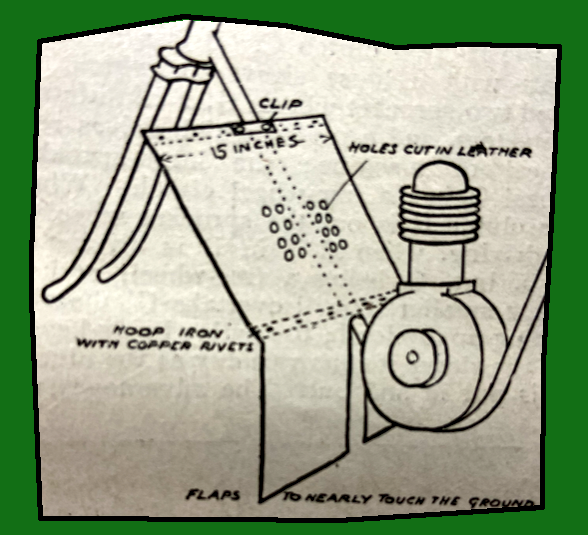
“THAT THE MARGIN OF SAFETY in high-powered motorcycle racing has almost been reached, if not passed, in England, has already become evident from the several serious accidents which have occurred, owing to the rider’s inability to control the machine and keep it from skidding up the banking. To the untrained eye it may appear quite easy to steer a motorcycle round a highly banked track; and to the spectator the day when a speed of 70 or 80mph will be accomplished is easy of imagination. The opinion, however, of experienced riders such as Fred Chase, his brother AA Chase, Harry Martin, or Joseph van Hooydonk is clearly to the contrary, and they all agree that the limit of speed for existing British tracks has almost been reached. Chatting with AA Chase on the subject, the writer asked him his opinion, and he puts the figure at 1min 4sec for the limit of speed at which the mile will be accomplished, and then at considerable risk, taking Canning Town as the finest and most suitable track. Fred Chase, thinks that 1min 2sec may be accomplished; but inside that the rider, whoever he may be, will run the life hazard in the endeavour to keep himself and machine on the track, and from collision with the fencing at the top of the banking. In view of their years of experience in fast track riding, the opinions of these men are worthy of the fullest attention from would-be record breakers who value their necks. Messrs Martin and van Hooydonk alas consider 1min 2sec for a mile about the fastest pace attainable with the banking at present used on English tracks: faster time is only a question of engine power, gearing, and banking; as there are plenty of machines already capable of higher speed if the rider dared let the engine out to its best.”
“A PATENTED TYPE OF telescopic footrest for motorcycles have just been put on the market by AB Clark, engineer, Curfew Ironworks, Sandwich. The special features of this invention are that the ends of the rest having the rubber covered foot plates fitted telescope into the main tube, which is provided with a clip to fit the down tube of the motorcycle. The foot plates are mounted on springs so as to absorb vibration, and a trigger attachment is combined with them, so that by slight pressure on the plates the telescopic ends are forced out by internal springs, and thus the rider’s legs are kept clear of the engine. When the footrest is required to be out of the way it is only necessary to apply slight pressure to the ends, when the tubes collapse to normal dimensions. Those riders who find the ordinary pedals as fitted to most machines somewhat tiring will be specially interested in this invention, which should prove a satisfactory rest. It is a well made and finished article, and the retail price is 22s.”

“MESSRS WA LLOYD’S CYCLE Fittings, Park Street, Birmingham, have introduced several important improvements into their new model motor-bicycles. The bore and stroke of the 2¼ and 3½hp engines are respectively 71.4×76.2mm [305cc] and 77x82mm [384cc], developing full power at 1,400rpm. In each case the engine is fixed vertically in a loop frame. The cylinder and valve chamber are of one casting, the inlet valve being of the automatic type. An exhaust valve lifter is employed, and is operated by a Bowden wire from the handlebar. The lever actuating the wire has two notches, and by lifting the lever to the first notch the contact is broken without the valve being opened so the engine may be used as a brake.By moving the lever to the second notch the exhaust valve is opened and the contact broken.”

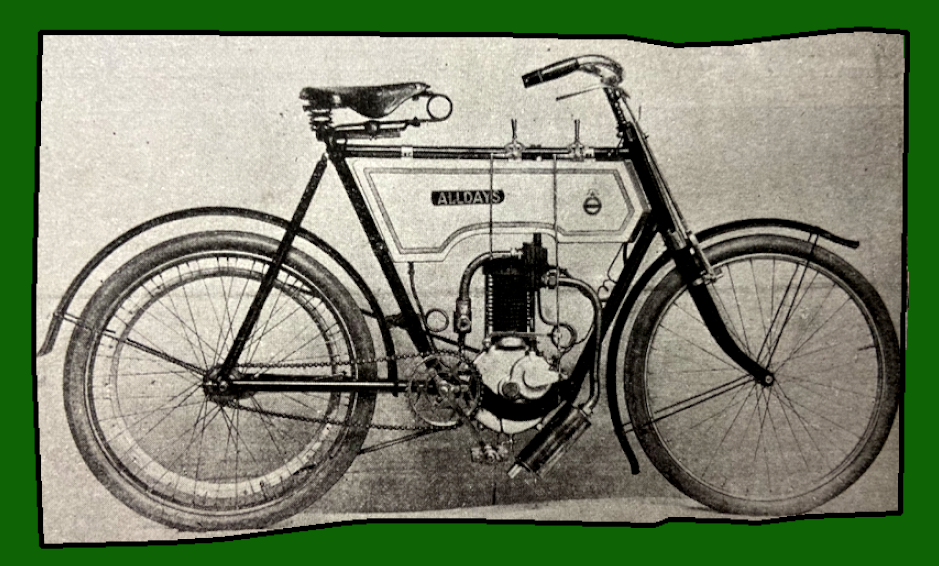
“MOTORCYCLING IN GERMANY. The ‘First Berlin Motor Cycle Club’ has decided to join the German Cyclists’ Association (Bund) in view of the latter’s special privileges to members in regard to insurance against liability and accidents, on the condition that the committee of the association find ways and means of enabling members of ‘Association’ clubs to count also as full members in a motorcycle club affiliated with the Bund. Herr Eugen Glombitza (secretary of the Berlin branch of the Bund) and Messrs Lange, Schindler and Wallner, all well known Berlin amateurs, have the negotiations in hand. “
“A NUMBER OF THE 1904 MODELS of American machines are now on the market. The ‘Black Diamond’ motor-bicycle is made by Reeser & Mackenzie, Betz Buildings, Philadelphia. This has a vertical engine fitted in a loop frame, driving by a chain first on to a countershaft and thence by another chain to the rear wheel sprocket. The frame outline is rather a symmetrical one, the petrol tank and coil being carried by the top tube of the frame. The ignition, as is usual on American machines, is by dry batteries carried in a case fixed behind the saddle. The make-and-break device of this machine is an imitation of the Garrard-Maxfield patent, but probably the most striking detail is the controlling device worked from a handlebar lever so constructed that the steering has complete freedom throughout a circle. There is a system of several levers ending in a ring through which the handlebar stem passes. There is a special feature about the inlet valve of this machine, this being used for relieving the compression and also for being automatically moved from its seating when the machine is stopped, and thus preventing the valve gumming or sticking. A spray carburetter of the mixing valve type is used. The total weight of the machine is 130lb, motor 391b, and having a cylinder 2⅝x3⅜in [303cc] is about equal to 2½hp. The petrol tank holds more than one gallon. To facilitate adjustment of the pedal chain and

driving chain, both of these are made of the same length by suitably designing the sprockets. The only brake fitted apparently is a ‘Coaster Hub’ pattern. The 1904 ‘Mayo’ machine has the motor of 2hp mounted inside the frame, the diagonal tube being taken further back from the bracket than is usual. The belt drive is comparatively short, but to compensate for it the pulleys are large and a lever adjusted jockey pulley is used for tensioning the belt. The coil and dry battery are mounted behind the saddle pillar. A spray carburetter is used. The weight is claimed to be only 90lb. The rims are steel and tyres are G&J pattern—practically the same as our Clincher tyres. The ‘Whipple’ machine is made by the Whipple Cycle Co, W Jackson Buildings, Chicago, and is rather a neatly designed mount and comes out at the reasonable figure of $120 dollars (£25). The special features about it are a two-speed gear and clutch only adding 6lb to the weight, engine arranged inside the frame, spray carburetter, duplex forks, exhaust taken behind the saddle pillar, belt drive with jockey pulley adjustment and Coaster Hub brake. The ignition is by dry battery and coil carried in a case behind the back stays. The petrol tank which appears to be of small dimensions is fitted in the forward part of the frame. The lubrication is effected by a sight-feed oil container screwed into the crank case. The makers claim that this machine is equal to doing 25mph and climbing any hill on the low gear.”
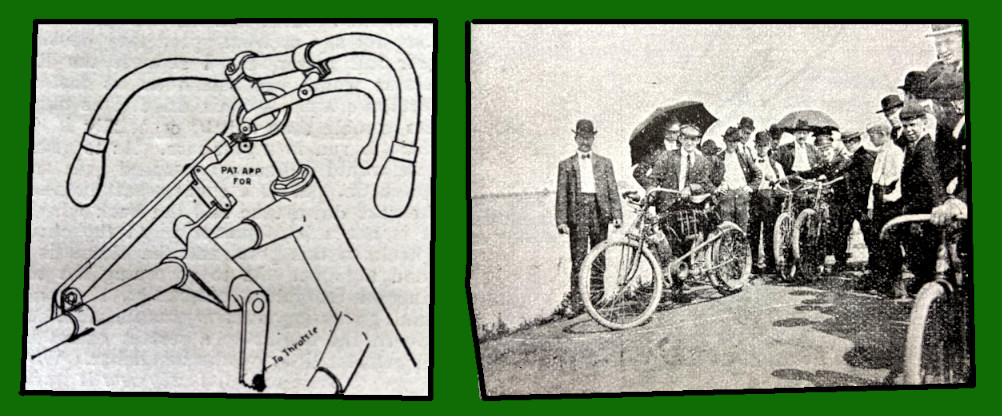
“THE ANNOUNCEMENT THAT there will be a competition, for devices for the prevention of side-slip organised early in the New Year by the Auto-Cycle Club will be heard with somewhat mixed feelings. We are all of us anxious to learn about the qualities of the non-slipping devices already on the market, and to encourage inventors to come along with others, but can anybody suggest a really satisfactory method of testing them? For the test to be of any value at all it most be thorough; and to be thorough will involve a great risk of life and limb to the demonstrators. The records of science show that the inventor is always so buoyantly confident of the soundness of his method and the perfection of his instrument that he scoffs at the idea of danger, so the Club will experience no trouble in finding drivers who will undergo, any risk with their own pet inventions under them; but in the event of a certain method proving a failure and the demonstrator sacrificing his life in a series of tests imposed by the Club, would not the organisers of the competition be liable to prosecution for aiding, abetting and encouraging the man to risk his life? It will be useless to run a series of tests which are ‘safe’ or only moderately risky to the riders. And, another thing, it will be desirable to show the behaviour of the unprotected machine on the chosen surface, in order that the qualities of the various devices submitted for test may be compared with it. Who is to be asked to show how the ordinary machine side-slips? With cars there is not so much personal risk to the occupants, because the slip is a bodily one, and an overturn is a most unlikely occurrence, but with a motorcycle a side-slip means a fall, and possibly a nasty one for the rider. Moreover, as the surface provided for the tests must be artificially prepared, its nature will probably be distinctly repulsive, so that the strain on the nerves of the riders may, in a measure, vitiate the tests. However, the idea of organising such a competition is a good one, and the ACC is to be commended on its pluck.”

“THE TRIALS AND RACES of commercial types of motor bicycles being organised in France are a very encouraging sign of the increasing attention being paid by makers to the designing of machines for practical use, and it is due to a Paris manufacturer, M Haustgen, that an hour’s race for motor bicycles of 3hp and less is to take place on the Municipal track at Vincennes. This event was to have been decided on Sunday last week. Owing to the large number of competitors, it was found necessary to run off preliminary heats, and by the time the final was started, the rain began to fall in such a deluge that the race had to be postponed. The machines competing were a very interesting lot. One of the novelties was the Moto-Cardan, designed with a 1¾hp motor fixed to the bottom of the frame, power being transmitted by a universal jointed shaft and bevel gear to the rear wheel. It is fitted with a clutch actuated by a fork and Bowden wire. The motor, however, is started by pedalling, but the clutch is very convenient for moving the bicycle about, and also for allowing the motor to pick up, while, of course, it may also be necessary at times to pedal the machine without the aid of the motor. The bevel drive has so often been advocated for bicycles that it is curious so few makers have attempted to use this system of transmission. It naturally requires great accuracy in fitting the machine, and also facilities for adjustment, as well as care in construction; but these qualities are nowadays so general in bicycle making that a bevel drive machine ought to give no more trouble to the user than the other types of motor bicycles. The bevel drive machine must be of sound quality, or it will inevitably be a failure. The Georgia Knapp bicycle has been attracting a good deal of attention of late on account of its novel system of propulsion, and it was with considerable interest that we saw it running for the first time in a race. In this machine the motor is clipped to the back stay, and is geared direct on to a spur wheel on the rear driving wheel. The arrangement, therefore, is extremely simple. M Georgia Knapp claims that it gives a higher efficiency than is possible with belt or chain transmission, and for this reason the standard bicycles are fitted with motors of only 1½hp. The engine is also of M Knapp’s own construction. In these direct-drive bicycles, as well as in machines fitted with chains, it is usual to provide a flexible coupling between the gear and the hub. In the Knapp bicycle this is done by means of spiral springs inside the spur wheel, so that the resistance of the springs prevents any sudden jerking of the back wheel. The V-shape two-cylinder engine seems to be becoming popular among certain makers, for both the Iris and Centaure motors are of this type. The engines were bolted to the curved bottoms of the frame, and there was in fact very little variation upon this method of attachment. One of the engines competing had a water-jacket all down around the combustion chamber and valves. It is easy to understand why motor cycle racing, limited to machines weighing 50kg and less, is becoming so popular on the French track. The novelty is sufficient to attract spectators until they begin to understand the features of motor cycling, and then the interest grows upon them with the competition of new machines, while they see that mechanical efficiency and skill in driving give a much greater zest to speed contests than is possible in races where everything depends upon the man alone. Nothing could have been more interesting than the races on the Municipal track on Sunday week. The hour event was preceded by a kilometre race run off in two heats—one for the bicycles of less than 2hp and the other for machines of between 2hp and 3hp. In the former category the Moto-Cardan, ridden by Berger, was first in 58sec, followed by Stern on a Knapp in 1min sec, the latter beating Lasne on a Lurquin-Coudert by ⅘sec. Among the higher-powered bicycles, the best performance was done by Goffre on a Griffon, whose time was 56sec, and then came Stockel on a Lurquin-Coudert in 1min ⅗sec. Mignard on a Knapp in 1min 2⅘sec, Godefroy on a Fafnir in 1min 3⅘sec, and Méline on an Iris in 1min 4sec.
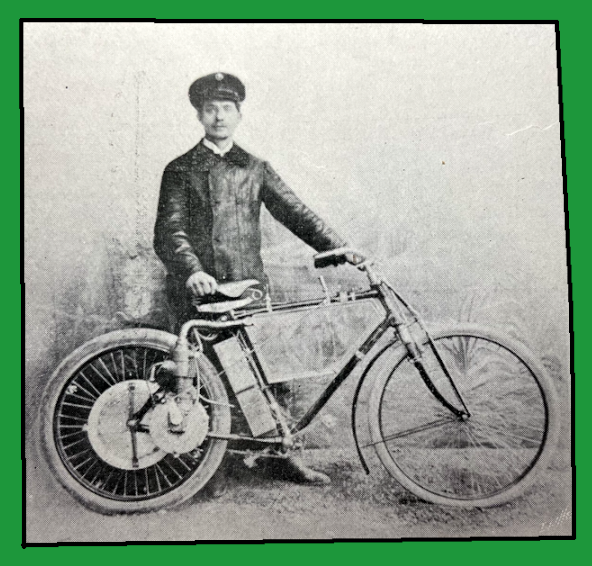
In the preliminary heats over 5km for the Prix Haustgen, the Griffon, of Goffre, was again first in 4min 55sec, and the second heat was won by Bonnet on a Centaure in 4min 59⅖sec. The twelve competitors qualifying for the hour’s race started just when a storm was brewing, and it looked doubtful whether it would be finished in time. The starting of a dozen machines made a great impression upon the spectators, who were very enthusiastic as they spread out in the first lap, and it really was remarkable to see the way in which the riders took the corners at full speed and the perfect command they had over their machines. At no single moment did there seem to be the possibility of an accident. As soon as the positions could be made out, it became evident that Mignard on his Knapp bicycle was ahead and gradually increasing his lead. The machine was running wonderfully well, and passed the others so frequently that the rider had to keep on the outside to avoid accidents. And then as the race continued the Griffon showed up prominently, and the Moto-Cardan ran with great regularity. At the end of a little more than half an hour rain began to fall, and it was decided to postpone the race. At that time Mignard on his Knapp was leading, having covered 39km 500m in 37min, and was followed 300m behind by Goffre on his Griffon. A Doué, Iris, and Moto-Cardan were in that order…On Friday last another start was made at 9.30am, but a fearful downpour drove competitors and spectators again under cover. It was not till about 11.30 that the actual start took place, when Bonnel (Centaure) took the lead from Mignart (Knap), who held first place at the conclusion of the last event. His premier position was short-lived, however. Mignart on his direct-geared Knap passed him, and soon commenced to lap all the other competitors as well. Mignart covered 69km 333m in the hour. Stockel was second, on a Lurquin & Coudert, 64km; Bonnel third, on a Centaure, 60km 933m; Goffre fourth, Griffon, 45km 862m. The machines were divided into two classes; all the above were in Class 2—engines from 2hp to 3hp. In Class 1 were Doué (Doué), 58km 600m, first; Berger (Moto Cardan), 56km second; Hibon (Doué), 52km 570m, third; Lasne (Lurquin & Coudert), 45km 320m, fourth. The distance covered by Mignart (69km 333m) equals exactly 43 miles 100 yards—not bad for a 2½hp engine.”
“THE DIRECTOR OF THE PARC des Princes track had the idea of interpolating in his recent Grand Prix de la Republique meeting a ‘world’s motor cycle championship’, which would have been better entitled a championship for professionals. Certain promoters are inclined to attach too much importance to the huge machines fitted with engines of 16 and even 22hp, which can be of no practical utility whatever except for pacemaking. Races are organised among the professionals solely as a means of providing sensation for the public. The so-called championship attracted eleven competitors, and the four preliminary heats were run off previous to the final contest over a distance of 5km. The first two heats were won by Champoiseau from Anzani and Kruger, and by Marius Thé from Rigal, who narrowly missed a spill at one of the corners, and as the rain began to fall both of them rode with a great deal of caution. The third heat, postponed to the following day, Was the occasion of a remarkable performance by Maurice Fournier, who covered the 5km in 2min 45⅗sec, and rode one lap at the rate of 65½mph. He finished easily threequarters of a lap from Sigonnaud. In the fourth heat A Fossier lapped Colomb, and won in 3min 2sec.”
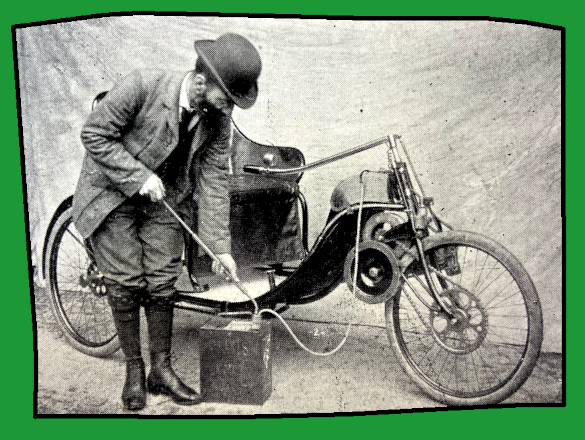

“A MOTOR BICYCLE THAT will travel 1,000 miles with little or to attention must necessarily be a good one. But good as a machine may be, the most essential point in all contests this kind is that an expert. driver should sit astride the saddle. Such a man must have skill, nerve and judgment, and be thoroughly fit before he starts on such an arduous undertaking. He must thoroughly understand every detail of his machine, and be conversant with every vagary of the internal combustion engine. Needless to say, great experience is necessary. And there is no doubt that when the Ormonde Motor Co selected Mr AC Wright to pilot their 2¾hp motor bicycle through the recent Auto Cycle Club’s trials they hit on the very man for the work. In a talk we had with Mr Wright a few evenings ago he told us that his first experience with petrol motors dated from the year 1895, a time when the Serpollet cars burnt coke. Like many motor cyclists, he first started riding a De Dion tricycle, and at that period he, like most people, regarded the motor bicycle as a very dangerous toy, especially on greasy roads. His first experiences of a motor bicycle were on a front-driven Werner. However, not long after a sample machine fitted with a 1½hp Kelecom line was sent over from Belgium, and this Mr. Wright elected to try. His first impressions of this machine were good, and he was especially struck by its steadiness in grease and general satisfactory running. After he had ridden this machine for several weeks, and found that it went well, he decided to enter for the Automobile Club’s run to Southsea in 1901. By this time another machine had been sent over from Belgium, but the cylinder on this turning out faulty, he substituted the engine on the first machine for that on the new one. At this period the Ormondes were naturally in rather a crude state, and no lubricator was supplied, the oil being poured into a hole in the crank chamber. But as with this system it was impossible to lubricate without dis-mounting, and as Mr. Wright was anxious to make a non-stop run, he fitted on a force pump. His ingenuity was well rewarded and he was able to gratify his wishes—except for a broken back-pedalling brake he came through without any other trouble. On this occasion the other two machines present were a Werner tandem and a Phoenix bicycle. His next run of importance was to Dashwood Hill and back—a trip which he accomplished most successfully, and climbed the hill three times, once without pedalling. On the return journey he came back with that plucky rider the late J Adams, who, though his back tyre was flat, ignored such a detail, and drove home at no small speed on the rim. Last year in the 650 miles reliability trials, Mr Wright found the 1¾hp Ormonde a most reliable machine, his only trouble being a defective sparking plug. His tyres were never inflated throughout the trip. During this time on one of the runs he accomplished a feat which ought to please the most hostile policeman; he covered near Arundel the distance of 200
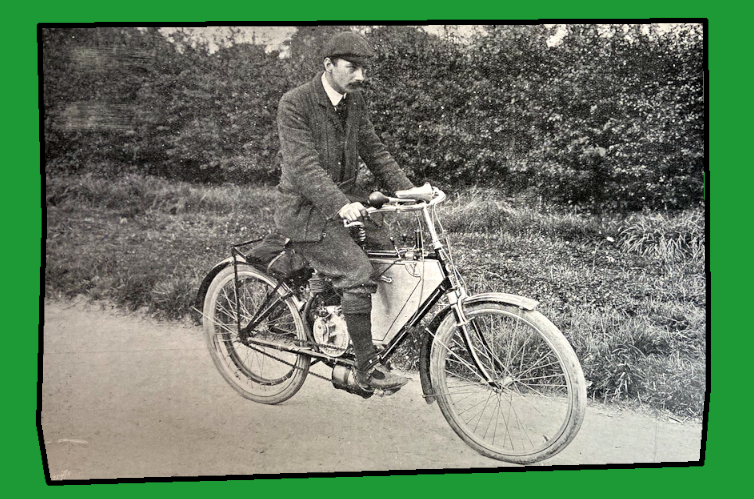
yards in seven minutes. Our readers will remember that during these trials cars and cycles ran together, and the driver of one of the former—a Wolseley—which he had been following closely, found that he had been exceeding the speed limit, and by letting his clutch slip covered the two hundred cards at a crawl. So Mr Wright caught hold of the car. Thus both avoided loss of marks by not arriving too early. During the Westerham hill-climb, as he found that this severe hill was too much for the little 1¾hp engine, he left the saddle and ran beside the machine, letting it climb the hill under power. This, however, was counted against him. On the last day but one his lubricator failed him, but be was not to be done—taking a. box spanner he unscrewed the apparatus and removed the automatic part, never leaving the saddle all the time The next event of importance in which Mr Wright took part was on the occasion of the Automobile Club’s anniversary run to Oxford, when he again came through with flying colours. As many of our readers no doubt remember, it was a pouring wet day, with roads in a filthy condition, and on one of the greasiest portions of the trip poor Adams skidded sidewise down a hill without losing his balance. On this run Mr Wright rode the same 1¾hp machine which behaved so well in the 650 mild, trials. Next after this carne one of the most memorable events in the history of automobilism—the ill-fated Paris-Madrid race. As in the case of more than one of the makes entered, the Ormondes were finished only two days before their riders left Newhaven, and on their arrival at Dieppe they had to wait two days and go through all manner of insane formalities before they were allowed to proceed to Paris. During these troubles Mr. Wright discovered that palm oil did much to simplify matters. Once started things seemed to go better, and he expressed himself delighted with the beautiful scenery of the Seine Valley, the excellent roads, the easy gradients, and the hospitality and good accommodation offered by the inhabitants. With the exception of one puncture—a really had one—which Hacking had on Gaillon Hill, all went smoothly till Paris was almost reached, when 10km of pavé had to be covered. Never in all his wide experience had he ridden over such an awful surface. And it is hardly to be wondered at that on his arrival in Paris he discovered the frame of his machine was buckled, and he was forced to use a strange mount for the race. How he fared and how his only troubles were due to tyres is now a matter of history. It is enough to say that he covered 350km, and, worn out with worry from continually repairing and renewing this most unreliable portion of the machine, and overcome by the intense heat, he retired from the contest. Mr Wright’s performances in this year’s 1,000 miles trials we were able to watch for ourselves, and they are now well known to all.” You’ll find comprehensive coverage of the Auto Cycle Club 1,000 Miles Reliability Trial in the features section—Ed.
“WE OBSERVE THAT OUR interesting contemporary La Locomotion publishes a very useful article on repairing water-cooled heads by a Monsieur Jules Garnier which may be of use to owners of motor cycles. The cracking generally happens in winter, in consequence of ice being allowed to form in the water-cooled heads of motor cycles, the expansion of which causes the cracking; but it also has been known to occur through other causes. M Garnier tells how he has succeeded in cementing cast-iron by using a mixture of sulphur, iron filings, and sal ammoniac, but adds that in the case in question the fissures were too small to allow of this method being employed, the cracks being so minute that only a liquid would penetrate. To condense his description, the idea came to him to employ the well-known property which the salts of copper possess of depositing their copper when brought in contact with iron. He therefore prepared a highly saturated solution of sulphate of copper with which he filled his cylinder head, thus allowing the liquid to percolate through the cracks until they were entirely sealed up. He tells how the experiment was an entire success, and adds that it saved him the cost of a new combustion head.”

“RELIABLE SINGERS. 21,939 MILES in 14 months on a Singer motor tandem tricycle and a Singer 2½hp motor bicycle is really a wonderful performance. The above distance has been covered by Dr HP D’Elsey Benson, of Guernsey, while using the two Singer motor cycles mentioned, and they both continue to give every satisfaction. We do not think any further test of reliability should be required to convince prospective purchasers that Singer motor cycles will do all that is claimed for them by the makers.”
“PATRONS OF THE CANNING Town track will have a few more opportunities of seeing some of the crack French racers before the season closes. At the end of the month the star attraction is likely to be a three-cornered pursuit race between two French riders and a prominent English crack. Evidently motor cycle racing is proving an attractive draw at the east-end track.”
“IN COLD WEATHER, ESPECIALLY if the temperature is approaching near freezing point, difficulty will be experienced in drawing a charge of oil into the pump, if the oil is at all of a thick bodied nature; in fact, nothing less than thawing the oil, by detaching the reservoir and warming it in front of a fire, or applying hot water rags to the outside of the reservoir, will cause the oil to flow. The difficulty, however, is overcome if a thinner oil be used therefore it is advisable to use a lighter bodied oil during the winter months.”
THAT THE QUESTION OF fitting two-cylinder motors on motor bicycles is one which cannot be ignored was proved conclusively, when the winner in the motor cycle class at the Côte de Latfrey Hill Climb, riding a motor bicycle of under 102lb weight, provided with a two-cylinder Clement motor, romped up and won at a speed of over 31mph, and that on a declivity having a mean grade of nearly one in ten, and we may also add that this was done from a standing start.”
“IT IS A MATTER OF REGRET that as little attention is being paid to the motor tandem—a combination which, in certain respects, promises distinct advantages over a motor cycle with a trailer or fore-car. There should be some demand for a tandem attachment provided with saddle, handle-bar, and rests, as a good many machines are well designed to carry a second passenger in this manner. It would impose a slight extra strain on the rear wheel and tyre, but a well-built wheel should be equal to the extra load. We have already seen one or two motor cycles thus converted into tandems, and were rather favourably impressed with the idea. Certainly, on the score of cost at any rate, a tandem attachment has much in its favour.”
“WITH THE POWERFUL ENGINES ranging from 2¾hp to 3½hp which some of the best makers are now fitting, and also provided that a really good carburetter is used, then, in my humble opinion, pedals are entirely unnecessary on a really good up-to-date motor bicycle; nay, I will go further, and venture to predict that in two years or less very few high-class makes of motor cycles will have them fitted. I have not been led to form these conclusions hastily, but after mature deliberation, founded on the experience of over 10,000 miles of riding on various styles of machines. The makers of the renowned Bat machine, which has gained such laurels on the racing path, certainly do not seem to consider pedals necessary to the efficiency of their machines, and are evidently prepared to pin their faith on the success of the pedalless machine. Many riders will ask, ‘What are you going to do with a pedalless motor bicycle if it goes wrong?’ To this my reply is, It should not go wrong if properly made and well looked after by its owner. I have now ridden a machine without pedals over 3,000 miles, and it has never failed me once, except in trifling matters, which I was able to remedy in a few minutes, and I have taken long rides of over 100 miles a day on many occasions, and I very rarely ride out without doing between 40 and 60 miles. I keep an eye on all its parts, and make sure all is right before I go out, and I never have the least fear of breaking down. My machine is fitted with a 2¾hp De Dion engine, a good-sized, reliable De Dion carburetter (a good carburetter is a sine quâ non on a pedalless motor bicycle), a good coil, well wired up, and a Bat raw-hide belt. The rest of the machine is as plain as can be, strong throughout, with girder front forks. To start it, I only have to walk it sharply, or run it three or four yards, and the motor begins to beat at once at a 4-5mph pace. It is easily mounted, and if my exhaust valve is properly ground in and the machine is properly in order, this speed develops to about 7-8mph, and it will go on beating at the same speed all day without attention. I have no trouble in getting the right mixture’, as my carburetter is so made that the mixture is always ‘ready set’ with the two little levers right back, and the machine is bound to start every time. I can leave it idle in the shed for 10 days—never see it, in fact—and I go to it, turn on the petrol valve, put in my connecting plug, and the machine will generally start with a few yards’ run (to loosen the piston), just as though I had only put it away an hour before. The position of the footrests or stirrups, too, is much more comfortable both on one level than the moving pedals at right angles. When adjusted to the right reach from the saddle, the position when riding is something between sitting and standing. In conclusion, I am quite satisfied with my machine in its pedalless condition. and have no desire to return to former designs. The only thing I am ever afraid of happening is the breaking of an exhaust valve. I know I ought to carry a spare one, but I do not. I look at mine occasionally, and if it looks all right I do not trouble. I have had a belt break now and again, but I carry a spare belt-fastener. and have always been able to put it right in a few minutes. Any machine properly made with a 2¾hp engine and good large carburetter (spray) is quite safe without pedals. given ordinary care and attention to all details, and even in the case of an exceptionally steep hill one can run alongside and allow the engine to take up the unloaded machine.”
“THE SUBJECT OF OUR ILLUSTRATION is that of Mr FR Butler, a well-known motor and cycle agent, at Baldock, Herts. He recently called at our office on his Enfield motor bicycle, and in the course of conversation ex-plained that this machine, which was originally delivered in February, 1902, had been in constant use ever since that time, being let out principally on hire, besides being ridden by himself for hundreds of miles. Although the machine is now an out-of-date pattern, we call attention to the durability of the motor cycle, as many of our readers are constantly enquiring whether second-hand machines of good make are worth buying, a prevailing idea being that if they have been ridden for a couple of years they are more or less worn out. The compression on the Enfield engine was perfectly good, and the bearings showed no signs of wear, either in the engine or cycle.”
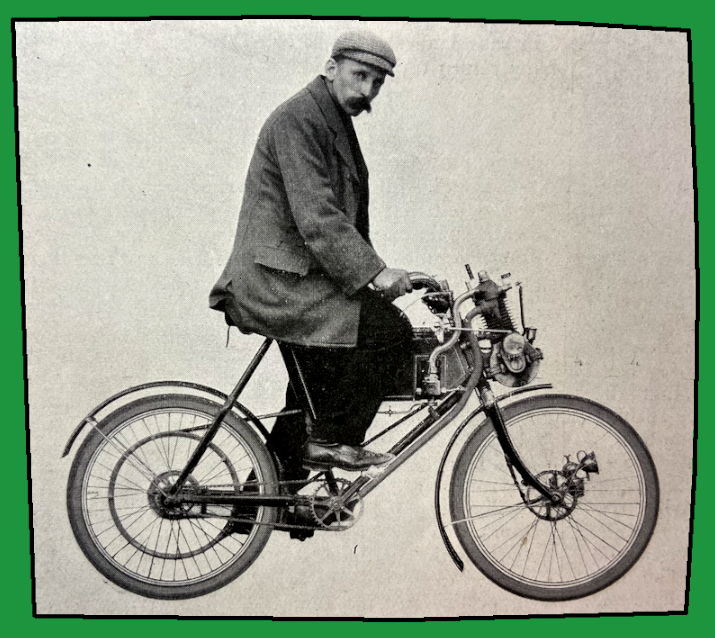
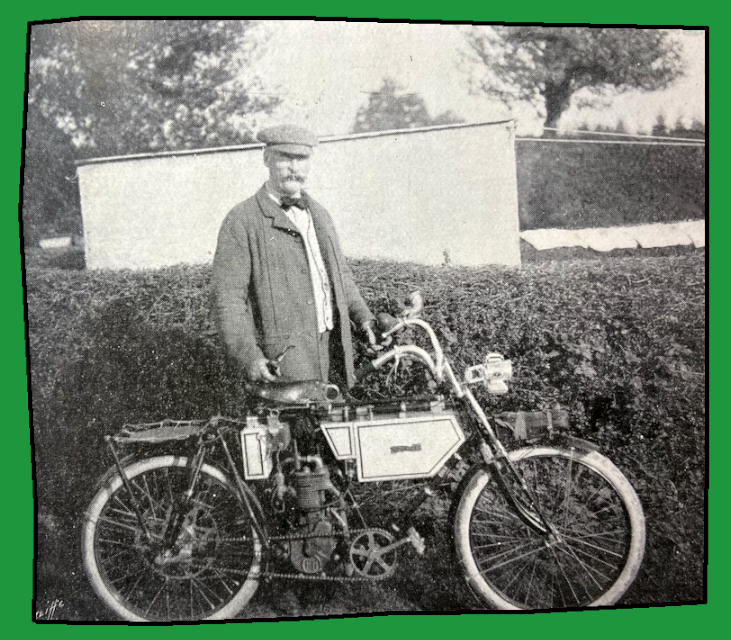
“TWO MOTOR CYCLISTS, Messrs Ferdinand Budicki d’Agram and Sigmund Eclserl, of Vienna, are at the present moment engaged in making an extensive motor cycle tour. They have already passed through a part of Europe and the North of Africa, taking on their way Tunis, Oran, Algiers. and Constantine, and during the month of August they passed through Italy and Switzerland, and they intend finishing their tour by passing through the following towns: Calais, Brussels, Amsterdam. Rotterdam, Hanover, Berlin. Hamburg, Copenhagen, Christiania, Carlstadt, Stockholm, Helsingfors, St Petersburg, Vilna, Kovno, Warsaw, Risburg, and Gratz. They hope to finish the tour before the end of this month. Their motor cycles are furnished with motors of 2¼hp.”
“WE HAVE HEARD SO MANY discussions and have had so many enquiries from motor cyclists about side-cars that we think a few words about our own experiences with them will not be out of place. Our first ride with one was both unpleasant and uncomfortable, and, like Mr Arnott, we felt it tiring to steer. But we did not set it aside and try another means of taking a passenger. We were not long in making another trip, and at the end of 40 miles we returned quite delighted with our purchase. The steering is simplicity itself. Corners may be taken with ease, though we do not advise them to be taken too rapidly, and the charm of sociability is delightful. Provided an efficient silencer is fitted to the machine, there is no need to shout to make one’s passenger hear. In our opinion the trailer is far behind this enjoyable means of locomotion, while the forecarriage is not much in front of it.”
“A CURIOUS MOTOR CYCLE accident has occurred at Namur, when a rider, coming along at a good pace, somehow ran against one of the stone blocks which hold the iron stays that support a railing along the bank of the Meuse. The shock sent the rider out of his saddle and projected him into the river. His body has not yet been found, though the spectators of the accident went to his immediate assistance, and the only clue to the identity of the drowned man is the number of his machine. It would appear that his head must have struck something, so that he was stunned when he fell into the water.”
“PHOENIX MOTORS HAVE established a most businesslike factory (which is just getting into full swing) equipped with modern plant necessary for the turning out of Phoenix motor cycles and Trimos. Showroom, offices, store-rooms, brazing and machining, polishing, plating, body-making, and finishing departments, are all busy with the hum of industry. In the body department we noted a large number of the new popular Trimos being prepared for despatch, several finished in a Chinese green for Singapore. Charging plant is also installed, and anything from the smallest accumulator to the big electric car accumulator can be undertaken.”

“NEARLY every motor cyclist is able to recall some bright particular ride before which all others pale in interest. During the past and previous seasons I can look back upon many a pleasurable outing, yet there is not one that affords more enjoyable recollections than the one I am about to record. With a companion, whom I shall refer to as X, we had planned to start from London, or, rather, its southern outskirts, at twelve o’clock on a Saturday night in July last. Our destination was Hastings, over 60 miles of the prettiest and best surfaced roads to be found near London. Previously, we had done the journey in the three hours, but this time we elected to travel down in a more leisurely manner, in time to arrive for an early breakfast. The eventful Saturday at length arrived, and proved to be one of the few really fine days that have been vouchsafed us this year. The early hours of the evening accordingly were spent in preparing the machine. The engine (a 2½hp Minerva) had so far behaved splendidly, and we anticipated little, if any, trouble in this direction. The accumulator, newly charged, and good for 800 or so miles, was packed into the case, plug and contacts cleaned and adjusted, and the tanks filled with Carless. The machine was then mounted and run briskly on the stand. All was well! Next the trailer was looked to. To the back of this we strapped a small dressing-case containing a few spare articles of clothing, and also a flask of something ‘special’, for previous experience of all-night riding on the old push-cycle had told me that this might prove welcome in the wee sma’ hours. Punctually at twelve, therefore, we lit up and made a start, and here I may mention that my companion has acquired the art of being able to mount and dismount a trailer whilst it is on the move—a most useful accomplishment, though it is a trick that, in his own words, ‘takes a bit of learning’, as most will believe. Bromley and the end of the rather rough macadam was soon reached, and as we skimmed through its narrow high street the echoes of the steady ‘pop-pop’ of the engine resounded sharp and clear. Then we were in open country, and ‘purred’ through Lock’s Bottom and Farnborough in fine style, giving the engine a rest as we descended the long steep hill of that name, at the foot of which a few twinkling lights betokened Green Street Green. From here the road ascends gradually to Pol Hill, and we became aware that what slight wind existed was in our favour. So with a little more gas and the sparking advanced, the machine bounded along the white road that lay ahead. Close to Halstead we overhauled the GPO horse-drawn mail van that starts from the GPO every evening and serves some of the remoter districts hereabouts. A cheery ‘Good-night’ from the driver as we sped by, and soon we reached the tree-tufted crown of Pol Hill, where the road descends through a scene of exceeding beauty to Riverhead. On each side towers a steep bank of trees. Descending slowly—as it was exceedingly dark ahead—we noticed the lights of Shoreham village twinkling in a hollow at the foot of the precipitous slope on our left. Halfway down, the road bends and runs out into the open, still continuing downhill to Riverhead. At Sevenoaks Tubs Hill entailed rather a stiff climb, and I warned my passenger to prepare to dismount should the engine slacken speed. By dint of vigorous pedalling, however, we managed to breast, the hill. Sevenoaks was as silent as a tomb—not a light visible anywhere. At the next hill the engine commenced to race, the machine meanwhile crawling. X jumped out, and I managed to get to the top by pedalling. A look at the belt showed it was on the the slack side, so by the light of the acetylene lamp we shortened it a trifle. We descended Riverhill cautiously, mindful of the fact that the abrupt bend is generally loose and cut up by traffic. It was as much as I could do, even with two brakes, to check the machine, but, happily, it was a clear night, and the white road ahead could be discerned for some distance. Refreshed after a good rest the engine took us along the smooth, level road past Hildenborough in fine style—a grand spin this. At Tonbridge, X consulted his watch, and found it was twenty minutes to two—well inside the schedule time. Not a light or living soul did we see as we rode through the town and over the little bridge that spans the Medway. Sharp to the left, we turned at the fork roads close to the SER station, and the stiff little climb out of Tonbridge was taken in good style. Burgess Hill—the stiffest on the outward journey—was reached. The surface, however, was excellent. Forward went the throttle lever, and with spark advanced we took the formidable hill at full, or nearly full, speed. First we flew, then the ‘poms’ grew less and less frequent and I to retard the spark cautiously. I called upon X to dismount, which he cleverly managed to do. Thus lightened, I romped up the remainder of the hill. As the engine was hot we decided to rest awhile on the inviting roadside bank. X suggested a drink. Good idea; so we unstrapped the trailer bag and each proceeded to sample the contents of the flask therein. The view from the summit of Burgess Hill is one of the finest in the South, and on that night we could plainly discern the lights of Tunbridge Wells. Another dose of oil for the engine, as there was some stiff work ahead, and we were once more on the move, the road, though decidedly switchbacky, being absolutely perfect. On through Pembury, and over roads that were made for motor cycling, merrily ‘purred’ the engine, the regular ‘pop-pop’ lending pleasant music to the journey. As we dropped down into Lamberhurst X suggested that we should change places, so at the foot of the hill I dismounted and snugly ensconced myself in the trailer. The stiff hill leading out of the village gave X some work to do, but with vigorous pedalling we surmounted the slope. Presently X pulled up, and suggested that we should again sample the warmthful beverage of the flask. This time we finished it. At Flimwell we met the first signs of daybreak in the far east, and gradually the light of day spread over the skies. High up at Robertsbridge we rested awhile, and witnessed a glorious sunrise. ‘Twas a splendid picture. As we sped over the remaining 17 miles that separated us from the sea, daylight gradually asserted itself. Past St John’s Cross and into Battle, where even so early in the day there were signs of life. Very beautiful did the famous old abbey appear in the soft misty light of early morn. Halfway up the stiff hill out of Battle the engine slowed and pulled up dead. Dismounting, I found the sparking well advanced and the throttle wide open, so that when the motor commenced to slow down it had naturally lost power. However, with a good push-off, X got going and scaled the top, and I lit my pipe and sauntered up the rest of the incline. The fresh, invigorating, morning air began to sharpen up our appetites, and, indeed, an all-night ride on a motor cycle is calculated to give an appetite to anyone. After one or two sharp little inclines were negotiated we arrived at the summit of Silverhill and sighted Hastings and the sea in the misty hollow below. Skimming over the excellent wood-paved parade from St Leonard’s to Hastings we made for the old town, and were lucky enough to find open a pleasant little coffee-house overlooking the fish-market and the quaint old timbered houses of Rock-a-Nore. And here, partaking of a hearty breakfast and a contemplative cup of tea, do we store up in the treasure-box of our memories a picture that months of fog and rain have failed to dim.
CMF“
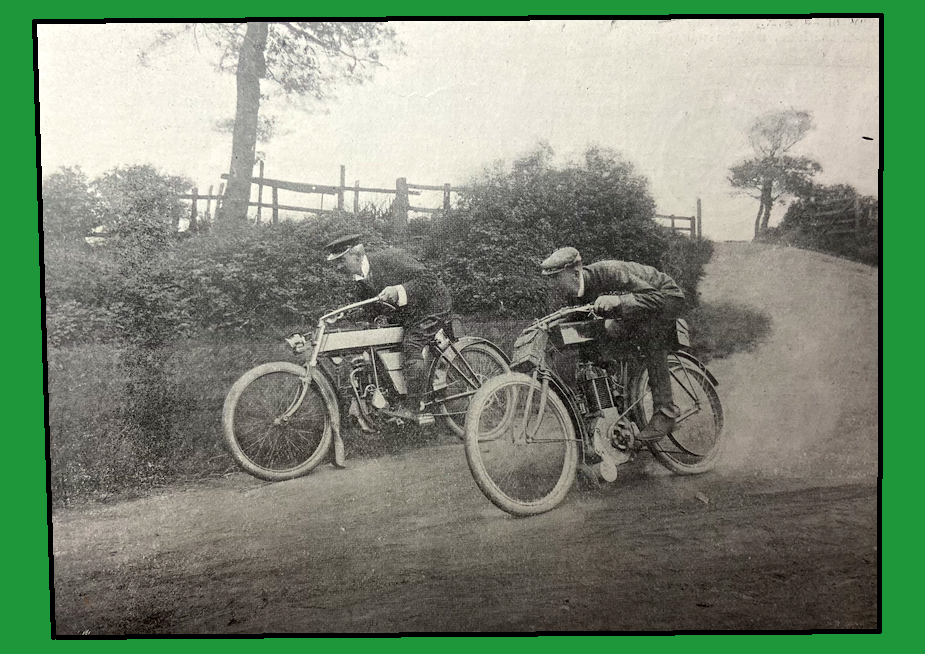

“ALL CYCLISTS OF THE ‘good old ordinary’ days will remember with pleasure the delightful ‘freemasonry of the wheel’, as it was then called. One used to make new friends each ride, and in a year or so seemed to know every rider for miles around. The writer, in the good old days of 1878, 1879, and 1880, made many acquaintances in this way who are to-day and seem likely to prove lifelong friends. All these thoughts are recalled by what may now be called the ‘freemasonry of the motor cycle’. Every motor cycle we meet we have the same old interest to see what make of machine is being ridden, and whether we know the rider…the qualities of the various machines—engine power, position of the engine, accumulators, sparking plugs, valves, etc—form interesting topics to converse about and pass comments upon. But by far the greatest source of satisfaction is the evident desire of all motor cyclists to assist one another in the case of a breakdown or mishap, and many acquaintances are made in this way. One feels almost compelled to sing out, ‘Is anything wrong?’ The writer has had the pleasure many a time of assisting to put matters right—faults which have never happened to his own machines. In this way, he gains knowledge, which comes in extremely useful, and teaches him to guard against similar mishaps occurring in his own experience. The obvious moral of it all is ‘Help one another’, and, independently of being of assistance, you will find the time and trouble bestowed anything but wasted. Moreover, the writer also perceives a time rapidly approaching when the brotherhood of the motor cycle will require to hang together even more strenuously than at present.. In saying this, he of course refers to the 1st of January next, on which date the new Motor Act will come into operation…it is very obvious that the stringent clauses it contains (in which the mildest penalty is .£5, ranging up to or at the discretion of the Court imprisonment for not exceeding three months) will give plenty of scope for the previously quoted moral of ‘Help one another’. Indeed, this view of the question has struck some members of the motor cycle confraternity so strongly that they consider, as an addition to ‘moral help’, a ‘Motor Cyclists’ Protective Association’ should be promoted, and we think this is an idea well worth consideration. “
“MOTOR CYCLES ARE NOT confined to the middle class. Thanks to modified prices and the extension of the instalment system, the motor cycle is becoming a more familiar vehicle with the artisan class.”
TO CONCLUDE THIS RAMBLE through the motor cycling world of 1903, here are some quotes that reflect the speed at which the new-fangled motorised bicycles were evolving into motor cycles: “The new 3½hp Simms bicycle motor fitted with the Simms-Bosch ‘Arc-light’ (high-tension) magneto ignition, which the makers claim as one of the greatest novelties for the coming season. This system of ignition consists of a magneto machine which produces a ‘jump’ spark without the aid of a coil, the machine forming a complete outfit in itself. Further, it is fitted with a lever by means of which the spark may be advanced or retarded. It is also applicable to any motor, as all that is necessary is to arrange a suitable rotary drive, and connect one wire from the terminal to ignition plug…All taps and levers are dispensed with, the machine being controlled from the handlebar by means of twisting handles and Bowden wire…The clutch is on the engine pulley and is operated by a lever on the left handle grip, by means of a Bowden wire…The drive is by a Hans Renold motor chain from a spring clutch…The new Raleigh-patent two-speed gear may be fitted to machine if specially ordered…Pedals are dispensed with as these are unnecessary, foot-rests being provided for the feet…Motorcyclists will be interested in the new ‘hand protector’ which obviates the necessity of wearing gloves. As riders well know, it is not possible to have the same control over the machine with a thickly gloved hand. The new protectors are of leather, fur-lined…A novel hinged rear mudguard greatly facilitates the removal of the rear wheel…A cure for all tyre punctures is shown here in the shape of Millennium, sold, in pumps, by means of which the puncture closer may be forced into the inner tube through the valve…There is no doubt that the ‘Alldays’ motor-bicycle is a beautifully finished and serviceable machine, all the parts of which are made to gauges and interchangeable…The firm also makes a speciality of what is known as gauge limit work, which provides the certainty of any part so made being certain to work without fitting…Motorcyclists will be interested in the new pattern combined carrier and stand…All the parts of this machine are standardised…Savon des Chauffeurs, a special soap for automobilists, was on sale. It is retailed in collapsible tubes at 1s each, and will remove grease, oil, etc., from the hands.”
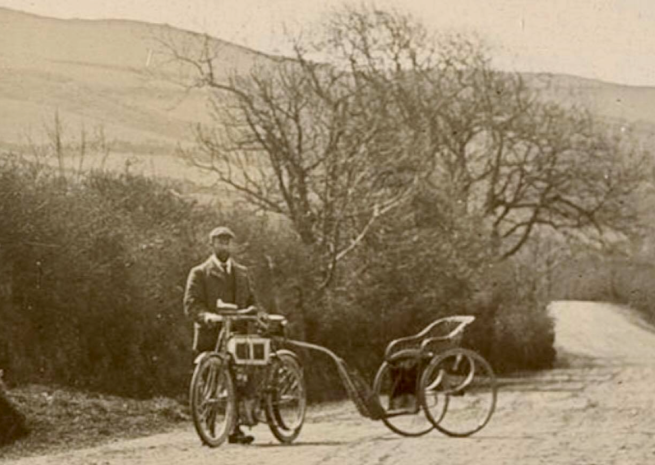
- And finally, a selection of adverts, including some from the colonial side of the pond.
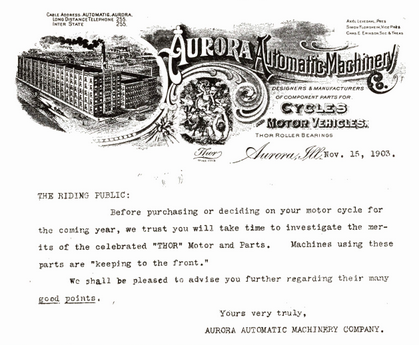
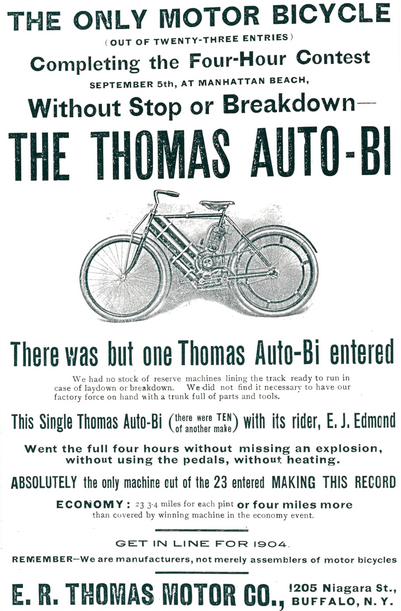
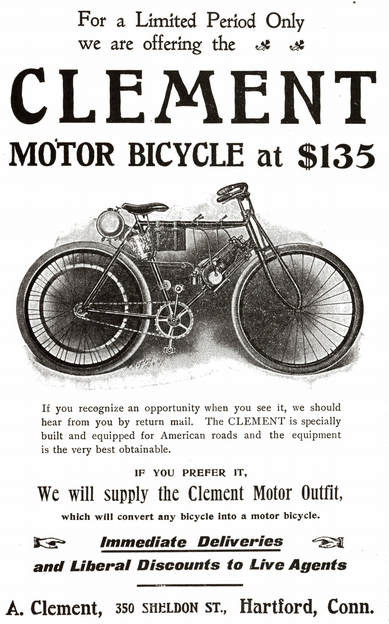
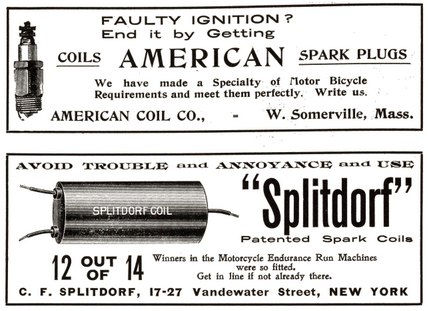
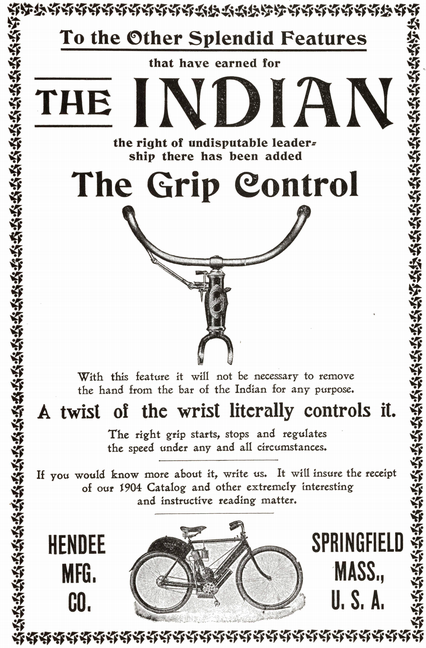
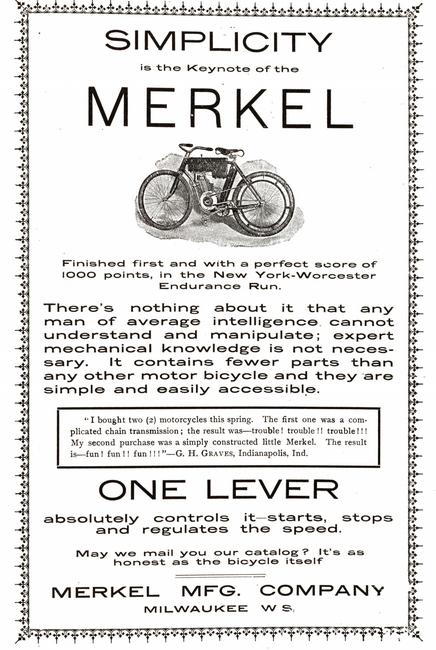

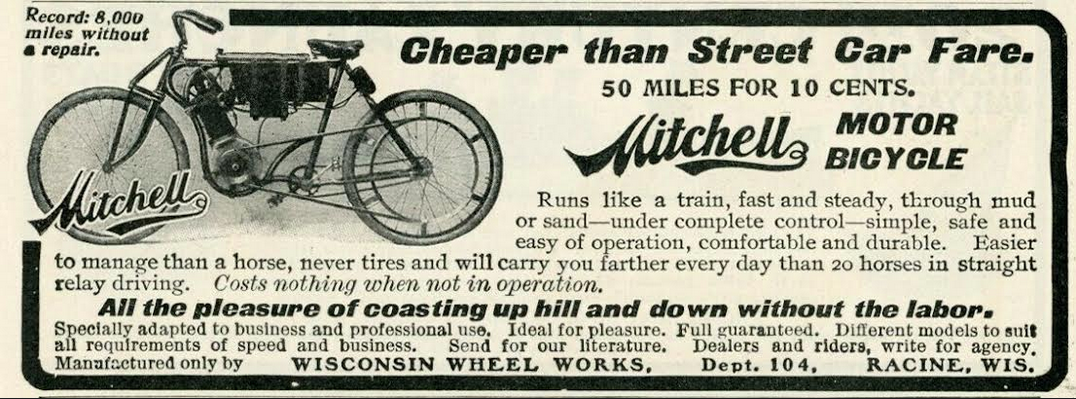
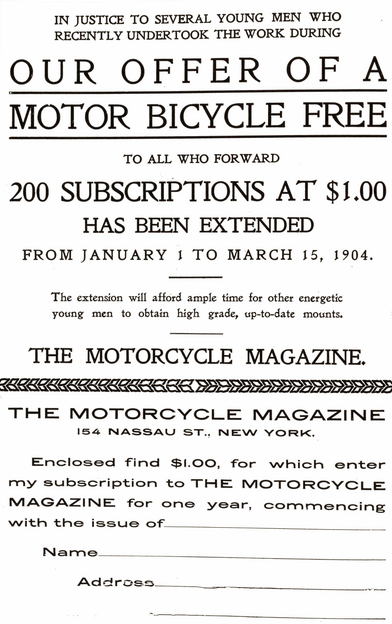
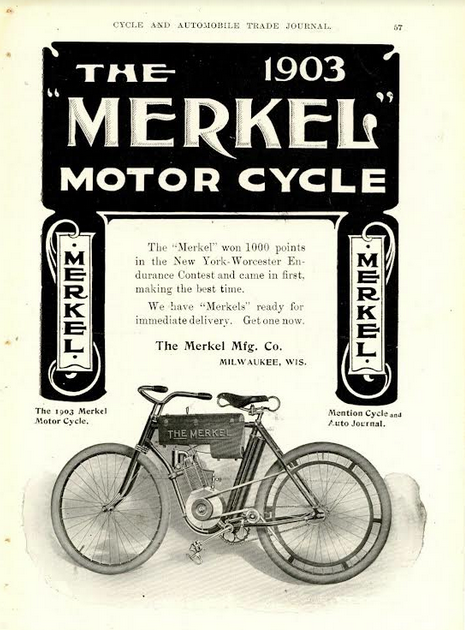
…A batch from Blighty:
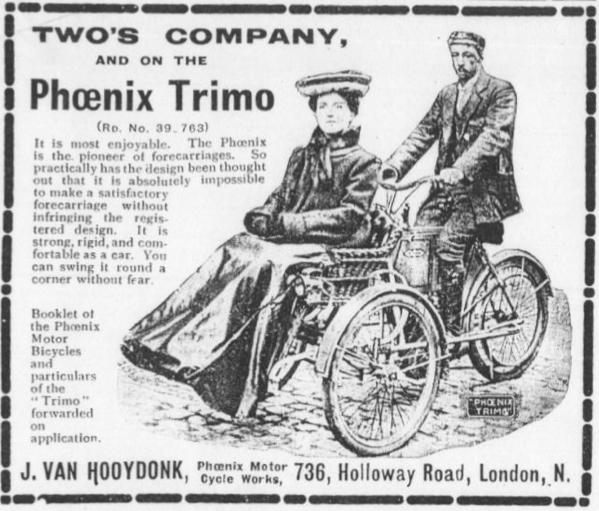
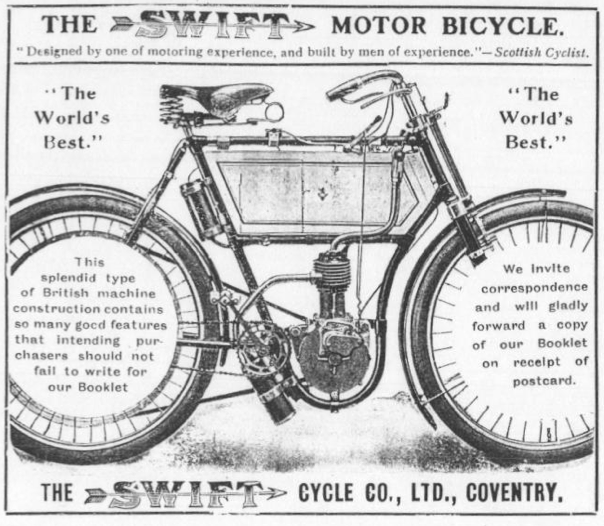
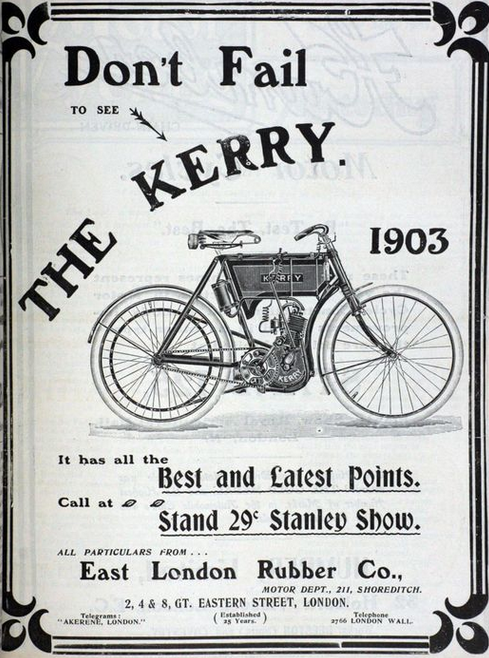
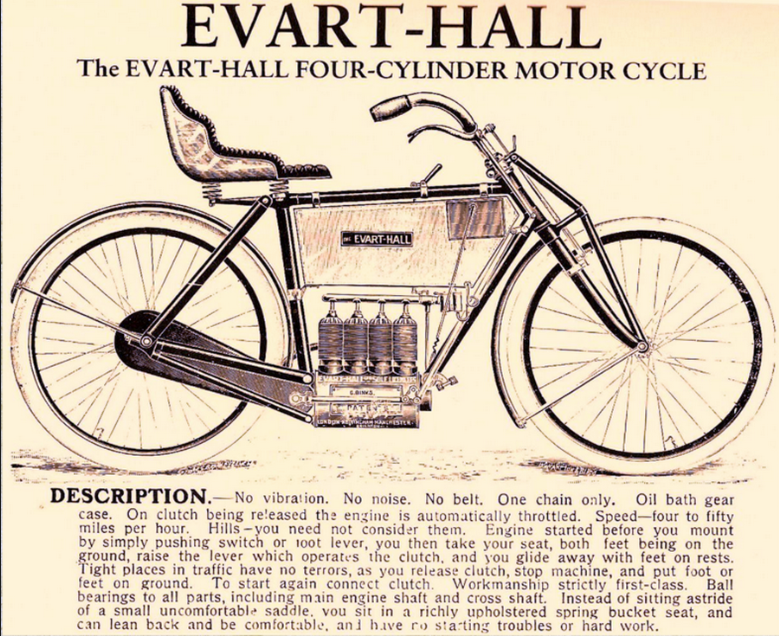
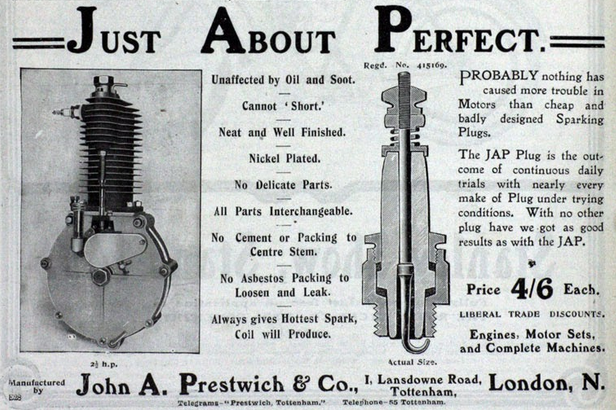










…from La Belle France:







…and from Italy, where an Italian ace was strutting himself on a French flier.

